- Tips & Tricks
- Tales from the Trails


The Ultimate Insider’s Guide to Trekking Everest Base Camp
CAMPING TIPS & TRICKS , Hiking / Camping / Tour Companies , TRAVEL

At 8,848 meters, 29,029 feet above sea level, Mt. Everest is the tallest mountain in the world, towering over the surrounding peaks in the Himalayas mountain range on the border between Nepal and Tibet.

Even if you’re not a diehard mountaineer, you can still explore this beautiful region of Nepal with a trek to Everest base camp (EBC).
Not only will you get lifelong bragging rights for completing the trek to base camp, but it’s also a beautiful trek in its own right. Amazing vista can be seen passing through the Sagarmatha National Park and the awe-inspiring Himalayas .
Although the trek takes about two weeks, it’s surprisingly accessible and has been completed by many first-time trekkers.
Everest Base Camp: A Brief Overview
Since the first successful summit in 1953 by Sir Edmund Hillary and Sherpa Tenzing Norgay, the imposing peak has attracted decades of adrenaline-seekers wishing to add their name to the list of successful summiteers. A good portion of these climbers never returned .
Despite the intimidating statistics, the sister trek through the picturesque Khumbu Valley to the base camp used by professional mountaineers is an attainable goal for many people.

Located at an altitude of 5,361 meters, 17,590 feet above sea level, you don’t need fancy equipment or mountaineering skills to reach EBC. Certainly, it takes just a positive attitude and a reasonable level of fitness.
There’s a sense of camaraderie and a tangible buzz in the air as the adrenaline of the would-be Everest summiteers infects everybody around them.
The scenery at these altitudes is breathtaking and varied, ranging from rhododendrons and pine fields to rivers; suspension bridges strung with prayer flags; glaciers, lakes, valleys, high mountain passes, and finally, the spectacular Himalayan mountain peaks!
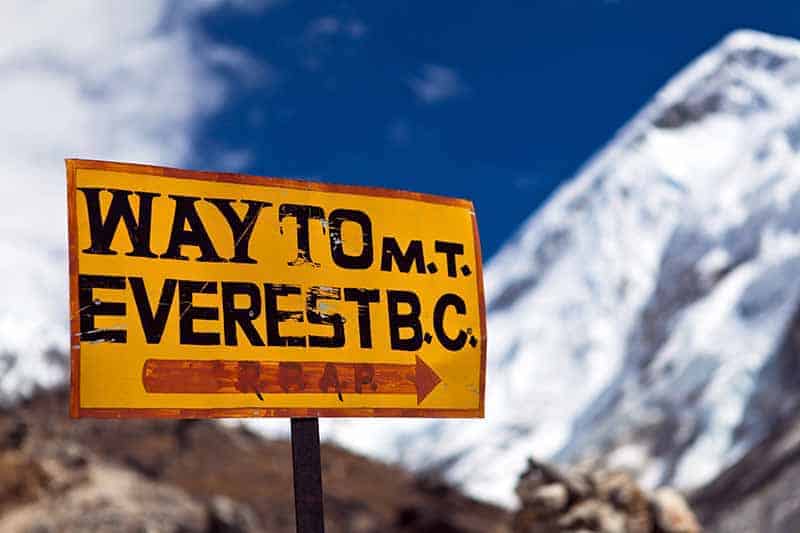
The Sagarmatha National Park is home to rare animal species such as snow leopards and red pandas – though it’s very unlikely you’ll encounter them. You’ll frequently have to step aside (to the uphill side!) as you encounter yaks on the trail.
Whether you choose to follow the traditional EBC route or one of the alternative trails, it’s guaranteed to be an experience you’ll never forget.
In contrast to most multi-day treks where you’d be camping in a tent, trekkers to base camp stay in cozy tea houses. You can find several available in a range of budgets, which function as both hotels and restaurants.
The trek is dotted with Buddhist monasteries and tiny villages almost all the way up. The relaxed pace of the trek allows plenty of time for you to explore the villages and get to know the local Sherpa culture.
Mt. Everest is increasingly covered in garbage left behind by the hordes of people who have set out to conquer its lofty heights. When you go, please respect the environment and do your best to minimize waste.
The most popular time of year to do the Everest base camp trek is between February and May – the pre-monsoon season.
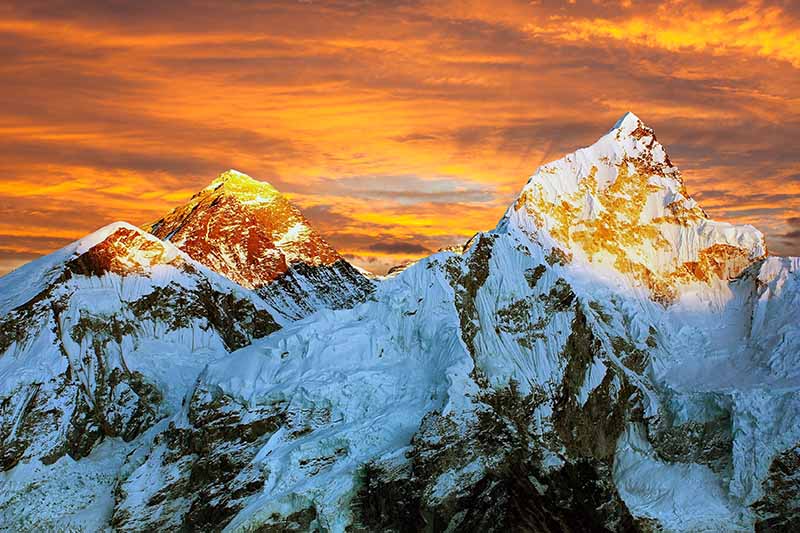
During these spring months, the weather is typically warm and dry and the mountains will be ablaze with colorful rhododendrons.
This is also peak season and while you’re unlikely to have the trails to yourself, you’ll enjoy a buzzing atmosphere at the tea houses on the way. This is also when most Everest climbers make their summit attempts.
The summer months bring the monsoon rains, resulting in slippery trails and a heightened risk of landslides. If that doesn’t deter you, the leeches and foggy weather might! It’s not recommended to attempt the trek in the summer.
It can also be difficult to fly into Lukla during the monsoon. Indeed, this is a good time to pick the Jiri trek over the classic EBC trek.

If you want fewer crowds, try going in September or October, the post-monsoon months, when you have the highest chance of clear skies, although temperatures are slightly colder.
You can even do the trek in the winter but be prepared for sub-zero temperatures most days and lots of snow.
Whenever you go, make sure you pack for unpredictable weather in case a snowstorm takes you by surprise.
Trekkers interested in the local culture might want to plan their trip dates around traditional holidays with celebrations in Kathmandu, such as Holi (February/March) or Indra Jatra (September).
Another thing to consider when planning your trip is flight prices, which can vary considerably. Check flights before booking as this might have a huge impact on when you want to go.
Lastly, be aware that it might be harder to find tour operators who provide treks in off-season months. Also, some of the paths might be closed.
Conversely, if you want a stab at actually sleeping in Everest Base Camp, then late spring is your best option. It will be rare to find tour operators who might be able to wrangle this.
Everest Base Camp Packing list
If this is your first multi-day trek, don’t forget to budget for all the equipment you’ll have to take with you.
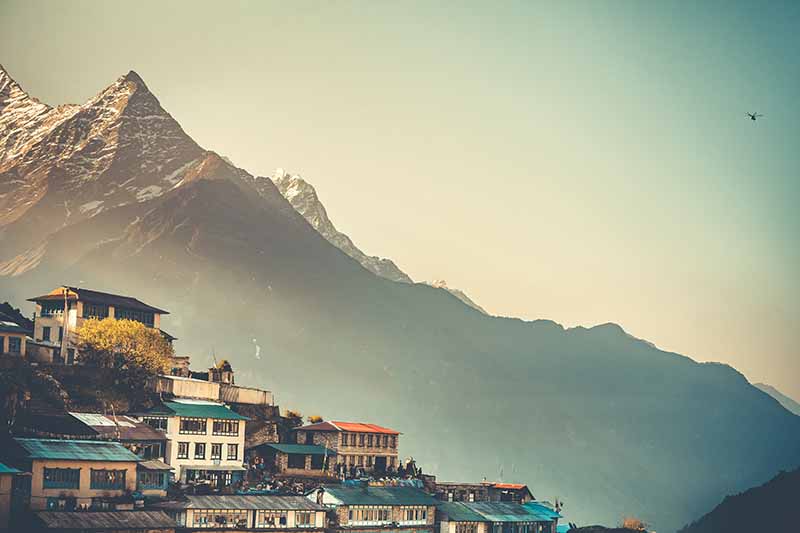
You can choose between renting or buying your gear. Hikers who plan on doing more multi-day treks might want to invest in their own equipment.
If you’re doing a two-week trek, it makes more sense to rent your sleeping bag and down jacket. For trekkers who plan on trekking for a whole month, it makes more financial sense to buy.
The neighborhood of Thamel in Kathmandu offers plenty of options for buying and renting. However, the products on offer may be of questionable quality.
Further on, Namche Bazaar is a last-resort option if you find you’ve forgotten to pack any essentials. If you keep your receipts, then talk it over with the shop when buying. Some shops will buy your gear back from you, at the end of your trek, for a reduced price.
Almost everything available for sale along the trek has been carried up the mountain, either by yaks or people. This means things get more expensive the higher you go.
Packing strategically. This means bringing the items you can’t live without while avoiding overloading your backpack. Whether you hire a porter or decide to go solo, somebody will be lugging your things up the mountain. Indeed,think twice before including unnecessary items like an extra book or five spare shirts!
Aim to pack around 10kg if you’re carrying everything yourself, and 20-25kg if you’re getting help from a porter. Don’t forget that your water adds extra weight. Try packing your bag with full water bottles, to get a more accurate idea of how much you can bring.
This list is aimed at trekkers who will be sleeping in tea houses every night. Be aware that if you don’t book early enough, the tea houses may be sold out in high season.
If you think you might end up having to camp, Then you’ll need more supplies not covered on this list. Such as a winter insulated tent , sleeping pad , etc.
What to Wear
The clothes you pack will depend on which season you’re visiting in. Make sure you have enough clothing to keep warm, especially in the evenings.

Layers are crucial, as temperatures and weather conditions will change drastically between day and night and as you ascend and descend in altitude.
Tea houses often only heat the common areas, and then only in the evenings, so bring warm clothes for lounging around at night.
The higher you get, the less likely you are to have power in your tea house, or only for a few hours as they’re run off solar power.
Base layers: Your base layer should be comfortable and moisture-wicking. Stay away from cotton; go for merino wool or synthetics .
Pack a long-sleeved shirt (avoid short sleeves as you’re more likely to get sunburnt) and long underwear, if only for the cold evenings.
Fleece mid-layer: You’ll probably be putting this on and taking it off with every mountain pass. Indeed, try to find one that will fit easily into your day pack.
Outer layer: Get a down jacket with a good warmth-to-weight ratio, as you’ll be carrying it much of the time.
Waterproof windbreaker and pants.
Hiking pants: Well-insulated trekking pants , or trekking pants that can turn into shorts.
Waterproof hiking boots. We can’t stress enough how important it is to break your hiking boots in properly before your trek.
Don’t forget to bring a pair of comfortable sneakers or sandals for the evenings and for bathroom runs.
Socks: Woollen hiking socks are worth the investment – bring a few pairs that can handle very cold temperatures for the higher altitudes, and look for flat seams and padded spots to reduce blisters.
Sock liners and Vaseline are two other good ways to prevent blisters . You should also bring a pair of warm socks for base camp.
Gaiters: These will be especially useful during the rainier months.
Gloves : Pack a thin pair of “inner” gloves and a very warm pair of outer gloves. There will be at least one or two days where your fingers will freeze otherwise – for example, the day you summit Kala Patthar.
Scarf/balaclava/buff: The trail to EBC gets infamously dusty, provoking the “ Khumbu cough ” that plagues many hikers. A buff or something similar will keep you warm as well as provide you with a layer to breathe through to minimize the amount of dust in your lungs.
Beanie and sun hat , preferably with neck cover, to protect against the sun .
Underwear and sports bras: You’ll probably be reusing these, so get good-quality, non-cotton ones.
Accessories
Drinking water: Most tour operators provide purified water. Avoid bottled water, as this is expensive on top of being an environmental disaster.

We recommend bringing two big reusable water bottles (or a water bladder for drinking on the go). Tablets take a while to work and it’s nice to have one water bottle ready to drink while the other one is getting purified.
You can also fill a bottle with hot water and sleep with it in your sleeping bag if you’re cold during the night. If you’re purifying your own water, bring water purification tablets , LifeStraw , or a Steri-pen. But remember, these need charging, and charging on the trail costs money.
You may wish to add flavor enhancers to your water. Unfortunately, at Gorak Shep the water is very mineralized so you’ll need to buy bottled water.
Showering: Whether or not you shower is up to you. Expect to pay around $5 for a hot shower. Some people rely on wet or backpacking body wipes , especially since wet hair is no fun in negative temperatures!
Sunglasses: The combination of snow and altitude is brutal on your eyes, so invest in good polarized sunglasses with wraparound arms.
Sleeping bag : The teahouses will provide blankets and pillows but you’ll want your own sleeping bag and pillowcase.
Find a mummy sleeping bag rated to -20° C – or colder, depending on the season. Consider bringing a silk liner , especially if you’re renting your sleeping bag.
Toiletries: Sunscreen , SPF chapstick (this is better than lip balm as there’s no need to smear it on with your grubby fingers), quick-drying towel, tissue, baby wipes, period supplies, compressed toilet paper tablets or biodegradable toilet paper (remove cardboard and keep in ziptop bag), hand sanitizer, toothbrush and toothpaste, etc.
Always bring toilet paper with you. Most bathrooms are squat toilets and are located only in villages.
Tip : wet wipes are more expensive than toilet paper on the trail, so if you have to choose, stock up on wet wipes and buy toilet paper when you run out.
Shewee: Ladies, you’ll be glad not to have to pull your pants down in the freezing high-altitude weather. If you need to pee, then I recommend using a portable pee device, like PeeBuddy Reusable Female Urination Device . You stand and use the portable pee funnel, so you don’t need to squat.
If you get your period on the trail and you’re not comfortable with using the DivaCup, another good option is to keep used pads/tampons in a ziptop bag and dispose of them in the next garbage can.
Personal first-aid kit: Bring diarrhea meds, altitude meds, antibiotics, ibuprofen, paracetamol, aspirin, bandaids, blister plasters, tape/trekker’s wool, Vaseline, cough drops (to beat the Khumbu cough), cold medicine, rehydration salts.
Tour operators should provide the rest. Don’t forget to get your travel vaccines before you go.
TSA approved padlock for your luggage.
Backpack: What you pack your gear in will depend on whether you’re using porters. Most porters prefer you to pack your things in a soft-sided duffel bag. Check with the tour operator in case they provide these for you.
If you have a porter, then you’ll only need a daypack for yourself. If you’re not hiring a porter, then bring a collapsible daypack anyway in addition to your backpack. This is so you can leave your big backpack in the tea house during the one-day acclimatization hikes.

Try to get a backpack with straps for hiking poles and zippers to open it from the sides. Not to mention, you won’t have to dig everything out of your bag whenever you want to access something.
Dry bag or plastic cover for your backpack and daypack to prevent water ingress.
Hiking poles : These are a must! All the treks listed here will take you uphill, downhill, uphill and downhill again. Hiking poles will save your knees, and they’ll come in handy on slippery trails during the wet season.
Headlamp or flashlight : You’ll be glad to have this in the evenings after the power goes out, and during early-morning or late-night hikes. Remember to bring extra batteries.
Trekking map: If you’re going independently, a good trekking guidebook is essential – Lonely Planet is highly recommended.
Ziptop bags: These always come in handy for protecting electronics, etc.
Camera or GoPro with memory card and extra batteries.
Money: There are ATMs at select points such as Lukla and Namche Bazaar. But these have low daily withdrawal limits and high commission fees. What’s more, they have been known to take money out of your account without actually dispensing it to you.
Since currency exchange rates on the trail are sky-high, it’s best to bring a stash of local rupees with you. You’ll need rupees to pay for meals, showers, tips, etc.
Wi-Fi: A good option for staying connected is to buy a local sim card. It will give you data to about 4000m altitudes, and sometimes in EBC itself.
You can also check Everest Link for Wi-Fi data packages. The connection is supposedly available in most teahouses along the way, but it can be slow and unreliable so don’t depend on it too much.
Top Tip : Beware of phone updates. These will eat through your Wi-Fi and data limits before you realize what just happened!

Entertainment: EBC treks usually only schedule a few hours of hiking a day, to allow you time to acclimatize. Bring books, a Kindle , cards or other games for the many hours of downtime. Certainly, bring a journal so you can remember this once-in-a-lifetime experience!
Solar charger: Many teahouses offer power points where you can charge your devices for a nominal fee. Also, don’t forget to bring an adapter. It’s a good idea to bring your own solar-powered charger and extra batteries to minimize costs.
Tip : Keep batteries, base layers , and anything else you don’t want freezing in your sleeping bag with you overnight. Keep your phone in flight mode to save power.
Important documents: Bring printouts of your travel insurance information. And make sure one of your travel buddies knows what to do and whom to contact in case of an emergency.
Bring your passport, visas, money, etc. – I always keep these documents in a zip-top bag.
Trekking solo? Bring a safety whistle , compass , pocket knife , & duct tape, especially on the less-crowded trails
High-calorie snacks: These will make a huge difference to your experience. Snacks are exceedingly expensive on the trail, and they provide welcome calories on tough trekking days.
You’ll have to decide how many you want to bring and which ones you want to buy along the trail.
Cloth bags : Many trekkers use these to separate dirty laundry and organize different outfits.
Earplugs: You’ll be glad for these when the tea houses are alive with the sound of Khumbu coughs.
A Note on Trekking Insurance
Be very careful when purchasing travel insurance, because regular policies usually stop covering you once you ascend higher than 3,000m/9,840ft.

At these altitudes, you have a higher chance of getting Acute Mountain Sickness. Also, there’s a pretty good chance you’ll have to be airlifted out to a hospital for injuries . To clarify, injuries like a pulled muscle or twisted ankle at sea level can be more serious at higher altitudes.
Because of these higher costs and risks , insurance companies will charge you a premium for high-altitude trekking insurance.
Luckily, there’s no shortage of insurance companies that offer travel insurance specifically tailored to Everest Base Camp trekkers.
When purchasing a policy, make sure you’re covered for trekking up to altitudes of 6,000m/19,685ft. In addition, ensure it has search and rescue costs, preferably by helicopter.
Don’t forget to check if you’re covered for different travel-related illnesses (and make sure you get your vaccinations before going!).
It’s also nice to have compensation for delayed or canceled flights and repatriation in case of death (hopefully you won’t be needing this one).
Check the clause about lost, stolen or damaged luggage to see if it will cover most of the cost of your hiking gear.

If you’re traveling in winter or shoulder season, then check for trip cancelation insurance. This is to ensure you’re covered if your trek is canceled due to weather.
You’ll likely have other considerations depending on your personal situation. Don’t just take our advice for it – remember to do your research, ask questions and read the fine print of your travel insurance policy before you purchase.
I always keep my travel insurance information handy while on the trek. Additionally, I pass it along to someone else in my group. This is so they know whom to contact in case of an emergency.
Some travel insurance providers require you to confirm with them before ordering a helicopter. Check out this option on getting trekking travel insurance for more information.
How to Avoid Altitude Sickness
Most tour operators organize a relaxed trekking schedule and follow the mantra “climb high, sleep low”. In essence, this is to avoid the risk of altitude sickness.
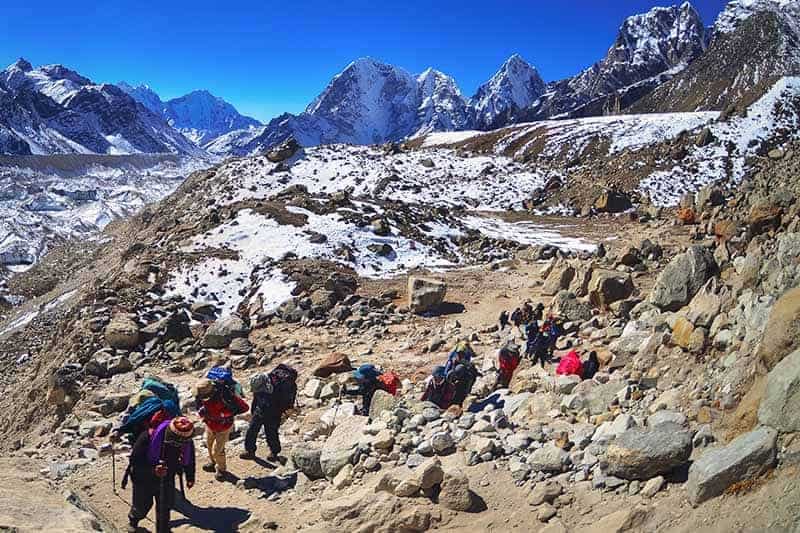
Take it slow – once you finish hiking for the day you’ll have a lot of dead hours in the teahouse. For this reason there’s really no point in racing there.
It’s important to respect the acclimatization days. The acclimatization hikes are designed to help you adjust to tomorrow’s altitude.
Try to drink 3-4 liters of water a day, as dehydration will make the altitude sickness way worse. It also goes without saying that you shouldn’t drink caffeine or alcohol or smoke during your trek.
If you can, then cut out these vices about a week before you start hiking. So that you won’t suffer from withdrawal headaches.
Many people swear by Diamox as a preventative drug against AMS. It’s your choice whether to take this or not. I personally found the tingling fingers and toes to be very off-putting, but it probably helped me acclimatize.
Altitude sickness is unpredictable and doesn’t discriminate based on fitness or age. Listen to your body and descend immediately if you think you have signs of Acute Mountain Sickness.
Check out our article on altitude sickness for a more detailed overview.
Choosing a Tour Operator
Every year there are rumors that the Nepali government will make it compulsory to go with a guide.. But so far, it’s still possible to undertake the trek to EBC on your own.

Unless you’re going in high season, you’ll can drop in at tea houses and get a bed without a reservation.
Independent trekkers can choose whether to hike all by themselves. While others choose between ring a porter, a guide, or a guide and a porter. A guide will speak some English and can help with booking accommodation. However, a porter probably won’t speak English and will only carry your bag.
You can also hire one person who acts as a guide and a porter. Another upside to hiring a guide is that you’ll be providing someone with a job. And in turn, you’ll get to immerse yourself in the Nepali culture.
Alternately, you can opt to join a guided trek with a tour operator. While this is pricier, it’s a good choice for people who have never done such a long, high-altitude trek before.
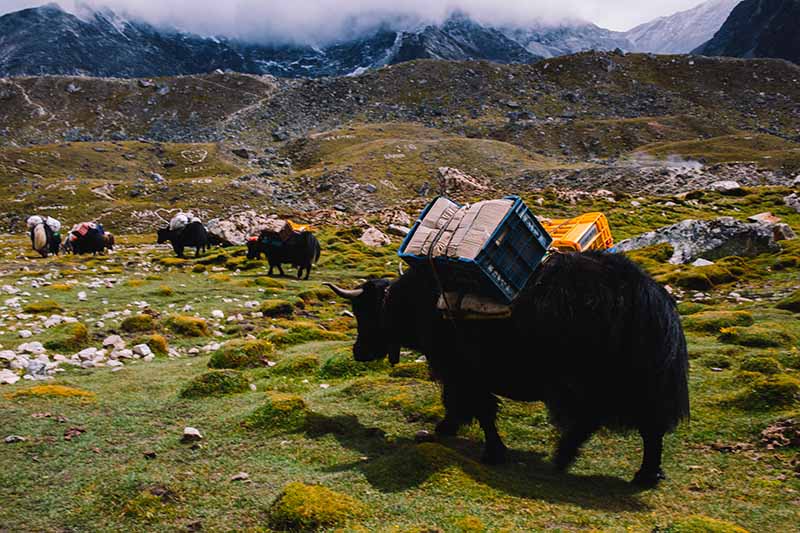
Tour operators typically arrange flights, airport transfers, accommodation, visas and permits, porters and guides. Western tour operators will usually charge more, but provide a more trustworthy service. You can expect to pay about twice as much for a Western tour operator.
Check to see if your tour operator is registered with the Trekking Agencies Association of Nepal (TAAN). TAAN regulates trekking agencies in Nepal to ensure fair treatment of employees, respect for local communities and preservation of the environment.
The Kilimanjaro Porters Assistance Project mission is to improve the working conditions of porters. They advocate for fair treatment and wages, lend free mountaineering clothing, and encourage them to work for only ethical companies. Through providing education and training opportunities, guides and porters have received classes on porters rights, Leave No Trace and are certified in First Aid.
Please make every effort to ensure the porters and guides are dressed properly, stay within the weight limit including their own luggage. Also, ensure they have adequate sleeping arrangements and insurance and are paid a fair wage.
It’s better to go with companies that employ their porters and guides full-time instead of freelance because there’s a better chance the company is providing them with benefits, sick days and health insurance.
Tipping is always a tricky subject and suggested rates will depend on whom you ask. Aim for around 15 percent of salary (if you’re traveling in a group, this number refers to the total pooled tip) per porter and/or guide, and adjust accordingly.
The classic Everest Base Camp trek winds through the Khumbu valley; once reaching Everest Base Camp, you’ll retrace your steps back down to Lukla for the return flight to Kathmandu.

If you’re interested in escaping the crowds or doing circular routes that don’t involve retracing your steps, there’s a variety of alternate routes to choose from.
You can also opt to tack small detours onto your classic EBC trek. This is especially doable if you’re traveling independently or in a small group.
You shouldn’t have any trouble booking your trek, even on the classic EBC trek.
Classic Everest Base Camp trek
The classic Everest Base Camp trek takes about 14 days, including time in Kathmandu before and after.
From Kathmandu, you’ll fly into Lukla Airport (2,860m/9,383ft) with its famously short runway – try to sit on the left side of the plane so you can catch your first views of Mt. Everest.
It’s a good idea to leave yourself a few buffer days, as Lukla flights are often delayed due to weather. Flights should be included in your tour price; otherwise they’re about USD 300, plus USD 100 for your guide’s ticket.
From the airport, you’ll trek to Phakding for the night.
The next day you’ll set out from Phakding and follow the Dudh Koshi River, crossing suspension bridges and pine forests until you reach the Namche Bazaar (3,440m/11,286ft), in the Sagarmatha National Park UNESCO World Heritage Site .
Namche Bazaar is the region’s principal trading point, so use this opportunity to stock up on supplies you might have forgotten. If you’re there on Saturday, then don’t miss the market. From here you can also catch a peak of Everest.
You’ll take a day to acclimatize in Namche Bazaar – you can make the most of the Wi-Fi, stock up on any supplies you forgot, check out the Sherpa museum or just tool around the village.
The day after you’ll follow the former Tibet-Nepal trading route via Thame to Tengboche. These villages are known for legendary views, where you can visit one of the region’s biggest monasteries .
Next you’ll hike through Phangboche to Pheriche while admiring the views of Ama Dablam. You might be interested to know that Pheriche is where the Himalayan Rescue Association makes its base – but hopefully you won’t need to use this information!
Most people stay in Pheriche for a day to acclimatize and visit local attractions like the Imja Lake or Dingboche village, which boasts views of Lhotse and Island Peak.
Now that you’re rested, you’ll be ready to tackle the trek to Lobuche, which features a 600m/1,969ft elevation gain. You’ll skirt the perilous Khumbu Glacier and witness the many memorials to sherpas and climbers who perished in their attempt to climb Everest.
From Lobuche you’ll set out towards Gorak Shep, which is the world’s highest permanently inhabited village.
Finally, it’s time to push on through the moraine towards Everest Base Camp! Since actual summiteers of Everest have priority, don’t expect to spend too long there or even be allowed inside the base camp itself.
But don’t worry, the adrenaline-filled atmosphere extends all the way down to the trekker stop point! From here you’ll go back down to Gorak Shep for the night.
You can’t actually see the peak of Mt. Everest from Everest Base Camp, so the next day you’ll make a steep ascent up to the summit of Kala Patthar (5545m/ 18,192ft) to catch amazing views of Everest, Nuptse (7,861m/25,791ft) and Lhotse (8,516m/27,940ft).
Most groups try to do this at sunset on the same day as they reach EBC, or at sunrise the next morning, when Mt. Everest sometimes turns pink in the early-morning light.
Forging on ahead, you’ll descend to Dingboche or Pheriche, and from there past Tengboche and back to Namche Bazaar the next day. Keep an eye out for the massive fields of wild rhododendrons if you’re visiting in the spring!
Your last day of trekking will take you back to Lukla, where you’ll spend the night before catching the flight to Kathmandu.
- Pros : Comparatively gentle altitude profile, can be done independently
- Cons : Have to retrace steps on the way down, can be crowded
- Length : ~130km (12-14 days)
- Highest point : Kala Patthar (5545m/ 18,192ft)
Gokyo Lakes Trek
The Gokyo Lakes Trek is popular for its beautiful glacial lakes , nestled in the quiet Gokyo valley.
Like the classic Everest Base Camp trek, the Gokyo Lakes trek starts at Lukla, breaking off towards the northwest at the Namche Bazaar.
This trek is considered slightly more challenging than the classic EBC trek, with steeper ascents and more time spent at high altitudes.
It takes 2-3 days longer, detouring around some of the most crowded sections of the classic base camp trek but still finishing at Everest Base Camp.
You’ll see glacial lakes and summit Gokyo Ri (5,357m/17,575ft) where you’ll earn views of Everest, Lhotse and Cho Oyu (8,201m/26,906ft).
Fly into Kathmandu, spend a few days acclimatizing and then take another flight to Lukla. The next day, you’ll trek down through the Dudh Koshi Valley to Phakding past several Buddhist sites.
Hiking through pine forests and along the Dudh Koshi River, you’ll cross several suspension bridges including the Hillary Suspension Bridge. After entering the Sagarmatha National Park, you’ll continue hiking until the Namche Bazaar.
You’ll then separate from the classic EBC trek and head northwest towards Dole along the Dudh Koshi valley. You’ll get some of the first views of Everest, Lhotse and Ama Dablam today.
The next day brings a steep climb towards Machhermo, which is populated with yaks in the summer.
Allow yourself a day to acclimatize and enjoy views of Ngozumpa Glacier (the biggest glacier in the Himalayas). Once you’ve enjoyed the glacier, trek to the Gokyo lakes and you’ll eventually reach Gokyo village. If you are tired by now, you’re in luck because this is where you’ll bed down for the night.
This is another popular time to take an acclimatization rest day and explore the surrounding lakes, or summit Gokyo Ri, which stands almost 5,500m/18,045ft above sea level.
Stop to take in the stunning views of Everest, Lhotse and Cho Oyu, then continue back down to the Ngozumpa glacier and on into Dragnag.
The next day is a tough one. You’ll traverse Cho La, one of the “Three Passes” (5,420m/17,782ft), cross a glacier and then spend the night in Zonglha.
Joining up with the classic EBC trek, you’ll stop for a moment of reflection at the memorials to sherpas and climbers who perished in their attempts to climb Everest, and then continue on to Lobuche for the night.
From Lobuche, you’ll skirt the Khumbu glacier, hiking up past Gorak Shep and finally you’ll reach Everest Base Camp! Enjoy it while it lasts, because the priority at EBC is the Everest summiteers, especially in the spring months.
You’ll hike back down to Gorak Shep alongside views of the Khumbu icefall . Part of the highest glacier on Earth, the icefall’s deadly crevasses, unstable seracs and unpredictable avalanches have taken dozens of lives.
The next day you’ll hike up Kala Patthar, with more views of Everest and the neighboring mountain peaks, and then down to Dingboche along the classic EBC route.
It’s time to return to Namche Bazaar. The day after you’ll hike back to Lukla through the Dudh Koshi valley, and then fly into Kathmandu.
Because the trek is longer, expect to pay more than you would for the classic EBC trek. Trekkers are advised not to attempt this trek independently, due to the increased difficulty and the fact that there are fewer people on the routes.
Like the classic EBC trek, the best time to go is during spring or fall. Because the trek isn’t as popular, you shouldn’t have to worry about crowds for most of the way, so feel free to go during peak season.
- Pros : Fewer crowds, more challenging, more sights, get to summit a peak, see the world’s highest freshwater lake system, prettier landscapes than classic trek, circular route so no need to retrace steps
- Cons : More expensive than classic EBC trek
- Length : ~220km/136 miles (16-17 days, including a few days in Kathmandu before and after)
- Highest point : Kala Patthar (5545m/18,192ft)
Jiri to Everest Base Camp
This old-school route mirrors the route taken by the first Everest summiteers in the 1950’s, starting with an 8-hour bus ride from Kathmandu to Jiri instead of flying into Lukla.
From Jiri, you’ll pass through the towns of Sete, Junbesi and Numtala in the Solu Khumbu region.
After reaching Lukla, you’ll join up with the classic EBC trek, passing through Phakding, Namche Bazaar, Tengboche, Pheriche and Gorak Shep.
In total, the Jiri route takes about 5-6 days longer than the classic route.
Jiri route trekkers will have the chance to spend a lot more time with the locals. You’ll also spend more time at low altitudes – the route starts at just 1,800m/5,905ft above sea level – meaning landscapes will forests and streams with actual running water.
Much of the trek is off the beaten path, with fewer crowds than the EBC classic trek.
Tool around Kathmandu for a day and then take an 8-hour (190km/118 mile) bus ride, following the Sun Koshi River to Jiri and then Shivalaya.
The next day, you’ll cross a suspension bridge over the river and then explore several tea houses. Go through the Deorali Pass, taking a moment to check out the prayer flags and decorated walls, and then head down to Bhandar for the night.
From Bhandar, you’ll walk through fields and forests before embarking on a steep descent t
owards the village of Kenja. Uphill again, you’ll traverse the Lamjura Pass and arrive at the town of Sete.
The next day, you’ll return to the Lamjura Pass and pass through magnificent fields of pine trees, magnolia and rhododendrons. Without a doubt, you’ll appreciate the stunning mountain views. Next,hike down the other side and you’ll arrive at the town of Junbesi.
Back into the forest, you’ll see Mt. Everest for the first time. You’ll then cross the Ringmo Khola suspension bridge and arrive at the village of Ringmo with its gorgeous Tibetan architecture. Another forest and you’ll be at Nunthala.
In the morning, you’ll head out towards the Dudh Koshi River, crossing another impressive suspension bridge on your way to Bupsa.
The next few days will take you to higher altitudes as you pass through forests with monkeys and several small villages.
Arriving in Lukla, you’ll join up with the classic EBC trek. After reaching Everest Base Camp, you’ll summit Kala Patthar for the obligatory views of Mt. Everest at dawn and then return through Gorak Shep, Namche Bazaar and finally Lukla, for your flight back to Kathmandu.
Like the classic Everest trek, the Jiri route is best undertaken in spring or fall. Caution: some parts of the Jiri trek may be closed in the winter, so we don’t recommend going during this season.
The Jiri route is only slightly more difficult than the classic Everest Base Camp route, due to its longer duration.
The average day of hiking comprises 5-6 hours, covering about 15km/9 miles. On the bright side, due to the more gradual ascent compared with the classic trek, you’re less likely to get altitude sickness.
- Pros : More authentic, less touristy, chance to see Solo Khumbu landscapes (terraced farmland, forests, Dudh Koshi river, sherpas), gradual acclimatization
- Cons : 8-hour bus ride (but scenic!)
- Length : ~250km/155 miles (22 days, of which 18 days of trekking)
- Highest point : Kala Patthar (5,545m/ 18,192ft)
Three Passes Trek
As you might infer from the name, the Three Passes trek takes you across three high mountain passes (all higher than 5,000m/16,400ft). Thus, making it more difficult than the classic EBC trek.
After reaching Namche Bazaar, the Three Passes trek splits off from the classic trek. This takes you towards Thame and the Nangpa Valley. The trek takes around 19 days in total, of which 14-15 will be spent trekking. Getting a guide is highly recommended.
After flying into Lukla from Kathmandu, you’ll work your way down to Phakding.
The next day will take you across several suspension bridges on the way to Namche Bazaar. You’ll be there for a day of acclimatizing. After which you’ll split off from the classic EBC route and head to Thame.
Crossing the Bhote Koshi river, you’ll reach Lumde and catch your first good views of the mountain peaks. The next day, you’ll tackle the first pass.
The Renjo La (5,360m/17,585ft) lies near the Dudh Koshi valley and will reward you with views of Everest. Then you’ll pass the Gokyo lakes and the village of Gokyo, where you’ll summit Gokyo Ri and catch sight of Cho Oyu.
After spending some time acclimatizing in Gokyo, you’ll walk across the Ngozumpa Glacier. This is Nepal’s largest glacier, and you’ll then spend the night in Dragnag.
The next day is notorious. You’ll traverse the next pass, Cho La (5,420m/17,782 ft), which has a glacier and prayer flags at the top. On the other side of the pass lies Zonglha.
Joining back up with the base camp trek, you’ll visit Lobuche and Gorak Shep and take in views of the Khumbu Glacier, Everest, Lhotse and Nuptse.
You’ll explore Everest Base Camp and summit Kala Patthar before retracing your steps back through Gorak Shep and Lobuche.
The trek keeps on going, past the Kongma La pass (5,535m/18,159ft), down into the Chukkung valley and up to the summit of Chukking Ri (5,550m/18,209ft) with more mountain views.
You’ll trek through Dingboche, with its views over the Khumbu Valley. Eventually, you hike down through the rhododendron fields and the village of Khumjung, ending back at the Namche Bazaar.
From here you’ll cross the Dudh Koshi, following the classic EBC route back down to Lukla.
This trek can also be done backwards; it’s up to you whether you want to head clockwise or counter-clockwise after the Namche Bazaar.
Many people recommend doing the trek counter-clockwise to avoid crossing the difficult Renjo La Pass right off the bat.
You’re best off doing this trek with a tour operator, as it’s quite off the beaten path.
- Pros : See a little bit of everything, uncrowded trails, challenging elevation profile
- Cons : Riskier terrain than classic EBC trail, long stretches with no facilities
- Length : ~21 days (150km/90 miles)
- Highest point : Chukking Ri (5,550m/18,209ft)
Island Peak (Imja Tse)
Experienced trekkers who wish to try their hand at mountaineering might be interested in summiting Island Peak (6,189 m/20,305 ft).

To master the glaciers and icy headwall during the ascent of these peaks, you’ll need to use crampons, an ice ax and potentially a ladder and ropes to cross the crevasses, depending on the weather.
Tour operators claim you can learn these skills on the fly, but it’s better to have some prior mountaineering experience before you tackle these routes, which are significantly more challenging.
That being said, Island Peak is a relatively “easy” climb as far as climbs go, so it’s a good option if you’re looking to expand your repertoire.
Since a detailed itinerary of Island Peak is outside the scope of this article, be aware that the general packing list doesn’t include the specialized mountaineering equipment you need for this trek.
Likewise, ascending Island Peak takes you above 6,000m and will probably not be covered by standard travel insurance providers, so check with your local mountaineering association for options.
Practical Information
What will I eat? How much will the trip cost? These are the questions most frequently asked.
As a general rule, the tea house lodgings themselves are very, very cheap with the condition that you eat dinner and breakfast in the same lodge.
This is where your costs will really add up – food is very expensive – so check with your tour operator when booking to see if meals are included.
Food on the trek is repetitive but nourishing. The meals are carb-heavy – think pasta dishes, dahl baht or “sherpa stew” with veggies and noodles.
What other trek offers the convenience of stopping in at a tea house or bakery for a hot lunch or freshly baked pastry? Just be prepared for stretches where you won’t see a tea house for several hours.
Hot drinks are readily available, and a popular treat is a deep-fried Mars bar. Don’t leave without trying one!
Most people recommend going vegetarian during the trek. Sagarmatha National Park has a no-kill policy so all meat has to be carried up by porters or yaks and is never very fresh, so there’s a real risk of getting sick.
Much of the garbage that’s disposed of in the villages ends up getting burned on-site, which really makes you consider the impact of your waste.
Before wantonly throwing plastic into the garbage cans, try to reduce what you use and pack out as much as you can.
The budget for your trip will vary widely depending on whether you’re trekking independently or going with a tour operator.
If you are booking with a tour operator, the flight price and permit prices should be included – usually you’ll have to pay for your guide’s flight as well.
Tour prices run from about USD 1000 to 3000 depending whether you go local or get a Western tour operator.
Budget around USD 400 for the flight from Kathmandu to Lukla Airport, including your guide’s ticket. If you go independently, consider getting help from a local agency for buying your flight tickets.
Flights have a way of being overbooked and you’re more likely to get on the plane if a local agent is vouching for you. On this note, factor in a few buffer days for your flight from Lukla back to Kathmandu, in case of weather or overbooking delays.
Nationals of all countries except India will need a visa to enter Nepal, which costs USD 25 for 15 days, USD 40 for 30 days and USD 100 for 90 days.
You’re best off getting the 30-day visa even if your trek is only scheduled to take two weeks, as weather and other factors might extend the trip unexpectedly. For the most part, you can get your visa when you land in Nepal.
It used to be mandatory to purchase a Trekkers Information Management System (TIMS) card, but the laws on this are constantly changing and there is a new local tax being charged, so check before you go unless your tour operator is arranging paperwork for you.
You will need a Sagarmatha National Park entry permit, which you can get ahead of time or at Monjo, when entering the park.
The price of the permits will normally be included in the trip price if going with a tour operator. Bring several passport photos for the permits.
All Set: Are You Ready?
The name “Everest” may sound intimidating, but this is actually one of the more approachable multi-day treks out there.

If you have a reasonable fitness level and are comfortable walking uphill for several hours a day carrying a heavy backpack, then you should be able to complete the trek. The key is to go slowly to avoid altitude sickness.
You don’t need special mountaineering know-how or an incredible level of fitness. The hike to EBC is a relaxed one, as hikes go.
The pace is slow, to allow you the time to acclimatize, so you’ll have plenty of free hours to peruse the village cafés, tuck into a slice of apple pie and snuggle up with a good book or make friends over a game of cards back at the teahouse.
That being said, of course it’s a good idea to prepare for the trek by hitting the gym in the months prior to your departure, and plenty of practice hikes starting two months before you go.
Don’t forget to practice hiking with a heavy backpack on! Check out this article for more tips on preparing for an uphill hike .
In total, the trek is around 130km/81 miles round trip, with an elevation gain of 2,685m/8,809ft between Lukla (2,860 m) and Kala Patthar (5,545 m).
It’s usually done in just under two weeks, including rest days for acclimatization. The outward leg will take longer and you can expect to trek 5-6 hours per trekking day, covering an average of 15km/9 miles.
The hike from EBC back to Lukla will go much faster since you’ll already be acclimatized.
Plenty of people with no prior trekking experience manage to complete the EBC trek and you can too! Like any non-technical trek at altitude , the key is a proper pace, a decent level of fitness and most of all, a good attitude!
Have you been trekking in Nepal? Let us know about it in the comments section below!
Disclaimer : This post is for information only and is not intended to replace the advice of an experienced guide. Always do your research and check with local weather stations, etc. before attempting to undertake treks in the wild. Distances are approximate and routes may vary depending on your tour operator.
Photos via Depositphotos.
- Insider’s Guide to Hiking Machu Picchu
- Inspirational Mountains: Exciting Summits for Ordinary Hikers
- Climbing Kilimanjaro: Everything you Need to Know
- Four Pass Loop (This Hiking Trail Should Be at the Top of Your List)
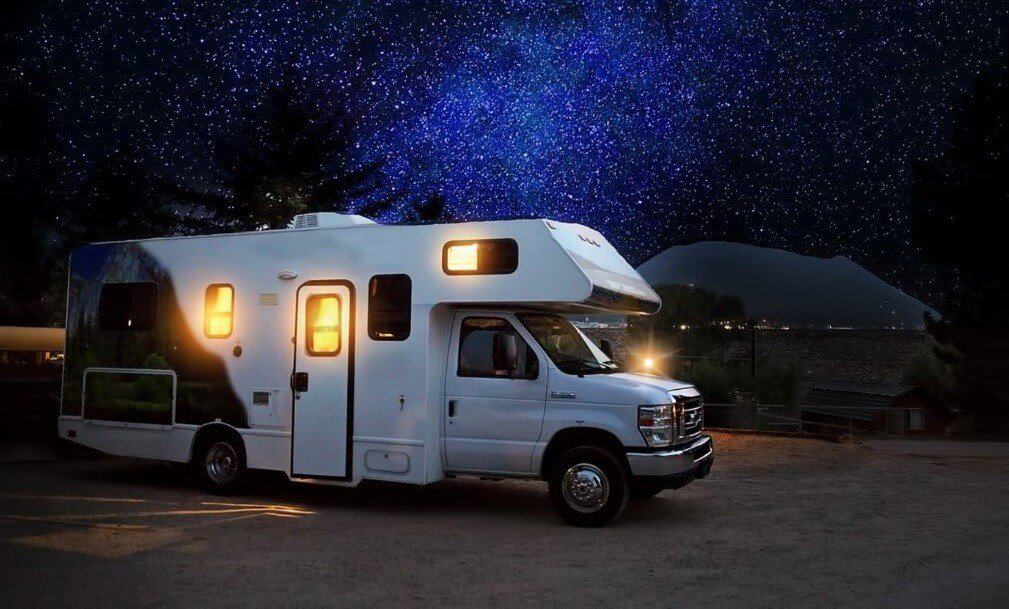
Do You Need a Camping Car Heater? How to Stay Warm on Long Trips

Top Camping Rules to Follow- Camp Like Mom Is Watching
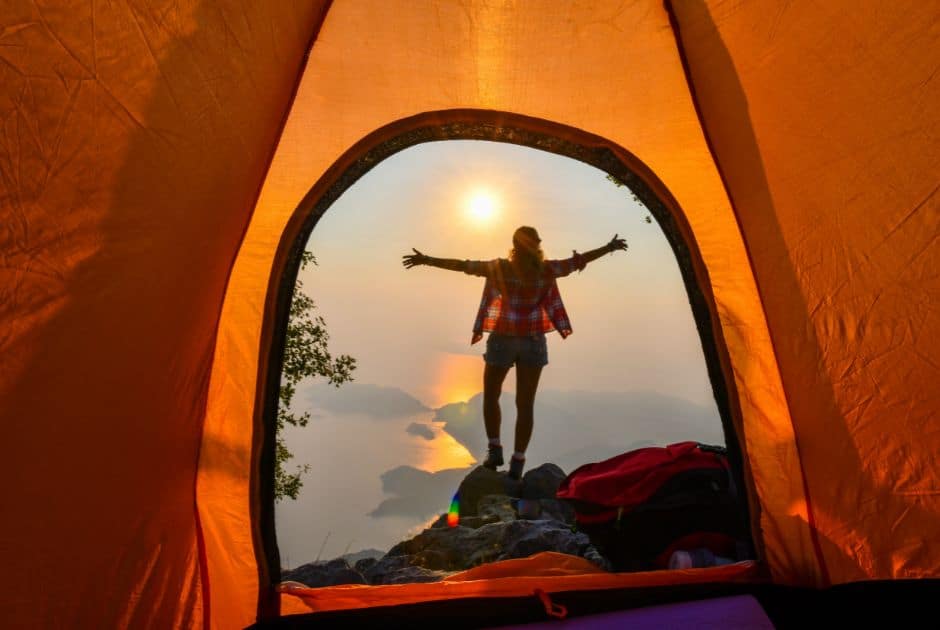
What is a Backpacking Cot Tent: 10 Things to Look For

Paradise Found: Pismo Beach Camping Delights
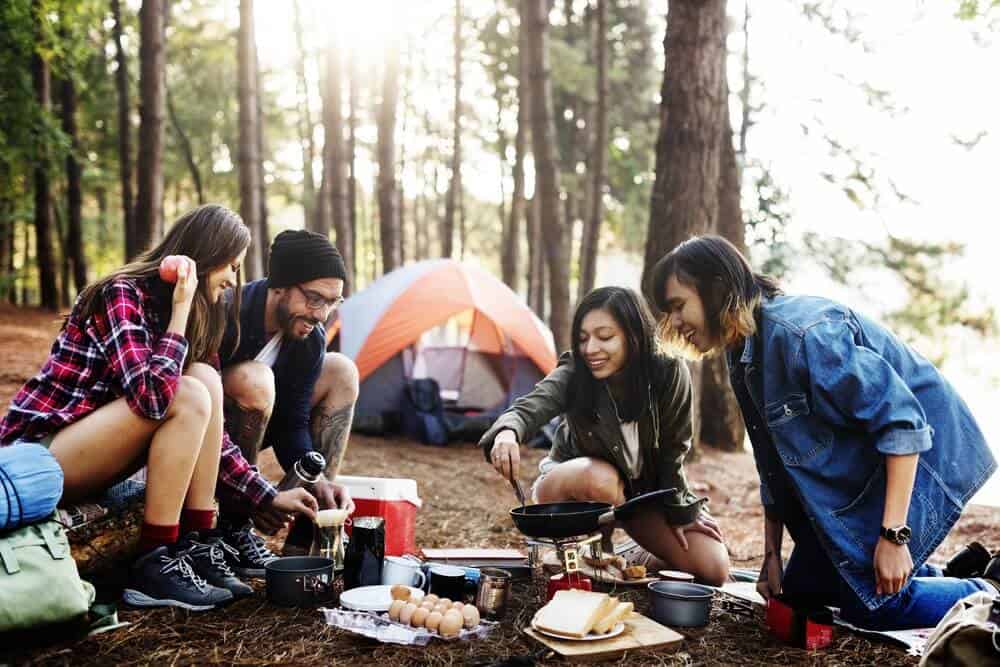
The Ultimate Camping Food List – Easy Camping Meals & Ideas

Best Hot Water Bottle for Camping: Top Picks in 2024

Black Friday Sales- Holiday Sales are ON!!!
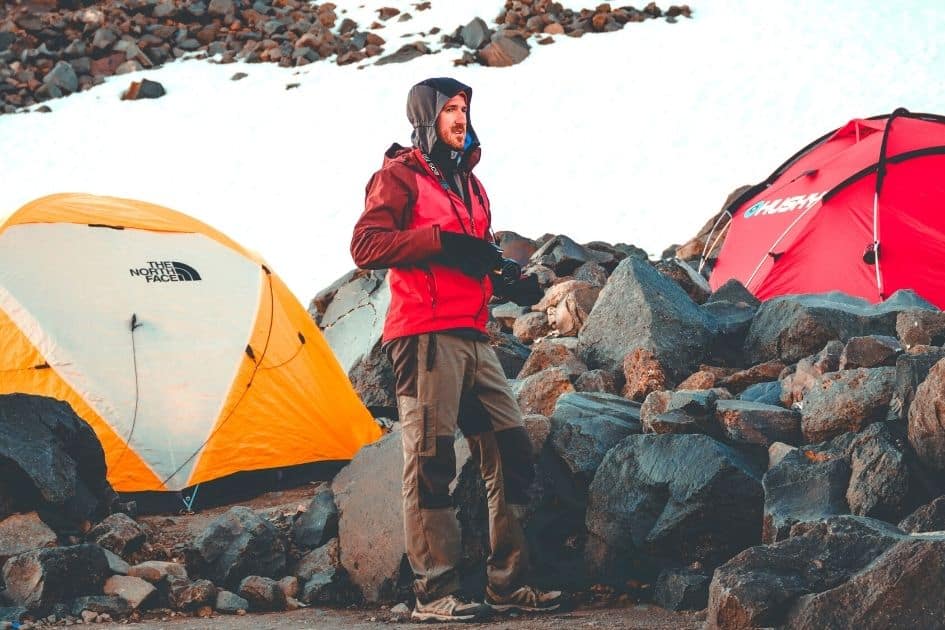
11 Best Mountaineering Tents According to Adventurers

Footprint Tent vs Tarp – Which One Holds Up Better?

The Ultimate Guide to Using a Tent Footprint

Family Camping Made Easy: Top 10 Camping Hacks With Kids

Best Tent Brands for Every Type of Camper: From Solo Adventurers to Family Outings

15 Best Backpacking Chairs of 2024 – Don’t Sacrifice Comfort
Last update on 2024-04-28 / Affiliate links / Images from Amazon Product Advertising API
Best Time to Visit
Weather & Climate
Kathmandu Airport Guide
Top Destinations in Nepal
One Week in Nepal
Tipping Guide
Getting Around
Top Things to Do in Nepal
Complete Guide to Kathmandu
Top Things to Do in Kathmandu
Top Things to Do in Pokhara
Sacred Sites
Amazing Festivals
Top National Parks
Must-Try Food
Annapurna Circuit
Manaslu Circuit
Himalaya Trail
Facts About Mt. Everest
Trek to Everest Base Camp
Everything You Need to Know About Trekking to Everest Base Camp
:max_bytes(150000):strip_icc():format(webp)/greg-rodgers-adventure-ed92646b25f247049e53af6d36f6c15f.jpg)
Jason Maehl / Getty Images
Everest Camp II
Trekking to Everest Base Camp in Nepal's Sagarmatha National Park is the adventure of a lifetime. Although actually climbing Mount Everest is out of reach for many of us, anyone with enough grit and good enough fitness can reach EBC and the Khumbu Icefall, the starting point for climbing Mount Everest. (You’ll need an $11,000 permit and some serious equipment to go any higher from there!)
The Himalayan scenery here is unrivaled on earth. Snowy sentinels will witness your struggle toward the top of the world , while stupas, prayer flags, and Sanskrit tablets will remind you of the spiritual significance of the area. Sadly, the numerous memorials to hikers who perished along the trail underscore the seriousness of your undertaking.
You’ll battle freezing cold, thin air, weather changes, and your own body as you ascend. Once at Everest Base Camp, you won’t even get to see the famous mountain itself unless you take a day to climb Kala Patthar (18,519 feet), an adjacent prominence that affords views of the “Holy Mother” when weather permits.
Read on for our complete guide to the Everest Base Camp trek, with information on what to pack, when to go, EBC tours, and more. Note that we’ll only cover getting to South Base Camp in Nepal, not North Base Camp in Tibet .
What to Expect
Trekking to Everest Base Camp involves hiking between lodges (or “teahouses”) found in villages along the trail. Some days may only consist of four hours or so of uphill trekking, depending on how much elevation is gained that day. Sometimes, you’ll have the option of pushing on to another village higher up—but no matter what, you will never gain more than 1,312 feet (500 meters) in a day.
Once above the tree line, the common rooms in your lodges will invariably be heated by yak dung-burning stoves. Weary hikers will hang around these stoves, warming themselves and socializing before retiring early to their unheated rooms. The shared toilets are sometimes located in snowy outhouses.
The village of Namche Bazaar (11,290 feet) is considered the last fully “civilized” stop on the trek to Everest Base Camp. Here, trekkers can enjoy treats from a German bakery while watching screened documentaries. You’ll find last-minute gear and souvenirs for sale along with the last ATM on the trail. You can even indulge at the “highest Irish pub in the world” on your way down after a successful trek!
When's the Best Time to Trek to Everest Base Camp?
The best time for trekking to Everest Base Camp is in either spring (March to May) or fall (September to November). If you want to see the camp in full form with climbers, support teams, and film crews, you’ll need to time your trip with spring climbing season, usually late April or early May. This is also the busiest time to be in Nepal .
For less traffic on the trails, consider making your trek to Everest Base Camp in September or October. Unfortunately, this means hiking in cooler weather with even less daylight than usual.
Avoid making the trek during monsoon season in summer. Humidity reduces beautiful views at lower elevations, and snowfall closes trails at higher elevation.
Adisorn Fineday Chutikunakorn / Getty Images
Should I Book a Tour or Go Independently?
There are three options for completing a trek to Everest Base Camp:
- Book a group tour and have all arrangements made for you.
- Make the trek to Everest Base Camp independently .
- Arrive in Nepal, then hire a guide and/or porter yourself.
No matter which option you choose, try to spend an additional day at Namche Bazaar. The extra time at 11,290 feet reduces some of the effects of elevation later; you’ll enjoy a better overall trekking experience and suffer less. The extra day isn’t “wasted”—many day hikes around Namche Bazaar provide beautiful views while giving your body time to adjust. Your chances of successfully reaching Base Camp vastly improve if you spend more time at Namche Bazaar.
Everest Base Camp Tours
Although the most expensive option by far, having everything organized before you arrive provides peace of mind. You’ll be taken care of all along the way, with access to better safety measures such as supplemental oxygen. Bigger companies use yaks to take your gear ahead; you’ll find it waiting for you in your teahouse room at the end of each hiking day.
You can book an Everest Base Camp tour online from home, or if time permits, do so after arriving in Kathmandu . Booking on the ground through a Nepalese agency saves money and better helps the local economy. You’ll find trekking agencies on every corner in Thamel, but unfortunately, not all are reliable. Choose a reputable agency that’s a member of the Trekking Agencies’ Association of Nepal . You can see in the member directory how long an agency has been in operation, and hopefully, make a better informed decision.
Independent Trekking
First, independently trekking to Everest Base Camp doesn’t necessarily mean solo trekking. Trekking alone in the Himalayas is dangerous no matter your experience level. A simple slip or unexpected weather change could keep you from reaching the next teahouse before temperatures plummet at night.
Independent trekkers can save a lot of money by foregoing organized tours and simply teaming up with other trekkers they meet along the way. (Everyone you meet in the lodges is going in one of two directions: up or down!) The well-marked trail to Everest Base Camp is busy during peak trekking seasons, giving you the best chance of meeting new friends who match your speed and fitness level.
Going independently does carry some risk, of course. You’ll be responsible for your own well-being and making important decisions. On the other hand, you’ll be able to set your own pace and make adjustments based on how well your body acclimatizes. A majority of hiker deaths on the trail each year occur when people in group excursions are suffering from Acute Mountain Sickness (AMS) but don’t speak up. They fear slowing everyone down, or don’t want to forfeit reaching Everest Base Camp.
If guiding yourself, pick up a good trail map in Kathmandu. Don’t rely solely on electronic devices for making survival decisions! You’ll also need to store your luggage at a trustworthy guesthouse or hotel in Kathmandu. Locking duffel bags and padlocks can be purchased in local shops; some owners will buy them back once you return from your trek.
Hiking Guides and Porters
Rest assured: Your pack is going to feel heavier at 15,000 feet than it does at home! Even as an independent trekker, hiring a local guide and/or porter are options. Hiring directly ensures money goes to the Sherpas instead of a Western tour agency that managed to rank well online. Expect to pay between $15 to $20 a day for a porter or $25 to $30 a day for a guide.
You’ll need to negotiate terms and contingencies before hitting the trail. Paying up to half of the porter’s fee up front is common, and you will also be expected to tip guides and porters after the trip. Finalize details and other expenses to avoid a potential disagreement. The agreed daily rate should include their meals, drinks, and accommodation so you aren’t asked for money later.
Guides will approach you on the street in Thamel, however, you should hire only a credible and licensed guide through either a trekking company or your accommodation. You may still be able to hire a porter later on the trail by speaking to the staff at your lodge.
How Much Does It Cost to Trek to Everest Base Camp?
The cost of trekking to Everest Base Camp depends entirely upon your needed level of comfort. One indelible rule holds on the trail: Prices rise as elevation rises. That 50-cent candy bar from Kathmandu is worth $7 at 17,000 feet!
Extremely basic accommodation in teahouses can be found for as low as $5 per night. You’ll be expected to have your meals where you stay. A hearty Nepalese meal of dal bhat can be enjoyed for $6 or less, but expect to pay much more for Western food. A can of Coke can cost up to $5; remember, it’s heavy and had to be carried up by a porter.
Other luxuries add to the cost of life on the trail. A (somewhat) warm shower can cost $5. Charging electronic devices and accessing the internet, if available, cost several dollars an hour, and the solar charging systems are often slow and provide only a weak charge. Depending on your food and drink indulgences, plan to spend $20 to $30 a day living on the trail. This excludes any fees you pay to porters and guides.
If not already covered, your greatest expense will be the short flight to and from Lukla. The 30-minute flight can cost around $180 each way.
Do You Need a Permit for Everest Base Camp?
You’ll need at least two permits for trekking to Everest Base Camp. Your tour organizer will probably provide these, but you’ll need to arrange them yourself if trekking independently.
- Sagarmatha National Park Permit: Get this at the Nepal Tourism Board office in Kathmandu (approximately $25).
- Khumbu Pasang Lhamu Rural Municipality Permit: You will get this permit from a checkpoint in Lukla; it isn’t available in Kathmandu (approximately $17).
- Gaurishankar Conservation Area Permit: You only need this permit from the Tourism Board if doing the longer trek to Everest Base Camp from Jiri instead of flying to Lukla (approximately $17).
The permit system changed in 2018. Disregard any information you read elsewhere about needing a TIMS card for the trek to Everest Base Camp.
Greg Rodgers
What to Pack
Kathmandu, particularly in Thamel, has more than enough outfitting shops for gearing up. Unfortunately, those same shops are stacked with counterfeit gear that probably won’t survive the hardships of the trek. Sifting through the piles of used gear in dark shops requires patience. Prices are inflated, so put your game face on and start haggling !
If you booked a guided tour, find out what your tour company plans to provide (e.g., hiking poles, down jackets, etc) before shopping. Consider bringing mission-critical items from home so that equipment failure doesn’t affect your experience. For instance, you’ll need quality sunglasses to prevent eye injury. Sunglasses for sale locally may have “UV Protection” stickers on them but don’t offer much actual protection.
- Good hiking boots. You should invest in high-quality, waterproof hiking boots and break them in properly before you leave home; painful blisters can ruin an otherwise-excellent trek.
- Lightweight sleeping bag. Rooms along the trek are unheated. Lodges provide weighty blankets for the freezing nights, but you'll appreciate having a layer between you and the unwashed bedding. Even a lightweight silk “sleep sheet” will do the trick.
- Alternate footwear. After removing your muddy hiking boots, a pair of lightweight shoes or sandals comes in handy for wearing around lodges and shared bathrooms.
- Water purification: As elevation increases, so does the cost of bottled water and need to reduce plastic waste. You’ll be drinking more than ever to counter dehydration in the dry air. Although there are many options, the two-bottle, chlorine dioxide system from Aquamira is a reliable solution.
- Trail snacks: Candy bars and nuts provide a much-needed boost to energy and morale while on the trail or in the lodge.
- USB power bank: Keeping batteries charged in the extreme cold is a challenge. If you plan to use a phone for photos or communication, you’ll want to bring along a rugged power bank.
- Diamox tablets: Diamox (acetazolamide) is medication for countering the dangerous effects of AMS. Guides should have some on hand, but independent trekkers will want to buy Diamox to carry. Beware of fake tablets for sale in Kathmandu. Purchase only from legitimate pharmacies—not from shops—and discuss how to use them.
If you won’t be taking your poles and other gear home after the trek, consider giving it directly to the Sherpas you meet in Lukla.
John Elk III / Getty Images
How to Get There
Fly into Kathmandu's Tribhuvan International Airport (KTM) and plan to spend a few days resting and preparing for the trek. Unless you’ll be starting the trek in Jiri—which requires a seven-hour bus ride and an additional five to seven days of trekking—you’ll need to book a flight to Lukla.
Taking the small prop plane from Kathmandu to Lukla (LUA) is one of the scariest and most scenic aviation experiences many travelers will have. Although not the highest airport in the world , weather and visibility changes have caused enough crashes at Tenzig-Hillary Airport in Lukla to earn it the title of “most dangerous airport in the world.”
The trek to Everest Base Camp begins in Lukla and finishes at the infamous Khumbu Icefall!
How Dangerous Is Everest Base Camp?
Although frostbite and rock slides are hazards along the trail, the biggest danger—by far—comes from the high elevation. Once symptoms of AMS begin (severe headache and nausea), you need to descend as soon as possible. Ideally, you’ll ascend slowly enough to minimize altitude sickness in the first place.
The CDC recommends never gaining more than 500 meters in one day and taking a rest day for every 1,000 meters gained. Whenever possible, you should descend to sleep at a lower elevation than the highest point reached during the day. Track and do the elevation math as though your life depends on it.
The high elevation and thinner air introduces additional risks. For one, your body will increase its production of red blood cells, causing excessive urination; be sure to drink plenty of water to avoid dehydration. Many trekkers will also experience the dry, hacking "Khumbu cough" from panting heavily in the thin air and breathing in the dust of the region. You can cover your face with a bandanna or balaclava for some protection. The cough usually goes away after time. Ultraviolet rays, too, are more damaging in the thinner air, so protect your skin, lips, and eyes by applying high SPF sunscreen and lip balm, wearing long sleeves, and donning sunglasses.
Finally, yak trains always get the right of way! Never share a bridge crossing with one, and always pass them on the “inside” of the trail. Startled yaks are unpredictable and sometimes knock trekkers off the trail.
Additional Tips
- Take your stocking up on snacks seriously. Pack candy bars, even if you wouldn’t ordinarily indulge at home. You’ll experience strong cravings at higher elevation. Hikers are willing to spend $7 or more for Snickers bars near Everest Base Camp!
- The weather in the Himalayas changes quickly and unpredictably. Flights to and from Lukla frequently become delayed by a day or two, maybe longer if a winter storm system sets in. Add some buffer days to your Kathmandu itinerary just in case this happens.
- Before retiring to bed, ask your teahouse staff to pour boiling water into your bottles and use them as bed warmers. Fair warning: They’ll probably be frozen next to you in the morning!
- Sleep with your phone and any batteries in the bed with you. Your body heat will protect battery life a little.
- Weight limitations imposed by airlines that fly to Lukla are strictly enforced. If an airline says 33 pounds (15 kilograms), that includes all baggage , stowed or carried. Don’t risk having to forfeit gear in Kathmandu Airport because you’re a pound or two over the allowance. You can stuff some items into your pockets, within reason.
How to Go Teahouse Trekking in Nepal
The Best 12 Hikes in Nepal
Solo Trekking in Nepal's Everest National Park
How to Choose and Prepare for a Hiking Trip
Independent Trekking in Nepal
The World's Highest Places and Attractions That You Can Visit
Five Amazing Hiking Routes Among the High Mountains of the Himalayas
The Most Beautiful National Parks in Nepal
A Guide to Tipping in Nepal
The Complete Guide to Climbing Morocco's Mount Toubkal
Nepal's Great Himalaya Trail: The Complete Guide
How to Trek Nepal's Manaslu Circuit
The Different Types of Adventure Travel
The Top 15 Destinations in Nepal
Where Is Mount Everest?
How To Do The Everest Base Camp Trek In Nepal
The Mount Everest Base Camp Trek in Nepal is one of the world’s best bucket list hikes. In less than 2 weeks, you can trek to the foot of Mt Everest and other snowy peaks in the Himalayan mountains.
The good news is that it’s not a super difficult hike, and you don’t need a big budget to do it. The EBC trek is worth it for the fun and accomplishment alone, but you also get views of the Himalayas that are out of this world.
This travel guide will explain how you can do the Mt Everest Base Camp hike independently (with or without a tour guide), along with a recommended packing list and everything else you need to know before you go!
Best Everest Base Camp Tours
First of all, if you’d rather skip the hassle of planning your own EBC Trek, Klook has Everest Base Camp Tours starting as low as $900 USD for a full 12-day trek.
You may be able to find something cheaper than this once you land in Kathmandu, but booking online with a vetted tour company has some big advantages, and the reviews on their website are very positive.
We’ve used Klook for lots of tours and activities around the world, and they’re great! Highly recommended.
Book Now: Everest Base Camp Tours

When To Do The EBC Trek
The Mt Everest region has 4 different trekking seasons:
- March – May: High season. Best weather, with stable temperatures and bright sunny days, but the trails can get crowded. During these months you may share the EBC trail with pro climbers on the way to go summit Everest.
- June – August: Monsoon season. There’s a lot more rain during these months, and the trails are mostly empty.
- September – October: Clear days and busy trails. This is one of the most popular trekking seasons.
- November – February: Coldest season, but the weather is stable and dry. The trails are mostly clear.
I trekked in early February, and even though it was nice having the trail mostly to myself, the cold in the evenings and mornings was straight up misery.
My home state of Missouri can get very cold in the winter, but the cold has just never been my thing. If I could go back and change it, I would definitely do my Everest Base Camp hike later in the season.

Everest Base Camp Weather
Temperatures on the Mt Everest Base Camp Trek can range from 5 °C (40 °F) to 20 °C (70 °F) depending on month, and as low as -30 °C (-22 °F) at night during the winter months.
If you trek during the warmer months (Mar-May and Sep-Oct), the cold is not a big problem and shouldn’t be hard to cope with. Winter is a different story. Your snot will freeze in your nose at Gorak Shep.
Sunshine is key for winter trekking in Nepal, and thankfully you should have lots of sun in most months outside of the monsoon season. On my February hike, I often found myself shedding all my layers while trekking because I was heating up in the sun.
If you do your Everest Base Camp hike during the winter, the biggest issue is staying warm in the evenings and at night. For this, you’ll definitely want a top quality down jacket and sleeping bag.

All About Everest Base Camp Trekking
My everest base camp itinerary.
- Day 1: Kathmandu to Lukla to Benkar .
- Day 2: Benkar to Namche Bazaar .
- Day 3: Namche Acclimatization Day .
- Day 4: Namche to Deboche .
- Day 5: Deboche to Pangboche .
- Day 6: Pangboche to Dingboche .
- Day 7: Dingboche Acclimatization Day .
- Day 8: Dingboche to Thukla .
- Day 9: Thukla to Gorak Shep .
- Day 10: Everest Base Camp .
- Day 11: Kala Patthar to Gorak Shep to Pheriche .
- Day 12: Pheriche to Namche .
- Day 13: Namche to Lukla .

If you ever need motivation to keep going on the Everest Base Camp hike, just look at how much the porters are carrying!

Mount Pumori as seen from the Kala Patthar viewpoint, just a short distance from Mt Everest Base Camp.

Ama Dablam, one of my favorite mountains on the Mt Everest Base Camp Trek.
EBC Trek Packing List / Gear
This isn’t a complete list of everything to bring on a Mt Everest Base Camp Trek, and you may have to change things up a little depending on what month you go, but these are just some of the basics.
You can find most of this gear in Kathmandu, but in my opinion you’ll get higher quality and a wider selection if you order online.
- Beanie: I only wore this at night, but it definitely helped keep my ears warm.
- Down Jacket: Bring the biggest, warmest DJ possible. This is your most important piece of gear. You can use it as an extra cover at night.
- Fleece Sweater: This is the only jacket you’ll need to wear while trekking most days, especially if it’s sunny.
- Shirts: Something comfy with quick dry material.
- Trekking Pants: Something lightweight and breathable.
- Thermal Underwear: May not be needed if you trek in the warmer months.
- Gloves: I only wore these at night, but they definitely helped keep my hands warm.
- Socks: Merino wool is best for staying warm and stopping moisture.
- Headlight: Smart to have at least a small one, just in case.
- Tumbler: 1 liter water bottle to refill daily on the trek.
- Sunblock: It’s easy to sunburn at high altitudes. A small bottle is plenty.
- Sunglasses: Good for snow. May not be necessary unless you plan to hike a mountain pass like Cho La.
- Hat: I wore old faithful throughout the hike.
- Watch: An altimeter watch would be fun to play with here.
- Camera: Duh. You can’t do the Mt Everest Base Camp Trek without taking lots of pictures.
- Power Bank: Bring a big power bank and you might only need to recharge it once on the whole trek.

Everest Base Camp Trek Cost
For a 13 day trek, I paid about $21 USD per day for food, drinks, and room. Porter/guide was an extra $25 per day, although it’s not a requirement. Flights to Lukla were $330 return, but again not a requirement if you hike in.
You can read the sections below for more info on the daily trekking costs and what you get for your money. It’s not a very expensive trek, all things considered!
Keep in mind, these numbers are from 2020. They’ll go up a little over time. Exchange rates may also vary, so check the latest rates .

The flight to Lukla from Kathmandu is $165 USD each way. You can shop for flights to Lukla at Skyscanner.
If your budget is tight or you have extra time, you can skip this flight by hiking from Jiri to Lukla rather than flying. It only adds a couple days to the itinerary.

Guide / Porter / Solo
You can do the EBC trek with a guide, porter, OR independently (solo).
A guide will show you the way to Mt Everest Base Camp and help with lodging, navigation, advice, taking pictures for you, etc. A porter-guide will do these same things and also carry a 20 kg (45 lb) pack for you.
A porter or guide is NOT a requirement to do this hike, especially if you go in the warmer months when you may not need as much gear. In 2023, they were supposedly introducing a guide requirement for EBC, but so far that has not been enforced at all, thankfully.
With that said, there are some good advantages to hiring a guide, and it’s pretty cheap by Western standards. A porter is only $15 or $20 USD per day, and a porter-guide is $25 per day. A popular arrangement is to hire one porter for two hikers, splitting the cost and still making things easier for both of you.
In the end, this all depends on your budget and hiking preferences.

Hiking Fees
If you’re hiking EBC independently, you’ll need to be aware of two fees you have to pay near the start of the trek.
There’s a local government tax that they’ve now started collecting in Lukla. This one is currently 2,000 Rupees ($17 USD).
There’s also an Everest park fee/ticket you have to pay at the Sagarmatha National Park entrance just beyond the small village of Monjo, Nepal. This one is currently 3,500 Rupees ($30 USD).
No TIMS card is needed anymore for independent hikers. That fee has been retired for the Mount Everest Base Camp Trek.

Accommodation & Amenities
Throughout the Everest Base Camp hike, you’ll stay and sleep at small guesthouses along the way, called teahouses.
This is where you get your meals and drinks for the trek, along with the occasional amenities like showers, charging, or WiFi. The teahouses start out decent, but quickly get more shabby as you go further up the trail.
You have to pay for everything you use, of course, and the prices get quite high as you go, because everything has to be hauled up on the backs of the poor porters.

Guesthouses
The teahouses on the EBC trek are cold and dingy, with drop toilets and cracks in the walls. Don’t expect luxury.
Most rooms are free as long as you buy your meals there (the meals are how they make their money). If you stay at a lodge and don’t eat there, you’ll be expected to pay for the room.
In some cases, I was charged 500 Rupees for a room on top of my meal costs. I’m not sure why some teahouses do this and others don’t, but I never paid more than 500 Rupees for a room, and most were free with the meals.

Food & Drink
I’m happy to report that the food and drinks on the Everest Base Camp hike are top notch, especially after you’ve worked up an appetite trekking.
You have western food choices, or the standard local staples like veggie fried rice, steamed momos (dumplings), and mushroom soup. Everything was hot and fresh. Meal prices for these ranged from 250 to 750 Rupees depending on altitude. Not too bad.
For drinks I tried hot chocolate, lemon/apple/mint tea, and occasionally bottled water for my tumbler. These ranged from 100 to 400 Rupees. If you want to avoid plastic bottles, there’s usually boiled water available and this is safe to drink too.
Getting enough water on the trek is never a problem. Just fill up a 1 liter tumbler in the morning, and this will last you until evening, especially since you’re likely to pass more tea houses along the trail as you’re hiking throughout the day.

Showers are only available at a few lodges, depending on the season and how high up you are, and they cost 600 to 1200 Rupees. In the winter, water higher up will be frozen most of the time.
I never had a shower on my February EBC trek, and that seems to be the norm (although I got one or two opportunities in Namche). Yes, it’s gross. I could smell myself by trek’s end, and it wasn’t pretty.
But aside from the fact that I hate to fork out money for something as basic as a shower, I also never really got close to other people for very long on the trek, so I didn’t feel too guilty about it.
Most days were cold enough that the thought of stripping down for a shower was not really appealing, either. Your best bet is baby wipes and deodorant.

WiFi / Cell Service
WiFi costs anywhere from $5 to $10 USD per day if you buy it from the teahouses.
Alternatively, you can buy a 10 GB/30 Day Everest Link WiFi card in Namche Bazaar and use this for the entire EBC trek. During my Mount Everest Base Camp Trek the WiFi was down across the whole region, so unfortunately I wasn’t able to use either of these options.
I bought an Ncell local SIM card in the Kathmandu airport and had 3G service for half the days of the Everest Base Camp hike. Coverage is still improving in the area, so if you need to stay connected I’d definitely bring a local SIM.

Electricity
All of the teahouses on the way to Mt Everest Base Camp sell outlet charging for electronics, and the prices range from $2 to $10 USD for a full charge, depending on how far up the trail you are.
The key is to bring a big power bank and then use this to charge all of your other electronics (phone, camera, etc). I did this and only paid once to recharge my power bank on the whole trek.

How Much Cash To Bring
Everything you buy during the Everest Base Camp hike (meals, WiFi, charging, etc) will have to be paid for with cash. Credit cards won’t work. There are no ATMs outside of Lukla and Namche Bazaar (Days 1-4), and even the ATMs there are not reliable.
What this means is that you’ll have to withdraw enough cash (Nepalese Rupees) at an ATM in Kathmandu to cover your entire trek. The ATM fees will bite you, and I hate to carry large amounts of cash, but it’s not really avoidable here.
All up, I spent about $20 USD (2,400 Rupees) per day on the Mount Everest Base Camp Trek, and never spent more than $25 USD in a single day. With that said, I didn’t splurge on WiFi, showers, charging, or alcohol. The only things I bought were the bare necessities: room, food, and drinks.
If you hire a porter/guide, you don’t need to factor that into your daily cash carry. That’s paid before the trek starts. But do reserve a little cash for a decent tip.

Mount Everest Base Camp Trek Difficulty
I’m not going to lie, this is a difficult trek. And if you do it in the winter like I did, it’s even harder. With that said, if you are in decent shape, determined, and obey the guidelines for altitude sickness prevention (more on that below), then you’ll have no problem reaching base camp.
There is a lot of elevation gain and loss on this hike. At times near Lukla, the constant ups and downs will make you feel like you’re hiking a roller coaster, but the trail is never too steep or dangerous. After Namche, it’s mostly a slow uphill plod.
This trek has been completed by old seasoned hikers in their 70s, and young kids in their pre-teens. It’s also been flunked by healthy 20-30 somethings who try to push through it quickly without enough acclimatization to altitude.
Patience and discipline are key for trekking to Everest Base Camp. Slow and steady wins the race here.

Trekking Distance
The one way trekking distance from Lukla to Mt Everest Base Camp is about 65 kilometers (40 miles).
That means the total roundtrip distance of an EBC Trek is about 130 kilometers, even if you don’t do any of the detours.
Don’t let that scare you off. It’s a lot of hiking, but every step is worth it.

Altitude Sickness
By far your biggest danger on the Mount Everest Base Camp Trek is altitude sickness, also known as Acute Mountain Sickness (AMS).
No one is immune to this, and it doesn’t matter how fit you are. If you gain altitude too fast, you can get sick and in some cases even die. Plenty of people have died from AMS on the EBC Trek.
The problem is that overzealous hikers push the envelope on this hike all the time, and a lot of them end up needing a very expensive helicopter evacuation to lower ground.
The best way to avoid altitude sickness is to go slow . At altitudes above 3,000 meters (10,000 feet), don’t increase your sleeping elevation by more than 300-500 meters (1,000-1,500 feet) per night.
Every 1,000 meters (3,000 feet) you should also spend a second night at the same elevation. If you get a bad headache, dizziness, or nausea, descend to a lower altitude until you feel better. As long as you follow these general guidelines, you shouldn’t have any issues.
You can take Diamox (acetazolamide) on the trek for extra AMS prevention. This medication can be found in Kathmandu or Namche. I bought mine in Namche and it seemed to help my headache and slight foggy feeling. I didn’t have any side effects aside from the usual tingling toes/fingers.

Everest Base Camp Altitude
The Mount Everest Base Camp altitude is 5,364 meters (17,598 feet). At this elevation, there is 50% of the oxygen at sea level.
However, most treks also go to Kala Patthar, a viewpoint even higher than base camp where you can get the best views of Mount Everest.
The elevation at Kala Patthar is 5,644 meters (18,519 feet). From there, you’ll be rewarded with an incredible panorama of Mount Everest and other icy peaks like Pumori, Lhotse, and Nuptse.
Happy travels!

If you’d rather skip the hassle of planning your own EBC Trek, Klook has Everest Base Camp Tours starting as low as $900 USD for a full 12-day trek.
You may be able to find something cheaper than this once you land in Kathmandu, but booking online with a vetted tour company has some big advantages, and the reviews on their website are very positive for this Mt Everest Base Camp tour.
More Nepal Travel Tips
Hopefully you were helped by this guide for the Everest Base Camp Trek. Let me know in the comments below if I can help answer any questions.
Don’t forget to check out my complete Nepal Travel Guide with tips, info, photos & more!
You may also like
How to visit dhigurah island: budget paradise in maldives, 10 best hikes in aruba: family friendly trails, how to visit tanjung puting national park in indonesia, sanur bali travel guide: 23 best things to do, coron vs el nido: which is better all differences explained, banggai islands travel guide & itinerary for sulawesi.
So much useful detailed information.
Thanks for the straight forward information. Beautiful photos

Leave a Comment Cancel Reply
Save my name, email, and website in this browser for the next time I comment.

Everest Base Camp Trek: The Ultimate Guide
Jackson Groves
Posted on Last updated: August 10, 2023
Categories NEPAL , HIKING
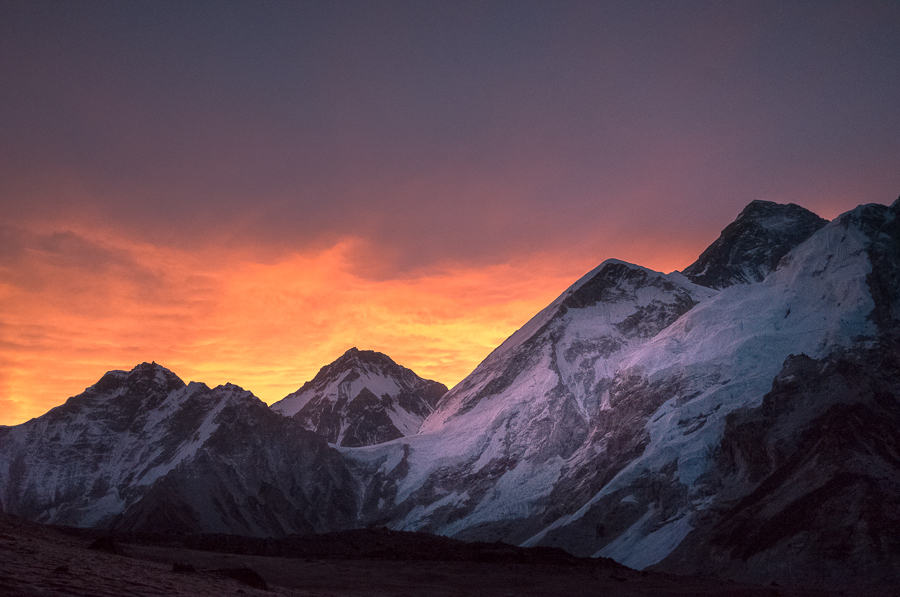
Mt. Everest is the highest mountain in the world and trekking to the base camp is no easy feat either. It’s a journey through some of the most spectacular mountain views but also through a number of beautiful villages along the way. The Everest Base Camp Trek takes anywhere from 9 to 15 days depending on your route and itinerary but also how well you acclimatize.
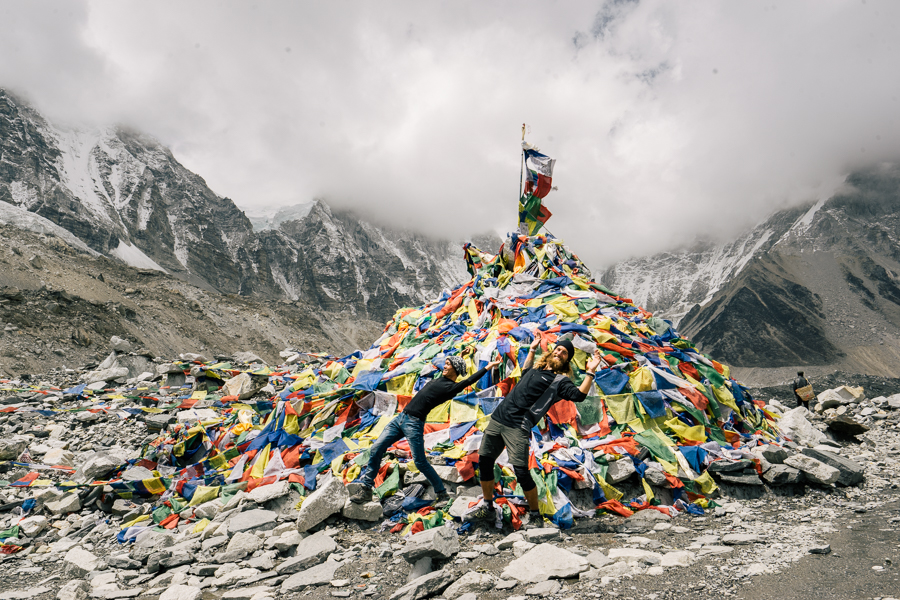
In this article, I will cover everything you need to know about the logistics of the Everest Base Camp (EBC) trek but I will also share with you my experience on each day of the trek. A short journal entry with a vlog from my experiences from each day will give you an idea of what to expect and you can see how the journey went for me. After sharing my experience, I will then include all of the information you need to know in this complete guide about trekking to Everest Base Camp.
BEST TREKKING COMPANY IN NEPAL
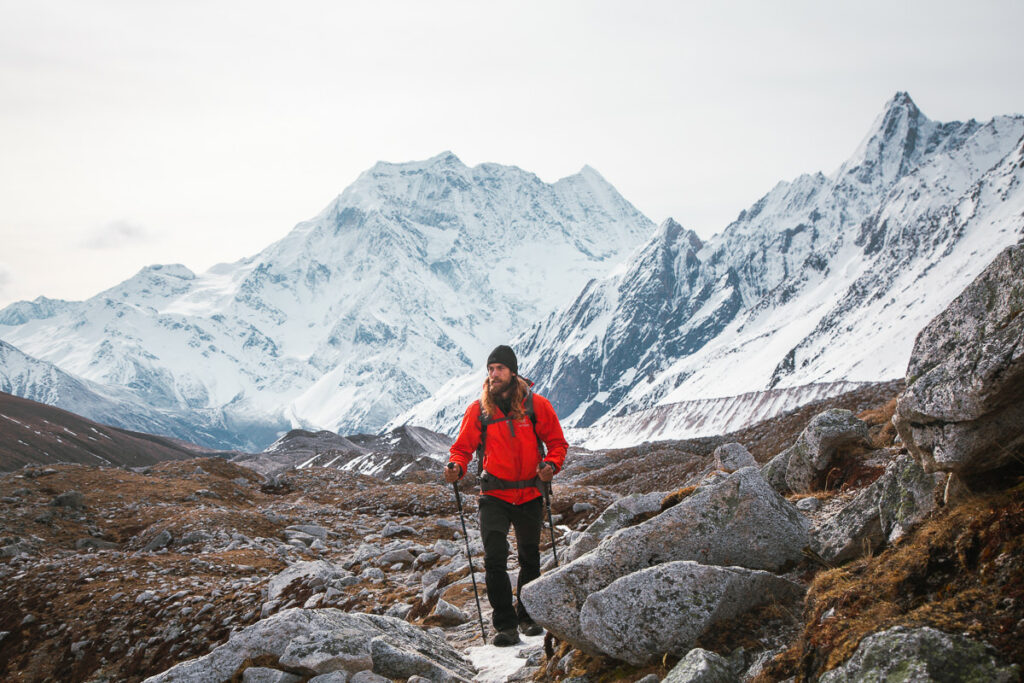
Interested in trekking in Nepal or doing the Everest Base Camp Trek? I recommend booking your trek with Himalayan Masters , which is the company I use for all of my treks in Nepal. Use my code JACKSON5 when you book to receive a 5% DISCOUNT .
Table of Contents
EVEREST BASE CAMP TREK DETAILS
- Distance : 120 km round-trip from Lukla to Base Camp and back to Lukla (You will fly to Lukla from Kathmandu)
- Days required : 12 -14 days
- Total Incline : (Undulation) – 6015 m
- Total Decline :(Undulation) – 5821 m
- The highest point on the trek : 5640 m/18 500 ft, this is actually at Kala Patthar, which you will hike to in the morning after reaching Everest Base Camp. This is where you get the best views of Mount Everest.
- Difficulty : It’s hard for an average hiker but the altitude is definitely more difficult to manage than the distance with several rest days and acclimatization days.
- Permits : Your tour operator will take care of these but in case you do the trek independently it’s good to know that you will pay a Local Government fee and Sagarmatha National Park permit, which totaled together cost about $40-$50
- Cost per day : This will depend on your tour price and whether you do the trek with a group, a porter, a guide, or independently. Somewhere between USD $40 (without flights) $60 per person per day with all meals, transport, and guides included.
- Guide : It isn’t required but highly recommended. You can do the Everest Base Camp Trek in a few different ways such as by yourself with no guide, with an experienced guide or in a group with a guide.
- Accommodation : Guest Houses, also known as Tea Houses along the way where you will sleep in a comfortable bed and have access to showers (extra charge) and restaurant facilities. Very comfortable accommodation and great after a long day of hiking.
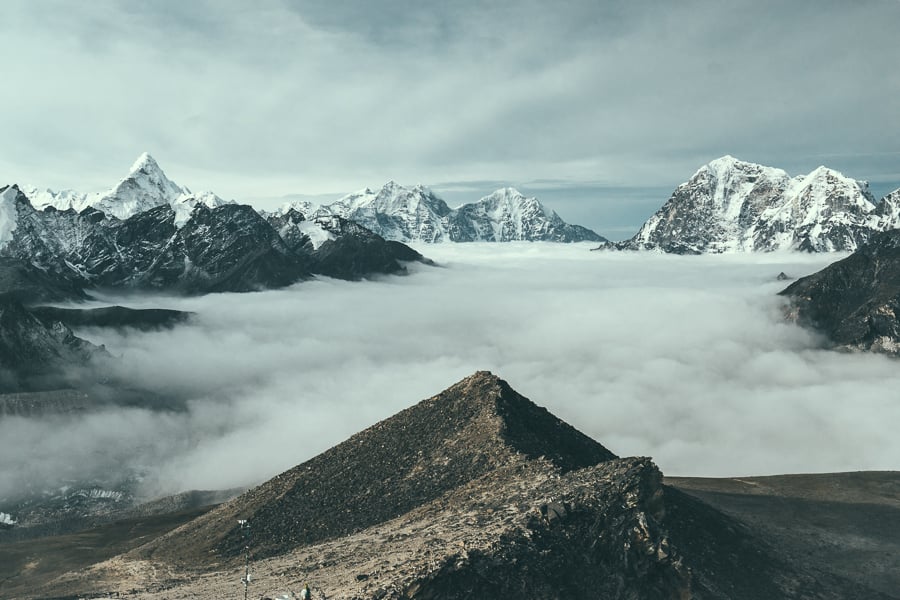
TRY THE 3 BEST TREKS IN NEPAL

Manaslu Circuit : My personal favorite 2-week trek through Tibetan villages and stunning scenery. Less crowded and more authentic.
Annapurna Circuit : The most beautiful & scenic 2-week trek in Nepal although can be crowded at times.
Everest Base Camp Trek : The most iconic 2-week route reaching the famous (EBC) Everest Base Camp at 5,300m.
BOOKING A GUIDE FOR THE EVEREST BASE CAMP TREK
The Everest Base Camp Trek doesn’t require a guide but it’s great to have a guide managing the logistics such as directions, tea-houses, distances, medical issues, and the overall organization. I’d say 90% of trekkers go with a guide. I highly recommend booking with Himalayan Masters which is one of the top trekking companies when it comes to the Everest Base Camp Trek. I’ve trekked many different routes in Nepal with them and I’m a big fan of their attention to detail.
The trek costs around $1500 USD with Himalayan Masters as of 2022 and includes all transfers, accommodation, meals, drinks, permits, and even the hotel stay before and after the trek at a high-quality hotel. I honestly had a great time on this trek and I can wholeheartedly recommend Himalayan Masters.
You can use my discount code ‘ JACKSON5 ‘ for 5% off the total price of your trek with Himalayan Masters which is a pretty handy saving.
Email: [email protected]
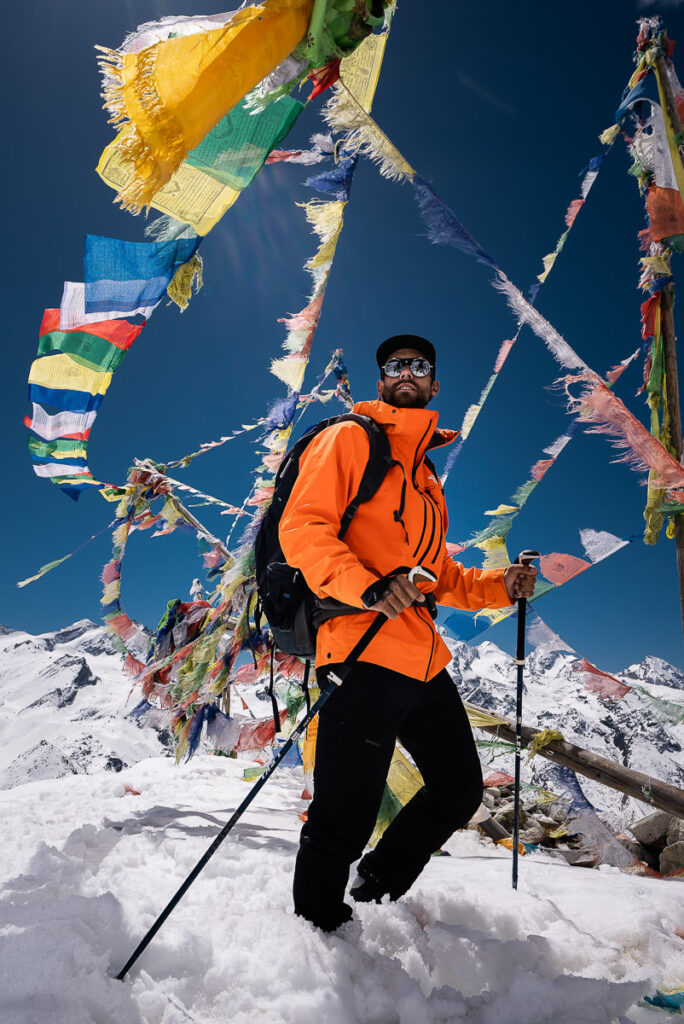
TOP 3 PLACES TO STAY IN KATHMANDU

- Ultimate Luxury: The Dwarika’s Hotel – Luxury, Spa-service, Pool
- Best Value : Aloft Kathmandu Thamel – Swimming Pool, Gym & Great Restuarant
- Budget Choice: Hotel Jampa is easily the top cheap hotel in Kathmandu
MY EXPERIENCE ON THE EVEREST BASE CAMP TREK
I’d like to share with you my experience and photos from my two weeks of trekking to Everest Base Camp. I hope you enjoy recounting the journey as much as I did.
Day One, Two & Three: Kathmandu to Lukla to Phak Ding to Namche
Day one began with an incredible flight from Kathmandu to Lukla. Unfortunately for me, I had come down with food poisoning the night before the trek so it was a rough start for me but I decided to battle on. The flight gives you incredible views of the Himalayas before you touch down at Lukla Airport, one of the most famous and scariest airports in the world. The landing strip is on a downwards slope and gives passengers a heart-in-mouth moment on take-off and landing.
After landing, we had a quick coffee and look around Lukla before making the short and relatively flat trek through the villages and forest to reach Phak Ding. Day one is a short trek but you have made your way up pretty high even just by landing at Lukla Airport so it is not a bad idea to take the first day easy, given that your biggest battle on this trek will be the altitude, not the distance or speed.
Day Two for me was actually a day of recovery in Phak Ding where I spent the entire day sick in the guesthouse. There is usually one day scheduled on your itinerary for sickness or rest day so I had used mine early!
Day three was a tough day as I was still recovering but we made the climb up to Namche, which is a winding climb through the forest and out above the tree line. Namche Bazaar is located at an altitude of 3450m inside the Sagarmatha national park, a UNESCO world heritage site and it is actually known as the last frontier for trekkers and climbers before the trek to Everest Base Camp starts to get serious.
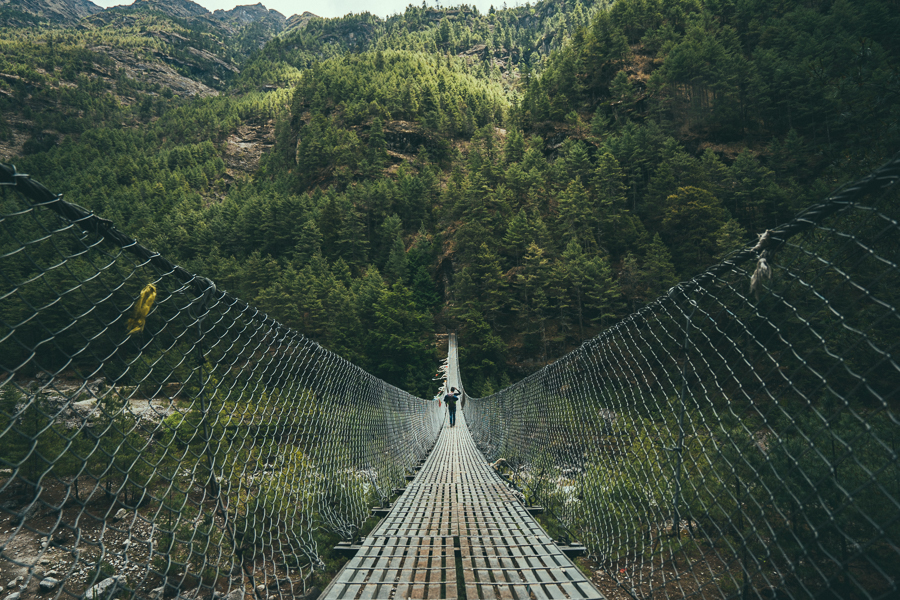
Day Four & Five: Namche to Tengboche to Dingboche
Day four is a big day of climbing. Namche Bazaar is 3,440 meters and Tengboche is 3,860 meters but the constant undulation on the trail means you will climb almost 900 meters of incline throughout the day.
The day begins by following the valley wall as you get some great views of the Everest mountain range out in front. The path then heads down into the valley floor as you lose a lot of elevation. However, you will then cross over the river and gain all the elevation back as you approach Tengboche where you will stay for the night.
Expect to have views of the mighty mountain Ama Dablam as well as Lhotse, Nupste, and even the peak of Mount Everest. Interestingly this will be one of the best views you have of Mount Everest until you reach Kala Patthar in a few days’ time.
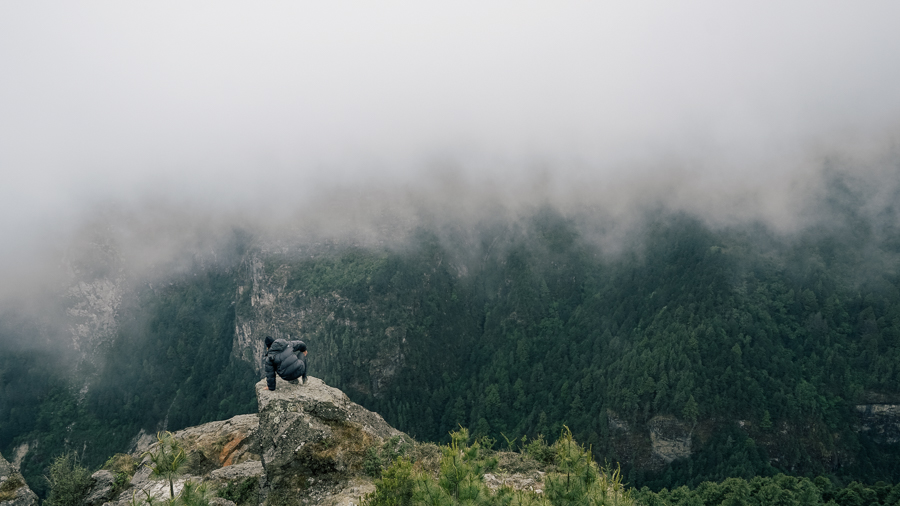
On day five of the Everest Base Camp trek, you say goodbye to the village of Tengboche and head towards Dingboche. It is a stunninng day as you voyage through the valley as the glacier river flows down below while snow-capped peaks loom in the distance. Along the trek, you will stop for tea in the village of Pangboche with lots of views of Ama Dablam mountain .
The elevation gain on day five is 700 meters and the entire journey will take about 5-6 hours at a moderate pace. Dingboche is 4,400 meters above sea level so it’s common to start to have a couple of symptoms of altitude sickness at this stage of the trek.
When you leave Tengboche, you begin a descent into the beautiful forest and can enjoy the shade as you pass through the village of Deboche. After you pass through Deboche, the trail gains some elevation and you will cross a suspension bridge, which guides you to the left side of the valley. Ama Dablam is still in view as you navigate the steep sections of the incline.
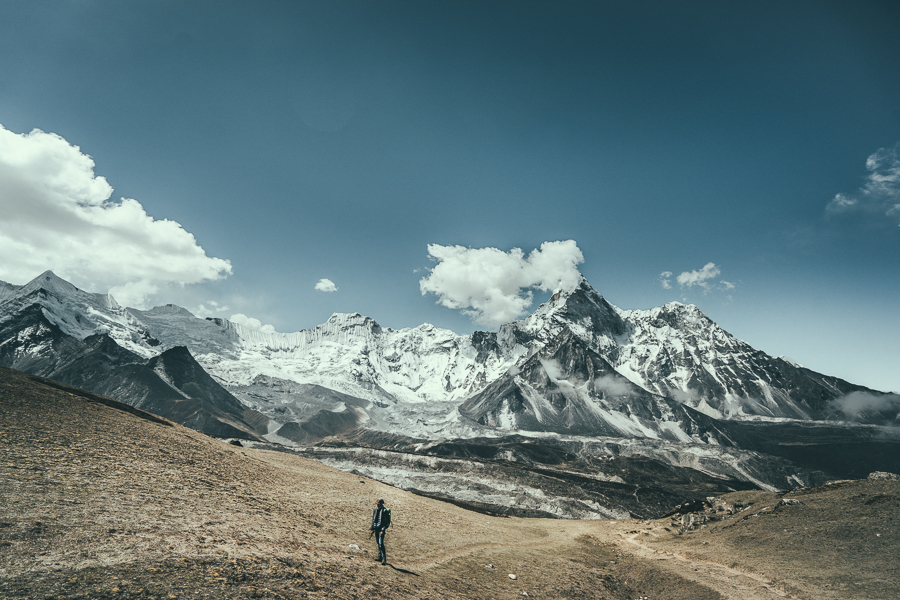
Day Six & Seven: Chuukhung Ri Acclimitization and Dingboche to Lobuche
Day six was an acclimatization day up to Chukhung Ri viewpoint, which was actually one of my favorite days. Because we would stay a second night in Dingboche, we left our bags in the tea house and did the climb up and down Chukhung Ri to help our bodies adjust to the altitude. The idea is to hike high and sleep low, which helps the body adapt.
Chukhung Ri is actually at 5500 meters, which is more than 1000 meters above Dingboche. This is a steep climb and you don’t need to go all the way to the summit. However, with spectacular views, isolation from other hikers, and a good chance to help your body adapt to the altitude, it’s a great day excursion with incredible scenery.
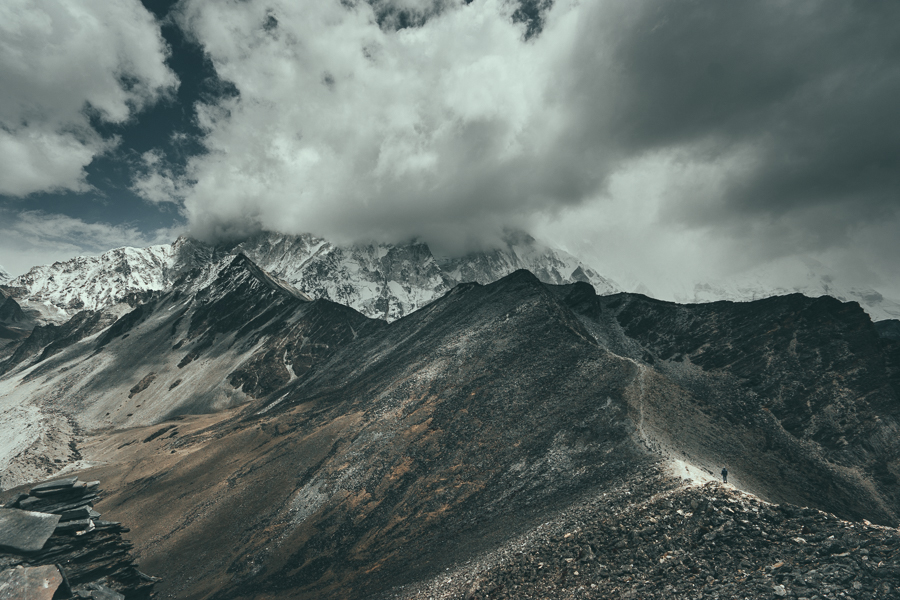
On day seven of the Everest Base Camp trek, we hiked from Dingboche to Lobuche, which is actually the second-highest village on the entire trail. Today is also the first time we will see the Khumba Glacier, which is one of the highlights of the trip.
The total elevation change for day seven is 500 meters in altitude but you will climb 600m in total for the day taking into account a few downhill sections on the trail. It’s a shorter day taking just four hours to reach Lobuche from Dingboche.
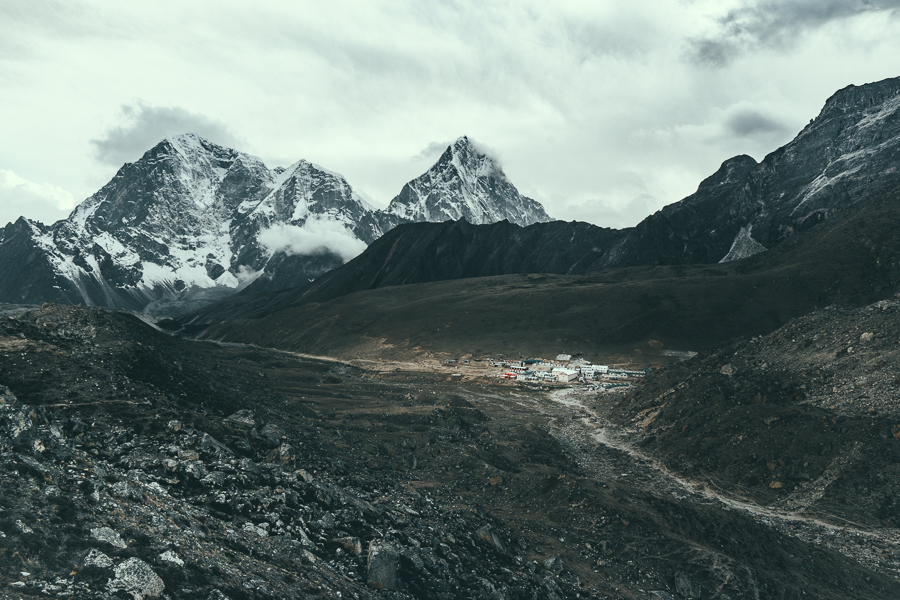
Day Eight: Lobuche to Gorak Shep to Everest Base Camp
On day eight of the Everest Base Camp trek, it is finally time to reach Everest Base Camp. From Lobuche your first trek to Gorak Shep, which is the highest village you sleep at throughout the trek.
Gorak Shep is a small village, and it’s the closest to Everest Base Camp is also the closest village to Everest Base Camp. Basically, you will trek to Gorak Shep, have an early lunch, and drop off your bag before doing the round-trip trek to explore Everest Base Camp. Then you will return to Gorak Shep where you will stay the night before heading to the nearby Kala Patthar in the morning.
The journey from Lobuche to Gorak Shep is along a rocky path, which slowly gains elevation as you walk next to the Khumbu Glacier. From Gorak Shep to Base camp, you will reach an altitude of 5,364m, which won’t be the highest on the trek as you will go higher the next morning at Kala Patthar.
When you leave Gorak Shep you walk next to the Khumbu Glacier with the Everest Mountain Range looming behind. The glacier is covered in dust and rocks due to the sediments, which have been falling from the surrounding peaks over the last years.
The trail continues alongside the glacier until you reach Everest Base Camp. It’s interesting because you actually can’t see Mount Everest from the base camp, which surprised me but the surrounding peaks are still very impressive and dramatic. Depending on if you come during the climbing season or off-season will alter how the base camp looks. I visited in the low season so there were no tents set up and it was pretty barren.
The trail continues past some Sherpa prayer flags as the rocky terrain leads you towards the famous Everest Base Camp rock, which is covered in hundreds of prayer flags. We’ve made it!
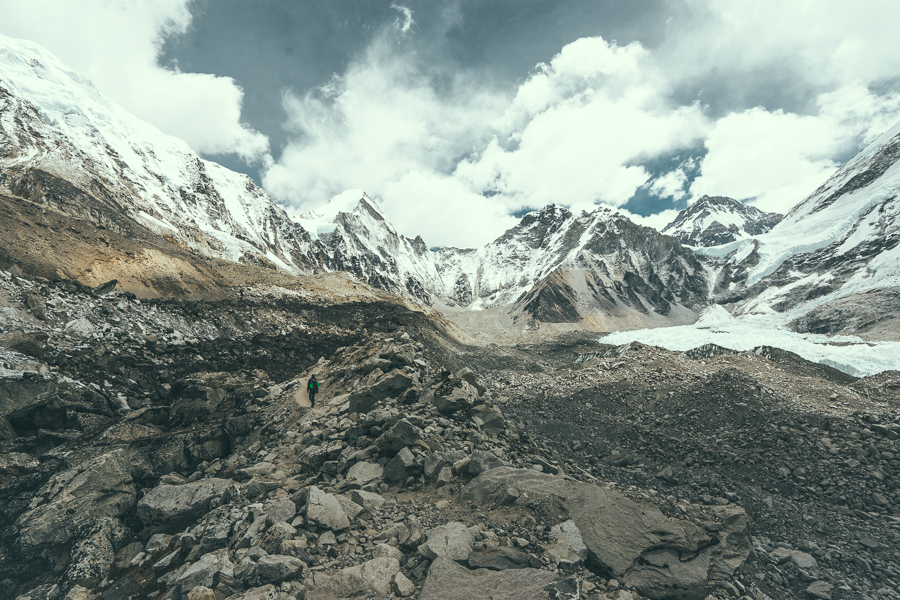
Day Nine: Kala Patthar
The highlight of the Everest Base Camp trek was the climb up to Kalapathar (also spelled out as Kala Patthar). It’s a 5,540-meter peak, which looms over the small village of Gorak Shep where you have just spent the night. It’s worth the freezing wake-up call in the morning as it is one of the best spots in Sagarmatha National Park to take in the views of Mount Everest.
It’s only a 3-kilometer round-trip trek from Gorak Shep with 300 meters of incline but at such high altitude, it can be quite difficult. I suggest starting 1.5-2 hours before sunrise so you are at the summit when the morning glow begins. After enjoying the sunrise with epic views of the cloud-filled valley and Mount Everest, we began the trek back down to Lukla.
It would take us another two days to reach Lukla, which is less than normal but going down is much easier.

Day Ten & Eleven: Heading back down
Heading back down is now at the pace of your choosing. We were keen to get back to Kathmandu so we took just two days to head back down the mountain. With altitude sickness no longer an issue, you can really make some good time.
If you are ahead of schedule you can keep going to the next village as there are no pre-made bookings. Heading down is a great feeling as you have accomplished reaching the base camp and you can now just breathe in the mountain air and enjoy the descent.
EVEREST BASE CAMP TREK: THE ULTIMATE GUIDE
In this section of the blog post, I will share with you the logistics and everything you need to know about trekking to Everest Base Camp.
HOW TO TREK TO EVEREST BASE CAMP
You have a few different options depending on your experience and requirements:
- Book a package through an agency to join a tour group
- Do the trek independently (not with an agency) but still hire a guide and/or porter
- Do the Everest Base Camp Trek entirely independently
If you are alone and don’t want to do the trek independently then it is a great idea to join a group. There are lots of free time and chill moments at the teahouses to play cards and chat with your group.
Doing it entirely independently means you are in charge of all the logistics and it can be quite stressful if you aren’t experienced at managing all flights, maps, costs, negotiations, food, language barriers, first-aid and more.
BOOKING AN EVEREST BASE CAMP TREK IN ADVANCE
These are the most popular routes and are organized by the top tour companies who have a global reputation.
The Everest Base Camp Trek doesn’t require a guide but it’s great to have a guide managing the logistics such as directions, tea-houses, distances, medical issues, and the overall organization. I’d say 90% of trekkers go with a guide.
I highly recommend booking with Himalayan Masters which is one of the top trekking companies when it comes to the Everest Base Camp Trek. I’ve trekked many different routes in Nepal with them and I’m a big fan of their attention to detail.
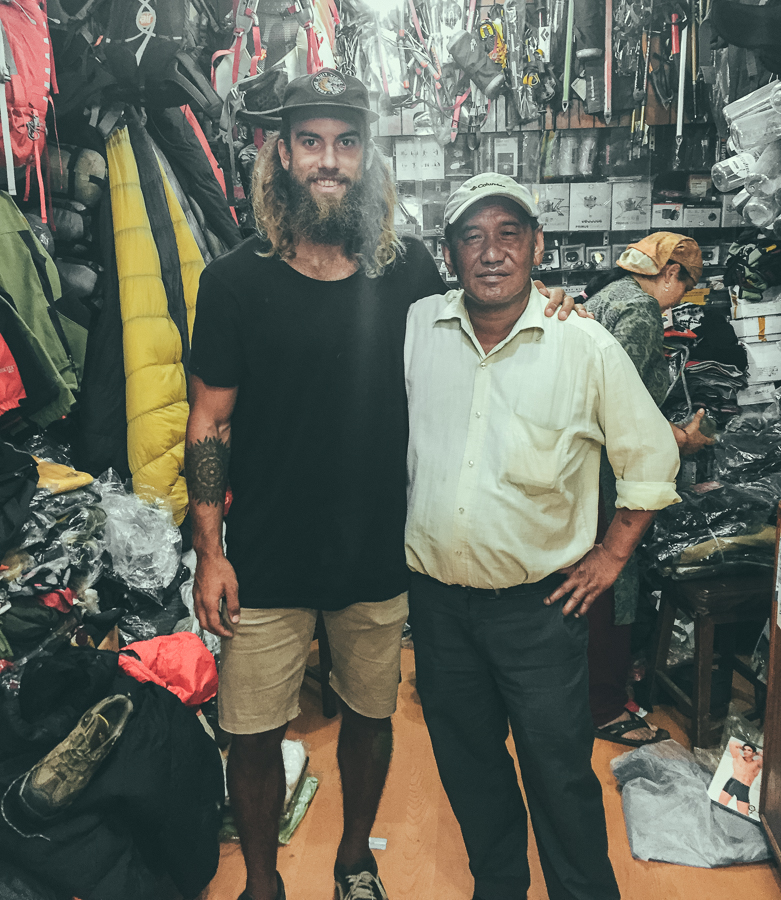
CHOOSING THE RIGHT TOUR AND A GUIDE
Trekking to Everest Base Camp can be done without a guide although I suggest hiring one. Here are 3 reasons why:
- Directions : The route isn’t incredibly hard to follow but there are many twists and turns I would have missed had I not had a guide. The route is available on many maps and map applications but it isn’t a clear trail throughout and some previous experience following a trail in a foreign country would be necessary.
- A guide is relatively cheap to hire : Included in your trekking package will be a qualified guide. However, in your package is also meals, accommodation, flights, etc. The guide him or herself will only cost $10-15 per day.
- When things go wrong : My guide helped me through food poisoning, altitude sickness and was as much a nurse as a guide. I rarely get sick at normal heights but altitude sickness is uncontrollable. I am pretty fit and it still smashed me hard. You can go it alone and be fine but it’s comforting to have a guide there when you come into trouble, especially with altitude sickness. My guide had seen it all before so his calm made me feel better about feeling sick for four days straight.
If you think you will get a guide like the majority of people on the Everest Base Camp, you have a lot of options and things to consider. Pictured below is my guide, Lapsang, who was a legend and someone who became a good friend. When I left Nepal he waited at the bus stop for two hours with me and gave me a Nepali scarf as a gift.
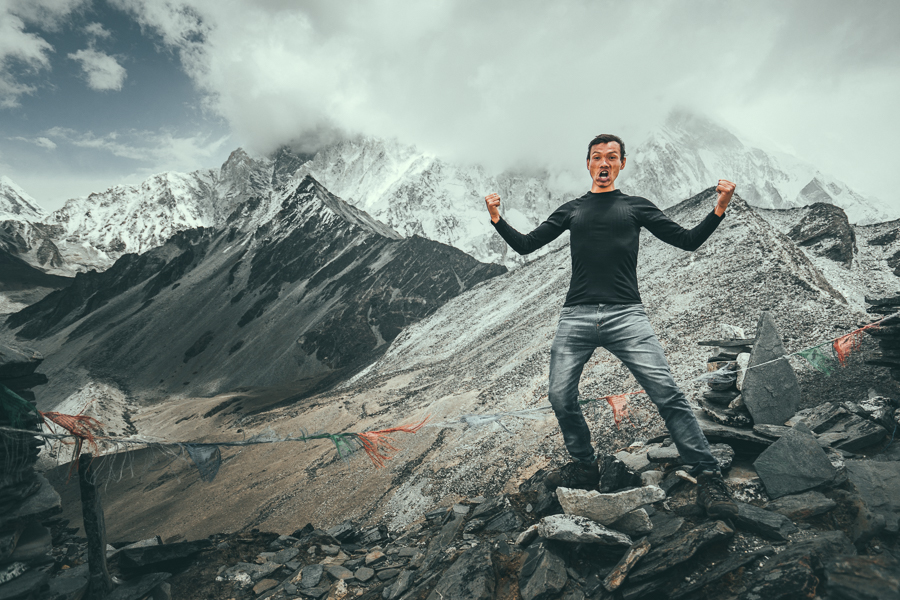
I suggest going with a small group of friends. We saw a few big groups and it looked like a Contiki tour compared to the experience I had with just myself and my guide. Only get a porter if you really need it. You should be able to carry your bag for 4-5 hours of trekking each day.
My guide, Lapsang Tamang, had done the trek multiple times as a porter and now many times a guide. He said he has lost count but somewhere over 20 times, he has been hiking the Everest Base Camp Trek. The best thing to do is to contact my guide and arrange to meet him first in Kathmandu so you can chat and decide if you want to go ahead. You will be together for 12 days after all!
You can directly contact my guide Lapsang by emailing him here: [email protected]
Lapsang is an awesome guy and I had too many chai tea hangouts with him before and after the trip. Lapsang and I became friends during the trip and afterward, we went bungee jumping, cooked Dal Bhat at his apartment, and visited Swayambunath Temple.
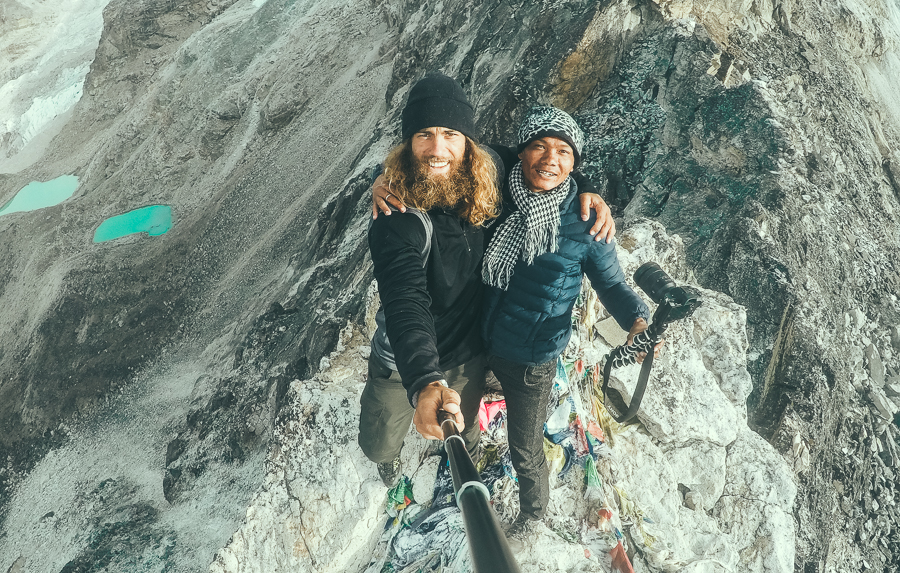
EVEREST BASE CAMP PACKING LIST
I had no winter clothes or even trekking shoes before getting to Kathmandu and bought it all for under $200 brand new (Likely fake North Face). But just as a guide you can get all the gear new for under $200. Bargaining/second hand etc. may help you get it a bit cheaper but this was one time I didn’t want to be so tight with money then freeze my ass off later on top of a mountain.
Keep in mind you won’t be doing any washing. Clothes that dry quickly and are lightweight are key. I showered once… Here is a list of what I took:
- 2 pairs of pants that rip off into shorts ($15 each in Kathmandu) (Super Safari style but actually handy in this situation.)
- 2 long sleeve quick-dry material shirts ($10 each in Kathmandu)
- 5 Pairs of Thermal North Face socks ($2-3 per pair in Kathmandu)
- 1 Fleece pants and sweater. ($25 for top and bottom in Kathmandu)
- 1 Thermal Lycra long sleeve and pants ($20 in Kathmandu)
- 5-6 pairs of quick-dry underwear
- 1 huge waterproof down jacket (Rented for $1 a day in Kathmandu)
- Beanie ($1 in Kathmandu)
- Neck Buff ($2 in Kathmandu)
- Gloves ($5 in Kathmandu)
- Water Purification pills and 1L bottle
- Camera gear and electronics (Not necessary but up to you. Obviously I carried a lot)
All of this should fit into a backpack no bigger than 50L and be less than 15kg. I used my 60L backpacking bag because I didn’t want to buy a new bag for a two-week trek. It worked out fine and weighed about 13kg including all of my lenses, chargers, and power banks.
What are my favorite pieces of trekking gear?
There are six pieces of gear that I simply never forget when I go trekking. These are five items that I using right now and this list gets updated every year! Here are my trekking essentials.
- Arcteryx BETA AR Rain Jacket : This is my go-to rain jacket. It’s super light, folds down into a tiny ball, and protects brilliantly in a storm. This one never leaves my backpack.
- Salomon X Ultra 3 Mid GTX Hiking Boots : For the best ankle support, waterproofing, and durable exterior I’m a fan of tough but light hiking boots like these Salomons for my adventures.
- Black Diamond Head Torch : I can’t tell you how many times, I’ve arrived back from a hike unexpectedly late. I always keep this lightweight but strong headtorch in my bag for the unexpected.
- Darn Tough Socks : These are the most comfortable hiking socks I’ve ever worn and last for years. They also have a lifetime warranty and you just send them in with a hole and they replace it no questions asked.
- Osprey Atmos AG 65L Backpack : I’ve never had a more comfortable 65L pack than this one. I got it in the Navy Blue and have trekked with it through many a mountain.
- Bl ack Diamond Trekking Poles : They might feel weird at first, but on a long trek with incline and decline you’ll begin to love these.
- Grayl GeoPress Water Filter Bottle : I’ve used this for three years. It filters your water with one press and you can drink directly from it. Never buy a plastic water bottle again!
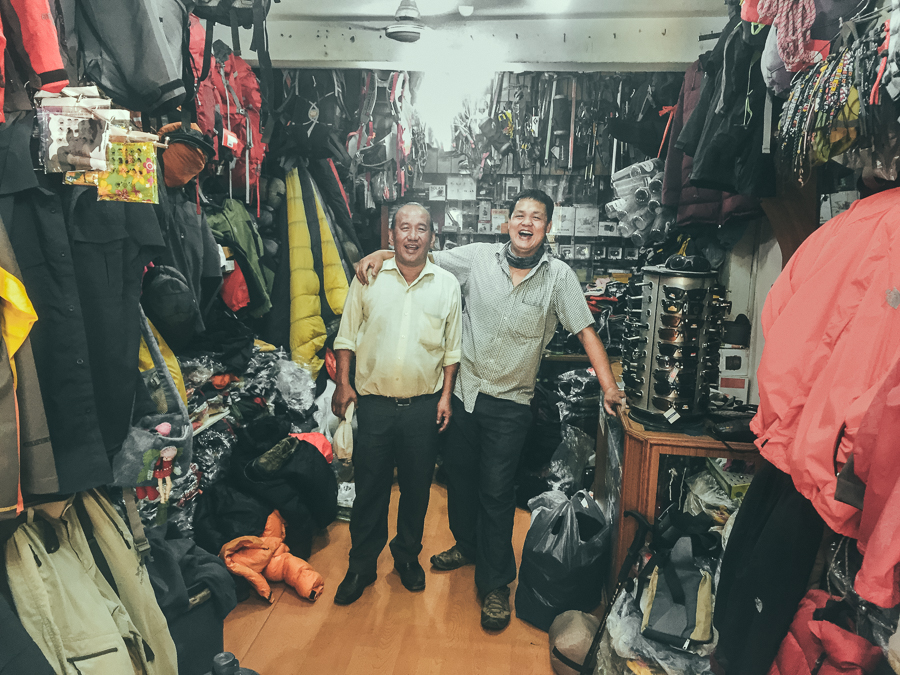
EVEREST BASE CAMP TREK COST
I paid $900 USD for my package all the way back in 2016 but you can expect to pay anywhere from $1400 to $2500 these days.
What’s included in the package for trekking to Everest Base Camp:
- Taxi from Thamel to Kathmandu Airport
- Flights from Kathmandu Airport to Lukla Airport
- Flights from Lukla Airport to Kathmandu Airport (Regular price $320 round trip)
- Breakfast, lunch, and dinner from the guesthouses you are staying at. I could pick anything on the menu, which had western options or Nepali options. You can eat pancakes, pizza, and burgers or you can go for the 24-hr Nepali Power Dal Bhat. I could also choose any hot drink with each meal.
- Your guide throughout the trip.
What’s not included:
- Water. You can buy bottled water like me if you are playing it safe. It is $1 per bottle at a lower elevation and $3 per bottle at the highest elevation. Or lots of people use purification tablets and they seemed to be fine.
- Electricity
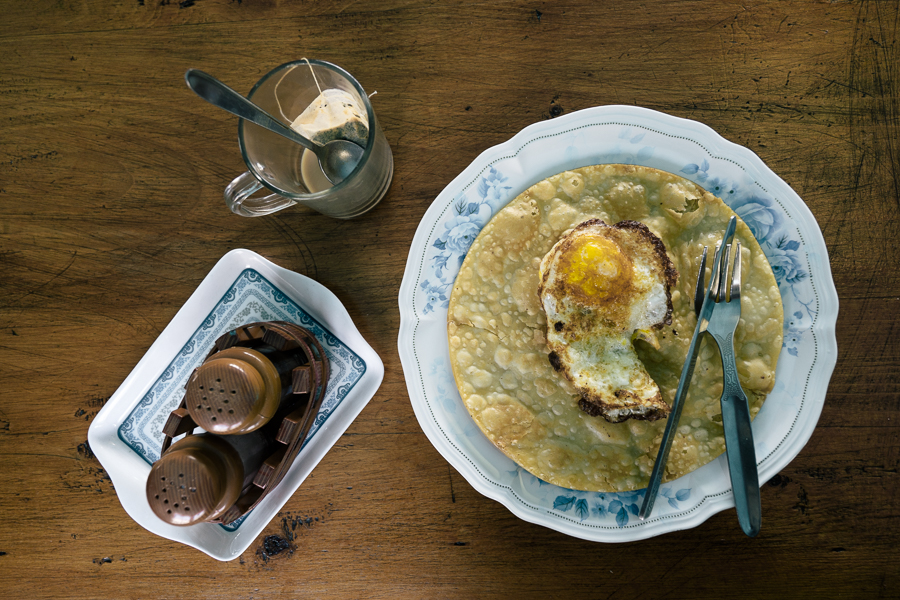
EVEREST BASE CAMP TREK: WIFI/ELECTRICITY AVAILABILITY.
Wifi: Costs anywhere from $3 to $10 to use wifi at the guesthouses. Buy a Ncell Sim before you go. Ncell works at 50% of the guesthouses. Electricity: You will have to pay anywhere from $2 at low elevation to $8 at high elevation to charge your power banks, cameras, and phones. The key is to get a fat power bank. Pay to charge that then charge everything from your power bank. My power bank lets me charge my phone and four camera batteries before it would be done.
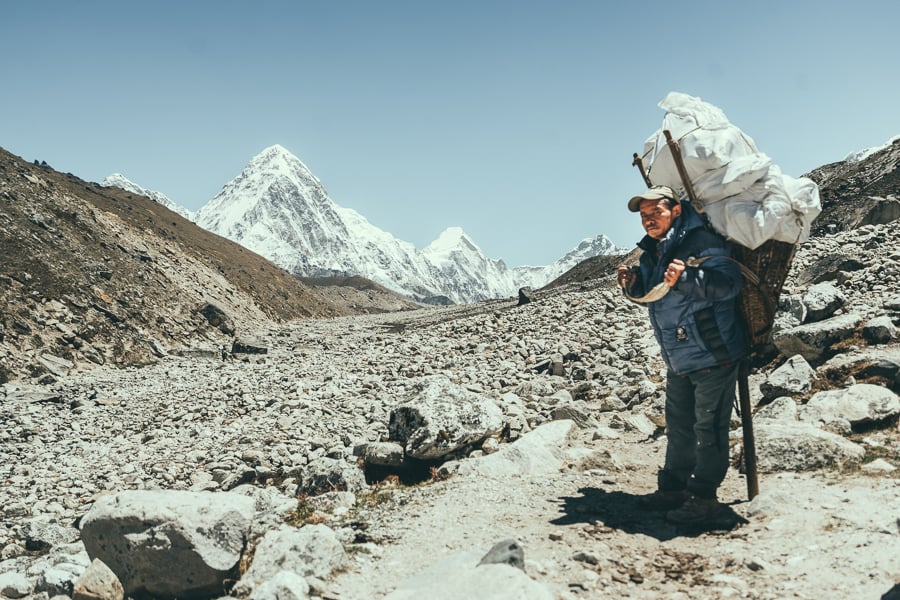
EVEREST BASE CAMP TREK: BEST TIME OF YEAR
This is an interesting question. Do you want snow, reliable weather or to get away from crazy crowds?
February to May – Peak season, clear bright days, very busy trails, lots of people attempting Everest ascent June to August – Monsoon season, no crowds and empty guesthouses September to October – Most stable and clear weather, trails are quite busy November to January – Coldest period, can reach -25, some routes closed
I trekked in the first week of June and was lucky to escape the rain. I didn’t get wet once. Normally it rained in the afternoon or at night if at all but we trekked in the morning and usually only heard the rain as we slept. The trails were open and some days we didn’t even see anyone.
My guide showed me a photo of Namche on a busy morning and I couldn’t believe it. The path looked like the start of a marathon. After seeing that I was so glad to have gone in the off-season.

EVEREST BASE CAMP TREK TEMPERATURE
During June when I trekked it was sunny in the days and I actually wore shorts every day. However as I mentioned above about when the best time to be trekking to Everest Base Camp is, it can get very cold at high elevations during November to January (-20 to-30)
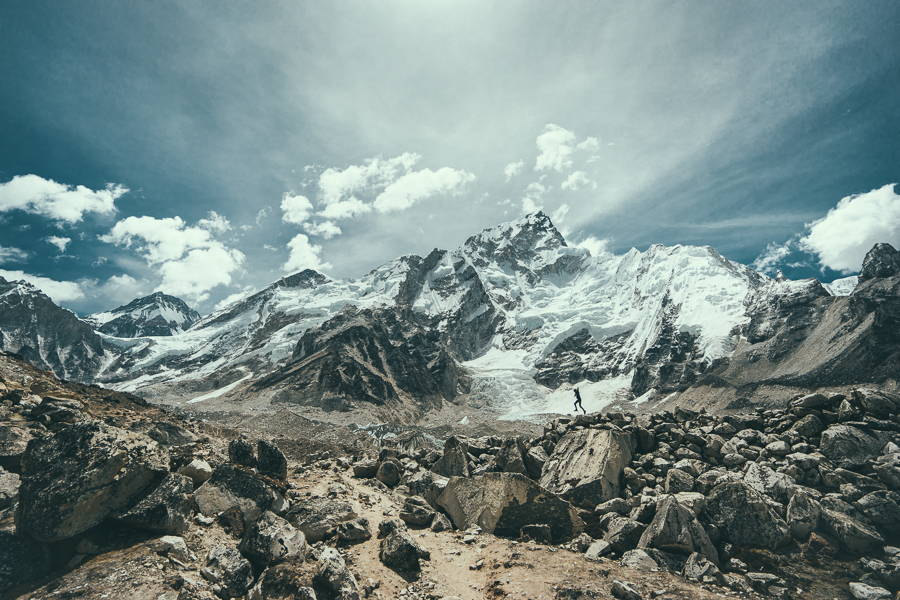
EVEREST BASE CAMP TREK DIFFICULTY
Trekking to Everest Base Camp takes some serious effort. But do you need to be in great shape to complete the journey? The simple answer is NO.
You can go at a slow pace, your own pace, and still make it to Everest Base Camp. In fact, going slow will help you to acclimatize better. I am all about speed but this is not a race. Some days we only trekked for just over three hours but we gained 500m in altitude so we rested for a day and then went again in the morning.
Having said all of that you should be able to walk 10-15 km in a day. Be able to walk up intense inclines for at least an hour. Be able to carry a bag while doing all of this unless you plan to hire a porter.
It’s hard to measure if you are ready. It isn’t like a marathon or anything else you have ever done most probably. I didn’t train at all and was fine. I’m in pretty good shape and played sport my whole life. There were people on the trail who were overweight and going incredibly slow but they were right there with us at base camp to celebrate the achievement.
EVEREST BASE CAMP ALTITUDE
The base camp is 17,600 ft or 5,380m. However, you will probably also trek to Kala Patthar, which looks over the base camp. Kala Patthara is 5,644m high.
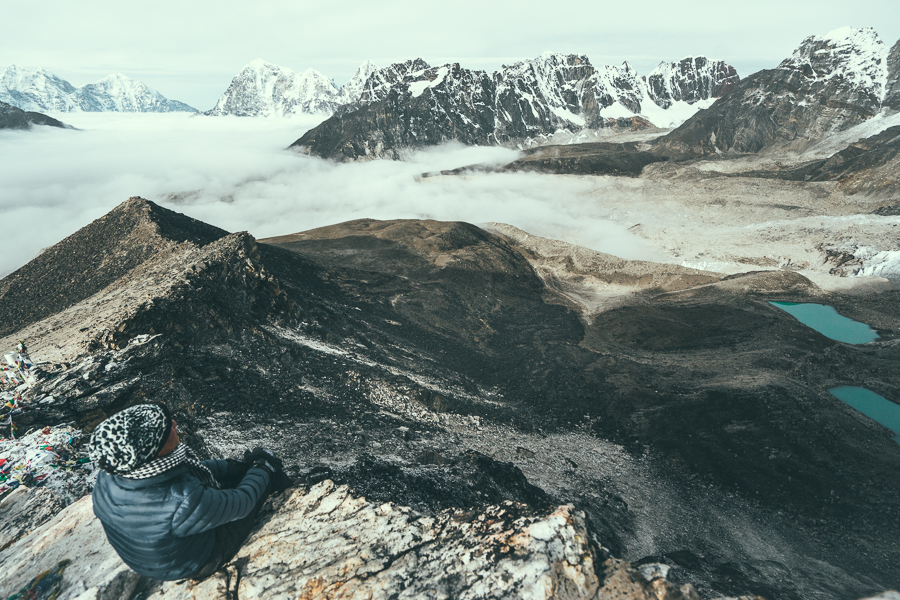
EVEREST BASE CAMP TREK DISTANCE
The distance from Lukla the first town to Everest Base Camp is 38.58 miles or 62 kilometers. Most people take 8-9 days trekking to Everest Base Camp and 3-4 days trekking back to Lukla. It took 8 days to trek to Base camp and two days to trek out.
EVEREST BASE CAMP ITINERARY
Your itinerary will vary depending on your speed and your guide. However, most people follow a somewhat similar trail and timeline. This was my timeline. Note that I spent one extra day in Phak Ding due to sickness. Most people spend that extra day in Namche.
- Day 1. Kathmandu flight to Lukla Lukla to Phak Ding (3-4 hrs)
- Day 2. Phak Ding rest day (sickness)
- Day 3. Phak Ding to Namche (5 hrs)
- Day 4. Namche to Tenboche (4 hrs)
- Day 5. Tenboche to Dinboche (3 hrs)
- Day 6. Dinboche to Chukhung Ri (2.5 hrs) Chukhung Ri back to Dinboche (1.5 hrs) (Acclimatization day)
- Day 7. Dinboche to Lobuche (3 hrs)
- Day 8. Lobuche to Gorak Shep (2 hrs) Gorak Shep to Everest Base Camp (1.5 hrs) Everest Base Camp to Gorak Shep (1.5 hrs)
- Day 9. Gorak Shep to Kala Patthara (2 hrs) Kala Patthara to Gorak Shep (1 hr) Gorak Shep to Tenboche (7hrs)
- Day 10. Tenboche to Lukla (8 hrs)
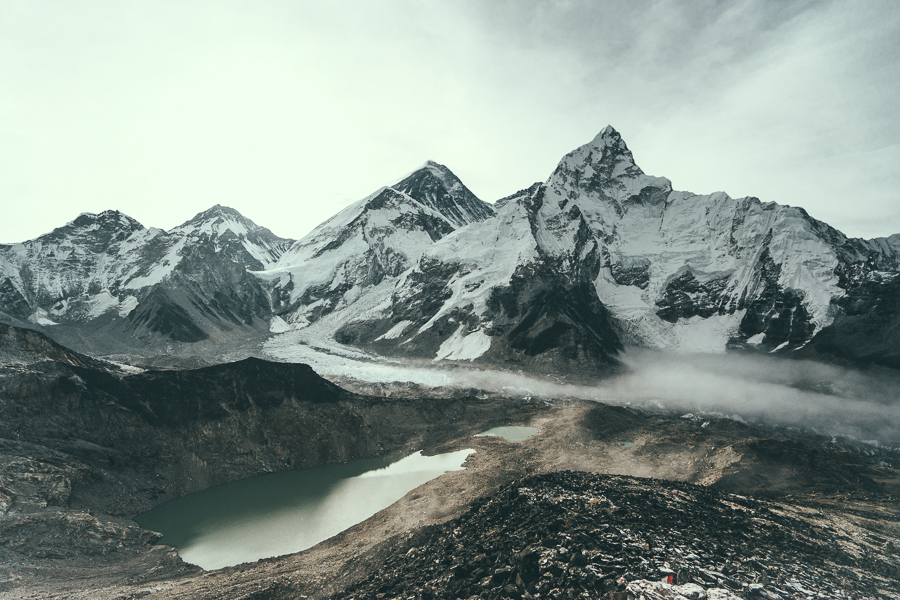
I hope you enjoyed my guide to the Everest Base Camp Trek and you have a great adventure.
HAVE YOU READ MY OTHER NEPAL BLOGS?
I’ve been lucky enough to have many awesome adventures in Nepal, which you can check out below where I’ve listed some of my favorite blog poss from Nepal.
- The Most Iconic route: Everest Base Camp Trek
- The Most Scenic Route: Annapurna Circuit Trek
- My Favorite Trek in Nepal: Manaslu Circuit Trek
- An Easy Nepal Trek: Langtang Valley Trek
- A great beginner peak: Island Peak Climb (6,165m)
- My Favorite Climb in Nepal: Climbing Ama Dablam (6,812m)
- My first 8000er: Climbing Manaslu (8,163m)
- My toughest climb in Nepal: Climbing Makalu (8,463m)
- Where to stay: 16 Best Places to Stay in Kathmandu

Tuesday 31st of October 2023
Sunday 17th of September 2023
So much informative articles which helps people to trek Everest Base Camp Trek
Inge Winkler
Saturday 3rd of June 2023
Hello, thank you for posting all the great infos, this will be very helpful for us. Could you please update me if the requirement of a Professional Guide is in place now or is there a way around it. Thank you so much in advance. Happy Trails, Inge
Sunday 18th of June 2023
I believe you need a guide now to trek anything above 3000m
Monday 21st of November 2022
Thanks for sharing such an adventurous trip experience with us. I read your blog. It feels like I was personally enjoying this trip.
Friday 12th of August 2022
Hi Jackson,
This was a helpful and informative guide. Kudos!
I had a small suggestion: You could have a small sections box right in the beginning and link each sub-section directly to the relevant content below, for ease of navigation!

EVEREST BASE CAMP TREK

EVEREST BASE CAMP

Pin Tweet Share WhatsApp
THE ESSENTIAL GUIDE
In this guide we cover everything you need to know about the Everest Base Camp Trek in Nepal. This includes suggested itineraries and practical information about accommodation, costs, what to pack, independent vs. guided treks, transport, and more. We also offer a route map with GPX download for use on the trek. And along with this written guide, we also share ‘silent hiking’ films that work well as a visual guide to the trail.
A chance for an adventurous and exciting journey, the Everest Base Camp Trek serves up spectacular scenery and gets you close to the world’s highest mountains, and as one of Nepal’s best known treks, it attracts people of all ages and experience levels. The trek ascends to high altitude (5000 m +) and is challenging, but it is achievable with a sensible itinerary that includes proper acclimatisation. Read on to discover more and start planning your own EBC trek.
Use the drop down menu below to jump to each section of this guide
TABLE OF CONTENTS
EVEREST BASE CAMP TREK OVERVIEW
EBC TREK FILMS
EVEREST BASE CAMP MAP & GPX DOWNLOAD
ELEVATION PROFILE & 3D ROUTE MAP
EVEREST BASE CAMP ITINERARIES
- THE CLASSIC EBC TREK
- EBC TREK VIA KHUMJUNG & PHORTSE
- EBC VIA KONGMA LA (5514 m)
- EBC AND GOKYO LAKES TREK
- BUFFER DAYS
EVEREST BASE CAMP TREK SUMMARY
- LULKA TO NAMCHE BAZAAR
- NAMCHE ACCLIMATISATION DAY
NAMCHE BAZAAR TO DINGBOCHE
- ALT. ROUTE VIA KHUMJUNG & PHORTSE
DINGBOCHE ACCLIMATISATION DAY
Dingboche to everest base camp.
- ALT. ROUTE VIA KONGMA LA
EVEREST BASE CAMP TO LUKLA
- ALT. ROUTE VIA CHO LA & GOKYO LAKES
BEST TREKKING SEASONS
HOW TO GET TO LUKLA
HOW TO GET TO LUKLA WITHOUT FLYING
EVEREST BASE CAMP TREK PERMITS & FEES
TREKKING INDEPENDENTLY
TREKKING WITH A GUIDE (& PORTER)
RECOMMENDED TREKKING AGENCY
ACCOMMODATION ON THE EBC TREK
FOOD ON THE EVEREST BASE CAMP TREK
SAFE DRINKING WATER
WIFI, PHONE SIGNAL & CHARGING
EVEREST BASE CAMP TREK COST & BUDGET
MONEY & ATMs ON THE EBC TREK
WHAT TO PACK FOR THE EBC TREK
ALTITUDE AWARENESS & AMS
TRAVEL INSURANCE
GETTING TO NEPAL
NEPAL TOURIST VISAS
Nepal visa on arrival process.
WHERE TO STAY IN KATHMANDU
BUDGET KATHMANDU ACCOMMODATION
Mid-range kathmandu accommodation, high-end kathmandu accommodation.
MAPS, GUIDEBOOKS & APPS
*Some of the links in this post are affiliate links – if you purchase a product or service via these links, we may earn a small commission at no extra cost to you . This helps offset the cost of running this blog and keeps us travelling so that we can continue to produce great content for you. As an Amazon Associate, we earn from qualifying purchases. We greatly appreciate your support!*
- DISTANCE | 120 -143 km depending on route taken (incl. acclimatisation/day hikes)
- DURATION | 12 – 15 days depending on route (incl. flying to/from Lukla)
- START/END | Lukla
- PERMITS REQUIRED | Khumbu Trek Card 2000 NPR; Sagarmatha National Park Fee 3000 NPR (SAARC nationals 1500 NPR / Nepali nationals 100 NPR)
- TREKKING SEASON | Best Seasons: April to Mid-May , October to Mid-November ; Shoulder Seasons: March, Late May, September, Mid-November to December ; Avoid: June to August, January to February
- TREK DIFFICULTY | Moderate (challenging if including Kongma La or Gokyo Lakes)
- ELEVATION GAIN/LOSS | +/- approx 7600 metres (Classic EBC Trek incl. acclimatisation/day hikes)
- MAX ALTITUDE | 5611 m (Kala Patthar)
- GUIDE MANDATORY? | Khumbu Pasanglhamu Rural Municipality has stated that it is NOT mandatory to trek with a guide in the Khumbu region
- ACCOMMODATION | Teahouses/Guesthouses in villages along the trail
- TREK COST | $35 – $144 USD per person, per day (budget independent trekker to fully inclusive package)
- RECOMMENDED TREKKING AGENCY | Himalayan Masters , Quote HOGG5 for 5% discount
DISTANCE 120 -143 km depending on route taken (incl. acclimatisation/day hikes)
DURATION 12 – 15 days depending on route taken (incl. flying to/from Lukla)
START/END Lukla
PERMITS REQUIRED Khumbu Trek Card 2000 NPR Sagarmatha National Park Fee 3000 NPR (SAARC nationals 1500 NPR, Nepali nationals 100 NPR)
TREKKING SEASON Best Season April to Mid-May October to Mid-November Shoulder Seasons March, Late May, September Mid-November to December Months To Avoid June, July, August January and February
TREK DIFFICULTY Moderate (challenging if including Kongma La or Gokyo Lakes)
ELEVATION GAIN/LOSS +/- approx 7600 metres (Classic EBC Trek incl. acclimatisation/day hikes)
MAX ALTITUDE 5611 m (Kala Patthar)
GUIDE MANDATORY? Khumbu Pasanglhamu Rural Municipality has stated that it is NOT mandatory to trek with a guide in the Khumbu region
ACCOMMODATION Teahouses/Guesthouses in villages along the trail
TREK COST $35 – $145 USD per person, per day (budget independent trekker to fully inclusive package)
OUR RECOMMENDED TREKKING AGENCY Himalayan Masters , Quote HOGG5 for 5% discount
EVEREST BASE CAMP TREKKING FILMS
Get a sense of the Everest Base Camp trekking route in our ‘silent hiking’ style ambient films.
EVEREST BASE CAMP TREK MAP & GPX DOWNLOAD
MAP & GPX DOWNLOAD
We have created a detailed Everest Base Camp trekking map to accompany this guide. It shows the Classic Everest Base Camp trekking route along with the alternative routes outlined in this guide, going via Khumjung and Phorste, Kongma La, and Cho La and Gokyo Lakes. The main side/acclimatisation hike options are included too, and the overland route between Salleri and Lukla is also marked.
Detailed stats and an elevation profile are included for each route section. Guesthouse settlements and tea shops are also marked, as well as key sights and practical info such as checkpoints, hospitals, and transport hubs. Guesthouses as per our own trek itinerary are marked, including info about prices and services, phone numbers (where possible), and a copy of the menu. Photos are included with almost every pin.
You can use the digital map online, or download it for offline use with a mapping app such as Organic Maps, Maps.me or Gaia GPS. This is very helpful for navigation assistance on the trail. It allows you to quickly pinpoint key places and services along the way and calculate distances and elevation differences between destinations.
Note that while we’ve tried to be as accurate as possible when recording and mapping the route, changes on the ground are inevitable (especially on routes crossing glaciers) and this map should not be solely relied upon for navigation.
EVEREST BASE CAMP TREK ELEVATION PROFILE
ELEVATION PROFILE
The image below shows the elevation profile of the Classic Everest Base Camp trek, starting and ending in Lukla. The route shown here includes the various acclimatisation and side hikes as outlined in the suggested itinerary below. Elevation is displayed in metres and distance in kilometres.

3D ROUTE MAP
Watch our 3D relief map video to visualise the landscape and get a sense of the Everest Base Camp trek.
EVEREST BASE CAMP TREK ITINERARY
ITINERARY OPTIONS
There is more than one trekking route to Everest Base Camp . In this section we outline the Classic EBC trek itinerary, but also include three alternative itineraries which enable you to vary your route on the way to and from Base Camp and see much more of the Khumbu region.
We have created an overview table for each of the Everest Base Camp trek itinerary options. These include trekking distances and approximate trekking times for each day (excluding lunch stops, breaks, etc), as well as stats on elevation gain/loss and sleeping altitude. For each itinerary the assumption is that you will fly into Lukla on the morning of Day 1 and start trekking. You will need to add 3 – 5 days if you plan to travel overland from Kathmandu to Lukla or vice versa.
It is also possible to combine the following itineraries to create your own alternative EBC trek. For example, you could trek via Khumjung, Phortse and Kongma La on the way to EBC, or you could include both Kongma La and Gokyo Lakes. A few minor possible alternatives along the way are noted below each itinerary, such as alternate overnight stops.
If viewing the itinerary tables on a mobile device or tablet, scroll to the right to see the full table or flip your screen to landscape mode
CLASSIC EVEREST BASE CAMP TREK ITINERARY
A classic Everest Base Camp trek itinerary is 11 nights/12 days, following the exact same route on the way to and from EBC. If you have limited time, this is the shortest itinerary you can follow while sticking to safe altitude ascent rates.
DAY 1 ALT. INFO*
*Alternatively, continue to Monjo (2830 m) where fewer people stay overnight (a further 5.1 km, approx 2 hours trekking time) . Doing this means the trail will be less busy for both your Phakding to Monjo section, and the Monjo to Namche section the following morning.
DAY 4 ALT. INFO**
**Alternatively, continue to Pangboche (3950 m) where fewer people stay overnight (a further 4.2 km, approx 1.5 hours trekking time). Pangboche is a lovely village with fantastic views of Ama Dablam, and there are many guesthouses. Tengboche, on the other hand, only has two guesthouses and it can be difficult to get a room here in peak season. Continuing to Pangboche also means the trail will be less busy for both your Tengboche to Pangboche section, and the Pangboche to Dingboche section the following morning.
DAYS 8 & 9 ALT. INFO***
***On days 8 and 9 the classic itinerary that most people follow is to visit EBC after lunch at Gorak Shep, then hike up Kala Patthar in the dark for sunrise the next morning (when it is bitterly cold). If you swap these two around as per the above suggested itinerary, you are guaranteed to have a less busy experience at both EBC and on the trail up Kala Patthar. As the skies are usually clearer in the morning you are also likely to have better views at EBC, however it is possible that the views from Kala Patthar will be obscured by afternoon clouds. If you’re lucky and have clear afternoon skies, then you will be treated to a fiery sunset glow on Everest and the surrounding mountains. If you hike up Kala Patthar in the morning, your mountain views will be brief as the sun rises directly behind Everest and you’ll soon be looking directly into the sun.
ALTERNATIVE EVEREST BASE CAMP TREK ITINERARY VIA KHUMJUNG AND PHORTSE
Our first alternative Everest Base Camp trek itinerary is 12 nights/13 days. This itinerary follows a different route between Namche Bazaar and Pangboche on the way to EBC, by trekking via Khumjung and Phortse. The overall difficulty of this route remains moderate, and the additional day allows you to explore more of the region and gives more time for acclimatisation. It’s also a great option for avoiding crowds during the peak trekking seasons, as far fewer people trek this alternative route.
DAYS 9 & 10 ALT. INFO**
**On days 8 and 9 the classic itinerary that most people follow is to visit EBC after lunch at Gorak Shep, then hike up Kala Patthar in the dark for sunrise the next morning (when it is bitterly cold). If you swap these two around as per the above suggested itinerary, you are guaranteed to have a less busy experience at both EBC and on the trail up Kala Patthar. As the skies are usually clearer in the morning you are also likely to have better views at EBC, however it is possible that the views from Kala Patthar will be obscured by afternoon clouds. If you’re lucky and have clear afternoon skies, then you will be treated to a fiery sunset glow on Everest and the surrounding mountains. If you hike up Kala Patthar in the morning, your mountain views will be brief as the sun rises directly behind Everest and you’ll soon be looking directly into the sun.
EVEREST BASE CAMP VIA KONGMA LA TREK ITINERARY
Our second alternative Everest Base Camp trek itinerary is 13 nights/14 days. This changes the route taken between Dingboche and Lobuche on the way to EBC by crossing a high pass called Kongma La (5514 m). This section is more challenging than the rest of the route, but it offers incredible scenery and the chance to explore much quieter sections of trail than you’ll experience on the classic EBC route.
DAY 8 ALT. INFO**
***There are two viewpoints on the Chukhung Ri acclimatisation hike, the lower one (5380 m) which most people visit and the higher one (5516 m) which involves a tough and steep climb towards the end.
DAYS 10 & 11 ALT. INFO****
****On days 8 and 9 the classic itinerary that most people follow is to visit EBC after lunch at Gorak Shep, then hike up Kala Patthar in the dark for sunrise the next morning (when it is bitterly cold). If you swap these two around as per the above suggested itinerary, you are guaranteed to have a less busy experience at both EBC and on the trail up Kala Patthar. As the skies are usually clearer in the morning you are also likely to have better views at EBC, however it is possible that the views from Kala Patthar will be obscured by afternoon clouds. If you’re lucky and have clear afternoon skies, then you will be treated to a fiery sunset glow on Everest and the surrounding mountains. If you hike up Kala Patthar in the morning, your mountain views will be brief as the sun rises directly behind Everest and you’ll soon be looking directly into the sun.
EVEREST BASE CAMP AND GOKYO LAKES TREK ITINERARY
Our third alternative Everest Base Camp trek itinerary is 14 nights/15 days. This varies the route taken between Lobuche and Namche Bazaar on the way back from EBC, by crossing a high pass called Cho La (5368 m) and descending via the spectacular Gokyo Lakes. Again, this route is more challenging than the classic or first alternative EBC itineraries we suggest, due to the extra distance and overall elevation gain. However, it is a highly rewarding trek which includes some of the most spectacular locations in the Khumbu region. The sections of trail that you must repeat on the way to and from EBC are kept to an absolute minimum on this itinerary.
IMPORTANCE OF BUFFER DAYS
Building in buffer days to your Everest Base Camp itinerary is highly recommended, especially if you plan on flying to/from Lukla. Flights are regularly cancelled due to poor weather conditions, sometimes for a number of days. If everything runs smoothly, it takes half a day or less to get to/from Lukla at the start/end of your trek. However, if flights are not operating, it can take up to 3 days to travel overland from Kathmandu to Lukla, using a mixture of buses and jeeps, and by trekking too. Therefore, it’s wise to have at least 3 or 4 days between the end of your planned trek itinerary and any international flight. This would allow you time to get from Lukla to Kathmandu overland if necessary.
Of course, a delay could also happen at the start of your trek while trying to get to Lukla, and this might leave you struggling to catch up with your original itinerary. Having a couple of buffer days built in will mean you don’t have to drastically alter your itinerary, avoiding the need to walk extra long distances to save a day or skipping places because you don’t have time.
Buffer days also allow you to alter your itinerary on the go more easily. For example, if you get sick and need to spend an extra night somewhere, or the weather is bad and you want to wait it out before continuing your trek, then you have the extra days on hand.
It’s worth knowing that should everything go to plan and you don’t need to use any buffer days during your trek, it’s straightforward for a trekking agency to change the date of your flight, bringing it forward a few days for example. However, this is not so easy if you have booked your flight online, independently.
OUR RECOMMENDED TREKKING AGENCY
We partnered with Himalayan Masters for our Langtang Valley, Gosainkunda, EBC and Everest Three Passes treks, and found them to be professional and committed to a high level of service
To enquire about booking your own trek, get in touch via email at [email protected] and mention the code HOGG5 to get a 5% discount off the cost of your trip
ROUTE SUMMARY
LUKLA TO NAMCHE BAZAAR
The first two days of the Everest Base Camp trek are repeated in reverse on the final day of the trek. With only one route connecting Lukla and Namche Bazaar, unfortunately there’s no avoiding this.
This section of the trek passes through numerous villages and teahouse settlements, the last of which is Jorsale, shortly beyond the entrance to Sagarmatha National Park. There are five suspension bridges to cross, including the 125 metre high Hillary Bridge, and numerous smaller fixed metal bridges. The Khumbu Trek Card Registration desk (where you get your Khumbu Trek Card and pay your Sagarmatha NP entrance fee) is shortly beyond Lukla, and there are further checkpoints at Toc Toc, Monjo, and just before Namche Bazaar.
The route follows a mixture of wide stone paths, riverside paths, and forest trail, with plenty of up and down along the way. There is one notable ascent, a 700 metre climb immediately after crossing the Hillary Suspension Bridge, on the last stretch before Namche. This section is a pleasant couple of days and a good introduction to the trek, with greenery and the chance to see colourful rhododendrons and blossoms in spring, plenty of scenic river views, and a definite buzz thanks to all the people coming and going and the numerous villages dotting the trail.
With only one route up and down to Namche, traffic jams are common along this section, with trekkers, porters, and pack mules, yaks and their handlers all sharing the same trail. Bottlenecks are particularly common at suspension bridges and on the steep climb up to Namche. Be sure to wait on the side of the trail without a drop-off when letting pack animals pass, and don’t start crossing a bridge if you can see them coming in the opposite direction – let them cross first. Finally, stick to the left side when walking by any mani stones, mani walls and prayer wheels, as it’s both common practice and culturally appropriate.
For more detail about this section of the route, see Days 1 and 2 of our Everest Three Passes Route Guide .

The Hillary Suspension Bridge as seen from the valley floor, with the old bridge still in place below

NAMCHE BAZAAR ACCLIMATISATION DAY
It’s important to acclimatise properly throughout your Everest Base Camp trek. This allows your body time to get used to the ever-increasing altitude as you ascend to 5000 metres and above. Building in rest days, staying well hydrated, and going on acclimatisation hikes (where you climb higher during the day but sleep lower at night) are all good ways of helping your body acclimatise.
Unless you are already acclimatised (for example you have been at altitudes of 4000 metres and higher within the previous week), spending a second night at Namche Bazaar is highly recommended and this is standard on virtually all Everest Base Camp trek itineraries. You should do this even if it seems like you feel physically fine.
The most common destination for an acclimatisation hike from Namche Bazaar is the Hotel Everest View (3880 m) , where you can get lunch or a drink and enjoy fantastic views from the terrace. It takes around 3 hours to hike up to the hotel and back down again. A must-visit on the way is Sagarmatha Next , a learning / experience / visitor centre and gallery championing waste management solutions for the Khumbu region.

Morning view over Namche Bazaar from the northeast

Morning view of Namche Bazaar from the northeast
For a longer hike and the chance to see more of the local area, doing a loop via Khumjung is a great option. Khumjung is the largest Sherpa village in the region, with an impressive monastery and a school founded by Edmund Hillary in 1960. The original classroom is now the Sir Edmund Hillary Visitor Centre , another great place to visit and learn about the Khumbu region. The loop hike (including Hotel Everest View) is around 7.5 km, and you should allow up to 5 hours for the hike. It’s also possible to include a visit to Khunde village, home to another monastery. This would extend the loop route to around 9.1 km and you should allow up to 6 hours.
If you plan to overnight at Khumjung on day 4 of your trek, following the ‘Alternative Everest Base Camp Itinerary’ outlined above, you might want to opt for a shorter Namche acclimatisation hike. Hiking 100 metres up to the helipad on the western side of the village is a good choice. There is an excellent view over Namche from here, where you can see it curving around the sloping hillside in amphitheatre-like fashion.
Various Namche acclimatisation hiking routes are marked on our EBC Trek map .
CLASSIC ROUTE VIA TENGBOCHE
This two-day section of the Everest Base Camp trek offers fantastic mountain scenery and a beautiful trekking trail, passing through forest and open hillside. There is one notable big climb between Phunki Thanga and Tengboche but otherwise the trail is mostly straightforward, with just a few short steep sections, and plenty of flat, undulating, or gentle climbs. There are a handful of small villages along the route, two suspension bridges, a checkpoint at Phunki Thanga, and an impressive monastery at Tengboche which is well worth visiting (daily 7am – 8am, 9am – 11am, and 1pm – 5:30pm, monks chanting at 3pm). After Pangboche you are more or less above the treeline, surrounded by imposing mountains and expansive views.
For more detail about this section of the route, see Days 4 and 5 of our Everest Three Passes Route Guide .

Trekkers pass through Shomare on the way to Dingboche, with the twin peaks of Ama Dablam rising behind

Trekkers pass through the village of Shomare on the way to Dingboche, with the twin peaks of Ama Dablam rising behind
ALTERNATIVE ROUTE VIA KHUMJUNG AND PHORTSE
This three-day route section follows an alternative trail between Namche and Pangboche before joining the classic Everest Base Camp trail for the final stretch to Dingboche. Opting for this itinerary allows you to vary your route on the way to and from EBC and take advantage of much quieter trails. Plus, the extra day allows for a slower ascent pace, which is a good option for anyone who knows they are slow to acclimatise or prefers to follow a more cautious itinerary.
This route climbs initially to Khumjung, the largest Sherpa village in the region, then stays above the ‘Classic EBC’ route to Pangboche, offering fantastic views throughout. There is a small guesthouse settlement at Mong La (3970 m) which is the highest point on the way to Phortse, a scenic village with a number of guesthouses, local homes, and the Khumbu Climbing Centre .
There is plenty of up and down on this section of the trek, with some notable climbs to Khumjung, Mong La, and both before and after Phortse. However, this route is not considerably more challenging than the ‘Classic EBC’ route, especially as it is split over three days instead of two.
Spending two nights at Dingboche, a sizeable village situated at 4300 m, is advisable in order to ensure you ascend to very high altitude at a safe rate. Going on an acclimatisation hike is also an important part of acclimatising to such altitudes, and Nangkartshang Peak (5039 m) is a great option. This hill rises to the north of Dingboche and there are fantastic views throughout the climb, especially of Ama Dablam. There is an obvious path all the way to the rocky top, which is festooned with prayer flags and spacious enough for plenty of people. The 766 metre climb should take around 2.5 – 3 hours, with the descent about half that. It’s advisable to start early (around 7:30am) for the best chance of clear views and calm conditions.

After a 760 metre climb, people rest and enjoy the views at the prayer flags on Nangkartshang

For a longer and less busy acclimatisation hike, a great option is the side hike up the valley to the east of Dingboche to Chukhung Village and Chukhung Ri, a viewpoint situated at 5380 m. The views from Chukhung Ri are fantastic, looking back down the valley and across to an impressive ice wall, and you’ll be surrounded by numerous majestic snowy peaks including Lhotse, Nuptse, Island Peak and Ama Dablam. Allow up to 8 hours for this return hike.

Plenty of outstanding views to appreciate while hiking up to Chukhung Ri

Plenty of outstanding views to stop and appreciate while hiking up to Chukhung Ri
Whichever acclimatisation hike you decide to do, ensure you have plenty of water, snacks, and warm layers with you.
For more detail about these hikes, see Day 6 (Nangkartshang) and Day 8 (Chukhung Ri) of our Three Passes Route Guide.
CLASSIC ROUTE
If you’re following the Classic EBC route you’ll trek from Dingboche to Base Camp over 2 – 2.5 days, spending a night at Lobuche and then at Gorak Shep. From Gorak Shep you’ll do a return hike to EBC. Most people also include a side hike to Kala Patthar, the highest point of the trek at 5611 m, where you can get a view of Mt Everest (which isn’t actually visible from Base Camp.)
The route heads up the valley to the northwest of Dingboche, climbs to Thok La pass, then heads northeast, running parallel to the Khumbu Glacier all the way to Base Camp. It’s a gradual ascent for most of the way, but at these altitudes (4300 m – 5300 m) even a gentle climb can take your breath away. The climb to Thok La on the way to Lobuche, the short but steep climb on the way to Gorak Shep, and the undulating rocky glacier section immediately before Gorak Shep are among the most challenging sections.
The views are wonderful throughout and the final sight of Everest Base Camp, encircled by soaring peaks, is a memorable one. This is especially true if you’re trekking during the peak climbing season, when a sea of tents sprawls across the glacier at the foot of the Khumbu Icefall – seen from the trail, these tiny yellow dots emphasise the enormity of the surroundings even more.

First sight of Everest Base Camp from the trail

Posing for the obligatory photo on the ‘EBC Rock’
Seen from the Kala Patthar trail about 30 minutes before sunset , the clouds part to reveal the summit of Mount Everest (8849 m)
Lobuche is a small settlement of guesthouses on the edge of the Khumbu Glacier, a very busy spot where everyone going to and from EBC stops for food and/or spends the night. Gorak Shep is even smaller, busier, and more basic with just four guesthouses and no good water supply.
For more detail about this section of the route, see Days 10 and 11 of our Everest Three Passes Route Guide .
ALTERNATIVE ROUTE VIA KONGMA LA
This alternative route to Everest Base Camp is a three day trek between Dingboche and Lobuche, via Chukhung, Chukhung Ri and Kongma La. At Lobuche you rejoin the classic route for the final section to Gorak Shep, Kala Patthar and EBC. This is part of the Everest Three Passes trek and is a challenging but very rewarding addition to the EBC trek. With far fewer people trekking this route compared to the Classic EBC route, you can expect the trail to be much quieter.
The route follows a gently ascending trail up the scenic valley to the northeast of Dingboche before reaching the small guesthouse settlement of Chukhung. It’s advisable to spend two nights here, using the extra day for an acclimatisation hike to the spectacular viewpoint of Chukhung Ri (5380 m) before crossing Kongma La the following day. The scenery around the village is very dramatic, as are the views seen throughout the hike to Chukhung Ri, with Ama Dablam rising to the south, Island Peak to the east, and Lhotse and Nuptse to the north, along with countless other peaks and the dramatic ice wall of the Chukhung Glacier.
The trek to Kongma La (5514 m) involves a long ascent but other than a couple of short steep sections, it’s mostly a steady climb, and the landscape is striking. From the pass you have incredible 360 degree views and you can see all the way down to Lobuche, a small cluster of buildings on the far side of the rocky Khumbu Glacier. The descent is somewhat steep and slippery at first due to loose dirt, shale, and small rocks, but becomes less steep as you work your way down to the eastern side of the glacier. The final section, crossing the glacier itself, involves plenty of up and down as you work your way across jumbled rocks and around small glacial lakes; on the other side, a final downhill stretch leads to Lobuche.
For more detail about this section of the route, see Days 7 – 9 of our Everest Three Passes Route Guide .

On the final approach to Kongma La

The Classic Everest Base Camp trekking route follows the same trail on the return to Namche Bazaar, covering the distance in three days with overnights at Pheriche, Namche, and Lukla. As you drop in altitude more oxygen flows through your blood and the physical strain on your body reduces. This combined with the fact that you no longer need to think about acclimatisation enables you to cover a much greater daily distance than on previous days. The return section of the trek is not all downhill however, and three 17 – 19 km days in a row can be very tiring!
ALTERNATIVE ROUTE VIA CHO LA AND GOKYO LAKES
An alternative route connects Lobuche and Namche Bazaar via Cho La and Gokyo Lakes. This turns your trek into a loop hike commonly known as the Everest Base Camp and Gokyo Lakes trek. Following this route over six days, you’ll cross Cho La (5368 m), a high pass to the west of Lobuche, descend from the pass and traverse the rocky Ngozumpa Glacier to reach Gokyo and a string of brilliant blue lakes, then follow the Gokyo Valley back to Namche where you’ll join the trail to Lukla. The route takes in some of the best scenery in the Khumbu region and is a fantastic alternative to the Classic EBC trek, although definitely more challenging with the addition of the high pass.
This route diverges from the classic trail a little south of Lobuche, working its way around a hillside to the northwest to reach the small guesthouse settlement of Dzonglha. The ascent to Cho La on the next morning is initially gradual, after which there are a couple of steep sections and the crossing of an icy glacier (microspikes recommended) just before the pass. The descent starts off steeply (aided by a fixed metal rope) before becoming more gradual as it works its way down the valley to the guesthouses at Dragnag (Thangnak). On the following morning* you have to cross the Ngozumpa Glacier, the largest glacier in Nepal, with a rocky, undulating trail passing small glacial lakes to reach Gokyo on the other side. The descent onto and climb off the glacier is quite steep.
*If you are looking to save a day it is possible to continue to Gokyo after crossing Cho La, without spending the night at Dragnag (Thangnak). It will very much depend on your energy levels and the weather conditions on the day.

Trekkers crossing the icy glacier towards Cho La (5368 m), the rocky dip ahead

Gokyo, a medium-sized teahouse village, sits on the western side of the glacier, on the shores of Dudh Pokhari, or Gokyo 3rd Lake. The setting is beautiful. You can visit the 4th Lake on a side hike to the north, and climb the steep trail to Gokyo Ri early the next morning for some of the most impressive views in the region. The return to Namche Bazaar is via the Gokyo valley, following the Dudh Koshi river. A good option is to break your journey at the small village of Dole, then continue beyond Namche to overnight at Monjo before the final stretch back to Lukla.

Early morning at Gokyo

Beyond Dole the trail descends towards Phortse Tenga, then climbs to Mong La, on the same route as outlined in the ‘Alternative Route via Khumjung and Phortse’ section. From Mong La it’s possible to descend all the way to Sanasa and take the same trail back to Namche that you followed on the way to Tengboche, or stay higher and follow a trail to the large Sherpa village of Khumjung before descending to Namche. The route between Namche and Lukla is the same as at the start of the trek.
For more detail about the Everest Base Camp to Gokyo section of the route, see Days 11 – 15 of our Everest Three Passes Route Guide .
SEE MORE FROM NEPAL

Everest Base Camp Trek: The Essential Guide

Everest Three Passes Trekking Route Guide

Everest Three Passes Trek: The Essential Guide

Gosainkunda Helambu Trekking Route Guide

Gosainkunda Trek: The Essential Guide

Langtang Valley Trekking Route Guide

Langtang Valley Trek: The Essential Guide

What To Pack For Trekking In Nepal

Upper Mustang Trek: The Essential Guide

Upper Mustang Trek Itinerary: A Day By Day Account

Annapurna Circuit Trek: The Essential Guide

Annapurna Circuit Trek Itinerary: A Day By Day Account

Manaslu Circuit Trek: The Essential Guide

Manaslu Circuit Trek Itinerary: A Day By Day Account
Everest base camp trekking season.
TREKKING SEASON
Like many treks in Nepal , the peak seasons for trekking the Everest Base Camp route are April to mid-May and October to mid-November . These months typically offer the best chance of both clear skies and warmer temperatures, although weather patterns are becoming increasingly unpredictable in Nepal and across the world, so you should still be prepared for snow and colder temperatures during these periods.
The spring trekking season coincides with the Everest climbing season , so the Khumbu region is very busy with helicopters and yaks transporting supplies to Everest Base Camp. If trekking at this time, you will have the chance to see base camp fully set up with all the tents, and there is a great buzz about the place. Outside of the climbing season, there are no tents or any other infrastructure at EBC.

Trekkers crossing the moraine-covered glacier between Lobuche and Gorak Shep on a clear skies spring morning

Trekkers crossing the moraine-covered glacier before Gorak Shep on a clear spring morning
In autumn, expect less wind and higher temperatures than in spring, while in late March and April, blooming rhododendrons and other spring flowers are a beautiful sight at some lower elevations.
The shoulder seasons are March, May, September and mid-November to December. During these times it can be much quieter on the trail. There is typically cold weather in March and December. In March there is a high chance of lingering or fresh snow. December typically has sunny weather and clear skies throughout the day. In late May and early September there is a higher chance of early or lingering monsoon rains and cloudy skies.
The summer months of June, July, and August coincide with the monsoon season . Trekking during this period means lots of walking in rain, muddy trails, leeches, and poor visibility with clouds obscuring the surrounding mountains. Many guesthouses close during this period, and it is not a good time to trek. Flights to and from Lukla are likely to be cancelled regularly and for days at a time.
The winter months of January and February are considered too cold by most to trek and many guesthouses are closed.
PLAN A TREK IN THE LANGTANG VALLEY

PLAN YOUR LANGTANG VALLEY TREK WITH OUR COMPLETE GUIDE

DETAILED TRAIL NOTES AND OTHER INFO FOR THE LANGTANG TREK
Lukla is the gateway for all treks in the Khumbu region, including Everest Base Camp, Everest Three Passes , and Gokyo Lakes. Nestled in the mountains at 2855 m, the closest dirt-road access is approximately 1 day’s walk away, with a tarmac road 3+ days’ walk away. The majority of people arrive in Lukla by air, landing at the small runway or helicopter pad at Tenzing-Hillary Airport (LUA). If you prefer not to fly, it’s possible to get to Lukla overland in 3+ days, by taking a bus/jeep then trekking on foot.
FLYING TO LUKLA
Flights to Lukla operate year-round from either Kathmandu or Ramechhap/Manthali (approx 4 hours’ drive from Kathmandu), although cancellations and delays are common as flights can only run in favourable weather conditions. The flight time is 30 minutes from Kathmandu, and 15 minutes from Ramechhap/Manthali. The Lukla runway is just 527 metres long and is sloped at an 11.7% gradient, making taking off and landing challenging for pilots and a little daunting for passengers.
Flights are operated by Tara (Yeti) Air , Summit Air , and Sita Air , with each company using small 15 seater twin propeller planes . Flights usually only operate in the morning, when the skies are clearer and there is less wind. There is a weight limit of 10 kg checked baggage + 5 kg hand baggage . The cabin is not pressurised and it’s very noisy. There are no assigned seats. For the best mountain views, try to sit on the left while flying to Lukla and the right on the return flight.
During peak trekking and climbing seasons , Lukla flights operate to and from Ramechhap/Manthali in order to ease congestion at Kathmandu Airport. The dates change annually, but this is roughly April 1st – May 20th and September 20th – November 20th . See below for how to get from Kathmandu to Ramechhap/Manthali.

The runway at the Tenzing-Hillary Airport in Lukla, sloped at an 11.7% gradient and just 527 metres long

The runway at Tenzing-Hillary Airport in Lukla, on an 11.7% gradient and just 527 metres long
Flight tickets cost $180 one way from Kathmandu and $152 one way from Ramechhap/Manthali . You can book online directly with the airline, or via an agency in Kathmandu. If you are booking an inclusive trekking package, for example with our recommended local trekking agency Himalayan Masters , your flight will be organised for you. Booking the earliest possible flight time is best as clouds tend to move in and the wind picks up through the morning, with later flights more likely to be cancelled. Note that agencies sometimes have access to earlier flights than are available to book online.
It is free of charge to change your flight date (in advance by calling the airline or in person at the airport) and it’s a good idea to reconfirm the day before you fly to avoid being bumped onto a later flight. Again, if you have booked through a trekking agency, they can take care of any flight changes and reconfirmations for you. This makes the whole process much more straightforward than if you have booked independently (especially if you’re trying to make changes while trekking with limited phone service or internet connection).
Be aware that it can be a bit chaotic at the airport and being bumped onto a different flight time and/or standing around confused about what’s happening is pretty normal. The situation is certainly easier to manage if you are with a guide, who will be used to the process, speaks the local language, and will take care of everything for you.
FLYING TO PHAPLU/SALLERI
Sometimes when flights can’t depart for Lukla, there is an option to fly to Phaplu (2 km north of Salleri) instead. From Phaplu it’s possible to trek to Lukla in about 3 days, or you can take a jeep as far as Thamdada (subject to road conditions) and trek the remaining distance to Lukla in 1 day.
See stages 2 and 3 in the ‘how to get to Lukla without flying’ section below for more details.
HOW TO GET FROM KATHMANDU TO RAMECHHAP AIRPORT (MANTHALI)
You can get from Kathmandu to Ramechhap Airport (RHP) (also known as Manthali) by public bus, shuttle bus, or private car. The journey takes around 4 hours.
Public buses depart between approx 0600 – 1100 from Ratna Park (also known as Old Bus Park) near Thamel, costing approx 600 NPR ($4.50 USD). The journey takes around 4 – 5 hours. You will need to spend one night at a guesthouse in Manthali before flying to Lukla the following morning. There are guesthouses within walking distance of Ramechhap Airport. You can just show up and buy a bus ticket on the day. Buses arrive at the Manthali Bus Park .
Shuttle buses depart from the Thamel area of Kathmandu at 0130 and 0200, allowing you to fly to Lukla the same morning. They also depart at 1100, if you prefer to travel during the day and spend one night in Manthali before flying to Lukla. The journey takes about 4 hours. You must make a reservation in advance. You can do this via a local agency, ask staff at your accommodation to help, or book online via Viator or Get Your Guide . Tickets cost up to $30 USD.
A private car costs approx 14000 NPR ($100 USD), which can be shared by up to 4 passengers. The road condition does not require a jeep/4×4 vehicle. The journey takes about 4 hours, with door-to-door service. You can book a private car via a local agency or ask staff at your accommodation to help organise it.
For the return journey from Ramechhap/Manthali to Kathmandu you must pre-arrange your shuttle transfer or private car transfer. If travelling back to Kathmandu by public bus, you should be able to get one from the Manthali Bus Park after arriving on the flight from Lukla.
HELICOPTER TO LUKLA
It is also possible to fly from Kathmandu to Lukla by helicopter. Helicopters can often fly in weather conditions that would ground twin propellor planes, they are generally considered safer, and they operate out of Kathmandu Airport year-round (unlike planes which only depart from Ramechhap/Manthali during peak season). Flying by helicopter is considerably more expensive though, costing around $500 USD one way per person (assuming there are enough people to fill five seats). You can book via a local travel or trekking agency, or book online in advance via Viator .

Morning mountain views on the helicopter ride to Lukla

Morning mountain views on the helicopter ride
It’s possible to get to Lukla without flying by using a combination of bus and/or jeep and trekking. This takes 3 – 5 days. Eventually there will be a road built all the way to Lukla, but for now the closest you can possibly get by jeep on a dirt road is Thamdada (1 day walk to Lukla), and by bus or jeep on a sealed road is Salleri/Phaplu (3 – 4 days’ walk to Lukla). Buses and jeeps stop for food and toilet breaks along the way. As the road between Salleri/Phaplu and Thamdada is unsealed, its condition can vary greatly depending on how much rain there has been. Sometimes it’s not possible to drive all the way to Thamdada, and you may only be able to reach Bupsa, Kharikhola, or Adderi.
Although it may be possible to get all the way from Kathmandu to Thamdada in one day, we do not recommend this as it means travelling on a dirt road with challenging hairpin bends and steep sections in the dark. Instead, it’s advisable to spend one night in Salleri where there are lots of guesthouses and travel to Thamdada the following day. At Thamdada, there is a guesthouse (Kare Hotel) at the jeep stop and two more approximately 25 minutes’ walk from the jeep stop. Additionally, there are many more guesthouses at Paiyu, which is around 2 hours’ walk away. It’s also possible to stop shortly before Thamdada to stay at a guesthouse in Kare (approx 1 hours’ walk to Thamdada).
The trekking route from Salleri to Lukla goes via Ringmu, Nunthala, Kharikhola, Bupsa, Kari La (Thamdada), Paiyu and Surke. Common overnight stops are at Nunthala, Bupsa, and Surke, after which you join the classic Lukla (or Cheplung) to Namche Bazaar route. There is a lot of elevation gain and loss on the Salleri to Lukla trekking route, so expect plenty of tiring up and down. The driving route from Salleri to Thamdada goes via Adderi and joins the trekking route shortly before Kharikhola.
KATHMANDU TO LUKLA OVERLAND STAGES
Step 1 // drive kathmandu to salleri/phaplu.
9 – 12 hours travel time (mostly sealed road); Phaplu is about 2 km north of Salleri
B us is approx 1700 NPR ($13 USD); departs from Chabahil Chowk (approx 0430) or from Koteshwor Chowk (approx 0500); no advance booking required
Shared Jeep is approx 2600 NPR ($20 USD) per person; d eparts from Chabahil Chowk and Koteshwor Chowk ( approx 0500); b est to reserve seat in advance (ask local travel agency or accommodation staff)
Private Jeep is approx $280 (can be shared between up to 7 people); d oor-to-door service, depart any time in morning; b ook via a local travel/trekking agency
STEP 2 // DRIVE SALLERI/PHAPLU TO THAMDADA (or Bupsa, Kharikhola, Adderi or elsewhere depending on road condition)
6 – 7 hours travel time (unsealed road)
Shared Jeep is approx 2600 NPR ($20 USD) per person; d eparts approx 0600; b est to reserve seat in advance; (ask your accommodation owner to book when you arrive in Salleri)
Private Jeep is approx $235 (can be shared between up to 7 people); d oor-to-door service, depart any time in the morning; b ook in advance in Kathmandu via a local travel/trekking agency
STEP 3 // TREK THAMDADA TO LUKLA OR CHEPLUNG
You can bypass Lukla itself and join the trail to Namche at Cheplung instead (you can get your Khumbu Trek Card from the checkpoint at Toc Toc as you will not pass the checkpoint at Lukla). There is a lot of up and down on this section. It is possible to cover the distance over two days if you prefer, staying at a guesthouse along the way (for example at Chheubas or Surke). The route and villages/guesthouses along the way are marked on our map .
To Lukla: 13.3 km | approx 7 hours trekking time | +1870 m / – 1744 m
To Cheplung: 13.9 km | approx 7 hours trekking time | +1785 m / – 1825 m
EVEREST BASE CAMP TREK PERMIT AND FEES
PERMIT AND FEES
You need two permits for the Everest Base Camp trek. Both are issued locally in the Khumbu region so you don’t need to organise permits in advance in Kathmandu. You will need your passport and the fee in cash in Nepalese rupees.
Keep your permits in a safe place as you will need to show them at various checkpoints during the trek.
KHUMBU TREK CARD
Issued at checkpoint (Lukla or Toc Toc)
C an register in advance online (not mandatory)
SAGARMATHA NATIONAL PARK FEE
(1500 NPR SAARC nationals/ 100 NPR Nepali nationals)
Pay at checkpoint in Lukla or NP entrance beyond Monjo
TREKKING EVEREST BASE CAMP INDEPENDENTLY
The Nepal Tourism Board announced on March 9th 2023 that as of April 1st 2023, all international trekkers in Nepal are required to hire a licenced trekking guide and obtain the TIMS card through an authorised trekking agency registered with the government of Nepal.
However, the Khumbu Pasanglhamu Rural Municipality has confirmed that it is NOT mandatory to trek with a guide in the Khumbu region. This means that you do not need to have a guide for the Everest Base Camp trek , or indeed for any other trek in the region such as the Gokyo Lakes or Three Passes treks. We have included copies of the official press release from April 2nd 2023 and an info card from September 2023 stating that a guide is not mandatory in the Khumbu region. You can check the Khumbu Pasanglhamu Rural Municipality Facebook page for any further updates.

PROS AND CONS OF INDEPENDENT TREKKING IN NEPAL
While having a guide in the Khumbu region is not mandatory, this does not mean that trekking to EBC independently is the right decision for you, especially if you are an inexperienced high altitude trekker. If you are thinking about doing the Everest Base camp trek without a guide, here are a few thoughts on the pros and cons of independent trekking in Nepal.
This is the cheapest way to trek to Everest Base Camp. You won’t have to pay for anything extra beyond your daily food and accommodation costs, permit fee, and transport to/from the trailhead.
You have complete freedom and flexibility. You can choose how long to trek for each day, what route to take and where to stay. If you like somewhere, you can choose to stay an extra day without having to consult anyone else or consider their needs.
It is easier to enjoy a bit of ‘alone time’ on the trail. If you are trekking with a guide or group it can be harder or more awkward to branch out and enjoy walking alone with your thoughts.
You’ll likely have more interaction with locals. If you are trekking with a guide it is common practice for them to deal with everything at your guesthouse and act as a go-between. It’s normal for your guide to take your order, bring out your food, and settle up the bill on your behalf, which means you may have little interaction with the owner or staff yourself. But, you’ll be doing all that by yourself if you trek independently.
With freedom and flexibility comes more responsibility and the need to do more research, preparation and daily planning. You will need to spend time organising things both on and off the trail. You will need to sort out all the logistics like your permit, transport, and accommodation by yourself, and be confident in your route planning and navigation.
You are more vulnerable in an emergency situation or if you get sick. This is especially true if you are trekking solo. You should prepare as best you can with a comprehensive medical kit, emergency contact numbers at the ready, and ideally an emergency communication device like the Garmin inReach .
In peak trekking season you may find it harder to get a room. Many guesthouses prefer bigger groups with organised companies and will give preference to them over independent solo trekkers or those in small groups. Guides with existing local contacts often call ahead to book rooms, something which isn’t as easy for independent trekkers with no personal contacts. Tengboche, Lobuche, and Gorak Shep all have limited accommodation options and it’s not uncommon for guesthouses here to be full during the peak seasons.
You miss out on all the insights a knowledgeable, English speaking guide can offer. Your understanding of the region, and Nepal in general, is likely to be much broader after spending two weeks in the company of a Nepali guide rather than going it alone.
This is the cheapest way to trek the Everest Base Camp. You won’t have to pay for anything extra beyond your daily food and accommodation costs, permit fee, and transport to/from the trailhead.
You have complete freedom and flexibility. You can choose how long to trek for each day, what route to take and where to stay. If you like somewhere, you can choose to stay an extra day without having to consult anyone else or consider their needs.
It is easier to enjoy a bit of ‘alone time’ on the trail. If you are trekking with a guide or group it can be harder or more awkward to branch out and enjoy walking alone with your thoughts.
In peak trekking season you may find it harder to get a room. Many guesthouses prefer bigger groups with organised companies and will give preference to them over independent solo trekkers or those in small groups. Guides with existing local contacts often call ahead to book rooms, something which isn’t as easy for independent trekkers with no personal contacts. Tengboche, Lobuche, and Gorak Shep all have limited accommodation options and it’s not uncommon for guesthouses here to be full during the peak seasons.
TREKKING EVEREST BASE CAMP WITH A GUIDE (AND PORTER)
TREKKING WITH A GUIDE (AND PORTER)
Although not mandatory, many people choose to do the Everest Base Camp trek with a guide, and often with a porter too. If you are an inexperienced high altitude trekker we would absolutely recommend hiring a guide for this trek, but even if you are experienced, trekking with a guide is a great option. Not only can a guide be invaluable when it comes to your safety, a guide can also enrich your experience on the trail, giving you the opportunity to learn more about the history, culture, and geography of the land. Hiring a porter to carry your bag will put less strain on your body, making your trek much easier and perhaps allowing you to better enjoy the surroundings. Hiring a guide and/or porter also provides jobs and supports the trekking tourism economy.
One guide can accompany a maximum of five trekkers. A porter shouldn’t be asked to carry more than 25 kg, ideally no more than 20 kg. If you pack appropriately, one porter can carry two trekkers’ bags. Ensure that your guide and porter have appropriate clothing and equipment for the trail, including warm clothing for high altitudes (a down jacket, hat, gloves), boots, sunglasses, and waterproofs.
WHAT TO EXPECT WHEN TREKKING WITH A GUIDE
If you are doing the Everest Base Camp trek with a guide you may meet them in either Kathmandu or Lukla. If you meet in Kathmandu, you will travel to the trailhead together and return to Kathmandu together at the end. Professional guides in Nepal are both licenced and insured, and will speak English (sometimes other languages too).
During your trek a guide will walk with you on the trail, suggest the best spots to stop for lunch, and take you to their recommended overnight accommodation. At busy times, they may call ahead and pre-book a room for you. They will act as your go-between at each guesthouse, arranging your room, taking your food orders, and settling the bill. It’s normal for a guide to run through the following day’s itinerary each evening, giving you an overview of the trail, trekking time, and any other relevant information.

A guide can help with many practical things, provide insight into local culture, and be a good companion on the trail

Your guide will always be around at your guesthouse, but they won’t stick by you constantly. You will have plenty of freedom to hang out in your room or the dining room, read your book, chat with other guests, play cards, etc. Guides sleep and eat in the same guesthouse as you, always in a separate room. A guide’s meals and accommodation are usually provided free of charge by guesthouses in exchange for their trekking clients’ custom. If a guesthouse is busy, your guide may share a room with other guides or be obliged to sleep in the dining room.
WHAT TO EXPECT WHEN TREKKING WITH A PORTER
If you’re doing the Everest Base Camp trek with a porter, you will usually meet them locally at the start of your trek. It is not common for porters to travel with you from Kathmandu due to the expense of getting to/from the Khumbu region. Trekking agencies usually have a pool of porters that they work with regularly and can arrange a porter as part of any trekking package. As porters usually do not speak English, your guide will communicate and organise the day-to-day logistics with your porter during the trek.
Porters often go at their own pace so you won’t always trek with them. It’s common to pack your bag and have it ready for them before breakfast, and for your bag to already be in your room when you arrive at your guesthouse for the evening.

A porter putting in the hard work on the Everest Base Camp Trek

CONDITIONS FOR PORTERS IN THE KHUMBU REGION
Conditions for trekking porters across Nepal are far from ideal, however they are particularly poor in the Khumbu region. Unlike in other trekking regions, guesthouse owners in the Khumbu do not permit porters to sleep or eat in their guesthouses alongside trekkers and guides (with the exception of a rare few based on our own experience). Instead, porters sleep and eat at designated Nepali hotels or porter shelters in each village or teahouse settlement in the Khumbu region. Also, unlike in other regions, porters in the Khumbu must pay for their meals, with a large proportion of their daily wage being spent on food.
The conditions in which porters sleep, often in one dormitory-style room with up to 100 or more porters, are much more basic than those experienced by trekkers and guides in guesthouses. Sometimes porter accommodation is full, and porters must walk to a different village to find available accommodation, returning to meet their trekking clients in the morning. This is especially common at Lobuche and Gorak Shep, where limited accommodation means that porters often have to walk for hours, back to Thukla or Pheriche to spend the night before returning early the next morning.
You can read more in the informative paper ‘ Uphill Struggle: Impediments and Facilitators to Porter Health in the Khumbu Region ’ by Nate Barott (2018).

Porters stop for a break at Lawi Schyasa, between Namche Bazaar and Tengboche on the Everest Base Camp trail

HOW TO ORGANISE AN EVEREST BASE CAMP TREKKING GUIDE (AND PORTER)
The easiest way to arrange a trekking guide is via a trekking agency . You can book an inclusive Everest Base Camp trekking package which covers your transport, entrance fees, guide (and porter), accommodation costs, and three meals a day. Alternatively, you can pay for a guide (and porter) only, and then pay-as-you-go for your accommodation, food, transport, and entrance fees (although this involves more day-to-day hassle than opting for an inclusive package).
Choosing a trekking agency is often the trickiest part as there are thousands of registered agencies in Nepal and the quality of service can vary greatly between them. Many trekkers will choose a guide or agency based on a trusted recommendation from a friend or fellow trekker, and this is a good approach. An alternative option is to visit a number of trekking agencies in person when you arrive in Thamel (Kathmandu) to get a feel for a company that you like, or to contact agencies online in advance.
Having trekked with three different agencies and three different guides on three visits to Nepal, our best experience has been with Himalayan Masters . We partnered with them for our Langtang , Gosainkunda Helambu , and Everest Base Camp and Three Passes treks, and found them to be very professional, committed to a high level of service, and competitively priced.
We really appreciate the fact that Sandip, the agency owner, is super flexible when it comes to itinerary amendments that don’t just follow the norm. He’s also a problem solver and what we’d call a real ‘go-getter’, a trait that’s highly valuable to his clients, whether he’s retrieving a swallowed bank card from a Thamel ATM in record time, or fixing logistical issues when things go wrong last minute at 2am (both real life examples experienced by us or fellow Himalayan Masters clients we met on the trail!).
We’d also highly recommend our Himalayan Masters guide, Govinda Rai, who we spent over a month trekking with in Nepal. He is very professional, taking care of everything you would expect from a guide, but also tailoring his suggestions and advice specifically to his clients, resulting in a more enjoyable trekking experience overall. We quickly came to trust his choices for lunch stops and accommodation as we felt they were always among the best options available. His knowledge of the trail was excellent, and his advice on trekking times for each day (based on our own pace) was spot-on, making it easier for us to plan our itinerary and make on-the-go changes as we saw fit. And on a personal level, we found Govinda to be easy-going, friendly, and an all-round great person to spend time with.

Govinda, o ur Himalayan Masters guide

Govinda, our Himalayan Masters guide
We also met a number of other Himalayan Masters guides while out on the trail, including Dipak who we chatted with lots, as our Langtang Valley trek itinerary coincided for three nights at the same guesthouses. From our interactions with Dipak, and positive feedback shared over dining room chats with his two trekking clients, we’re confident that Himalayan Masters are working with great guides across the board.
In addition to our guide, Govinda, we’d also highly recommend our porter, Prakas Tamang, organised last minute for us by Himalayan Masters. He knows the trail inside out, portering on the Everest Base Camp route, along with various others in the Khumbu region, multiple times a season. We felt he went above and beyond his role as a trekking porter, especially when breaking trail for us in snowy conditions while crossing Ngozumpa Glacier and Renjo La.
To discuss planning your Everest Base Camp trek you can get in touch with Himalayan Masters at [email protected] and you’ll get a 5% discount off your trip cost by using our code HOGG5 .
HOW ABOUT TACKLING THE MANASLU CIRCUIT?

DAY BY DAY ACCOUNT
ACCOMMODATION ON THE EVEREST BASE CAMP TREK
Accommodation.
Accommodation on the Everest Base Camp trek is in the form of guesthouses, also known as teahouses or lodges. These can be found regularly along the trail in local villages (such as Namche Bazaar and Dingboche) or in guesthouse-only settlements (such as Lobuche and Gorak Shep). In general, the standard of accommodation is decent on the EBC trek, but it becomes more basic at higher altitude, with accommodation at Gorak Shep (5160 m) the most basic (and the toilets the most unpleasant) of the whole trek.

The accommodation at Gorak Shep (5160 m) is the most basic on the Everest Base Camp Trek, but the mountain views are spectacular

Guesthouses provide both accommodation and meals, and you are expected to eat dinner and breakfast at the guesthouse you sleep at. Lunch is usually at a different guesthouse along the trail, unless you arrive early at your destination for the day.
Rooms are basic, but comfortable. They usually have two single beds, although some places will have rooms sleeping three, or just one. Beds always have a sheet-covered mattress, a pillow with a pillowcase, and a blanket. We have seen plenty of bedding hanging out to dry which would suggest sheets, pillowcases, and blankets do get washed, however there is no guarantee that they will be freshly laundered for each guest. Personally, we always trek with our own sleeping bag and silk liner, using the blanket over our sleeping bag for extra warmth at higher altitudes.
There is always a light in the room, powered by mains electricity or solar. Often there is a small table, some hooks on the wall, and a bin, and there is almost always a window with curtains. Some guesthouses will have charging sockets in the room, but this is not always the case. There is no heating in guesthouse rooms, only ever in the main dining room.
DINING ROOM
Every guesthouse has a dining room where you can eat your meals, drink tea, and hang out. There are usually tables and benches around the perimeter of the room, with plenty of plastic chairs for huddling around the central stove. Expect to see a display cabinet of snacks and sundries for sale (eg. chocolate bars, biscuits, Pringles, toilet paper, soft drinks), and often a Buddhist prayer altar, too. The dining room is the only room with a stove. This is usually lit in the late afternoon or early evening as the sun goes down and it starts to get cold, making it nice and cosy.

The dining room of Mountain Paradise Lodge in Dragnag/Thangnak on the Everest Base Camp and Gokyo Lakes Trek

The dining room of Mountain Paradise Lodge in Dragnag/Thangnak, a small teahouse settlement on the Everest Base Camp and Gokyo Lakes Trek
TOILETS AND SHOWERS
There are usually rooms with attached bathrooms (ensuite) available as far as Dingboche. After Dingboche, rooms with shared (common) bathrooms are generally all that is available. If you have an attached bathroom this will usually have a toilet, sink (not always), and shower. Shared bathroom facilities normally consist of separate toilets and shower rooms, with a sink outside, although sometimes there is no dedicated sink and you’ll need to wash your hands/brush your teeth at an outdoor tap.
Toilets may be sit-down or squat style. Toilet paper is never provided , so you’ll need to pack your own and buy more as you go. Do not flush toilet paper down the toilet, always put it in the bin next to the toilet (this may be an old tin can, a cardboard box, a plastic container, or such like.) Sit-down toilets will likely have an automatic flush, although at higher altitudes in cold weather, the pipes can freeze and you may need to flush the toilet using a bucket of water. Squat toilets never have an automatic flush; you always need to flush using the scoop and bucket of water provided.
A gas shower is usually available although sometimes the water is solar heated. If neither are available, guesthouses can provide a bucket of hot water which you can use to wash. You can expect to pay up to 800 NPR for any kind of hot water shower at guesthouses between Namche Bazaar and Lobuche. There are no shower facilities at Gorak Shep.
COME JOIN US ON INSTAGRAM

FOOD AND DRINK
Every guesthouse serves meals and you are expected to eat dinner and breakfast at the guesthouse you are sleeping at, otherwise the cost of the room will be much higher. There are also a few bakeries, coffee shops, and tea shops along the route where you can pop in for treats.
Every guesthouse has a menu, and the options for breakfast, lunch, and dinner are similar at each. Prices increase the higher you go as food and fuel needs to be transported further via porters or pack animals, resulting in additional costs. Meat is on the menu at most guesthouses (usually buffalo, yak, or chicken), but it’s advisable to stick to vegetarian food; meat is not usually fresh or kept refrigerated and the chance of getting an upset stomach is much greater if you eat it.
EVEREST BASE CAMP TREK MENU
Click into the slider to see a typical example of a menu on the Everest Base Camp trek. This menu is from Dingboche, where prices are more expensive than at lower altitudes but fairly representative of prices above 4000 m.
We have included photos of the menu from every guesthouse that we stayed at on the Everest Base Camp trek in our accompanying map .

Breakfast dishes include porridge, muesli, eggs, Tibetan bread (a kind of fried dough), chapati (flat, unleavened bread), and pancakes . Honey, jam, peanut butter, apples, chocolate sauce, and yak cheese are common accompaniments on offer.
Breakfast options are generally priced between 300 – 1200 NPR (approx $2 – $9 USD), depending on location and item.
LUNCH AND DINNER
Dal Bhat is a ubiquitous Nepali meal , eaten twice a day by many locals. It consists of plain rice, a lentil soup, veggie curry, papad (poppadom), and some sort of pickle. Depending on the veggies available, you may also get saag (spinach) or something similar. Everything is served on a big plate, and you can get free refills of each item (apart from the papad!).

There are always free refills of rice, dal and curry with Dal Bhat , giving rise to the familiar catchphrase ‘Dal Bhat power 24 hour’

With Dal Bhat , t here are always free refills of at least the rice, dal and curry, giving rise to the familiar catchphrase, ‘Dal Bhat power 24 hour’
Other options include various soups (some fresh, some from a packet), basic pasta dishes (usually fried), fried rice, fried noodles, boiled or fried potatoes, and momos (steamed or fried dumplings). Ingredients more or less revolve around eggs, cheese, potatoes, carrots, cabbage, onion, garlic, and tinned tuna.
Lunch and dinner options are generally priced between 350 – 1200 NPR (approx $2.5 – $9 USD), depending on location and item.
Various hot drinks include black/green/milk/masala/mint/ginger lemon honey tea, instant coffee, and hot chocolate . You can order a single cup or a small/medium/large thermos (called ‘pots’). Cups or pots of hot water are also available.
Soft drinks like Coke, Fanta, and Sprite are available to buy at each guesthouse shop, along with bottled water (although we recommend purifying tap water to drink instead of buying bottled water). You can also buy beer (bottles/cans) and small bottles of Khukuri rum , however it’s best to avoid alcohol at higher altitudes as this dehydrates you and makes acclimatisation more difficult.
Hot drinks are on average about 80 – 350 NPR per cup ($0.60 – $2.60 USD), or up to 800 – 3000 NPR per large pot ($6 – $22 USD). Soft drinks are about 300 – 600 NPR ($2.30 – $4.50 USD), bottled water is about 100 – 500 NPR ($0.75 – $3.80 USD), and beer is about 800 – 1200 NPR ($6 – $9 USD).
SNACKS AND DESSERTS
You can buy chocolate bars, biscuits, and Pringles at most guesthouse shops. Other snacks like popcorn, papad, prawn crackers, yak cheese, or french fries are often available on the menu, and you can usually get desserts like apple, Snickers, or Mars spring rolls/fritters/pies/momos.

A typical example of what’s on sale in guesthouses

A fairly typical example of what’s on sale
Prices for Snickers/Mars start from 300 NPR ($2.30 USD), packets of biscuits start from 100 NPR ($.75 USD), and Pringles start from 600 NPR ($4.5 USD). Desserts range from 350 – 900 NPR ($2.70 – $6.80 USD).
BAKERIES AND COFFEE SHOPS
You’ll find bakeries and coffee shops (some with even proper coffee machines!) in various villages along the Everest Base Camp trekking route. These include Namche Bazaar, Tengboche and Dingboche. Common bakery treats include brownies, cinnamon buns, and apple pie. A few bakeries in Dingboche also show mountain-related films every afternoon.
Coffee costs around 300 – 400 NPR ($2.20 – $3 USD); bakery treats are usually around 400 – 600 NPR ($3 – $4.5 USD).
FANCY THE BIGGEST TREKKING CHALLENGE IN THE KHUMBU REGION?

PLAN YOUR TREK WITH OUR GUIDE

TRAIL NOTES AND OTHER INFO
SAFE DRINKING WATER ON THE EVEREST BASE CAMP TREK
Bottled water is available to buy along the trail, however a much better option (environmentally and economically!) is to treat tap water and drink this instead. Come prepared with a refillable water bottle and/or water bladder , and a method of treating the water to make it safe for drinking.
The cheapest option is to use water purification tablets . You drop these into the water, wait about 30 minutes, then your water is safe to drink (although it can have a strange taste due to the active chemical in the tablets, ie. iodine or chlorine). You can buy these easily in supermarkets and outdoor shops in Kathmandu.
Our preferred method of water sterilisation is to use a Steripen Ultra in conjunction with a filter . The filter screws onto the top of our Nalgene water bottle and ensures any weird floaty bits or particulates are filtered out. Then we stick the Steripen into 1 litre of water for 90 seconds and the UV light sterilises the water, making it safe to drink immediately and with no change to the taste. The Steripen Ultra model is rechargeable via USB, so we can charge it using our solar panel, power bank, or an electrical socket. We always carry water purification tablets as an emergency backup, although we’ve never had to use them during 6+ years of using the Steripen.
Other common sterilisation methods include a Lifestraw , Grayl , Water-To Go , or a squeeze filter system .
As pipes can freeze overnight at higher altitudes, be sure to fill water for the following day before going to bed . There is usually a tap where you can fill your water bottle, but if not your guesthouse owner/staff can fill it for you from their water storage container.
The only place on the Everest Base Camp trek where it is not possible/advisable to drink the local water is at Gorak Shep . There is no good water supply here. The local guesthouses have to fill water from a questionable spring and store it in containers for use in the kitchen. Given the scarcity of water and the effort involved to carry it to the guesthouse, staff will not fill your bottle for you. The only option is to buy bottled water (500 NPR) or do as we did and carry enough water with you from Lobuche. Given the poor water supply and likely less than ideal hygiene standards at high altitude Gorak Shep (5160 m), it is not uncommon for people to get sick here. We would advise caution with what you order, perhaps avoiding hot drinks (which may not have been properly boiled).

WIFI, PHONE SIGNAL, AND CHARGING ON THE EVEREST BASE CAMP TREK
WIFI, PHONE SIGNAL, AND CHARGING
Nepal Telecom SIM cards work best on the Everest Base Camp trek. With NTC you’ll have a phone signal and usually a data connection for most of the trek between Lukla and Pangboche . You’re unlikely to get much of a signal beyond here.
WiFi is available at most guesthouses and bakeries along the trail. Between Lukla and Pangboche the usual WiFi cost for unlimited use at a guesthouse is around 300 NPR ($2.30 USD), although sometimes it’s free. Beyond Pangboche you can connect to the internet via Airlink . To do so you buy a card with an individual access code and this costs 600 – 700 NPR for 24 hours. Poor weather conditions can affect WiFi connectivity so there are no guarantees it will be working 24/7.
Most guesthouses run off solar power, and free in-room charging isn’t usually available. Instead you pay per device , charging in the dining room. Prices increase the higher you go, with one phone battery full charge costing between 200 – 800 NPR ($1.50 – $6 USD), and a power bank full charge costing between 1000 – 2000 NPR ($7.60 – $15 USD). Some guesthouses do offer free in-room charging (and a hot shower) if you are paying for a more expensive room with an attached bathroom. Depending on how many devices/batteries you need to charge, paying for the more expensive room can sometimes work out better value overall. Some coffee shops (notably in Dingboche) offer free phone charging with the purchase of food or drink.

One of the cafes in Dingboche offering free phone/battery charging for customers

It’s definitely a good idea to pack a power bank (or two, depending on your usage), enabling you to charge your phone and batteries on-the-go. A portable solar panel allows you to charge your devices for free in sunny conditions, and may be worth buying if you’ll continue to use it on future trips.
EVEREST BASE CAMP TREK COST AND BUDGET
COSTS AND BUDGET
The cost of your Everest Base Camp trek will very much depend on how you choose to trek (independently or with a guide), how many people you share the costs with, how much you eat and drink, and how often you want to have a hot shower, connect to the internet, or charge your devices.
EVEREST BASE CAMP TREK BUDGET SUMMARY
An inclusive Everest Base Camp trekking package with a local agency such as Himalayan Masters (quote HOGG5 for a 5% discount! ) usually works out at around $125 per day . This normally covers your accommodation during the trek in a mixture of rooms with attached and shared bathrooms, three meals and three hot drinks per trekking day, a guide and porter, internal flights, all airport transfers, all permits, and a couple of nights accommodation in Kathmandu. You will need to pay for any extras during your trek such as hot showers, charging devices, WiFi, and snacks – budget about $20 per day to cover all of this. You should also budget for a tip for your guide and porter.
An independent trekker with a mid-range budget (travelling without a guide or porter) could expect to pay around $50 – $55 per day on the EBC trek. This would cover flights to and from Lukla, your permits, accommodation in a mixture of rooms with attached and shared bathrooms, three meals and three hot drinks plus one treat a day (such as a Coke, Snickers, or real coffee), connecting to WiFi, charging a power bank, and having a hot shower every other day, and charging a phone or camera battery every day.
The minimum that we estimate a budget independent trekker could spend on the Everest Base Camp trek is about $35 per day . This would mean trekking without a guide or porter, opting to travel overland by public transport (minimum 16 days required Kathmandu to Kathmandu), sharing a twin room and using shared bathroom facilities every night, eating three simple meals a day with no snacks or treats, and not paying for any WiFi, hot showers, or device charging.
DETAILED EVEREST BASE CAMP TREK BUDGET
Below is a complete breakdown of the average costs for an Everest Base Camp trek. This should allow you to plan your budget according to your own style of trekking. We have calculated these costs based on the actual prices charged at each guesthouse we stayed at, averaged out over an 11 night/12 day itinerary as outlined in our Classic Everest Base Camp Itinerary table above .
TRANSPORT COSTS
Flight: Kathmandu < > Lukla; $180 (one way)
Flight: Ramechhap < > Lukla; $152 (one way)
Helicopter: Kathmandu < > Lukla; $500 (one way)
Kathmandu to Ramechhap
Local Bus: Kathmandu < > Ramechhap; 600 NPR ($4.50) (one way)
Shuttle Bus: Kathmandu < > Ramechhap; $30 (one way)
Private Car: Kathmandu < > Ramechhap; 14000 NPR ($100) (one way) (cost can be shared among 4 people)
Kathmandu to Salleri
Local Bus: Kathmandu < > Salleri; 1700 NPR ($13) (one way)
Shared Jeep: Kathmandu < > Salleri; 2600 NPR ($20) (one way)
Private Jeep: Kathmandu < > Salleri; $250 (one way) (cost can be shared among 7 people)
Salleri to Thamdada
Shared Jeep: Salleri < > Thamdada; 2600 NPR ($20) (one way)
Private Jeep: Salleri < > Thamdada; $235 (one way) (cost can be shared among 7 people)
PERMITS/ENTRANCE FEES
2000 NPR ($15) Khumbu Trek Card
3000 NPR ($23) Sagarmatha National Park Fee (1500 NPR SAARC nationals / 100 NPR Nepali nationals)
Twin Room with attached bathroom: 1000 – 1500 NPR ($7.50 – $11) per night (cost can be shared between 2 people)
Twin Room with shared bathroom: 500 – 1000 NPR ($3.80 – $7.50) per night (cost can be shared between 2 people)
11 nights twin room with shared bathroom average cost 750 NPR ($5.70) per night (cost can be shared between 2 people)
11 nights twin room with attached bathroom where possible average cost 1200 NPR ($9) per night (cost can be shared between 2 people)
3 x meals with hot drinks, average 3150 NPR ($24 USD) per person, per day
Costs based on 1 x chapati with omelette (breakfast) + 2 x dal bhat (lunch and dinner) + 3 x masala tea per day
It will cost extra if you want to have soft drinks, snacks, desserts, etc.
For a detailed look at food prices, check out the menus for each guesthouse we stayed at in our Everest Base Camp map
Average 500 NPR ($3.80) per day (if using wifi every day)
PHONE/CAMERA BATTERY CHARGING COSTS
Average 400 NPR ($3) per day (if charging one phone or camera battery every day)
POWER BANK CHARGING COSTS
Average 550 NPR ($4) per day (if charging one power bank every day)
HOT SHOWER COSTS
Average 550 NPR ($4) per day (if taking a hot shower every day)
TREKKING GUIDE
$20 – $30 USD per day (cost can be shared with up to 5 people)
$18 – $25 USD per day (max weight carried 25 kg, cost can be shared between 2-3 people)
GUIDE AND PORTER TIPS
Guides and porters rely on tips to supplement their daily wage and it is expected that you tip at the end of your trek
Recommended minimum amount is:
500 NPR ($4 USD) per person, per day for guides
400 NPR ($3 USD) per person, per day for porters
For larger groups, tip 10% of total tour cost to be split between all trekking staff
Average 500 NPR ($3.80) per day (if using wifi every day)
PHONE/CAMERA BATTERY CHARGING
Power bank charging, money and atms on the everest base camp trek.
MONEY AND ATMs
You will pay for everything in cash on your Everest Base Camp trek. It is best to bring all the cash you need from Kathmandu , in Nepalese rupees . There are ATMs in Lukla and Namche Bazaar, but we advise you to think of these as emergency ATMs only and not to rely upon them. It’s a good idea to have a mixture of large and small bills, as guesthouses, shops, and bakeries don’t always have change.
ATMs in Nepal have maximum withdrawal limits (usually 35,000 NPR) and your bank card is also likely to have a max daily withdrawal limit . Be sure to plan ahead and start withdrawing cash a few days in advance. If this is not possible, for example you plan to depart for Lukla soon after arriving in Nepal, you will need to have enough foreign currency (USD is best) to exchange for Nepalese rupees.
If you are trekking independently you will need to carry quite a lot of cash. You will need less cash if you choose an inclusive trekking package as your guide will pay for accommodation and food during the trek, but you will still need enough to cover daily expenses such as hot showers, snacks, and device charging. You should also ensure you have enough cash to tip your guide and porter at the end of the trek, as one or both may not be returning with you to Kathmandu.
PLAN YOUR JOURNEY ON THIS CLASSIC NEPAL TREK

WHAT TO PACK FOR THE EVEREST BASE CAMP TREK
WHAT TO PACK
Everything you need for your Everest Base Camp trek is covered in our dedicated packing guide, What To Pack For Trekking in Nepal , so be sure to check this out for a complete rundown. You can also download our Nepal Packing List , a useful online or printable checklist for your trek.
In a nutshell, you will need layers suitable for trekking in warm and cold conditions and dry clothes for the evening, gear which you will use on the trail and at your guesthouse, any relevant electronics , hygiene and first aid items, and a few essentials such as cash , emergency contact details , your travel insurance documents, and your passport . We would highly recommend carrying microspikes (crampons) for crossing the icy glacier at Cho La, and in case you encounter any other snow or ice during the trek.
If you arrive in Nepal without the appropriate gear for trekking, you can buy and/or rent everything you need in Kathmandu (either fake or genuine items). Some trekking agencies provide gear free of charge to clients. Himalayan Masters , for example, provide sleeping bags, down jackets, trekking poles, water bottles, purification tablets, caps, T-Shirts, and a duffel bag if you’re trekking with a porter.
There are also lots of trekking shops in both Lukla and Namche Bazaar , with others dotted along the trail in various smaller villages. You can buy genuine gear from the likes of Icebreaker, Osprey, and Black Diamond at Sherpa Adventure Gear stores in Namche. There is also a branch of The North Face in Namche. Most other shops sell counterfeit/cheap gear.
You can leave any excess luggage at your hotel in Kathmandu and pick it up when you return from your trek.

WHAT TO PACK FOR YOUR TREK

Download our handy Nepal packing list to print or fill in digitally using a PDF reader
ALTITUDE AWARENESS AND AMS
Acute Mountain Sickness (AMS) , also commonly referred to as Altitude Sickness, can affect people at heights of around 2500 m and above . It can affect anyone regardless of age, physical fitness, or other factors. The higher you go the less oxygen there is, and it takes time for your body to adjust. Symptoms of AMS, such as headaches, nausea, vomiting, dizziness, fatigue or loss of appetite, can occur when your body is not properly acclimatised to being at a particular altitude.
The highest sleeping altitude on the Everest Base Camp trek is at Gorak Shep (5160 m). The highest point you are likely to trek to is Kala Patthar (5611 m) . These altitudes are considered ‘ very high altitude ’ in trekking terms.
AMS can develop into the life-threatening conditions of HACE or HAPE, therefore symptoms of AMS should never be ignored. Read up on the causes, symptoms, and treatments for AMS prior to your trek – it could save your life or that of a fellow trekker! We have found the altitude.org website helpful, along with the PDF booklet about Travel at High Altitude (available in a number of languages) produced by Medex . A number of other medical websites, such as the NHS , are also good resources.
In a nutshell, the best way to avoid developing AMS (or the life-threatening conditions of HACE or HAPE) is to follow medically advised best-practices . This includes ascending slowly, sleeping no more than 300 – 500 metres higher than the previous night, taking a rest day for every 1000 metres ascended above 2500 m, staying well hydrated by drinking lots of water, and going on acclimatisation hikes where you can climb high but return to sleep at a lower altitude.

Ascending at the correct rate and doing acclimatisation hikes like this one (Nangkartshang) will help your body adjust to high altitude properly

Ascending slowly and doing acclimatisation day hikes like this one (Nangkartshang) will help your body adjust to high altitude properly
If you develop AMS symptoms, do not ascend any higher. Rest, drink water, eat something, take paracetamol and ibuprofen to help with the pain, and assess whether your condition is worsening or improving. If it is worsening, you should descend to a lower altitude immediately. If it is improving or staying the same, rest at the same altitude for a night and allow your body more time to acclimatise before ascending.
Acetazolamide (Diamox) is a tablet that can be taken as a preventative to AMS, or as a treatment to help reduce the symptoms. It helps to speed up the acclimatisation process by causing you to breathe deeper and faster, resulting in higher oxygen concentrations in the body. It usually comes in tablets of 250 mg and the dosage is 125 mg twice a day. You can speak to a medical professional prior to your trip about taking Acetazolamide (Diamox). It is available to purchase over the counter at pharmacies in Kathmandu and trekking guides will often carry it in their first aid kit. Common side effects of taking Acetazolamide (Diamox) are tingling fingers, lips, and/or feet.
Note that many guides and locals will advise you to eat garlic soup as a remedy to AMS, but there is no medical evidence to support this notion.
TRAVEL INSURANCE FOR TREKKING IN NEPAL
You will have the chance to trek up to 5611 m on the Everest Base Camp trek. Trekking to this altitude is NOT automatically covered by most travel insurance providers , but you should be able to pay extra for an add-on ‘activity pack’ or such like which will cover you for trekking at such heights. When choosing your travel insurance policy, it’s also wise to ensure you have Search and Rescue cover and Medical Evacuation cover included.
Always check the inclusions and exclusions of your policy carefully. Some travel insurance providers have specific exclusions or conditions when it comes to trekking in Nepal. For example, the excess for helicopter evacuation may be considerably higher for Nepal than elsewhere. This is due in part to a scam in recent years whereby trekkers who become ill are pressured or encouraged to fly out of the mountains by helicopter for medical attention, with unscrupulous guides, helicopter companies, doctors, and even some trekkers themselves, profiting from the scam.
You should also make a note of the correct procedure for medical emergencies and the insurance company emergency contact number. Add this information to your phone, and keep a written copy with you while trekking.
Whether you are currently in your home country or are already travelling, two travel insurance policy providers that can cover you for trekking in Nepal are World Nomads (for residents of 140+ countries) and True Traveller (for UK and EEA residents only). We have purchased travel insurance policies from both of these companies on numerous occasions and have found their policies to be comprehensive, and their online claims and extension processes straightforward.
If you still need to organise your travel insurance, we’d suggest getting a quote from each to see which suits you best.
Click the links below to get a quote
Click the links to get a quote.
It’s possible to travel overland from India to Nepal, crossing the border at Sunauli. The route and details are described in this post on Seat 61 .
The easiest way to get to Nepal is by flying and this is how the vast majority of people arrive. A number of different airlines operate flights to Nepal’s only international airport, Tribhuvan International Airport, on the outskirts of Kathmandu. There are very few long distance direct flights to Nepal, so you can expect to transfer somewhere in Asia or the Middle East, depending on your direction of travel.
It’s best to book your flights at the earliest possible opportunity . During busy times, such as the peak trekking seasons in spring and autumn, flights are often fully booked.
CHECK FLIGHT OPTIONS HERE
Arriving at kathmandu airport.
There is a money exchange booth next to the visa payment counter , prior to passing through immigration. There is an ATM next to the visa payment counter too, however it is unreliable. More ATMs are available after passing through immigration, but it’s best to have some cash with you just in case.
You can arrange a SIM from NCell or Nepal Telecom at arrivals , and SIM cards are also available from many small shops in Thamel.
AIRPORT TAXI
A taxi from the airport to Thamel costs approximately 800 – 1000 NPR ($6 – $7.50 USD) and takes between 15 – 30 minutes depending on traffic and the time of day. There are prepaid taxi counters at arrivals, or you can negotiate a fare with a taxi driver outside (there are no metered taxis). You need to pay cash .
PLAN YOUR TREK TO UPPER MUSTANG

Tourist visas are available on arrival at Tribhuvan International Airport and at all land border crossings that are open to foreign travellers .
While tourist visas on arrival are available for many foreign passport holders, citizens of some countries are required to get a visa prior to arrival, while those from SAARC countries can get their visa free of charge.
See the Nepal Immigration website for more details.
NEPAL VISA ON ARRIVAL
There are three Nepal tourist visas available and three things you must have to get one on arrival:
- 15 Days – 30 USD
- 30 Days – 50 USD
- 90 Days – 125 USD
WHAT YOU NEED
- A passport valid for at least six months
- At least one blank page in your passport
- The visa fee in cash (US Dollars is best)
The Nepal tourist visa on arrival process is as follows:
- Go to the machines to the right as you enter the arrivals hall. You’ll need your passport details and hotel address . After filling in the required details on the screen, take a photo of the confirmation page on your phone (the printer doesn’t work).
- Next, you need to pay for your visa at the desk on the left as you enter the arrivals hall. You can show the confirmation on your phone. They want a cash payment for the visa. A sign indicates that a number of currencies are acceptable, including EUR, GBP, CAD, USD, AUD, JPY, KRW, AED, SGD, THB, MYR, CHF, DKK, QAD, SAR, CNY, HKD, KWD, and BHD. Note that they will NOT accept Bank of Scotland GBP notes, only Bank of England notes. You cannot pay in NPR. The sign says they accept card payments, but they will refuse and advise you that you must pay cash. If you insist hard enough, then they’ll send you to the desk on the far left to pay at a card machine with a $1 surcharge. The machine can be temperamental and the payment may fail to go through a few times. Also, it’s treated as a cash advance from your credit card, not a transaction, so you’ll probably be charged a cash withdrawal fee by your credit card company. After paying for your visa you’ll get a receipt .
- Take the receipt of visa payment, your passport , and boarding pass for your flight into Kathmandu to the immigration desk and get stamped through.
RECOMMENDED KATHMANDU ACCOMMODATION
Thamel is the main tourist hub in Kathmandu , with plenty of restaurants, bars, shops, and services aimed at trekkers. Here are some recommendations for accommodation before and after your Everest Base Camp trek, with something to suit all budgets.
Flock Hostel | Dorm and Private rooms, modern design, close to Thamel, rooftop bar and terrace, restaurant
Zostel Kathmandu | Dorm and Private rooms, terrace, bar, restaurant, close to Thamel
Flying Yak | Dorm and Private rooms, modern design, central Thamel, bar, terrace
Yakety Yak | Dorm and Private rooms, sleek modern design, rooftop terrace, bar, restaurant, central Thamel
Bag Packer’s Lodge | Budget private rooms with shared or private bathroom, rooftop terrace, restaurant, central Thamel location
9ine Thamel | Sleek minimalist design, central Thamel, excellent restaurant
Nomad Hotel | Tasteful modern design, short walk from Thamel, restaurant and terrace
Oasis Kathmandu Hotel | Good location in Thamel, restaurant, generically ‘nice’ decor
Kathmandu Aagantuk Hotel | Good location in Thamel, restaurant, generically ‘nice’ decor, some rooms with balconies
Hotel Roadhouse | Stylish Modern design with heritage feel, central Thamel, popular restaurant on ground floor
Dalai-La | Central Thamel, courtyard restaurant, artistic Nepali design
Hotel Thamel House | Classic heritage style with lots of brick and wood, leafy courtyard restaurant, central Thamel
Kathmandu Marriott Hotel | Sleek and minimal design, walking distance to Thamel, Nimsdai store on-site
Aloft Kathmandu | Modern design, Thamel location
Baber Mahal Vilas – The Heritage Hotel | Heritage boutique hotel invoking a range of historic styles
The Dwarika’s Hotel | 5* luxury heritage style hotel, half-way between airport and Thamel
SEE MORE KATHMANDU ACCOMMODATION HERE
Everest base camp trek maps, guidebooks and apps.
MAPS, GUIDEBOOKS AND APPS
You can easily pick up trekking maps of the Khumbu region in Thamel, Kathmandu, with many shops selling them. Check that your map covers the full Everest Base Camp route, plus the section to the south as far as Salleri if you’re planning to travel overland to Lukla (or plans change at the last minute and you need to trek instead of fly!).
Good guidebooks for the Everest Base Camp trek specifically, and the Khumbu region and Nepal in general, include A Trekking Guide to Everest: Everest Base Camp, Gokyo Lakes, Thame Valley, Three High Passes, Classic Everest, Arun Valley by Sian Pritchard-Jones and Bob Gibbons (available in paperback or kindle), Cicerone’s Trekking Everest: Base Camp, Kala Patar and Other Trekking Routes in Nepal and Tibet , Lonely Planet’s Nepal Guide , the Lonely Planet Trekking in the Nepal Himalaya guide, and The Rough Guide to Nepal .
We would also suggest having a mapping app on your phone that can be used offline . Our favourite is Organic Maps ( iOS / Android ) (very similar to Maps.me, but with less ads) which is easy to use and has a straightforward interface. You can download maps for the area beforehand and use it offline with the GPS on your phone. Our Everest Base Camp Trekking E-Map includes a KML file with the various routes and all relevant places pinned, which can be imported to Organic Maps or Maps.Me for easy navigation and planning.
We also use the Gaia GPS app ( iOS / Android ) when we want more detailed topographical info, ensuring that we’ve downloaded the relevant map region online in advance. Again, our Everest Base Camp Trekking E-Map includes a GPX file download of the routes and key places, which can be imported directly into your app.
THANKS FOR READING!
If you’ve found this guide helpful, please consider leaving us a small tip. Your support is greatly appreciated and helps cover the costs of running this blog.
Kim and Del Hogg
If you’ve found this guide helpful, please consider leaving us a small tip.
Your support is greatly appreciated and helps cover the costs of running this blog.
That’s it for our guide to the Everest Base Camp trek. We hope you found it useful. If you’ve any thoughts or experiences to share, or any questions about this trek, drop them in the comments below.
ORGANISE YOUR TRIP
Still not sorted your travel insurance it’s not too late get a quote now, liked this guide pin it for later, 3 leave a reply.
Wow, there is nobody ever who even talks about the Sherpa Porters in the region. Exactly, the porters have difficulty in getting the right accommodation and good food. I really love the way it has been explained in this guide. They should be paid more and they should have as good facilities as the guides. They are superhumans.
Thanks Naresh, we were happy to highlight this issue. Ultimately, porters do a valuable job and we believe that both they and trekking guides should be well treated and provided for.
This guide is truly the most comprehensive and accurate I have come across in over 30 years! Still I would like to make a few comments: – about guides and trek packages: some guides want to have total control and not just act as helpers and fixers. Getting a trek package which does not include food and lodgings helps in this regard, as you as the paying client are responsible to pick the lodge to the stay at and also can eat anything from the menu, or nothing in some cases, without the guide having anything to say about it. … Read more »

WORK WITH US
We use cookies to ensure we give you the best possible user experience on Going the Whole Hogg. By continuing to browse this site, we assume you're happy with this.
Cookie and Privacy Settings
We may request cookies to be set on your device. We use cookies to let us know when you visit our websites, how you interact with us, to enrich your user experience, and to customize your relationship with our website.
Click on the different category headings to find out more. You can also change some of your preferences. Note that blocking some types of cookies may impact your experience on our websites and the services we are able to offer.
These cookies are strictly necessary to provide you with services available through our website and to use some of its features.
Because these cookies are strictly necessary to deliver the website, refusing them will have impact how our site functions. You always can block or delete cookies by changing your browser settings and force blocking all cookies on this website. But this will always prompt you to accept/refuse cookies when revisiting our site.
We fully respect if you want to refuse cookies but to avoid asking you again and again kindly allow us to store a cookie for that. You are free to opt out any time or opt in for other cookies to get a better experience. If you refuse cookies we will remove all set cookies in our domain.
We provide you with a list of stored cookies on your computer in our domain so you can check what we stored. Due to security reasons we are not able to show or modify cookies from other domains. You can check these in your browser security settings.
We also use different external services like Google Webfonts, Google Maps, and external Video providers. Since these providers may collect personal data like your IP address we allow you to block them here. Please be aware that this might heavily reduce the functionality and appearance of our site. Changes will take effect once you reload the page.
Google Webfont Settings:
Google Map Settings:
Google reCaptcha Settings:
Vimeo and Youtube video embeds:
You can read about our cookies and privacy settings in detail on our Privacy Policy Page.

How to Plan a Trek to Everest Base Camp: Ultimate Guide
Are you thinking of how to plan a trek to Everest Base Camp , one of the most famous hikes in the world? If so, you’ll want to make sure that you are prepared, from how to book your tour all the way to what you’ll need on your trip.
How to Plan a Trek to Everest Base Camp
This guide on how to plan a trek to Everest Base Camp will walk you through everything you need to know about this popular trek, from choosing your company and guides to packing and more. By following our advice in this guide, you’ll be ready for the adventure of a lifetime!
Trained and Prepare yourself
It’s highly important that you train for your trek. It doesn’t have to be intense training, but if you think you can just go hiking and achieve success, then you are dead wrong. Preparing by walking or running every day is advisable. Also, it’s extremely important that you find out as much information as possible about preparing and going on a trek. You should also contact people who have done treks before so they can give tips on what precautions should be taken in order to be safe. If anything happens during your trek to Everest Base Camp, it could result in serious harm or even death. Having those precautions will help make sure you enjoy your time there instead of worrying about getting hurt or dying.
Consult with Doctors and get recommended Vaccines
Before you set off on your trip, you’ll need to make sure that you are healthy enough to safely make it. Doctors can be crucial in assessing your physical condition and determining whether or not you have any preexisting conditions that could prove dangerous while hiking at high altitudes. You may also want to get vaccinated before departing, as some areas where trekking is popular do require people going into the wilderness to show proof of immunization. Take note of all recommended vaccines before traveling.
Decide on an itinerary
The base camp trek is challenging and rewarding, both in terms of physical and mental stamina. When planning your trek, you’ll want to determine what will be most important during your trip: reaching Mount Everest Base Camp or enjoying downtime with friends. Depending on your itinerary, you may want to plan rest days into your trek so that you have time off when needed but can still reach base camp safely. It’s also important to discuss with family and friends who will be joining you on your trip how much downtime each person wants; if everyone has different interests, it can be difficult finding common ground. Always add two extra days on your itinerary so you will not miss anything if the weather changes or you are blocked in a place for a day by natural calamities, etc.
Research the trek
There are many resources you can use to learn about trekking to Everest Base Camp, including guidebooks, TripAdvisor, and other websites. An important aspect of researching is making sure that you understand your physical abilities and limitations as well. You should also be aware of any pre-existing conditions such as high blood pressure or a heart condition, which could impact your trekking experience. Once you know what you’re getting into and your physical limitations, you can start looking at flights, lodging (like hotels or hostels), transportation (such as domestic flights and jeeps), food supply (mostly included when you buy the packages), etc., so that nothing will come as a surprise when it comes time to go. Doing all of your research now can save you a lot of trouble in the future!
Don’t skimp on safety
One of the most important things you can do before trekking in Nepal makes sure you have Travel insurance. Most companies have what’s called an annual aggregate limit, which means that regardless of how many different things happen in one year, your policy won’t pay out more than a certain amount. In addition to medical insurance, you should get travel insurance that covers trip cancellations, and emergency evacuations. It also provides coverage if your luggage gets lost or stolen during travel (something that happens with surprising frequency). The good news is that there are several affordable policies on offer; World Nomads is recommended by Lonely Planet and it’s my personal choice as well.
Book a Local Trekking Agency
Once you’ve decided on where you want to trek and when to start researching reputable trekking agencies that operate in that area. Since there are plenty of agencies to choose from, take your time and book with one that comes highly recommended by TripAdvisor or individuals who have been before. The company’s reputation is one of your best guarantees of safety, so don’t forget to check it out. When you’re ready, book directly with an agency – travel agents don’t typically work with these kinds of tour companies, so you won’t save much by going through an agent. Be sure to ask about cancellation policies if you plan on canceling or changing your reservation; many companies require at least two weeks’ notice.
Pack appropriately
It’s possible to trek in sneakers, but if you’re going to scale mountains and pass through freezing temperatures, you’ll want gear that can handle conditions. Hiking boots are a good choice; they provide support and traction on steep climbs. You’ll also need something warm enough for high-altitude environments—choose synthetic materials over cotton when possible. Finally, be sure you bring along clothing that is appropriate for layers. It can get really cold in trekking areas at night, even during warmer months of the year; it pays to be prepared with both long sleeves and leggings as well as hiking pants. And remember: more layers can always come off if needed. Check our page essentials trekking gear for Nepal for more information about gears.
Weather will affect your trek
The main thing to keep in mind when planning your trek is that weather conditions can change drastically throughout Nepal. This shouldn’t stop you from embarking on your adventure, but it is important to be prepared! Most of all, try not to venture out into extreme weather conditions because you could face serious health problems and potentially life-threatening situations. During the rainy season, landslides are also more likely to happen, so always stay up-to-date with local news and forecasts before going out on any treks. Consult with your guide and follow their advice.
Everest Base Camp Trek Costs
For Everest Base Camp Trek, you’ll need between $2,000 and $4,000 depending on the services you want. Prepare with plenty of cash (preferably in USD or Euro) so that you don’t have to rely on ATMs or credit cards; both charge hefty fees. Then there are transportation and visa fees that can add up quickly. In order for most people to make it within the right budget, I have already recommended an organized tour group or book with a trekking agency which includes everything with Guide and Porter Services, hotels and tea houses, food, permits, etc. You can also save money by staying in hostels instead of luxury hotels at night.
Remember it’s about the journey, not the destination
Some people think of trekking to Mount Everest as some sort of race, trying to get from one point to another as quickly as possible. But it’s not about beating other people or reaching a destination before everyone else; it’s about enjoying and appreciating each moment along the way. There are many different routes up to Everest Base Camp Trek, but all of them require proper acclimatization and equipment, plus lots of stamina and endurance—there is no shame in taking your time on a trek that takes you through places you will never see again. If you can wake up every morning with a smile on your face and energy on your body, that’s more than enough accomplishment. One foot in front of another will take you far if you just enjoy yourself.
Listen to your body
Hiking and climbing at high altitudes is a physically demanding endeavor, so it’s vital that you pace yourself. You should also schedule rest days in advance—not just because your body needs time to recover from aches and pains, but also because trekking around 10,000 feet above sea level can result in nausea and altitude sickness if you push yourself too hard. If you feel sluggish on day two of your trek, don’t be afraid to take an extra day off. Taking breaks will not only help ensure that you stay fit enough to reach base camp and make it back down safely (and with all of your limbs intact), but they’ll also help prevent injuries along the way.
Best Time to Trek
Spring or fall, when it’s not too hot and not too cold. In winter, temperatures can dip below -30°C -40°C at night, and in summer it can be scorching hot in low land areas with above 25°C to 35°C in Nepal. It’s also best to avoid the rainy season, which falls between June and August. The most popular months are March to May and September to November.
Tipping your Guide and Porter
When it comes time to reward your guide and porter at the end of your trek, there’s no hard-and-fast rule on what you should tip them. It depends on how much you paid for your trek, how good they were and where you are in. The range is about $20-$30 per day, per person. You can give one big tip at the end or dole out smaller amounts throughout your trip. Whatever works best for you!
After reading this article you have clearly understood how to plan a trek to Everest Base Camp. If you still have some questions regarding this trek or any other treks in Nepal then ask your questions in our Hiking Forum , we will answer shortly.
Share this:
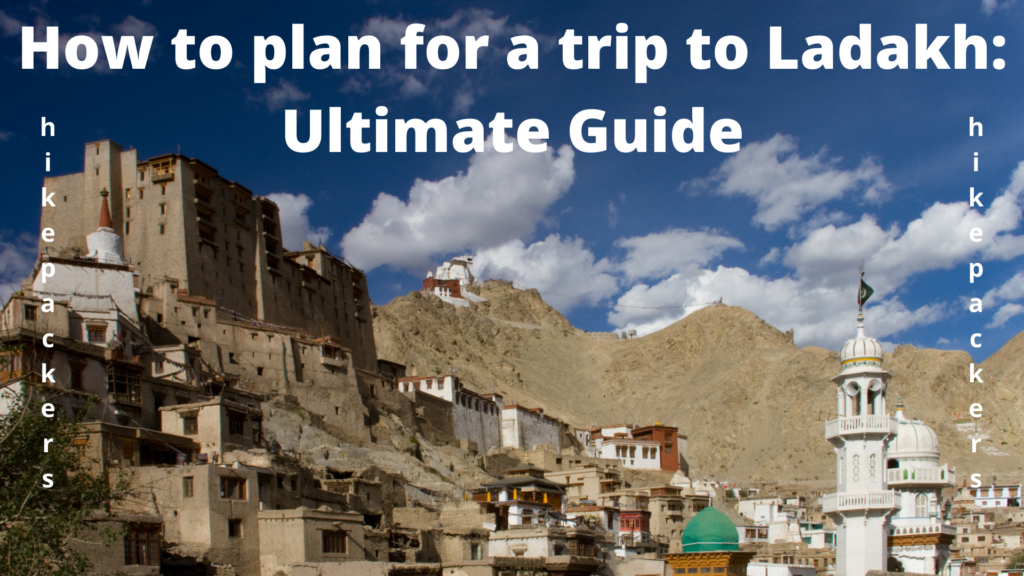
How to plan for a trip to Ladakh: Ultimate Guide

How to prepare for a hike | How to plan for your first hike?
7 thoughts on “how to plan a trek to everest base camp: ultimate guide”.
Pingback: Top 10 Adventure Trekkers Destinations in the World - HikePackers
Pingback: The Ultimate Travel Hacking Guide to Manaslu Circuit Trek - HikePackers
Pingback: The Best Hiking Boots of All Time - HikePackers
Amazing article about guide to Everest Base Camp. I would definitely like to give you the credit as resource when I published Everest Base Camp Trek on my hiking agency.
Pingback: 5 Reasons Why Hiking in Nepal Should Be on Your Bucket List - Adventure Puddin
Pingback: How to break in hiking boots - Hiking Boots
Pingback: 12 of the World's Longest Hiking Trails - HikePackers
Leave a Comment Cancel Reply
Your email address will not be published. Required fields are marked *
Save my name, email, and website in this browser for the next time I comment.
Notify me of follow-up comments by email.
Notify me of new posts by email.
Sign up for our newsletters
The best of hiking news, in your inbox.
Atlas & Boots
The UK's most popular outdoor travel blog
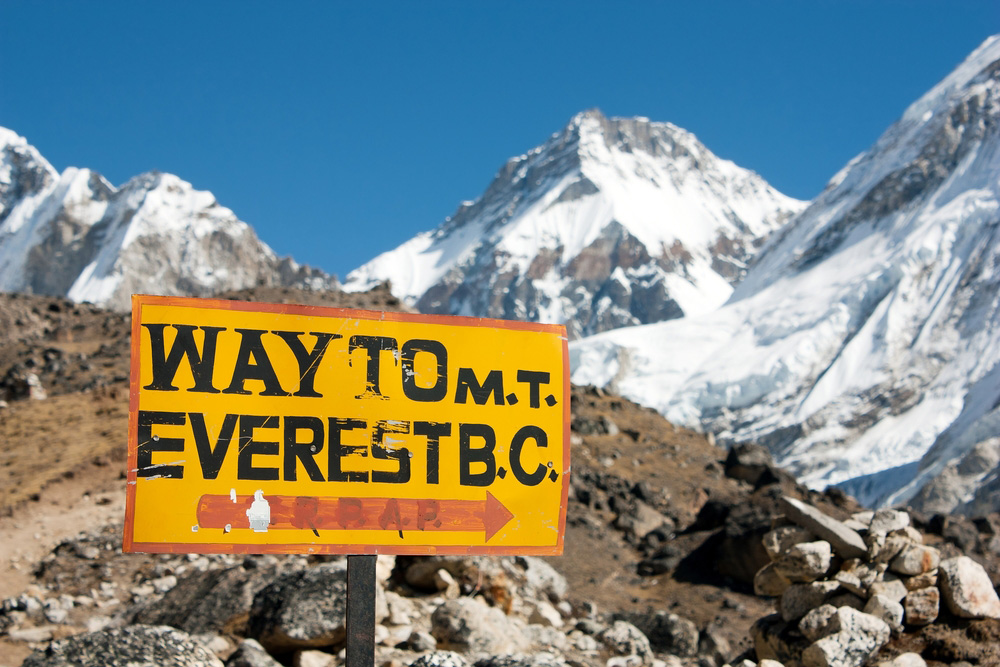
Everest base camp trek tips: 28 things to know before you go
Our Everest base camp trek tips cover everything from permits and teahouses to where to get the best views
I trekked to Everest base camp back in 2019. It was the start of a feverish 24 months of trekking and climbing that took me to the base camps of Earth’s highest and second-highest mountains, across the remote tundra of western Greenland and ultimately to the summit of Aconcagua – the roof of the Americas which, at 6,961m (22,837ft), is the highest peak I’ve ever climbed.
Nepal’s – and perhaps the world’s – best-loved trek is a scenic tour de force. At 8,848m (29,029ft), Mount Everest is the highest mountain in the world. It is one of just 14 eight-thousanders as well as a seven summit . It has captivated intrepid men and women since the first legends of mountaineering made headlines of Everest around the world.
Beyond the epic summits are Sherpa villages, picturesque forests and glacial moraines, all at their best beneath Nepal’s brilliant morning light or blissful evening alpenglow. The route makes use of unparalleled trekking infrastructure with porters and guides taking the heavy loads and cosy teahouses providing soft beds and steaming plates of dal bhat (lentils and rice) along the entire route.
Nepal instantly became one of my favourite countries and I have vowed to return as soon as possible to complete the Annapurna Circuit and Langtang treks. Perhaps one day I’ll go a step further and climb the mountain for real.
Everest base camp trek tips
Given that a few years have passed since my own trek, we asked leading Nepali trekking guides Magical Nepal for their advice on how to get the most from your Everest base camp trek .
Based in Kathmandu, they have a wealth of experience when it comes to trekking throughout the Everest region and the wider Nepali Himalayas as well as Bhutan and Tibet. Together, we have assembled the following list of Everest base camp trek tips you should know before you go.
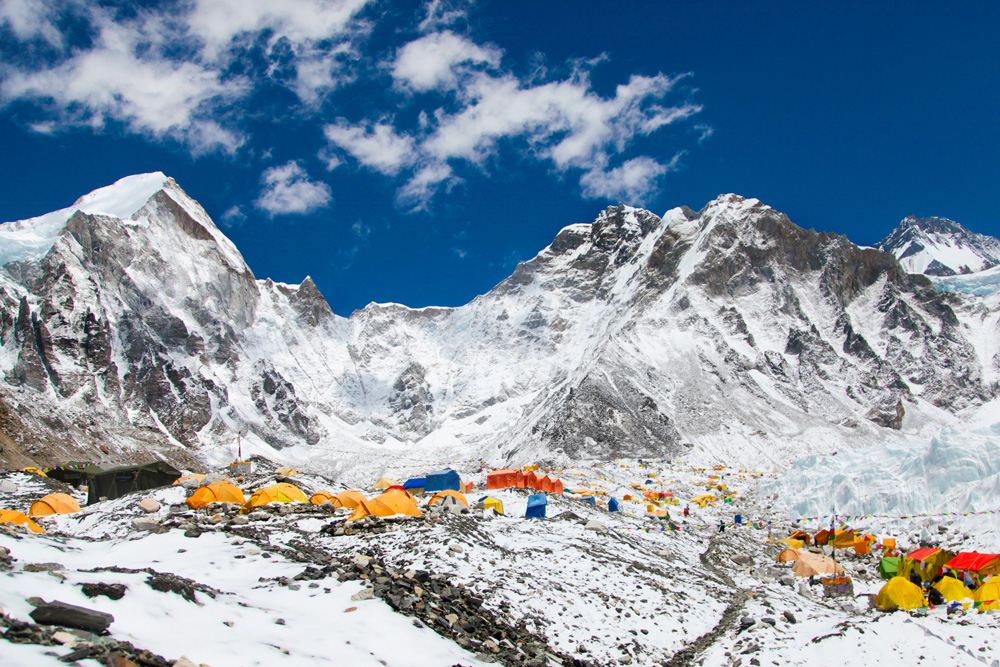
1. At a glance
Duration: 14 days Distance: ~110km Max Altitude: 5,545m (18,192ft) Starts/ends: Lukla Longest day: 19.6 km/7-8 Hours Region: Everest, Sagarmāthā National Park Accommodation: 11 nights in mountain teahouses; two nights in a Kathmandu hotel
2. How long does it take?
An Everest base camp trek typically takes around 14 days which includes 11 days of trekking – although two of these will be acclimatisation/rest days. The trek takes nine days to ascend to base camp and two to descend back to Lukla.
3. How hard is the Everest base camp trek?
On a scale of one to 10, I would say it’s about a six or seven. It is a high-altitude trek, it is for 11 days, you walk for between three and eight hours a day and it can get very cold. It is a challenging trek that shouldn’t be taken lightly.
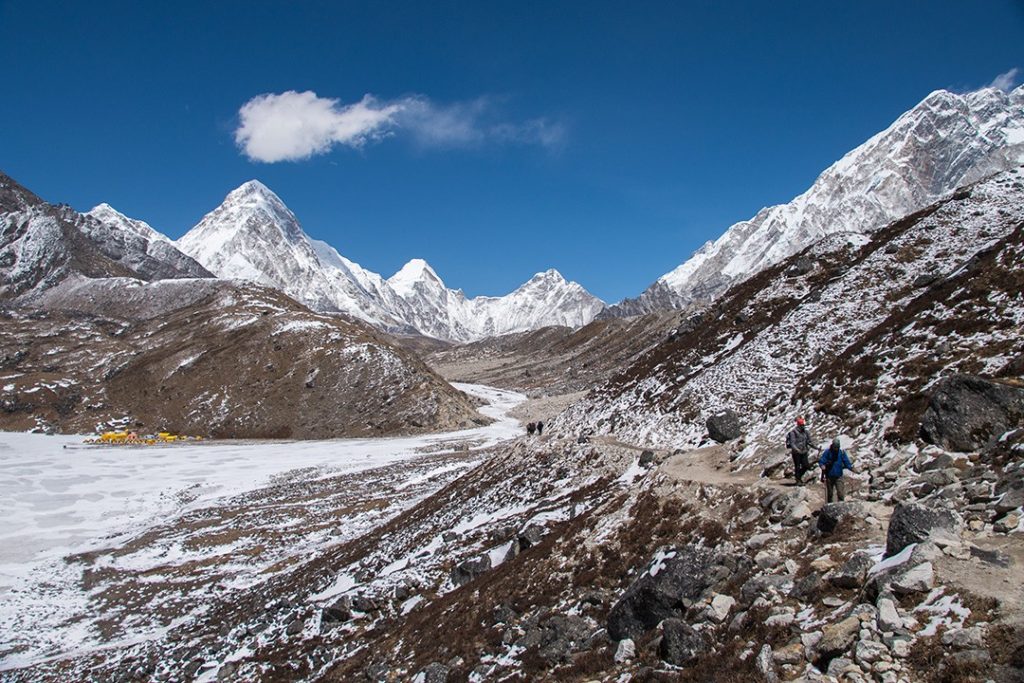
If you have little experience with multi-day trekking or walking at altitude or aren’t particularly fit, then you will find this trek more challenging. A member of our group, a healthy thirty-something man, described it as the hardest thing he’s ever done.
That said, porters carry your heavy gear so your backpack is light, the trail is well-trodden and easy to follow and as long as you take your time and listen to advice, it is a very achievable trek. Every year, over 30,000 people from all walks of life make the trek.
4. How much does it cost and what does it include?
The Everest base camp trek can be booked through Magical Nepal , a Kathmandu-based trekking specialist with a wealth of experience in the region. Prices start from around USD $1,459 for a round trip from Kathmandu and include the following:
- Local transfers for international flights (arrival/departure)
- Local transfers for domestic flights
- Return flight from Kathmandu to Lukla
- Sagarmāthā National Park entry permit and local permits
- Guide for 12 days
- Porters for 11 days
- 2 nights accommodation in a Kathmandu (Bodhi Boutique or similar)
- 11 nights accommodation in mountain teahouses
- 12 breakfasts, 11 lunches and 11 dinners during the trek
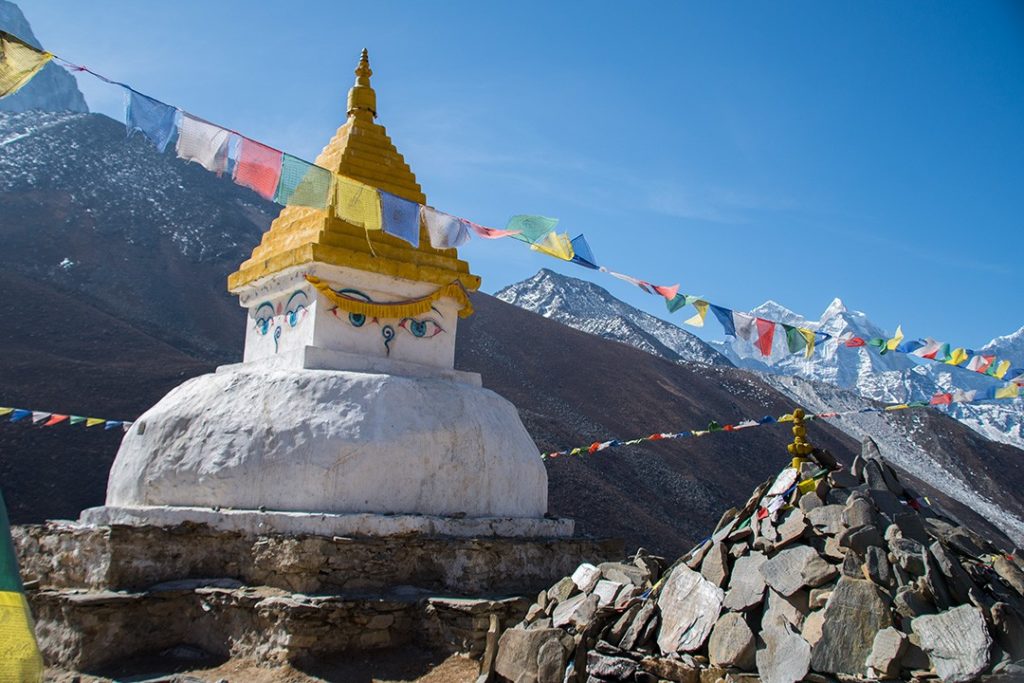
5. How cold does it get?
It depends on the time of year and your location on the trail. The higher you are, the colder it gets. During our trek in early April, it got as cold as -20°C on one night – although most nights were not as cold. The days varied massively. Sometimes we were hiking in shirtsleeves and sweating in the sun while on others we were in cold-weather gear while it snowed.
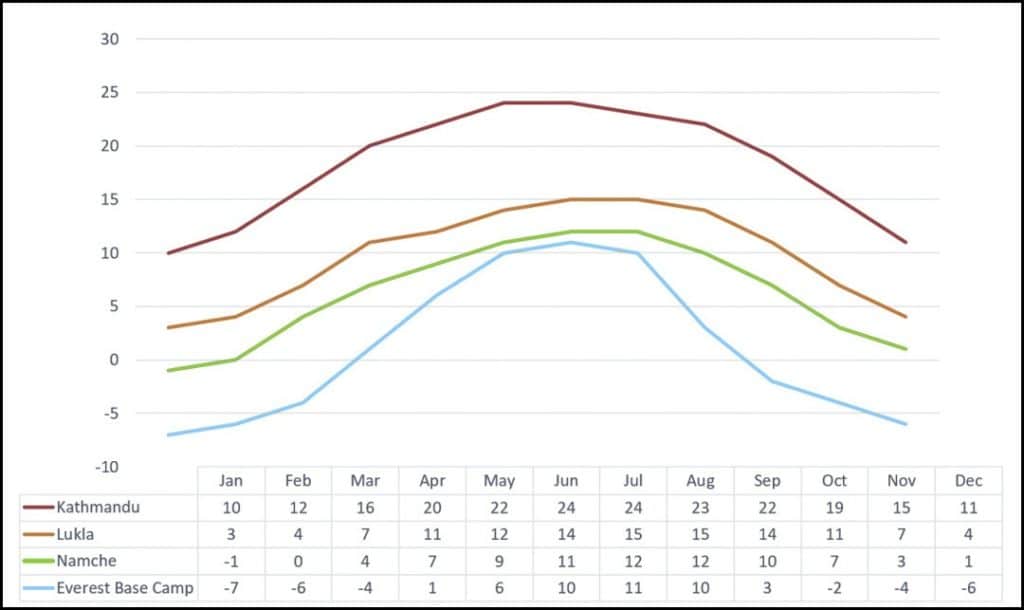
6. When is the best time to trek?
The best time to complete an Everest base camp trek is in autumn (late Sep-Nov). Days are generally dry and clear although there can be the odd shower or storm. This is also peak season so trails are at their busiest.
Another excellent time to trek is during the warmer and quieter spring (Mar-May), which is when I went (early April). This is also the time when the colourful rhododendrons bloom, generally between 2,000m and 3,000m. The drawback is that the dry weather brings dust which leads to hazier days.
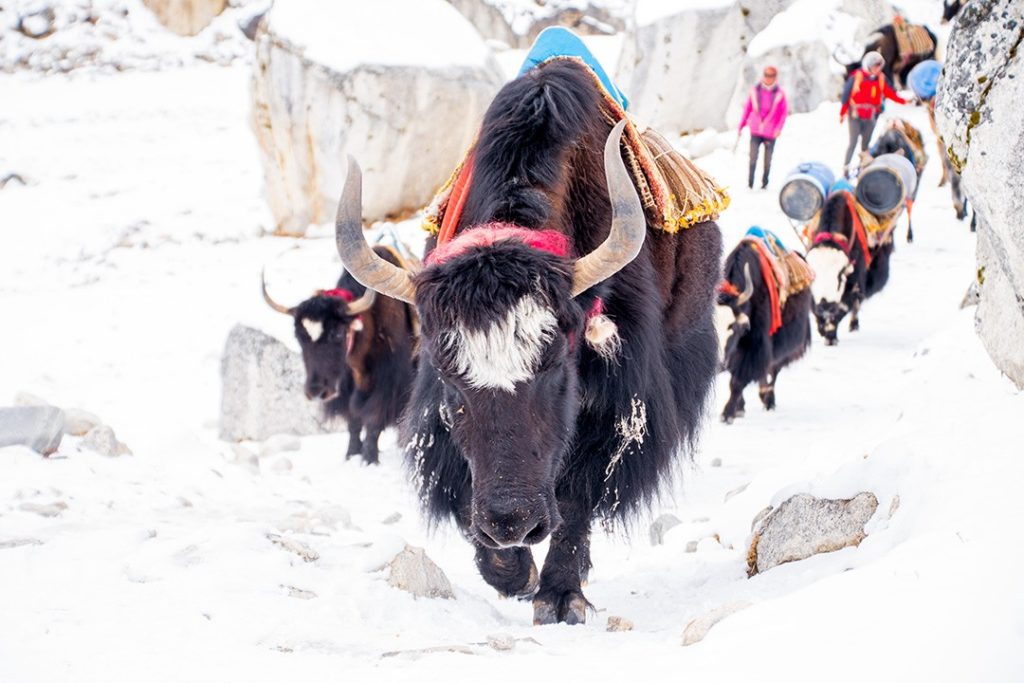
Dec-Feb are good months for trekking, but they are also the coldest and reaching base camp can be a real endurance test. The monsoons arrive in earnest from Jun-Sep, swelling rivers to breaking point, bringing hordes of leeches and making the trail very muddy. Many teahouses will close during these months.
7. Is there snow at Everest base camp?
Absolutely. It’s the base of the highest mountain in the world! It will of course depend on the weather and the time of year, but you should expect to find snow at base camp throughout the year.
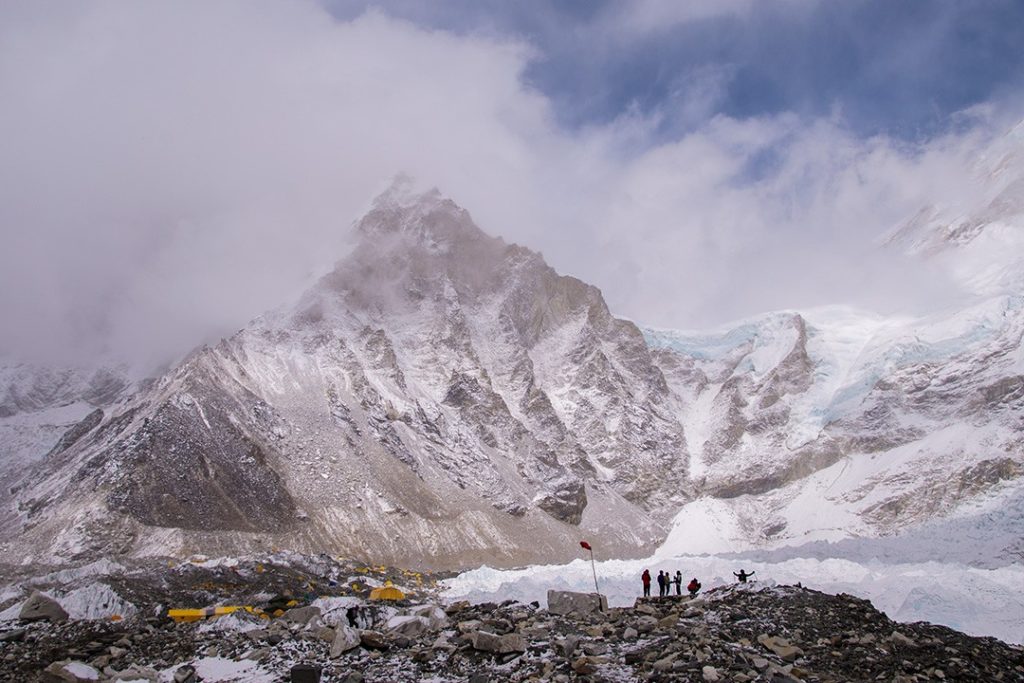
8. What should I pack?
I’ve put together a complete Everest base camp kit list . It contains everything I took with me including clothing, trekking gear, toiletries, medication, electronics and documentation.
9. Can I buy trekking gear and clothes locally?
It is possible to buy (or hire) most items on my Everest base camp kit list on arrival in Nepal. However, I wouldn’t advise leaving it that late and quality can’t always be guaranteed.
Kathmandu does have a host of outdoor shops selling much of what you’re likely to need. There is a collection of imported gear shops – with comparable prices to those in the west – spread along Tridevi Marg near Thamel.
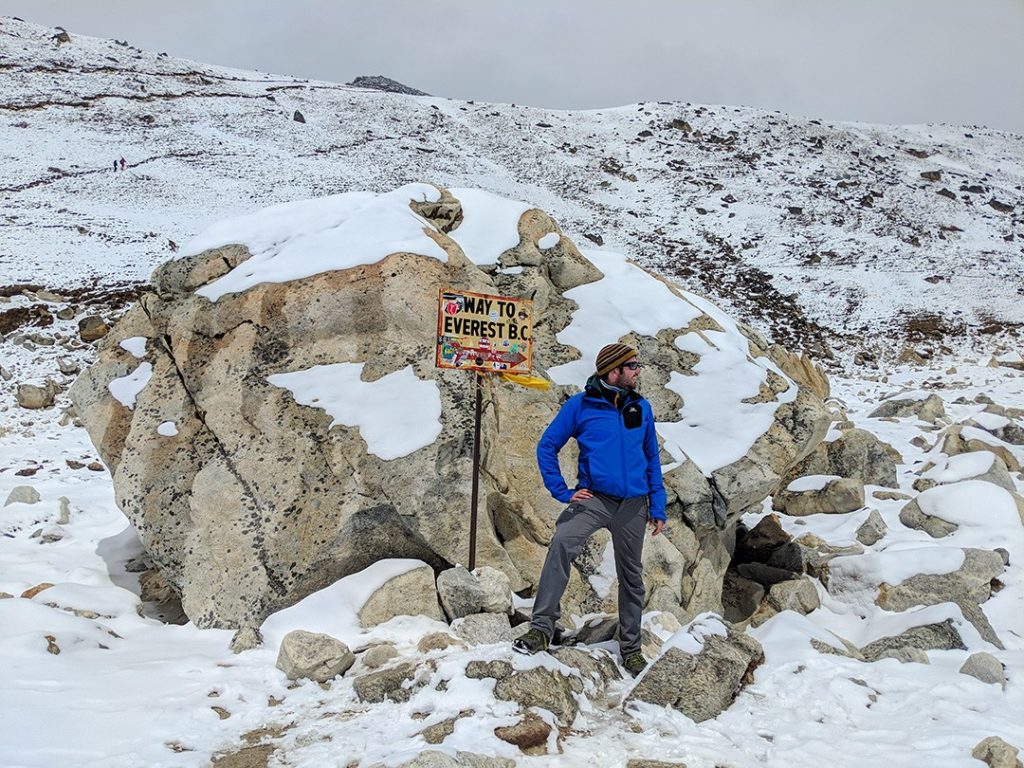
On the trail, Namche Bazaar has some excellent equipment shops including both international ( Sherpa , The North Face ) and local outdoor gear shops as well as countless souvenir shops. There is also a limited assortment of shops and pharmacies in Lukla and other trailside villages en route.
Again, in Kathmandu, it’s possible to hire many items such as sleeping bags and down jackets. Trekkers should always bring their own walking boots and shoes, which should be thoroughly worn in beforehand.
10. What are the weight limits on the flight?
There are strict weight limits on the domestic flight from Kathmandu to Lukla. The flight only allows for 10kg of checked luggage and 5kg of hand luggage. This coincides with the maximum weight porters are allowed to carry: 10kg per trekker with a maximum of two trekkers per porter.
Luggage can be stored securely at your hotel in Kathmandu, but you will need to take all your trekking gear with you. In our Kathmandu hotel, Fuji , there were some luggage scales available for guests to use.
11. What is the flight to Lukla like?
Thrilling! The morning flight to Lukla is spectacular in its own right, with the landing an exciting way to begin the trek. One end of the runway at Tenzing-Hillary Airport in Lukla is 60m (197ft) higher than the other.
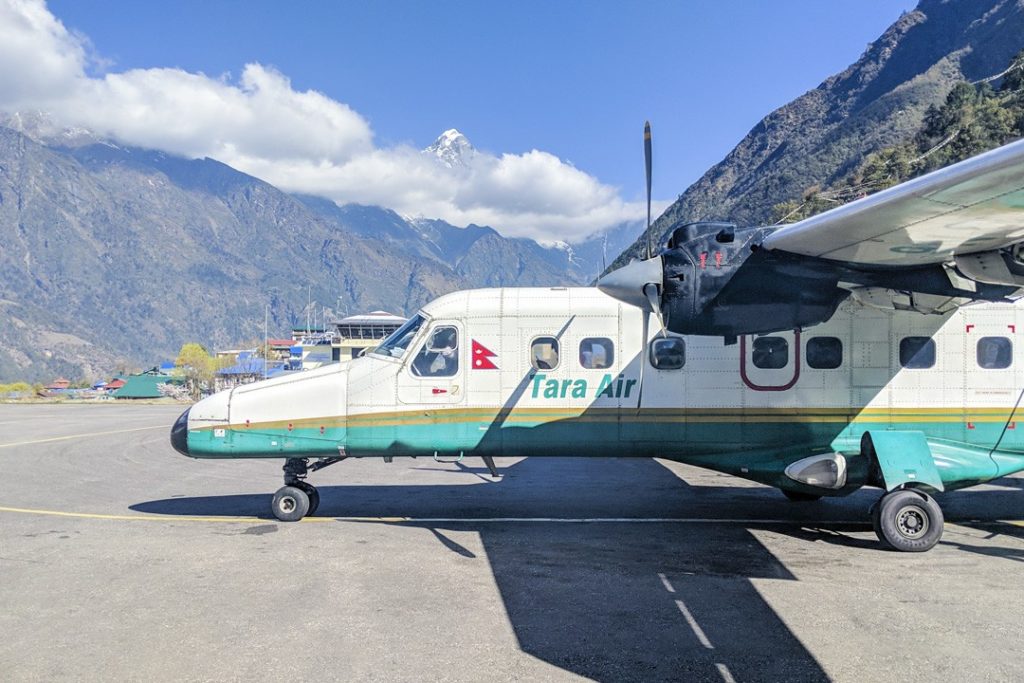
The journey to Lukla takes around 25 minutes by small propeller planes – either Dornier Do 228s or Twin Otters – that seat only 15 to 19 passengers. Spectacular views of the foothills of the Himalayas are on offer, but the weather tends to deteriorate in the afternoon.
If you suffer from travel sickness, I would advise taking some medication. At least one member of our group wished they had! Airsickness bags are provided on the flight.
12. How much should I tip guides and porters?
Tipping when travelling can be a bit of a quagmire, but the guides and porters on the trek deserve every penny they earn and then some. We suggest the following when it comes to tipping local support staff.
- For the head guide between $20-30 USD per client, per week.
- For porters during the trek $4-7bUSD per group, per day.
- For drivers and local guides $1-$2 USD per client, per day.
We had a head guide, assistant guide and five porters supporting our group of 11 clients. Our guide and assistant guide were with us for 15 days and the porters for 12 days.
We each contributed around $150 USD to the tip fund which was divvied up as follows:
- Head guide: $60 x 11 = $660
- Assistant guide: $30 x 11 = $330
- Porters: $60 x 11 = $660 / 5 porters = $132 each
We also collected a few dollars each for our head porter as he was particularly helpful and even invited us to his wife’s teahouse during the descent for snacks and tea.
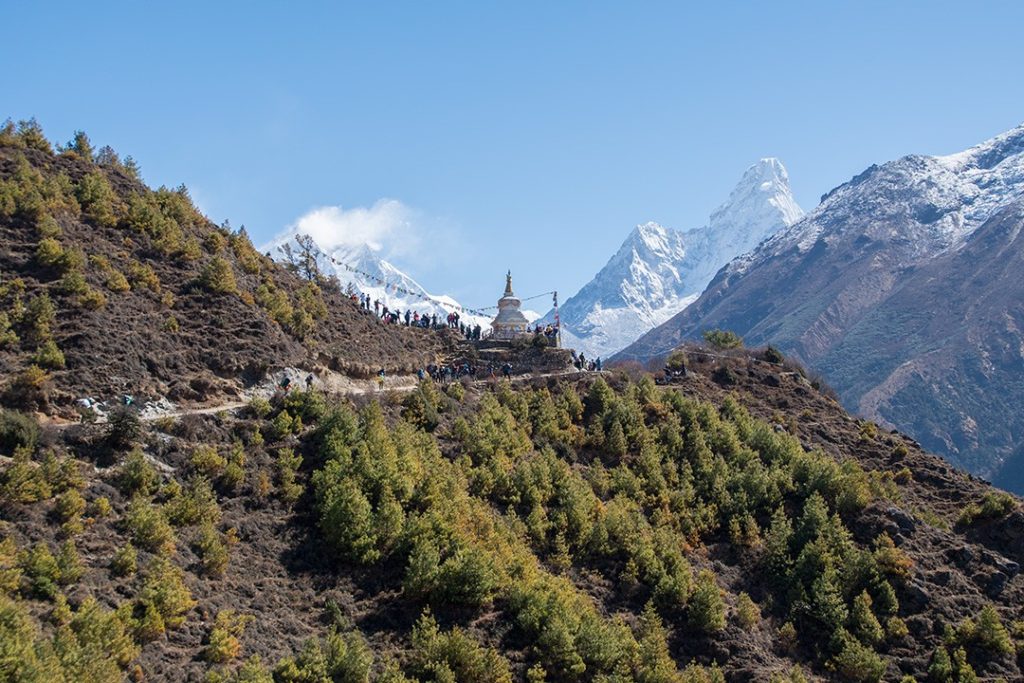
13. Can I charge my phone and camera on the trail?
It is possible to charge appliances at teahouses, but this usually incurs a charge starting from 100 NPR ($1 USD) at lower altitudes and rising to 500 NPR ($5 USD) higher up the trail. Some teahouses charge more for charging a powerbank or camera. I think the most I heard someone paying was 700 NPR ($7 USD) for a large powerbank.
Some cafes on the trail will allow you to charge a device for free if you’re buying a meal or drink.
14. Is there wifi available?
Wifi is available at many villages along the trail. However, these are some of the most remote villages in the world so connection is often interrupted or very slow – particularly when groups of trekkers arrive at the same time and all connect simultaneously!
Again, wifi costs increase as you ascend. Generally, at lower levels, it starts from around 100 NPR ($1 USD) to connect at a teahouse overnight and increases as you get higher.
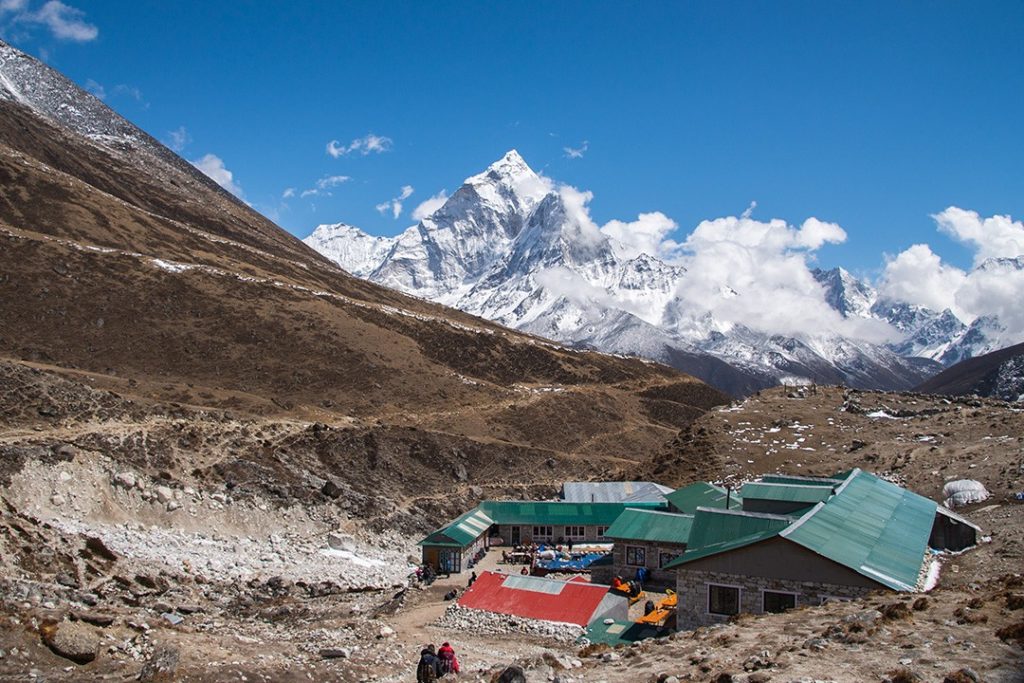
The most reliable connections are the Everest Link hotspots available at most of the villages. These prepaid cards are available in 10GB and 20GB for 1,999 NPR ($20 USD) and 2,999 NPR ($30 USD) packages and last for 30 days. Cards can be bought in Kathmandu, Lukla, Namche Bazaar and in some of the smaller villages.
15. Is there phone reception?
Phone reception is of course intermittent, but there is reception at the lower villages. I made the mistake of buying a Nepal Telecom ‘Namaste’ SIM card at the airport on arrival. However, this didn’t have reception from Namche Bazaar onwards. The Ncell networ k , which my guide and some other trekkers had, appeared to have better reception further up the trail and my guide recommended them.
Both providers have outlets at the airport and throughout the country and offer a range of data packages. You’ll need a copy of your passport and a photo to obtain a SIM card.
Another option is to get a Holafly eSIM for Nepal so you can stay connected to the internet on your trip. We can offer our readers 5% off Holafly purchases. Simply use the code ATLASANDBOOTS at checkout.
16. Is it safe to drink the water?
Yes, it is safe to drink water as long as you use purification tablets. Nearly all teahouses and restaurants can provide drinking water free of charge. Only at Gorakshep (the last stop before base camp) was it necessary to buy bottled water, as there is not a natural spring nearby.
Otherwise, do not buy bottled water or bottled soft drinks on the trail. Plastic bottles are difficult to dispose of and have become a serious environmental problem.
17. What is the food like?
The food is actually pretty good along the trail. For lunch and dinner, every teahouse serves the traditional Nepali Dal Bhat (rice and lentils) as well as a variety of meals such as rice, vegetables, noodles, potatoes and soup along with Nepali versions of western food such as pizza, pasta, sandwiches and veggie burgers.
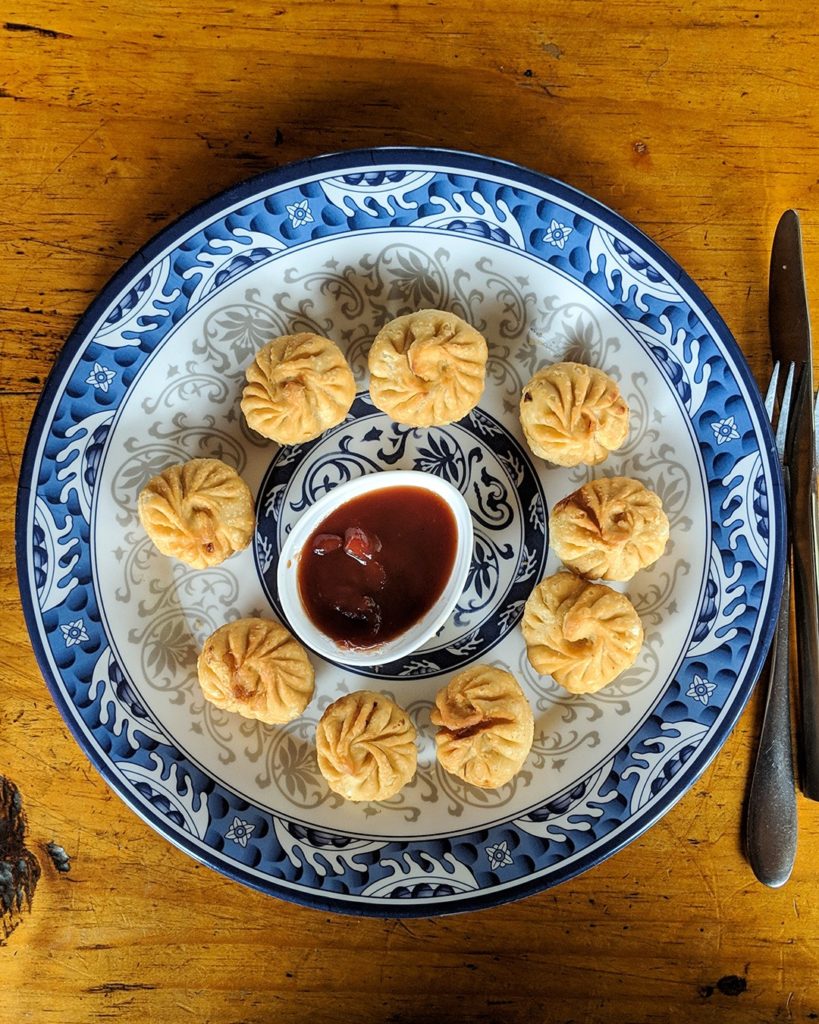
The food on the trail was tasty and varied
Breakfast is usually a choice of porridge, various styles of eggs, toast, pancakes or the delicious (but sweet) Tibetan bread.
Do not eat meat along the trail, particularly higher up, as it has to be flown into Lukla and then transferred up the trail. Additionally, refrigeration cannot be relied upon.
Regardless, it’s much better to stick to a carb-heavy vegetarian diet as it’s just what you need on a long high-altitude trek such as this.
18. How much do meals cost?
I found I was spending around $20-30 USD per day on food, hot drinks and snacks – and that often included a fee for charging a device, a hot shower or wifi.
However, if joining an organised trek, all meals along the trail are usually included in the price so you only have to pay for your meals in Kathmandu.
If you’re travelling independently, allow for between $400-600 USD in total for meals along the trail. The cost of food and drinks gets more expensive the higher you trek.
19. Can I take a shower during the Everest base camp trek?
There are some hot showers at teahouses on the trail at an additional cost ($3-5 USD). I took two hot showers during the trek. The rest of the time I just had cold-water washes.
Only have showers at teahouses with solar heaters. Don’t use water heated by wood, as a lack of firewood in villages is a big environmental concern in Nepal. Your guide will be able to advise you.
20. Is the Everest base camp trek dangerous?
All high-altitude treks involve a certain degree of risk. However, if you follow these Everest base camp trek tips, along with the advice of your guide and adhere to the set acclimatisation itinerary, then most healthy people will complete the trek without any serious issues.
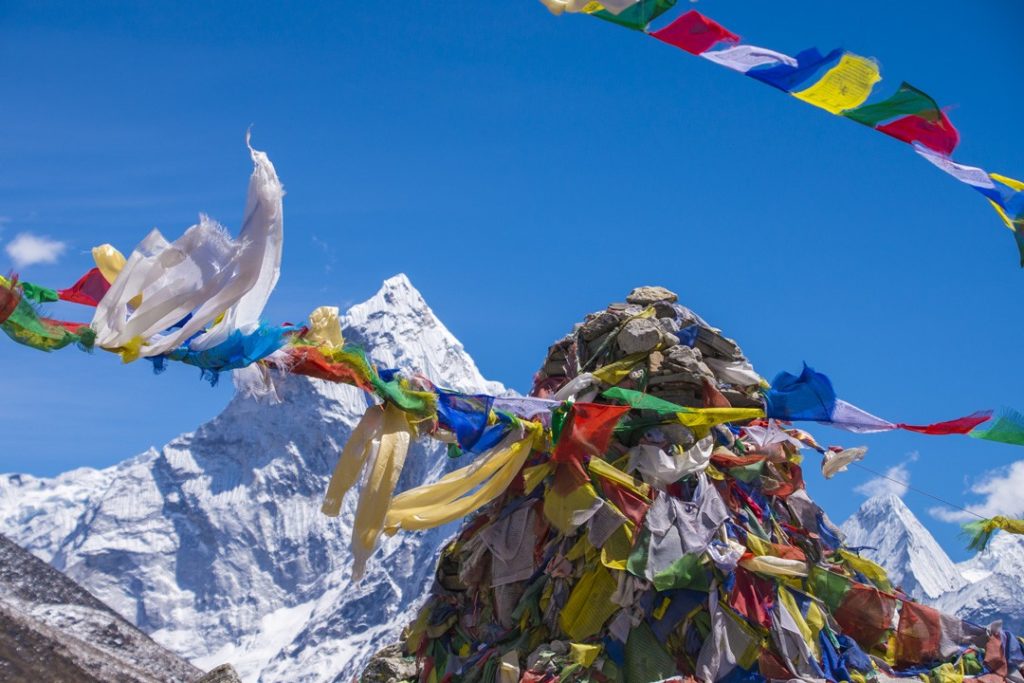
The important thing with high-altitude trekking is to not rush, go at your pace and listen to your body. Read our detailed guide on how to identify, treat and prevent altitude sickness symptoms .
21. Should I take Diamox?
This is very much down to the individual. I didn’t take Diamox, but I have been up to this altitude several times before so knew what to expect. However, I did have some with me in case I felt bad at the higher altitudes.
The best advice I can give is what trekking guides have told me in the past. Have some Diamox with you and take it as soon as you start to feel the pulsing headaches that are synonymous with altitude sickness . He said it’s good to have some available at the higher altitudes – particularly at Gorakshep where you sleep at 5,300m – so you can use it to help you get a good night’s sleep.
22. Do I need sunscreen?
Yes! Despite the cold, the sun is intense. Make sure you wear sunscreen with an SPF of at least 40, lip balm with SPF protection, sunglasses and a sunhat.
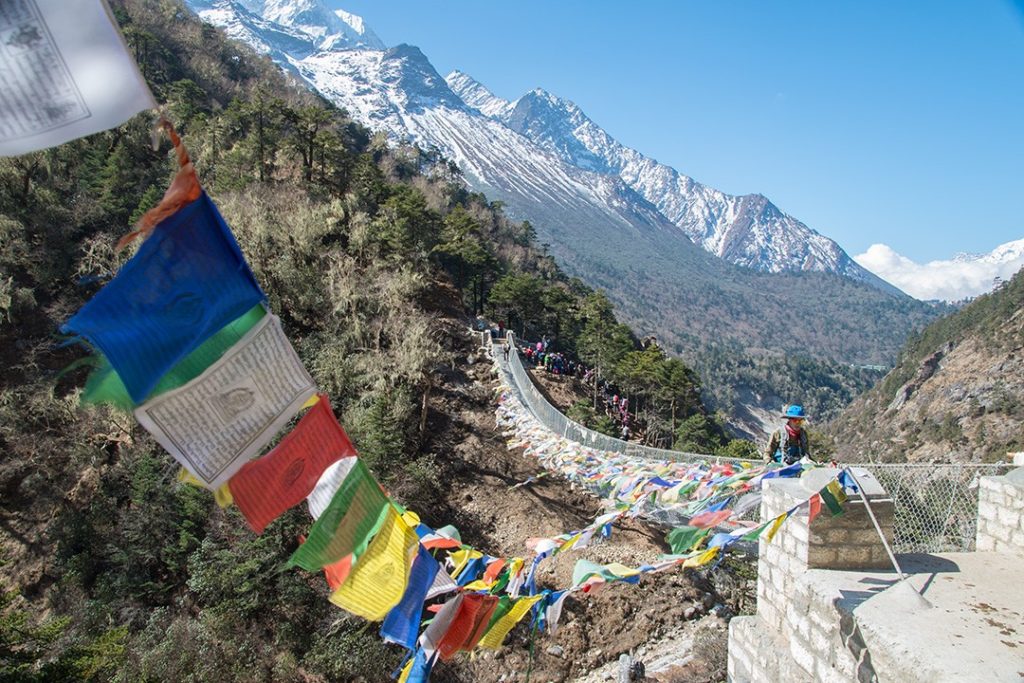
23. What sort of travel insurance do I need?
One of the most important Everest base camp trek tips is to make sure you select a travel insurance policy that has sufficient medical coverage. It must have a minimum coverage of $200,000 USD for repatriation and emergency rescue. Make sure you check how your policy covers ‘dangerous activities’ such as trekking at altitude and mountaineering.
It must cover the possibility of a helicopter evacuation for trekkers and general medical evacuation to Bangkok or Delhi, which alone can cost $40,000 USD.
24. Do I need a trekking permit?
To trek to Everest base camp you must enter Sagarmāthā National Park where you will need to pay a national-park fee. For foreigners, not from a South Asian Association for Regional Cooperation (SAARC) country, the fee is 3,000 NPR ($30 USD) per person. A full list of park entry fees in Nepal can be found here .
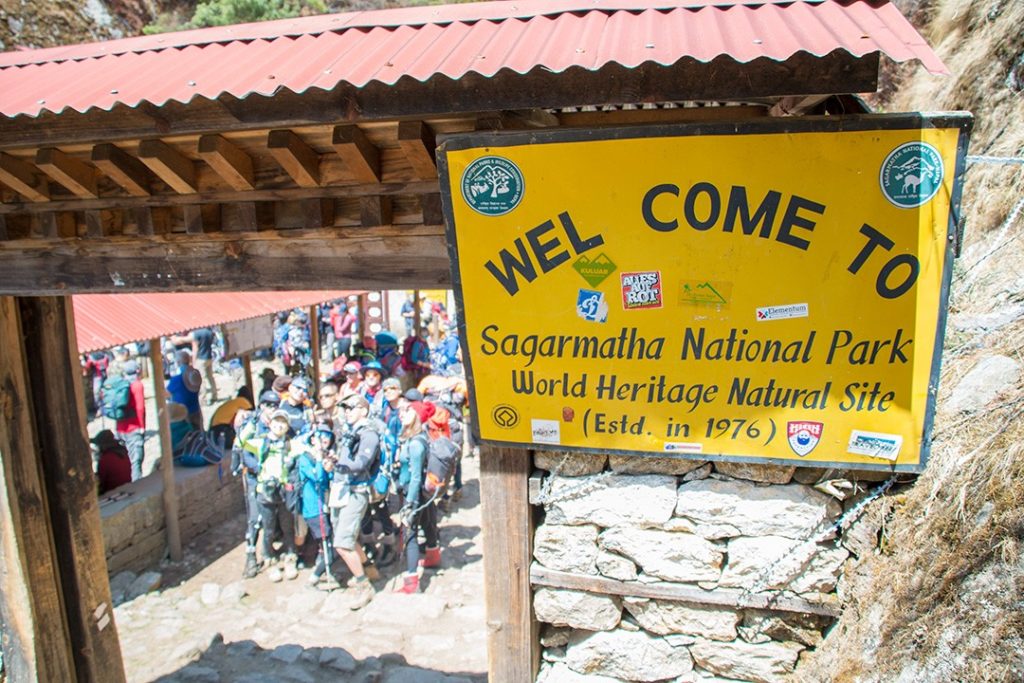
If you’re joining an organised trek, the fee should be included in the trip cost.
25. Are the teahouses warm?
There is usually a large dining room-cum-lounge with a stove in the centre where trekkers hang out in the evenings. The stove is usually lit in the early evening so the room gets pretty cosy.
However, the bedrooms remain chilly, to say the least. A blanket is often supplied which, combined with your sleeping bag, means you should be warm enough once safely cocooned in your bedding. The cold certainly never stopped me from getting a good night’s rest.
26. Can I drink alcohol along the trail?
There are teahouses, restaurants and even bars in the villages along the trail that serve alcohol. However, I wouldn’t recommend drinking any alcohol until you’re on your way down.
Some members of our group drank alcohol on the way up and they all suffered for it. On the way down you’ll be accustomed to the altitude and in a far better state to enjoy a snifter or two.
Furthermore, drinking higher up the trail just encourages demand. All those cans of beer you don’t need have to be carried on the backs of porters and yaks.
27. Can I see Everest from base camp?
Yes, although because of the angle it is somewhat obscured by Lhotse, Nuptse, the West Shoulder and the South Col. The best views of the Everest massif and the Khumbu Icefall are from the nearby summit of Kala Patthar.
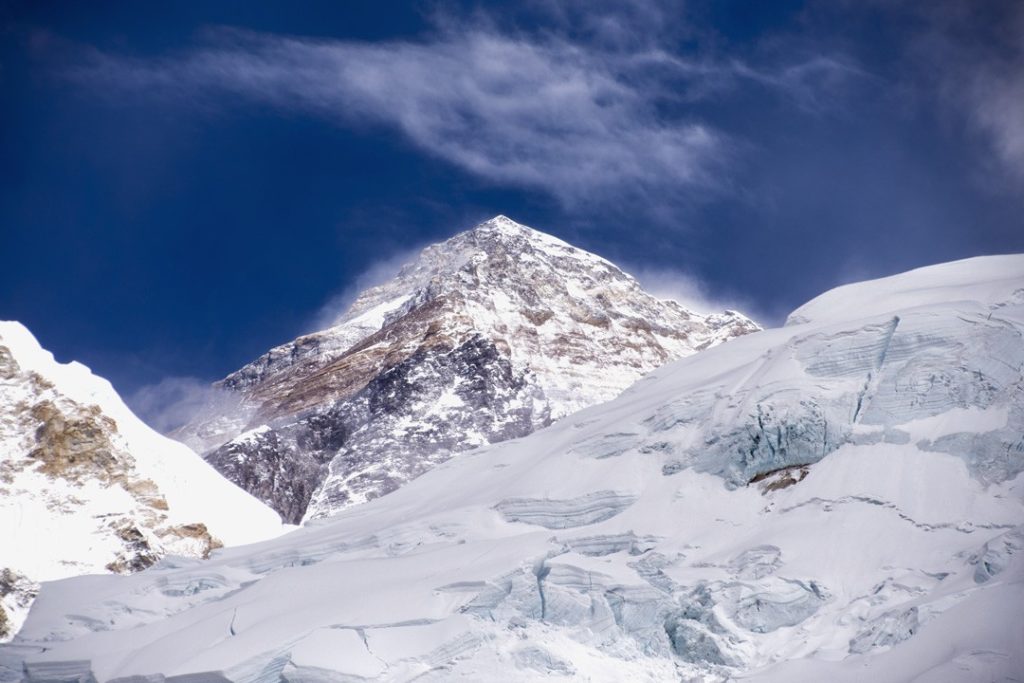
On my trek, no one fancied the optional early morning hike up Kala Patthar, so I dragged myself out of bed and headed off alone. I didn’t have enough time to make it to the summit, but I got as high as the plateau which still offered some excellent views. The wind was lashing and it was ferociously cold, but I do regret not getting up a bit earlier and making the full ascent.
28. Is the Everest base camp trek worth it?
Without a doubt, yes.
After over 100km of high-altitude trekking amid soaring peaks, Sherpa villages, picturesque forests and glacial moraine concluding at the foot of the world’s highest mountain, I can safely say the experience was everything I hoped it to be.
Enjoyed this post? pin it for later…
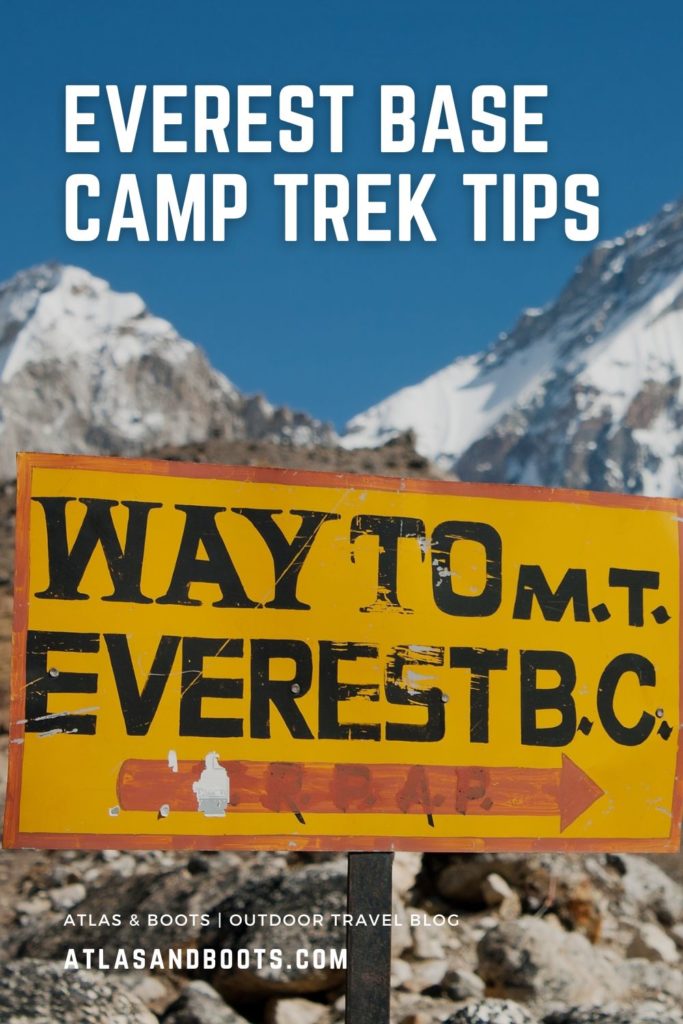
Lead image: Daniel Prudek/Shutterstock
You might also like:.
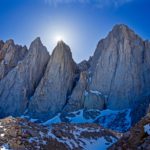
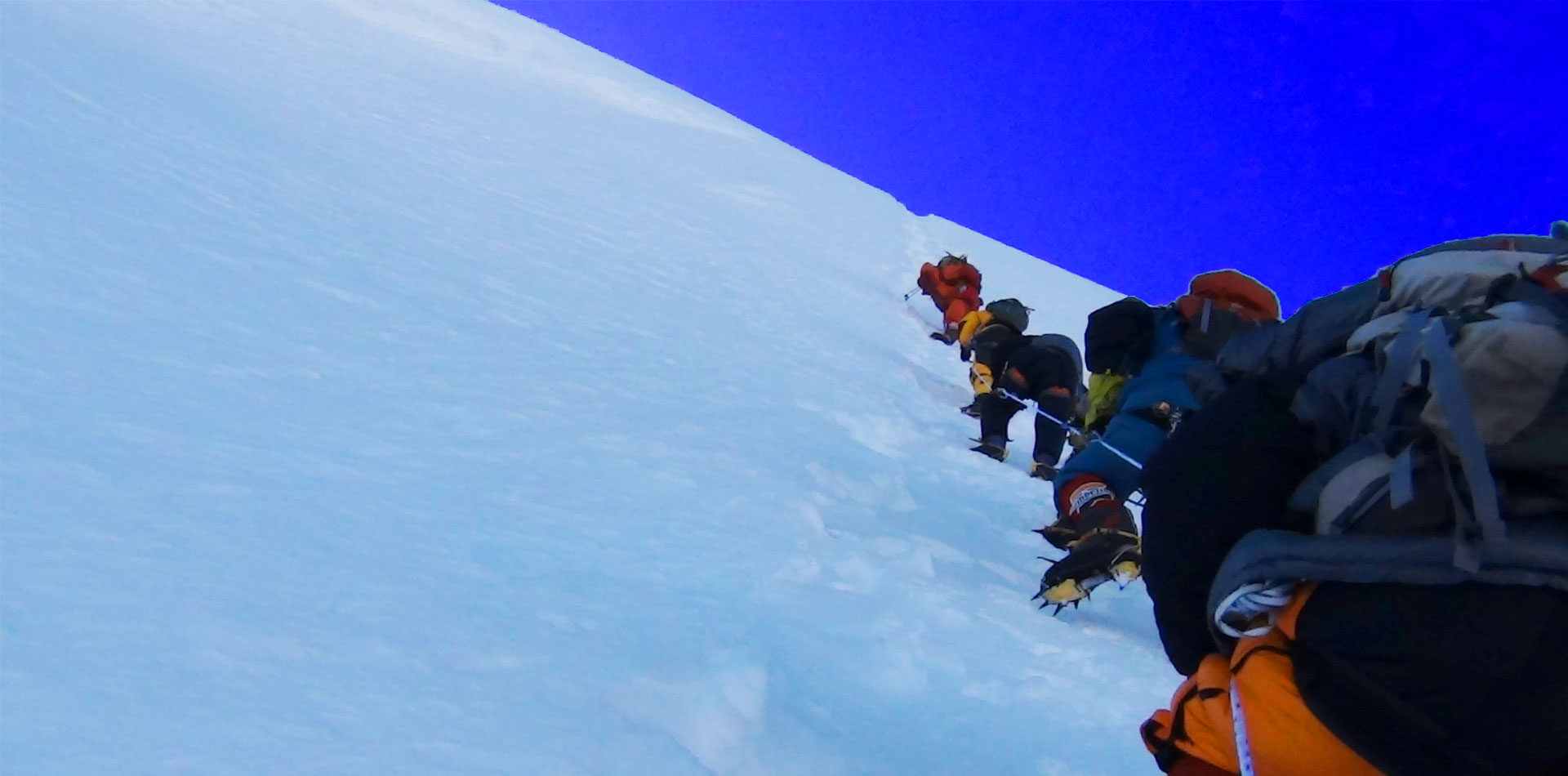
Everest Base Camp Trek – A complete Guide
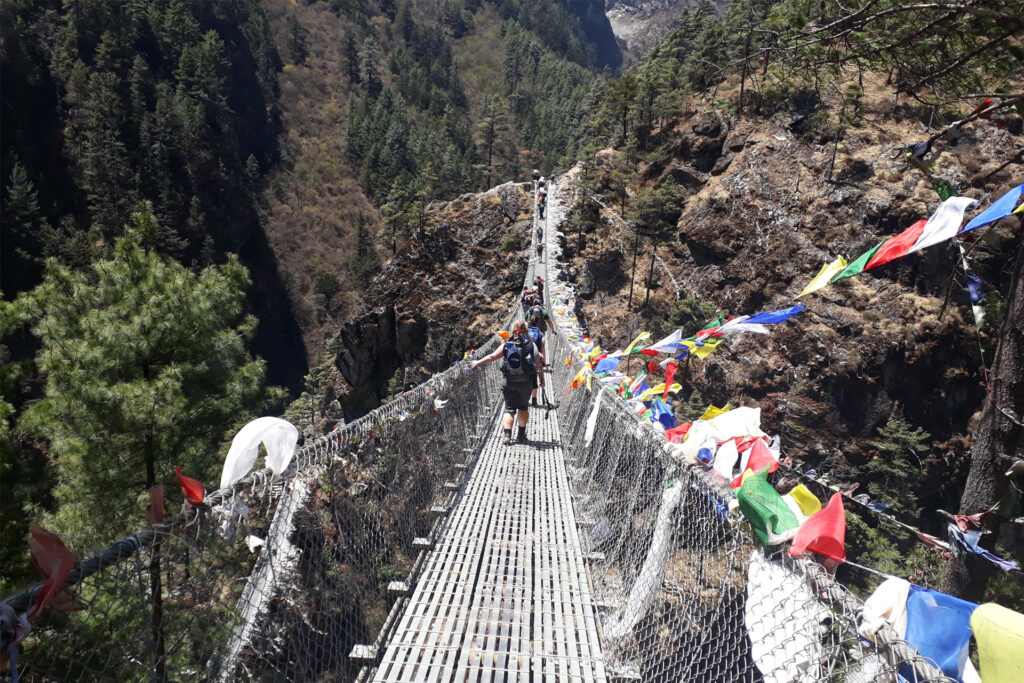
For Everest Base Camp Trek, take a short spooky flight above the mountain hill to Lukla, and follow the footsteps of legendary trekkers and climbers to achieve this uniquely distinctive and iconic adventure journey.
Everest Base Camp Trek Facts
- Required Trip Duration : 12 days
- Trek Difficulty: Moderate
- Highest Altitude : 5545m (Kalapathar viewpoint)
- Distance : 120 km/75 miles
- Accommodation: Teahouse
- Guide and Porter: Both are not mandatory. You can go independently or can hire a guide and porter to support you and make your trip easy and joyful
- Required permits: Local government tax and Sagarmatha National Park Permit
- Best Time to Trek to EBC : March to May(Spring) and September to November(Autumn)
- Start and End Point: Kathmandu to Kathmandu
Highlights of EBC Trek
- Explore lifestyles and culture of Local sherpa communities
- Astounding mountain views of Towering peaks including the highest Mt Everest (8848m), Lhotse (8,516m), Makalu (8,463m), and Cho Oyo (8,201m)
- Explore Sagarmatha National Park, Mani wall, Gompas, Prayers flags, Prayers wheels, and high suspension bridges
- Visit Ancient Tengboche Monastery – the biggest monastery in the region
- Highest glacier on Earth – Khumbu Glacier
- Diversity of flora and fauna along with wildlife – Colorful Pheasants, Musk Deer, Himalayan Thar, and Snow Leopard
Everest Base Camp Trek Overview
Everest Base Camp Trek has been a goal of thousands of novice, independent and anxious trekkers all around the world. Here you can get the genuine and honest facts of this trek before you come to achieve it. So, feel easy to ask if you have any queries regarding this trek.
In this article, you’ll get general ideas of the overview of Everest Base Camp Trek along with itinerary, health requirements, packing list, permits, and frequently asked questions. Indeed, this article is especially for backpackers who want to trek to Everest Base Camp on their own path.
Basically, Mt Everest has two base camps – one is on the Nepal side and another is on Tibet, China side. But Everest Base Camp Trek is a wonderful trip that begins from Lukla to approach Mt. Everest closer to reaching Everest Base Camp (5364 m) and Kala Pathar (5545 m). It literally means the trek lies in Nepal and reaches to South Base Camp of Mt Everest. This iconic journey leads you through a few Sherpa villages in Khumbu, offering the beauty of the Sagarmatha National Park. Meanwhile, you will be delighted with a mesmerizing view of the dignified mountains above 8000 m. Mt Lhotse, Mt Nuptse, Mt Cho Oyu, Mt Makalu, and Mt Ama Dablam are the major peaks that you can observe on this trek. You can also observe the customs and traditions of Local Sherpa people along with their lifestyle.
The trek covers a distance of 130 Kilometers beginning and ending in Lukla. To find out more, you can visit our article Everest Base Camp Trek Distance .
To reach Kalapathar is this trek’s ultimate destination, which is elevated 5545 m above sea level. Therefore, Everest Base Camp Trek is also known as Everest Kalapathar Trek .
The trip begins from Kathmandu, however, the trek starts from Lukla. Alternatively, one can choose Jiri to EBC route to avoid the Lukla flight. But it requires 4-5 more days than Lukla to EBC route.
If you don’t wish to do such a long exhausting journey but want to see Mt Everest from closer, then Everest Base Camp Helicopter Tour can be another best alternative way to see Mt Everest for you.
Check out 5 different trekking itineraries for Everest Base Camp
Everest Base Camp Trek Route Map
Below, you can view an overall map of Everest Base Camp Trek.
There are several maps you can get on premium online. Instead, you can buy it after you arrive in Kathmandu.
Click here to see the pictorial map
Detailed itinerary of EBC Trek
Day 01 arrival in kathmandu (1350m/4429feet).
If you have booked your trip with us or any tour operator either local or international, there will be one of their members to pick you up as per your and the tour operator’s understanding. If not, then you can find a Taxi there. But you have to do an agreement on the price before getting into the Taxi. Meter is rarely used by them.
We can suggest you book a hotel around Thamel as there are many hotels that range from Budget to Standard level. If you arrive in Kathmandu earlier, then you can even visit around Thamel .
Elevation Gain: 1310 m
Day 02 Fly to Lukla (2880m/9448feet), then trek to Phakding (2610m/8563feet)
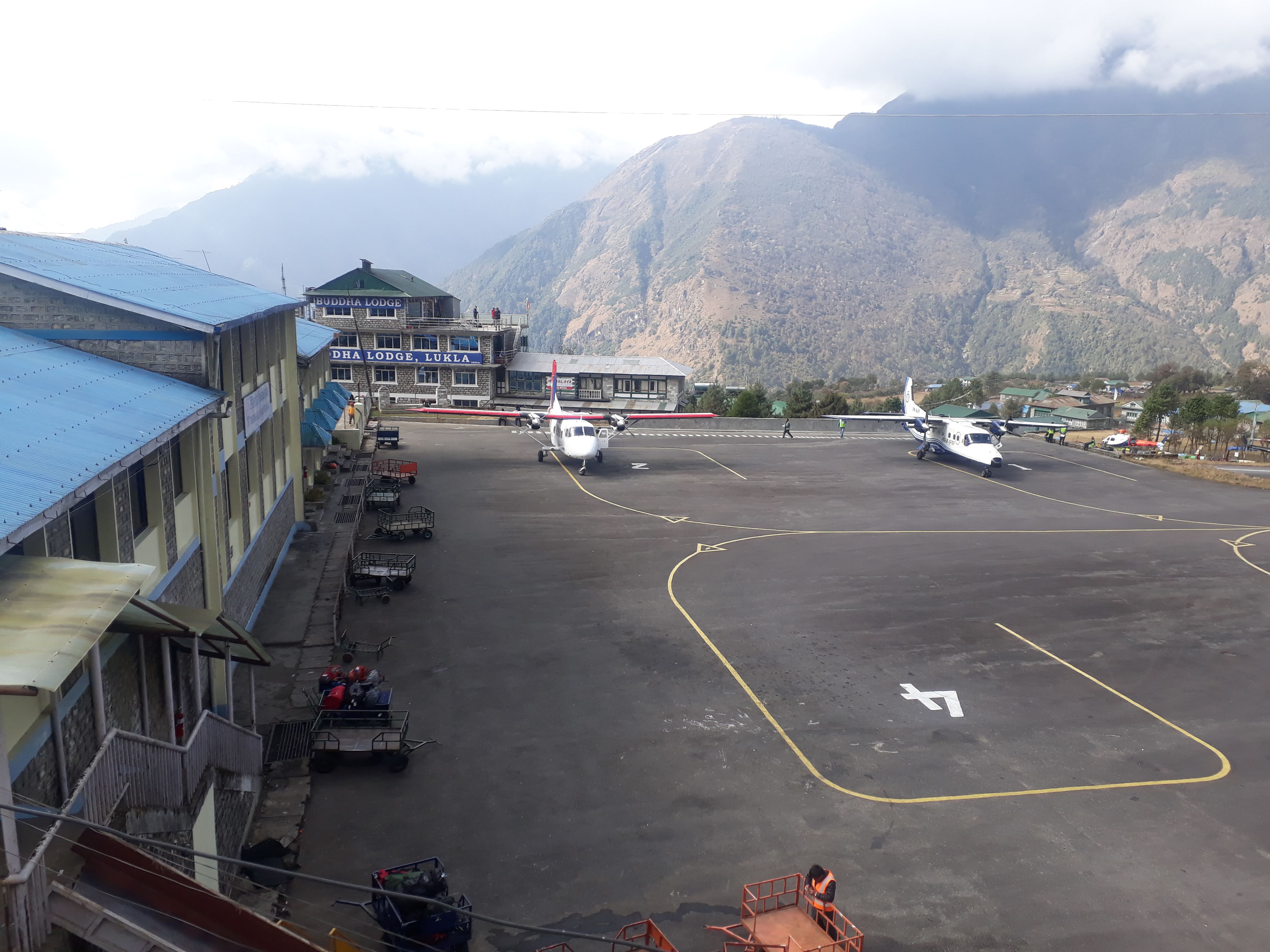
Flying in a short scary domestic flight to Lukla and following the bank of Dhudhkoshi River crossing a few quizzical suspension bridges, you arrive at a small Sherpa Village called Phakding by 2-3 hours walk. Here it will be your first mountain overnight.
Either your tour operator will arrange the flight ticket for you or you should purchase the tickets at the airport. However, the ticket can be unavailable during peak trekking and climbing seasons. So, it would be better to buy tickets earlier either through a travel agency or directly from the airline’s website. Basically, the Lukla flight ticket costs around 280 USD which includes a return ticket as well.
There are chances of cancellation of Lukla’s flight due to bad weather. So, we recommend you make a flexible itinerary as much as it is possible. Having one or two spare days would be better.
Elevation Gain: 2880 m Lukla, and 2610 m Phakding
Day 03 Trek to Namche Bazaar (3440m/11286feet)
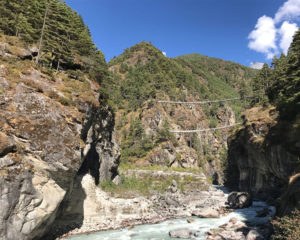
Today, you will be trekking through some local villages like Monjo, Jorsalle, etc till reaching Namche Bazaar – The biggest Sherpa town in the region. You can cut your lunchtime in Monjo as many trekkers do. From here, you will be entering Sagarmatha National Park which is home to many endangered wild animals. It has been also enlisted in UNESCO WORLD Heritage Site.
You will take a steep hike to Namche Bazaar after passing Jorsalle. It will take you 2 hours approx to reach Namche Bazaar. You will have enough time to visit Namche Bazaar and see the small markets.
From Namche Bazaar, the Everest Three High Passes Trekking route separates and moves toward Thame village which follows the path to Renjo La Pass, while the EBC route goes to Tengboche.
Elevation Gain: 3440 m
Day 04 Acclimatization day in Namche Bazaar
Reaching 3440 m altitude above sea level, anyone could suffer from altitude sickness problems. So, Namche is a great stop for acclimatization for Everest Trekkers. It will offer an opportunity to explore the village from near.
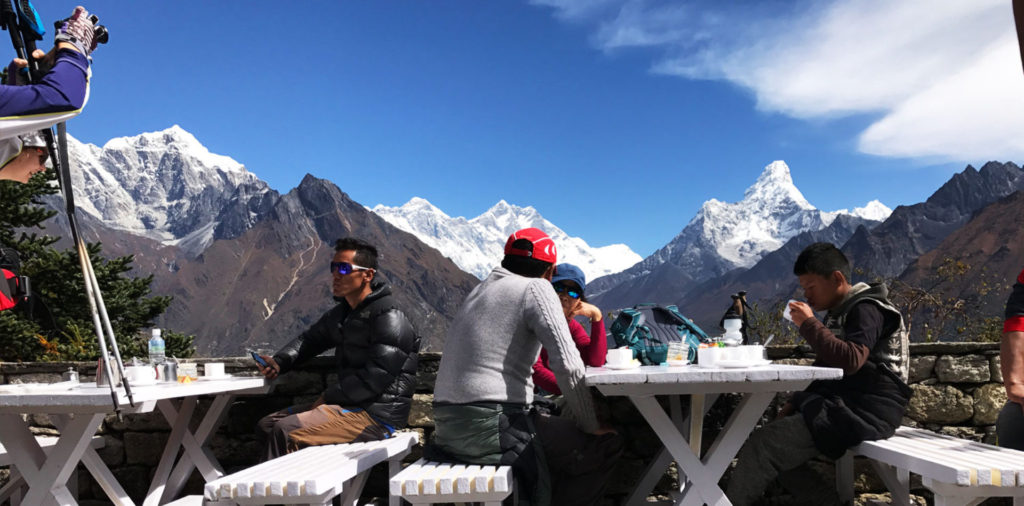
In addition, many love to hike to Everest View Hotel to see a glimpse of Mt Everest and the surrounding mountains. You can chill here by having a cup of tea or coffee ; you also can snap awe-inspiring pictures of Mt Ama Dablam in the foreground while Mt Everest will be in the background if the sky is crystal clear. Besides that, the hotel provides WiFi that enables you to contact your relatives and share how you are feeling.
Day 05 Trek to Tengboche (2860m/12664feet)
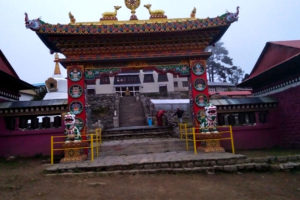
Today, you will be heading toward Tengboche, the home of one of the largest monasteries in Khumbu i.e Thyangboche Monastery. It is a mixture of great architecture and color that has a history of over 500 years.
Elevation Gain: 3860 m
Day 06 Trek to Dingboche (4410m/14468feet)
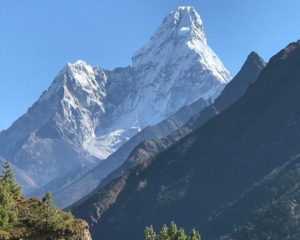
On the 6th day, either you will head to Dingboche or Pheriche. The way follows the same path until it reaches Worshyo Village. It then separates – one way goes to Pheriche and another to Dingboche. I always advise choosing Dingboche when you are going toward EBC. If you are coming down, then staying in Pheruche would be good. From Dingboche, Ama Dablam mountain is very closer. A way goes toward Chhukung from Dingboche that traces a path to Island Peak Climbing . However, the next day, we will not take our path to Chhukung because the EBC trek moves toward Lobuche.
In fact, the EBC route from Dingboche or Pheriche, both meet at the same point i.e Dughla, then approach the Lobuche where you will spend your 7th overnight stay at the mountain.
Elevation Gain: 4410 m
Day 07 Trek to Lobuche (4940m/16207feet)
As I already mentioned that your path from Pheriche or Dingboche meets at Dughla village, and head toward Lobuche having extraordinary scenery of mountains. Within 5-6 hours, you will be at Lobuche village.
Elevation Gain: 4940 m
Day 08 Trek to Everest Base Camp (5364m/17598feet)
From Lobuche, you walk through a rough rocky terrain path passing Gorakshep. You will spend 40 minutes approx in EBC enjoying and collecting the view of Nuptse, Lhotse, Pumori, etc mountains. Thereafter you come back to Gorakshep for an overnight stay.
Elevation Gain: 5364 m
Day 09 Kalapathar Hike (5545m/18192feet) and trek back to Pheruche
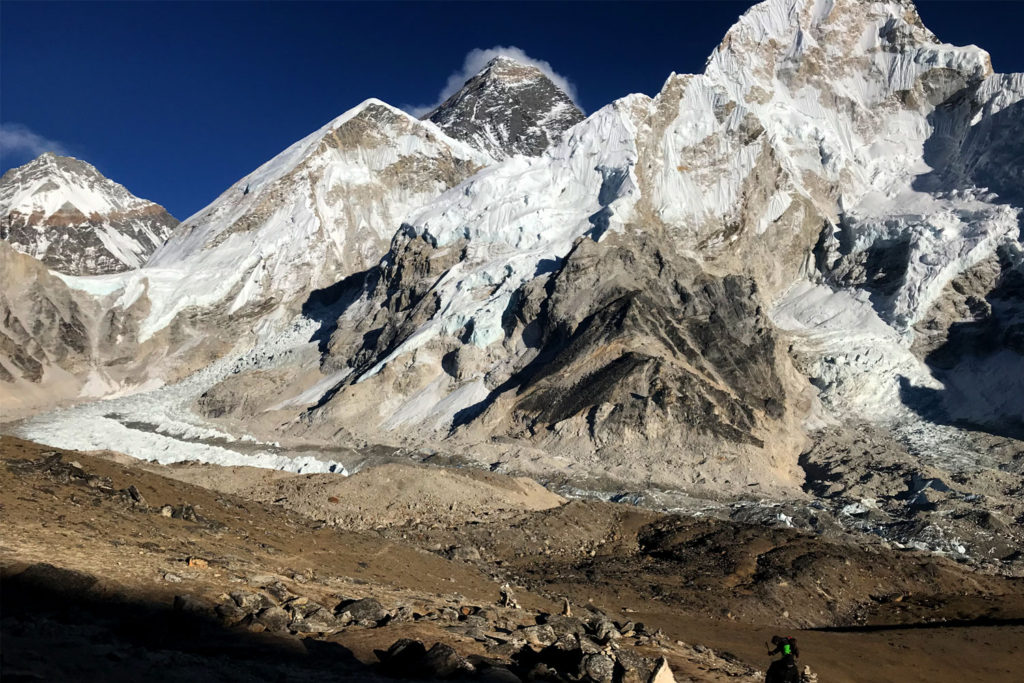
Approximately 2 hours hike to Kalapathar will wonder you today when you reach there. Kalapathar is the optimal viewpoint of Mt Everest and its neighboring mountains. After spending 30 minutes, you then will come down to Gorakshep and may have lunch before moving down to Pheriche.
Elevation Gain: 5545 m
Day 10 Trek back to Namche Bazaar
When you will be coming down to Namche via Tengboche, keep your camera ready to capture beautiful photos of rhododendron forests.
Day 11 Trek back to Lukla
You will walk approximately 6 hours today to come back to Lukla. Then you may celebrate the night with your team as you succeed in the EBC trek.

Day 12 Fly back to Kathmandu
Take a short flight from Lukla to Kathmandu in the morning and the rest of the day will be on your hand. You can spend how you want to. You may visit around Thamel or may go for 1-day heritage sightseeing in Kathmandu valley.
Everest Base Camp Transport
Generally, you will take either taxi or a private vehicle to go to Tribhuvan International Airport as it is the only airport that conducts a Lukla flight. However, the roads of Kathmandu are very congested, so as you can say it is badly regulated and has the poor condition of transportation. In case you choose to trek Everest Base Camp via Jiri Route, then you need a standard vehicle and driver for all your transfers. In the monsoon season, the hilly roads of Nepal are prone to landslides and accidents.
Foods and Accommodation for EBC Trek
Unlike the luxury hotel in a city like Kathmandu, you will not get a wide variety of meal menus during the Everest Base Camp Trek.
You get to have a few options of food while Dal Bhat Tarakari will be the favorite of many people as it is also a common and national meal in Nepal. Dal Bhat is provided by a teahouse that also serves as accommodation for trekkers. Basically, they provide a twin-shared room with separate beds. Likewise, some lodge base teahouses do also provide hot showers, and can also serve laundry service charging a small fee.
What type of hotel can we find in Kathmandu city?
There is a wide variety of hotels ranging from 2 star – to 5-star in Kathmandu valley. Even you can get a very normal hotel around Thamel – a tourist center of Kathmandu.
Is it possible to book a tea house room by yourself?
It is a little bit hard to book a teahouse room in advance by an independent trekker. There are a few reasons behind these conditions:
- Trekkers might not have enough contact information about the teahouses
- If trekkers try booking the room by contacting teahouses, there is no guarantee of room booking. Because it is a remote area where almost all of the teahouses do not have an online booking system. So, they can’t be sure whether it is an original or fake booking.
On the contrary, trekking companies and guides do have more and better relationships with teahouses. Hence, they can arrange teahouses in a better way.
Note: You can’t expect high facilities in the tea house.
EBC Trek difficulty and health requirements
It is considered to be a moderate trek although it accesses Kalapathar which is 5545 m above sea level. Nevertheless, you should not take it so easily as many people have got altitude sickness while trekking in Everest.
To overcome the chances of altitude sickness , you need to do some physical activities at least 10-15 days prior to the trek. It would have been far better if you have already hiked some mountains. It may be applicable for those people who have been living just close to the height of sea level.
Basically, you need to be physically and mentally fit to trekking to Everest Base Camp. It does not require any mountaineering skills as it only passes through terrain land and hikes to the steep hill.
Kathmandu to Lukla Flight Cancellation
Since the classic Everest Trail begins from Lukla, we need to take a short flight to Lukla from Kathmandu. It only takes 40 minutes approx to arrive at Lukla from Kathmandu. Nevertheless, no one can be 100% sure about the weather in the Himalayas. It might be changed anytime. Consequently, the Lukla flight may be canceled or can not be landed on Lukla.
Therefore, I would like to suggest everyone add 1 or 2 spare days in order to ensure your trekking on Everest. Alternatively, there is the possibility of helicopter service in a group joining spending some money. The helicopter service charges may range from $300 to $500 for each of the members. In a helicopter, there will be a maximum of 5 members at a time.
Everest Base Camp Trek Permits
The basic required permits for Everest Base Camp Trek are listed below:
Khumbu Pasang Lhamu Rural Municipality Entrance Fee
Sagarmatha National Park Entry Fee
- TIMS (Trekking Information Management System) fee
The first two permits are now the must-require permits. However, about the third permit – TIMS, there are a lot of controversies still going on. But you are allowed to trek just having Khumbu Pasang Lhamu Rural Municipality Entrance and Sagarmatha National Park Entry permits.
You can’t get this permit in Kathmandu. It is like a replacement of a TIMS permit which is directly collected by Khumbu Pasang Lhamu Rural Municipality. It can be obtained either in Lukla or in Monjo Village.
Cost: Rs 2000 per person
It is another must-required permit that can be obtained in Kathmandu at Nepal Tourism Board or in Monjo village just prior to entering the National Park.
Cost: Rs 3000 per person
Note: If you are planning to trek from Jiri to Everest, then you need an additional permit i.e Gaurishankar Conservation Area Permit. Because you will be passing through Gaurishankar Conservation Area which also costs Rs. 3000 and it also can be obtained in Kathmandu.
What documents are required to issue Everest Base Camp Trek permits?
It is enough to have valid passport details to issue the permits to trek to Everest. But all permits are only for a single entry and once the permits are issued, they can not be refunded.
FAQs of Everest Base Camp Trek
How safe is it to trek to Everest Base Camp?
Safety concern on EBC Trek depends upon a variety of aspects. But In comparison to Everest Climbing, Everest Base Camp Trek is very safe. However, it still poses some risks due to the high altitude as written above.
Apart from the geographical scenarios, the political situation also matters in your safety zone while you are traveling to a particular place.
Before 2008, there used to be a Maoist problem – a form of a political party. But now they are also a part of the Nepali Government. After the comprehensive peace agreement, they are now in parliament. So that this problem no longer exists.
What to pack for trekking in Everest Base Camp?
Normally, you need to bring basic hiking gear, such as walking poles, hiking boots (preferably shoes), lightweight t-shirts, hiking pants, a down jacket, sleeping bags, and so on. For detail about the gears, just click here .
What is the Best time to trek to Everest Base Camp?
Basically, trekking in EBC is open all the time year. However, March to May and September to November are the best time to trek in Everest Base Camp because, in these months, the weather and climate in EBC become as good as a trip requires.
Why hire a local guide for Everest Base Camp Trek?
An interpretive local guide will enhance your valuable time in the mountain. They are very knowledgeable about mountain conditions, weather, avalanches, and other potential hazards. In order to keep you safe on the mountain, they will be passionate about sharing their knowledge of your surroundings.
Is Travel Insurance necessary for Everest Base Camp Trek?
To protect your travel investment, you must have travel insurance for Everest Base Camp Trek ; it should cover helicopter evacuation and medical repatriation. Although it is a moderate trek, it goes up to 5545 m above sea level. In such conditions, some trekkers can suffer from high altitude sickness which can be life-threatening too. Sometimes, trekkers need helicopter rescue. So, if you have travel insurance, it will save you money.
Will there be access to any communication medium in Everest Base Camp?
Definitely, you can take Nepali SIM cards – NCELL or NTC. It often works in most areas. You can enable Internet Data Service on your sim card which makes you unable to communicate with your international friends. In remote areas, the data service of NCELL is better than NTC. Otherwise, Paid WIFI service is available in some of the teahouses. They take nearly $1 USD to use the internet service.
“But keep in mind not to forget to bring a power bank for your mobile phone” Although teahouses do have the facility of electronic device charging, they may charge a few amounts for it.
Is a private trip possible for Everest Base Camp Trek?
Yes, you can book your private trip. But it may cost a little bit higher than the group trek. Almost all of the trekking agencies do organize private trips to Everest Base Camp.
Is it necessary to hire a guide and porter to trek to Everest Base Camp?
No, it is not compulsory to hire a guide and porter for Everest Base Camp Trek. However, a guide and porter can be good company for the whole trip as they will take care of you; help you to get safe, and get better teahouses and food. They can give detailed information and safety precaution about the trail and region. Even some of the guides and porters entertain tourists by singing and dancing.
A Porter will carry your luggage weight of up to 15 – 20 kg. It is not a joke to carry that much weight in such a king of rough trails and altitude.
Note: In Nepal, a guide is a must only for those trails which lie in certain areas called restricted zones by the government of Nepal. Such as Manaslu Circuit Trek , Upper Mustang Trek, etc.
Do I need a porter for the trek to Everest?
I never say that a porter is a must needed for the EBC trek. However, having a porter may let you enjoy the trip twice better than a porter-less trip. A porter will carry your luggage and let you enjoy your journey pleasantly.
Small earnings from you become helpful for them and it improves the income of local communities of the mountain area.
How much does it cost to hire a guide and porter?
The basic salary of a guide ranges from USD $15 – $25 per day. Likewise, it costs $12 – $15 per day to hire a porter. If you buy a complete package trip from a trekking agency, then they will provide a guide and porter accordingly.
Is natural water drinkable on Everest Trail?
We don’t suggest you drink tap water or any water from natural streams. However, you can use a water purifier if you really want to drink that. Instead, mineral water can be found in teahouses on the trail but that is nearly 10 times more expensive to buy than in Kathmandu.
What is the right cost to trek Everest Base Camp?
The cost of an EBC trek varies on the trip type, trekking trails, and the trekker’s own behavior. But the best reasonable cost of Everest Base Camp Trek is about $1400 – $1600. This cost can cover all your food, accommodation, guide and porter, permits, and domestic flights to Lukla. Follow this link for a detailed cost estimation of the Everest Base Camp Trek .
How much does it cost to trek to Everest Base Camp for Indians?
For Indians, it is not the budget of Everest Base Camp Trek that far different than any other nation. However, Indian nationals will get Kathmandu to Lukla flights at a cheaper price than any other nationals. And Sagarmatha National Park Entry fees are only Rs 1500 for an Indian citizen, whereas it costs Rs 3390 for each person.
Can I sleep at Everest Base Camp?
No, you can’t sleep in Everest Base Camp. There is no tea house in Everest Base Camp. On the other hand, trekkers are not allowed to stay at base camp. Only climbers who are summiting Everest can stay at Everest Base Camp.
Do I need to take Oxygen on this trek?
Generally, it is not necessary to take oxygen for this trek. You just need to walk at your own pace and should not get horrid while trekking to Everest Base Camp. However, a well-managed trekking company always brings oxygen as a medical backup to ensure first-aid support for their clients.
What is the temperature at Everest Base Camp?
The weather and temperature of Everest Base Camp are extreme. It ranges from 20 degrees Celsius in summer to -5 degrees Celsius in winter in the daytime throughout the year. But at night, it can reach up to -20 degrees in winter and 4 degrees in summer.
Once you reach Lukla, you will feel a decrease in temperature in the air as you are already at the height of 2800 m above sea level. Again when you go up and up, then the temperature further drops.
Is there any age limit to trek to Everest Base Camp?
Not exactly, the government of Nepal has not defined any age limit for Everest Base Camp Trek. All can plan to trek to Everest Base Camp. However, considering the high altitude and difficulty level of the trek, it is most probably best doable for those who are 14 to 65 years old.
Is there road access to South Everest Base Camp?
There are only trekking trails that take you to the Everest Base Camp. The road access has not reached to Khumbu region yet instead it only reaches the Solu region.
Can Everest Base Camp Trek be an educational trip?
Yes, it can be an educational trip because Everest Base Camp Trek is not only an adventure journey, but it also covers cultural and traditional aspects of the Khumbu region, Nepal. The region is the home of Sherpa communities. Throughout this journey, travelers can explore a few Sherpa inhabitants and the museum of Khumbu Region – Sagarmatha National Park Museum. Moreover, you can study the lifestyle of mountain people before and now.
How to book Everest Base Camp Trek?
To book Everest Base Camp Trek, you can contact us . We provide budget and luxurious both sort of Everest Base Camp Trek. We assure you that you will definitely love our service.
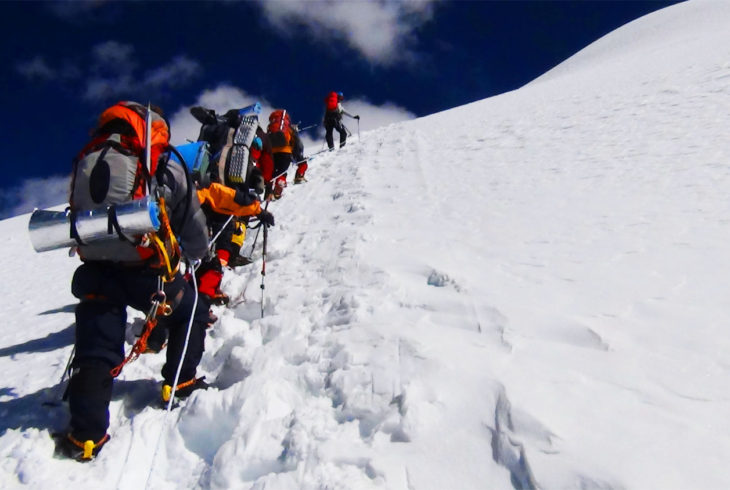
Podcast of EBC Trek
Latest features.
The latest articles, galleries, quizzes and videos.
Island Peak Climbing – A Complete Guide
Island Peak Climbing is an expedition of glacier travel, snow and ice climbing and trekking in the Khumbu region which goes through some tiny ethnic Sherpa villages with Sagarmatha National Park. Highlights of Island Peak Climbing Climbing Island Peak also known as Imja Tse offers a great opportunity to experience the worlds’ impressive mountain range…
Everest Base Camp Trek in April
In April, the Everest Base Camp Trek continues to offer a spectacular experience, building on the favorable conditions of March. Here’s what you can expect: Weather April falls within the Spring season in Nepal, offering pleasant and stable weather conditions. Temperatures are mild, ranging from around 9 to -4 degrees Celsius. While the lower altitudes…
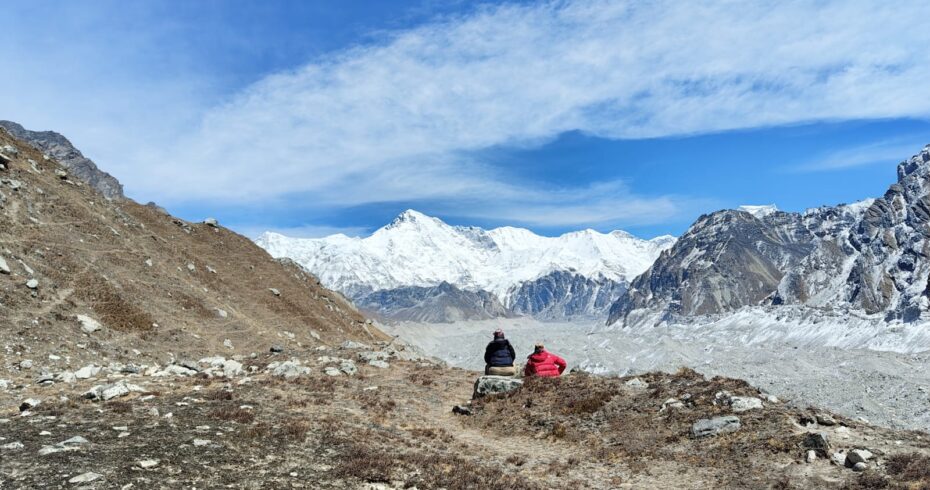
Everest Base Camp Trek in January
Everest Base Camp Trek in January can be a memorable trip for those who prepare better for winter and cold since it is a peaceful time, the trails get empty, and the sky looks clear. Everest Base Camp Weather in January Generally, the weather in Everest in January gets colder as the temperature can go…
Everest Base Camp Trek in February
February is considered to be Off-season for trekking in Nepal due to cold temperatures and foggy weather in the whole country. If you are thinking of Everest Base Camp Trek in February but have some dilemma on your mind, this is the right place where you will get all your answers. Why trek Everest Base…
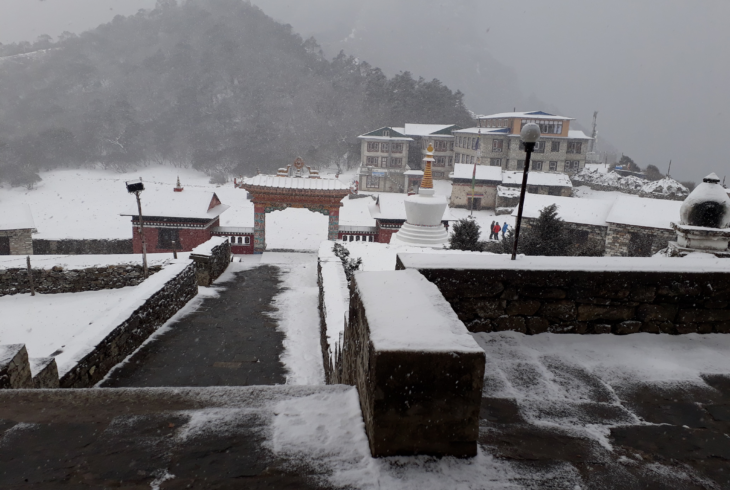
Sign up for trip deals, inspirations and competitions.

The Ultimate Everest Base Camp Trek Itinerary: How to Get from Lukla to Everest Base Camp
Are you planning a trip to Everest Base Camp? Sitting at 5 380 m, the EBC trek in Nepal is one of the most iconic hikes in the world and tops any adventurer’s bucket list!
But walking over 130 km from Lukla to Everest Base Camp is tough! Mentally, physically and emotionally. Every day of your expedition will push you to your limits.
The reality is that no matter how intense your preparation is, it’s not your fitness levels or even your age that will determine whether you reach Everest Base Camp. It’s about how your body adjusts to a higher altitude.
Some people struggle, others don’t. This is why the acclimatization schedule in your Everest Base Camp trek itinerary is so crucial.
After successfully reaching base camp, I put together this comprehensive guide which includes step-by-step details of the best Everest Base Camp route to take, including the trekking time, the highlights, the best tea houses, how to deal with altitude sickness and so much more!
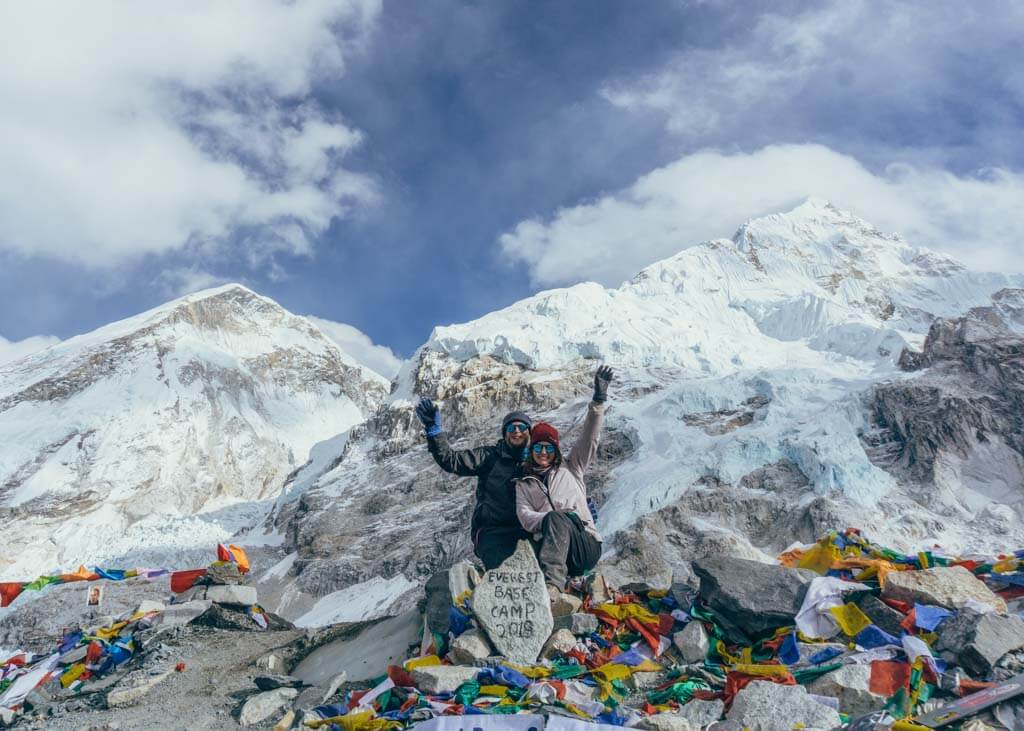
Quick Navigation
When to plan your Everest Base Camp Trek itinerary
April to May (Spring) and October to November (Autumn) are the most popular hiking months in Nepal offering perfect conditions for your Everest Base Camp trek.
But these months also attract scores of travelers looking to take on the Himalaya mountain ranges and so the trail does get busy.

Everest Base Camp Trek Route
If you follow my Everest Base Camp trek itinerary, you’ll need 12 days to start and return to Lukla. You will reach Everest Base Camp on day 9 which is enough time for your body to adjust to the higher altitude.
Day 1: Kathmandu to Lukla to Phakding
Day 2: phakding to namche bazaar, day 3: namche bazaar (acclimatization day), day 4: namche bazaar to khumjung, day 5: khumjung to phortse, day 6: phortse to dingboche, day 7: dingboche (acclimatization day), day 8: dingboche to lobuche, day 9: lobuche to gorak shep to everest base camp to gorak shep, day 10: gorak shep to kala patthar to pheriche, day 11: pheriche to namche bazaar, day 12: namche bazaar to lukla.
I did not take altitude sickness medication such as Diamox but I walked slowly, extremely slowly – probably the slowest anyone’s ever walked to EBC. This Everest Base Camp trek itinerary offers the best acclimatizing schedule to allow your body to naturally adjust to a higher altitude.
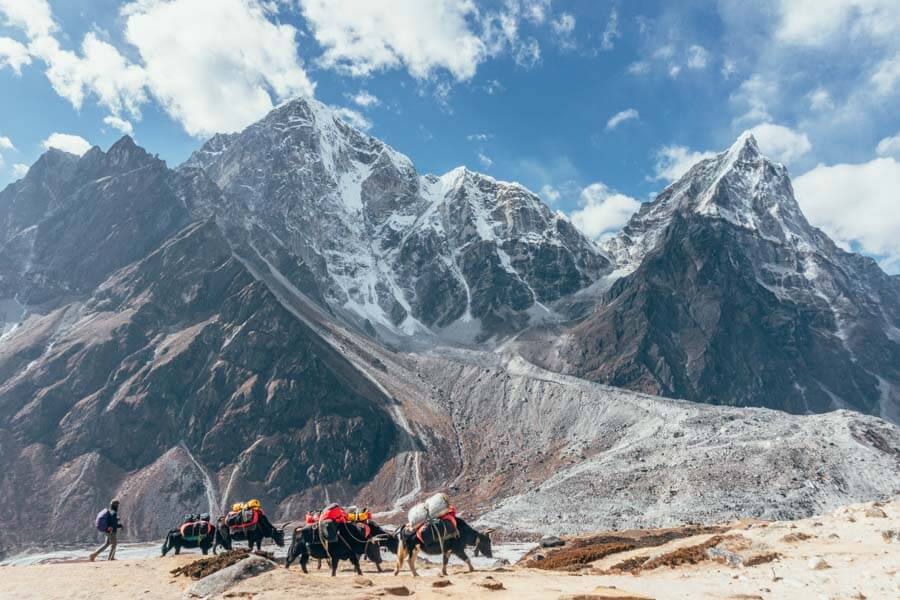
The start of your Everest Base Camp itinerary: Kathmandu
Your first few days in Nepal will be in the capital city, Kathmandu. Sitting at 1 400m above sea level, it’s recommended to spend at least 2 days here.
This allows your body to get used to the higher elevation, especially if you’re coming from sea level.
Kathmandu is a dynamic city with a rich culture and tradition, and you can easily spend a few extra days exploring if you have the time. Most tour operators include a day excursion to the nearby sights and temples within the city.
Make sure you stay in Thamel. It’s the hiking hub of Kathmandu with lots of eager trekkers choosing to base themselves here.
You can buy all your Everest Base Camp hiking gear in Thamel so don’t worry if you’ve forgotten something behind. Or if, like me , you arrived in Nepal with no hiking gear – only a pair of hiking boots! Thamel has got you covered.
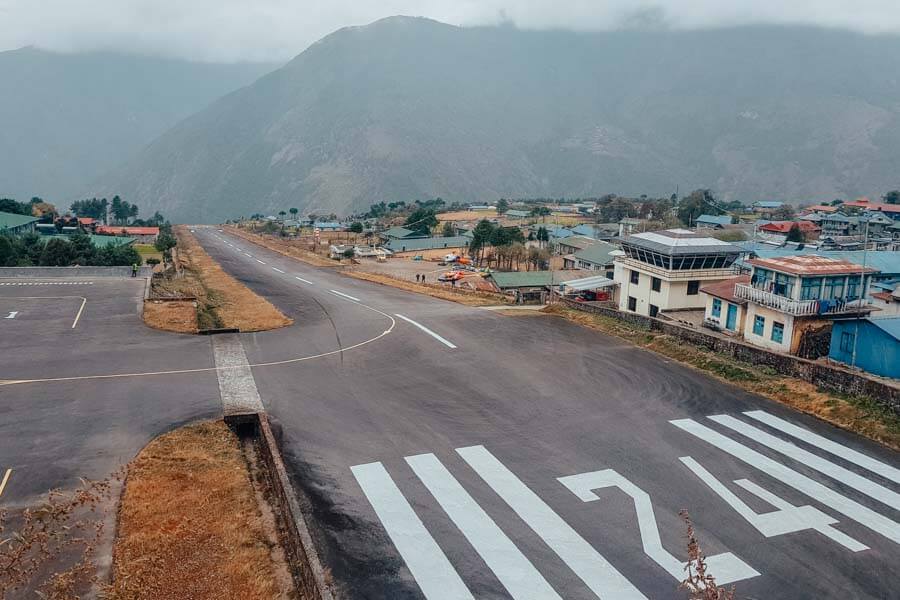
Altitude: Kathmandu (1 400m) – Lukla (2 860m) – Phakding (2 610m).
Trekking time: 3-4 hours | 7,4 km.
Difficulty: Easy with only a few uphill sections.
Highlight: Flight into Lukla.
Overview: The first day of your Everest Base Camp trek itinerary will start bright and early with a flight out of Kathmandu to the infamous Tenzing Hillary Airport in Lukla. From there, you’ll hit the ground running and hike just over 3 hours to Phakding, your stop for the night.
Tea house: Royal Sherpa Resort.
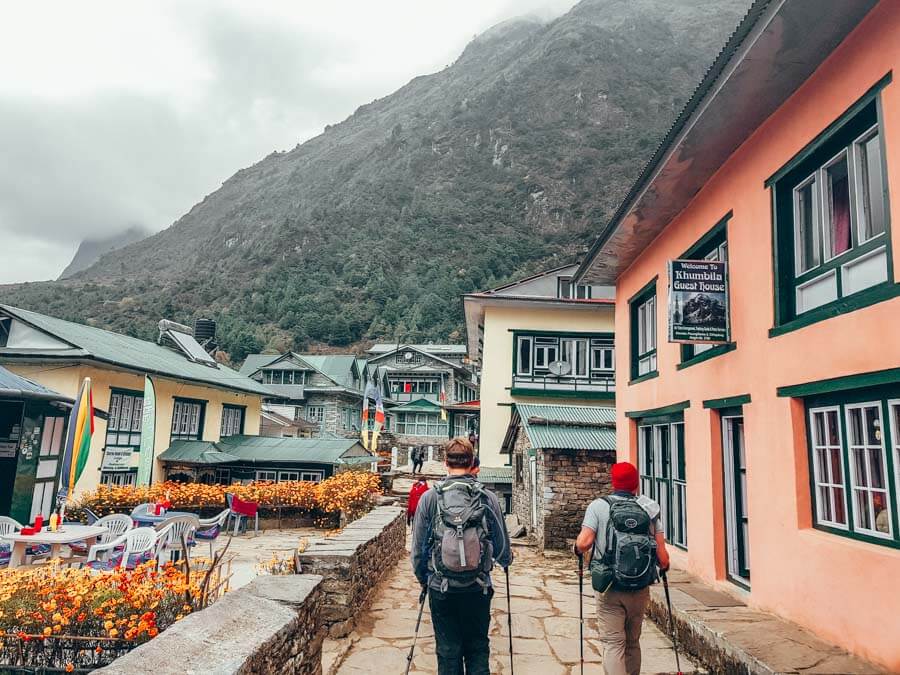
The day has finally arrived – The first day of your Everest Base Camp itinerary!
The flight from Kathmandu to Lukla is only 36 minutes but it relies heavily on the weather. Even if there’s slight cloud cover, the flights are delayed or worse, canceled. Lukla Airport is one of the most dangerous airports in the world after all.
My flight with Summit Air was due to leave at 9 am, but we only left after 3 pm due to the weather conditions. The planes are tiny, and you’re allowed no more than 15kg of luggage – in total!
The flight itself was thrilling but not as frightening as I anticipated. Although I did freak out every few minutes when there was a slight bump.
Lukla to Phakding
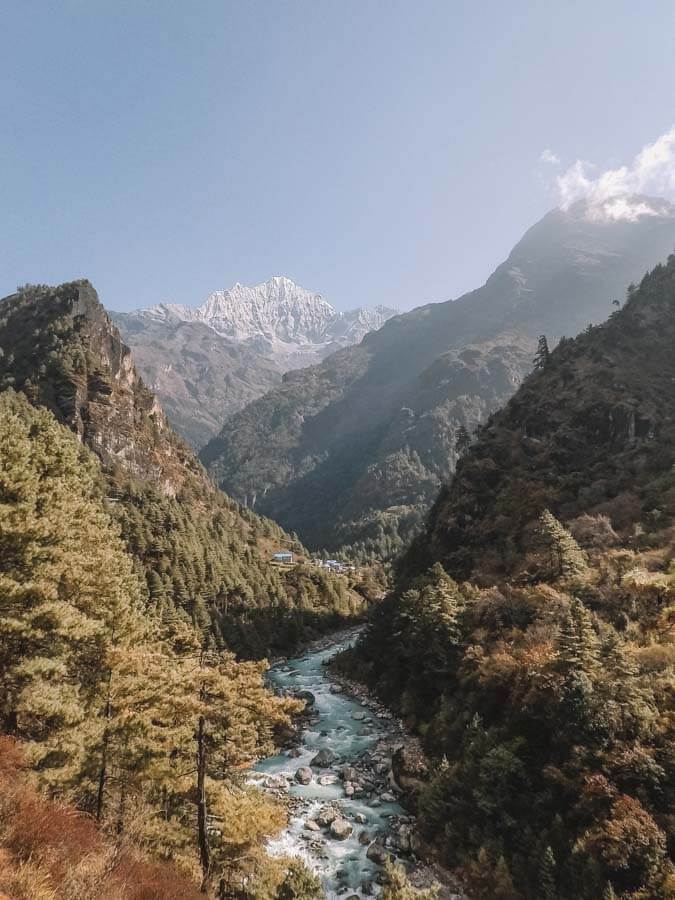
Once you’ve arrived in Lukla, grab a quick bite to eat before starting the afternoon trek to Phakding.
This section from Lukla to Phakding is an easy one and it’s the perfect introduction to the Himilaya mountain range. It’s an incredibly scenic trail that hugs the mountain and runs alongside a stream.
You’ll pass through several villages and will set your sights on the first yaks and mules of your Everest Base Camp trek.
Before you know it, you’ll have reached Phakding where you’ll spend the night in your first tea house. Don’t get too used to these comfortable conditions though. The further up you go from Lukla to Everest Base Camp, the more basic the amenities become!
Tip: There are ATM’s in Lukla (and Namche) but draw cash in Kathmandu as a back-up.
Tip: There’s cell reception (NCell) in Phakding and most tea houses offer free power to charge up your phone or camera here.
Tip: Try to eat well during the first few days as you’ll start losing your appetite from day 3 of your Everest Base Camp itinerary. Remember: “Dal Bhat Power – 24 Hour”

Altitude: Phakding (2 610m) – Namche Bazaar (3 440m).
Trekking time: 7-9 hours | 10,4 km.
Difficulty: Easy for the first section, steep and difficult for the second half.
Highlight: The views from the suspension bridges.
Overview: Day 2 is when the real hiking starts! You’ll begin with a slow hike before climbing a steep section leading to Namche Bazaar, one of the most iconic stops on your Everest Base Camp trek itinerary.
Tea house: AD Friendship Lodge.
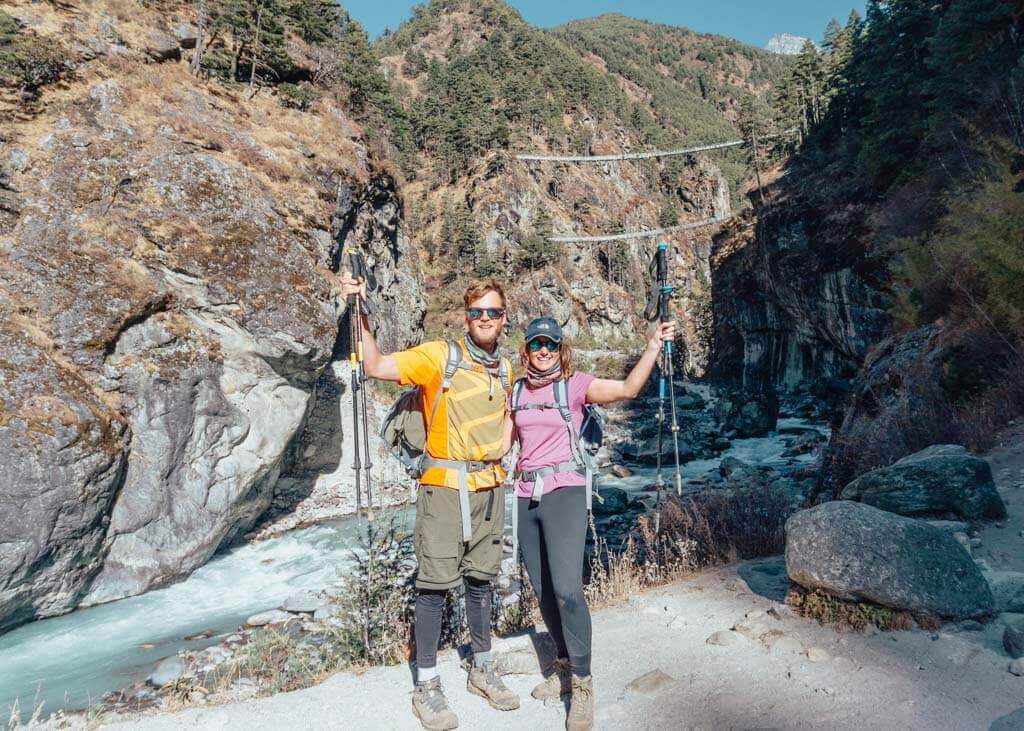
Day 2 is one of the most picturesque days of your Everest Base Camp trek itinerary. But you have a long day of hiking ahead of you so try to leave Phakding by 08:00 am.
The first part is an easy trek alongside pine forests and the excitement will begin to set in as you pass fellow trekkers making their way back down from Everest Base Camp to Lukla.
The glacial rivers are an impressive sight and you’ll cross several suspension bridges throughout the course of the day. These offer gorgeous views but they’re also terrifyingly high! Take in these beautiful surroundings as the landscape changes dramatically over the week.
After lunch, there is a sharp gain in elevation and the easy path suddenly becomes steeper. Take it slow to allow your body to adjust to this higher altitude.
En route to Namche Bazaar, you’ll also get your first glimpse of Mount Everest (If the weather conditions are on your side). You’ll also need to sign in at a checkpoint.
Namche Bazaar
Namche Bazaar is a picturesque village with a lively atmosphere. It’s the main trading center of the Khumbu region and a sherpa village. From Namche Bazaar it starts to get chilly but luckily there are plenty of tea houses with fireplaces to warm you up.
Tip: After you’ve arrived in Namche, pop into Hermann Helmers for their chocolate carrot cake. It’s life-changing!
Tip: Take a warm shower in Namche ($5) as it’s the cheapest you’ll find for the next 10 days!
Tip: Avoid eating meat after Namche Bazaar. Just think of it being carried up the mountain, during the heat of the day with no refrigeration. Don’t do it!
Day 3 of your EBC trek itinerary is your acclimatization day, a supposedly “rest day” to allow your body to slowly adjust to the high altitude. But that doesn’t mean you’ll get to sit inside and relax all day. Today, you’ll do an acclimatization hike to Everest View Hotel.
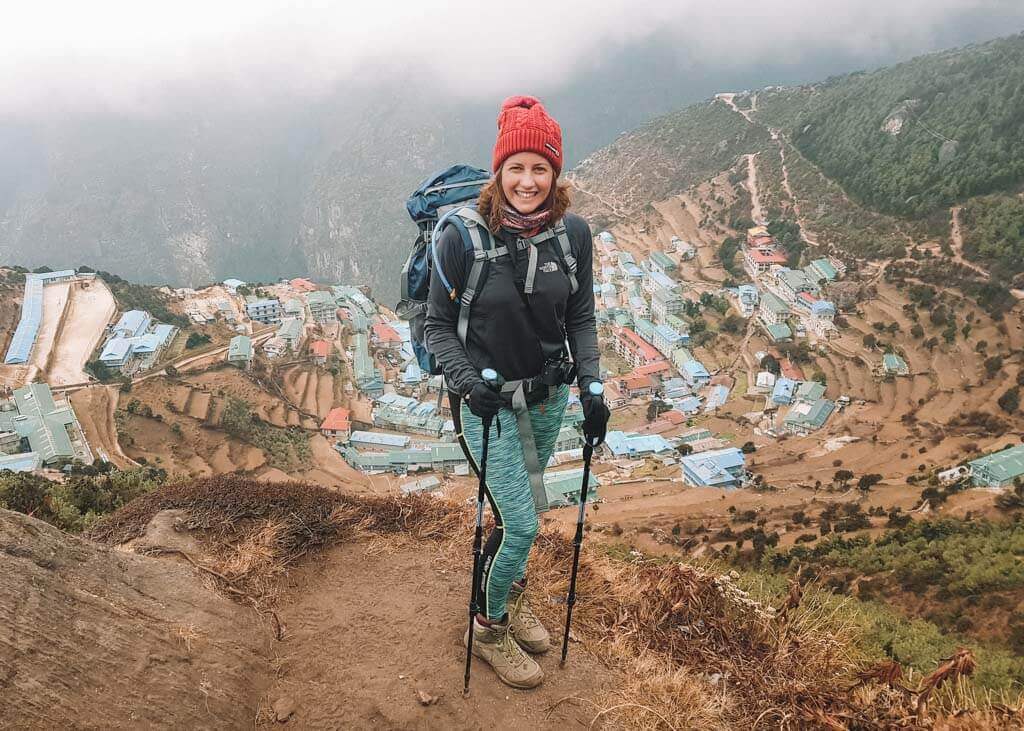
Altitude: Namche Bazaar (3 440m) – Everest View Hotel (3 880m) – Namche Bazaar (3 440m).
Trekking Time: 3 hours | 2.5 km.
Difficulty: The path itself isn’t too difficult, but with the elevation gain, you’ll begin losing your breath quickly.
Highlight: Watching Everest documentaries at Liquid Bar in Namche Bazaar (3 pm or 7:30 pm).
Overview: A short hiking day to Everest View Hotel and back, followed by free time to explore Namche Bazaar.
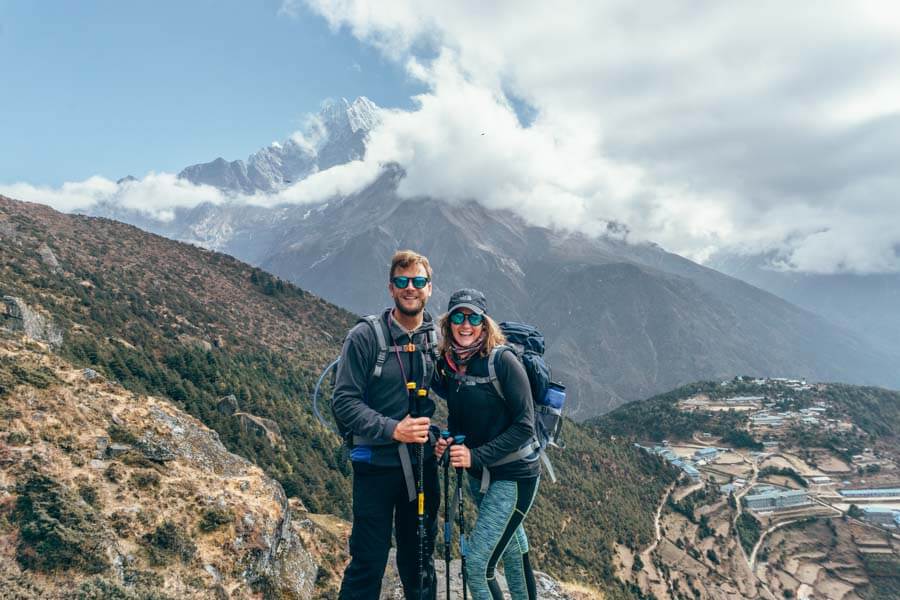
Even if you’re not feeling up to it, it’s important to get out and hike to a higher point, before coming back down to sleep at a lower altitude.
Today is also your second chance to get a glimpse of Mount Everest if you didn’t the day before. The trek is a tough one, and if you have not yet felt any symptoms of the higher altitude, you’ll soon begin to experience them.
Tip: There are many pubs and bars which show Everest documentaries. Make sure you watch one during your time in Namche Bazaar (But don’t drink alcohol on your way up – save that for when you return).
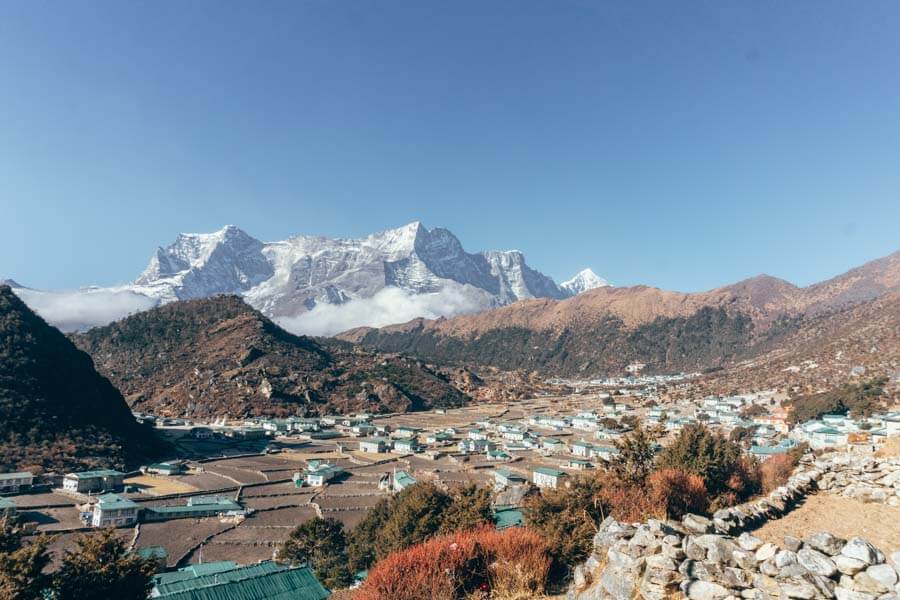
Route: Namche Bazaar (3 440m) – Khumjung (3 780m).
Trekking time: 4 hours | 4 km.
Difficulty: Moderately easy as it’s a short trekking day but from today the cold sets in.
Highlights: Playing card games in front of the fire, wrapped up in my sleeping bag because it was so cold.
Overview: You’ll go off the standard trekking route from Namche to Khumjung.
Tea House: Hill Top Lodge.
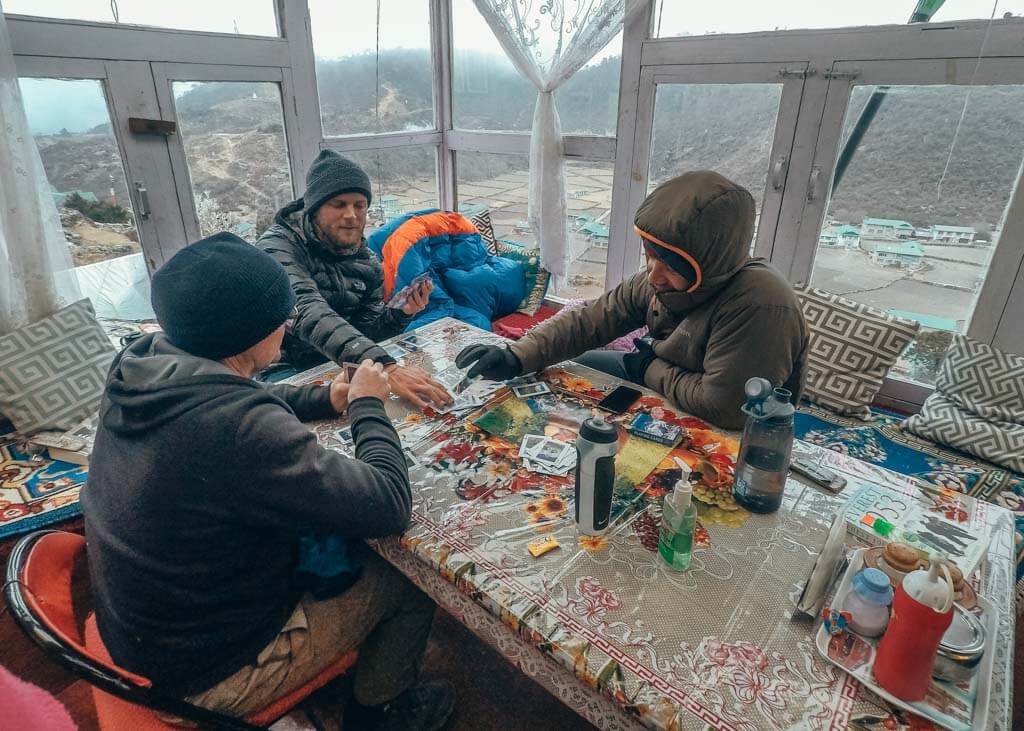
This is where most Everest Base Camp trek itineraries differ. From Namche Bazaar, there are two routes you can take both of which link up again in Dingboche on day 6 of your trek.
The first option (and most popular) is from Namche to Tengboche, before reaching Dingboche .
The second option (and my chosen route) is from Namche to Khumjung and Phortse which are on the other side of the river.
I chose the Khumjung route as it’s the less popular option. As a result, the hike isn’t as crowded, yet it offers the same sweeping views of the valleys below. But don’t worry, you’ll still get to experience the Tengboche route on your way back down from Everest Base Camp to Lukla.
Today was the first day that I layered up as it did get quite cold. You’ll pass a small local hospital as well as the famous Sir Edmund Hilary School before arriving in the small village of Khumjung.
When you get to Khumjung you’ll notice the change in the landscape. It’s far more arid and drier, with very few green luscious trees.
Tip: Ensure you have a pack of playing cards and a book with you. They’ll come in handy on short trekking days like today.
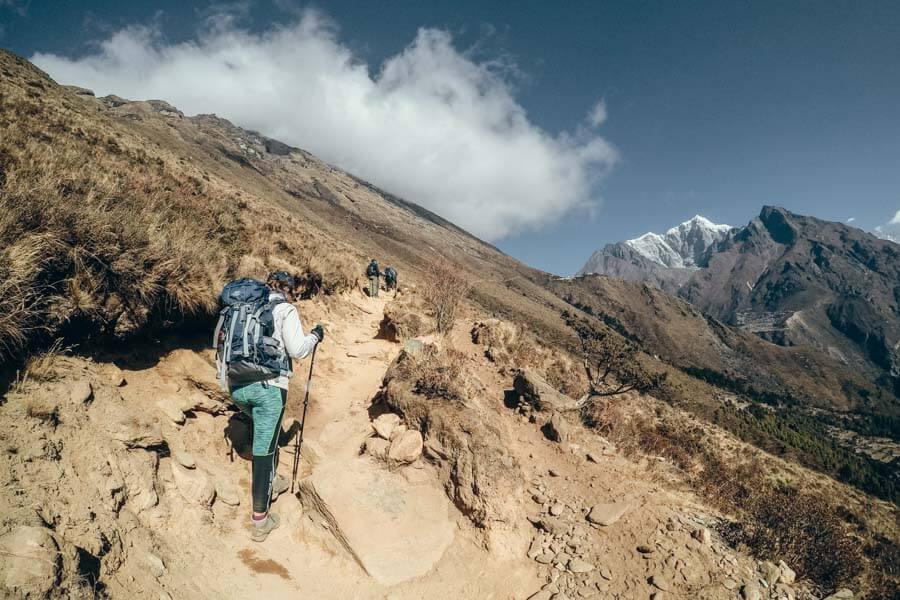
Route: Khumjung (3 780m) – Phortse (3 900m).
Trekking time: 6 hours | 7 km.
Difficulty: Although there isn’t much altitude gain today, there are still many sections where you walk downhill, before climbing back uphill so this constant up/down is strenuous.
Highlights: Today was the first day I began to feel the effects of the high altitude and I lost my appetite.
Overview: The trail from Khumjung to Phortse is incredibly scenic and you’ll walk alongside all the Himalaya giants.
Tea house: Phortse Resort.
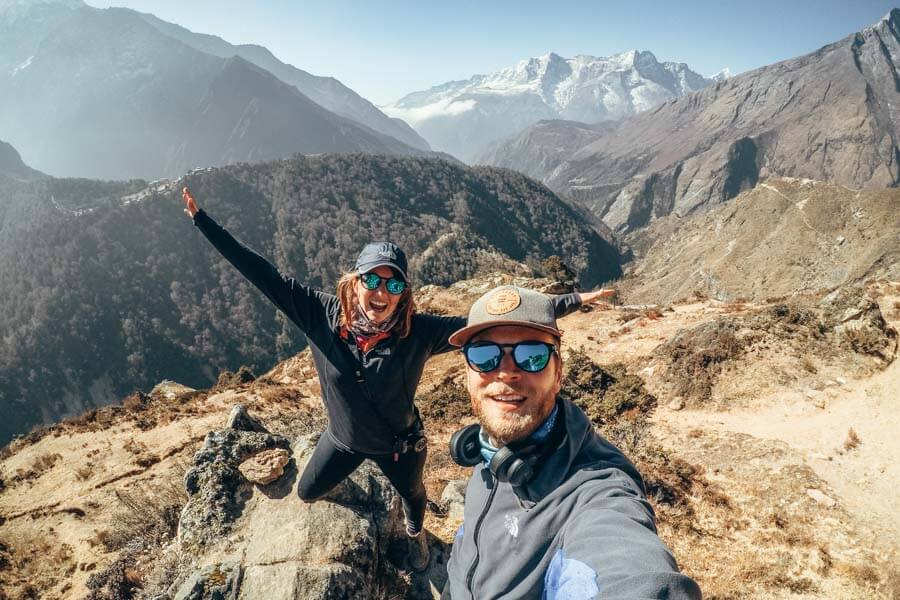
Day 5 of your Everest Base Camp trek itinerary will start with a 2-hour climb to Mongla (3 975m). You’ll then go back down to 3 800m which is the elevation of your next stop, Phortse.
You’re still on the “quieter” route so enjoy this path as it gets busier from tomorrow when you head to Dingboche.
Today is the day I started to feel the effects of altitude sickness and by the time I reached our lunch stop, I had lost my appetite and a terrible headache was setting in. I wrote this detailed guide to how hard Everest Base Camp is and it includes these moments where i felt horrible!
There is also a considerable drop in temperature – It was 4 degrees celsius when we started walking today. The pipes in Phortse were frozen and the guides start to give you hot water in the evening which will be your drinking water from here on out.
Tip: When you’re given hot water in your drinking bottles, put one inside your sleeping bag to act as a hot water bottle.
Tip: I took a headache tablet at lunchtime and after a good night’s rest, I was feeling much better. If you’re not feeling well, don’t be afraid to take a pain killer but make sure you communicate with your guide so that he knows to keep an eye on you.
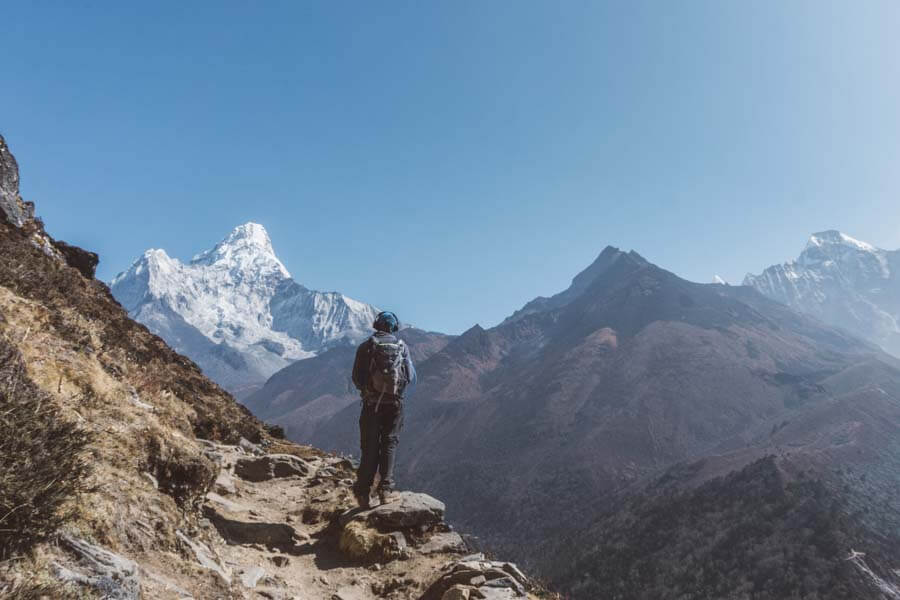
Altitude: Phortse (3 800m) – Dingboche (4 360m).
Trekking time: 8 hours | 9 km.
Difficulty: Today is a long, tiring day and breathing is difficult. The first few hours are tough, followed by an easier trek as you get closer to Dingboche.
Highlights: Arriving in Dingboche – today was a hectic day and I was so happy when it was over!
Overview: You’ll trek the entire day with a constant gradual incline until you arrive in Dingboche, where our EBC itinerary will meet up with the others who are coming from Tengboche.
Tea house: Sonam Friendship Lodge.
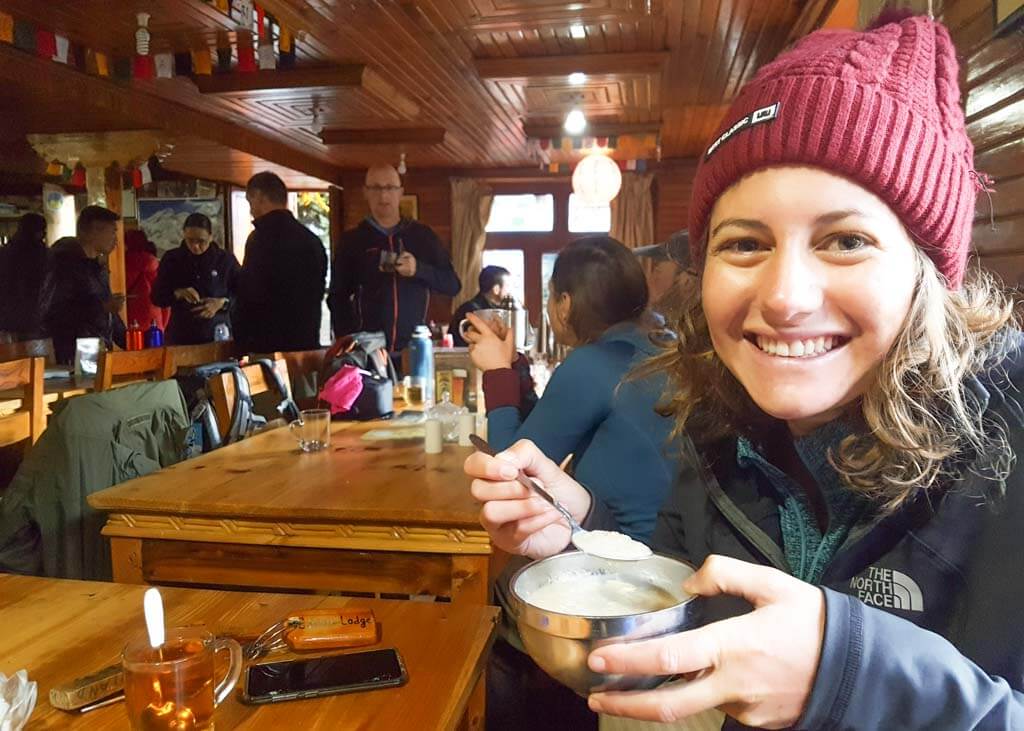
Today is a long trekking day!
When I woke up on day 6, I was feeling fit and strong (unlike the afternoon before) . I was extremely aware of how sick I had felt yesterday and despite feeling better, I took precautionary measures and walked extra slow with many breaks.
The first 5 hours involve constant uphill climbs, followed by downhill treks, before going uphill again! You’ll eventually pass the tree line, and the entire landscape becomes bare and rocky and resembles a desert.
Today you’ll be surrounded by all the Himilayan giants: Ama Dablam, Nuptse, and Cholatse, with unspoiled views of Mount Everest.
Throughout the day you’ll hear the sounds of helicopters making emergency rescues as trekkers begin struggling with the higher altitude and need to be taken back down to Namche Bazaar from Everest Base Camp. It’s quite scary to see how frequently people require this emergency assistance!
Luckily, the final stretch to Dingboche after lunch isn’t as tough as the section before.
Tip: There’s no cell reception as you get closer to Dingboche so enjoy the next few days going off the grid.
Tip: On day 6 of our Everest Base Camp itinerary, a few trekkers started taking altitude sickness medication as a precautionary measure. I didn’t take Diamox but my guide had in case I needed it. As always, be cautious of the altitude.
Tip: You’ll lose your appetite, but order boiled potatoes to get some food into your stomach.
Today is the last of your acclimatization days so you’ll spend a second night in Dingboche. Again, it’s important to do an acclimatization hike from Dingboche .
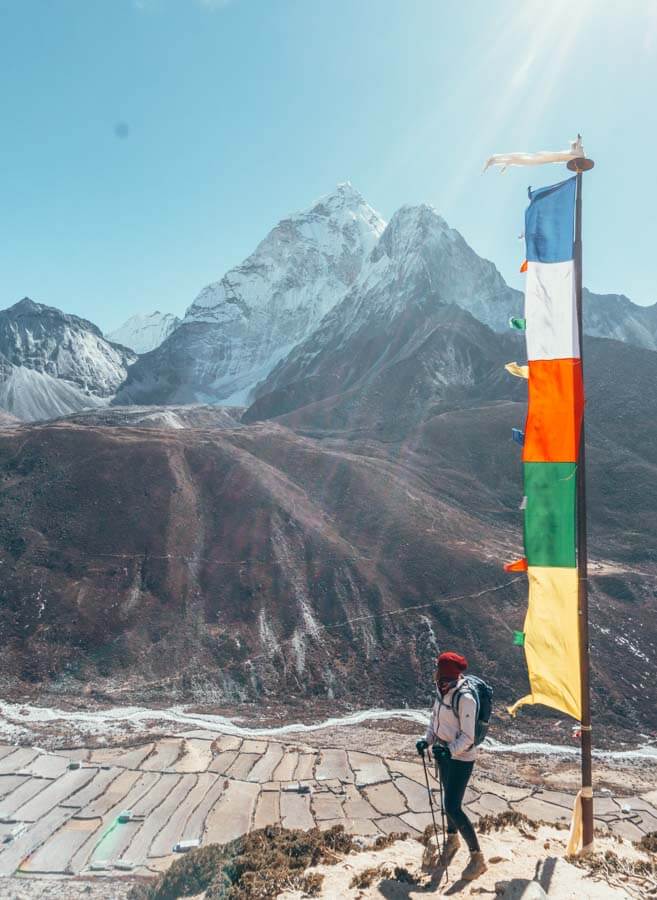
Altitude: Dingboche (4 360m) – viewpoint (4 900m) – Dingboche (4 360m).
Hike time: 3 – 5 hours | 3 km.
Difficulty: Short, but steep climb so take it slow and steady.
Overview: Today is a short acclimatization hike to a viewpoint and back.
Highlight: Views of the Chukhung Valley and Island Peak.
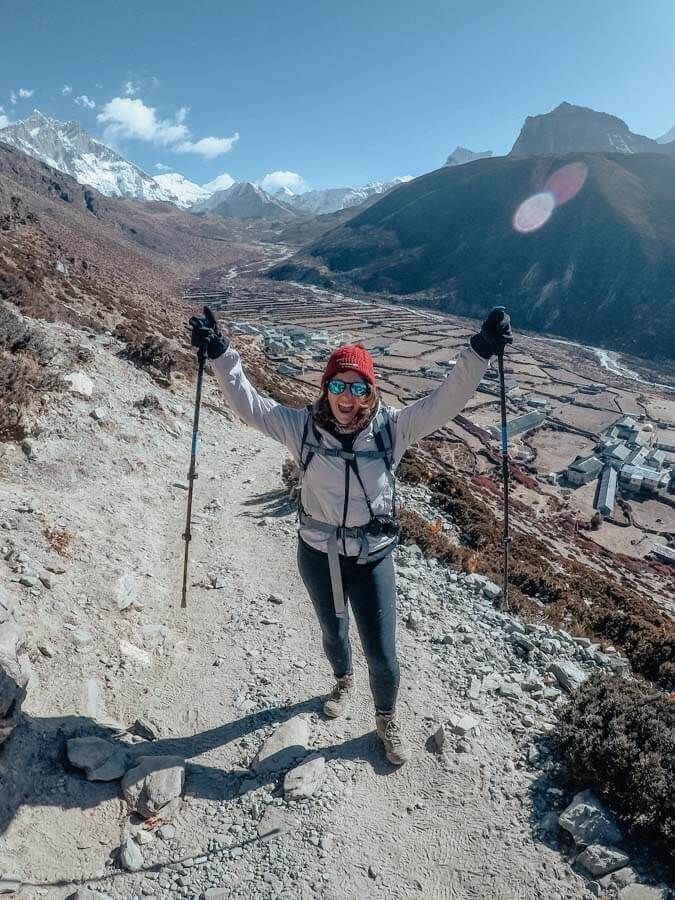
I woke up on day 7 of my EBC trek and I was feeling terrible. The Khumbu cough had really set in, I was freezing cold, my nose was constantly running and I was beginning to lose my voice.
When you reach Dingboche, the luxuries of warm water, comfortable beds, and flushing toilets are long gone, and this is when the mental challenge begins. But listen to your body and be honest with your guides about how you’re feeling.
During my time in Dingboche, a porter from a different tour group (who had hiked to EBC many times before) had gotten sick and had to be airlifted back to Lukla. This was a harsh reality of the effects of high altitude climbing and how it can happen to anyone, no matter your experience, fitness level, or age.
Dingboche Acclimatization Hike
Today you’ll go on an acclimatization hike to a viewpoint overlooking the Chukhung Valley. Going to this higher altitude, and then returning to Dingboche will make you feel so much better (as it did for me). So, gear up, pack your day bag, and head outside for a few hours.
The acclimatization hike from Dingboche to the viewpoint is pretty steep and rocky, but you’ll be hiking at a much slower pace than the previous days. All around you, you’re surrounded by towering mountains and peaks, and it’s a sight you won’t easily forget!
Once at the viewpoint, you’ll have the best views of Ama Dablam and Island Peak, as well as the symbolic prayer flags.
I added Island Peak to my Everest Base Camp itinerary (and I HIGHLY recommend you do the same). It’s 4 extra days of trekking after you’ve reached Everest Base Camp, and it was one of the best and most thrilling experiences of my life!
Tip: After returning from your acclimatization hike pop into Cafe Himalaya Bakery to watch their daily Everest movie.
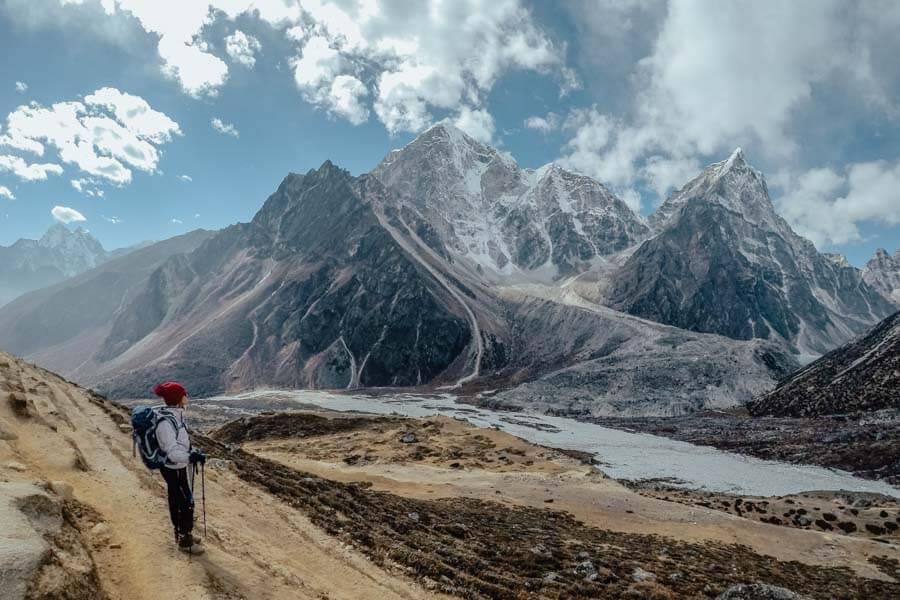
Altitude: Dingboche (4 360m) – Lobuche (4 930m).
Trekking time: 7 hours | 10.7km.
Difficulty: Hard! The section from the bottom of the icefall to the Everest memorial is brutal. It’s steep, and it’s far.
Highlight: The climb to the Everest memorial. It’s painfully steep and I struggled!
Overview: As you leave Dingboche, the first part of your trek is relatively easy. Until you reach Dukla! This is where the trail becomes steep. From there it’s an excruciating 2-hour climb before the path becomes flat again. You’ll walk alongside the Khumbu Glacier, the longest glacier in Nepal.
Tea house: Sherpa Lodge.
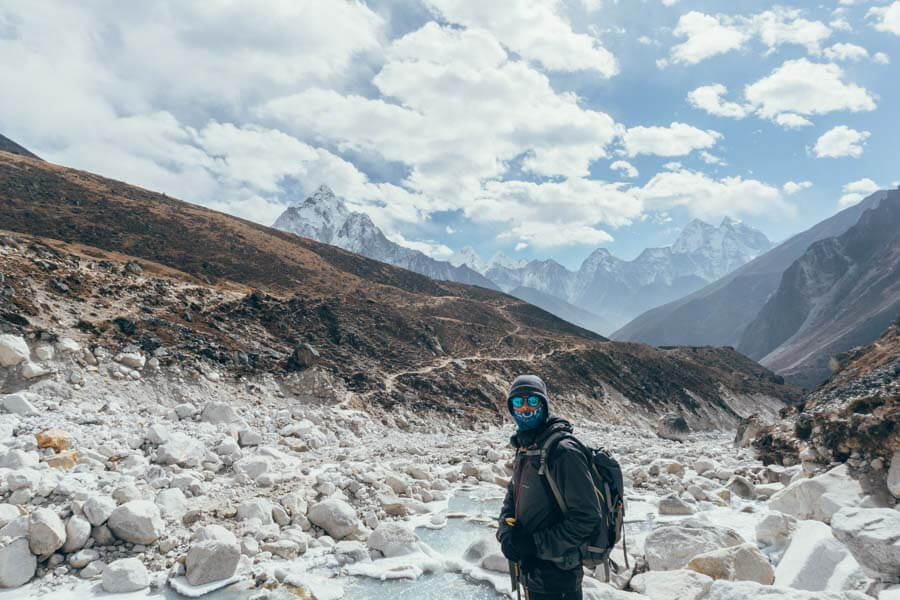
I kept a day-to-day journal of my Everest Base Camp trek itinerary, and in it, day 8 is highlighted (in capital letters with several exclamation marks) “ The hardest day EVER! ”
And thinking back to this day, it really was!
The first 3 hours include a gradual incline before crossing to Dukla which will be your lunch stop for the day. Enjoy the break, because you are going to be hating life for the next 2 hours – it’s a killer of a climb. Breathing at an altitude of over 4 500m doesn’t make it any easier!
You’ll pass many trekkers who are making their way back from Everest Base Camp. I was shocked to see the condition most of them were in. Many people were even getting carried down by mules! They looked like they had really taken strain – coughing, no voice, chapped lips, and no energy.
I was hoping and praying that wouldn’t be me in a few days (but unfortunately, it was – except I didn’t need to be carried down!)
Everest Memorial
At the top, you’ll reach the Everest Memorial for climbers who’ve lost their lives in their attempt to reach the summit of Mount Everest. There is a somber mood, and I get goosebumps thinking about all those climbers and their families.
From the memorial, it’s about a 1-hour trek alongside the Khumbu Glacier to Lobuche. This last section is far easier than the previous one. Again, take it slowly!
Tip: At this stage, everyone is feeling the effects of the altitude and the cold. You’re not alone! Just keep pushing through, it’s nearly over! (says me who wanted to turn back countless times) .
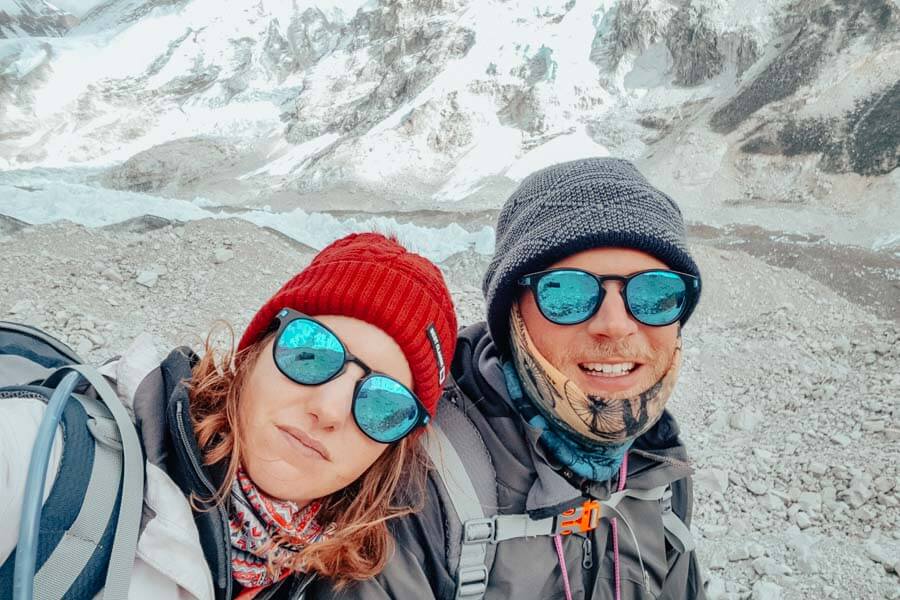
Altitude: Lobuche (4 930m) – Gorak Shep (5 160m) – Everest Base Camp (5 360m) – Gorak Shep (5 160m)
Time: 10 hours | 12 km.
Difficulty: Moderate with a steep climb towards Gorak Shep and an easy trail to Everest Base Camp. The difficulty lies in hiking time and the high altitude.
Overview: Today is the day you reach Everest Base Camp! You’ll arrive in Gorak Shep, drop off your bags and have lunch before departing north along the Khumbu Glacier to Everest Base Camp.
Highlight: It should be reaching Everest Base Camp, right?
Tea house: Buddha Lodge
Whilst the previous day’s hike from Dingboche to Lobuche was certainly the toughest and most physical section, getting to Gorak Shep, and then on to EBC and Kala Pattar were the most emotionally and mentally challenging sections of my entire Everest Base Camp trek itinerary.
Your day will start with a moderate hike leading to Gorak Shep from Lobuche. After about an hour into your hike, the path becomes steep with numerous boulders to pass. Whilst it isn’t a strenuous climb, the altitude will affect you and you’ll be walking very slowly.
Gorak Shep and Everest Base Camp
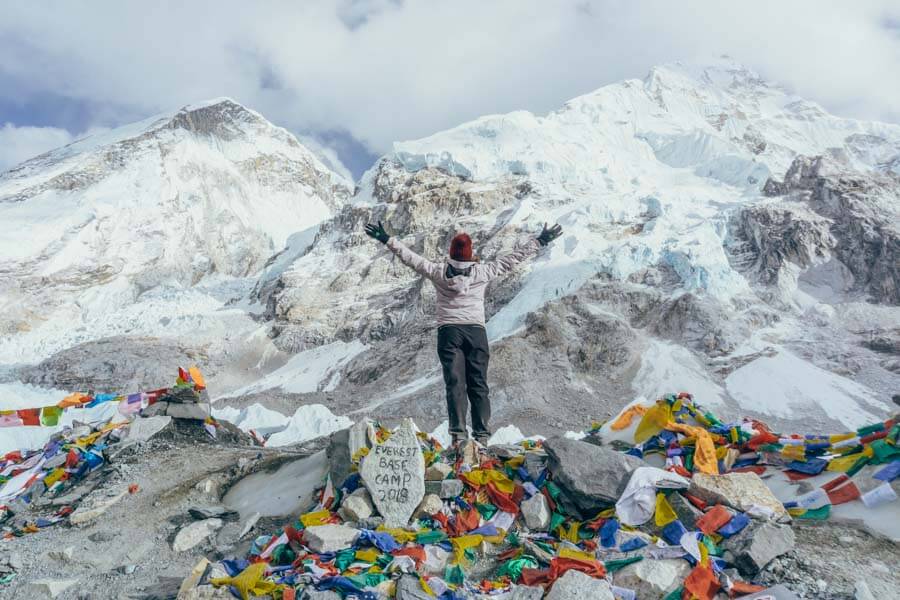
You’ll reach Gorak Shep at lunchtime where you’ll drop off your bags and prepare for the afternoon hike to EBC.
You don’t actually stay at Everest Base Camp. Gorak Shep is your base with the closest tea house to EBC.
After lunch, you’ll trek to Everest Base Camp. The path is made of rocky sections and loose stones. You’ll be exhausted at this point. But the adrenalin rush will keep you going. The excitement to finally reach Everest Base Camp will get you to the end.
Arriving at base camp is surreal. You can see the Khumbu Icefall in the distance, one of the most notorious sections leading up to the Everest summit.
It’s an eerie feeling reaching Everest Base Camp but absolutely gorgeous standing at the foot of the highest mountain in the world.
You’ll then make your way back to Gorak Shep which is where you’ll spend the night.
The reality
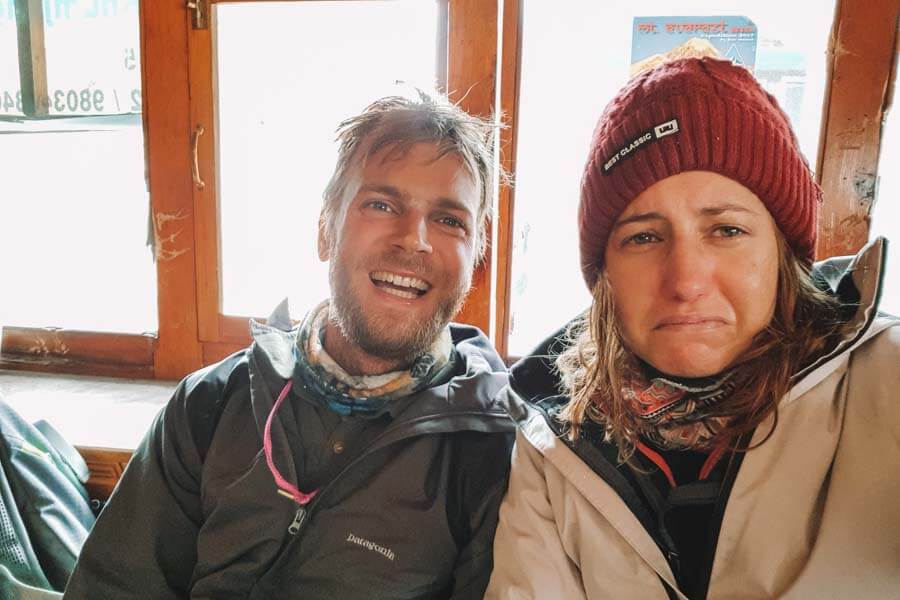
The most vivid memory I have of my entire Everest Base Camp trek is sitting in the tea house in Gorak Shep after returning from Base Camp.
The communal area of more than 60 people was quiet. You could only hear the sounds of loud coughing. There were no celebrations by those who had made it to Everest Base Camp and the atmosphere was not jovial.
Everyone was feeling sick and looking worse for wear. People were being helivaced from Gorak Shep to Lukla, others were on oxygen. You could see trekkers struggling to take a bite of their food.
I was so emotional because I was just so incredibly exhausted. You could sense that everyone was at their breaking point and had been pushed to their limits. Including me.
Tip: Don’t rush! Remember that you’re breathing in air with 50% oxygen. Many trekkers get excited as they’re so close to Everest Base Camp, but you still need to be careful. From what I saw, several people got sick and had to be put on oxygen AFTER they’d successfully reached EBC, perhaps this is because they’d taken it too fast.
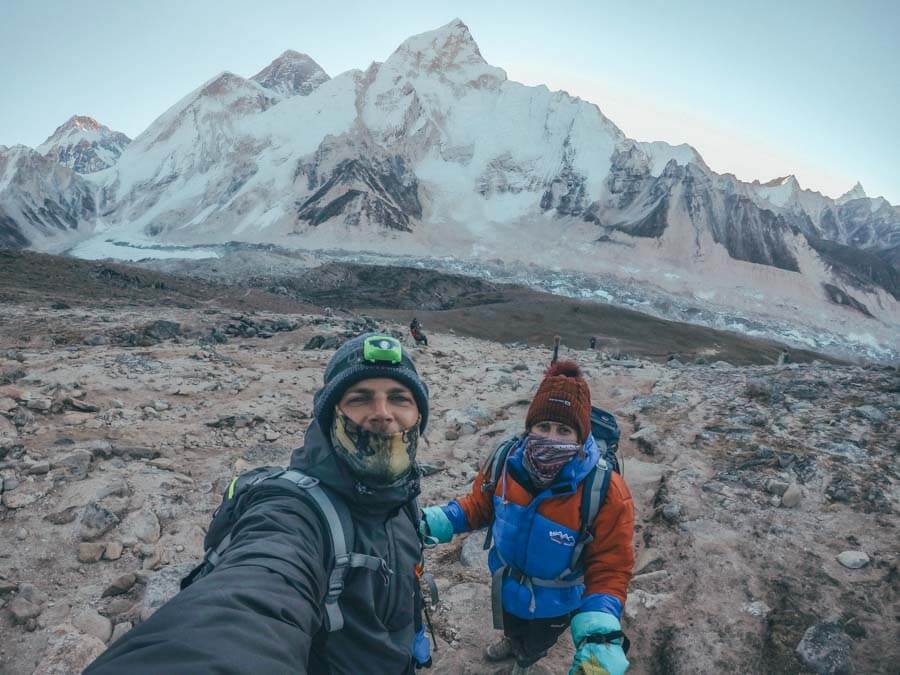
Altitude: Gorak Shep (5 160m) – Kala Patar (5 643m) – Pheriche (4 370m).
Trekking time: 7 hours | 13 km.
Difficulty: This day is difficult, only because of Kala Patthar! The rest is easy as you’ll be going down the mountain to a lower altitude.
Highlight: Everything about the trek up to Kala Patthar. The 5 am wake-up call, the ice-cold temperatures, the steep trail, the incredible view!
Overview: The day starts with an early morning trek to Kala Patthar for the best views of Mount Everest. After returning to Gorak Shep, you’ll head back down to Pheriche.
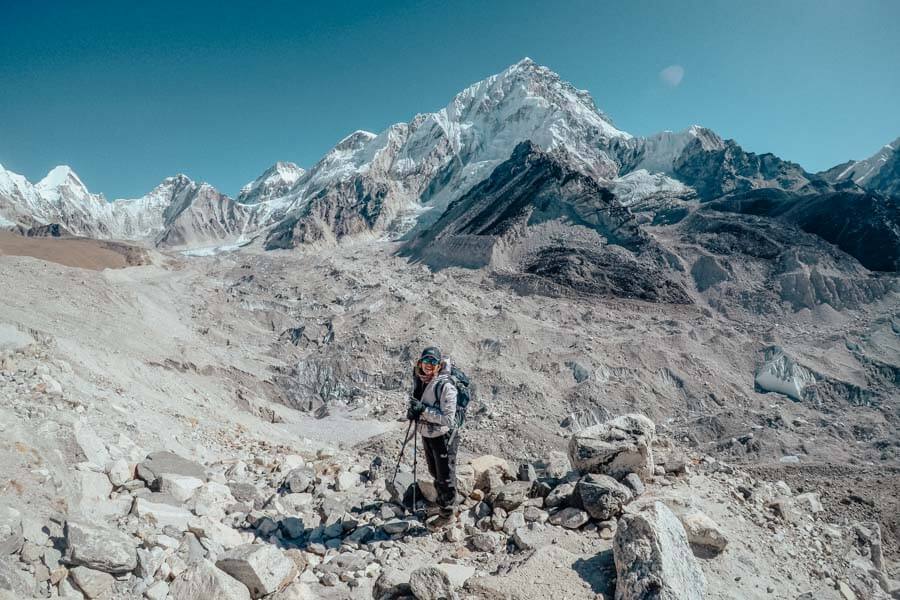
You can’t actually see Mount Everest from Everest Base Camp or Gorak Shep as Lhotse sits in front of it and blocks the view.
This is why people trek to Kala Patthar, which is a nearby viewpoint next to Gorak Shep.
Be prepared for a long and tiring day! Just when you thought it couldn’t get any tougher, day 10 of your Everest Base Camp trek will really push you to your limits.
Sitting at 5 643m, Kala Patthar is a small, rocky peak with a rewarding view of Mount Everest, Changtse, Lhotse, and Nuptse.
Your morning starts with a 5 am wake-up call as you prepare to hike to Kala Patthar. Some trekkers choose to skip this part of the itinerary because they’re too sick and just do not have the energy to make it to the top.
The main goal is Everest Base Camp, right? You’ve made it!
You don’t have to climb Kala Patthar. Listen to your body and if you’re not feeling well, don’t do it! I was incredibly slow, fatigued, and sluggish and only got about ¾ of the way to the top before our guide advised that we turn back.
If we didn’t, we’d fall behind on the day’s schedule.
After climbing Kalla Patthar, we arrived back at our tea house at Gorak Shep at about 9 am, had a quick breakfast then began our long trek past Lobuche and on to Pheriche.
My day hadn’t got off to a good start and I was feeling very weak hiking Kala Patthar, but as soon as we began our downhill climb, I regained my strength and felt like a different person!
Tip: If you’re feeling sick at Gorak Shep, make sure you monitor this but the moment you go to a lower altitude, you will feel stronger.
Tip: If you’re continuing to Island Peak, you can check out my Island Peak guide. To sum it up, from Gorak Shep, you’ll go to Dingboche ( and not Pheriche as this route goes) . After spending the night in Dingboche, you’ll go in a different direction to Chukhung and Island Peak Base Camp.
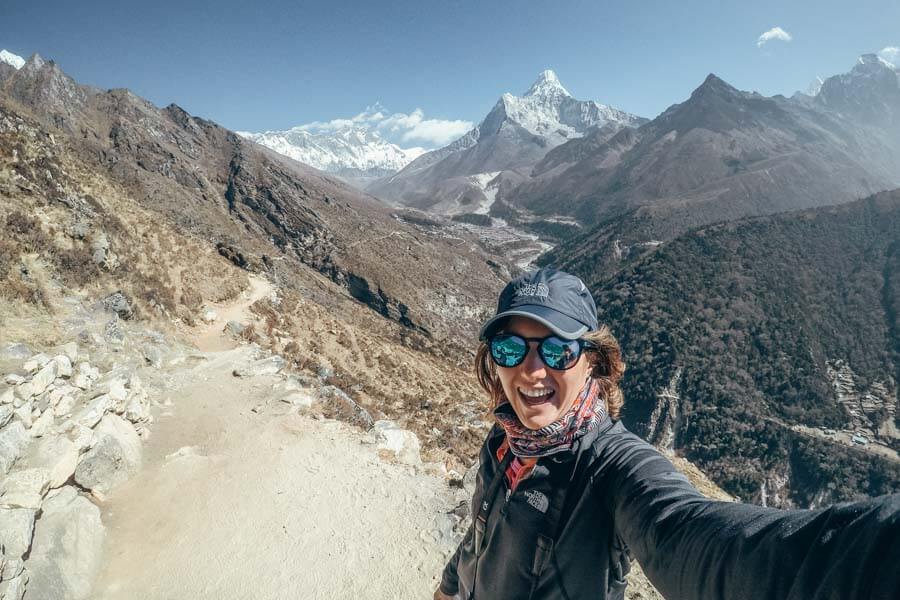
Altitude: Pheriche (4 280m) to Namche Bazaar (3 440m).
Trekking time: 14km | 8 hours.
Difficulty: Easy but a long day of hiking.
This day (and the next) are particularly long and you’ll want to get off the mountain ASAP!
You’ll be running down from Pheriche to Namche Bazaar as it’s so much easier to breathe as the elevation decreases. You’ll also be craving a hot shower, clean clothes, a proper meal, and a warm bed.
Soon, you’ll hit the tree line once again, cross over suspension bridges, and pass scores of mules.
After every corner, you’ll think you’ve reached Namche Bazaar, but it’s further than you expect, and the trail seems to go on forever. On your way down you still have sections where you climb up and down (yes, more climbing), but there’s no altitude gain so who’s complaining!
You’ll pass Tengboche, which is home to the largest monastery in the Khumbu region and the village where most trekkers stop on their way up the mountain (But we chose a different route on this Everest Base Camp trek itinerary).
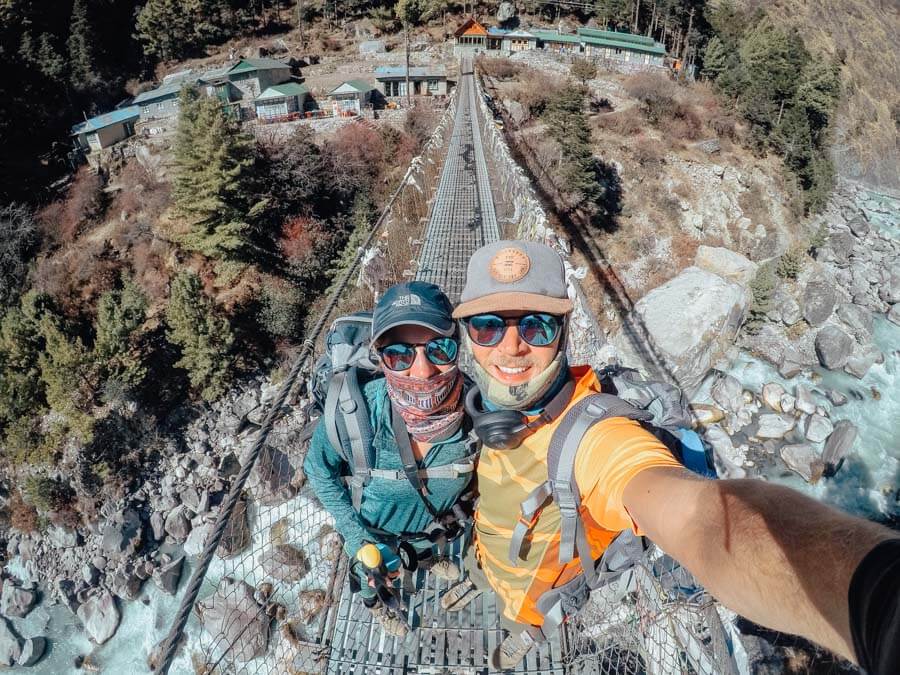
Altitude: Namche Bazaar (3 440m) – Lukla (2 860m).
Trekking time: 18 km | 8 hours.
Difficulty: Same as yesterday! A long day of hiking.
You’ve made it to the last day of your Everest Base Camp trek itinerary! Today you’ll retrace your steps from Day 1 and 2 (except this time you’ll cover the same distance in 1 day, and not 2!)
You’ll also see other trekkers ascending to EBC looking bright-eyed and bushy-tailed. If only they knew what was in store for them over the next few days! You’ll smile at them, and offer words of encouragement, but deep inside, you’ll just thanking your lucky stars that it’s them going up, and not you!
Enjoy your last lunch on the mountains in the village of Phakding before taking on the last section to Lukla. Spend the night in Lukla where you’ll celebrate with a delicious meal and a few cold beers!
Last day of your Everest Base Camp itinerary: Lukla to Kathmandu
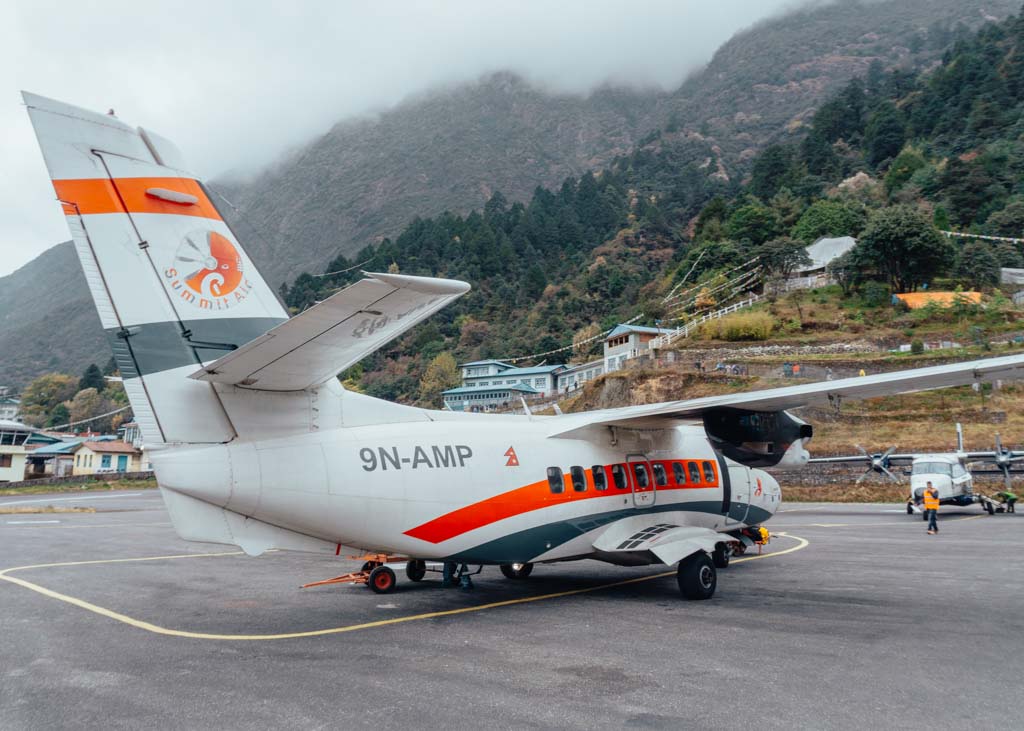
On the last day, you’ll be ready to say goodbye to the mountains! Once again your flight isn’t guaranteed to leave on schedule so one last bit of patience is required.
After I landed in Kathmandu, I went straight to my hotel, had the best hot shower EVER, ordered takeaways, hopped into bed, and didn’t leave my room for 24 hours! Those 24 hours of doing nothing were absolutely incredible!
Pictures speak a thousand words! After going through my EBC trek itinerary, check out my photo diary with includes all the highlights of my trek to Everest Base Camp.
Is Everest Base Camp trek worth it
Absolutely – But it’s not easy! From the terrifying flight into Lukla to the long trekking days, freezing cold tea houses, weeks with no showers, dealing with altitude sickness, and all the aches and pains that come along with it – It’s brutal.
But the experience is incredible and you’ll gain memories that will last a lifetime!
Should you plan your Everest Base Camp Itinerary with a tour or not
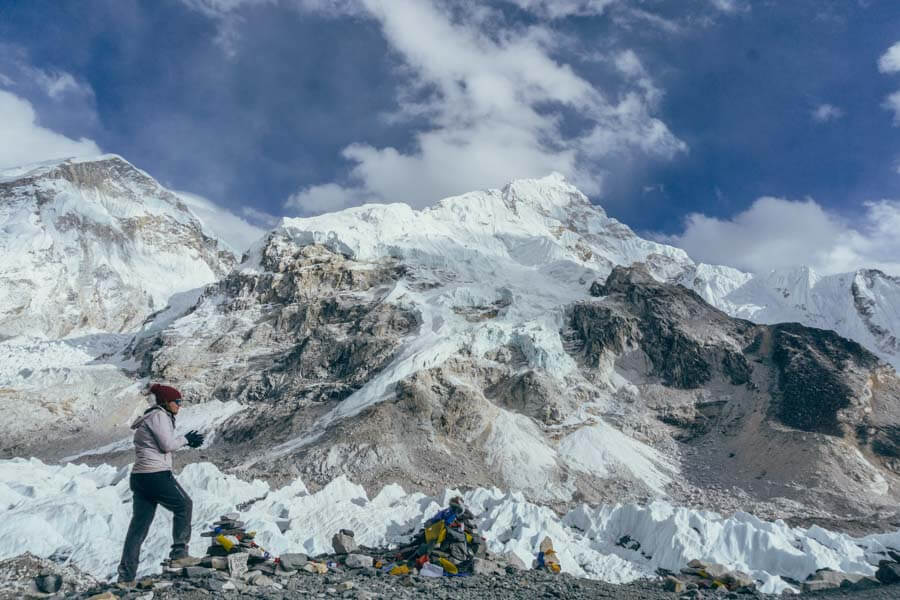
This one’s debatable!
In 2014 I summited the highest mountain in Africa, Mount Kilimanjaro . For this trek, you have to book a tour through an organized trekking company. I thought the same would apply to Everest Base Camp and wrongly assumed that attempting to conquer EBC independently was only for broke backpackers or highly experienced hikers.
I was wrong! You can definitely navigate the Everest region without a guide and many people do so.
However, I don’t regret booking through a trekking company, Mountain Monarch . Here’s why.
Why I booked my EBC trek with a tour group

Firstly, I added Island Peak to my Everest Base Camp itinerary. For this extra section of the trek, a guide is required. Whilst Everest Base Camp requires no technical climbing, Island Peak does and it’s intense.
If you’re up for the challenge, I highly recommend you add Island Peak to your Everest Base Camp tour. You can read about my climb to Island Peak here!
Secondly, I had previous experience with high altitude climbing and if it wasn’t for my skilled guide, I wouldn’t have made it to the summit of Mount Kilimanjaro. As with Kili, getting to Everest Base Camp is tough and reality is that it can be fatal. You need to pace yourself. Many people are put on oxygen and need assistance and those who trek independently don’t have immediate access to these emergency services.
And lastly, the fellow trekkers that I met on my Everest Base Camp tour were the best teammates anyone could ask for. I loved the support, the humor, the motivation, and having a small group of people who were there for me through thick and thin. As you get to the end of your Everest Base Camp trek, you’re going to need all the support you can get.
Final thoughts on how to plan a trek to Everest Base Camp
Trekking to Everest Base Camp is tough. Looking back, there are so many moments where I was thinking “ Why the F$%# did I sign up for this ” and “ With this money, I could’ve spent an extra 3 months backpacking instead of putting myself through this torture “.
But, challenging myself, my mind, my body – and crushing my goal and STILL going on to summit Island Peak – man, you cannot beat that feeling!
Are you planning a trip to Everest Base Camp? Looking for more information on how to get from Lukla to Everest Base Camp? Drop me a question in the comments section below!
Psst… Looking for epic adventures to add to your bucket list? Check out my other posts!
- Complete Guide To Island Peak Climbing in Nepal
- The Perfect Everest Base Camp Packing List
- 10 Things You Need To Know For Your Kilimanjaro Trek
- Everest Base Camp Trek Difficulty: 11 Key Things You Need To Know
- Everest Base Camp Trek with Island Peak Climbing: My Highlights and Photo Diary
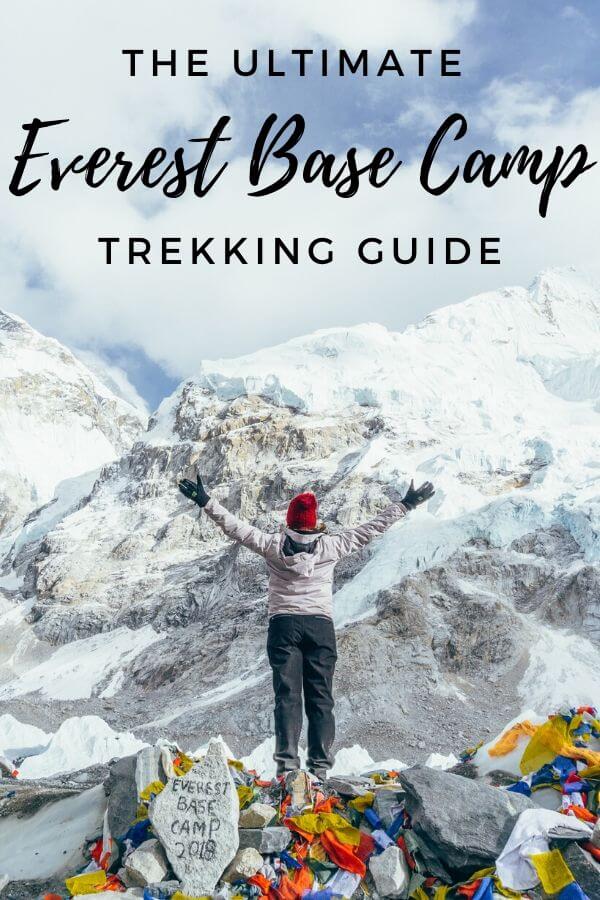
Hi, I'm Carryn. I’m an adventure travel blogger trying to figure out my way through life by traveling and exploring. Join me as I share my travel guides and tips for life abroad. Find out more about me here .
Backpacking Indonesia: 26 Things I Wish I Knew
Everest base camp trek difficulty: 12 key things you need to know, 24 thoughts on “the ultimate everest base camp trek itinerary: how to get from lukla to everest base camp”.
Wow! Sounds like such an adventure. I loved reading your in depth post about your Everest base camp itinerary. It sounds like there is so much that goes into preparing but definitely sounds like you had the adventure of a lifetime.
Thanks Ann. It sure was an adventure I’ll never forget!
Ok, this post was epic – so much information I have to save it. Thanks for sharing!
Thanks Laura! Glad you found it helpful.
this is absolutely breathtaking! i honestly don’t know if I would ever be prepared to do this myself, but your day by day break down was really helpful!
Thanks Claire! Looking back at the photos I’m still in shock that I managed to get to Everest Base Camp!
Amazing. What a trek and journey for your mind, body and soul!
It was indeed!
This is epic! Im going in April and I’m so excited. Ive done Annapurna base Camp and loved it so I’m sure ill love this too!
Hi Emma, Good luck for your trek! I’d love to hear how EBC compares to Annapurna.
So interesting to read about your experience! I’m going to Nepal soon to do the Annapurna base camp and mardi Himal. They have a lower altitude but I’m still a bit nervous because of the altitude sickness 🙆🏼♀️
Hi Nina, I’m sure you’ll love it. Just take your time and don’t be afraid to walk super slow (like I did)!
WoW! This sounds like one amazing trip and one I’m sure that you will never forget! Really inspiring
Thanks Lori. EBC tops my bucket list so now I’m looking for the next adventure to conquer!
Wow! This sounded so intense! What an experience to say that you’ve done it.
It was tough, but everyone goes through a different experience. I thought about turning back so many times, but I’m so glad I stayed strong and kept going!
Wow! What an incredible experience, I don’t know if I’m ready for it but you definitely gave me some things to think about, thanks for sharing!!
Thanks Meghan!
Amazing!!! Wonderful recap! EBC isn’t easy! That was my first dance with altitude! Need to get back to do Island Peak!!!
Hey Bridget, Island Peak is incredible and I’m so glad I added it to my Everest Base Camp itinerary. Congrats on making it to base camp!
BADASS! I love that you mentioned a longer itinerary to acclimatize (is that the right word? lol) naturally and a way to get off the beaten path for this popular trek! I hope to make the Everest Base Camp Trek in the coming years and this is definitely a guide I will come back to help plan (: AND CONGRATS on killing it on this hike! So epic!
Hay Aaren, thanks for the kind message! I’m so stoked that I made it to base camp. And you can to! If you ever decided to trek to EBC, let me know!
Congrats on choosing the High Scenic Trail via Mong La and Phortse instead of the crowded Tengpoche route 95% of trekkers use. The best kept secret in Khumbu is finally leaking out!
About helicopter traffic: Google [helicopter rescue scam Nepal] and be educated. Multimillion dollar business now, thousands of EBC trips destroyed every year with this insurance fraud.
Hi Petrus, Agree – the less crowded route is far better!
Leave a Comment Cancel reply

Base Camp Adventure

- Email: [email protected]
Everest Base Camp Trek Tips and Tricks

Everest Base Camp Trek is an incredible adventure in the Himalayan region of Nepal. Mt Everest region is home to majestic hills, serene rivers, pristine waterfalls, and village settlements. There are various trekking routes and destinations in this region.
However, it is quite a challenge to trek these rugged landscapes for around two weeks. Therefore, trekkers must undergo various training regimes before taking this famous trek. You can tackle these challenges by following specific tips and tricks during your trekking journey.
These excellent tips will ensure that your Everest Base Camp Trek is entirely safe and comfortable. Moreover, we have listed some of the most essential Everest Base Camp Trek tips and tricks. Trekkers should follow these guidelines for a great adventure in the Himalayas. Read on to learn more about them in detail.
20 Essential Everest Base Camp Trek Tips and Tricks
● get a training regime.
Everest Base Camp trek is not an ordinary hike. It requires proper training well ahead of the trek. You will need to pass through long and taxing trails to arrive at a high-altitude base camp. Besides that, you also need a good level of fitness and stamina.
There are diverse landscapes in this beautiful region that are ideal for trekking. The trekkers need to cross around 130 km, with a maximum altitude of 5,545m. There are incredible up and down trails with incredibly challenging sections. However, if you train well, you can achieve this journey with ease.
Therefore, physical training, cardiovascular exercises, mental preparation, and others are essential. You should start your workout and training at least 2 to 3 months before the trek.
● Trek through a local trekking Company
This Everest Base Camp trek is ideal if you trek with a local trekking company. While there are numerous trekking companies, you can select the best one considering their experience and ratings on sites like TripAdvisor .
You can also learn from veteran trekkers who have trekked in the region before to know more about trekking companies. Another advantage of these local companies is that you can get the best meal, accommodation, and other logistics services. You don’t have the hassle of booking these facilities yourself if you trek through a trekking company.

● Hire local professional guides
Everest Base Camp Trek is possible to solo as well, but it is a much better experience with a professional guide. You will have a lot of burden off your back when you hire a guide. You can also know more about the local culture, settlements, and markets of the Everest region.
Besides, you will also get the best meal and accommodation services as these guides have local contacts. You will also learn the local language and interact with locals as they can act as translators. Overall, you will have a beautiful trekking experience when you hire a local professional guide.
Travelers should also not hide their problems with your guide and team leaders. The high-altitude treks provide you with many challenges, and you will have to adapt. Therefore, you can speak out to your guides about any problem.
● Get the right gear and equipment
Gear and equipment are an essential part of your trekking journey in high-altitude conditions. They will keep you safe in emergencies and help you proceed further along trails. The unpredictable weather in high-altitude conditions requires warm clothes and gear.
These items will keep you safe from the region’s chilly weather, harsh winds, and heavy snowfall. Trekking pants, shirts, gear, footwear, toiletries, and medical items are essential gear and equipment. However, you should not pack heavy and only pack those items for your hike that are necessary. A heavy backpack will cause you problems while trekking.
- Full Name *
- Contact Number
- Your Message/Inquiry *
● Mentally prepare for the trip
While physical training is quite essential, mental preparation for this Everest base camp trek is a must. Beginners or amateur trekkers should especially prepare well mentally for this trek. Those vital mental preparations will lead you to the successful completion of your trek. Having a positive outlook and attitude in these challenging trails is essential.
● Learn about Altitude Sickness in advance
Learning about altitude sickness is a must before you take on this trek in a high-altitude region. If altitude sickness persists, you will have to descend back to lower altitudes. Learning about altitude sickness will make you aware of its symptoms and precautions. This altitude sickness is a severe threat that requires proper consideration.
● Hydrate regularly
Everest Base Camp Trek is a high-altitude adventure. Hence, there is an extremely high chance of altitude sickness among trekkers. Drinking water at regular times and intervals will keep you safe from altitude sickness. Dehydration is a primary cause of altitude sickness.
The altitude sickness can even turn fatal if not treated in time. So, travelers should keep their water bottles near at all times during their trek. Besides that, you should not drink alcoholic drinks as they can cause dehydration and, subsequently, altitude sickness.

● Have a proper Travel Insurance and Evacuation plan
Having a proper emergency evacuation is essential for this trek in the Everest region. Many situations might require helicopter evacuation in the area. If you have not trekked in high-altitude conditions before, you should have a proper evacuation plan ready before you start on this trek.
Therefore, adequate travel insurance is a must during this Everest base camp trek. Travel insurance must cover all aspects of this trek, including medical injuries, thefts, loss of property, and evacuation costs. However, you must ensure that it covers an altitude of 4000m above.
● Always trek on the safe side.
The Everest Base Camp is an incredible landscape trail. The travelers will walk along the steepest and narrowest path. Therefore, travelers should always walk on the safe side to avoid falling on this Everest Base Camp trail.
Moreover, mules and yaks are walking along trails in herds. They can hit you if you stay in their way. Therefore, you should always step out of their way and stay on the safe side until they ultimately move out. Consequently, you should watch your every step along the Everest base camp trail.
● Acclimatization is essential
Acclimatization is an essential process when it comes to high-altitude conditions. For those who are trekking high altitude conditions for the first time, acclimatization becomes a must as it helps you tackle and adapt to changing conditions.
Everest Base Camp Trek takes around two weeks to complete, and at least two days of acclimatization is a must in your itinerary. These acclimatization days help lower the chances of altitude sickness, and you can complete this trek with ease.
● Get a perfect trekking Boot.
Everest Base Camp Trek passes through rugged and remote terrains of the region. Therefore, you will require proper footwear to traverse alongside the most challenging trails. You will need to travel a long distance of around 130km with an average of 6-7 hours of hike.
Thus, picking the right trekking boot becomes essential during this trek. Besides that, these boots must be comfortable, breathable, and durable. Therefore, you should invest well in these boots before starting on this trek.
● Carry books, kindle, playing cards to past time
This Everest Base Camp is an arduous journey that takes around 6-7 hours a day. You will, however, have a lot of free time on your trekking journey in the mornings and evenings. Therefore, you can carry books, a kindle, or playing cards to pass the time and keep you occupied. But you can also bring other board games or musical instruments so that you don’t feel bored and avoid dullness.
● Eat a balanced and nutritious diet during the trek.
Food along the trail must be balanced and rich in carbohydrates. Dal Bhat, a typical Nepal dish, is quite common along the route and easily found in these tea houses. Besides that, you should also eat more as you burn more calories while trekking in high altitude up and down conditions. Munchies and snacks during the trek will boost your energy and increase your stamina.

● Carry cash along the trail
Since this Everest base camp trek is a high-altitude trek, there are no ATMs along the trail. The last ATM booth you can find is in the Namche Bazaar. Therefore, you should withdraw money in lower regions and carry cash along trails for meals and accommodations.
Instead, you can also cash out on Kathmandu. You don’t have to worry about safety as you can also treat guests as gods. You can remain assured of your and your item’s safety along trails.
● Walk Gradually along Trail
Everest Base Camp Trek is a long-distance adventure. However, you should not treat this trek as a race and trek quickly as it can lead to altitude sickness. Therefore, you should trek gently at a gradual pace with many rests in between.
You can also cover 10 to 15 km in the distance within the daylight. Even if you stroll and take breaks in the middle, you can arrive at your destination before dark. You can also explore the region and take incredible pictures of snow-capped mountains along the trail.
● Carry Power Bank or Solar Charges
There are problems with electricity along the EBC trail. It is pretty challenging to charge your phone at all times along the trail. Therefore, you can carry a power bank to keep your phones charged along the route.
Besides that, you can also take the solar chargers. Having such power backups will provide you with a proper mobile connection. Most teahouses also offer charging facilities at an added cost. But you should still take power banks or solar charges for emergencies.
● Keep spare days in he itinerary
Everest Base Camp trek is a long-duration trek that provides you a great adventure. Since there is quite unpredictable weather, you must keep extra days as there are many delays and cancellations.
There are other incredible sightseeing spots around the region, including Kathmandu valley. You can tour the City, heritage, wildlife, religion, and others. You can also get various adventure sports, including rafting, fishing, mountain biking, paragliding, etc. So, you should keep some extra spare days during this trek.
● Carry snacks to munch on during trek
Everest base camp trek also requires you to carry snacks to munch on during the trek. They will satisfy your hunger and provide you with enough energy for the hike. But there are not many shops along the trail, and even if there are, the prices are pretty high. Therefore, you should pack your bags with snacks. Having snacks like protein bars, chocolate bars, granola bars, walnuts, peanuts, and others is essential for this Everest base camp trek.
● Prepare for cold weather conditions.
This incredible trek is in some of the coldest places on earth, the Himalayas. Rain showers are pretty standard, along with the snowfall. There are overcast conditions, and temperatures can fall significantly in these regions. The weather forecast of the area is quite unpredictable. You should pack the necessary clothing and gear to save from extreme cold.
● Bring sunscreen and Wet wipes.
The sun in the Himalayas reflects from silver mountains and gets harsh. Therefore, trekkers’ skin can get burned quickly. If you travel in peak seasons of Autumn and Spring, you will get sunny days that are ideal for trekking but can cause sunburns. You can get proper gear to cover the body or and use sunblock creams to avoid sunburn.
The sun hat/cap, jackets, trousers work fine as well. Wet wipes are another useful along trails as you will not get hot water along the route. Hence, you can wash your face and body after a long day on the course with wet wipes. However, you must ensure that wet wipes are biodegradable and non-fragrance.
Hence, these were the various Everest Base Camp trek tips and tricks that are of great use along the trails.
Everest Base Camp Trek is one most sought-after treks in the world. This incredible trek is equally challenging as well as convenient. If you are taking this outstanding trek in the region, you must consider certain factors.
Moreover, you can make incredible memories in the Himalayas with the help of these guidelines. We hope you learned about these Everest base camp trek tips and tricks through this article. Contact us for more information about this trip. Happy travelling!
You may also like...

Langtang Valley Trek Route – 8 Days Itinerary

Manaslu Tsum Valley Trek Map

3 Days Treks in Nepal

Everest Base Camp Trek – Ultimate Guide For 2024
Written By: The Planet D
Adventure Travel , Nepal
Updated On: January 5, 2024
Trekking to Everest Base Camp is different than other treks around the world. Nowhere else on earth will you experience trekking as you do in Nepal and nowhere quite compares to the majesty of the Himalayas. Villages dot the landscape filled with restaurants, markets, bazaars, and tea houses (mini-hotels) where you can stop for lunch, buy supplies, and have a piece of apple pie while surrounded by the highest mountains in the world.
Every hundred meters or so there is a hotel, restaurant, or cluster of buildings making up a small village. The villages are stunning reminding us of something out of the Swiss Alps on steroids. Well-built lodges and brick homes line the trail with the magnificent setting of the Himalayas draped in the back.
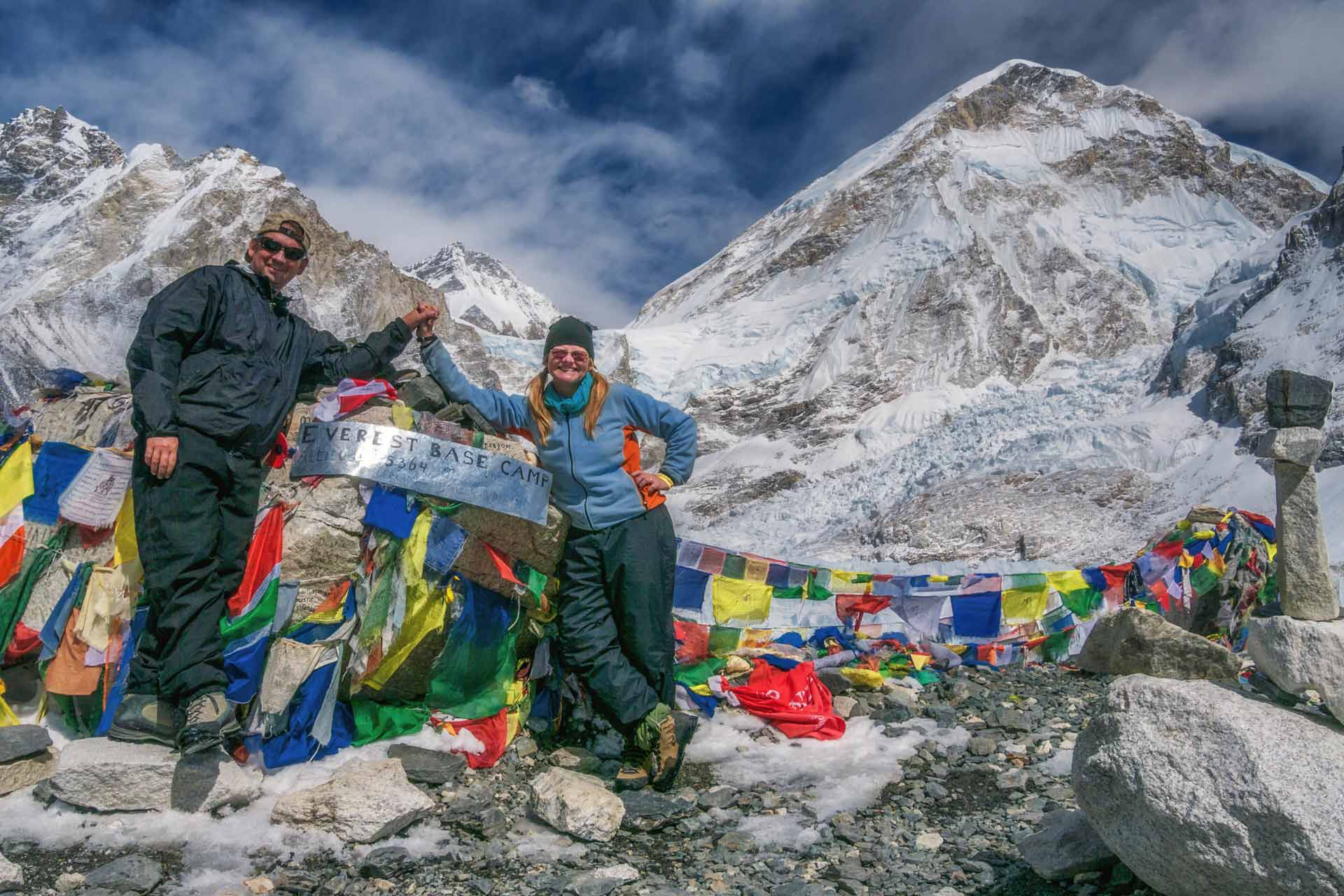
Table of Contents
Trekking to Everest Base Camp
What is it like trekking to Everest Base Camp in Nepal? The EBC Trek is life-changing, it’s exhilarating, and it is challenging. We share everything you need to know from planning your trek to Everest to packing for your trip. This guide to the Everest Base Camp Trek breaks down each day. So sit back and take a journey with us through Nepal’s legendary Sagarmatha National Park.
Everest Base Camp Trek Itinerary
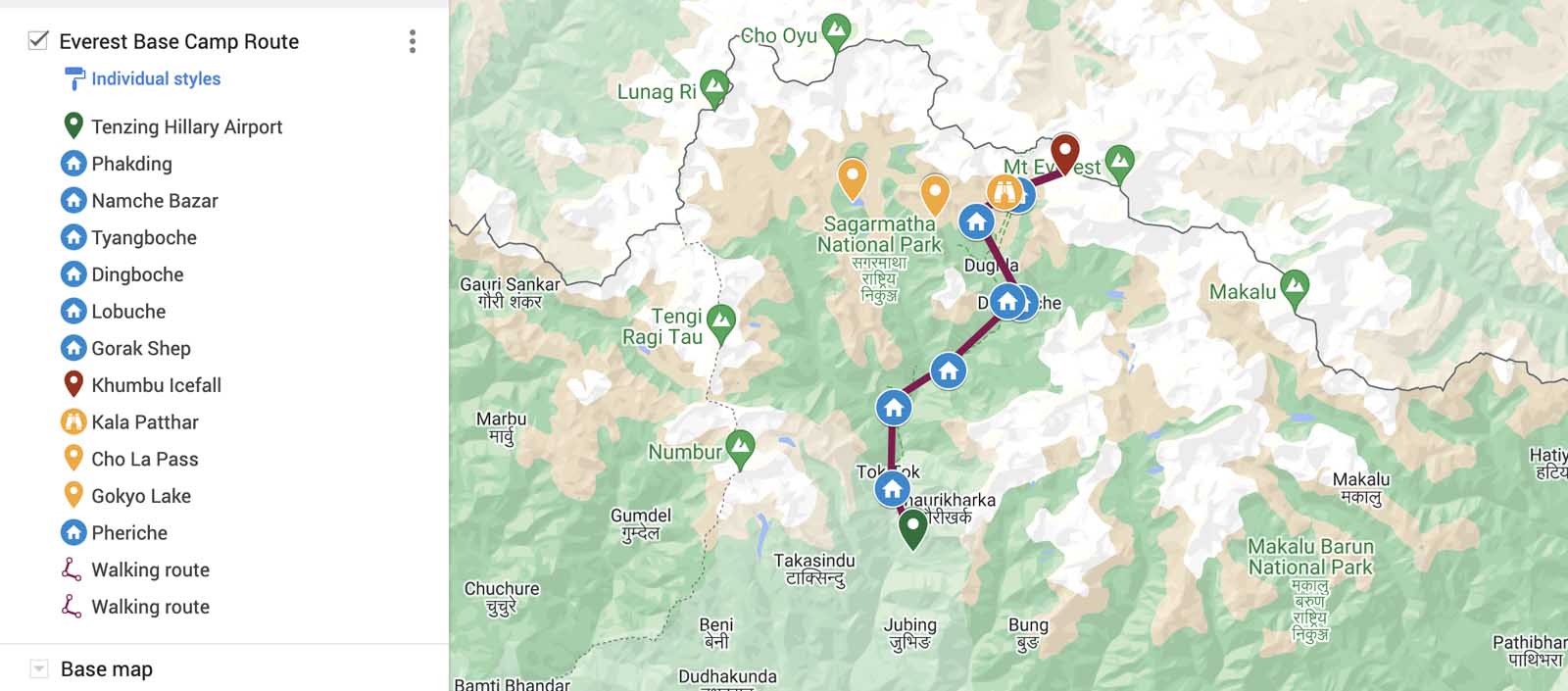
On the map, the Everest Base Camp trekking route distances look fairly easy to hike from village to village through the Khumbu Valley. Eight days may seem like it would be more than enough time to cover a mere 63 km (39 miles) one way, (128 km return) but with several sustained days in a row above 4000 meters (13,000 feet), the walk is slow and steady.
It is important not to push too fast to avoid altitude sickness which is a very real possibility. When trekking to Everest base camp, expect to hike anywhere from 7 – 17 km (4.5 – 10 miles) per day with the entire trek taking 12 – 14 days.
Hiring a Guide for the EBC Trek – Mandatory
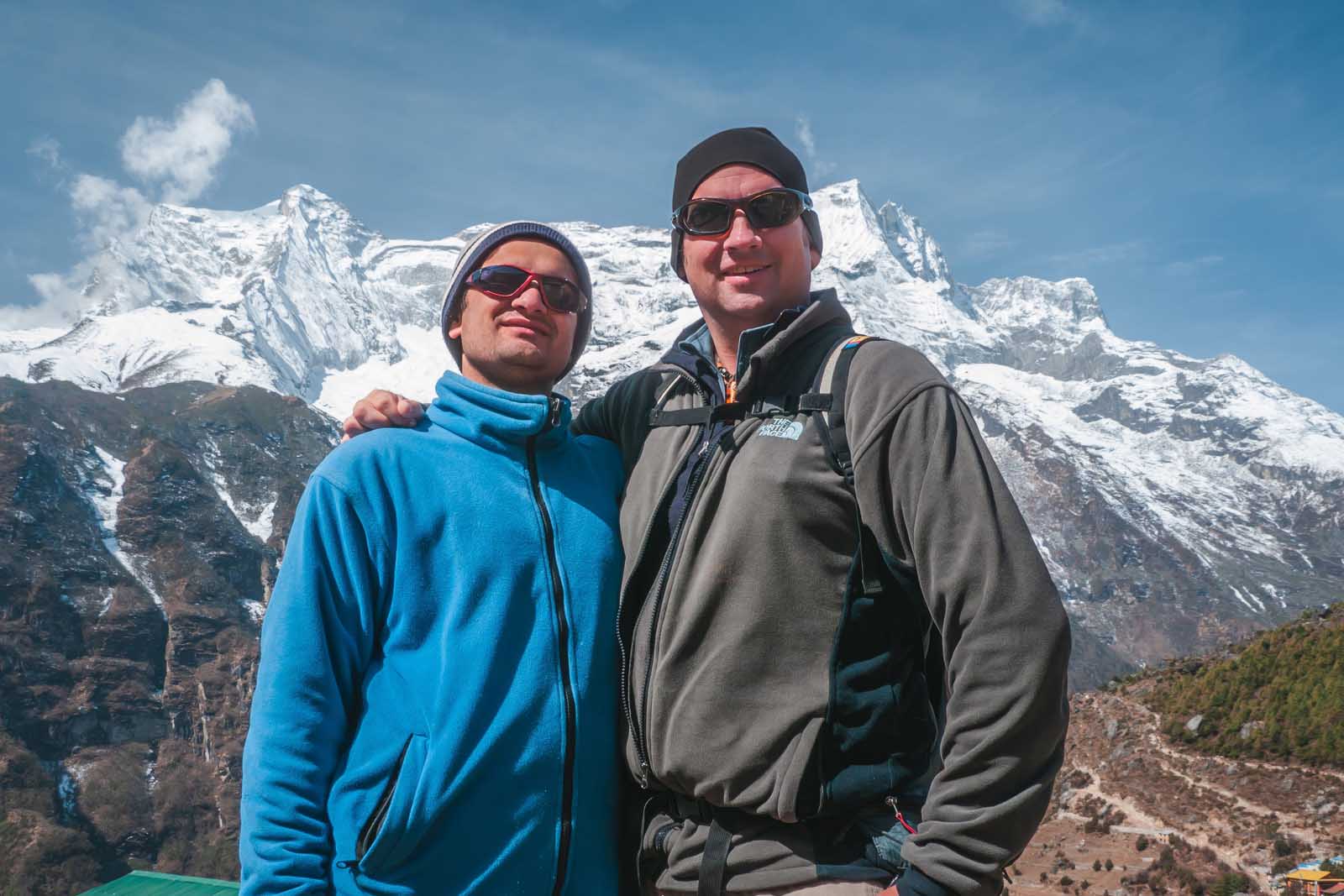
In April 1, 2023, Nepal has banned solo trekking. Foreigners must hire a guide for treks in high-altitude trekking regions of national parks. According to the Kathmandu Post in March “ solo or independent trekkers have to mandatorily hire a guide or a porter before setting off to Nepal’s mountains.” However, after an updated article in the Kathmandu Post, it seems that the Everest Region is an exception. Before booking, we would check with local companies and authorities as rules are constantly changing.
Book Locally
Many people book ahead of time with a tour company located outside of Nepal such as Intrepid Travel or GAdventures, but we hired locally and it saved a lot of money.
Plus, you know your money is going directly to the local economy and you have a more intimate experience by trekking with a local guide. We spent a couple of days in Kathmandu looking for a guide to Everest and found Simrik Real Nepa l owned by Kathmandu resident Dipendra Simkhada.
Dipendra planned the entire trip for us, and all we had to do was wait for him to pick us up at our guesthouse in Kathmandu to take us to the airport to board our Tara Air flight to Lukla Airport. Book your Trek to Everest Base Camp with Simrik Real Nepal – A Locally owned and operated tour company, Simrik is located in Kathmandu.
Kathmandu – The Hub of Nepal Treks
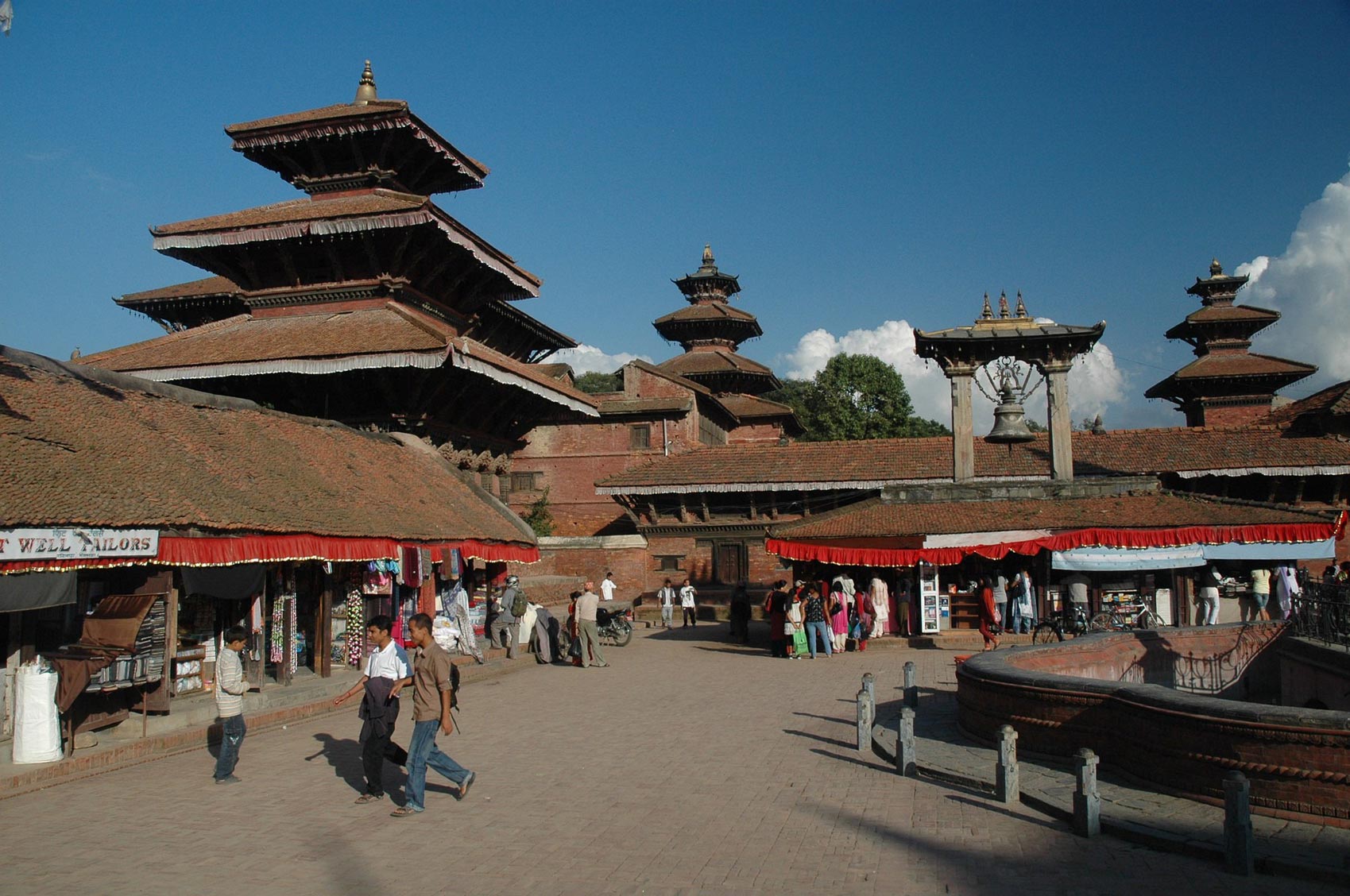
We spent a few days in Kathmandu picking up supplies and doing some sightseeing before trekking to Everest. We suggest not spending too long here as it can be very polluted in Kathmandu and by the time we were ready to trek, I was already quite congested.
Our recommendation is when you arrive in Kathmandu, only spend two to three days to get yourself organized and instead do your sightseeing at the end of your trek. Read more: Top Places to visit in Kathmandu, Nepal
Day 1: Fly from Lukla Trek to Pakhding
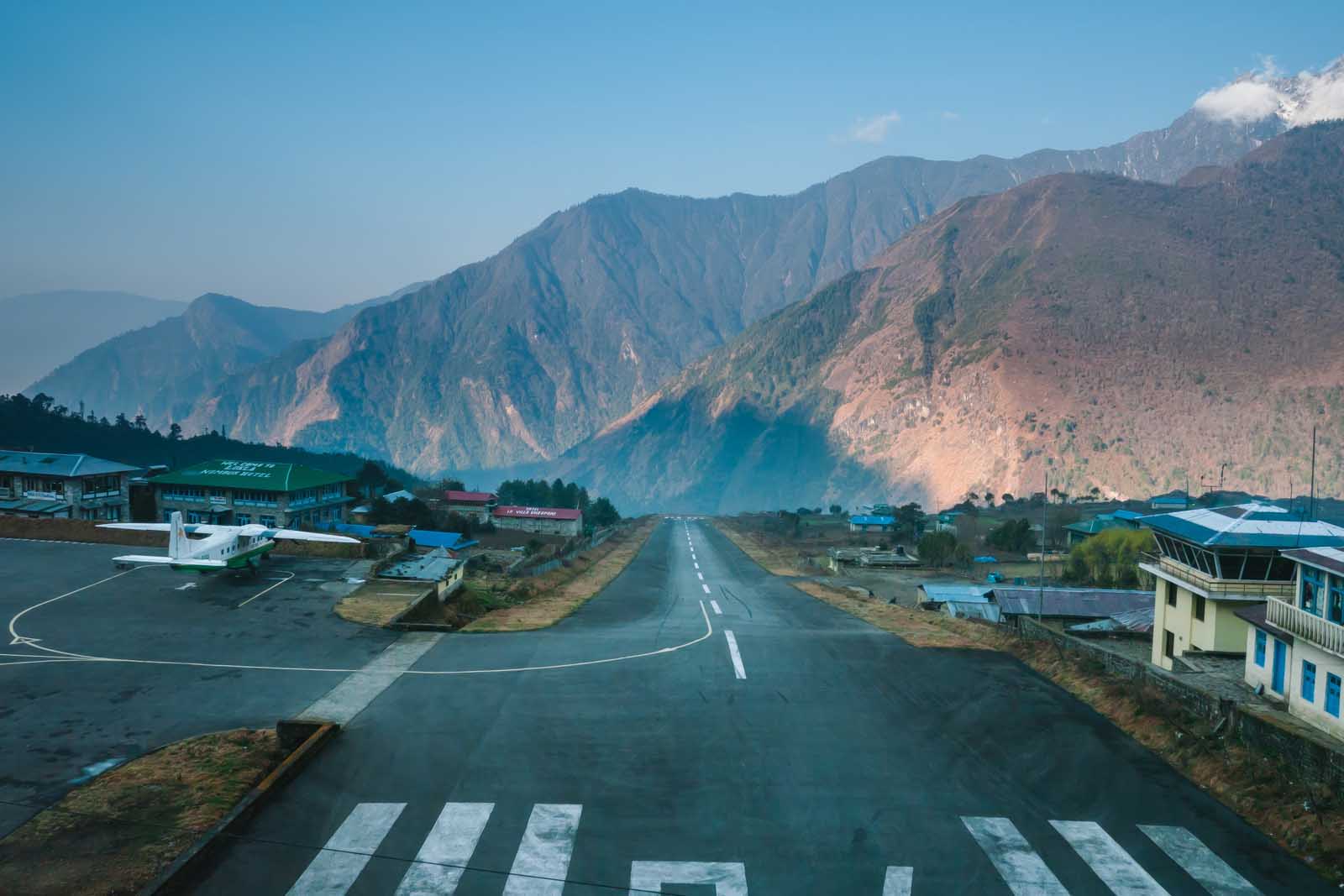
Flights to Lukla no longer leave from Tribhuvan International Airport (Kathmandu Airport) in Kathmandu due to congestion. Flights are now out of Ramechap airport which is a 4 1/2 hour drive from Kathmandu. You can book private helicopters from Tribhuvan International Airport.
The flight from Ramechap airport is much shorter than the flight from Tribhuvan International Airport. Flights to Lukla are only 12 minutes so more flights can get through when the weather is clear making flights less likely to be canceled or delayed for too long.
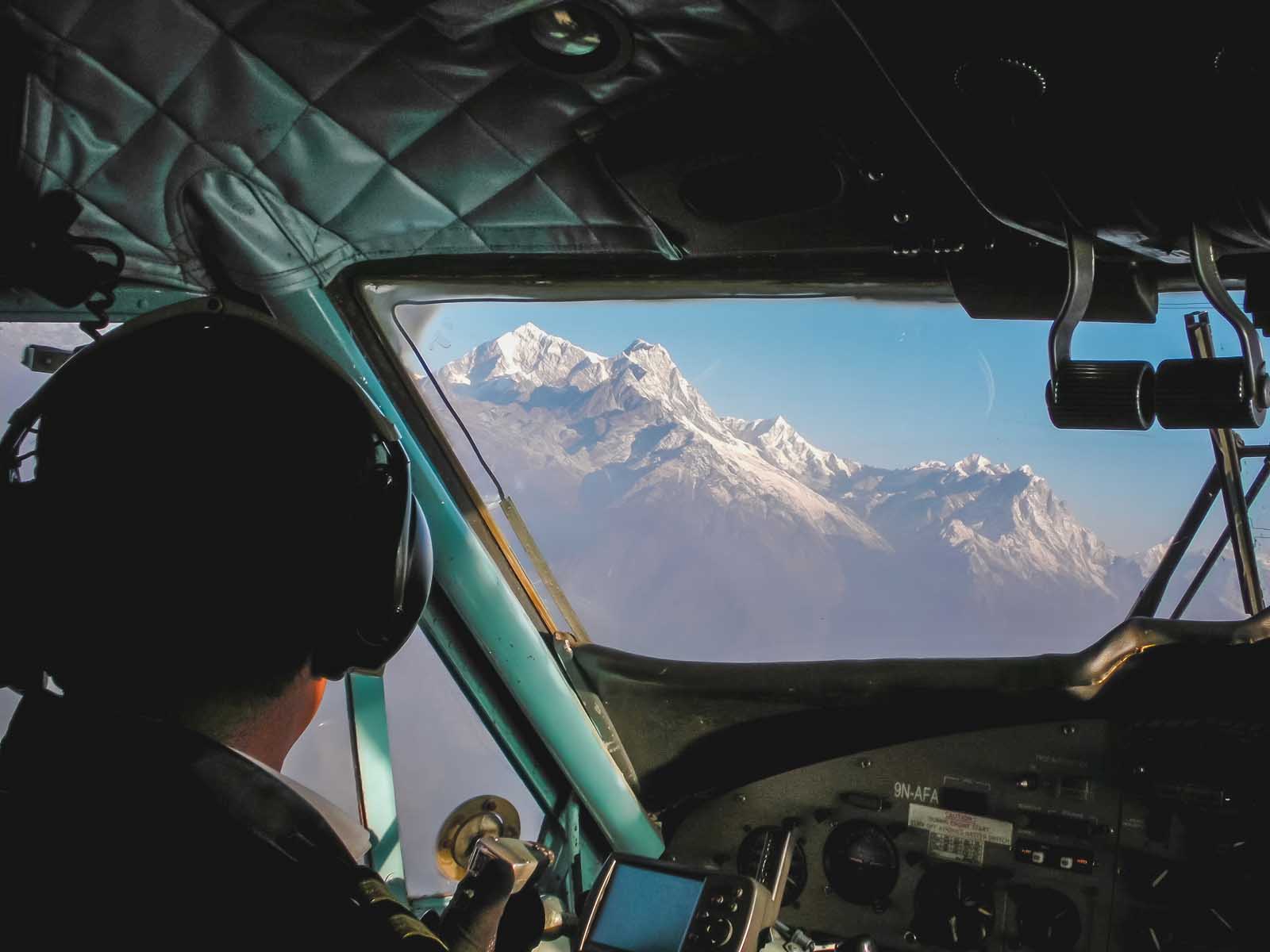
The flight to Lukla is a scary flight and is considered one of the most dangerous in the world. We flew from Kathmandu but flights now are much shorter from Ramechap. I think I would like it better as we sat at the front of the plane and saw the pilot’s instruments constantly flash “ obstacle ahead. ” It looked as if we were about to crash into a mountain at any time. Read all about our flight to Lukla and watch the video here
Watch Us Fly to Lukla Airport
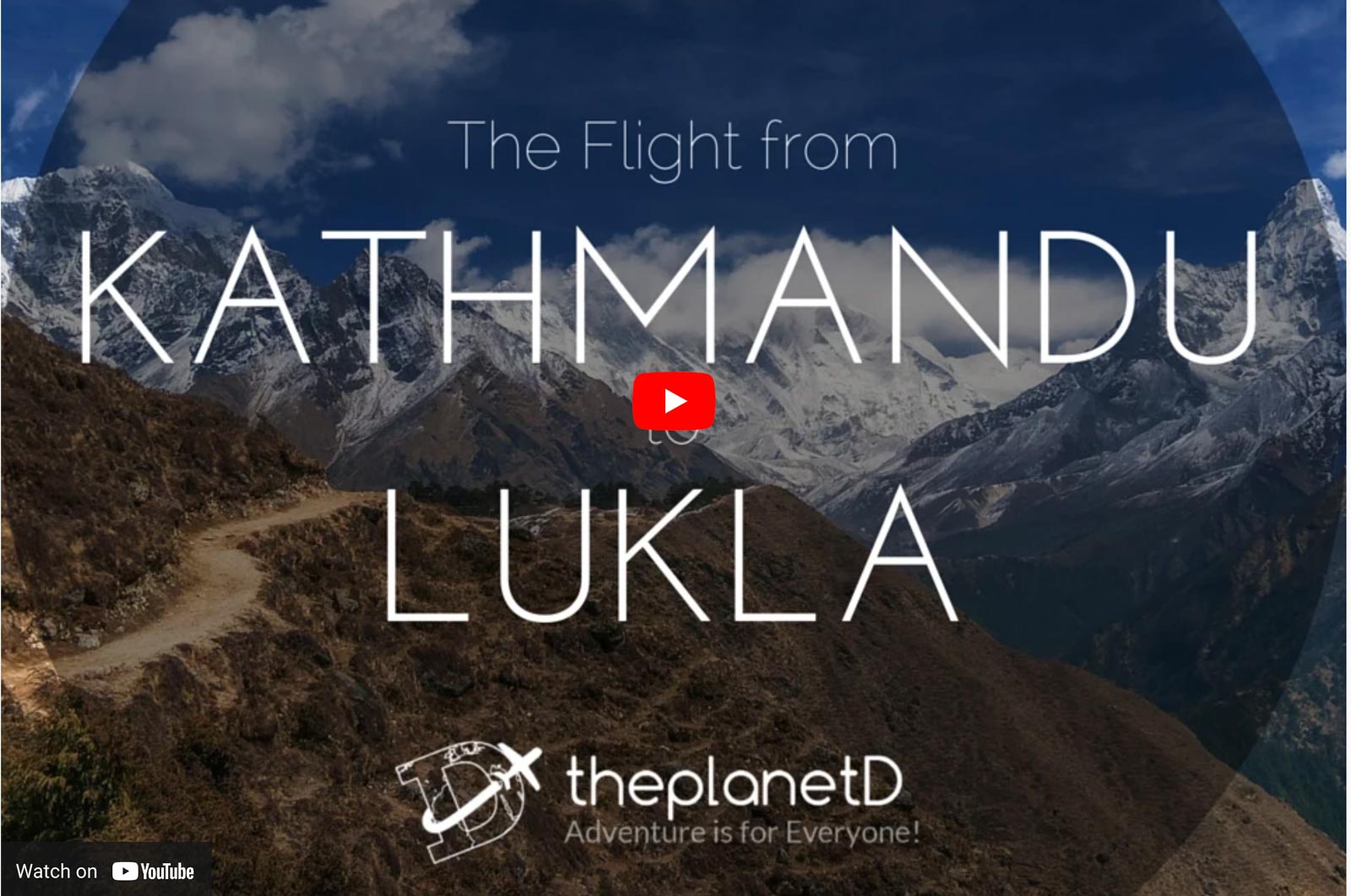
The Lukla airstrip at Lukla Airpot is a short landing strip at only 525 meters (1,729 feet long.) Built on the side of a mountain it is also a very steep grade that is needed to slow the planes down quickly. Needless to say, we held our breath during the landing.
We survived that flight, but it was the flight back to Kathmandu I was nervous about. Taking off on that short of a runway was a hair-raising experience. One false move and we’d drop thousands of feet into the valley below. Lukla Airport is actually called Tenzing Hillary Airport named after the first two men to summit Mount Everest.
Hiking from Lukla to Pakding
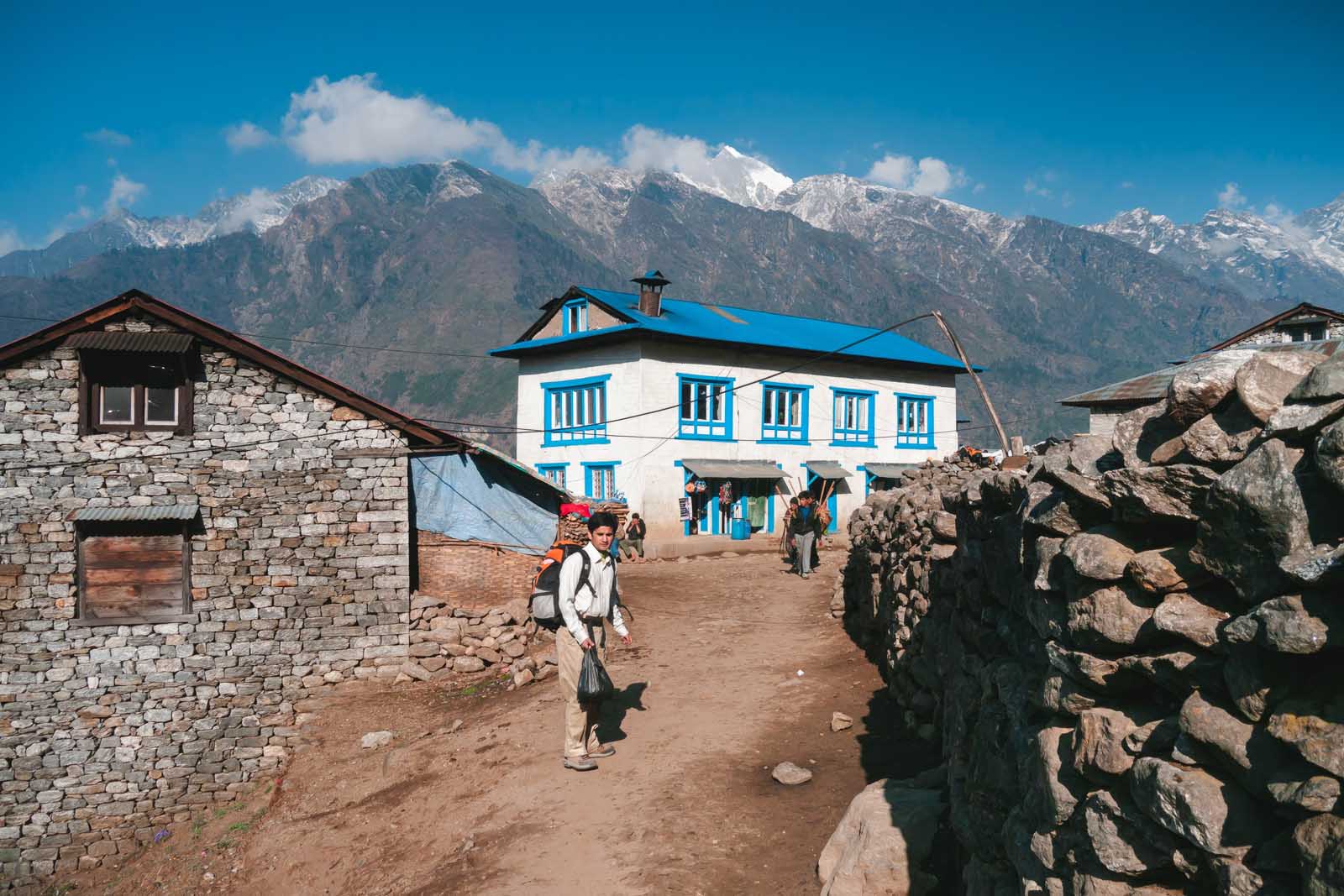
The trek begins officially in Lukla. Lukla is a busy town with plenty of accommodation, shops, and eateries. If you forgot anything for your EBC trek, you can pick up supplies in a pinch. But we suggest purchasing all your gear in Kathmandu. It is much cheaper.
From Lukla, we immediately started our Everest Base Camp hike. After a quick snack and a cup of tea in Lukla, we set off on an easy three-hour trek along trekking trails that were easy to follow weaving through villages, crossing rivers, and stumbling over stony paths.
Entering Sagarmatha National Park
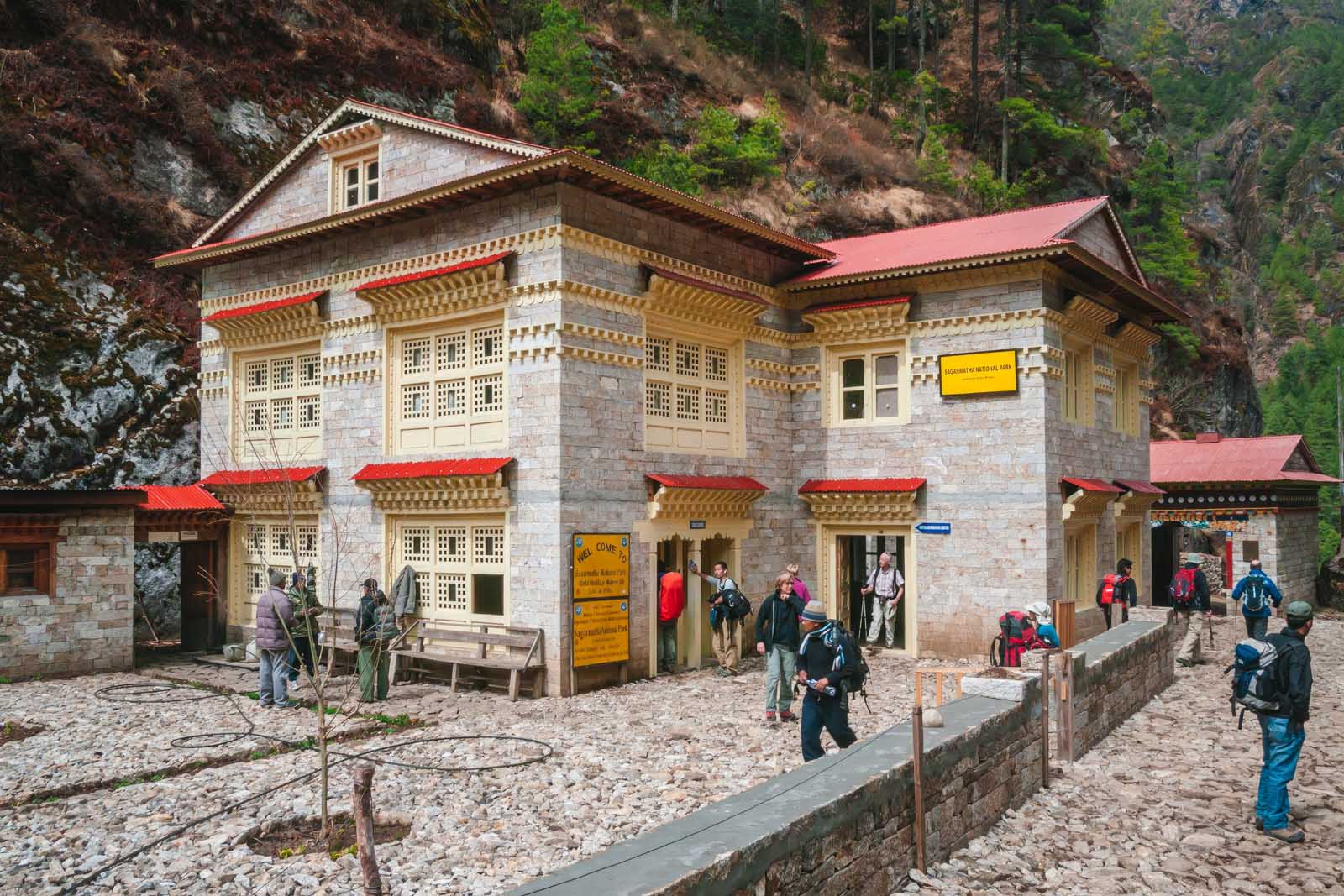
A permit is needed to hike to Everest Base Camp as it is located in Sagarmatha National Park. We checked in with the national park headquarters and Dipendra took care of everything. He had all our paperwork in order so all we had to do was start walking through the beautiful Khumbu Valley to make our way to Everest base camp.
Sagarmatha National Park has been a UNESCO World Heritage Site since 1976. At 1148 square km (443 square miles) in area, it is one of the most beautiful places we have ever visited.
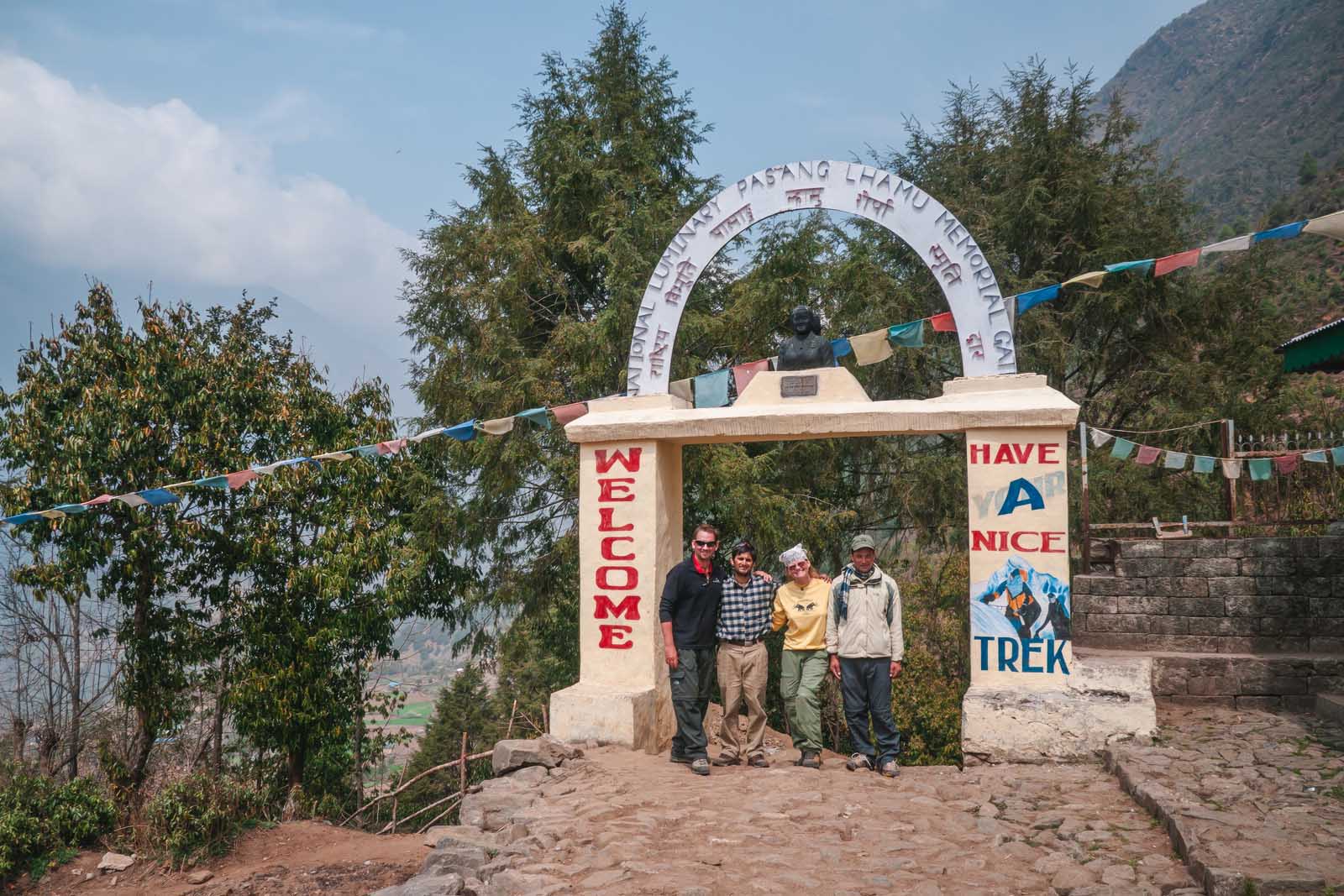
We felt giddy stepping through the welcome gates located just outside of Lukla. This was it, we were following in the footsteps of the great adventurers of our time. It was awe-inspiring to hike through the Khumbu region surrounded by the Himalayas.
As we hiked out of Lukla, Dipendra pointed out the surrounding jagged white peaks named Kwangde, Mumbu, and Kishumkongara. At 6000+ meters, (19,000+ feet) these are the “little guys” of the world’s highest mountain range. It wouldn’t be long until we were among the famous 8000-meter (26,000 feet) peaks.
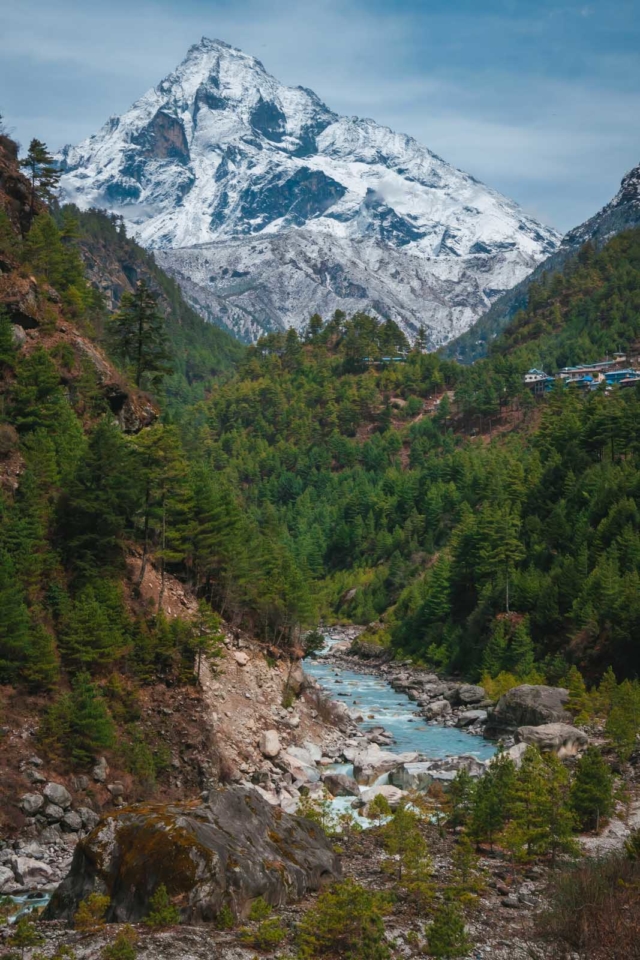
Our first day was filled with a relaxing walk while learning about the Khumbu region. It was quite early in the day, so we had plenty of time to take our time to learn about the customs of climbing and learn the names of the mountains found in this beautiful region of Nepal.
For the rest of the day, we followed the Dudh Koshi River Valley at a steady but leisurely pace to the village of Pakding. Temperatures were warm and the first day of trekking was comfortable. Lukla to Pakding actually has an elevation loss, so it is a good introduction to hiking through the region as we had a lot of downhill trekking.
After about 5 hours, we came to our first night on the trek where we spent the night in a comfortable teahouse in the village of Phakding.
Our First Night on the EBC Trek
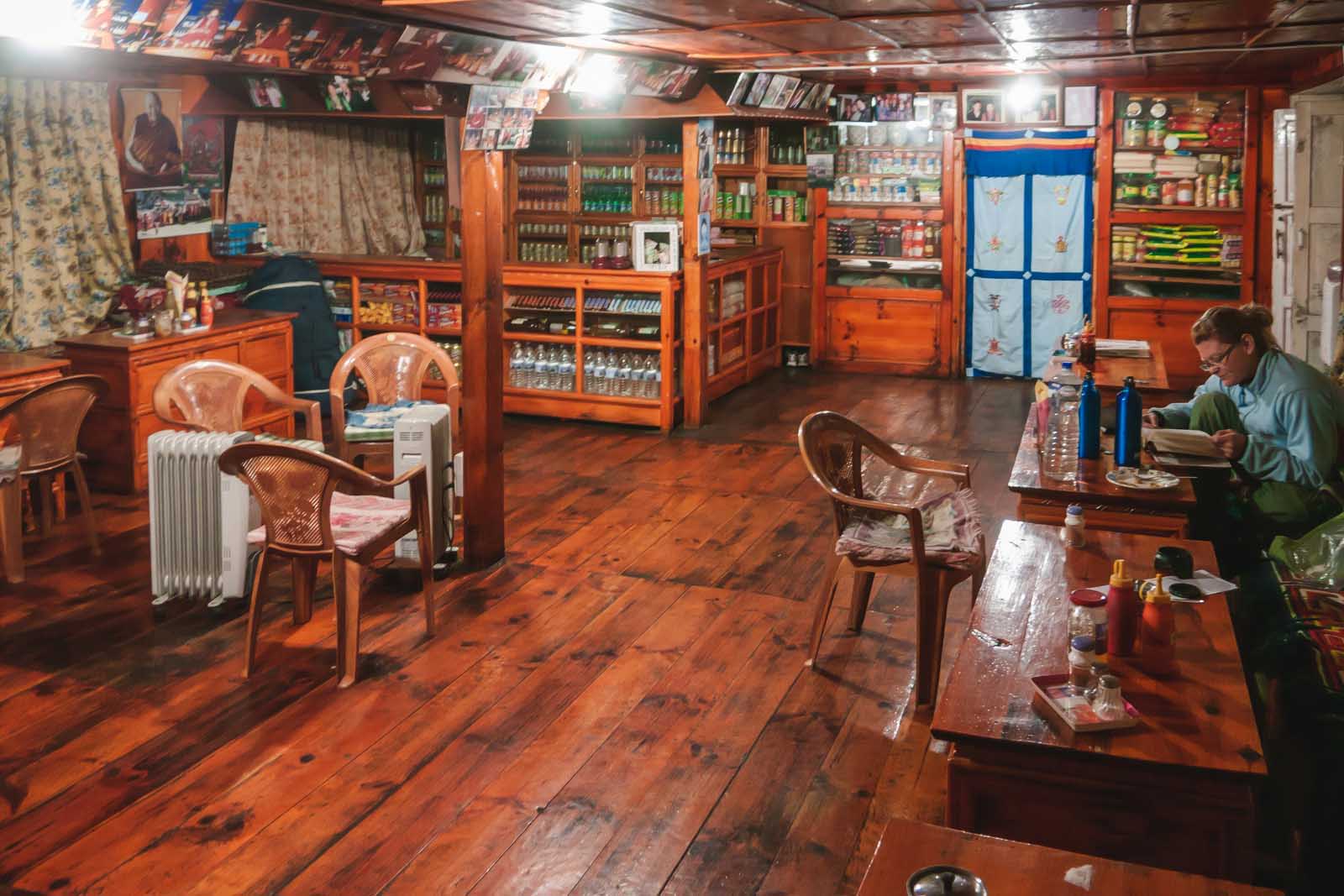
The accommodation in Pakding was a quaint little hotel/teahouse that looked like a cottage. The wood-burning stove smelled delicious as it warmed the restaurant while they prepared our meals.
Our porter “Sher” carried all our supplies including the sleeping bags that we borrowed from our trekking company. We each rented a sleeping bag that was included in the price of our EBC trek. The beds were comfortable and Dave and I had private rooms. Some tours use dorm rooms but we had private rooms. Toilets were shared, but everything was clean and comfortable. The rooms were clean and we slept like rocks snuggled up in our thick down sleeping bags.
Heated Lodges – Teahouses on the EBC Trek
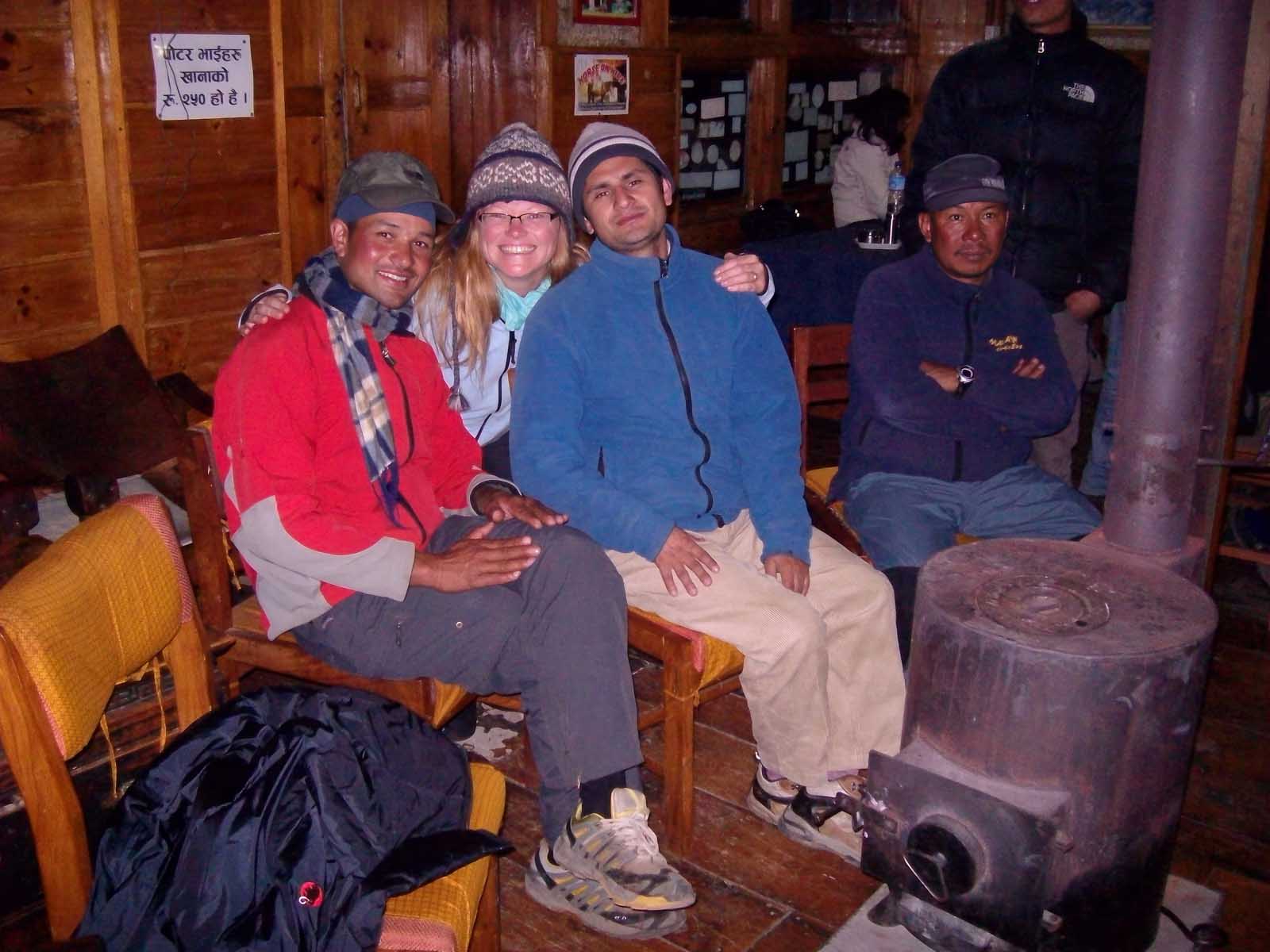
During the EBC Trek, you don’t stay in tents. You stay in charming teahouses with cozy beds, wood-burning stoves, and fully stocked restaurants that serve dinner.
The teahouses are a welcoming sight after a long day of trekking helping to make the trek to Everest one of the most memorable experiences of our lives. If you are planning to trek to Everest Base Camp in Nepal, read on for all the information you’ll need to help you prepare.
The main lodges of each teahouse we stayed in during the first half of our EBC trek were cozy and warm. At the lower elevations, woodstoves burned wood in the dining room and common areas and our rooms were a comfortable temperature with heating as we were wrapped up in our sleeping bags. We ate hearty meals of pasta and meat and enjoyed a relaxing night soaking in the amazing day we just had on the mountain.
- From Lukla – Elevation 2869 meters (9,350 feet)
- To Pakding – Elevation 2610 meters ( 8563 Feet)
- Length – 7.7 km (4.78 miles)
- Elevation loss – 79 meters (259 feet)
- Duration – 3 Hours
Day 2 – Pakding to Namche Bazaar
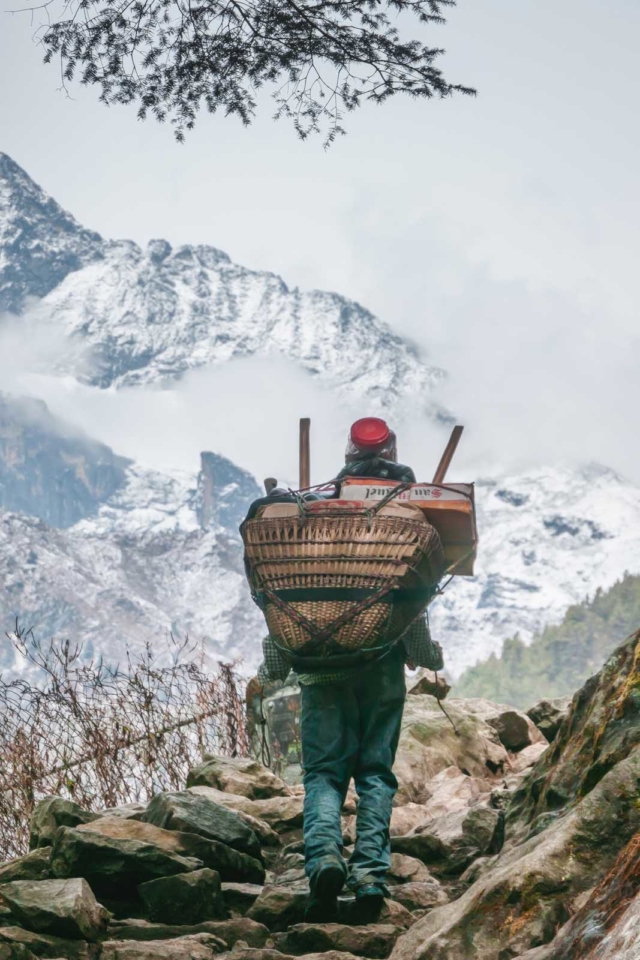
On day two, we checked in at another gate of the Mt. Everest park headquarters to show our documentation. We had to show our passports and give them extra passport photos to go into the log. (So make sure you have extra passport photos with you) Once we signed in, we were officially in the Khumbu region and officially on our way trekking to Everest Base Camp.
We covered a lot of terrain on day two making it the longest day of the Everest Base Camp trek. The trail up the mountains was steep and challenging but it was a memorable day.
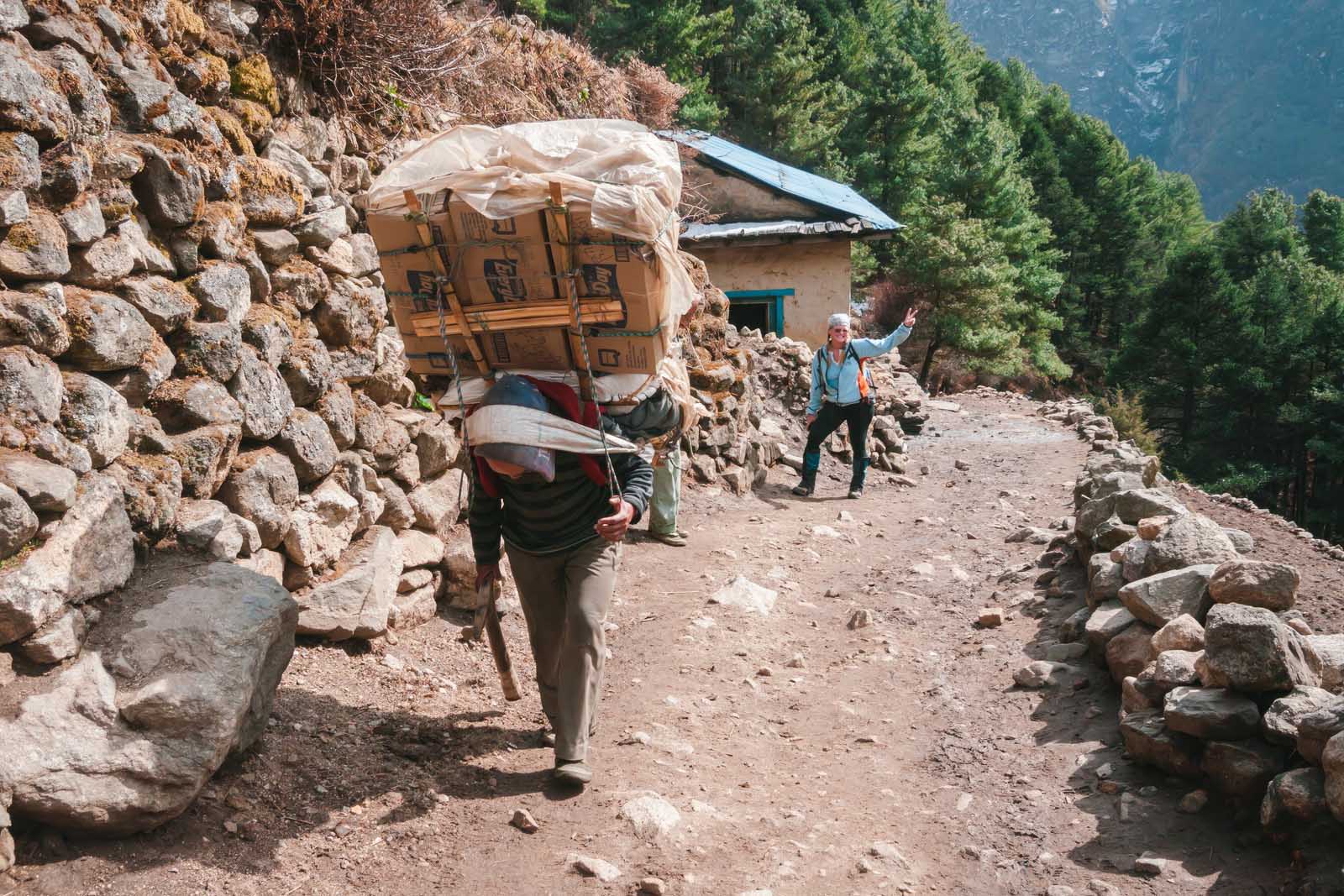
Day two of the EBC trek was a hike of almost 10km (6.2 miles) with an elevation gain of 800 meters (2624 feet). But throughout the hike, there was a lot of elevation loss mixed in so it felt like a lot more.
We would lose elevation as we descended into the valley only to have to climb back up again to a higher elevation. Today was a lot of fun though because we crossed several suspension bridges over Dudh Kosi River Valley.
Suspension Bridges on the way to Everest
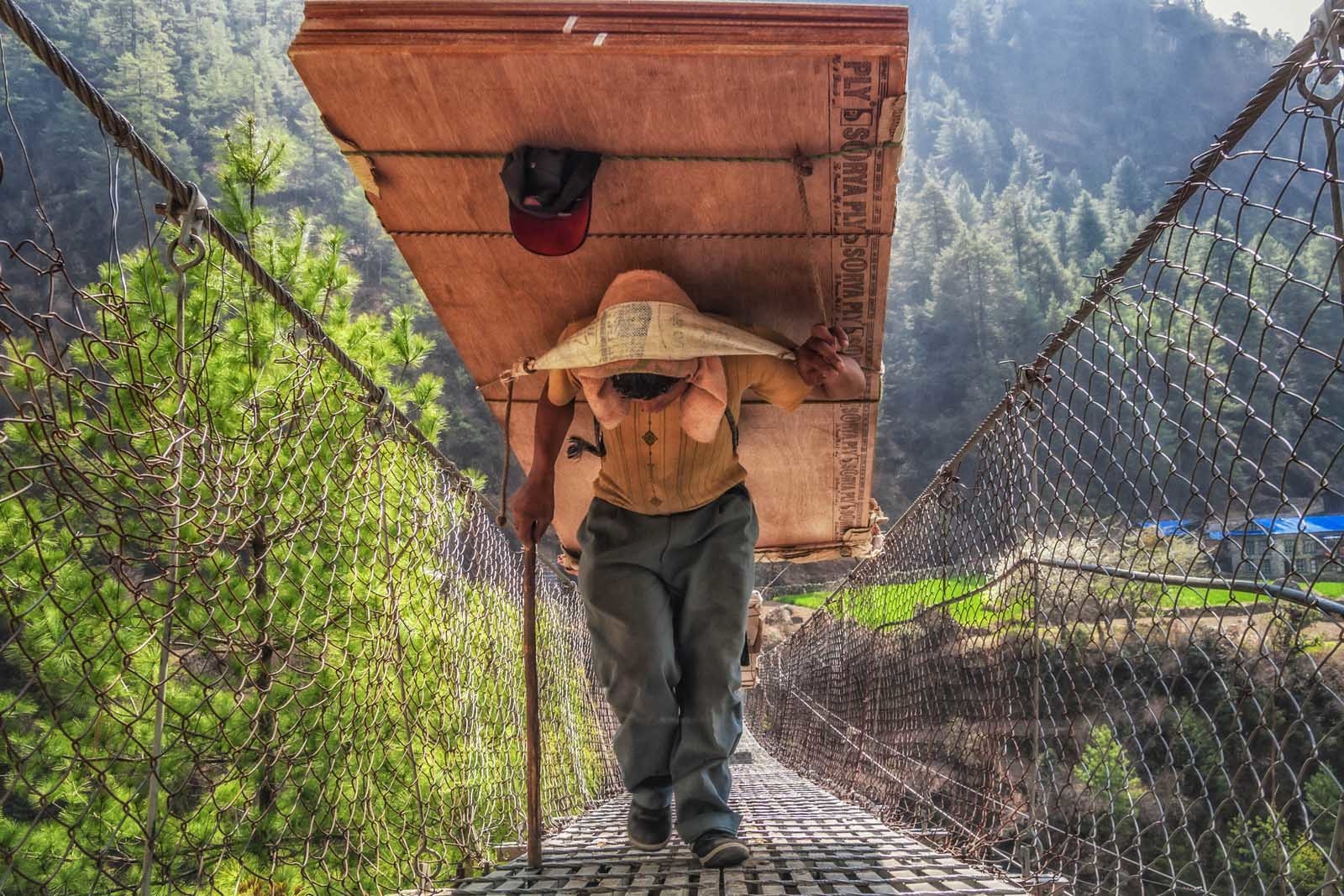
If you have a fear of heights, crossing suspension bridges may not be your favorite moment, but the suspension bridges while trekking to Everest Base Camp are well constructed, made of steel, and in excellent condition.
I was nervous about the suspension bridges. The Lonely Planet Guide said, “ Grit your teeth and climb onto a drooping suspension bridge floating at a dizzying height .” That sentence freaked me out.
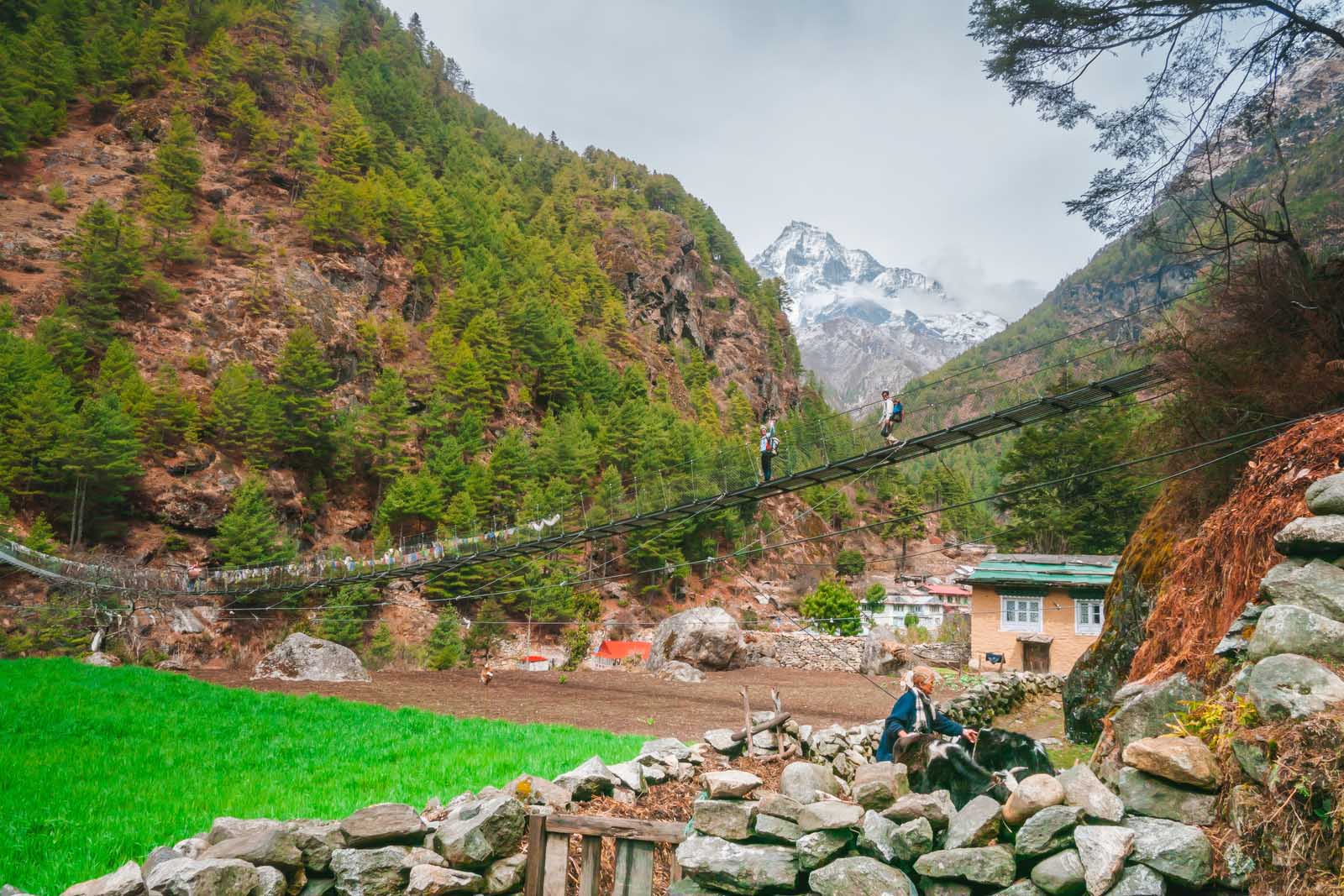
I had built the suspension bridges of the EBC trek in my head as something monstrous. But by the time we reached the first bridge, I wondered what all the fuss was about. Once I crossed my first bridge, my confidence was up and I was ready for anything the Everest trek was ready to throw at me.
Donkey Trains
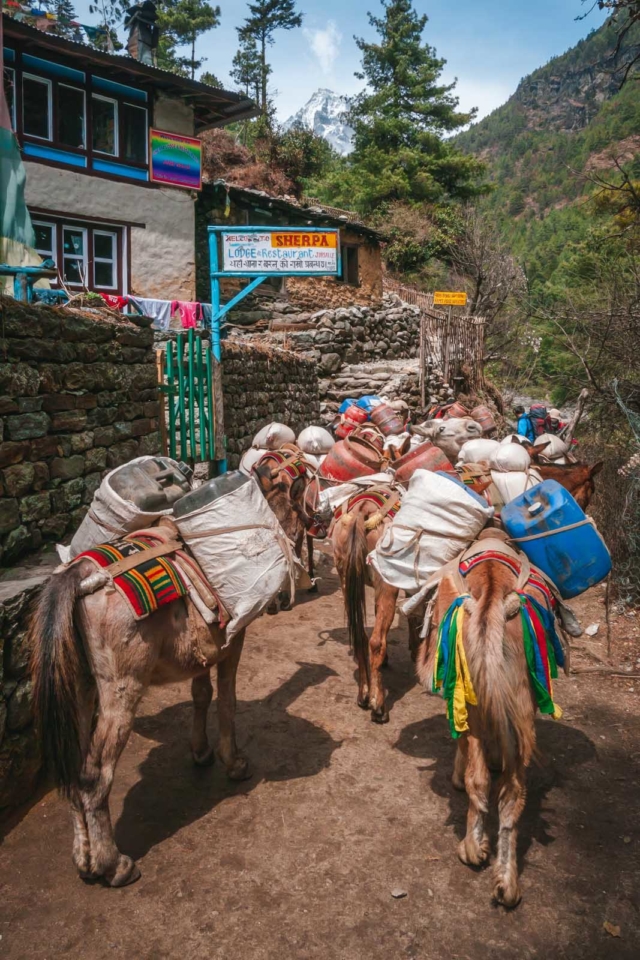
Today we also started to see a lot of donkeys, cows, and goats taking supplies to the villages. Traffic can get very heavy on the Everest Base Camp hike. When animal trains go by, make sure to get out of their way and stay to the side.
They are loaded down with heavy gear and they have a mission to keep on walking until they are done. They can easily nudge you right off the side of a cliff as no matter what is in their way, they just keep walking.
The trail is a highway, but instead of transport trucks or trains carrying cargo, people and farm animals carry everything from lumber and building supplies to food and kitchen appliances.
Safety Tips on the Everest Base Camp Trek for yaks and donkeys
- Important Tip: When a yak, donkey, or cow train passes you during the EBC trek, be sure to stand on the mountainside of the trail so they can’t push you over the edge !
- It is better to be squished into a mountainside than to go tumbling over the edge!
Final Stretch to Namche Bazaar
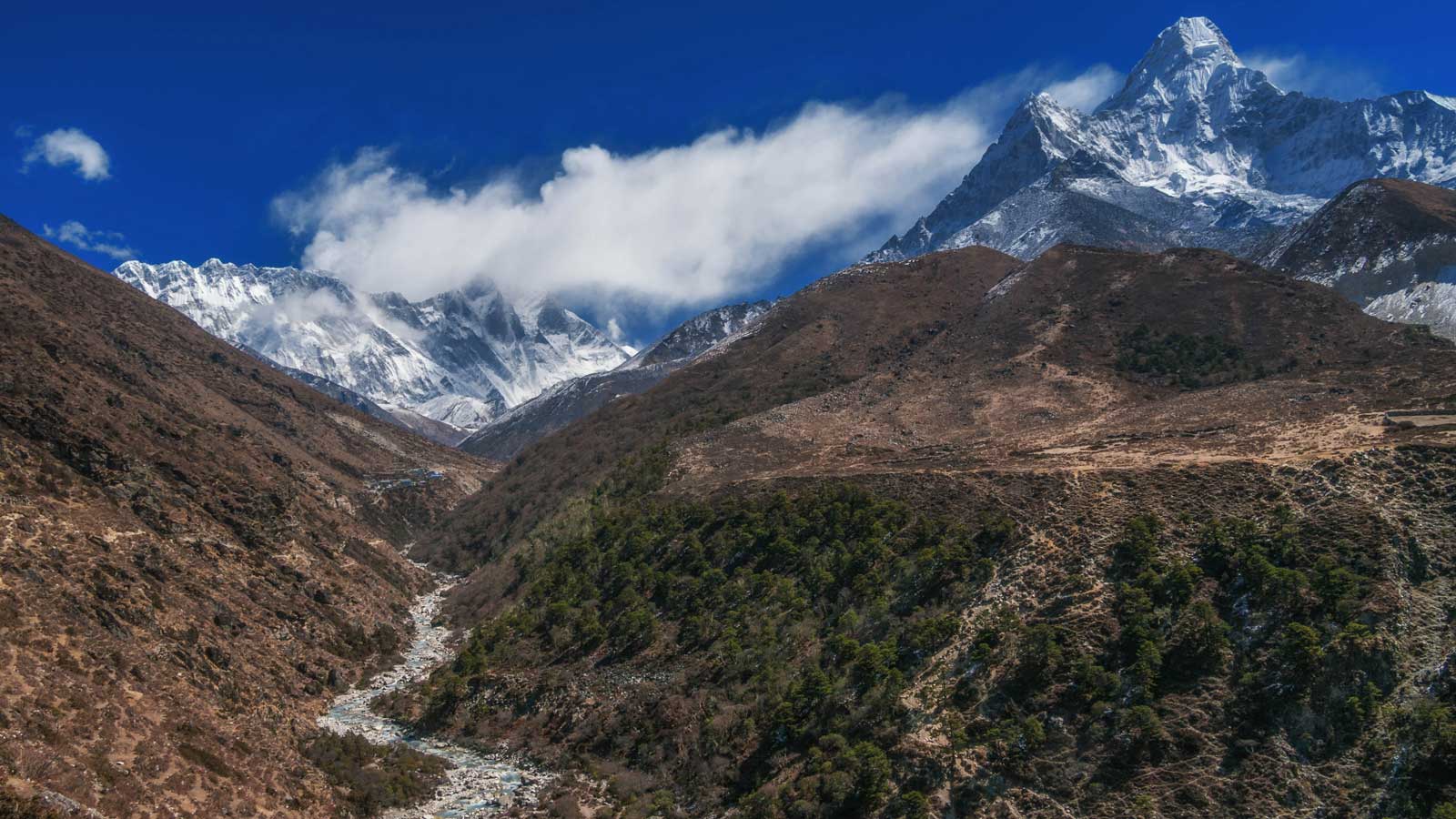
Right after crossing the last bridge, the hardest part of day two of trekking to Everest base camp started The last push of the day consisted of 2-hours straight uphill to Namche Bazar.
We were drenched with sweat but the air was cool. Whenever we stopped for a break, we would get a chill so we just kept on chugging away.
Large tour groups passed us quickly, only to be caught a few minutes later as they rested. We realize that we were the tortoise and they were the hare! Slow and steady is the way to climb at high altitudes and in the end, we made it to Namche Bazaar with plenty of time to spare in the day.
Arrival to Namche Bazaar
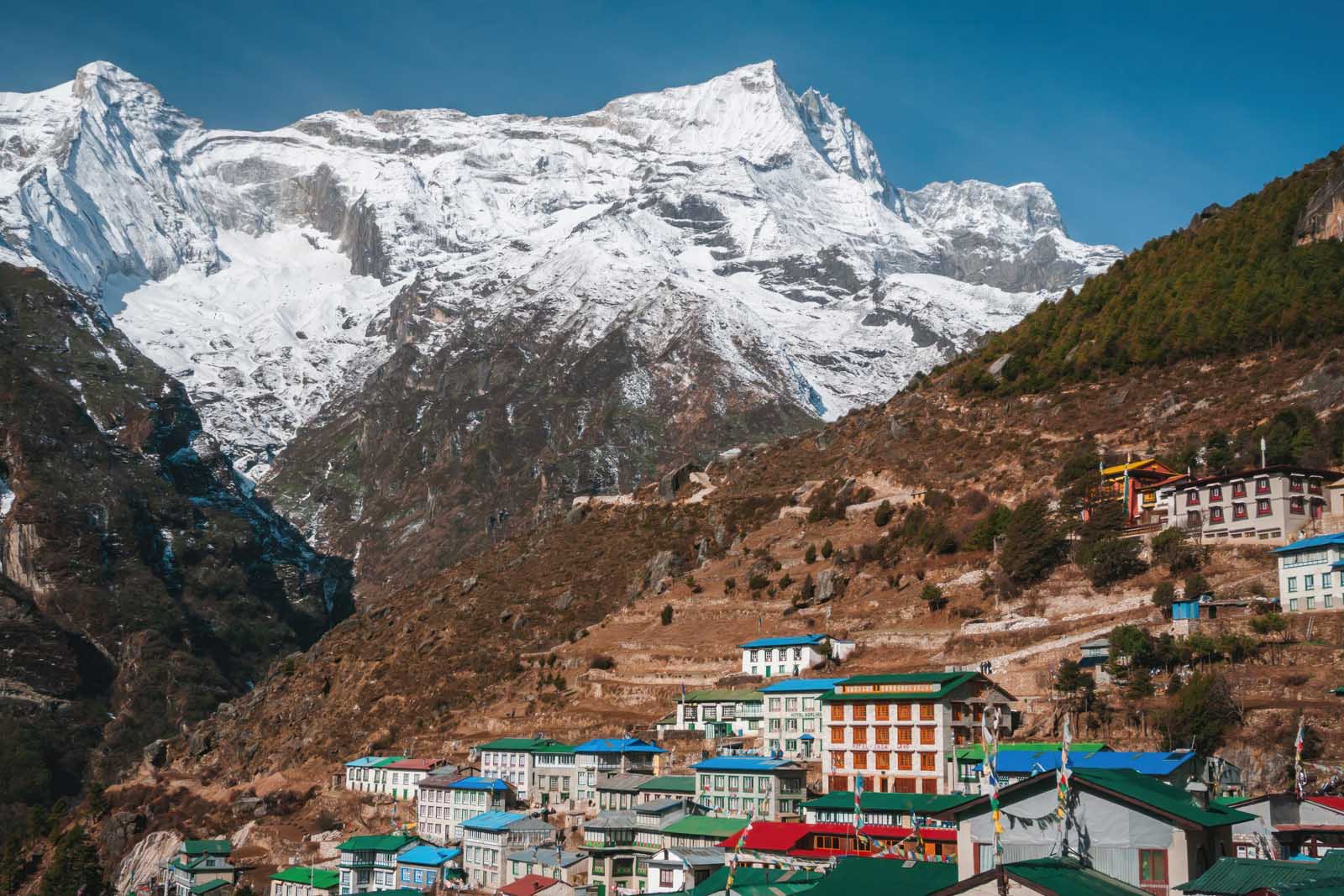
We checked into the security post and cringed when we found out that our lodge was an uphill walk for another 20 minutes. Rest had to wait a bit longer.
When we arrived at our accommodation, we were thrilled to see our porter Sher’s smiling face. He had already checked us in and put our bag in our room. We immediately went for a nap and then did a little walking around town in the evening to do some shopping and grab a bite to eat before turning in for an early night.
There are plenty of shops and restaurants at Namche Bazaar, this town is bustling and we spent two nights of our EBC Trek here which was awesome.
Pakding – Elevation 2610 meters ( 8563 Feet) Namche Bazaar – 3440 meters (11,286 feet) Elevation Gain – 830 meters (2723 feet) Distance – 10km (6.2 Miles) Duration – 6 hours
Day 3 – Acclimatization Day at Namche Bazaar
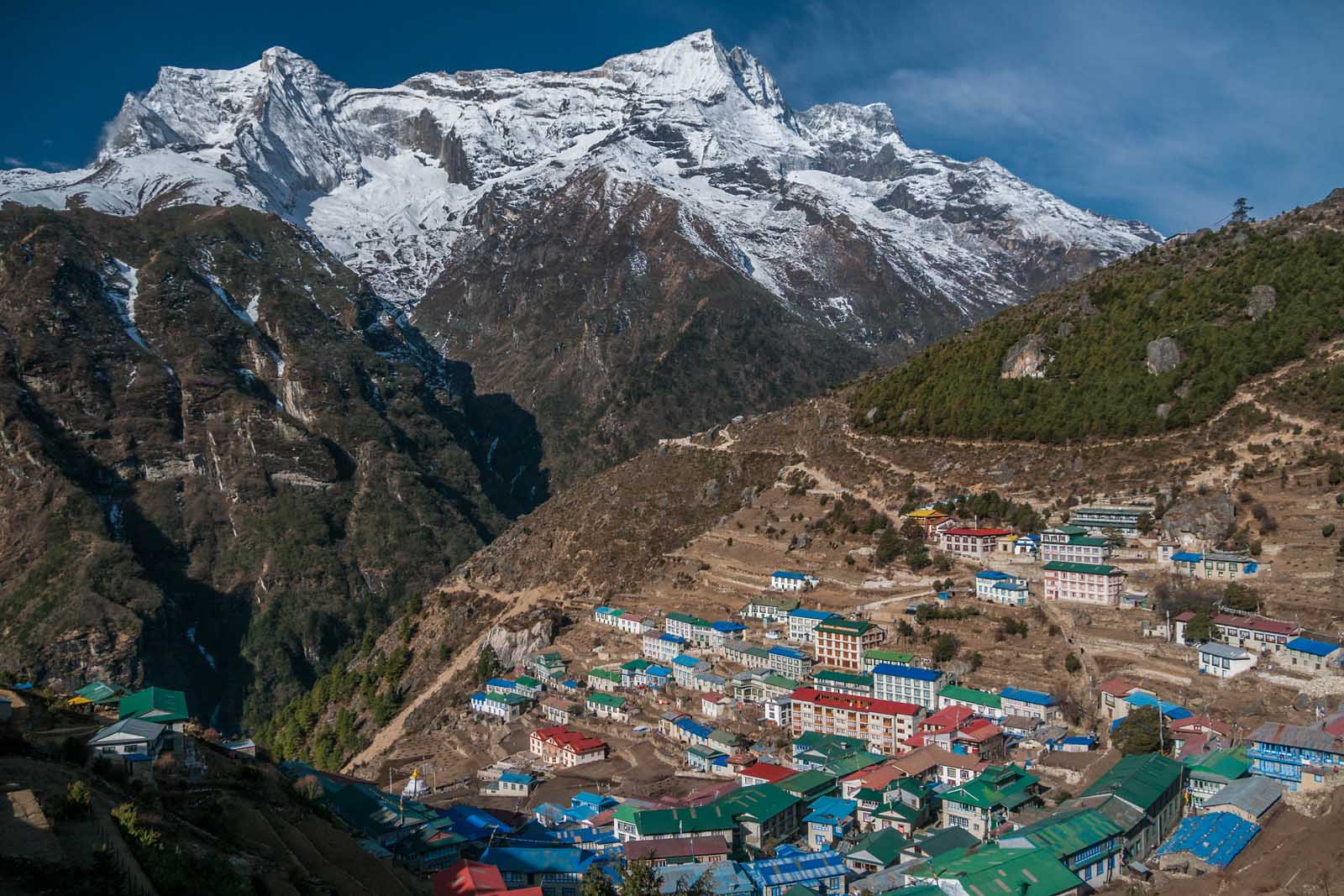
We had two glorious days at Namche Bazaar. Dipendra chose great accommodation for us throughout our EBC trek and we had a good rest in this splendid teahouse where we enjoyed delicious pasta, meats, and of course dhal baht. We spent the morning enjoying coffee and doing a bit of shopping.
What to do in Namche Bazaar
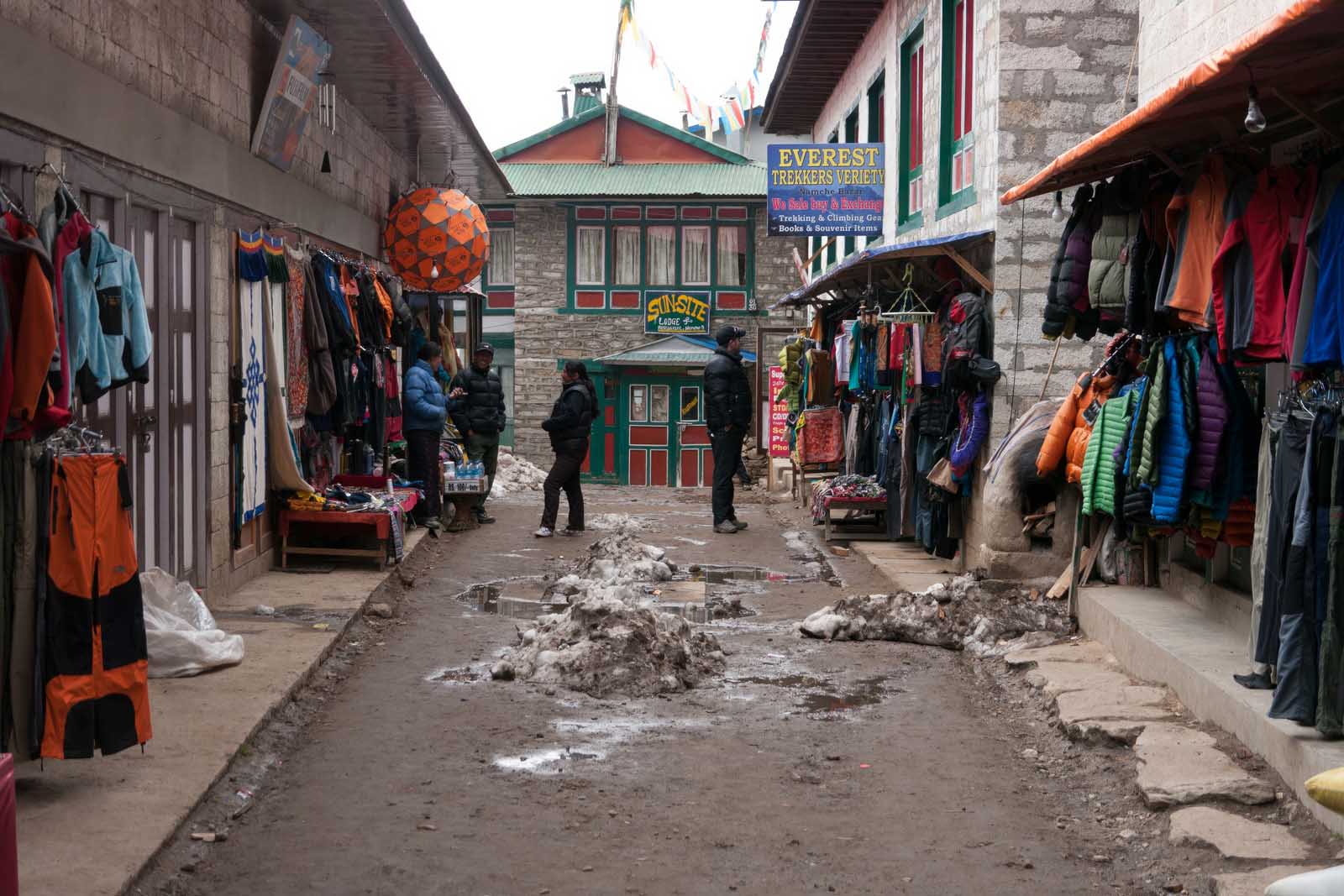
We explored Namche Bazaar and checked out its many shops. The streets are packed with shopping stalls and markets. We searched for gear that we missed getting in Kathmandu and got some great deals. We were surprised the prices weren’t inflated at Namche Bazaar.
We bought some down booties to keep our feet warm at night, a couple of sherpa hats, and a warmer set of gloves. The Everest Bakery was a highlight with delicious apple pie, fresh coffee, and WiFi. We had two pieces each!
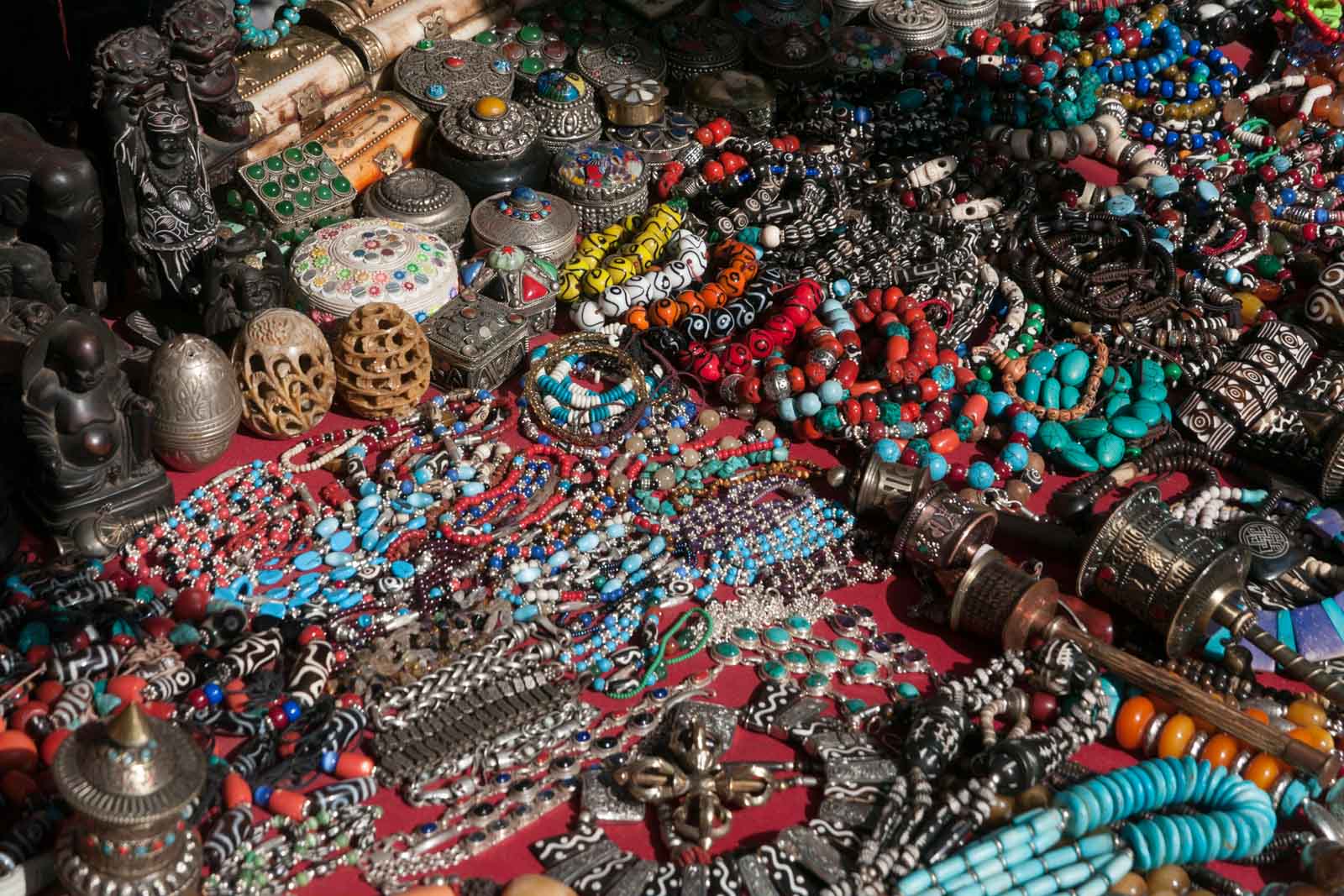
But we took it very easy, making sure to stay hydrated and to eat enough food to stave off altitude sickness. Namche Bazaar is located at a high altitude of 3440 meters (11,286 feet). We already saw a woman suffering from altitude sickness. She was having her blood pressure taken and heart rate monitored and when she got up, she was staggering as she leaned on her guide.
Her Everest base camp trek had already come to an abrupt end. It reminded us to relax because the days ahead were going to be tough. So we went back to our teahouse to relax and prepare for the rest of our journey
The Acclimatization Hike for EBC Trek
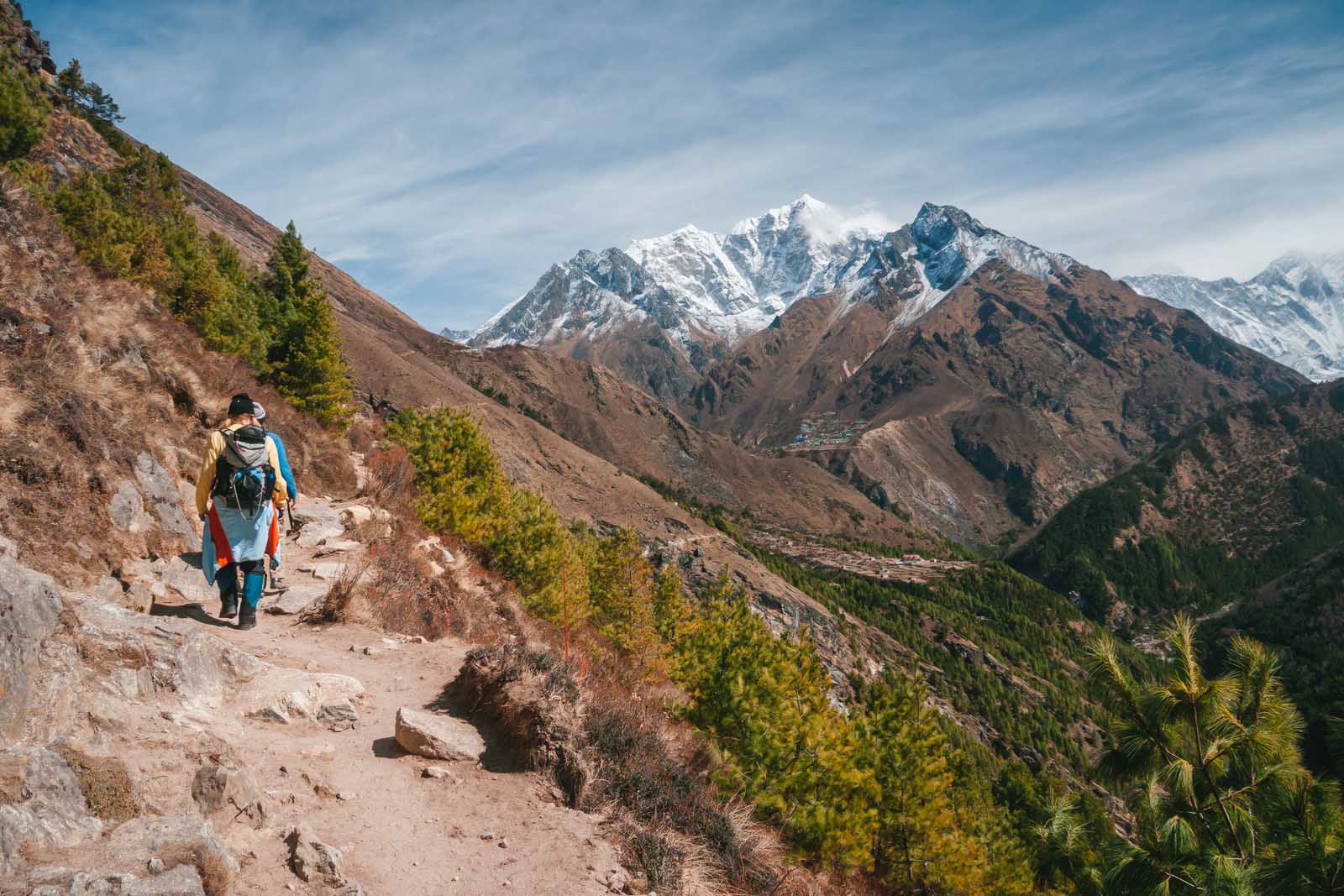
Most high-altitude treks have at least one acclimation day . The Everest Base Camp trek is no exception. An acclimatization day consists of hiking to a higher altitude and then coming back down to sleep at a lower elevation. It gives your body a chance to adjust to the altitude but you don’t stay for long.
As you will be constantly gaining altitude on the Everest Trek, it is good to have at least one day to climb higher and sleep lower to help prevent altitude sickness.
Our acclimation hike took us to the Everest View Hotel. With an elevation gain of only 400 meters, it wasn’t too much higher than our hotel in Namche Bazaar, but it is enough to help acclimate to the high altitudes. Everest View Hotel offers amazing views of Mount Everest (hence the name). Plus it holds the Guinness book of world records as the highest hotel in the world.
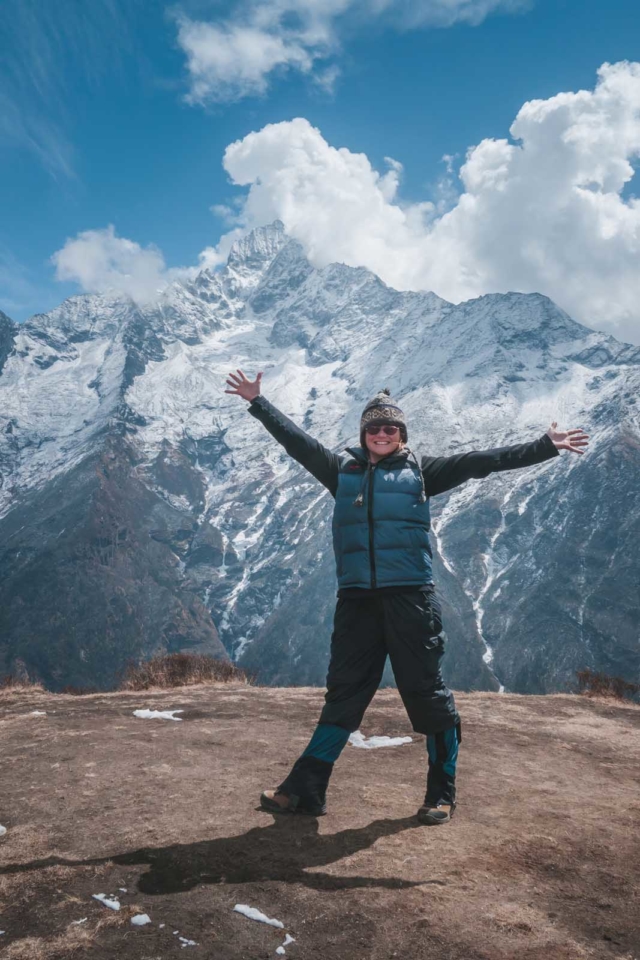
It is not an easy day off though. Just walking through town takes your breath away. As we made our way up the steps, I wondered if I should have just stayed in bed and skipped the viewpoint to relax. When we started the climb I was breathing heavily just walking up a few flights of steps. We hadn’t even left Namche Bazaar and I was pooped!
Once we got on the trail, things became easier. The steep grade gave way to a sloping trail and I started to feel better. After one and a half hours of climbing, we reached what has to be the world’s highest airstrip at 3700 meters (12,139 feet). We arrive just in time to see a small plane take off.
First Views of Mt. Everest
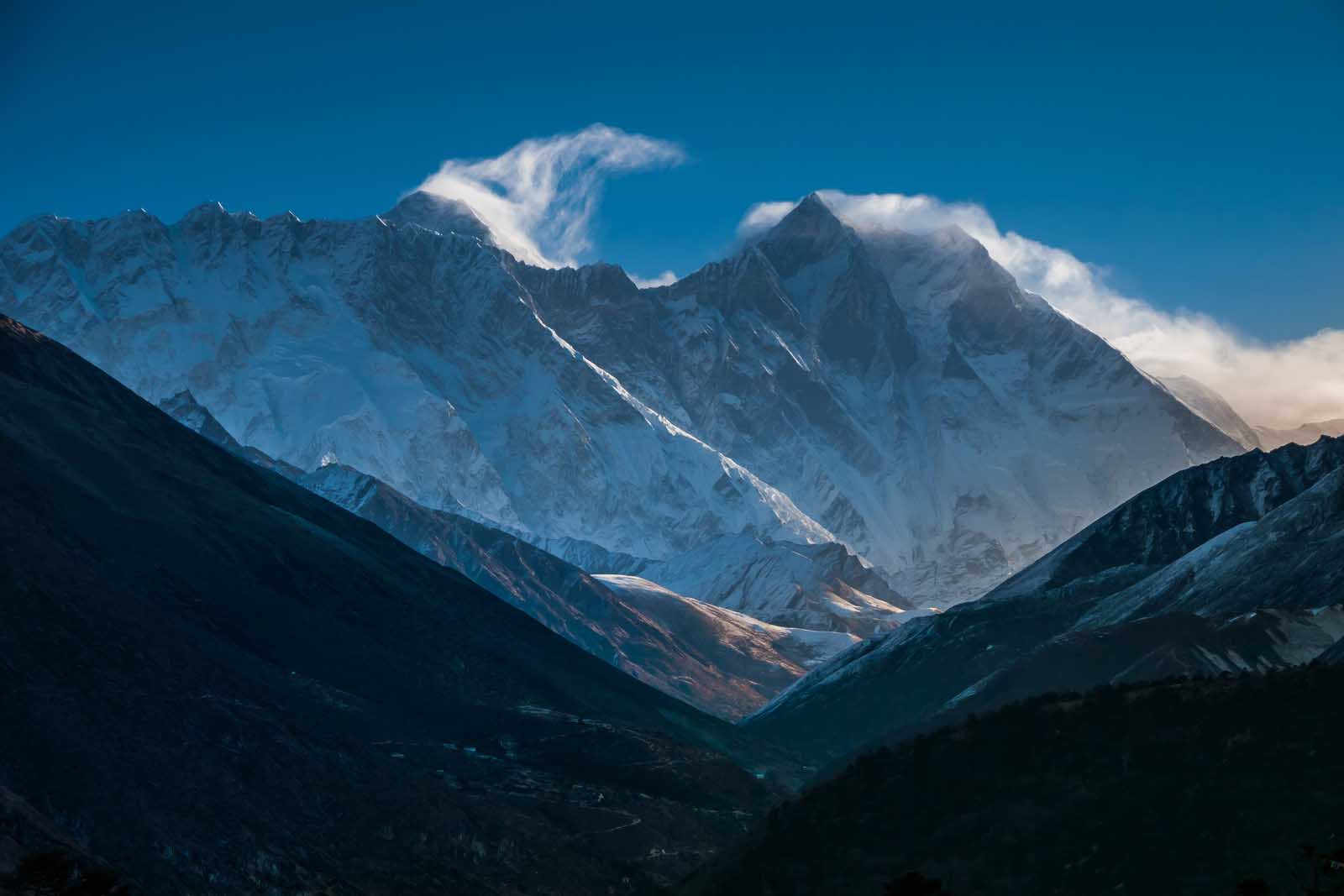
It was here that we got to see our first breathtaking views of Mt. Everest and the surrounding mountains. We hiked a bit farther and there it was, standing quietly behind the other highest peaks of the earth.
Lhotse, Changri, Ama Dablam, and Nuptse surround the mighty Mount Everest, the world’s highest peak. At 8414m (27,604 feet), 6027m (19,773 feet), and 7861m (25,790 feet) they are the little sisters of this sacred mountain. Mount Everest stands at 8848 meters (27,716 feet).
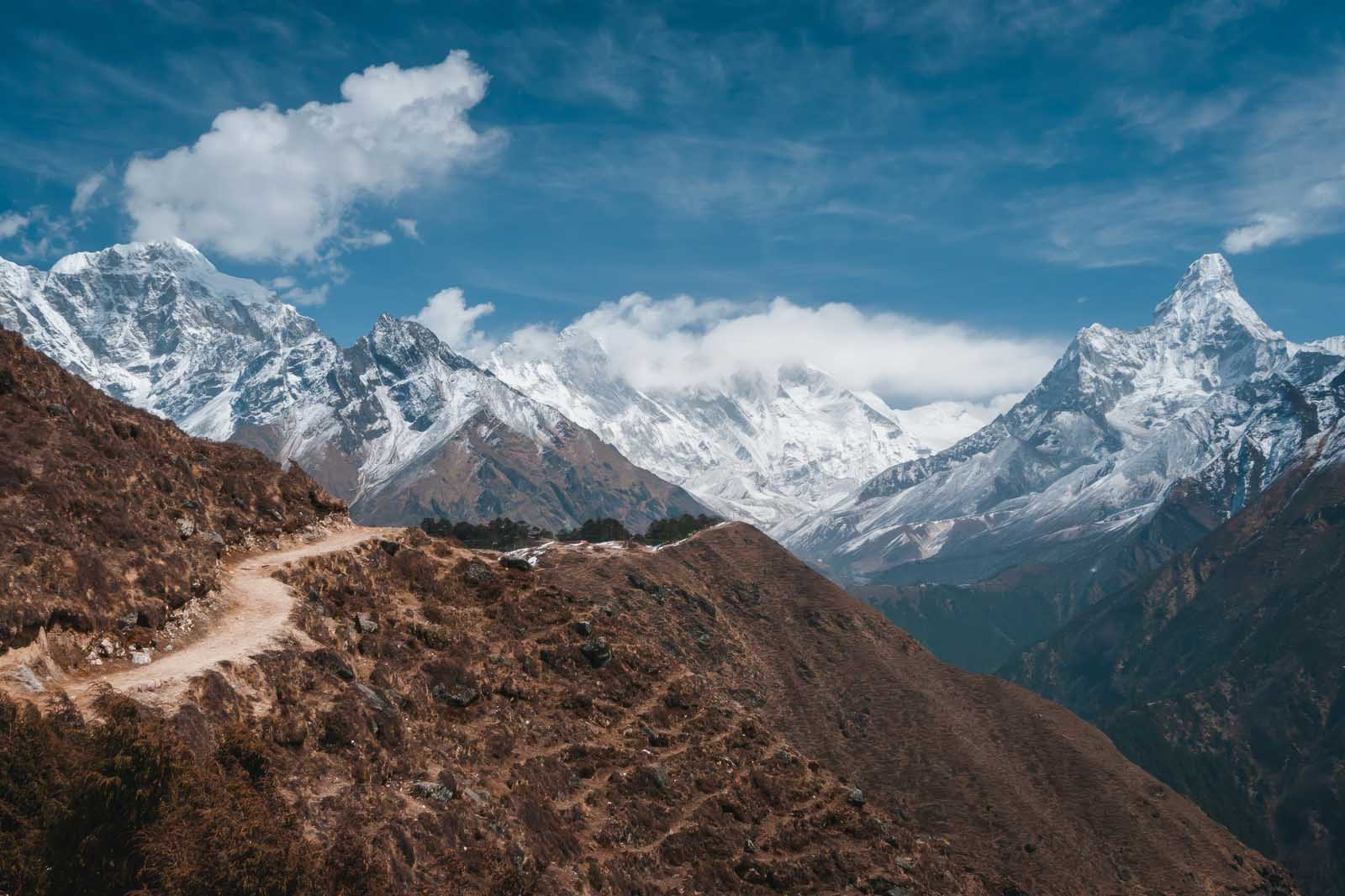
The deep Khumbu valley views were magnificent. The river wove far below, carving through the panorama of the white mountain tops. We walked a narrow trail snaking along the side of a steep mountain and suddenly realize “this trek has become real.” We were high in the Himalayas and one false move could mean catastrophe falling into the abyss below.
The sky was a deep blue and the white summits reached toward the billowing clouds. The view was so awe-inspiring it brought me to tears. Everything was so crisp and clear. During the EBC trek, you feel as if you could reach out and touch heaven.
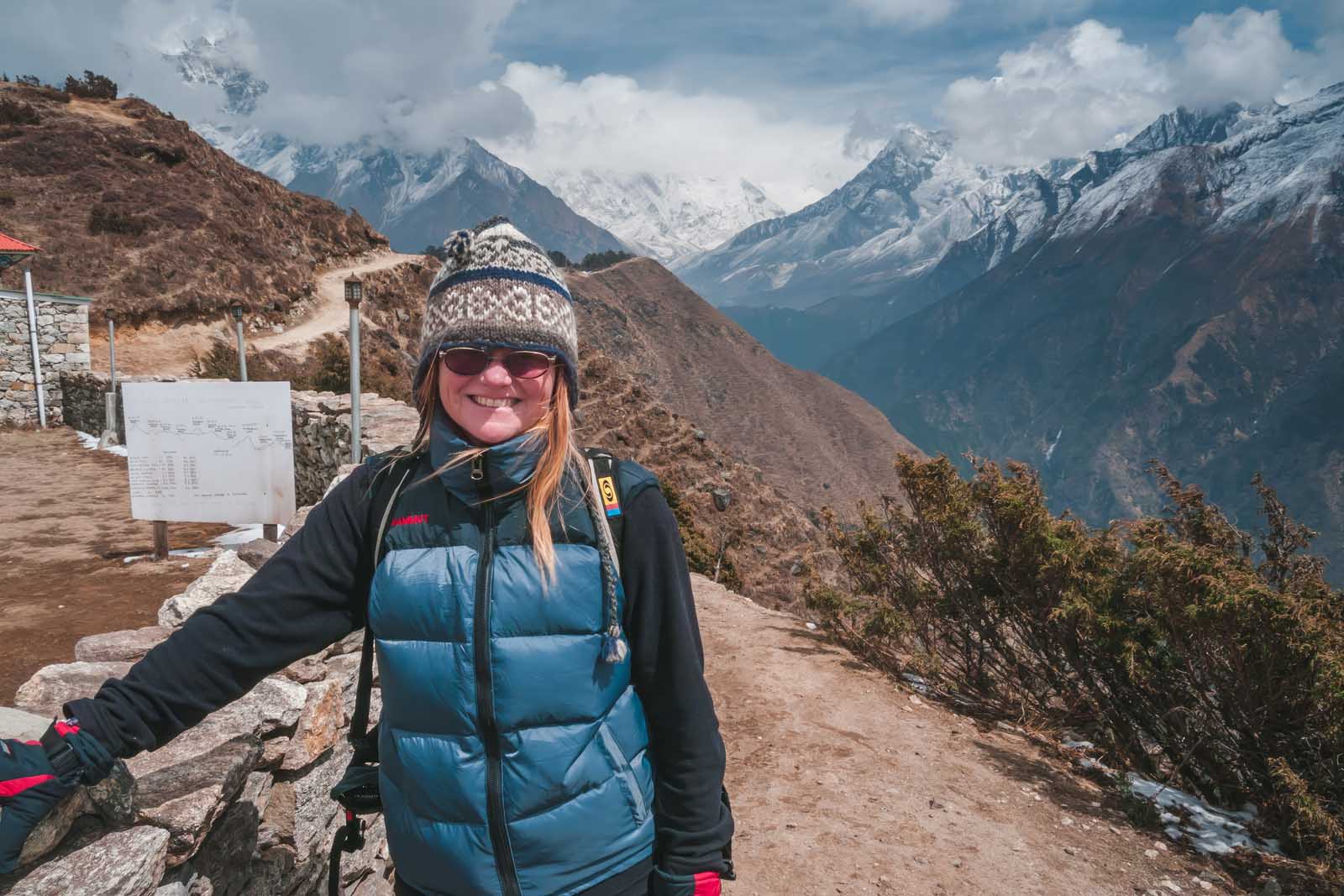
The clouds rolled in quickly so it was time to go. The weather conditions change quickly on the Everest base camp hike, so it is good to have the experience of a guide leading us through all terrain and conditions. We went back to Namche Bazaar to relax and gain strength for the rest of the trek.
Namche Bazaar – Elevation – 3440 meters. (11246 feet) Everest View Hotel – 3880 meters (12,730 ft.) Elevation – Bounce of 440 meters (1443 feet) Duration – 3 hours return Elevation Gain – 0 km
Day 4 – Namche Bazaar to Tengboche
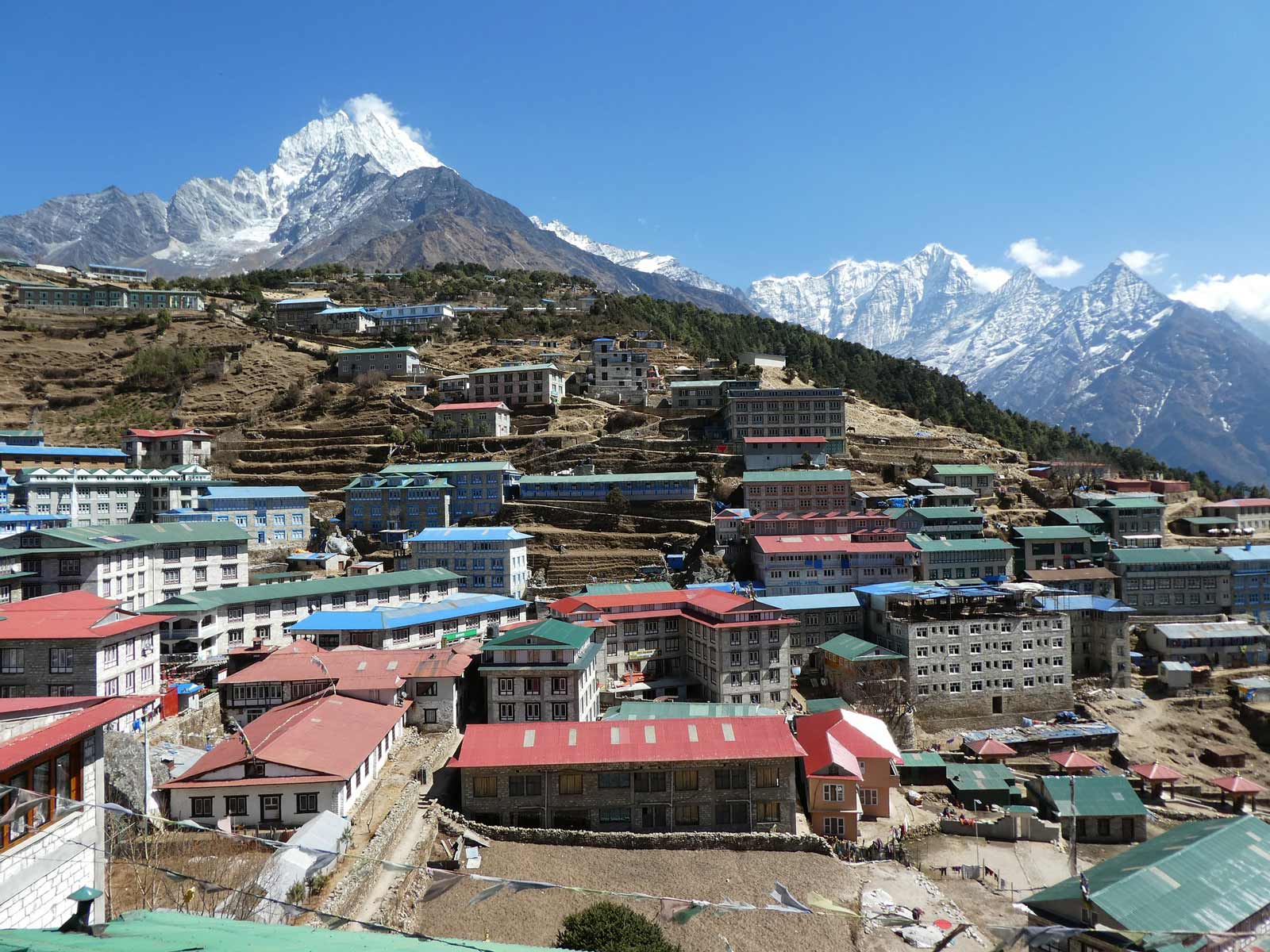
We awoke earlier than usual on Day 4. Two large group treks (Intrepid Travel and G Adventures) had checked into our lodge and we didn’t want to have to compete for service or breakfast. We also didn’t want to have to wait in line for the bathroom.
Lodges become more and more sparse as you go higher on the Everest Base Camp Trek and fewer toilets are shared between more people. Up until now, we hadn’t encountered crowds of people. It had been pretty quiet on the mountain and we liked it that way.
Luckily, we were a day ahead of the other tours. They had to stay in Namche Bazaar for another day to acclimate to the high altitudes, So we moved on to enjoy our EBC Trek free from crowds of people – for now.
Tenzing Norgay Memorial Stupa
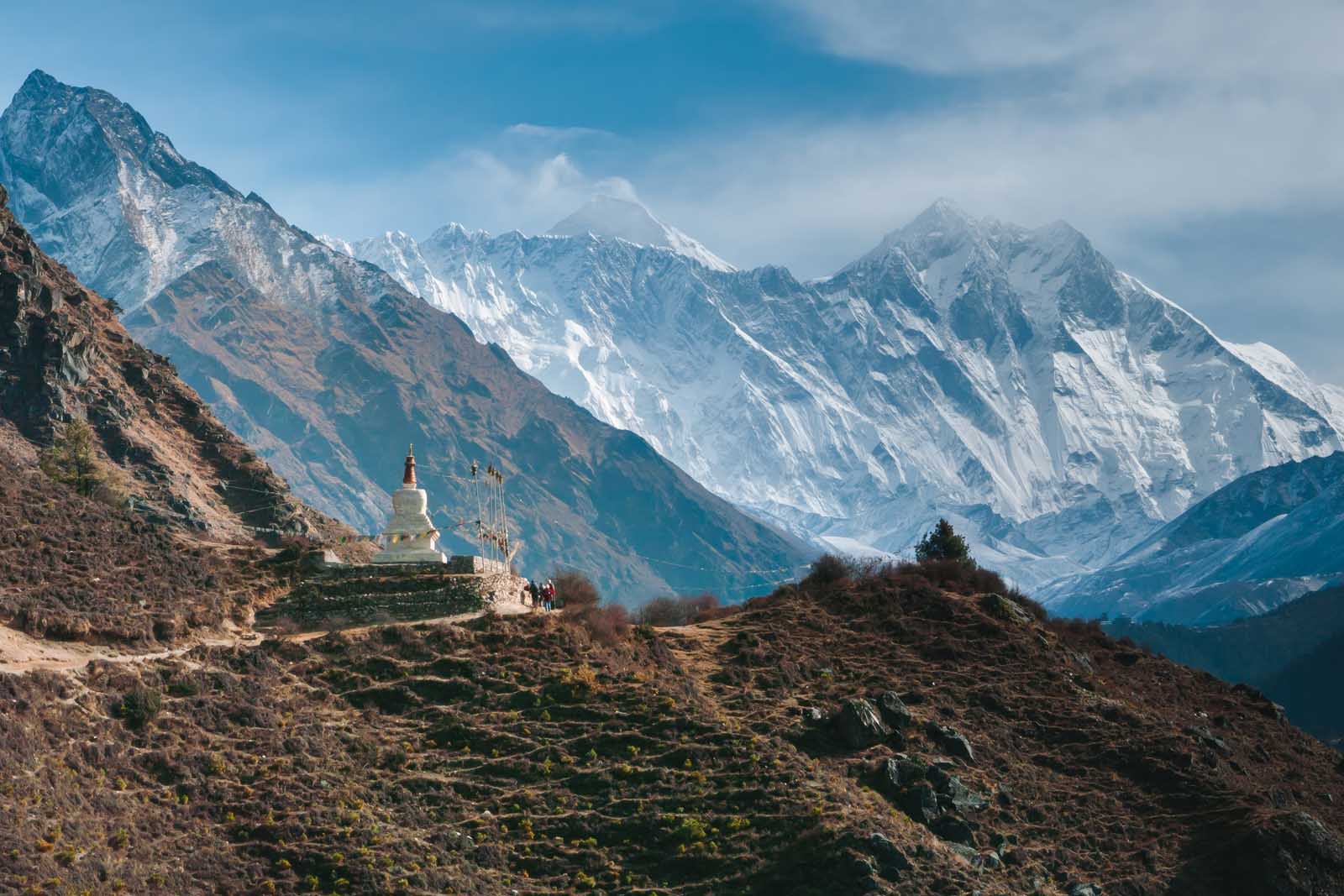
During day 4 of the EBC trek, we hiked along trails clinging to the side of the mountain. The narrow trekking trails along this route were a little scary. They wound along the edge of the cliff with nothing but a sheer drop to the abyss into the Khumbu Valley. But we kept our wits about us putting one foot ahead of the other until we reached the Sherpa Monument.
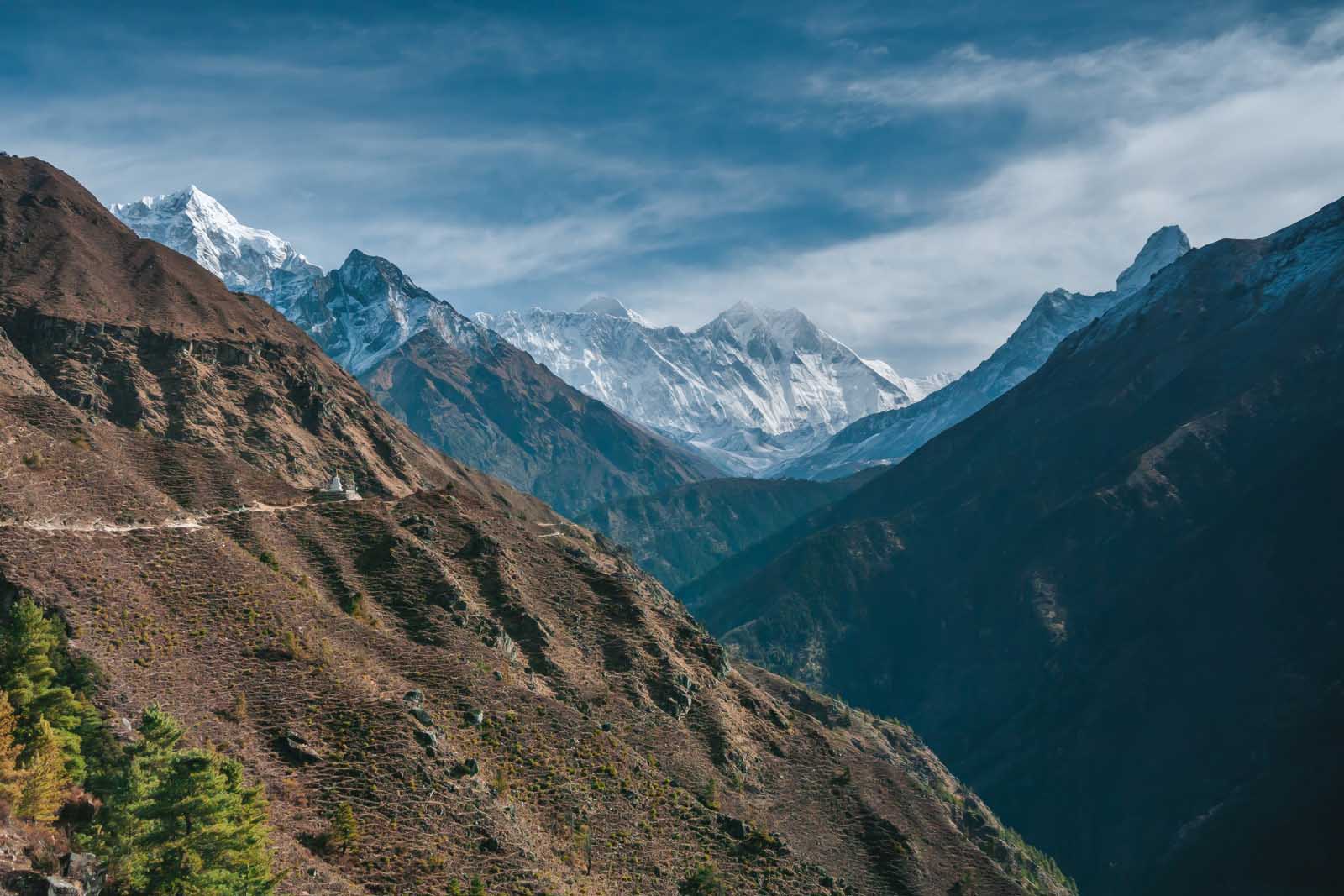
Tenzing Norgay Sherpa monument was erected by the Norgay family. It is a stupa honoring Tenzing Norgay Sherpa and all the Sherpas that risked their lives to help climbers reach the summit of Mt. Everest.
All treks pass this monument and it is an important stop on the journey to pay respect to the famous Sherpa of the Everest region. In case you don’t know, Tenzing Norgay Sherpa was the first man to summit Everest along with Sir Edmund Hillary.
What is a Sherpa?
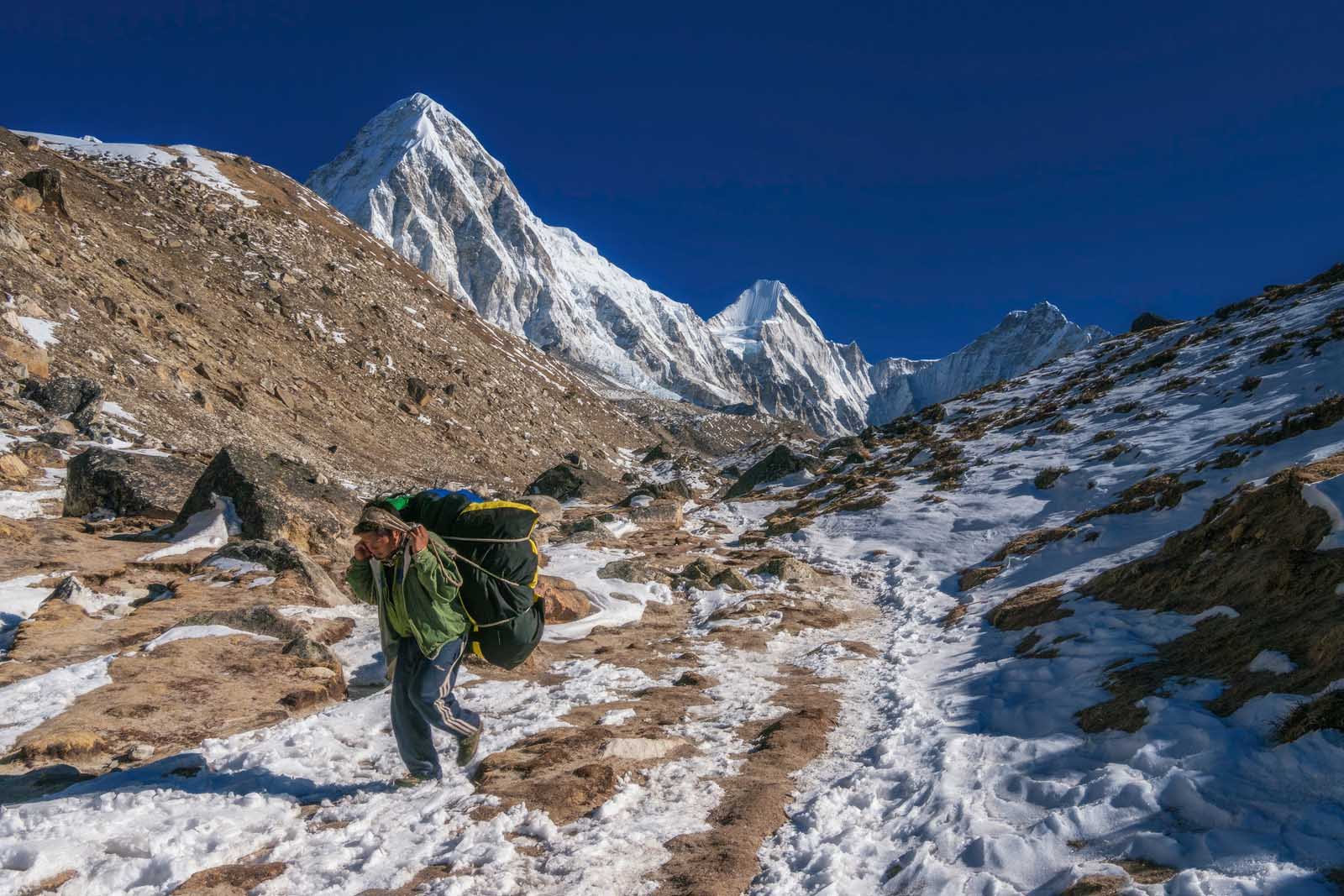
Sherpas are the unsung heroes of Mt. Everest. They do all of the hard work and technical work on the mountain. They carry the heavy loads, set the ladders and ropes to cross the Hillary Step and Khumbu Icefield for mountain climbers, and they take care of setting up camp while climbers and trekkers catch their breath and try to survive life on the world’s highest peak.
Difference Between a Sherpa and a Porter
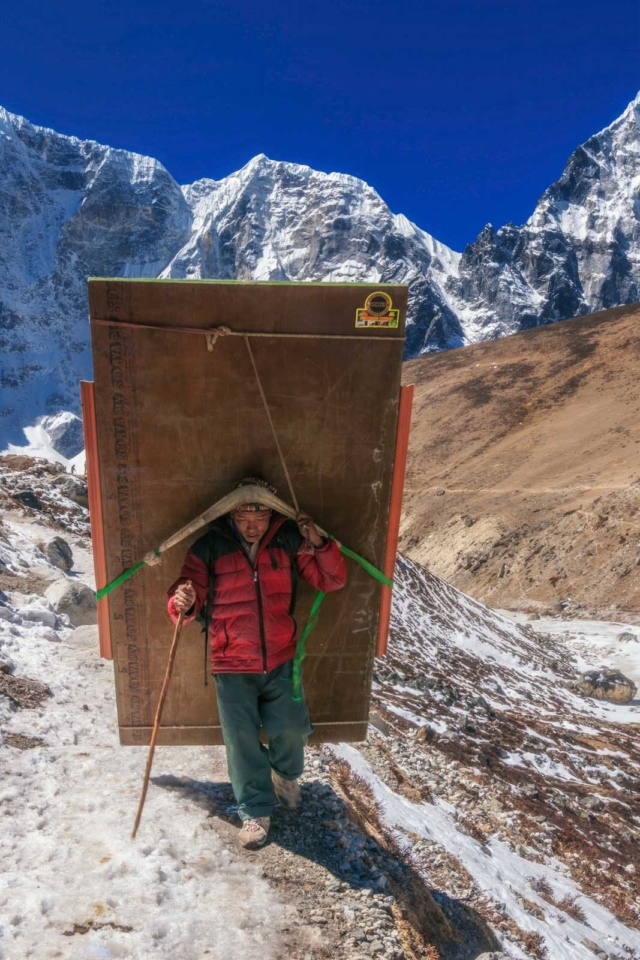
Sherpas and porters are very different from one another. We learned that a Sherpa is actually the name of an ethnic group from Tibet. The original mountaineers hired Sherpas as their guides in the Himalayas and the world has now adopted the name for porters in the Everest region. If you aren’t born into the Sherpa ethnic group, you cannot be called a Sherpa. Porters are porters and Sherpas are Sherpas.
We were told that some porters, especially commercial porters carry up to 60kg (150 pounds) of supplies and gear to businesses located along the EBC trek. That is a lot of weight and we were very surprised. When climbing Mount Kilimanjaro , porters had a mandatory weight limit of 35kg. (77 pounds).
Dipendra told us that they get paid per kilo so some people push it too far. The Nepalese are a strong bunch but this is a lot to carry at such a high altitude no matter what shape you are in.
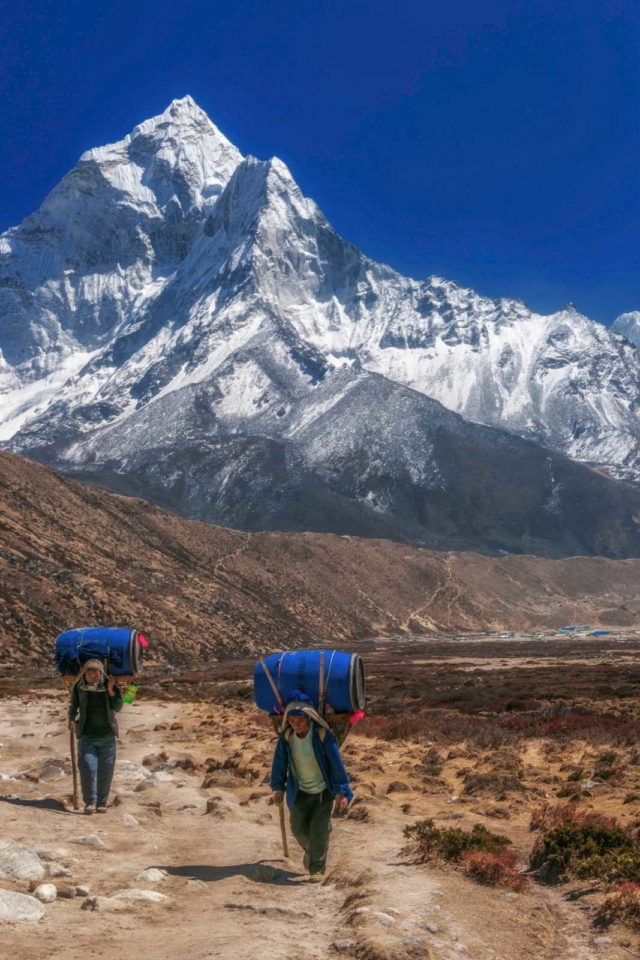
We kept our pack as light as possible at around 22kg (48 pounds) for Sher and we even felt bad about that! We have heard there is a 30kg (66lb) limit for Everest, but judging by what we saw other porters carrying on the Everest Base Camp hike, people were pushing it well beyond that.
We saw men carrying stacks of plywood with heavy white sacks loaded on top. We saw men carrying propane tanks, doors, and huge packs. What could people possibly need on the EBC Trek that they packed their packs so full? Read more: Packing List for Everest Base Camp Trek
Approaching Tengboche
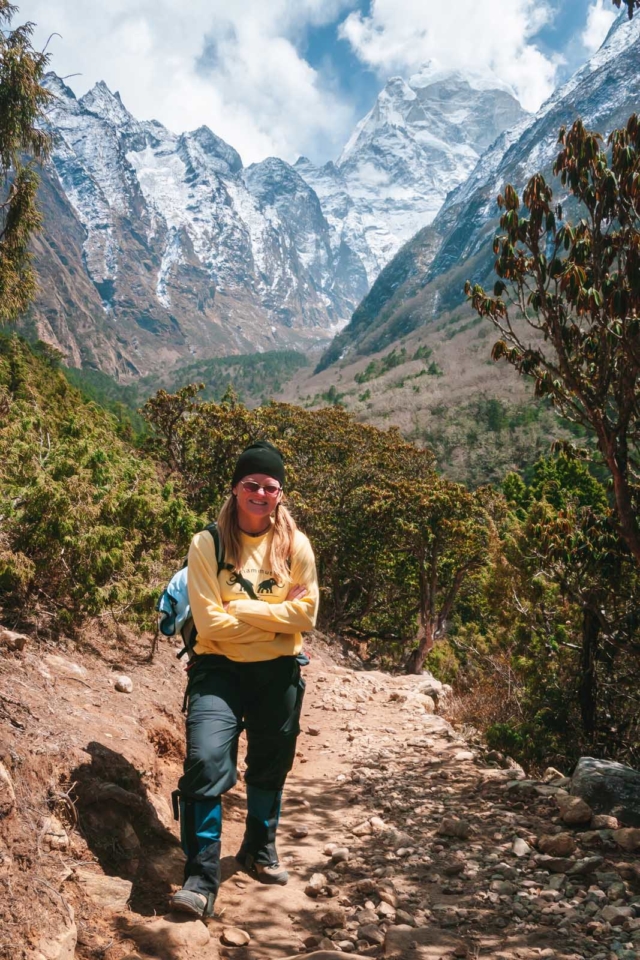
The final push of our EBC Trek day 4 was to Tengboche Monastery. It was a tough yet steady 2-hour steep climb. We are now gaining altitude climbing above the tree line. We put our heads down and huffed and puffed our way up. We didn’t stop for any photos or videos and were surprised to cut the climb down to just one and a half hours.
We reached the prayer wheels of Tengboche Monastery just in time for light snow to start falling. We made it into our camp at Tengboche by 1:30 pm and had the entire afternoon to ourselves at 3900 meters (12795 feet). This is an excellent place on the Everest Base Camp hike to have some extra time to relax as there are a few special things to see and do.
Tengboche Monastery
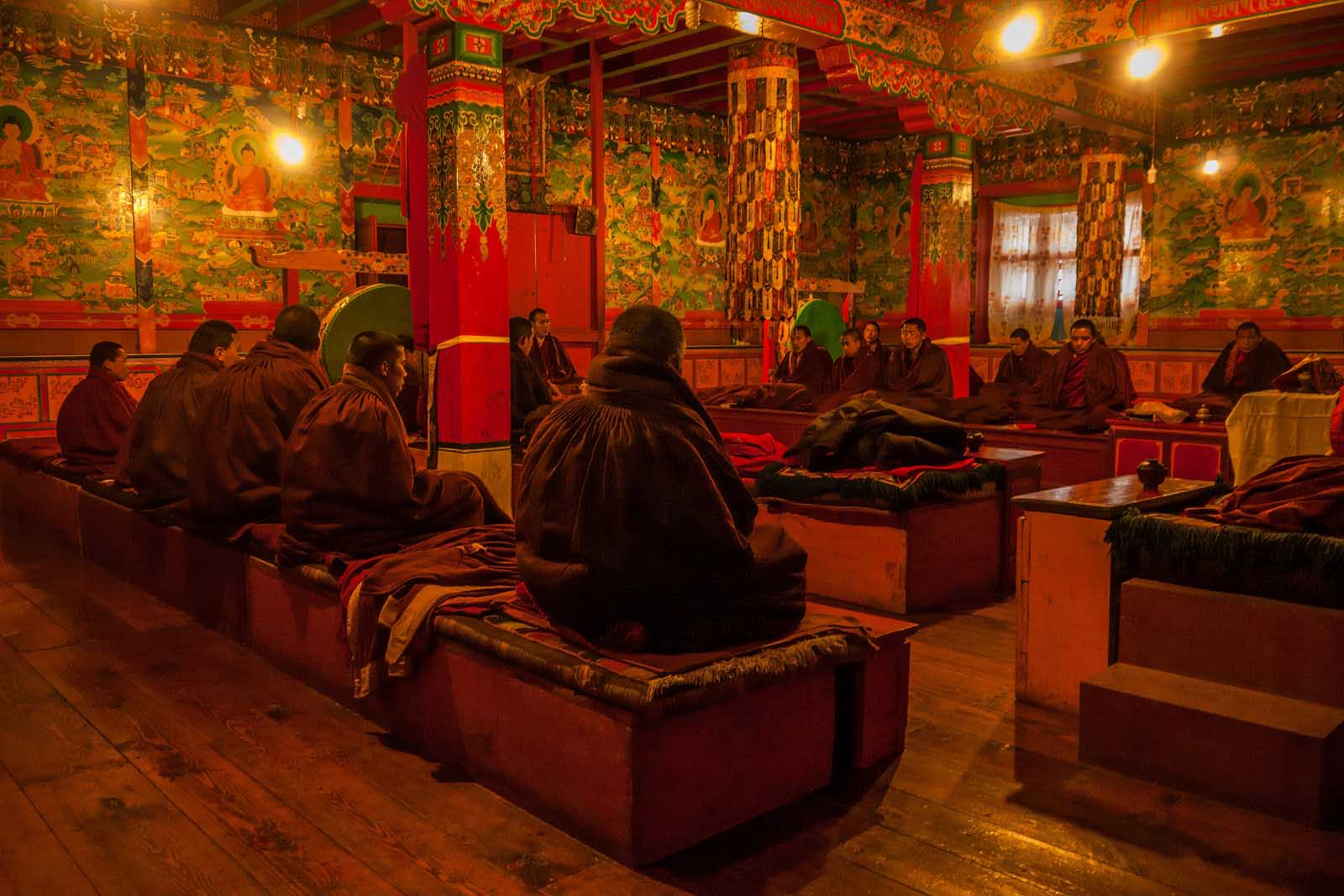
We warmed our feet with our new down booties that we bought at Namche Bazaar and changed into some dryer clothes before heading off to see the monks chant at Tengboche Monastery. Our guide Dipendra told us that this is the most important monastery in the region. All climbers summiting the mountains stop at this monastery to be blessed by the monks.
We were allowed to watch the ceremony and to take in the warmth and blessings from the monks. It is a sacred place and all climbers and trekkers stop here before continuing up the mountains.
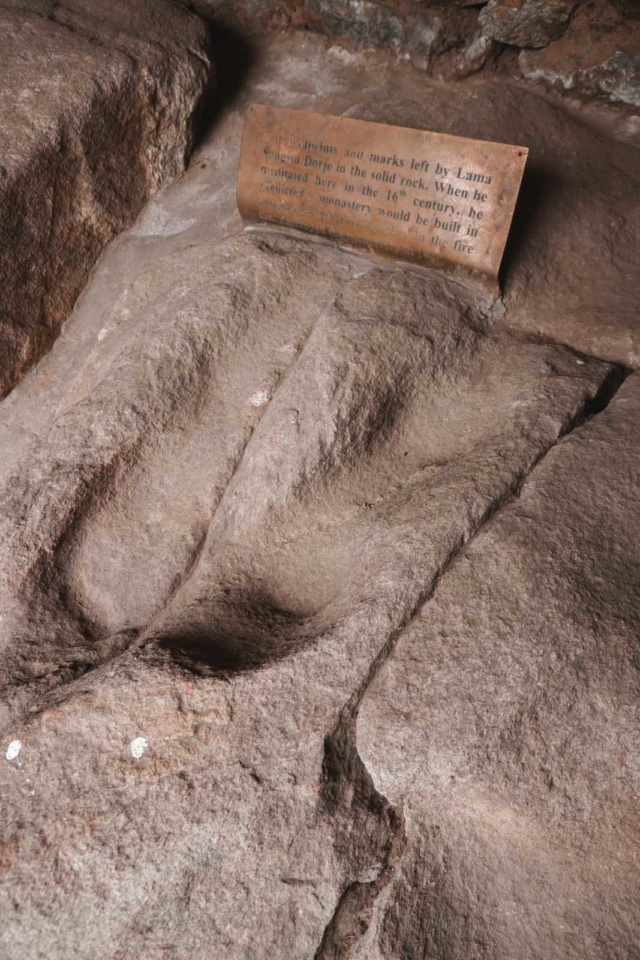
The footprints of Lama Pagna Dorje from the 16th century are embedded in solid stone in front of the monastery. A place where he mediated and raced through the Himalayas riding the wind with his mind.
Apparently, he sat on this stone for so long, his feet left their mark. He spent years traveling the world through the power of his mind and we believe the story. Especially after our yoga experience in Goa India. He predicted that a monastery would be built here and surprise surprise…here it is.
The View from Tengboche Monastery
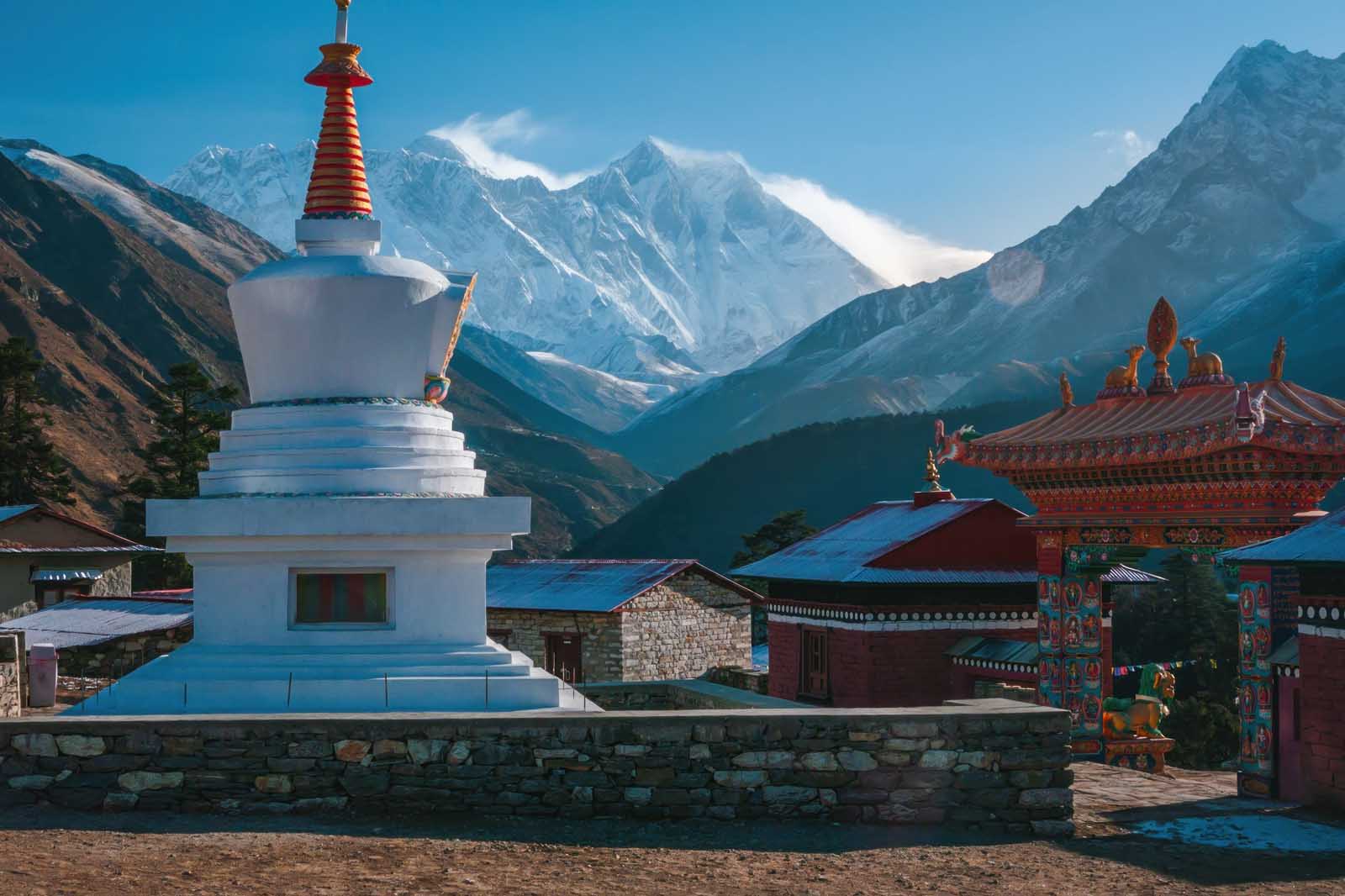
The view is magnificent from Tengboche Monastery. The valley is wide and opens up to massive rolling hills giving way to the highest peaks on earth. Plus it has a clear view of Mt. Everest and the surrounding mountains.
We were told that Sir Edmund Hillary came back to survey the peak of Mount Everest from this spot because the view is so clear of the mountain and we can understand why.
Accommodation – Basic Tea Houses at Higher Altitude
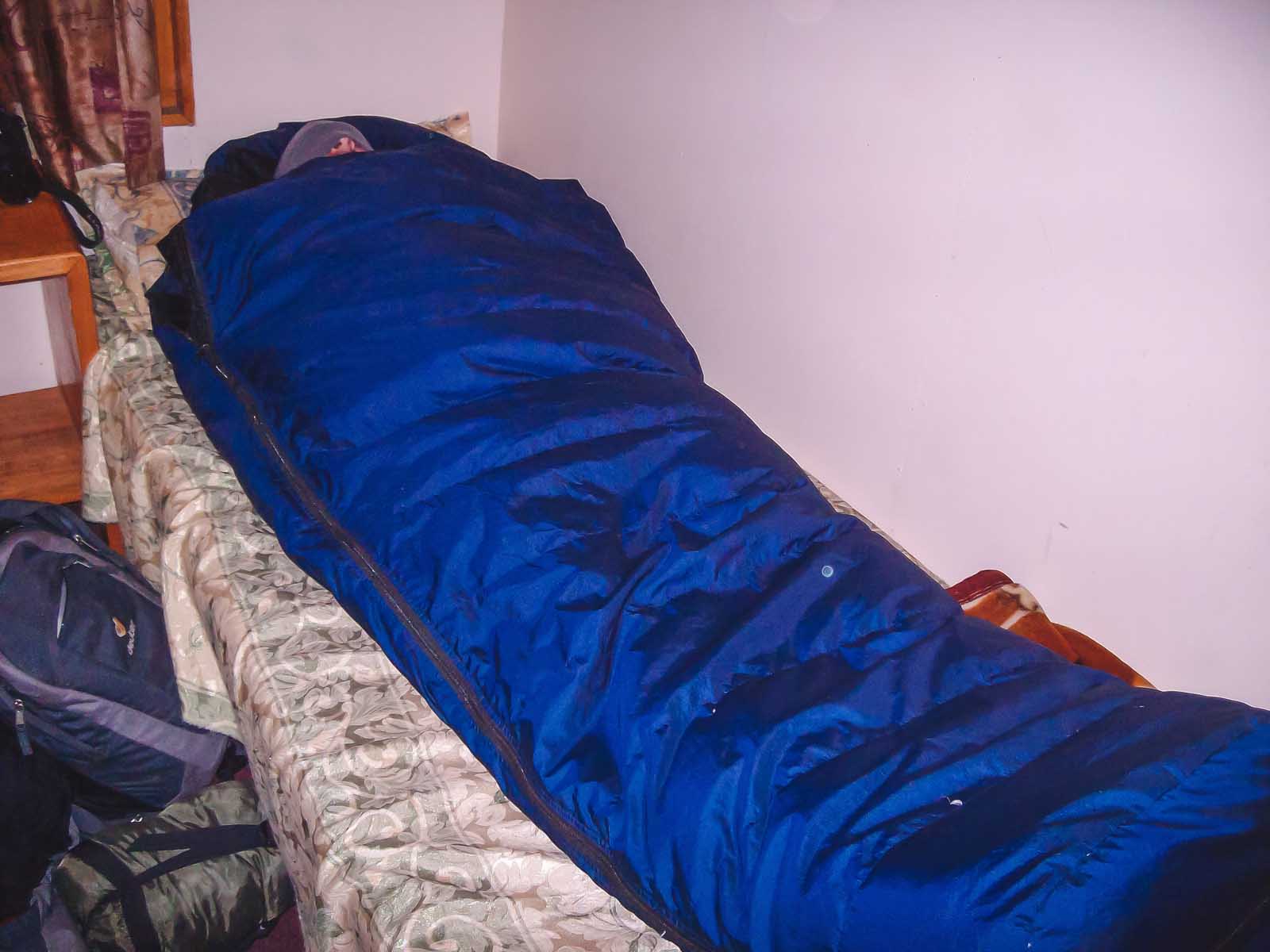
At this high elevation of the EBC trek, accommodation became very basic and rustic. We felt like true adventurers as we sat by the fire warming our feet and bonding with our fellow trekkers over our shared experience by candlelight.
There were 10 of us staying in this teahouse. All are sharing electricity to charge our camera batteries. Meals were now vegetarian and wood stoves were heated by yak dung. At this high altitude, meat cannot be transported fast enough to stay fresh and regular wood is scarce, so yak dung it is.
When we went to bed, our room was freezing. Rooms are not heated at higher elevations. We had our own room, but I sometimes wonder if sleeping in a dorm would have helped with more body heat. The temperature easily dipped down to -10 Celcius (14 degrees Fahrenheit) and our plywood walls didn’t offer a lot of comforts.
We tossed and turned all night long trying to keep our noses warm in our sleeping bags wearing our down jackets, thick socks, and thermal mid-layers.
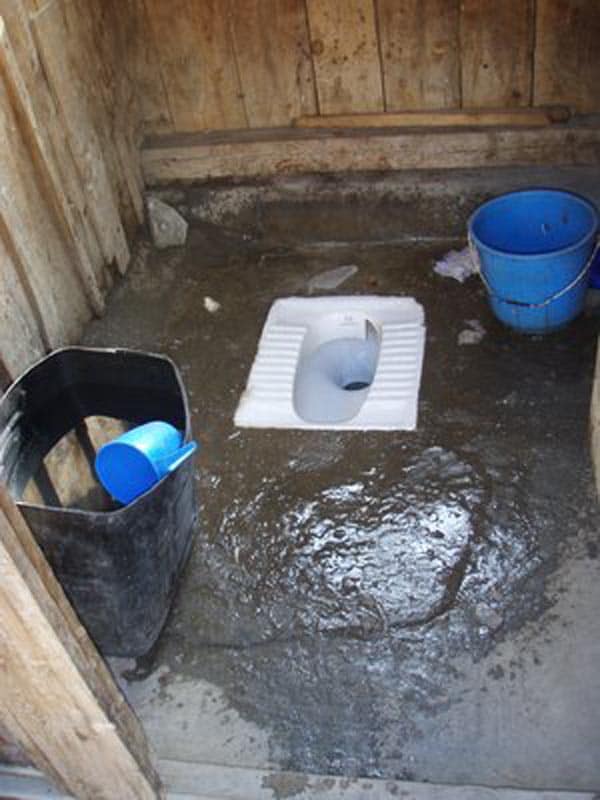
It was so cold the scoop bucket for the shared squat toilet froze over forming a patch of ice to form on the floor. It was a slippery trip to the outhouse. Sadly, we always have to pee a lot during the night when sleeping at high altitudes so we visited that toilet a lot.
Hot Tip: Pay for hots showers at lower elevations You won’t regret it! We realized that we should have paid the 250 Rupees for the hot showers offered at the accommodation in Namche Bazaar. Now that the weather was so cold there was no way we could face a bucket bath in a freezing shed. Dave and I set a new record in these mountains of Nepal, 9 days without a shower!
Namche Bazaar – Elevation – 3440 meters. (11246 feet) above sea level Tengboche – 3860 meters (12664 feet) Elevation Gain – 420 meters (1378 feet) Distance – 9.3 km (5.77 miles) Duration – 3 hours (without stopping) 5 hours for photos, lunch and rest.
Day 5 – Tengboche to Dingboche
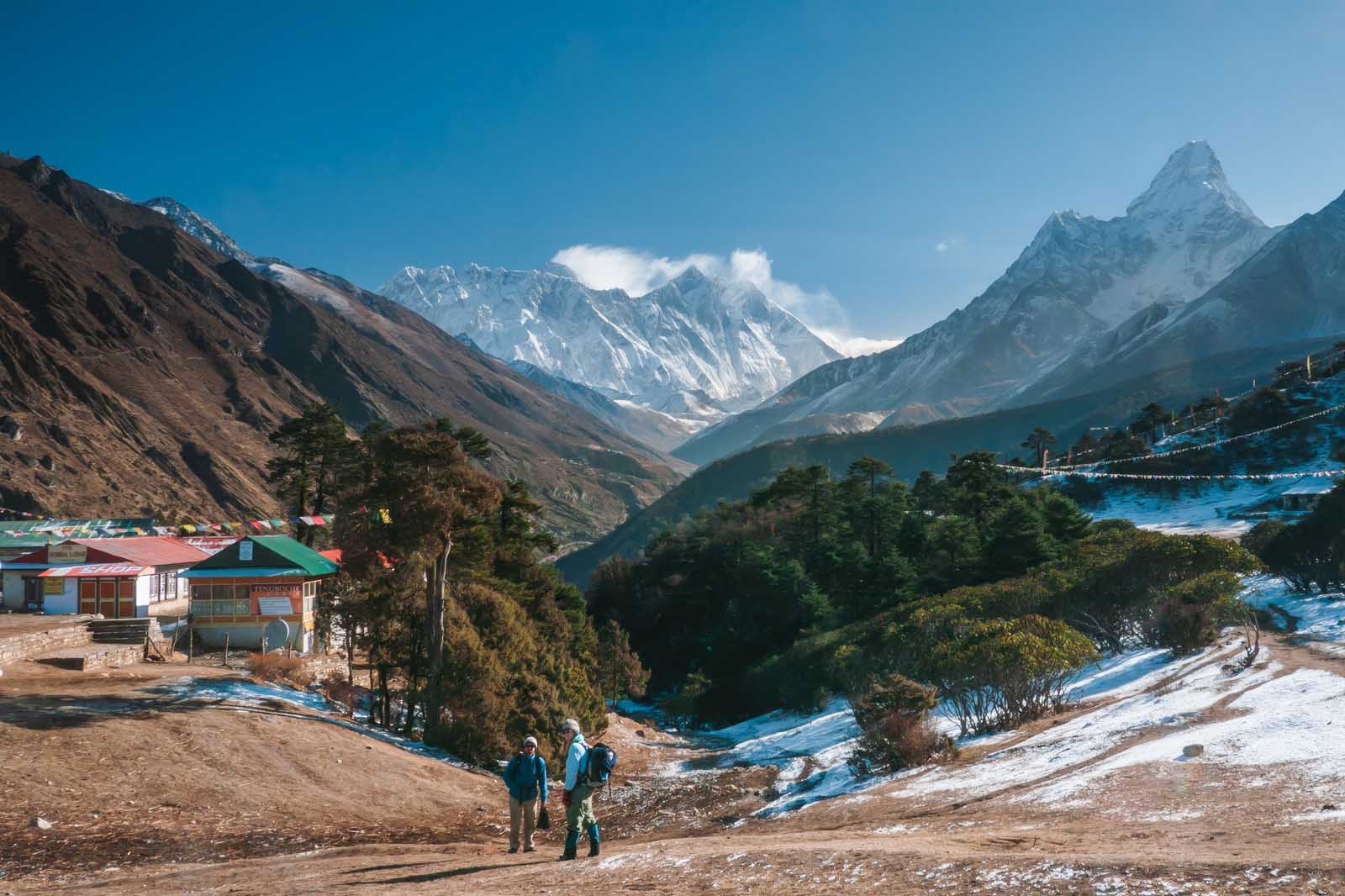
Day 5 of the EBC Trek was freezing! We had an early wake-up call and morning came too quickly on the Tengboche leg of the EBC Trek. But, we awoke to a winter wonderland of fresh snow at the Tengboche Monastery and clear views of Lhotse peak.
The snow from the night before made for more incredible views on the hiking trails. As we started out from the lodge, the sky was crisp and clear, showing Mount Everest in all its glory. It was stunning, and in between gasping for air, we admired the view.
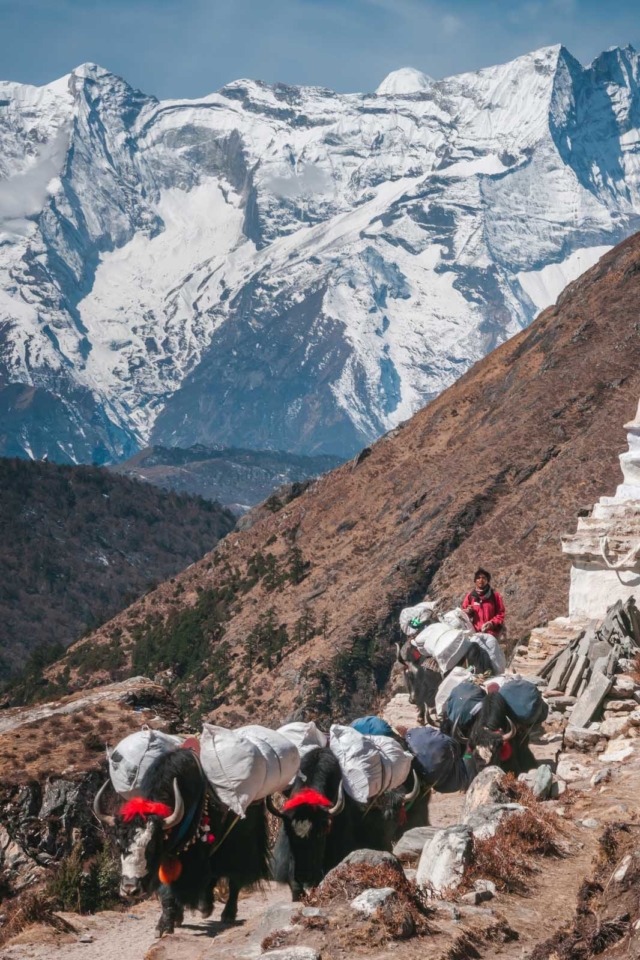
Today we walked to higher altitudes and saw our first trains of wooly yaks. Yaks cannot survive at low altitudes because it is too warm for them, so you don’t see yaks on the Everest Base Camp hike until at least 3000 meters. (9800 feet) They are beautiful.
Yaks on the Trek to Everest Base Camp
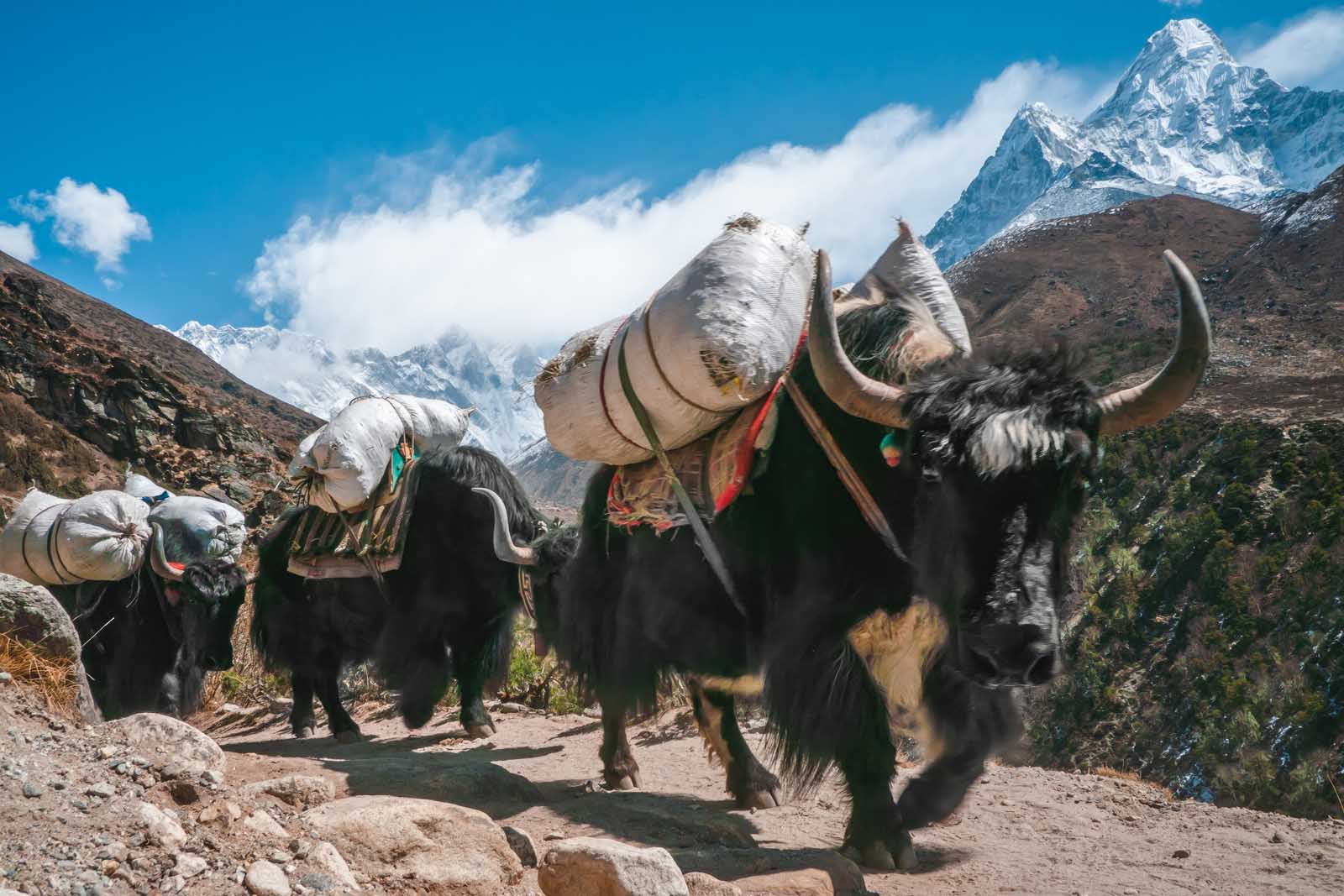
Woolly yak trains were more frequent and by day five of the EBC Trek, we had our system perfected to give them the right of way without letting them nudge us off the mountain.
As we said earlier, it is important to give yaks space. They will run you right off the mountain if you are in their way. Be sure to stand on the mountainside as they pass so you don’t get knocked over the edge. The yaks of the Everest Base Camp trek, have only one thing on their mind. To get to their destination.
On this day, signs of expeditions going up to summit Everest started to go by as large groups of yaks carried giant loads of climbing gear. It is exciting to think that we were walking the same route as so many great mountain climbers, like Sir Edmund Hillary and Tenzing Norgay Sherpa.
The Trek from Tengboche is breathtaking
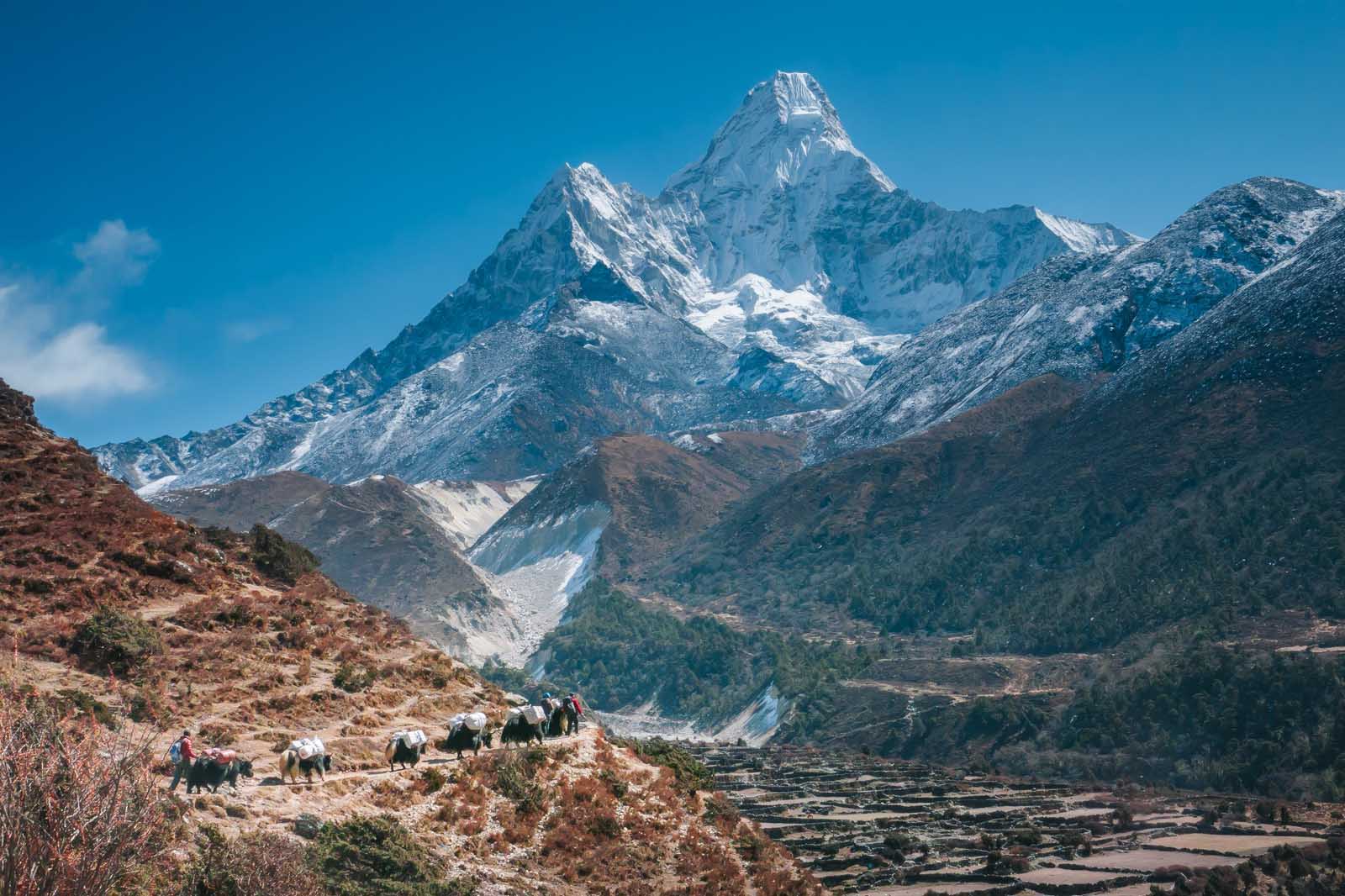
I conquered what little fear of heights I had left this day. Some of the narrow paths on the route dropped sharply into the deep valley below. Soon we found ourselves walking along the ledge not thinking at all about the dangers below. We hiked for a couple of hours before stopping for tea at a restaurant in Pangboche.
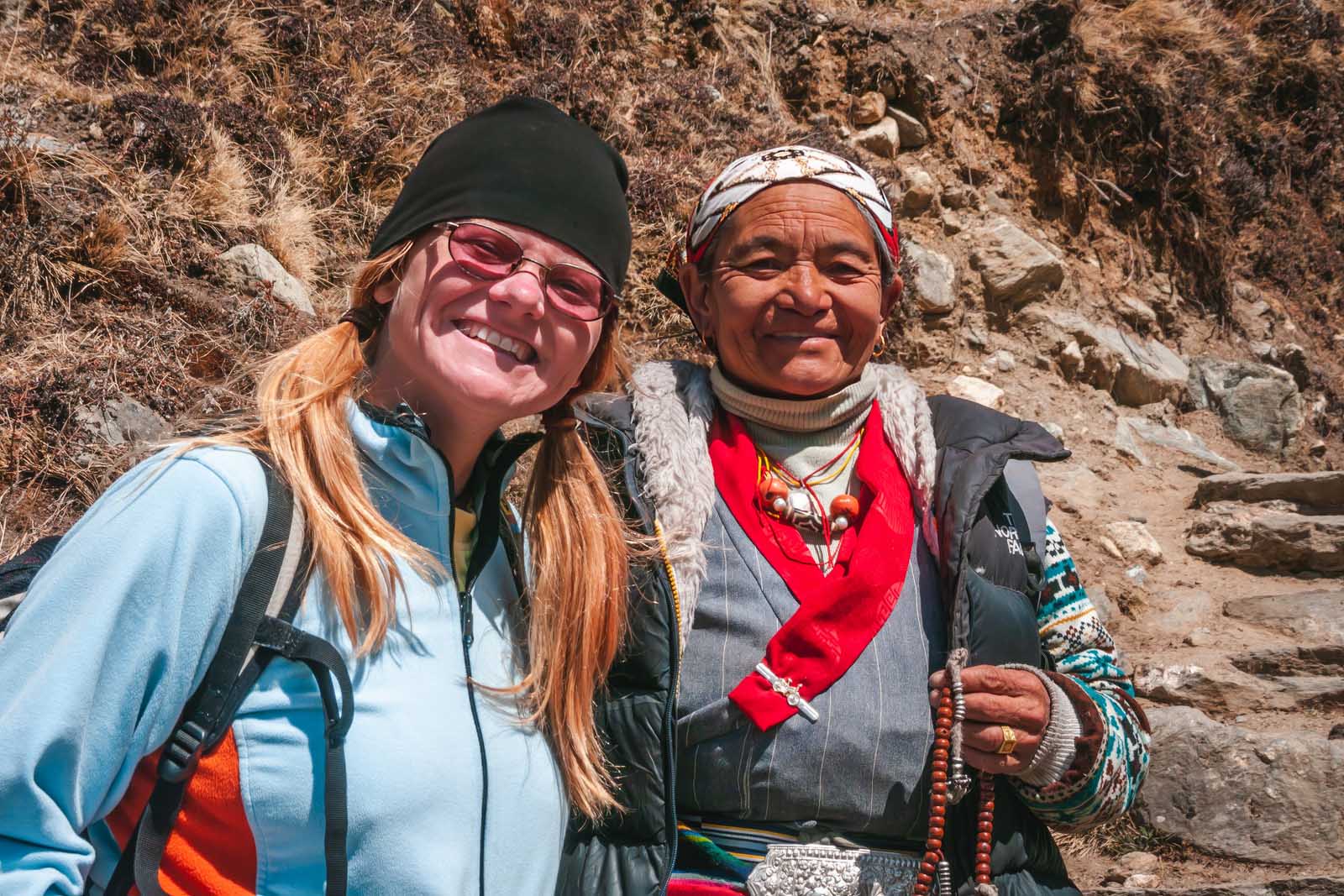
There are shops, teahouses, and restaurants along the route so we could buy lunch along the way and one of the more popular stops is in the village of Pangboche. After a tea stop in Pangboche, we met a sweet lady that walked with us all the way to the village of Dingboche. Her name was Yangshou and she waited for us as we struggled up hills and crossed the suspension bridge over the Imja Khola River.
Her cute laugh and quiet prayers helped to pass the time. She stopped to talk to everyone on the trail while we plugged along. She’d fall far behind when she chatted with friends, only to quickly catch us and then scoot by us with ease. She must have enjoyed our company because we really slowed her down. “ Yangzhou, we will always remember your smiling face!
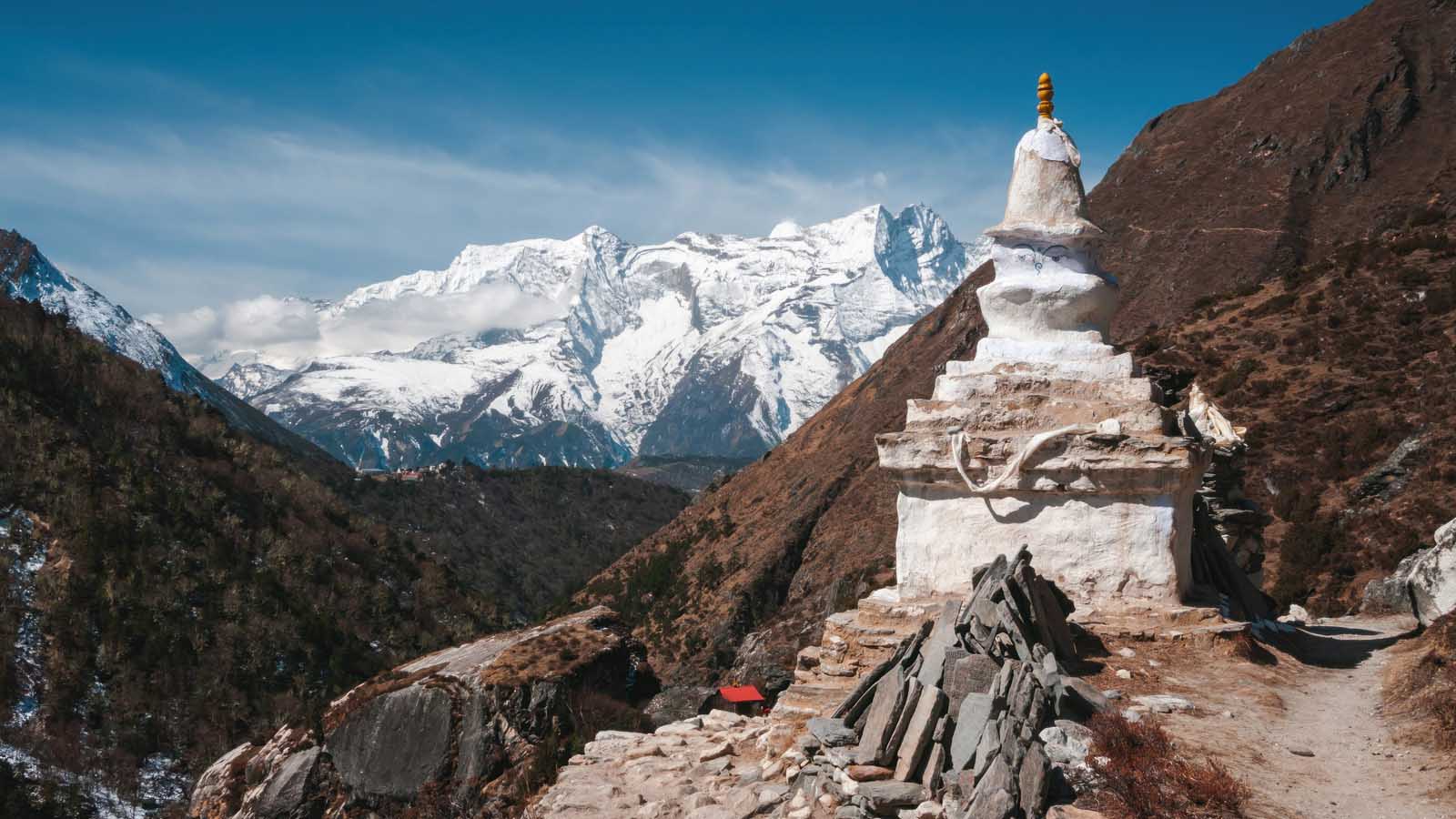
We spent the night in the village of Dingboche and wished that we had another night here. It is from here that you will see beautiful views of Island Peak and Lhotse, but it is also a good spot for another acclimatization day.
Tengboche – 3860 meters (12664 feet) above sea level Dingboche – Elevation – 4410 meters. (14468 feet) Elevation Gain – 550 meters (1804 feet) Distance – 10.8 km (6.71 miles) Duration – 3 hours (without stopping) 5 hours for photos, lunch, and rest.
Day 6 – Second Acclimatization Day at Dingboche
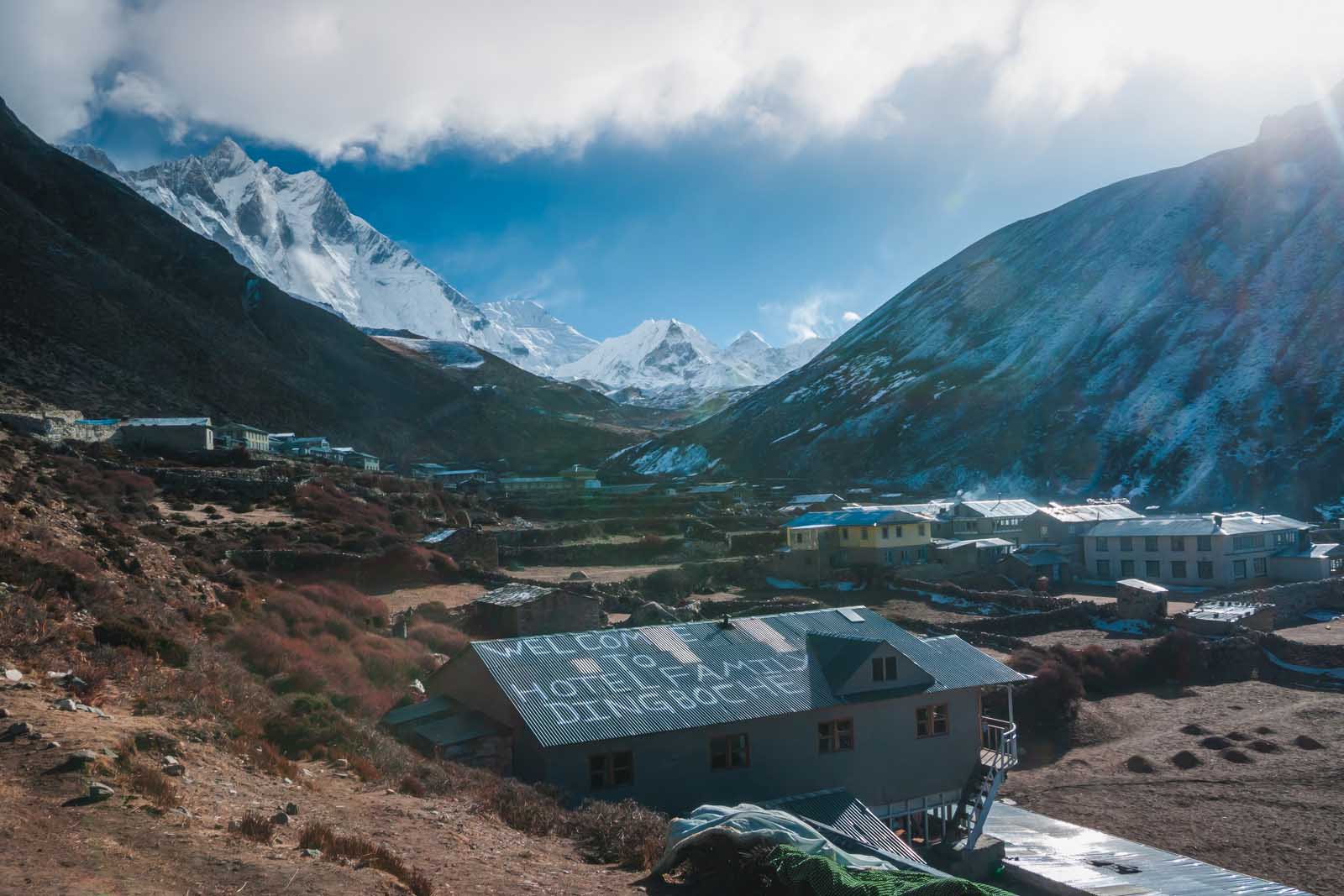
This is a day that most people spend acclimating to the high altitude. We did not do this day, but you should! So we are including it in the guide because it is a very important day when trekking to Everest Base Camp. If we were smarter, we would have spent 2 nights in the village of Dingboche where we would spend a day hiking up to Nagurjun Hill.
This is the best place for climbers looking to summit Everest, Ama Dablam (6812m), Lobuche peak (6,119 m), or Island Peak to do their acclimatization day. Dingboche is a small village in the Khumbu region with only a few guest houses, so it is a good time to relax, replenish and rejuvenate for the next push.
If we had brought our Lonely Planet Trekking in the Nepal Himalayas (which we forgot in Kathmandu and kicked ourselves about it every day) we would have realized that we should have taken an extra day to acclimate in Dingboche.
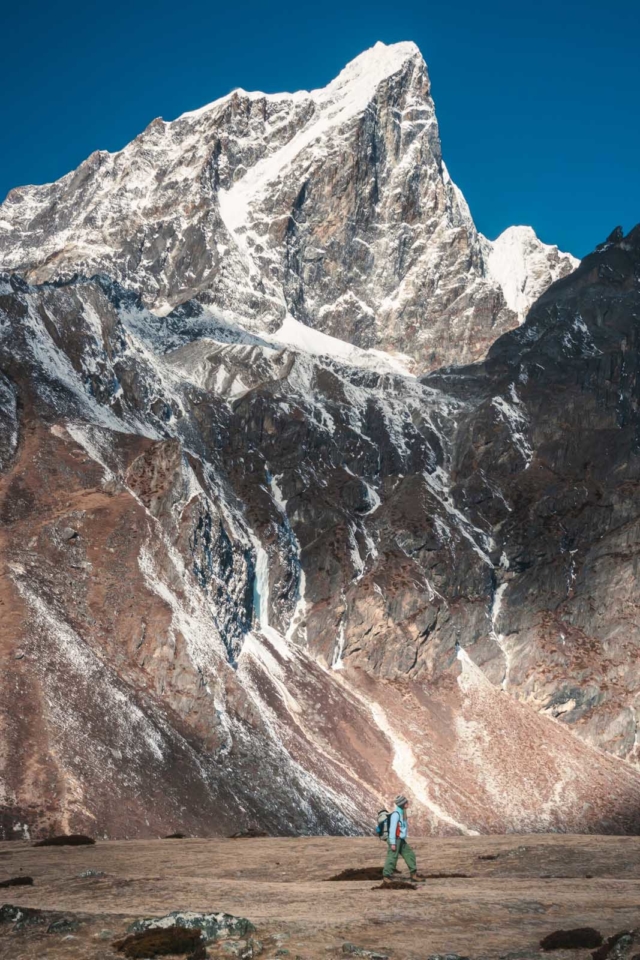
Dipendra was flexible so he would have easily added another day onto our trek, we just didn’t know any better to ask about it. Lucky for us, we felt strong, but other groups were complaining of headaches and dizziness.
In the end, we wish we spent the extra day here. Some people even spend two days here climbing to the surrounding peaks. We did suffer after reaching base camp and I believe that is because we didn’t spend time acclimatizing here.
Had we stayed, we would have done some light hikes to gain altitude and then come back down to rest at a lower elevation. Many people who are set to climb Island Peak or Kala Patthar stay here for a few days to get some practice climbs in.
Dingboche – Elevation – 4410 meters. (14468 feet) above sea level Nangkartshang Peak – Altitude – 5050 meters (16568 feet) Climb – 640 meters (2099 feet) Distance – 10.8 km (6.71 miles) Duration – 4 hours Elevation Gain – 0
Day 7 – Dingboche to Lobuche
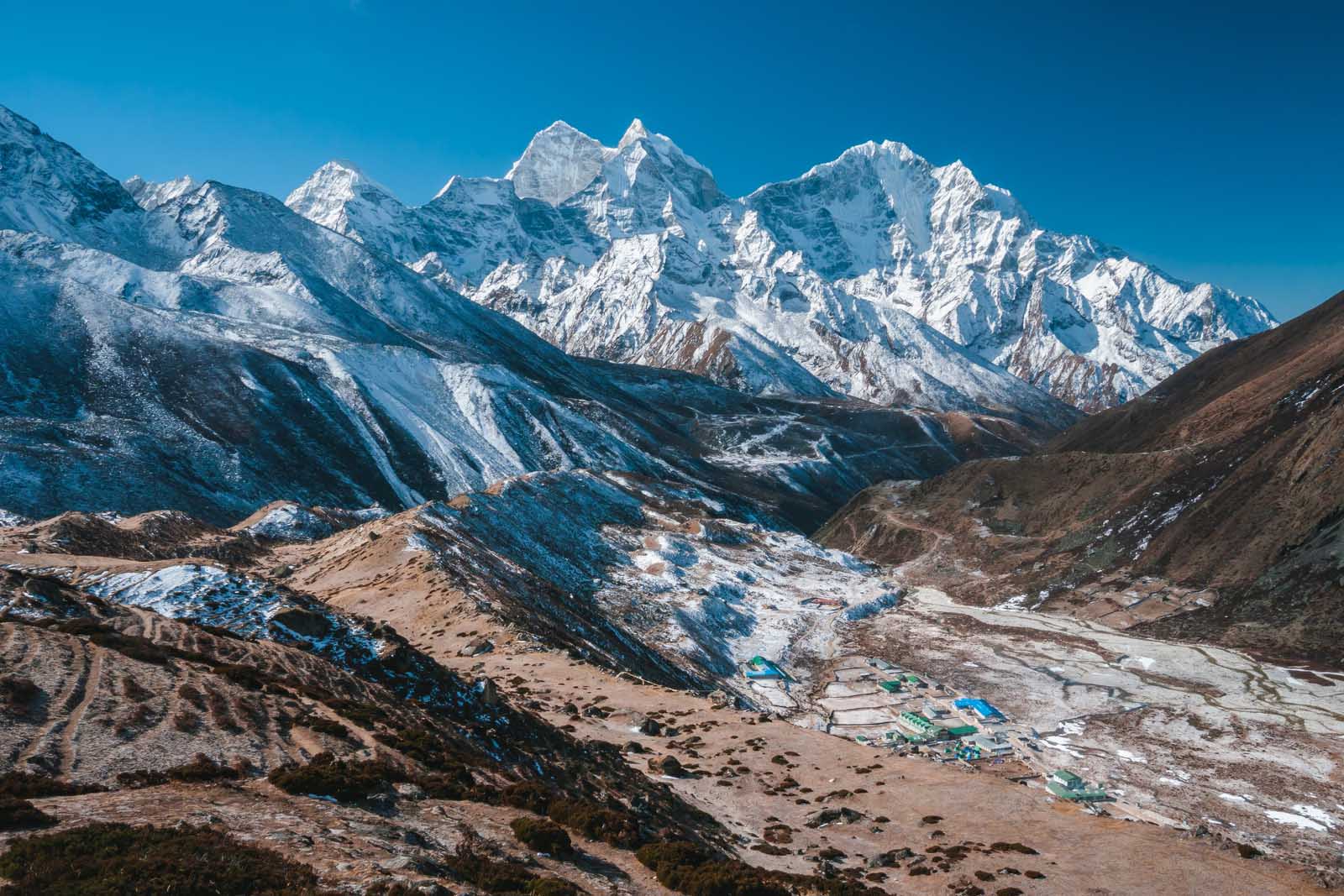
We walked with fellow trekkers we met at our guesthouse Martin and Richard from Slovakia during the morning hours. They carried their own packs and after watching them struggle, we were happy we hired a porter. (note: As of April 2023, you can no longer trek independently in Nepal) They were really starting to feel the altitude and we eventually left them behind.
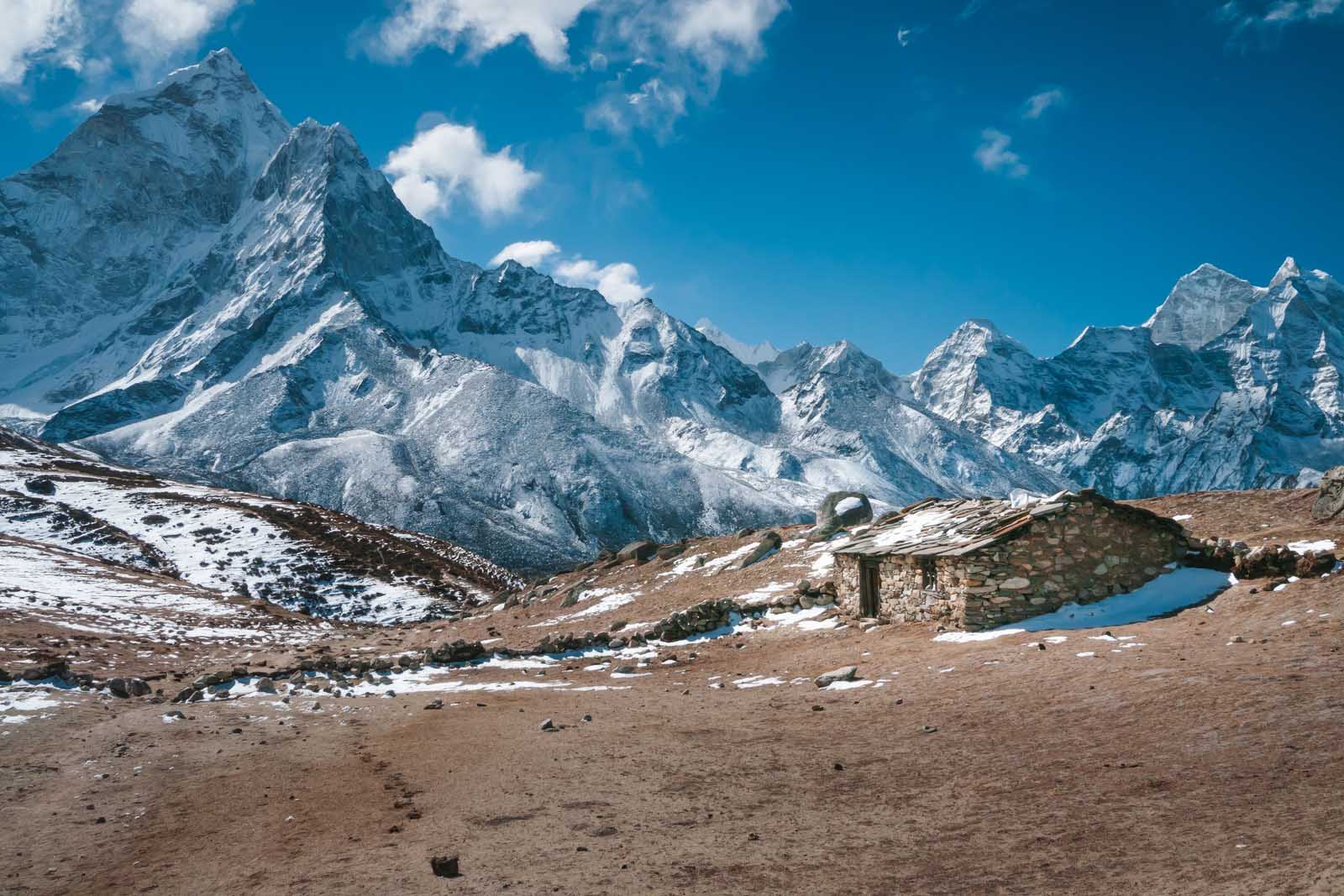
We enjoyed our day taking photos of the stunning clear views of the Everest region. It may be a little colder trekking in Nepal at this time of year (Early March), but the skies are clear and blue. When we came across a small cluster of houses, we felt like we had entered the Kingdom of Middle Earth. Little Hobbit houses lined a valley with giant peaks looming overhead.
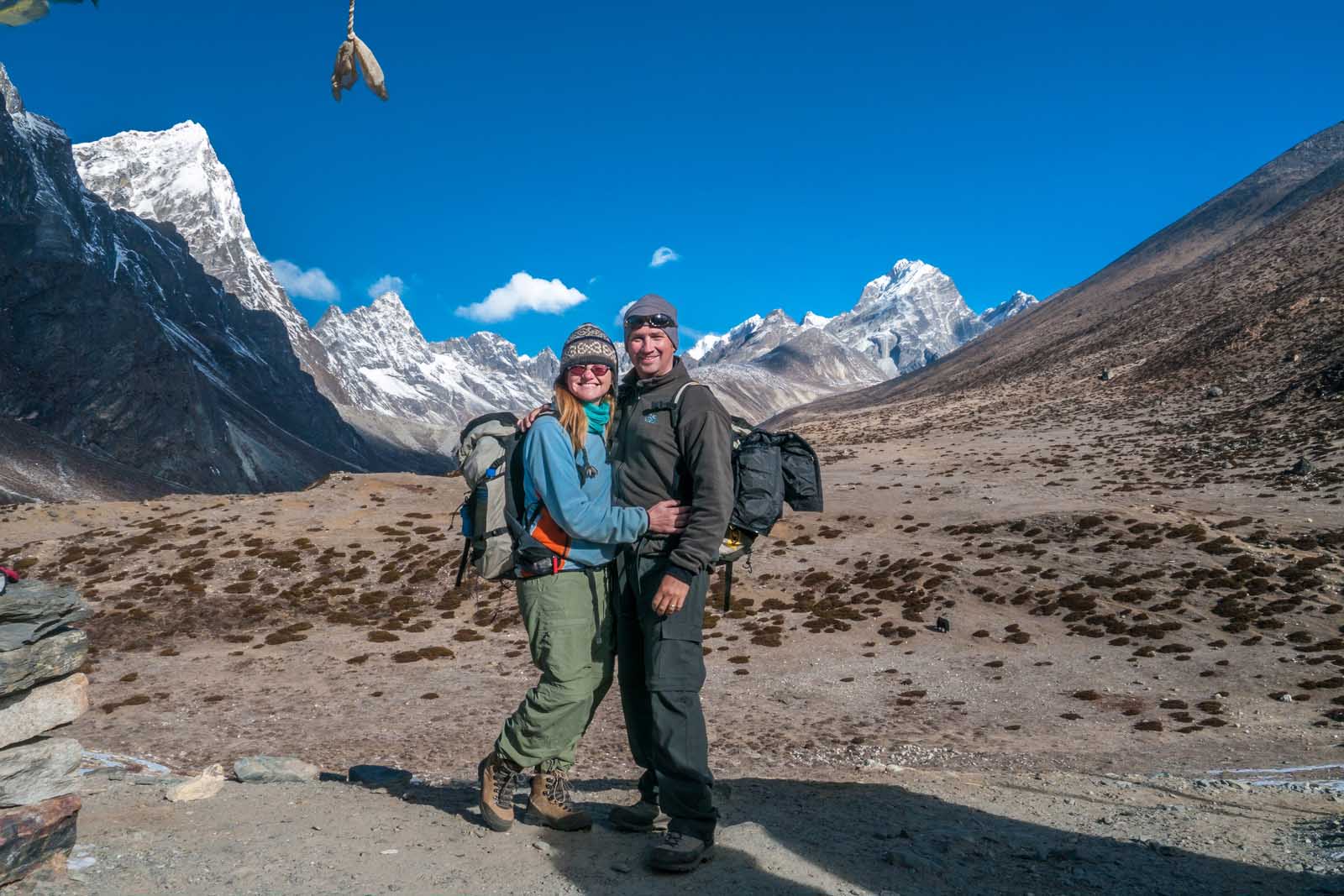
We had a front-row seat to some of the most breathtaking views on earth. An entire panorama of the mountains standing proudly overhead, reaching up to the deepest blue sky that I have ever witnessed. The scene took our breath away. The mountains looked more imposing with each corner we turned and we could not believe that we were fulfilling our dream of hiking to Everest.
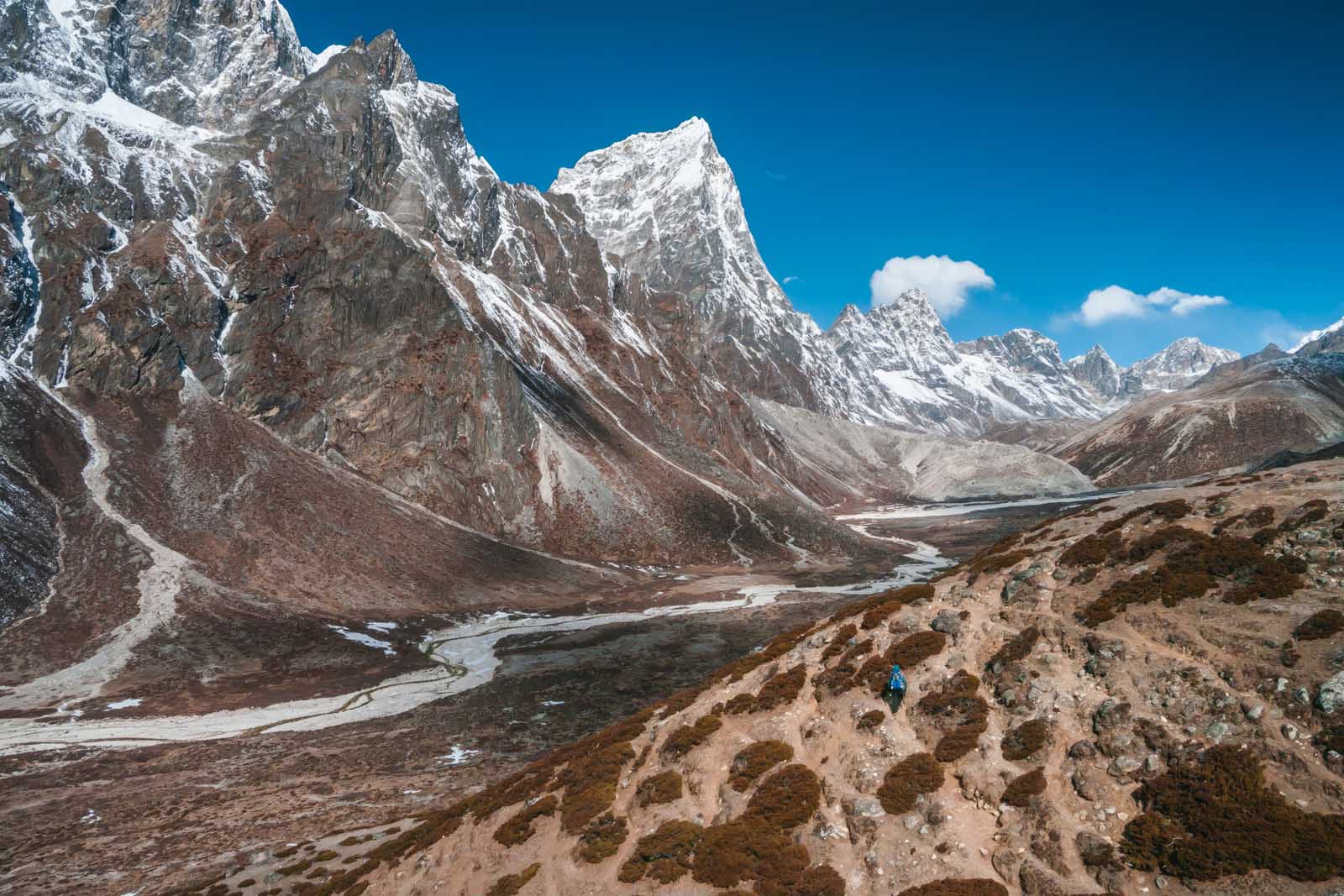
We had to knock on the door to see if Bilbo Baggins happened to be in. Sadly, he wasn’t home. I ended up singing Leonard Nimoy’s Ballad of Bilbo Baggin s for the rest of the day. A bad idea since I only know a few words.
Weather Conditions
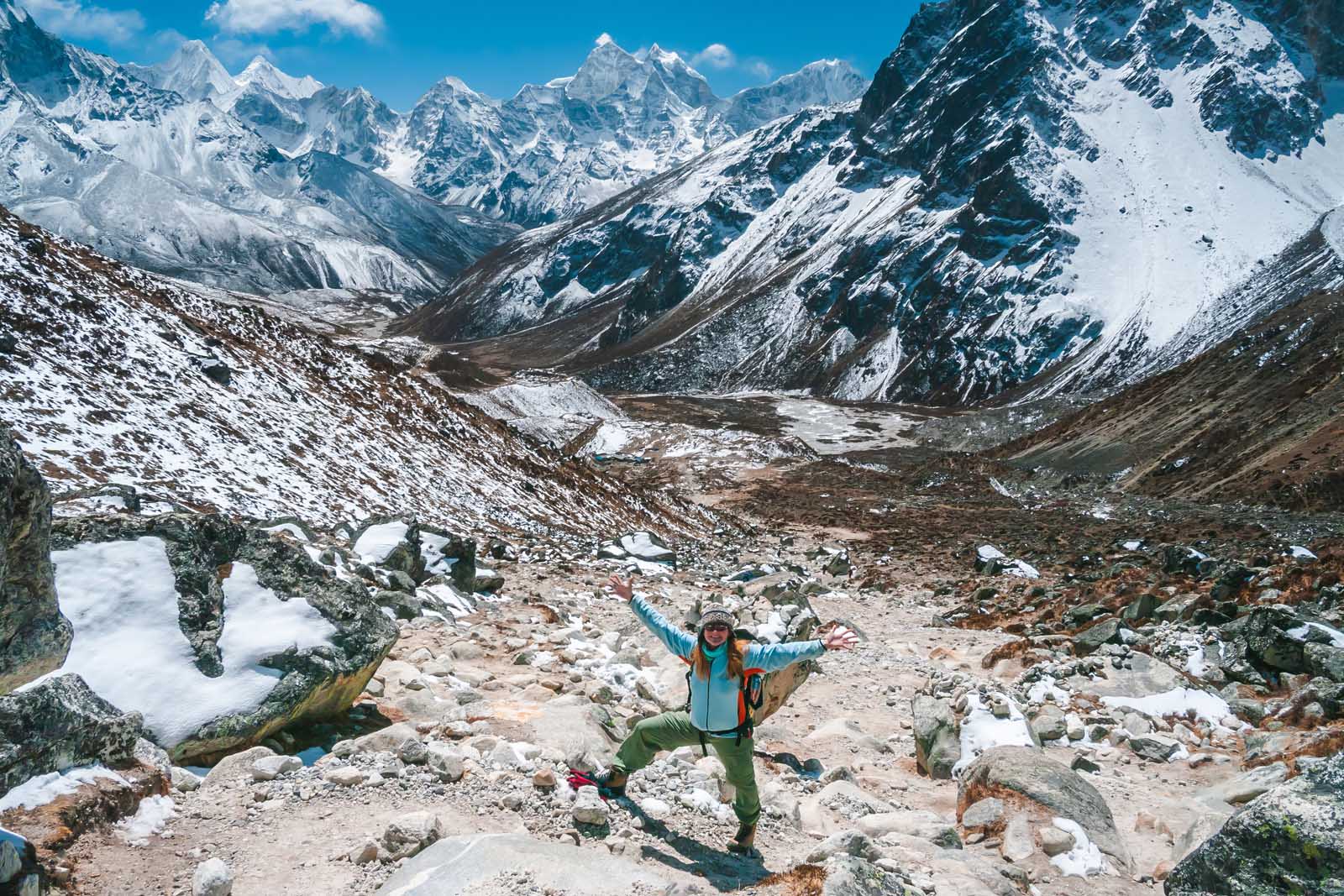
The wind picked up and we put on our outer layers for the first time. We were thankful to have them as we staggered through the high gusts. Weather varies greatly in the Everest Region and before you know it you can have inclement weather so be prepared with your layers. The sun can be shining one minute and then wind and clouds roll in the next.
After lunch, we faced quite the scramble up a steep hill littered with boulders. It looked like a tough climb, but we moved with ease and quickly made it to the top. Where we found our strength, I do not know.
Sherpa Monuments
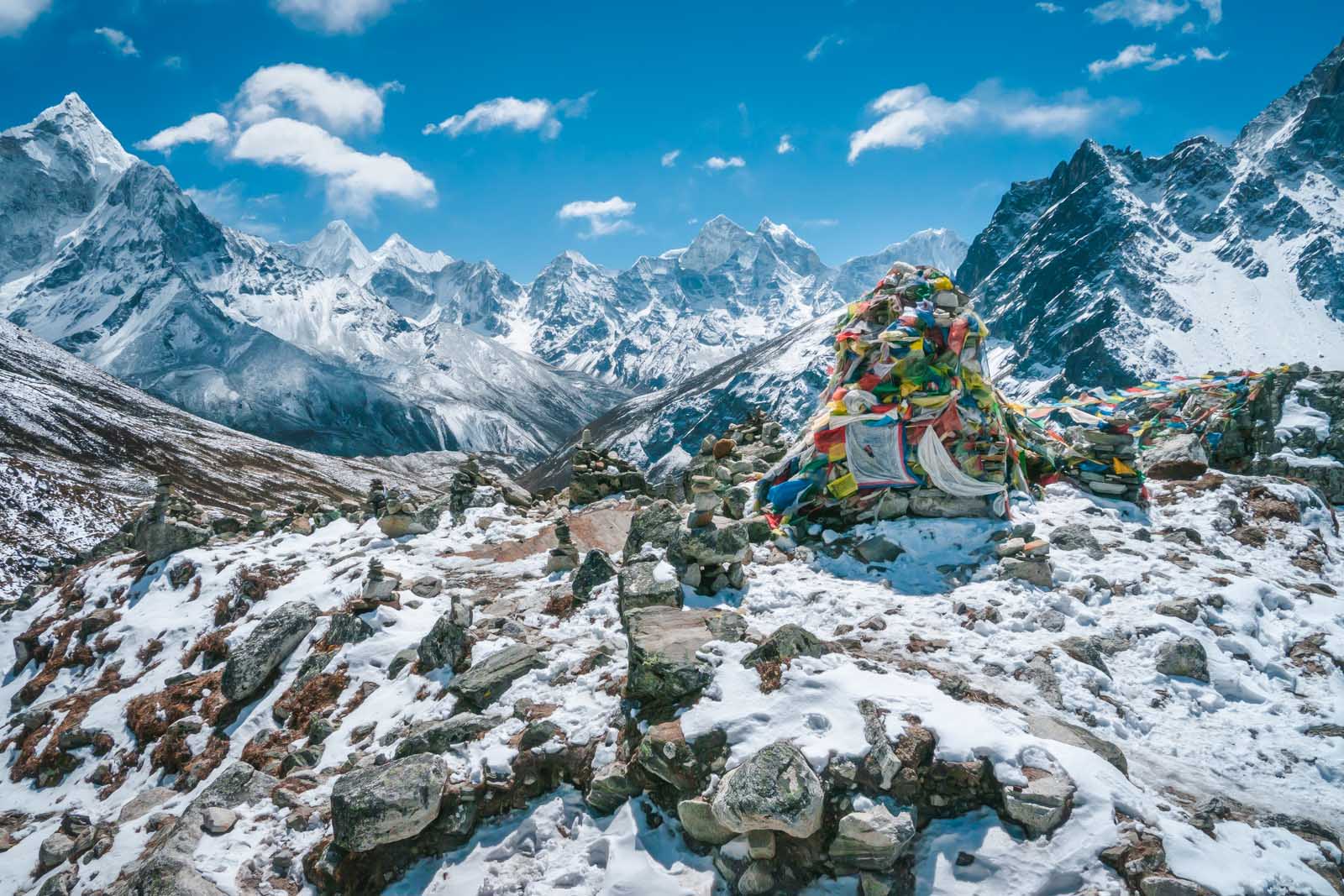
At the top of the hill is a very moving sight. Several monuments and stupas are erected, honoring Sherpas and climbers that have lost their lives on Everest. The most notable of these is Babu Chiri Sherpa .
Babu Chiri Sherpa was the former world record holder of the fastest ascent of Everest, the most number of ascents up the mountain, and the quickest back-to-back summits of 2 in less than 2 weeks. He tragically lost his life on his 11th attempt when he fell into a crevasse.
It was a moving experience and a strong reminder to not take things lightly on Everest, even if you are only trekking to Everest Base Camp. It is still a serious trek.
Dingboche – Elevation – 4410 meters. (14468 feet) above sea level Lobuche – Altitude – 4940 meters (16207 feet) Elevation Gain – 530 meters (1738 feet) Distance – 17.6 km (10.9 miles) Duration – 4 to 5 hours
Day 8 – Morning – Lobuche to Gorak Shep
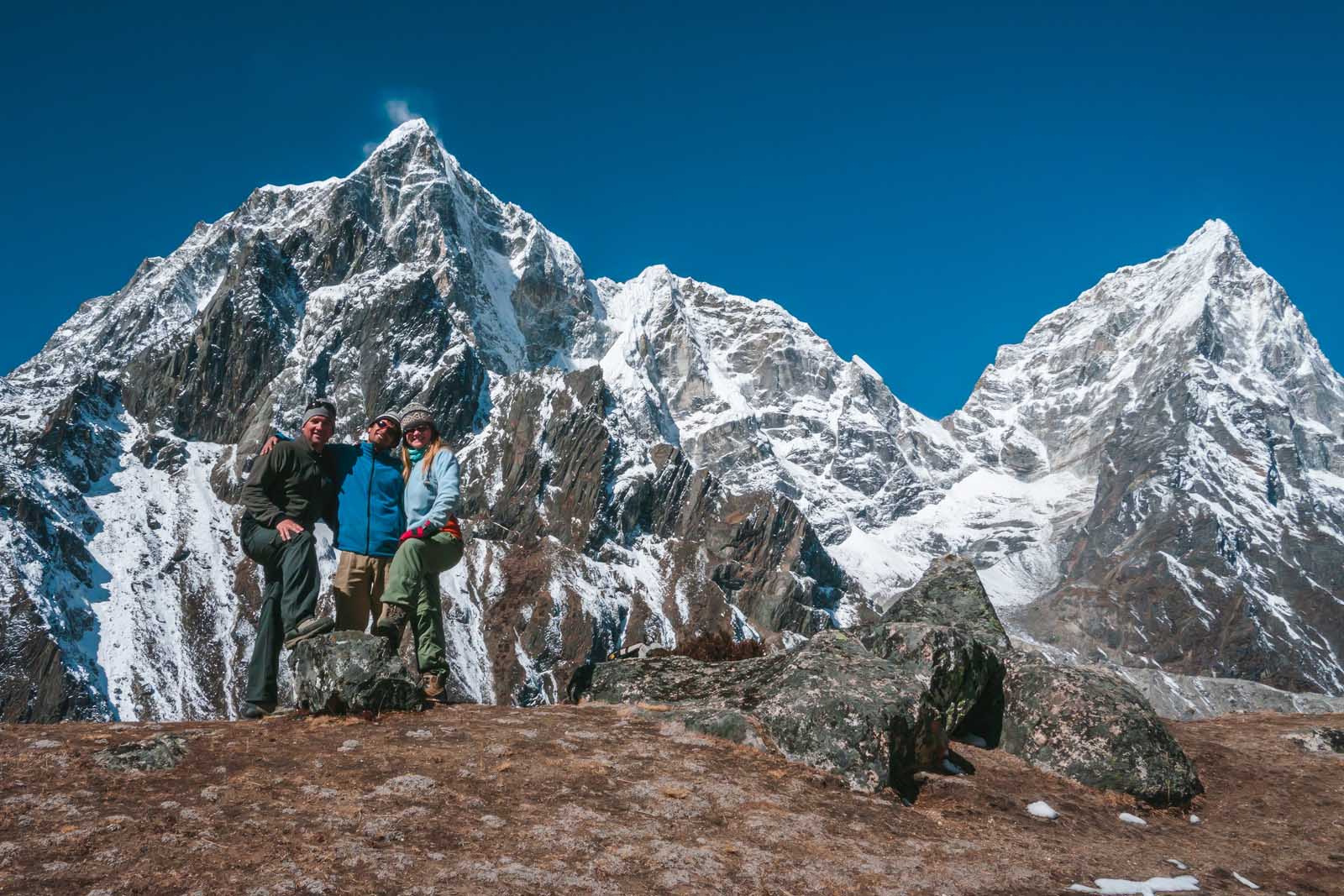
Day 8 on the Everest Base Camp Trek takes you to 5000 meters (16404 feet). How did we feel at 5000 meters? Terrible. Before entering Nepal, I had been suffering for a few weeks in India. The pollution of Kathmandu didn’t help and my congestion was worse when I started the climb. I thought it would clear up in the fresh air, but it intensified with each increase in altitude.
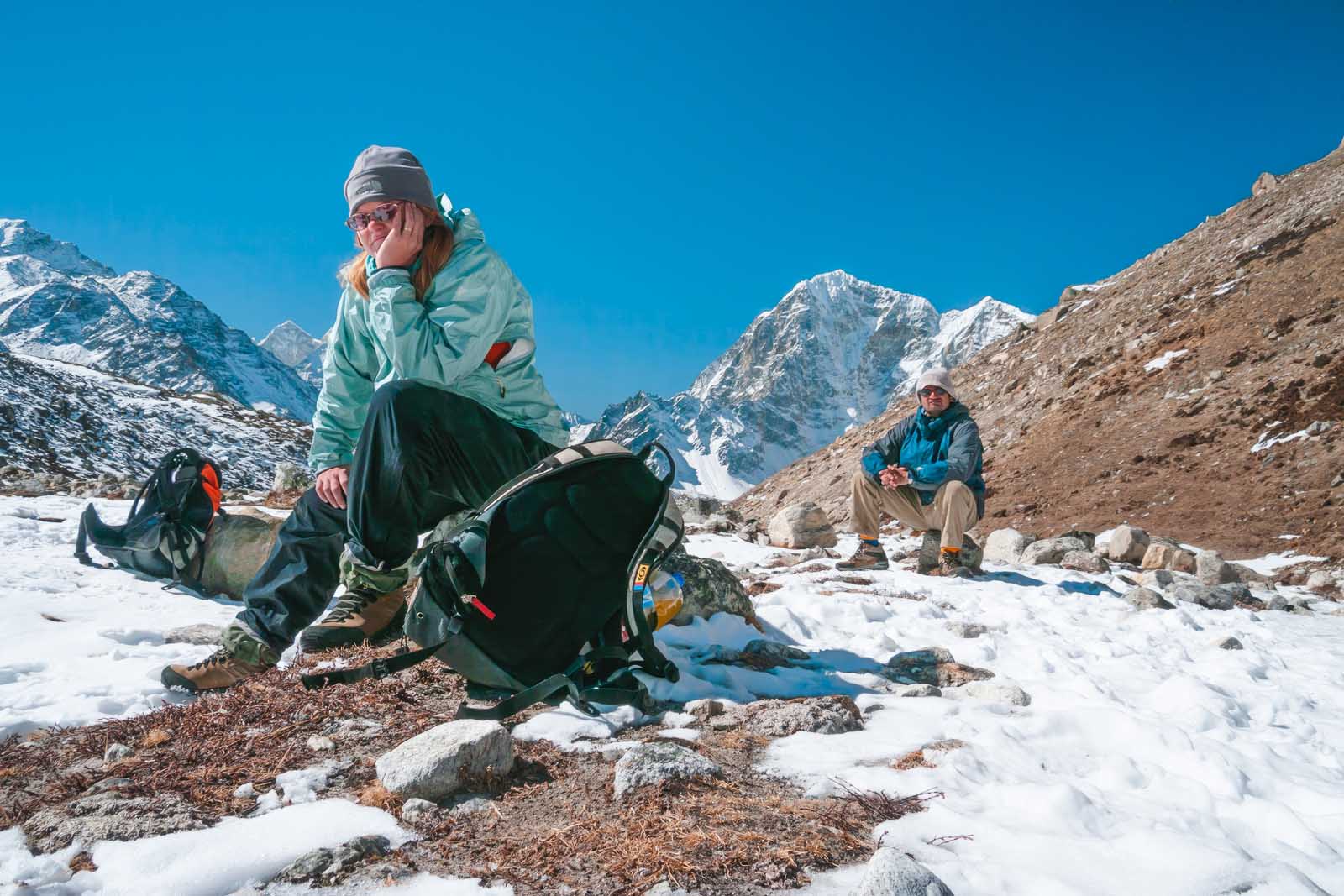
Every morning my cough got worse and my nose was stuffed up to the point of being unbearable. Today, I felt the effects of the congestion and couldn’t catch my breath. It didn’t help that we had gone into such a high altitude. The air is thin and cold.
Dave suffered his first symptoms of altitude sickness when reaching 5000 meters as well. He had a slight case of diarrhea and wasn’t happy about having to wait for the toilet in the teahouses. I think many people were suffering from the same symptoms.
Our was a slow climb to Gorak Shep. We stopped regularly to catch our breath and today we took more breaks than usual. Luckily it was only a couple of hundred meters in elevation gain so we made it to our guest house in Gorek Shep by 12:30.
Lobuche – Altitude – 4940 meters (16207 feet) above sea level Gorak Shep – 5164 meters (16942 feet) above sea level Elevation Gain – 224 meters (734 feet) Distance – 4.3 (2.6 miles) Duration – 4 Hours
Day 8 – Afternoon: Gorak Shep to Everest Base Camp
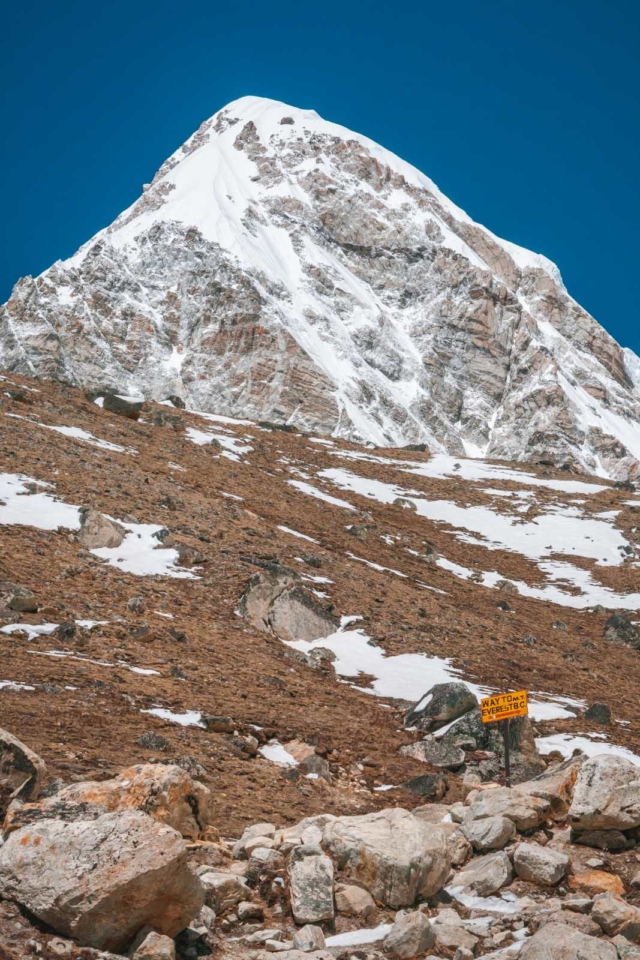
We took a break at Gorek Shep before making out way to Everest Base Camp. We sat in the sun marveling at the fact that we made it this far. After eating a hearty lunch of vegetarian Sherpa stew (Dal Bhat) on the terrace, (yes, we ate outside in the warm sun above 5100 meters) we set out for Everest Base Camp. The sun was shining brightly and it was quite pleasant outside so we were very excited.
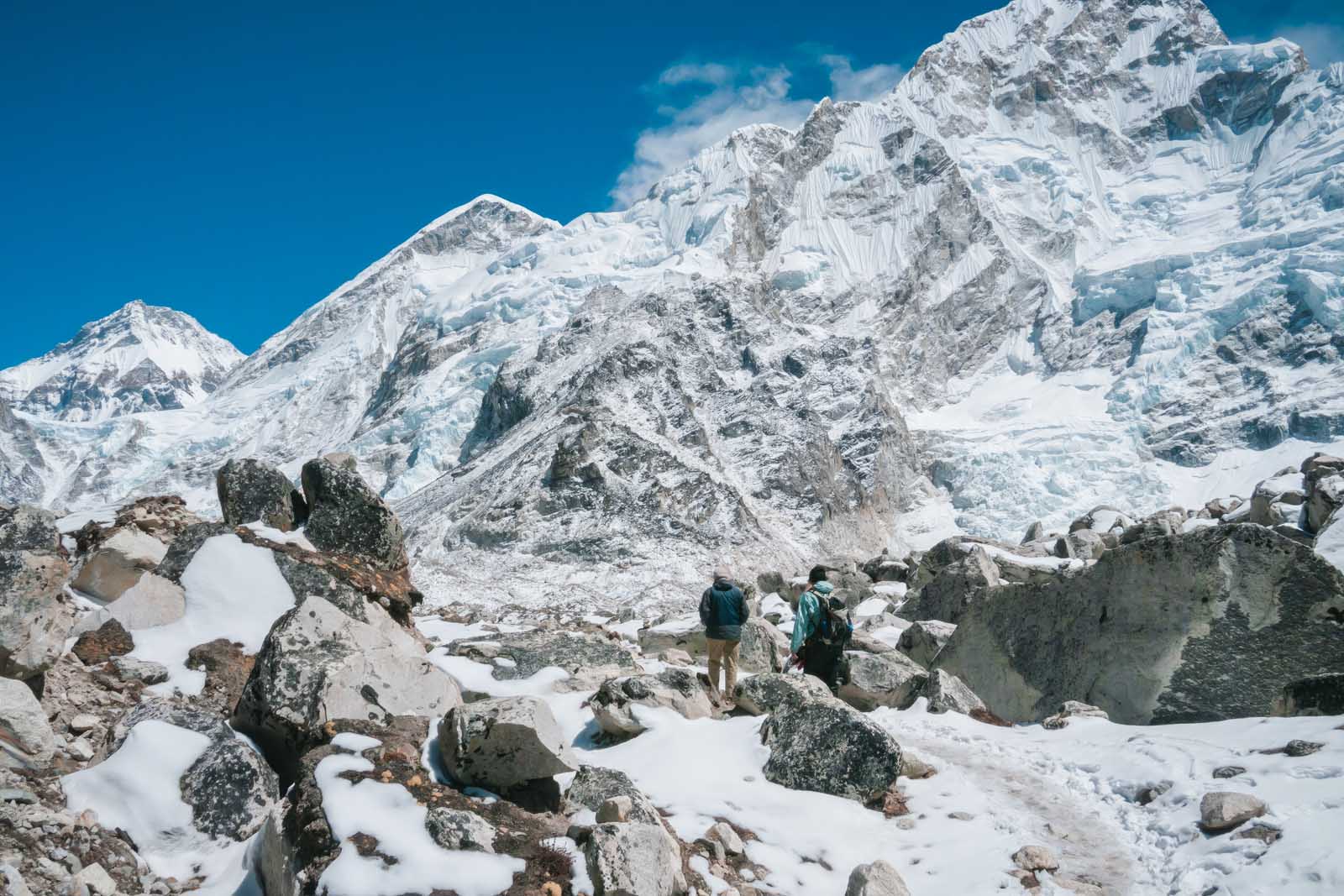
We were lucky and had clear skies. Up until today, the clouds had rolled in by early afternoon every day. Today the sun shone and the skies were blue until sunset. So, it was our perfect morning to make the push.
The trek to Base Camp from Gorak Shep is an easy one. It’s two hours of walking with only a small elevation gain, and we made it with ease. That break for lunch really helped our spirits.
Reaching Everest Base Camp
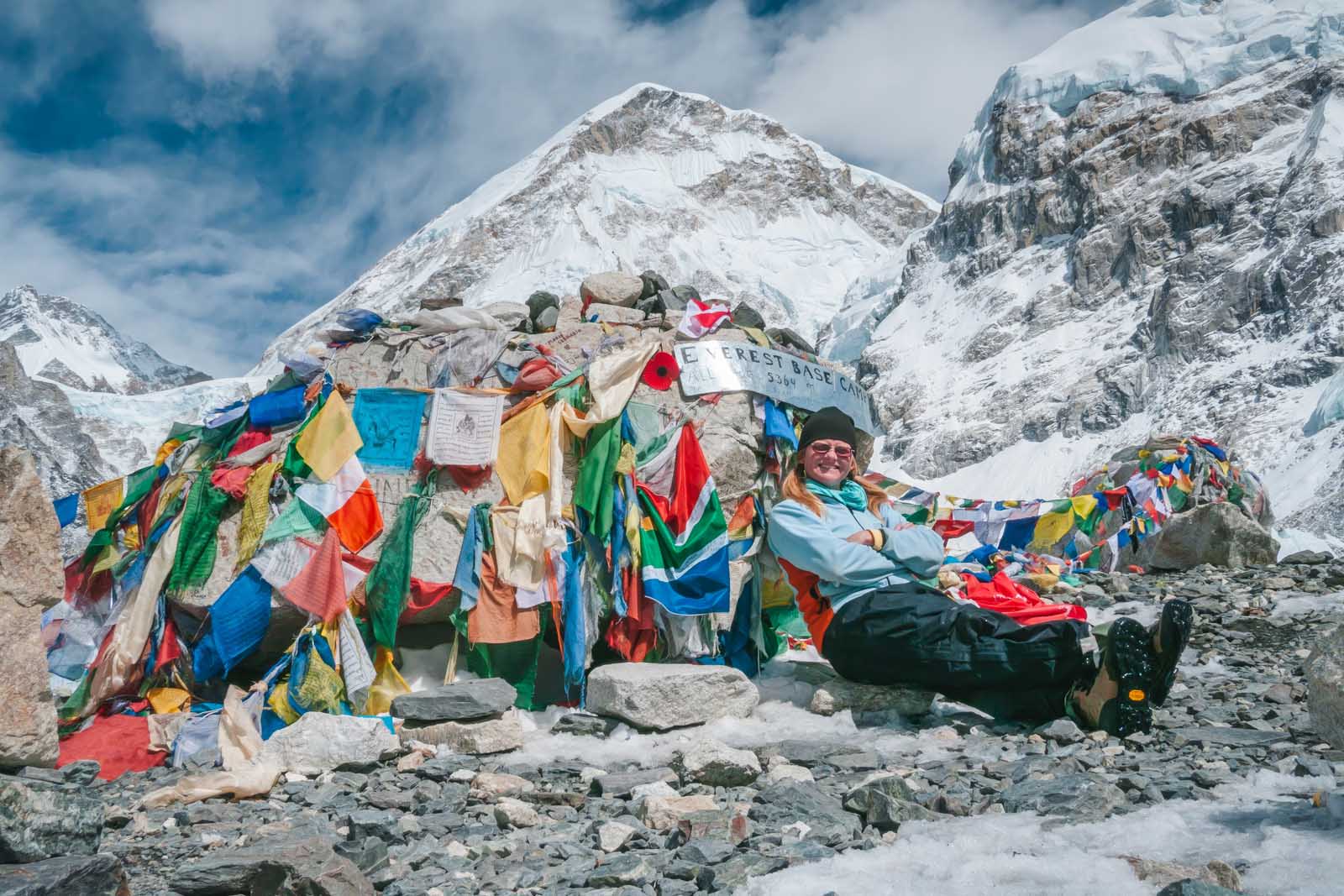
People can summit Mount Everest from Tibet, but the main Everest Base Camp expedition route is in Nepal, and it is busy when the season is in full swing. Even those climbing to the peak of Mt Everest hike the route we took along the Everest Base Camp trek.
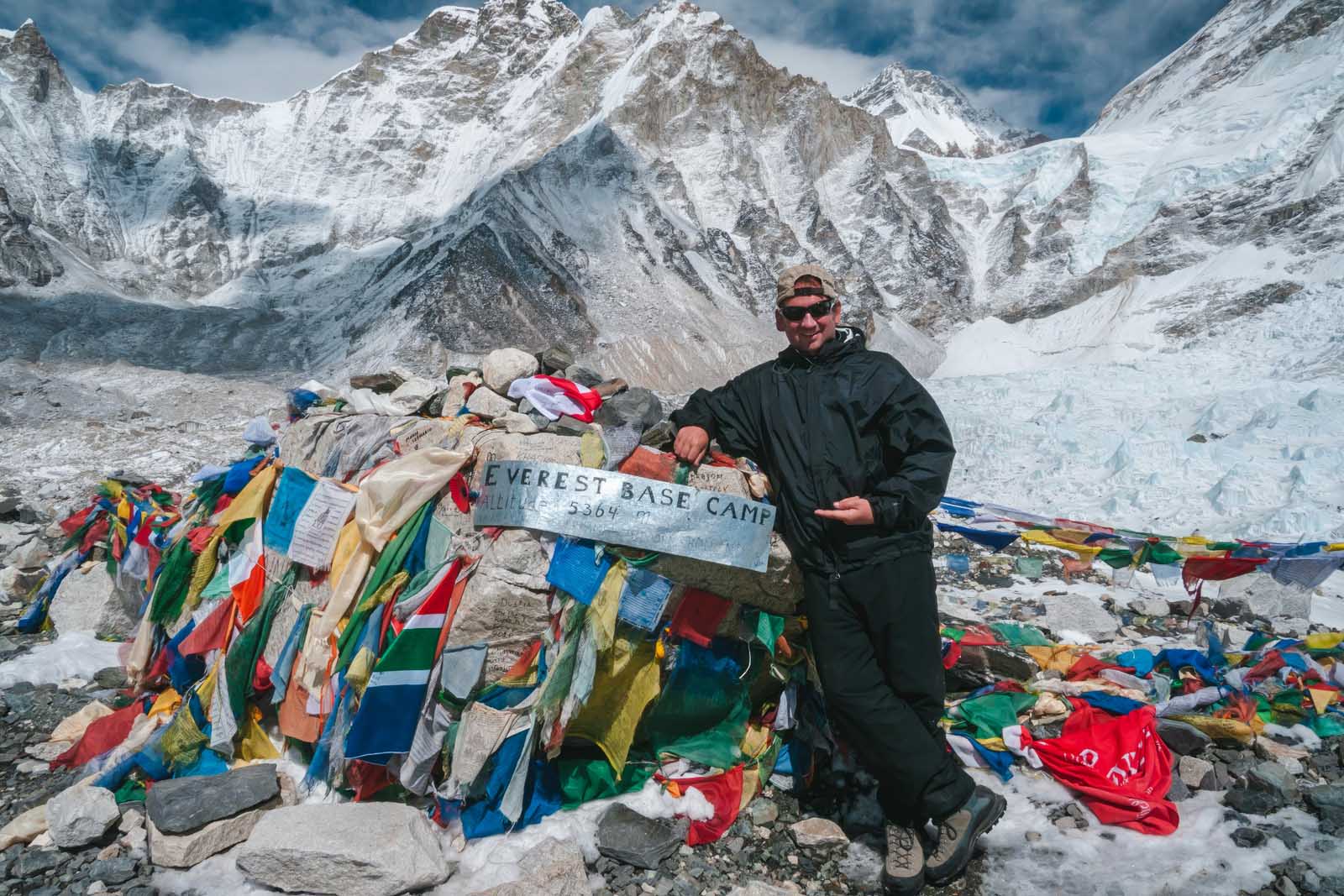
We arrived just a week or two before the season, so it was still quiet on the mountain. In fact, we were the only people at Base Camp that afternoon. We saw another group coming down on our way up, but once there we had it all to ourselves. It was thrilling.
To reach Everest base camp, you will hike out from nearby Gorak Shep and then hike back the same day to spend the night in the village. You do not spend the night at base camp.
Khumbu Glacier
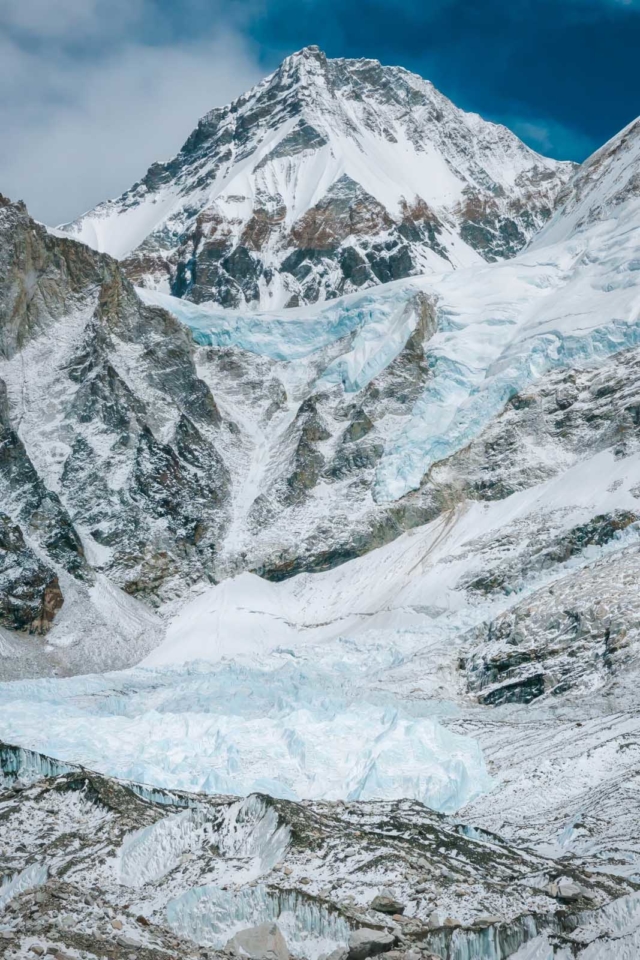
The Khumbu Glacier is the first thing to come into view, and it is unbelievable to think that we are actually standing there. The Khumbu Glacier is the largest glacier in all of Nepal and is famous for the Khumbu Icefall. This treacherous sheet of ice is the most dangerous obstacle that climbers face when summiting Everest.
We witnessed an avalanche that reminded us just how precarious the climb to Mount Everest is. It is an intimidating sight and I cannot imagine having the courage to cross that field of ice. Climbers walk across ladders that shift and move as the ice is alive and constantly settling. It has taken many lives, and we were happy to look at it from afar.
With an elevation of 7600 meters at its source, the Khumbu Glacier is the highest glacier in the world and the Khumbu Icefall is one of the most dangerous portions of the climb to the summit of the world’s highest peak. We were happy to look at it from afar.
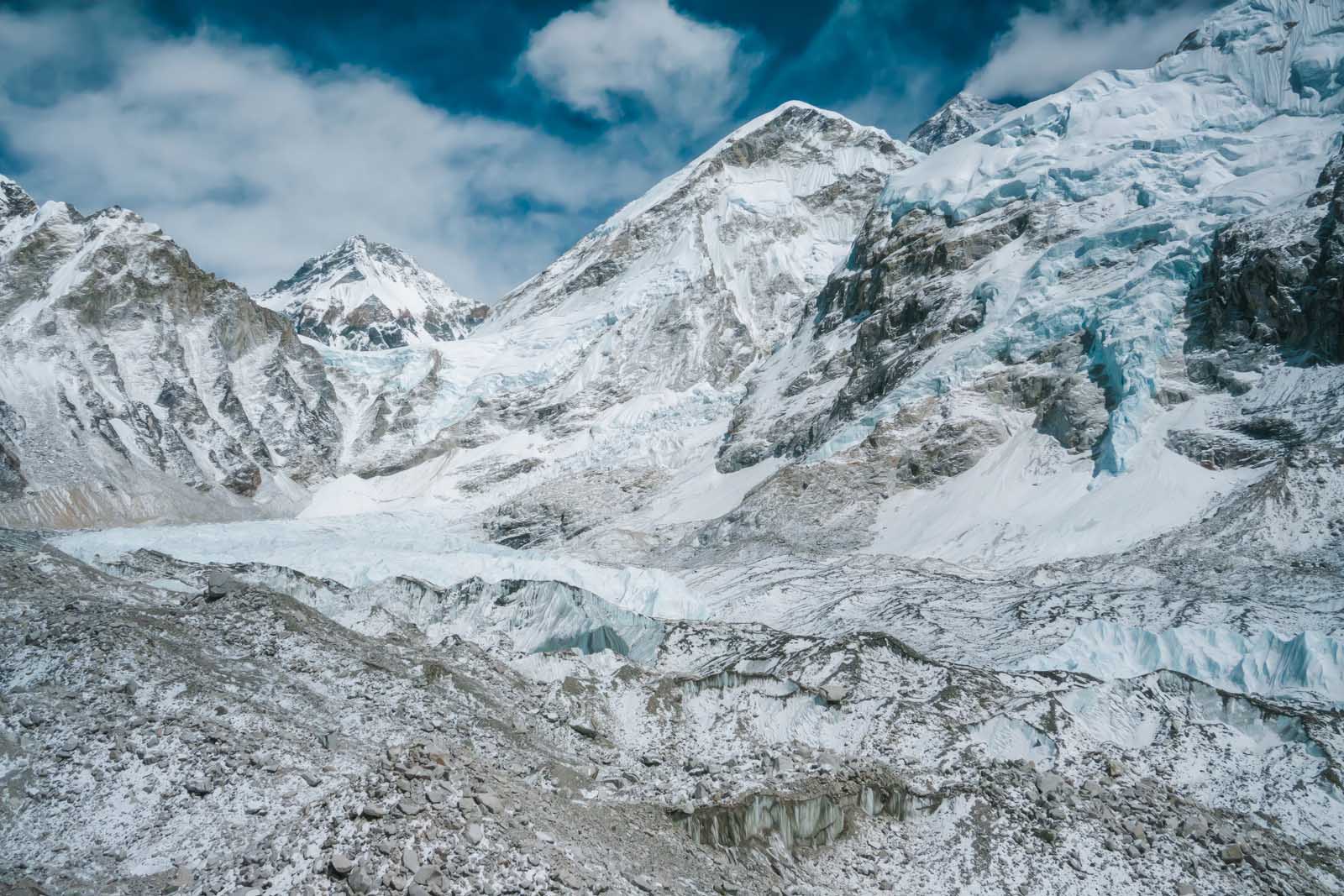
Everest Base Camp’s elevation is 5,364m (17,598 feet) so you will feel the high altitude. But, if you have taken your time you should feel pretty good. We had been at this elevation now for a while and stayed hydrated, so we could enjoy the experience.
We stood at a rock covered with prayer flags announcing that yes, we had made it to Mount Everest Base Camp at 5364 meters. We stayed for almost an hour taking videos, celebrating, and snapping photos. If you can bear it, don’t rush the experience, take it in and enjoy every minute. This will be the only time you’ll see it.
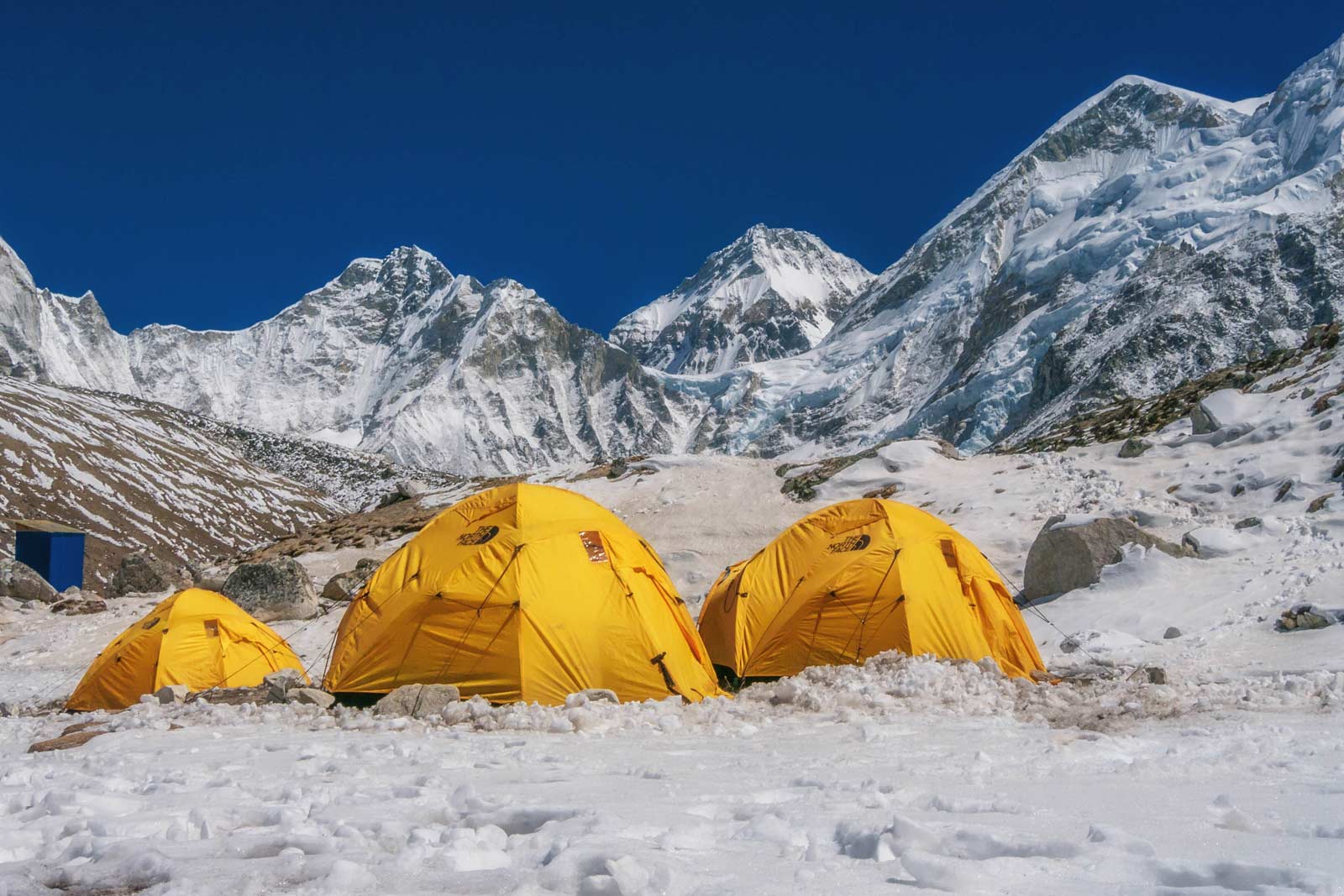
Trekking to Everest may be more exciting later in the season when Everest expeditions are there, but we really liked having base camp to ourselves. There wasn’t a soul on the mountain except for the three of us. We stayed for almost an hour taking videos, celebrating, snapping photos, and marveling at the massive Khumbu Glacier. Can it really be true that we are here? It felt like a dream.
We finished our climb about two weeks before the high season began and we wouldn’t have it any other way. We stood at a rock covered with prayer flags announcing that yes, we had made it to Everest Base Camp.
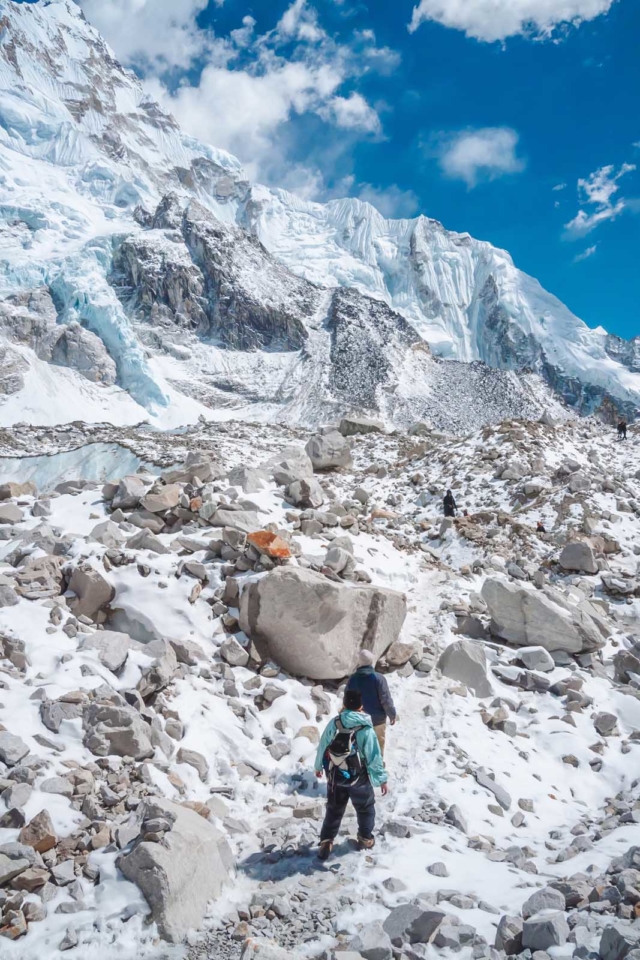
When it’s high season, base camp is filled with expeditions and tents spanning the valley. We only saw one expedition so far. They may have been here to climb Island Peak as base camp is also a place to acclimate for that peak.
We started to make our way back to Gorak Shep from Everest Base Camp at about 3:30 pm. Even though it was an easy trek back, there are narrow paths atop high ledges and it just so happens that while we were walking back, an ice bridge broke off after I stepped on it leaving Dave with a sticky situation of having to take one giant leap over a gorge. We made it back to Gorak Shep safely but it was a reminder just how dangerous the Himalayas can be.
Back to Gorak Shep
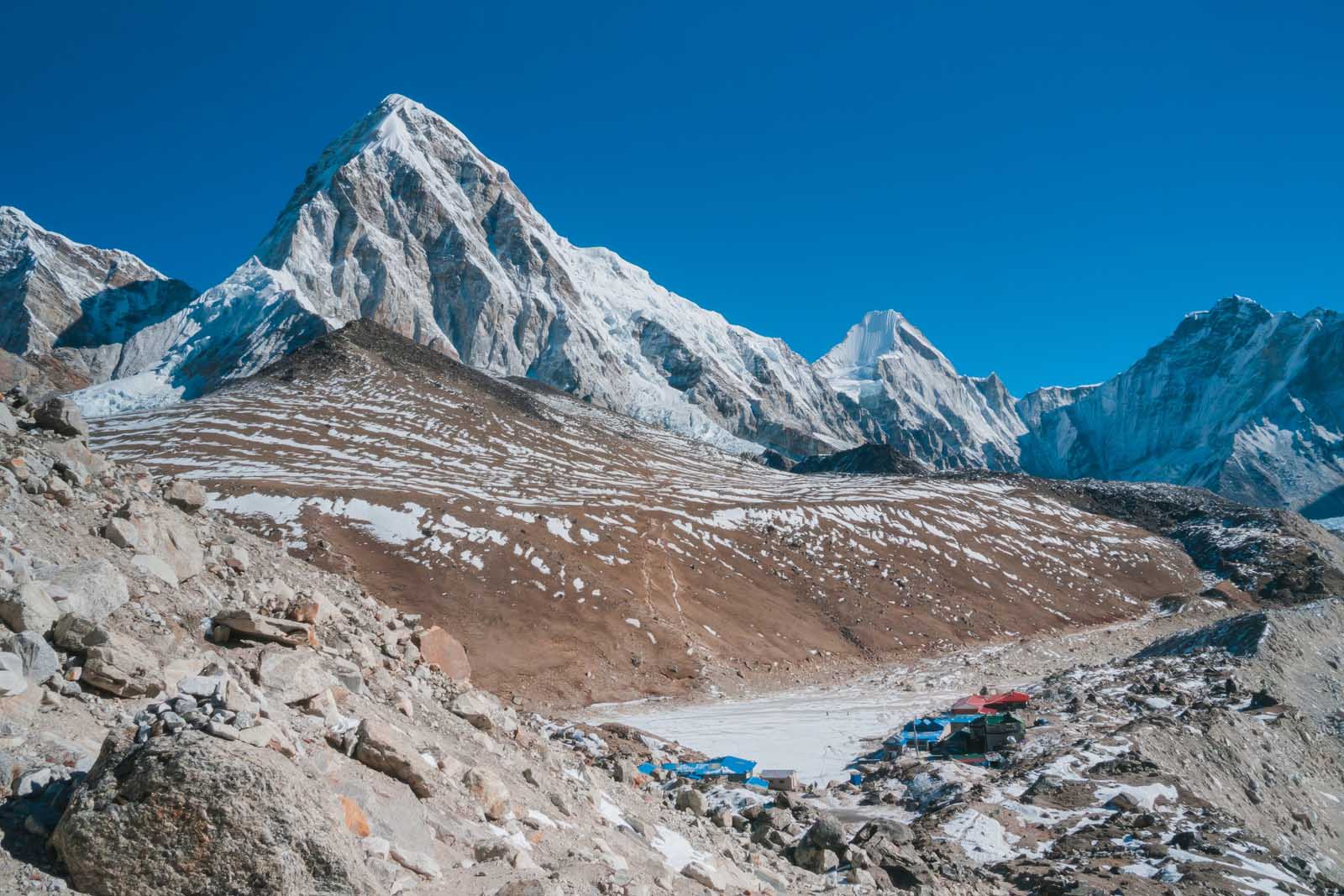
By the time we made it back to Gorak Shep, the excitement of reaching Everest base camp had worn off. We had reached our final destination Base Camp, but there was still a lot more trekking to go.
We were happy to have seen it, but we were exhausted. We felt the same when we climbed Mount Kilimanjaro. The thrill of reaching your destination is over and there is nothing more to look forward to, but there are still so many days to go.
That night I had serious sinus congestion and felt like I was suffocating in my freezing bed. It was quite scary to already be short of breath because of the altitude and then be completely congested. I really was terrified. Our guide Dipendra brought me hot tea all night and I slathered myself in Vicks Vaporub but nothing helped me to breathe easier.
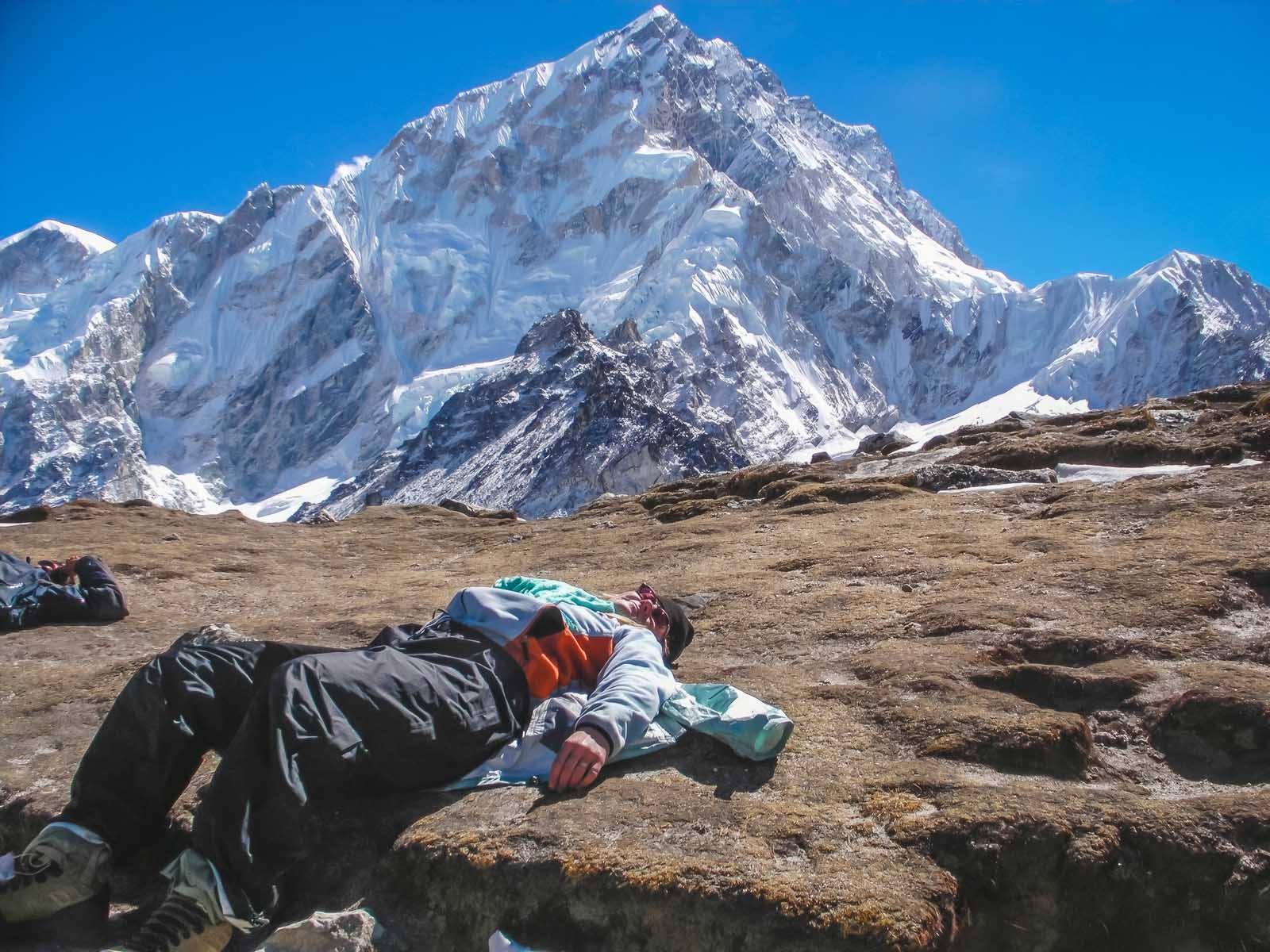
I was afraid as we had the Gokyo Lake trek ahead through the Cho La Pass. We were also planning to trek up to Kala Pattar for the best views of Everest in the morning. I hope I could make it but I was also dreading the day ahead. I barely slept a wink but I finally drifted into a not-so-peaceful slumber.
Gorak Shep – 5164 meters (16942 feet) above sea level Everest Base Camp Elevation – 5,364m (17,598 feet) above sea level Elevation Gain – 200 meters (656 feet) Distance – 3.5 km one way (2.1 miles) Duration – Three Hours Round Trip
Alternative Gokyo Lake Via Cho La Pass
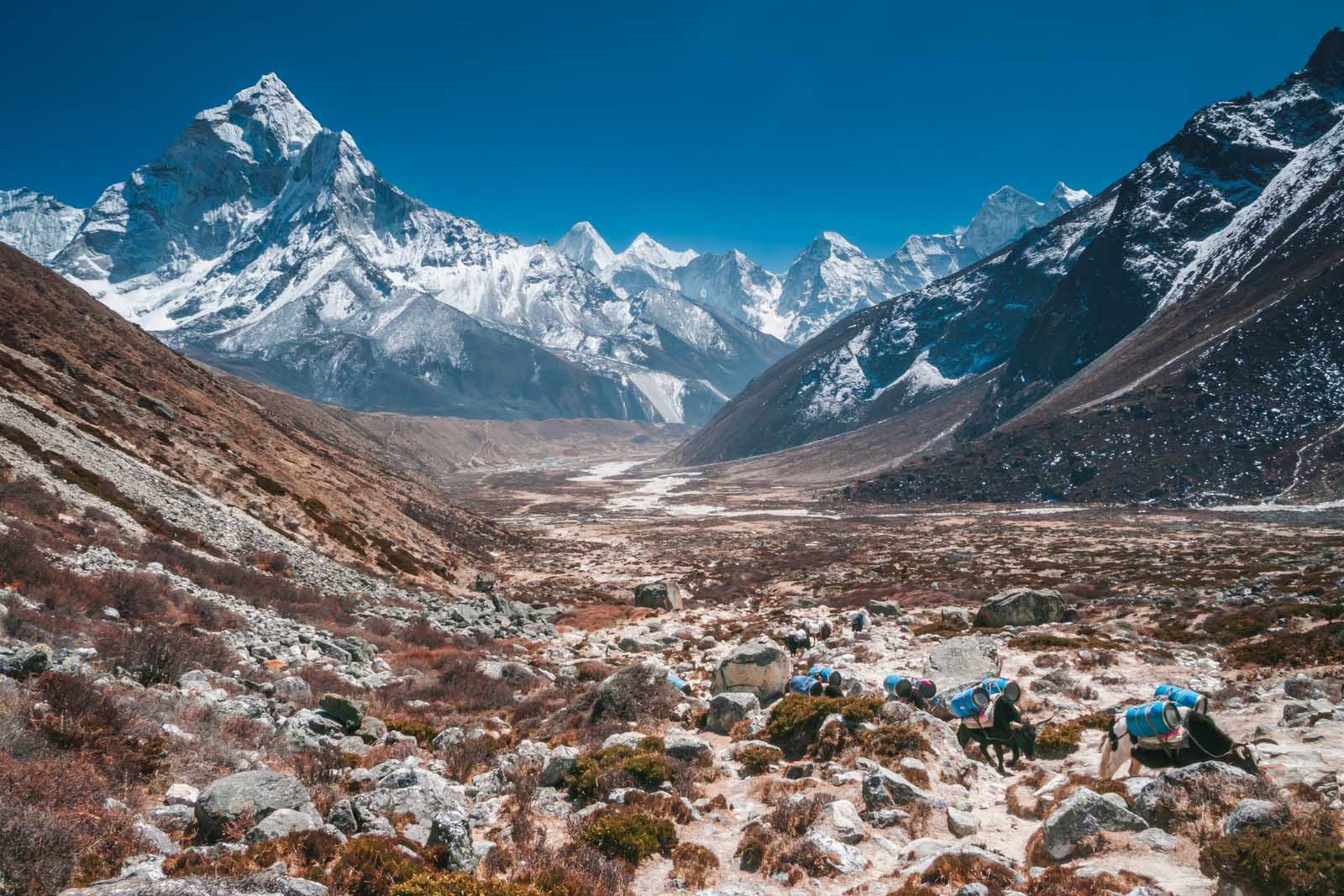
The next morning after a terrible night, we gave up our plans of climbing Kala Patthar and then on to the Gokyo Lakes and Cho La Pass trek. Even though I wasn’t feeling dizzy, nauseous, or lightheaded anymore, the sinus congestion was really getting to me. At altitude a cold can turn serious quickly, you just can’t take a chance when altitude is involved.
But, if we were going to trek on, this would be the next stop. It is supposed to be beautiful and if you are feeling up to it, we highly recommend it. This makes the trek much more interesting as you get to take a different way back to Lukla.
Cho La Pass: Altitude 5420 meters (17,782 feet) Gokyo Ri: 5357 Meters (17,575 feet) Gokyo Lakes: 4,700–5,000 m (15,400–16,400 ft)
Day 9 – The Descent and Kala Patthar
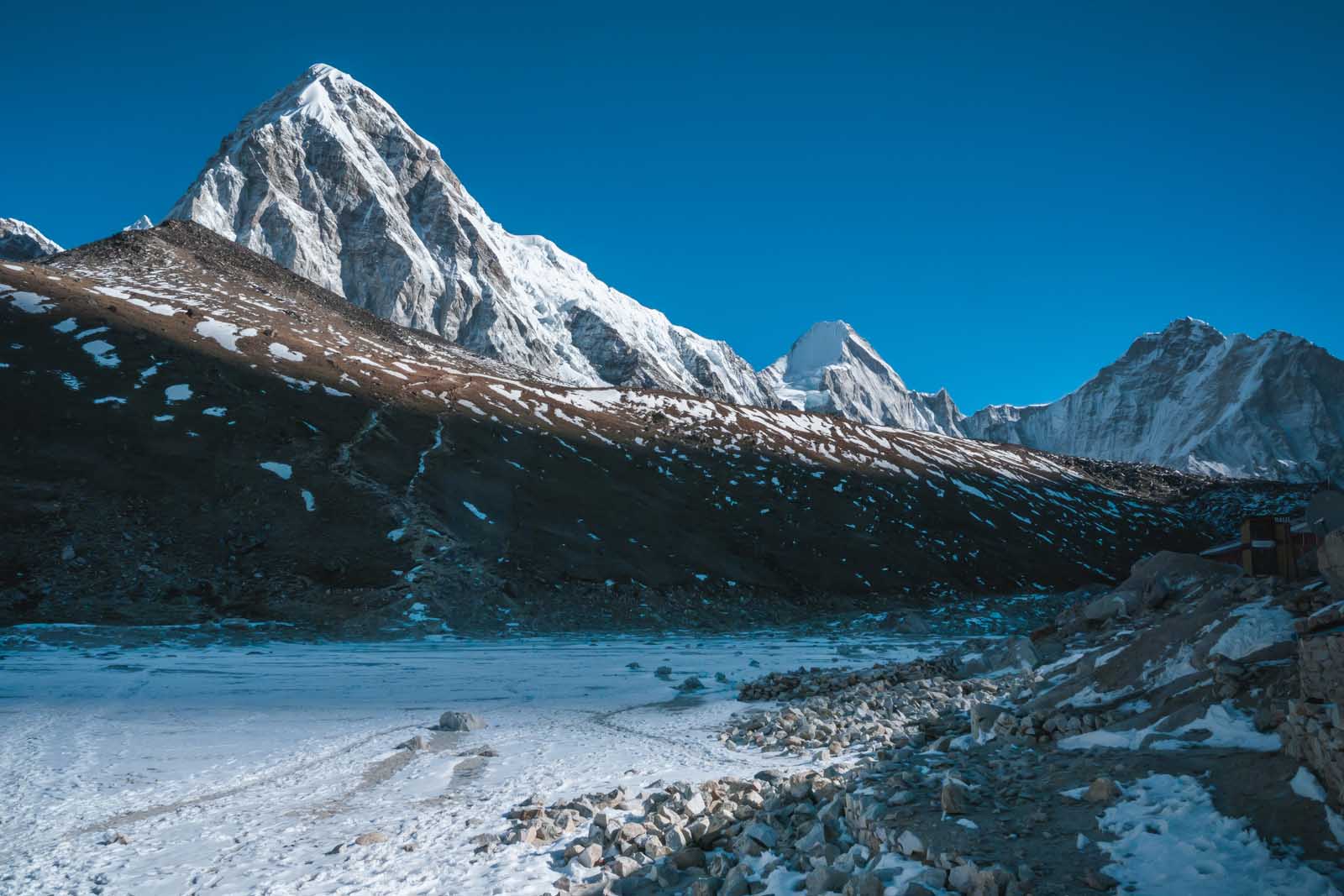
Kala Patthar is a hill above Gorak Shep that offers the best views of Everest and is a must-stop on anyone’s Everest Base Camp trekking route. We had planned to climb to the summit of Kala Patthar, but my congestion was so bad, that we decided it was safer to get to a lower elevation quickly.
Kala Patthar is a quick two-hour trek to add to your descent back to Lukla. It is a good option if you are feeling up for it as it gives a great view of Mt. Everest. Make sure to start early morning before dawn as there is still a long day of trekking after summiting Kala Pattar. Plan on another five or six hours to your next overnight stop at Pheriche.
Kala Patthar to Pheriche – Afternoon
By the time you reach your accommodation at Periche, you should be feeling a lot better. Dave and I find that we are fine in the 4000-meter ranges of altitude and experience very few symptoms of altitude sickness. It is at 5000 meters and above that, we start to feel our symptoms. Periche is a much more manageable 4371 meters.
Kala Pattar: 5643 metres Pheriche: 4371 Meters Altitude Loss : 1272
Days 10 to 11 – The Descent from Everest Base Camp
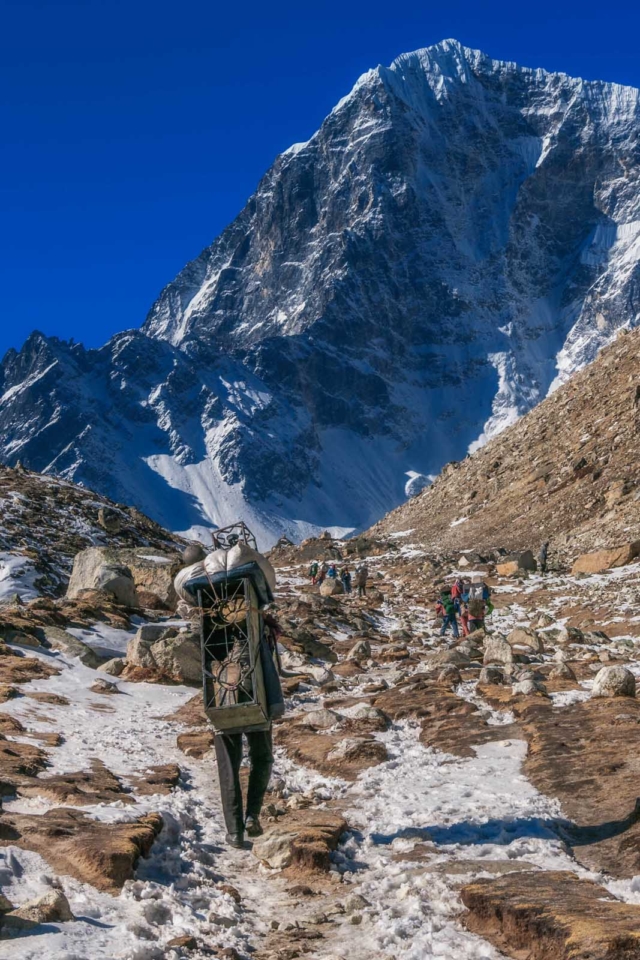
It took us two days more to trek back from Everest Base Camp to our final destination on the EBC Trek. I started feeling better on the second day as the dryness of the Everest base camp disappeared. My sinuses cleared and soon I was breathing easily. I started to feel guilty about turning around, but in hindsight, I know it was the right choice. You never want to take a chance with altitude sickness.
Even though we were heading down, there is still a lot of altitude gain as the EBC trek doesn’t continuously go downhill. I was feeling really fatigued and we still had a tough couple of days ahead of us. But knowing there was light at the end of the tunnel made everything easier.
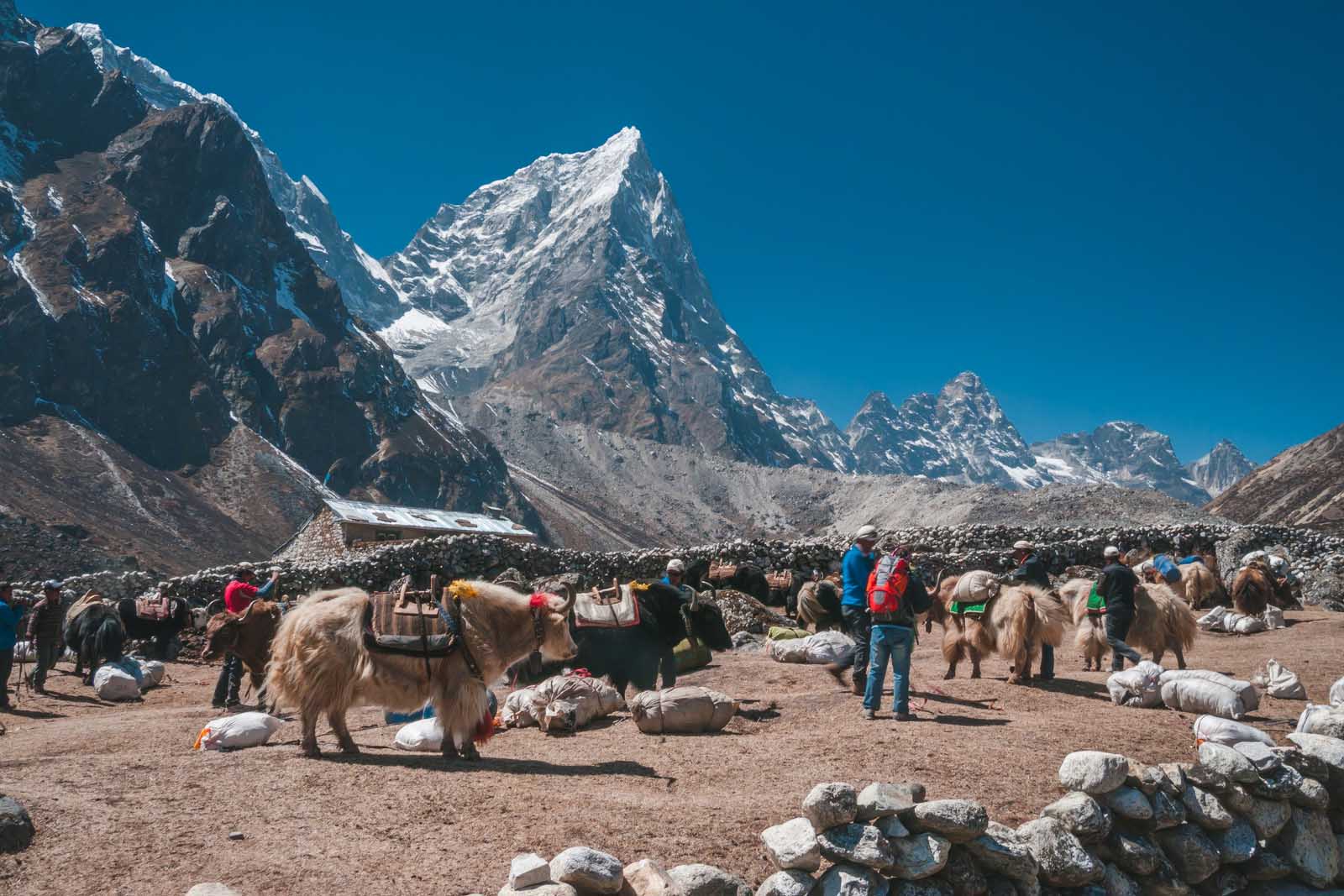
It takes a lot of mental stamina to climb back down as the euphoria of reaching the Everest base camp has worn off, but we made the most of it, by chatting with other trekkers and getting to know our guides better.
During our decent we could actually take our time to smell the roses or should I say enjoy the trekking trail that ran through the stunning rhododendron forest.
Rhododendrons are beautiful flowering plants that bloom in different shades of pink, red, white, and purple. The rhododendron forest is particularly prominent in the areas of Phakding, Namche Bazaar, Tengboche, and Dingboche which we really didn’t notice until we made our way down the mountains.
We followed the route we came up with, but it was much faster and we stayed in different villages. The beauty of booking organized trips with a local guide is that our guide Dipendra knew the routes like the back of his hand, so he could change accommodations easily to suit our speed.
Day 12 – Lukla
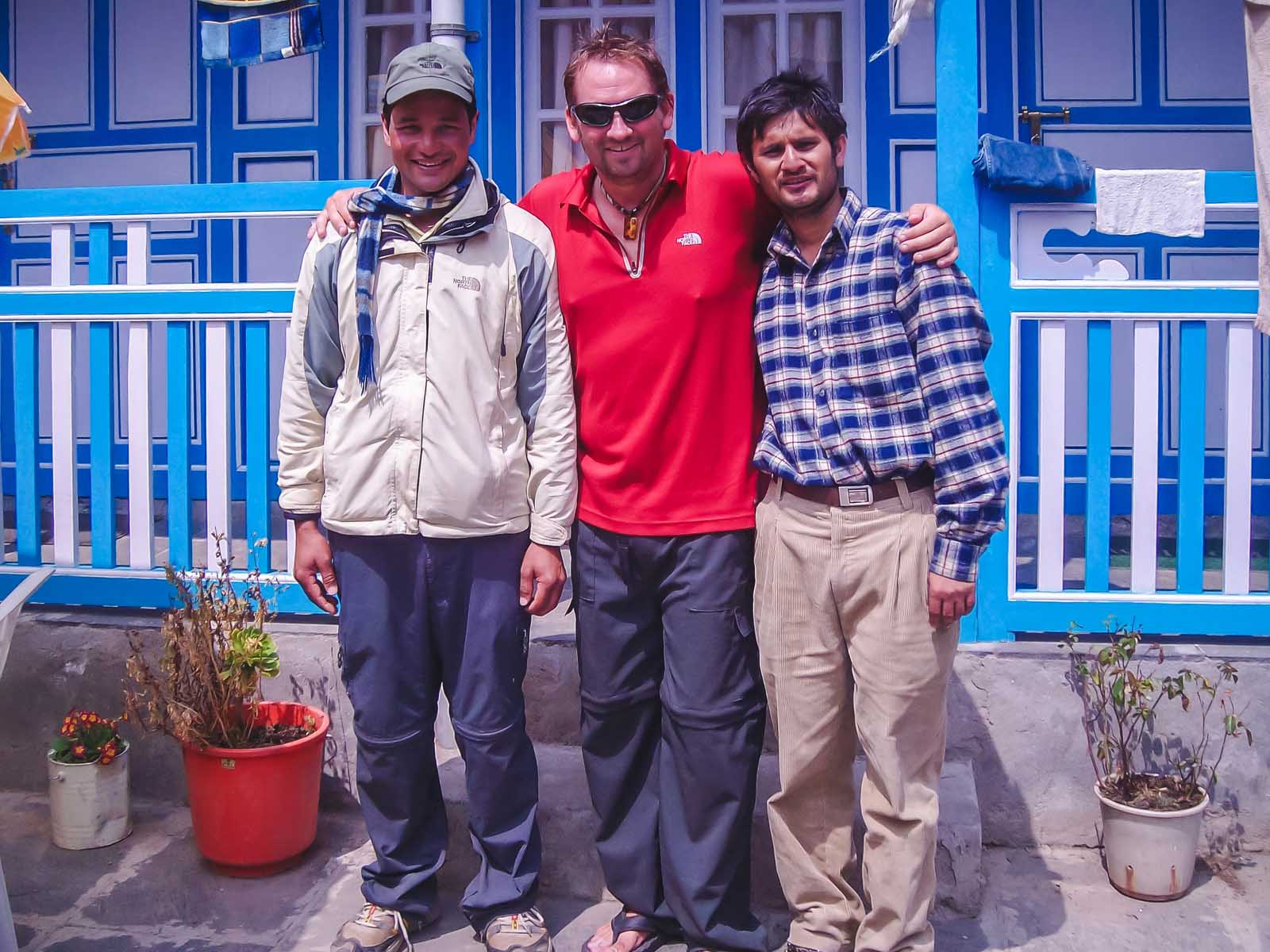
We were back in Lukla early on day 12 of our EBC Trek and had an evening booked in a guest house here to catch the first flight from Lukla back to Kathmandu in the morning. As much as we loved our trip to Everest, we were excited to be moving on to explore more of Nepal.
The accommodation was pleasant with a lovely restaurant, hot shower, and warm and cozy beds. It was a great way to end the trip.
Day 13 – Return To Kathmandu Flight from Lukla Airport
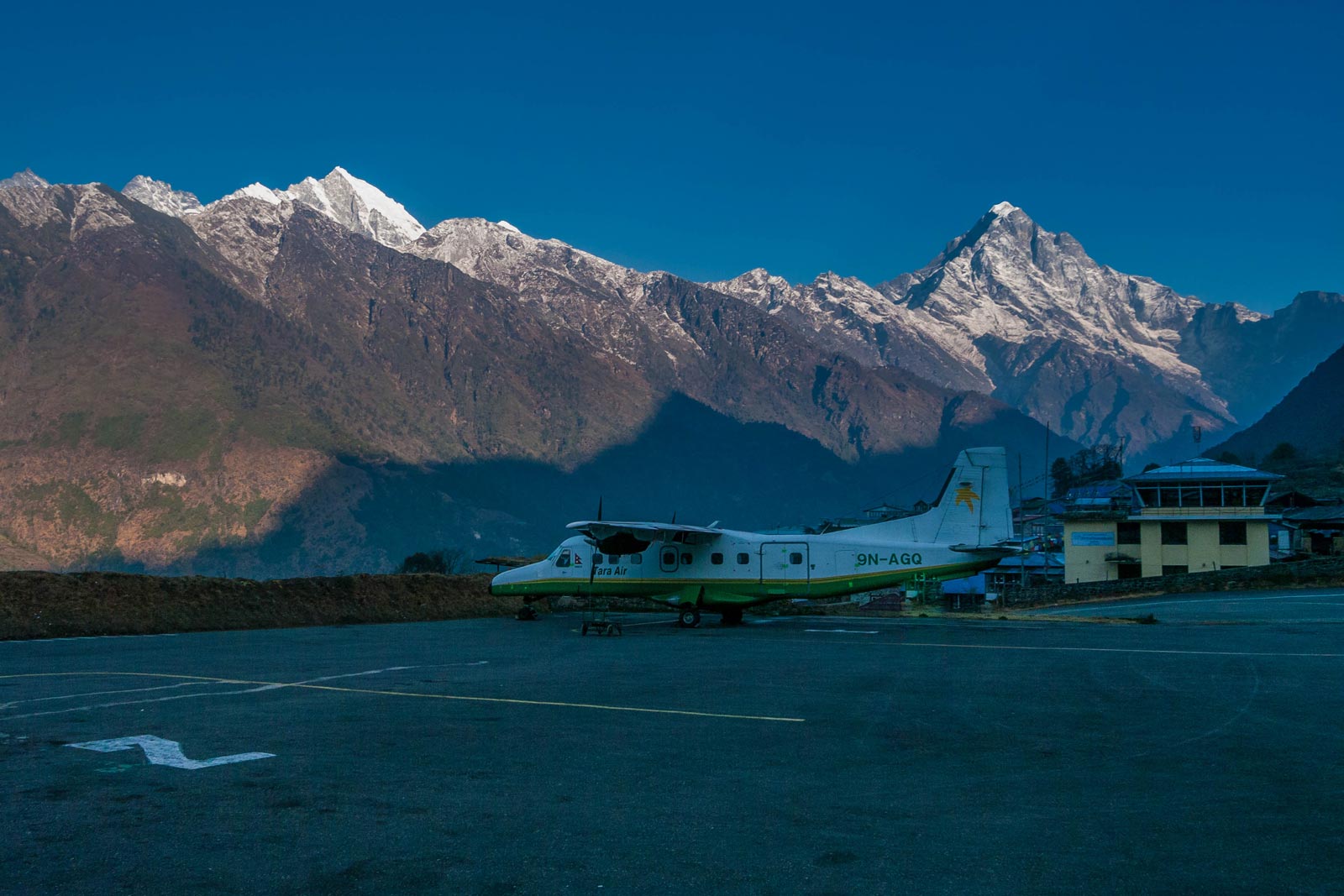
It is very important to give yourself an extra cushion when booking your return flight not only home from Kathmandu but from Lukla. We stayed overnight in Lukla on the final night of our trek and booked a flight to Kathmandu for first thing the next morning.
It is not uncommon for flights to be canceled or delayed flying out of Lukla Airport. Weather conditions change quickly. So give a bit of a cushion when booking your flight home from Nepal after you’ve finished your trek to Everest Base Camp. Many a traveler has missed their connecting flights home from Kathmandu because of delays in Lukla. It is safer to plan to spend a night or two in Kathmandu after your trek.
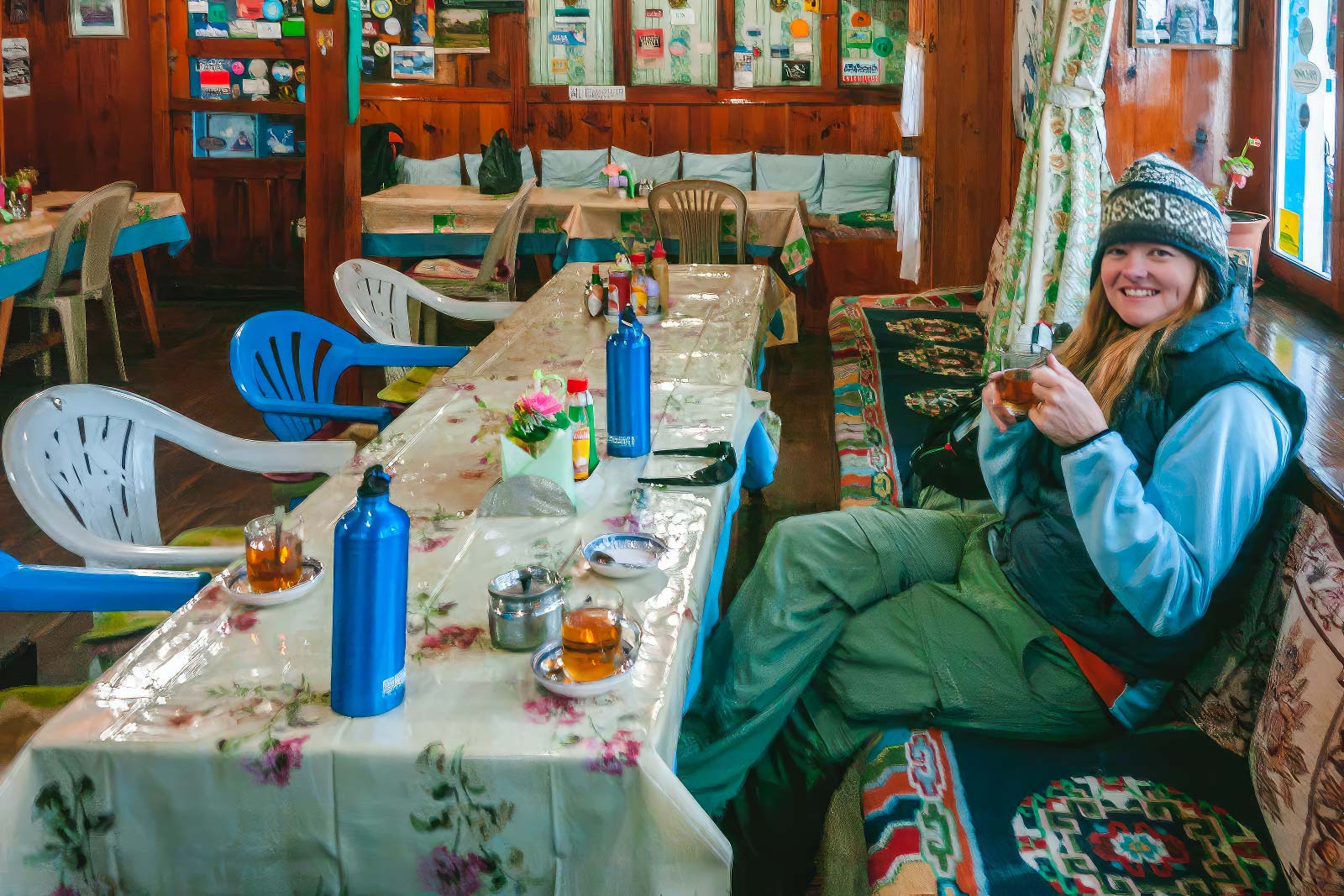
We were delayed an entire day. Even though we were booked on the first flight from Lukla, the weather made us wait until near sunset. We were the first (and only) flight out that day, so everyone else who was waiting for their flights all day was stuck another night.
It was a bumpy flight back to Kathmandu and we almost wished that we didn’t make it on the flight. The turbulence was so bad, I was sure we were going to drop out of the sky.
Everyone on the flight was silent as we were tossed about dropping huge amounts of elevation at a time. But we landed and we have never been so happy to arrive in Kathmandu. We kissed the ground, thankful to have trekked to Everest Base Camp, but vowed to never do it again.
Accommodation – Tea Houses on Everest Base Camp
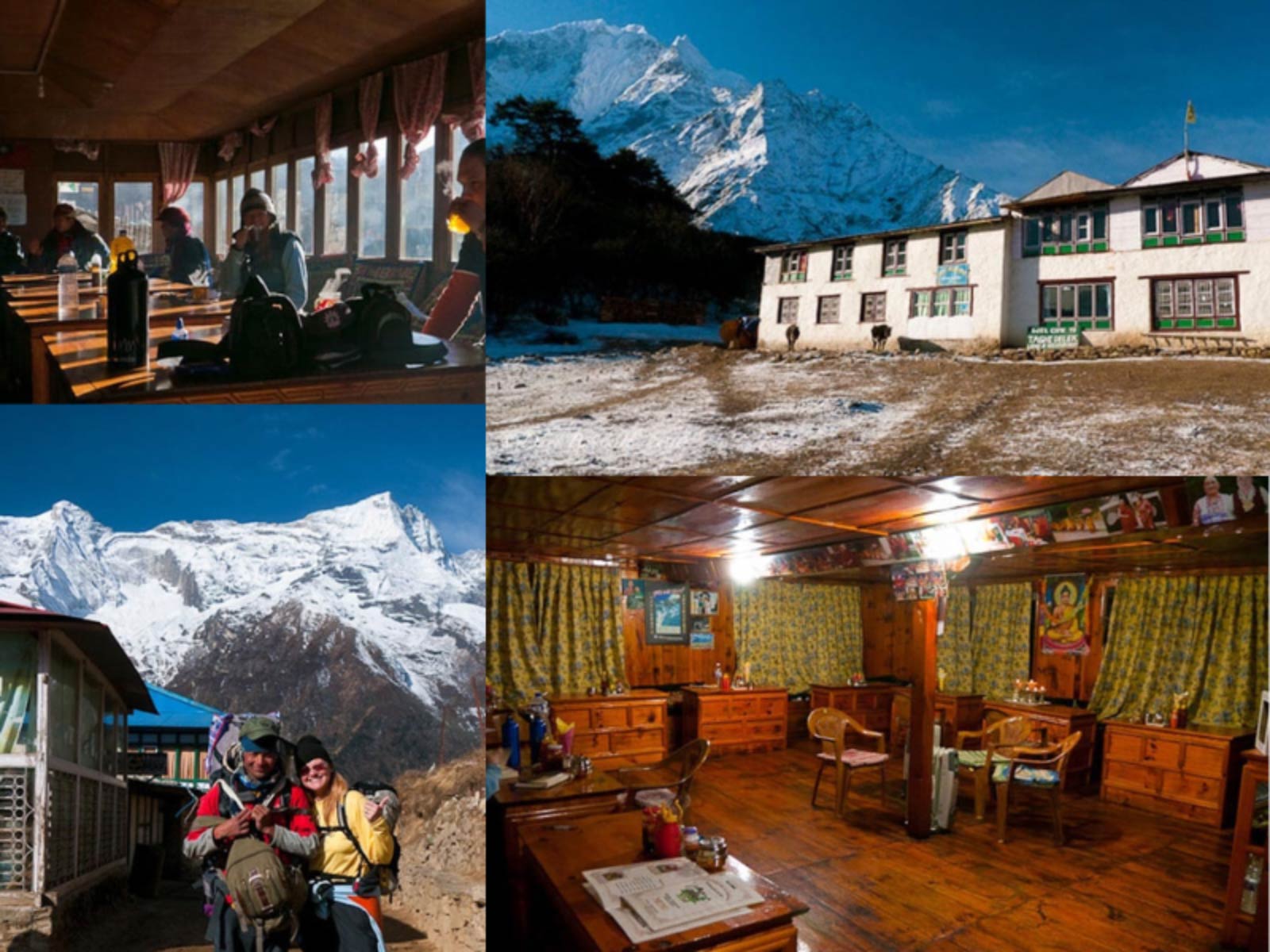
The main lodges of each teahouse we stayed in during the first half of our trip were cozy and warm. At the lower elevations, woodstoves burned wood in the dining room and common areas and our rooms were a comfortable temperature as we were wrapped up in our sleeping bags.
But as we ventured higher, the stoves were less abundant and instead of wood, they burned yak dung. You heard me, Yak Dung. Wood can’t burn in thin air, so they use yak dung to heat the teahouses at high elevations. Rooms are not heated so when we went to our rooms, we had to wear hats, thick socks, puffy coats, and long johns.
There were charging stations at the accommodation for electronics and we paid by the hour for electricity.
- We highly recommend taking a portable USB charger to charge your own electronics.
- We also used a solar USB charger that recharged during the day as we hiked.
Meals on Everest Base Camp
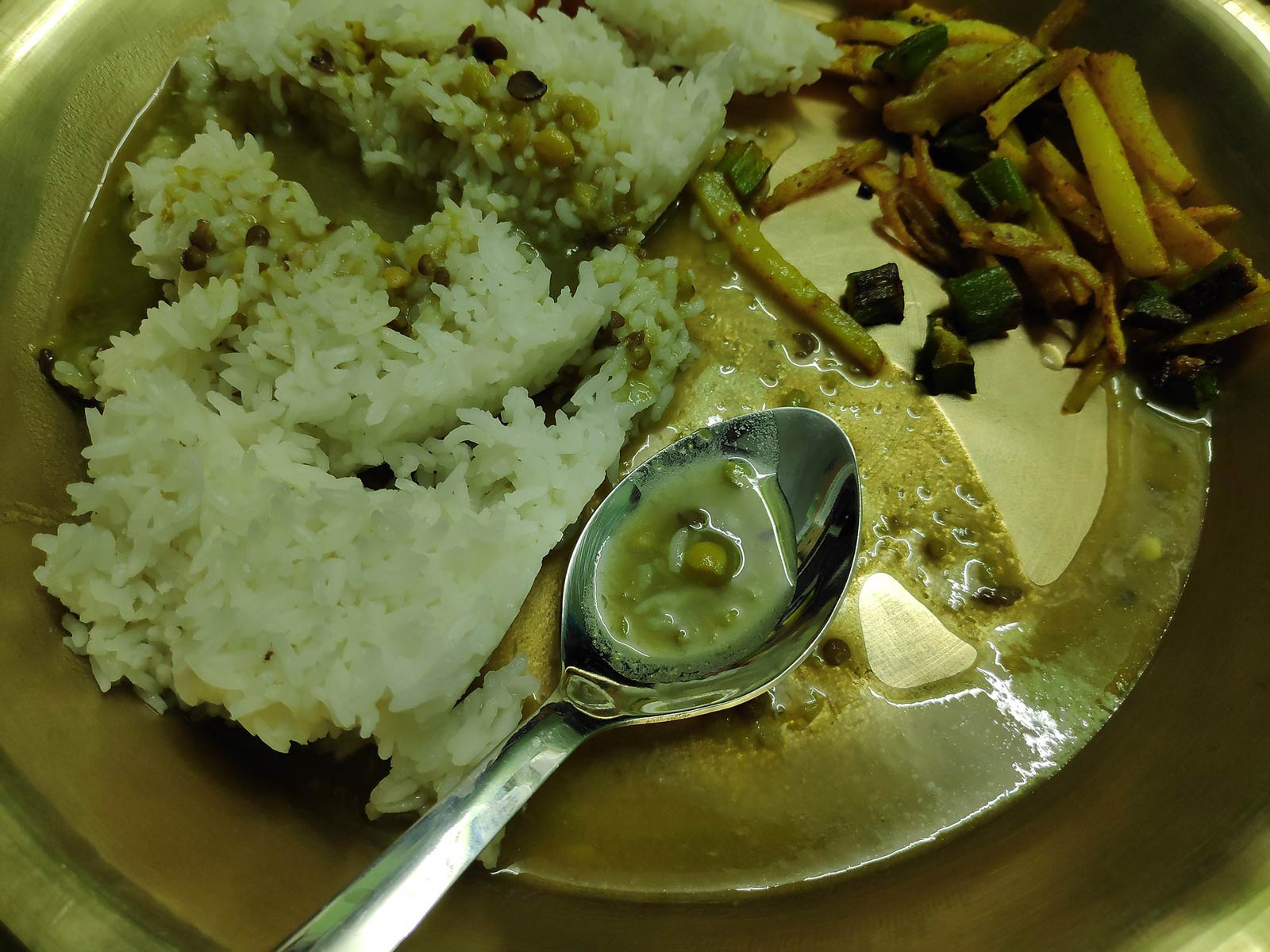
Because we booked an all-inclusive Everest Base Camp trek with Simrik Real Nepal tour company, all meals and snacks were included with our accommodation. Each evening, hearty meals were served that included pasta, rice, or Dal Bhat. Dal Bhat is the staple food of Nepal consisting of lentils, vegetables, steamed rice, and curry.
For the first few days, meat was served at meals, but as you climb higher, meals turned to vegetarian as it is more difficult to get the meat up the mountains.
Prayer Flags and Prayer Wheels – EBC Trek Etiquette
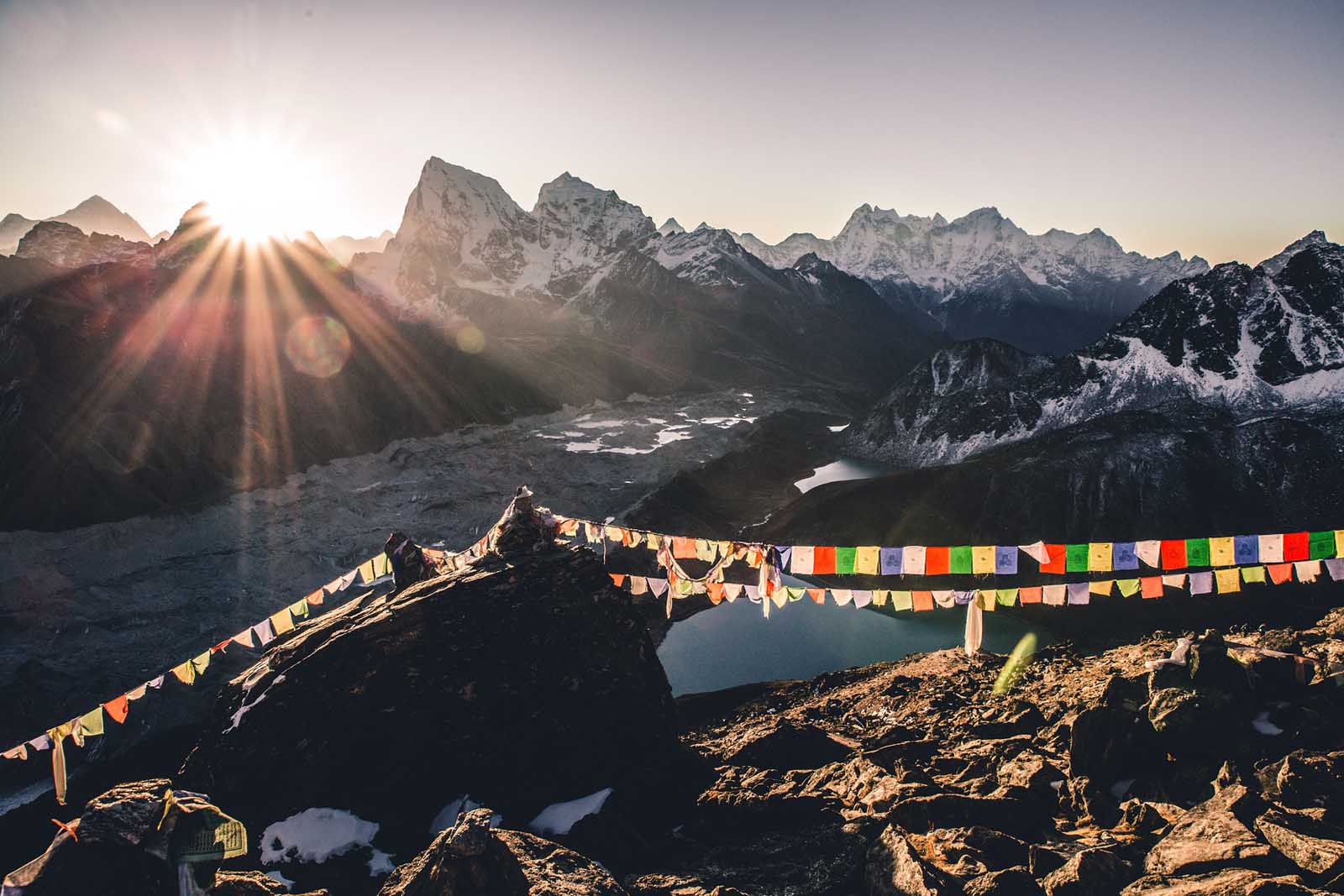
We saw many prayer wheels, prayer flags, and prayer rocks (mani stones) all along the trail to Everest. Everest is a sacred mountain and these monuments help give luck to the climbers on the mountain. There are customs to be followed when approaching prayer rocks or prayer wheels.
How to properly trek around prayer Wheels and Prayer Rocks
- When approaching a prayer rock, it is important to walk to the left of the prayer rocks (mani stones) in a clockwise direction. The stone on the right means you are on the “right hand of God.”
- When using prayer wheels, you walk along and spin them to ask for blessings for the climb ahead.
- Sherpas and locals spin prayer wheels saying the mantra “ Om Mani Padme Hum” giving blessings to the climb ahead.
- The prayer flags have prayers and mantras written on them which are believed to carry messages of positivity and to spread goodwill and compassion they are carried by the wind.
Altitude Sickness
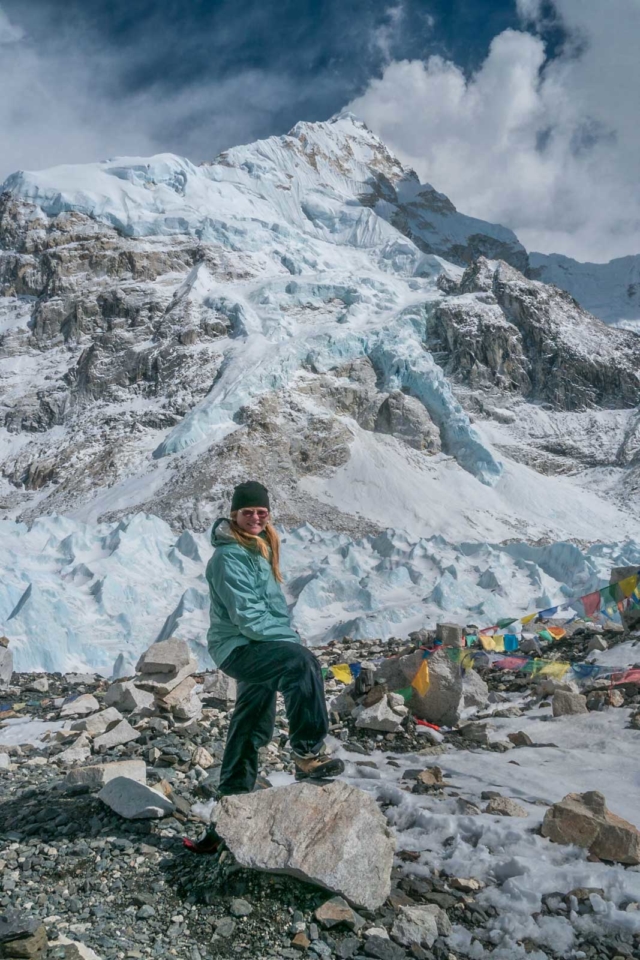
Altitude Sickness is a very real possibility on the EBC Trek. On average 3-5 people die each year doing the trek to Everest base camp. Make sure to keep an eye out for signs of Acute Mountain Sickness. Acute Mountain Sickness is life-threatening and early symptoms include nausea, headache, and vomiting. It can lead to death. The Best way to alleviate symptoms is to go down to a lower elevation.
If you start to feel dizzy, have a pounding headache, or if you start to vomit go down to a lower altitude as quickly as possible. Take your time climbing, stay hydrated, and listen to your body.
Drink plenty of fluids, try to eat, and rest regularly. It is better to walk slowly and steadily rather than rushing at high altitudes. And when you get to your accommodations each day, relax as much as possible.
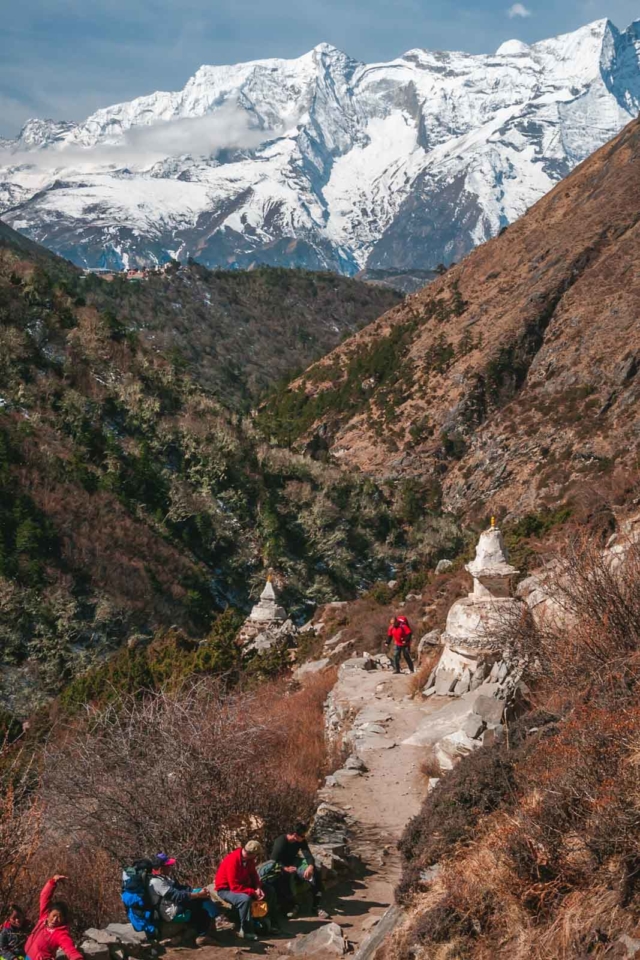
It can be dangerous trekking to Everest Base Camp from falling off the mountain to succumbing to altitude sickness. Some people have simply disappeared. Hiring a guide is a good option (and now the only option) for safety and it is very important to look for signals of altitude-related sickness.
But the Everest basecamp trek isn’t nearly as dangerous as climbing to the summit of Mt Everest. In 2019, 11 people died while trying to summit Mount Everest.
The village of Lukla is located at a high elevation so you will feel the effects of the thin air as soon as you land. The elevation of Lukla, Nepal is 2869 meters (9,350 feet). We were short of breath and already feeling fatigued upon landing. So instead of immediately starting our trek, we had a hot breakfast at one of the many restaurants in Lukla.
Travel Insurance for Everest Trek
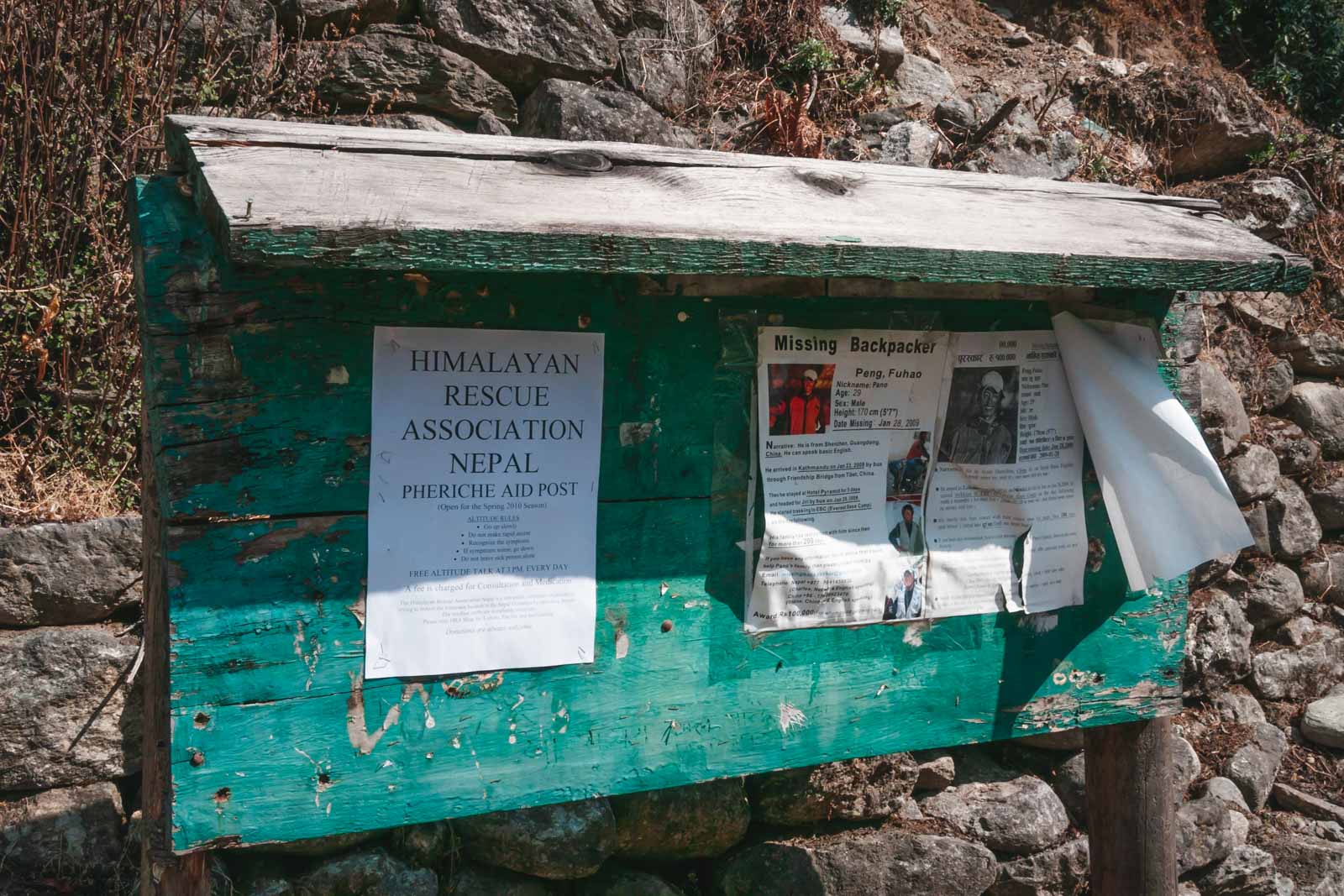
We always travel with travel insurance on our travels, but hiking to Everest Base Camp will not be covered by regular insurance providers. It is highly recommended to get supplemental comprehensive travel insurance that offers trip cancellation insurance, and medical evacuation insurance.
Medjet is a good option for medical evacuation insurance and is a good addition to your regular travel insurance. There is a very real possibility of altitude sickness and we knew of two people that needed helicopter rescues during our trek.
World Nomads offers specific Everest Base Camp Insurance. You can check them out to get a quote. I would suggest a combination of World Nomads travel insurance and Medjet medical evacuation insurance. Regardless of what travel insurance you choose, be sure to call them directly to ask for specific advice about trekking to Everest Base Camp.
For a trip like Everest Base Camp, you will want to make sure to have trip interruption and trip cancellation insurance as well as lost luggage. This is a trip of a lifetime, so make sure you have a backup plan.
Can you Trek Independently to Everest Base Camp?
As of April 1, 2023, Nepal has banned solo trekking. Foreigners must hire a guide for treks in high-altitude trekking regions of national parks. According to the Kathmandu Post in March, “ solo or independent trekkers have to mandatorily hire a guide or a porter before setting off to Nepal’s mountains.” However, after an updated article in the Kathmandu Post, it seems that the Everest Region is an exception. Before booking, we would check with local companies and authorities as rules are constantly changing.
Regardless, we loved hiring a local guide to make oure experience richer, to support the local economy and to feel safer hi
- Our all-inclusive Everest Base Camp Trek through the Simrik Real Nepal included return flights from Lukla, food, lodging, guiding, and all permits and paperwork.
- We didn’t have to search for accommodation at the end of each day of trekking
- We had English-speaking guides and a porter.
- We had our own room, but you can also share rooms on the EBC Trek
- We never worried about the cost of meals. They were all prepaid.
- And our guide (Dipendra) and porter were part of the package for the trip.
Costs for Everest Base Camp Trek
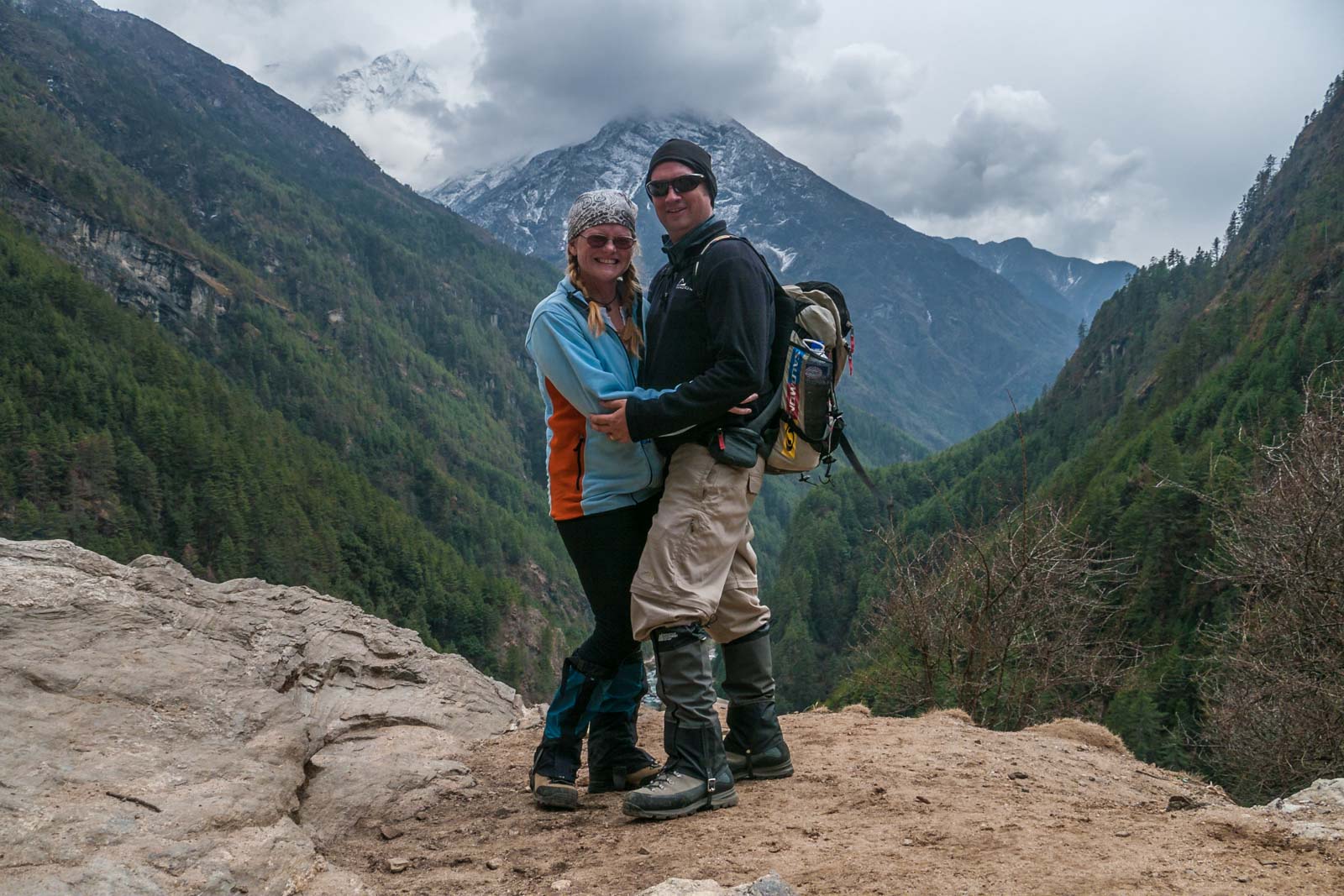
Prices can vary greatly for trekking to Everest Base Camp. You can contact Simrik Real Nepal for up to date prices.
- Booking with an international agency can cost from $1800 – $5000 USD
- Booking with a local agency and be anywhere from $1400 – $2500
W hen is the Best time to Trek to Base Camp?
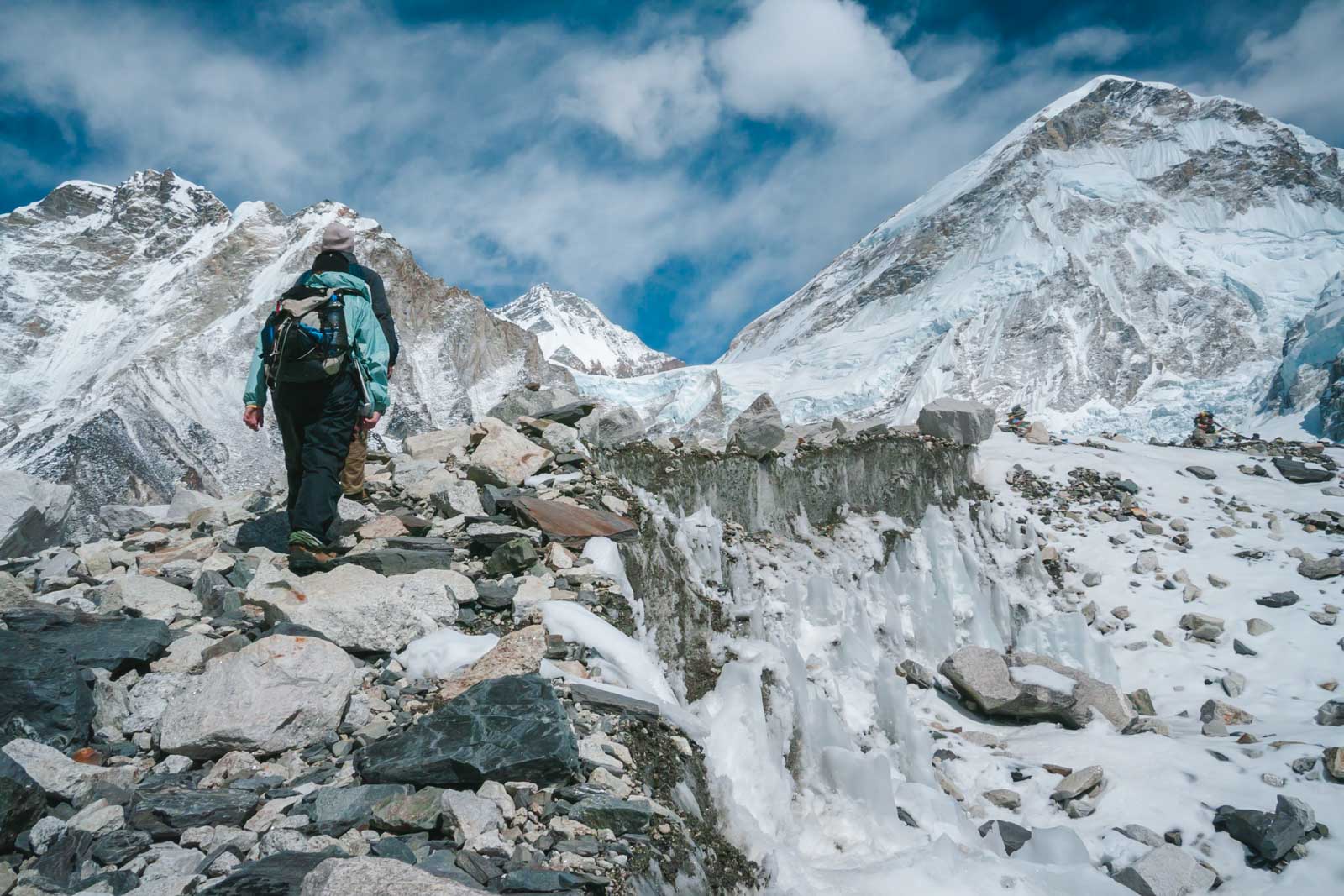
The high season for treks is April to May and October to November. We climbed in early March and felt that it was the perfect time of the year. The weather was beautiful, the skies were clear and the official climbing season hadn’t picked up yet. So we had a lot of the mountain to ourselves. We had heard stories of how busy the trail is, but at this time of year, it was quite deserted.
But a week and a half after our trek started as we made our way back to Lukla, it was already busier. We saw a lot of parties climbing up and the trail was getting congested. I can only imagine how packed the trails are during the high season.
What to Pack For Your Everest Base Camp Trek
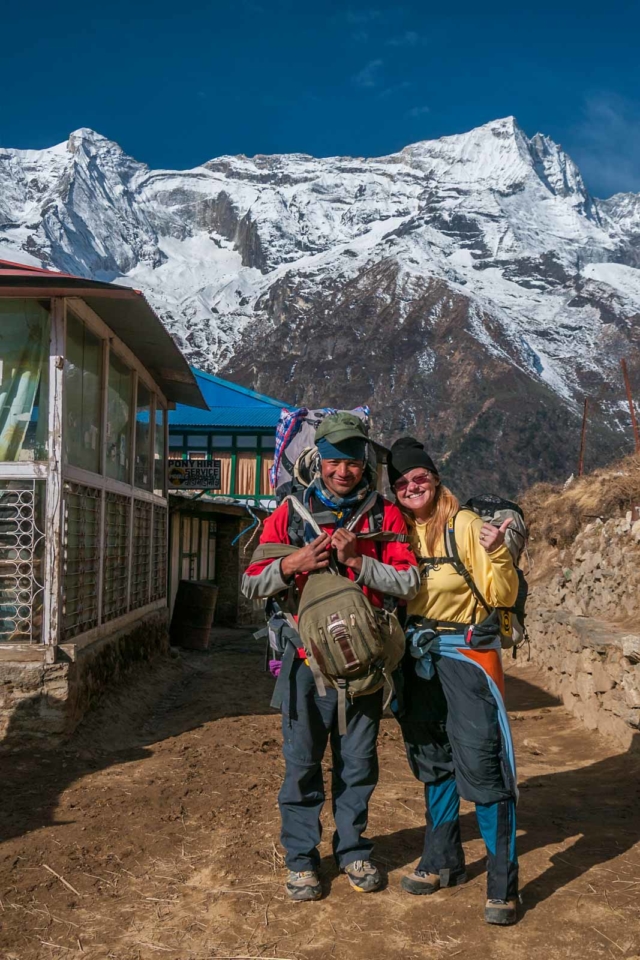
Layering is extremely important when trekking to Everest Base Camp. This is a quick guide for clothing but we wrote a complete packing guide for base camp here .
Make sure to have a day pack to carry the important items and layers that you will need for your day of trekking for the entire trek. Your porter will carry everything else.
- 2 quick drying long sleeved base layer shirts
- 2 trekking shirts short sleeve
- 2 Thermal Base Layer – 2 leggings/2shirts
- 2 liner socks
- 3 pairs of woolen blend trekking socks
- 2 pairs of trekking pants with zip-off bottoms
- 2 fleece sweaters – one lightweight, one heavier
- Outer windproof jacket and pants
- 2 water bottles to fill regularly
- Steripen or Lifestraw – this is great for purifying water
- Portable USB Charger
- Basic First Aid Kit – A first aid kit is important to have but your guide, they will have one as well.
- Warm sleeping bag. If you don’t have a sleeping bag rated to below zero, we recommend renting one from your guding company.
Treats and Medication
- Tang – I was glad we packed Tang for our water. It made it taste better, keeping us well-hydrated. We didn’t really want to drink just water, but the Tang (which we bought in Kathmandu) was actually delicious. Gatorade or another electrolyte-replenishing drink is a great idea.
- Diamox – (You can buy this in Kathmandu without a prescription) I highly recommend using Diamox tablets for altitude sickness as well. We met so many people suffering from headaches, dizziness, and fatigue and they weren’t taking anything. We’ve always used Diamox when climbing to altitude and it has worked beautifully for us.
- Chocolate – When we were feeling ill, we were happy to have chocolate to eat. It was the only thing that we could eat at times.
How to Get Fresh Water on An Everest Trek
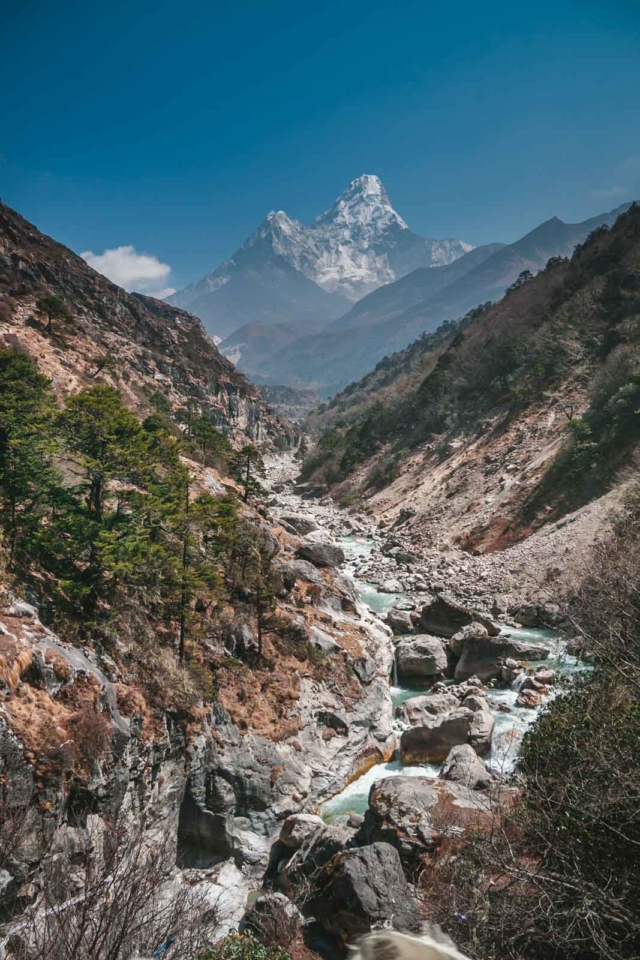
We recommend two refillable water bottles per person that can be refilled along the way. You can fill up anywhere for free along the Everest Base Camp route, but make sure you have a SteriPen or some other form of water purification with you. We love the SteriPen for purifying water, see our review here.
You can also use the LifeStraw or water purification tablets , but once we discovered the SteriPen , we never went back. See our complete Packing a Travel First Aid Kit here
Do You Need Climbing Experience for Everest Base Camp Trek?
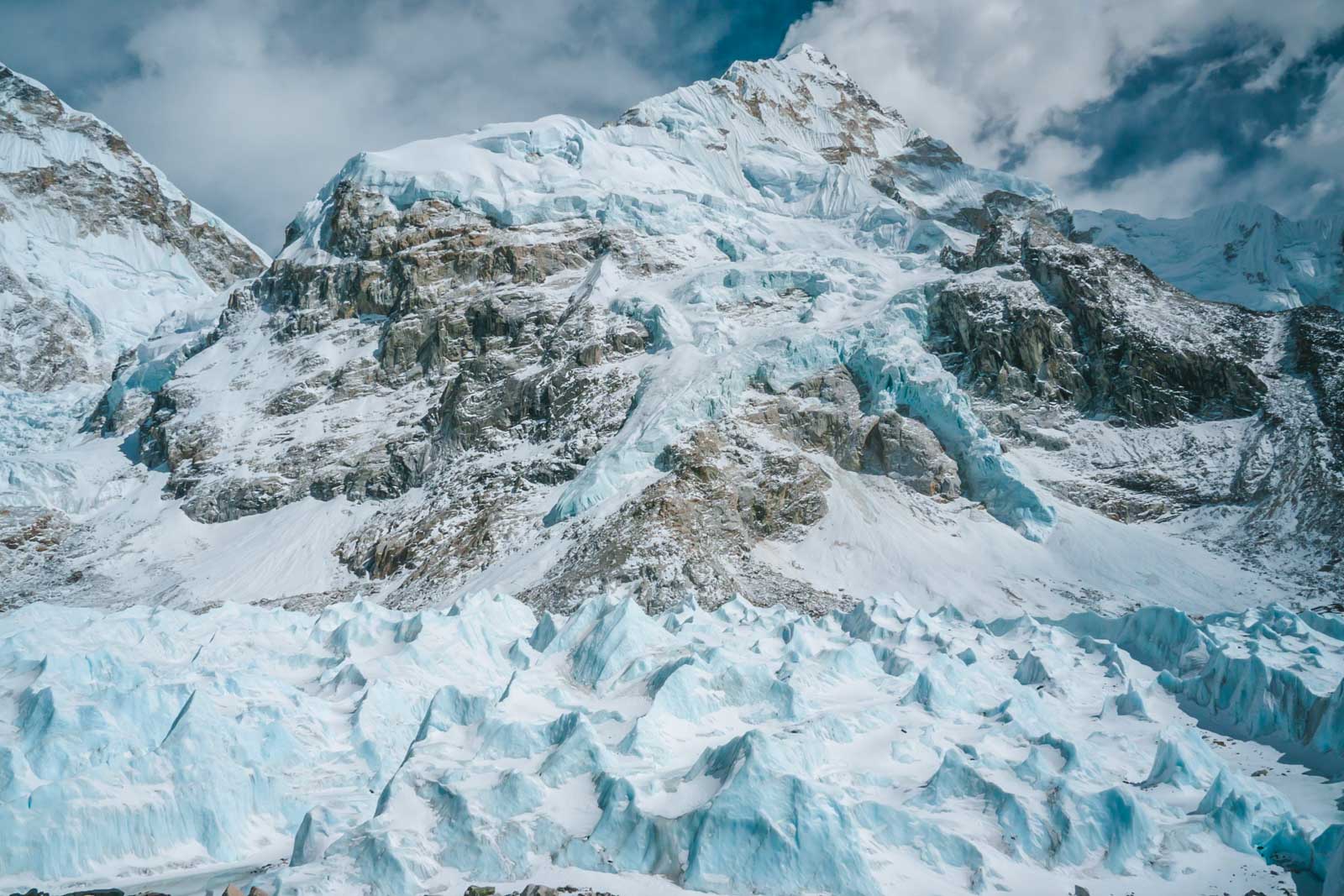
There is no need for any technical climbing experience to make it to Everest Base Camp. If you are relatively fit, it is very doable. But it is a full two weeks at a sustained altitude of over 4000 meters.
We didn’t train for our Everest Base Camp Trek but we had been to altitude before and had spent a lot of time backpacking leading up to the months prior. It’s good to know how your body reacts to altitude. We suggested doing a couple of treks above 3000 meters (9000 feet) to see how your body reacts.
Hot Tips for Trekking to EBC
- Keep your camera batteries close to your body when not in use. The cold and altitude really eat up battery life, so you will want to keep them warm for as long as you can.
- Bring USD, ATM Fees are high and you are limited to the amounts you can take out of the ATM, so have ISD to exchange instead.
- Pack handi wipes and Gold Bond Powder – it’s a lifesaver when you can’t get hot showers.
- See our Full list of Everest Base Camp Tips here.
How to Get to Everest Base Camp
There are daily flights to Kathmandu International Airport from international hubs around the world.
Where to Book Your Everest Base Camp Trek
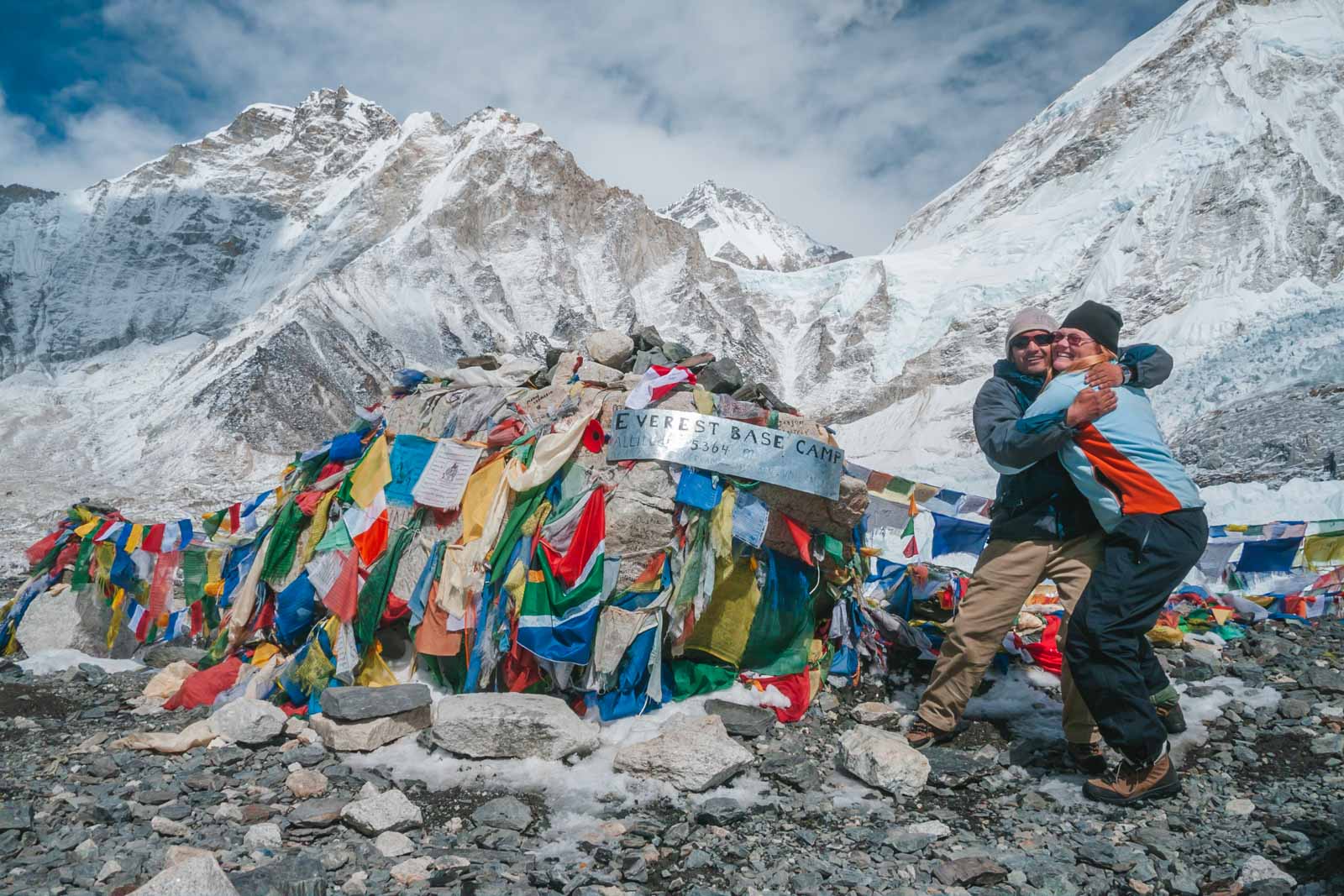
We booked our trek in Kathmandu with Local Guide Dipendra of Simrik Real Nepal. If you are looking for a local guide he is an excellent choice with nearly 20 years of experience in the mighty Himalayas.
Prices for the Everest base camp trek cost can vary depending on where you book. Group tours booked in North America will charge more. Ranging from $1500 – $5000 USD
You can save a lot of money by booking a local guide as you will cut out the middleman prices. Having a local guide let us know our money was going directly to the Nepal economy. Check with Simrik Real Nepal for current prices.
How Much to Tip Guides and Porters for an EBC Trek
Guides and porters in Nepal do not make a lot of money and rely on tipping. When we take tours of any kind, we (ourselves) tip 15% – 20% but that is a part of our culture in North America, we are quite large tippers and realize that others are not comfortable with that. We’ve done a lot of research and gone by what our tour companies have suggested on other tips, what we feel is a fair tip and what the average is across the internet.
For tipping in Nepal we have broken down the cost for a guide and porter.
Guide – Tipping – 10% – 15% of the total cost of the trip. We find this the easiest to figure out. If you paid $2000 for your trek, the lead guide should receive $200 – $300
Guide per day – Some suggest $10 – $15 per day per person for guides – For a 14 day trek that means you would tip your guide $140 – $210.
Porters per day – $5 – $10 per day per person for porters. – $70 – $140 for your porter.
We like to start at 15% of the total cost of our trips to give to the guides and then pay the porters a daily fee of $10.
If you can afford to trek to Everest Base Camp, you should be able to tip your guides and porters who have worked so hard accordingly.
Daily Life in the Everest Region of Nepal
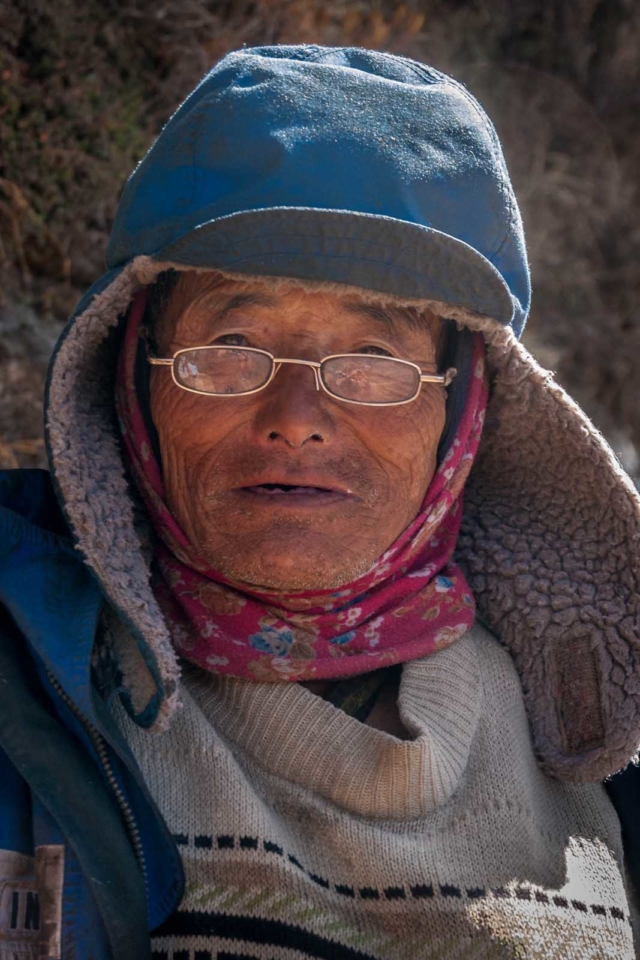
While trekking to Everest we passed through many picturesque villages. The people are friendly and life goes on as it would in any community in Nepal. People do well in the Khumbu Region and they respect the tours passing through because the tourists are what keep them going.
There is electricity from the water that they harness from the Imja Khola River and Dudh Kosi River; two rivers that run through the trek. They also have solar power for electricity as well. There are schools, fresh running water, televisions, a health clinic, and bars.
That is not to say that life is all roses. It is a remote region of Nepal and it is difficult to get any supplies in. Food and equipment need to be carried into villages on foot. Porters carry heavy loads on their backs and women and children also do the heavy lifting. Everything needs to be carted in by hand or by animals. Check out our tips for climbing to Base Camp
How Long Does it Take to Trek to Everest Base Camp?
The Everest base camp trek takes 12 – 14 days to climb including two acclimatization days. Treks can be done in 11 days and it is not uncommon for trips to take 15 days to allow for more acclimatization.
How Difficult is it to trek to Everest Base Camp?
Trekking to Everest Base Camp requires good fitness. You spend several days at a sustained altitude of more than 4000 meters (16,404 feet). Altitude sickness is a genuine possibility, it is important to take your time, stay hydrated, and listen to your body.
Can you trek to Everest Base Camp on your own?
As of April 1, 2023 the government states that all high altititude treks require a guide, but then after some backlash, they made an exception for the Everest region. However, we highly recommend hiring guides and porters . You can trek the region yourself carrying your own packs and gear, but you have a much better chance of making to base camp (and enjoying the experience) if you hire guides.
How Long is the Everest Base Camp Trek?
The trek is 63km (39 miles) each way . 126 km (78 miles) round trip from Lukla. Expect to hike anywhere between 7 to 17 km per day.
And that is a day-by-day breakdown of our experience on the Mount Everest Base Camp Trek. If you plan ahead and understand what to expect on the EBC Trek, you will be sure to have an amazing journey.
It’s an experience we’ll never forget and highly recommend it to everyone. The Himalayan Mountains are the most beautiful and spiritual place on earth and this trip will change your life.
Read More about travel to Nepal and things to do in Kathmandu before your trek
- Flight to Lukla
- Packing list for Everest Base Camp
- Remarkable Everest Base Camp Trek in Photos
- 30 Tips for Trekking to Everest Base Camp
- Nepal Travel Guide
- Top 6 Places to visit in Kathmandu, Nepal
- Where to Eat in Kathmandu – Eight Great Spots to Indulge After Your Trek
- The Ultimate Travel Songs Playlist to Inspire Wanderlust
Dal Bhat photograph courtesy of Wikimedia – I don’t know why we never took a photo of our Dal Bhat. We ate it nearly every day while trekking to Everest Base Camp. You’ll either learn to love it or despise it.
- Inca Trail – Machu Picchu Hiking Tips – How To Hike the Inca Trail
- Complete Guide to Climbing Mount Kilimanjaro – How Hard is It?
- Top 13 Best Treks in Nepal to Help you Choose The Right Trek for you
- Trolltunga Hike – Trekking to Norway’s Most Famous Landmark
- The Complete Guide to Climbing Mount Fuji
Travel Planning Resources
Looking to book your next trip? Why not use these resources that are tried and tested by yours truly.
Flights: Start planning your trip by finding the best flight deals on Skyscanner
Book your Hotel: Find the best prices on hotels with these two providers. If you are located in Europe use Booking.com and if you are anywhere else use TripAdvisor
Find Apartment Rentals: You will find the cheapest prices on apartment rentals with VRBO .
Travel Insurance: Don't leave home without it. Here is what we recommend:
- Allianz - Occasional Travelers.
- Medjet - Global air medical transport and travel security.
Need more help planning your trip? Make sure to check out our Resources Page where we highlight all the great companies that we trust when we are traveling.
You May Also Like
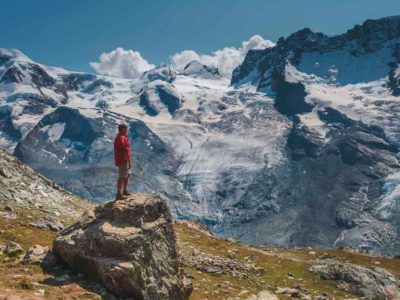
30 Beautiful and Best Hikes in the World
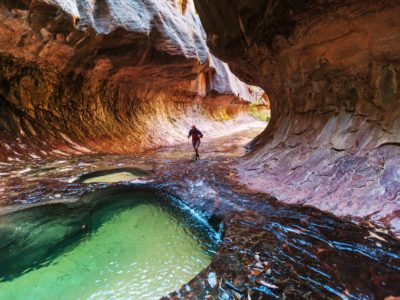
24 Best Hikes in the USA to Add to Your Bucket list
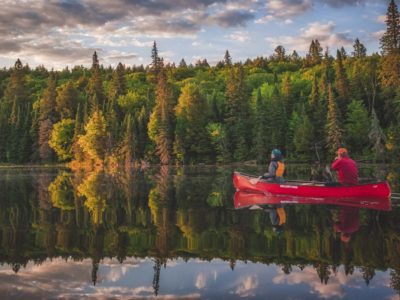
Weekend Warriors – 14 Awesome Hobbies to Turn You Into an Adventurer
About The Planet D
Dave Bouskill and Debra Corbeil are the owners and founders of The Planet D. After traveling to 115 countries, on all 7 continents over the past 13 years they have become one of the foremost experts in travel. Being recognized as top travel bloggers and influencers by the likes of Forbes Magazine , the Society of American Travel Writers and USA Today has allowed them to become leaders in their field.
Join thousands of others who get our monthly updates!
Leave a comment cancel reply.
Save my name, email, and website in this browser for the next time I comment.
53 thoughts on “Everest Base Camp Trek – Ultimate Guide For 2024”
Beautiful article! You have shared a thrilling journey with us till the end. It will definitely be useful for us trekkers. Thanks for the great pictures, videos, and useful tips!
This is a fantastic and unique post! After reading it, I learned a lot about Basecamp that I didn’t know before. Excellent article! That is true adventure, and conquering Mount Everest is without a doubt the goal of all hikers around the world. Keep up the excellent work. Thank you for providing this information.
Wow, the content has got all the details about the trek. Thank you so much for sharing your Journey experience of Everest Base Camp Nepal.
Hi There, Great Article! That’s the real adventure and especially climbing Mount Everest is the dream for all hikers across the globe without any doubt. Keep up the good work. Thanks for sharing.
Wow, the content has got all the details about the trek. Thank You so much for writing such an efficient article on Everest Base Camp Trek.
That’s the real adventure and especially climbing Mount Everest is the dream for all hikers across the globe without any doubt.
Thank you for taking the time and effort to produce such an awesome post with amazing pictures. Loved reading all your posts, really good insights here into Everest Base Camp ! Looking forward to read more.
Nice article on trekking best of luck for your new journeys
Dear Dave and Deb Namaste It is really beautiful article regards of Everest base camp trek in Nepal. Your article provides a lot details of the EBC trek. I’m sure your blog helping lot to organize other trekkers.
Excellent article. Everest Base camp is in my bucket list but I haven’t attempted because I’m prone to sickness quickly. Reading this article has triggered the interest even more. Thank you so much for explaining in detail about EBC trek. I hope One day I too can share my experience 🙂
Hey, I love trekking, I went last month with my friends in Nepal after reading your blog the memory are refreshed Thank you for sharing
Namaste, Dave and Dave, Thank you so much for sharing your Journey experience of Everest Base Camp Nepal. And also glad to read that why not support the local economy by hiring a guide and porter… I salute to your positive view. Visit Nepal anytime.
It is very interesting to read this Everest base camp trekking. I love trekking and i am excited very to do this base camp trekking once. Thanks for sharing.
This popped up in my inbox I love the way you break down your travel itinerary this way. I’m one of those people that love to know every detail of a place before travelling there myself. Another place to add to the list, thanks to you guys! Beautiful photographs.
Thank you for taking the time and effort to produce a terrific blog of your trek to EBC. I really appreciate being able to experience what it is going to be like before I actually arrive.
Everest is the highest mountain. It is at the Zenith. Most of the people just a dream of it.Very useful information. Thanks for sharing with us.
Excellent article !! Thanks for sharing such a great informative post it really helpful and amazing so keep it up and all the best………….
this was just amazing… keep sharing
The post was very informative. If you love adventure and treks you should definitely visit Nepal, it’s gonna be a life time experience. This post will really help people who are planning their next trek to Everest base camp. If you are planning your next trek to Nepal, North Nepal Trek can help you to make your trek much easier and will give you unique experience.
All of your photos are just awesome. Information is perfect.
Such an awesome post with amazing pictures. Thanks for sharing your experience with us.
This is really a very good blog post and thanks for sharing it with the community
It’s an informative post and I was thinking how you backpack for the weather? There are many things that somewhere can’t be cope at altitude like a sickness. I remember I scare when I attempt sky diving in Dubai. It’s was a wonderful experience but I have a fear of altitude places.
I have read about it but never tried. I am glad that at least i am reading such an informative article that clearly shows experience of treking over there. It might so much exciting and filled with happiness because seeing something like that would always be more of fun and achieving some of our own. Would love to try it once for sure!
Hi guys. Nice blog. Very informative. I just wonder, how did you prepare for the weather? How did you acclimatise so that you can cope with thr danger of altitude sickness? It is the ine thing that scares me to try to trek on high altitude places. To climb Kilimanjaro and to reach the EBC are in my bucket list. I’m hesitant because of my fear that I might die from cold temperature and altitude sickness.
Dress in layers, and drink plenty of water. You will want to bring DIamox with you and take it. You can get it in Kathmandu, or go to a travel clinic before leaving home. You won’t die from cold temperatures at Base Camp if you have a proper guide, and dress properly. The real dangers are if you are summitting Everest, that’s when you can get into problems, but Base Camp is very doable for anyone that is physically fit. If you don’t have the gear, you can buy winter coats, boots etc in Kathmandu. But we do recommend breaking in your boots beforehand, so you should buy those before you leave home and wear them a lot. Get warm, waterproof breathable boots with wool socks and bring several pairs. We have a guide to winter base layers to avoid the deep freeze here: https://theplanetd.com/layering-tips-for-cold-weather-travel/
Loved reading all your posts, some really good insights here into EBC! You mention putting your hair in braids, why is that? Is it because of the sweat? Is it windy so it gets knotted up? Just curious as I am doing this trek in a week and am open to all tips ?
Yes, hair can get really matted due to wind, dryness and lack of showering. The Braids kept it from matting up like dread locks. Have a great time!
Long hair can get very matted almost like dread locks. It’s becuase there aren’t a lot of chances to shower after Namche Baazar, the wind, sweat and dryness from altitude really takes its toll on both hair and skin and the braids, keep the hair from matting and breaking off.
Great read! Just curious. what time of year did you go to avoid the masses of tourists?
Thanks for sharing articles and videos it will be helpful to all people those wants to go Mount Everest.
This is just amazing and knowing each and every experience that we will have while travelling is another aspect that made me read this article fully. I am in Dubai now on a trip and would surely try to visit this place i could. I should consider the right time and other things roo. I must thank you for this wonderful piece.
Such a great journey you have shared from start to finish and your presentation is also impressive. I would love to follow these things when I will go for a camp tour.
Regards, Ronit
Your Video is superb, I feel your treking experience in this article. worth to read it.
Wow what an wonderful place is this. Want to trek this place in my life.
Great article, thanks, surprised at the early time of year you did the trek, but sounded ideal – any other good write-ups or links discussing the pros and cons of going in the spring vs fall? …weather, landscape, crowded w/ other trekkers, festivals, etc Thanks!
I am looking forward for this kind of base camp.
What an excellent post!! Thank you so much for an informative article and personal feel. This is very helpful and inspiring for my upcoming trek to Everest Base Camp.
There is so great view in pictures.it’s useful and helpful for the trekkers .i like these types of views .and tourist are also love these types of views.
Anyways amazing photos and love the videos! really gives you a feeling how it is there and must be just thrilling. Looking forward to read more about your travels.
Nice Articles and sharing a good details of Everest base camp and amazing photos. I will try to go this year Nepal and go to Everest Base Camp.
Great post. I am doing the Everest Base Camp trek in October. I completed the Annapurna Circuit in 2012 and loved it. Nepal is a such a lovely place and the people are amazing. Thanks for sharing!
Wow congratulations on your trip and everything looks really cool. I would love to do the same! Did you train a lot before you went there? Did you prepare physically? I don’t know how fit I have to be to be able to take on such a travel. Anyways amazing photos and love the videos! really gives you a feeling how it is there and must be just thrilling. Looking forward to read more about your travels.
Hi Marus, we didnt’ train a lot before. We were traveling a lot though. Before heading to Nepal we spent 4 months traveling Sri Lanka and India. We did a yoga retreat and a lot of hiking and walking, but we didn’t do any proper training. We were in relatively good shape. It’s mostly just a long uphill hike. The difficulty is being at altitude for a sustained amount of time. It affects everyone differently. Some people can be in tip top shape, but not do well at altitude and vice versa. So, it’s best to take it slow and steady, drink plenty of fluids and pay attention to how you are feeling.
All your photos are simple awesome and your posts are speaking a lot of useful information. Thank you for sharing this article.
Thanks for your beautiful video. I fell a little up lifted seeing this. I believe one of the prayer flags is for a lady I knew. Inspiring. I wish I would have done adventurous things like this when I was young. Young people don’t put off adventure.
I’m glad I read this. This is something I have always wanted to do but have been a little nervous to think about doing it when the climbing season is in full swing. The time of year you went and the company you chose make a lot of sense! Thanks for sharing.
The views are amazing!! I love adventure, but I would definitely need to build up my stamina to do the Everest Base Camp trek. It looks like it was an awesome experience for you!
Wow, what a beautiful experience. Your photos are amazing!
-Siggi The Voyaging Viking
Amazing! Can’t wait to check this off my list!
Thanks for writing this.
Thank you for sharing these helpful tips. Your post has given me some great ideas. Thanks again for the valuable information!

Everest Base Camp Trek – 13 Things to Know for Your Trip in 2024

Just a mention of the Everest Base Camp Trek (EBC) in Nepal is usually enough to stir the soul of hikers all over the world. Thousands of aspirational ramblers have gained valuable experience on this Himalayan route. Some see this hike as a rite of passage for all true trekkers. Others go on this trek because it’s a ticket to the soaring roof of the world, where an up-close encounter with the highest summit of all awaits. The Everest Base Camp in Nepal itself sits at an impressive 17,598 feet (5,364m) high, but more on its impressive heights later on.
Whatever your reason for wanting to strike the Everest Base Camp Trek from the bucket list this year or the next, this guide can help in your pursuit. It will run through all the basics of this iconic trekking route between Namche Bazaar and EBC in Nepal, detailing the best time of year to go, what sort of challenges can be expected along the way, what trekking gear you’ll need on such a trip, and so much more. Find answers to the most frequently asked EBC Trek questions here. Dive in!
Our experience on the Everest Base Camp Trek
Like many, we began offering the trek to Everest Base Camp largely because of its reputation as one of the most extraordinary adventures on the planet. As soon as our team set foot on this legendary path we could instantly see why it was the case. Travelers of all stripes, all nationalities, join together on this true Himalayan adventure. The EBC Trek has the feel of a true expedition as you fly into the small airport at Lukla and take your first steps on the wooded trail towards the small village of Namche Bazaar.
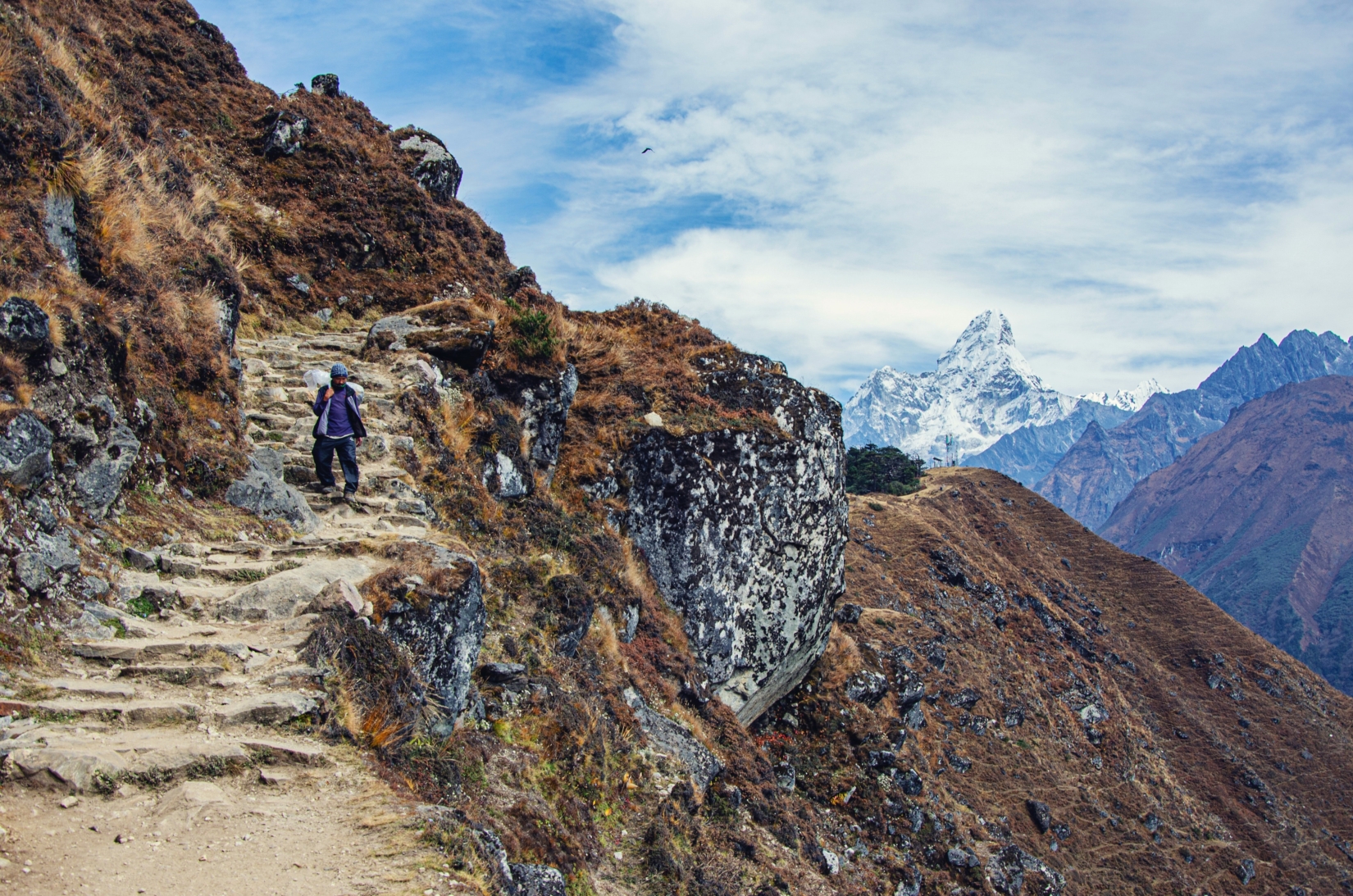
For me, Nepal is unlike any country I have visited. On my visit to this culturally rich and diverse nation I felt like I had entered into a new world. With the influences of both Buddhism and Hindi, the capital city of Kathmandu provides a window into the beautiful culture and history of the Nepalese people and bags you to explore more of this remarkable country.
What’s in this guide?
- Where is Everest Base Camp (EBC)?
- History of Everest Base Camp
- How long is the trek to EBC?
- Is it worth it? Things to see & costs
- How hard is the trek? Terrain, elevation, and altitude
- Food on the Everest Base Camp Trek
- Accommodations on Everest Base Camp
- When’s the best time to go? Temperatures & weather
- What gear and equipment should I pack?
- Should I use a porter service?
- Getting there
- Travel visas and permits
- A typical Everest Base Camp Trek itinerary
1. Where is Everest Base Camp (EBC)?
There are actually two base camps for Everest trekking: the North Base Camp in Tibet and the South Base Camp in Nepal. The Nepalese camp in the Khumbu region is the Everest Base Camp that most people talk about, and the endpoint of this legendary trek. It’s tucked away at the end of a long valley that carves through the Himalayas after splitting at the Sherpa village of Dingboche. The formidable Khumbu Icefall – the first obstacle for those attempting a summit push to Everest – begins right on the doorstep of the camp, leading up to the Western Cwm (also known as the Valley of Silence) and the peaks of Lhotse and Nuptse.
2. History of Everest Base Camp
Climbing on Mount Everest started at the beginning of the 1920s, when a team led by George Mallory (who some think may well have been the first person to reach the summit) came to map out the north face. However, Mallory and his team never established a permanent base camp on their trips, and the north route was all but shut when China invaded Tibet in 1949.
Then came the conquering expedition of Edmund Hillary and Tenzing Norgay . It took place on the south slopes in Nepal. Hillary and Norgay realized it made more sense to have a place to store supplies at the base of the mountain rather than trek the whole length of the Khumbu Valley whenever they needed gear. Thus, Everest Base Camp was born.
3. How long is the trek to EBC?
The Everest Base Camp Trek may be the single most famous trek in Asia, and arguably the world. Some say its booming popularity is the trek’s own worst enemy, and it’s true that the trail has suffered from overcrowding and some pollution in recent years. However, nothing can take away from the thrilling sense of adventure that comes with climbing towards the edge of the world’s highest peak. That reaches a fever pitch in the early days of your hike, when you’ll catch a jaw-dropping broadside of Mount Everest from a lookout on the south side of Ama Dablam.

Distance
The rewards of the trek don’t come so easily. EBC is a high-altitude path that requires considerable acclimatization over a good distance. You’ll typically need 12-14 days of full-on trekking (that’s right, your “rest days” involve walking too!) to complete the 80-mile (130km) roundtrip that starts from Lukla.
This distance is roughly divided into individual daily sections of 8-10 miles (13-16km), but the reason the whole adventure takes so many days is because it needs to be broken down into bite-sized chunks due to the altitude with acclimatization and rest days mixed in. Most itineraries will leave enough time to complete each leg on any given day at well below the average trekking pace.
Walking times
Most walkers find that they hike a maximum of 8 hours each day, though that can go up a little when you reach the higher altitude sections of the route – not just because of the physical challenge, but because you’ll be stopping often to take in all the breathtaking views!
4. Is it worth it? Everest Base Camp trip highlights & costs
The joy is in the journey here, as you trek further up to gaze from the roof of the world. Some of the best sightings of the famous Everest arguably come during the Everest Base Camp Trek itself, from various lookout points along the way. These magnificent views combined with mystical monasteries and Sherpa villages offer a host of intriguing trip attractions en route. For me, the best highlights of the trek are:
- Kala Patthar (Kalapathar) – Roughly translates to “Black Rock”. Detour to this soaring lookout point that’s 18,208 feet (5,550m) up on the ridges above Gorak Shep . It’s a real challenge (think a 1,640-feet / 500-meter ascent in 2 hours) but is hailed by many as the best view over Everest, with the Khumbu Icefall crashing through the valley below.

- Gorak Shep (Gorakshep) – A settlement that seems at the end of the world, this tiny town is the heartland of the Sherpa people and sits at the base of Kala Patthar.
- Sagarmatha National Park Museum – You’ll encounter this one very early on in the trek during your rest day in Namche Bazaar. It’s worth the climb to its perch above the village, mainly because the forecourt has incredible views of Everest and Nuptse – your first glimpse of the great mountain. Inside, you can learn all about the unique culture of the Khumbu Sherpa people .
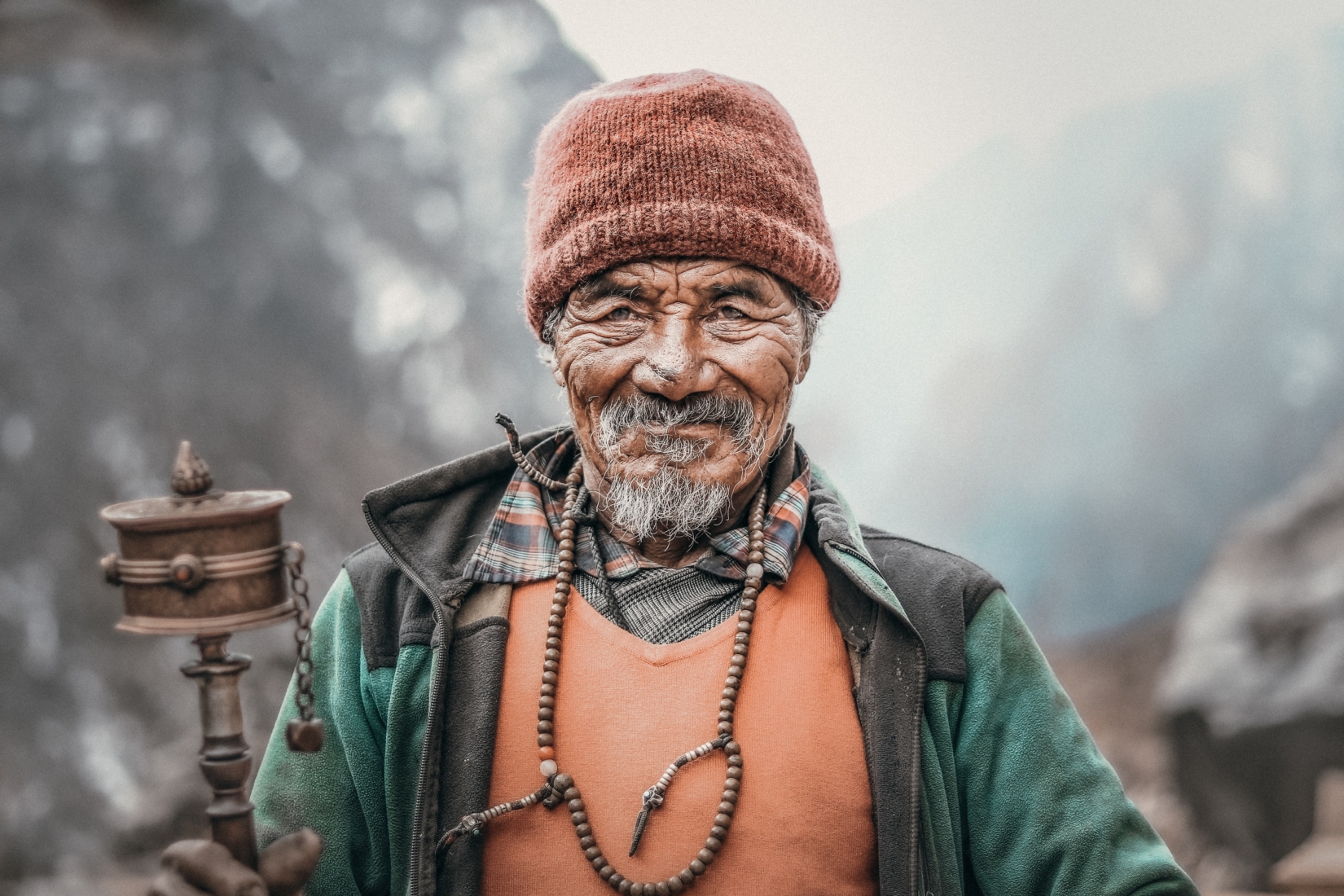
- Tengboche Monastery (Thyangboche Monastery or Dawa Choling Gompa) – The largest Buddhist gompa in the valley of Everest, Tengboche Monastery is a pitstop for determined trekkers bound for the summit. They come to light candles and ask for blessings.
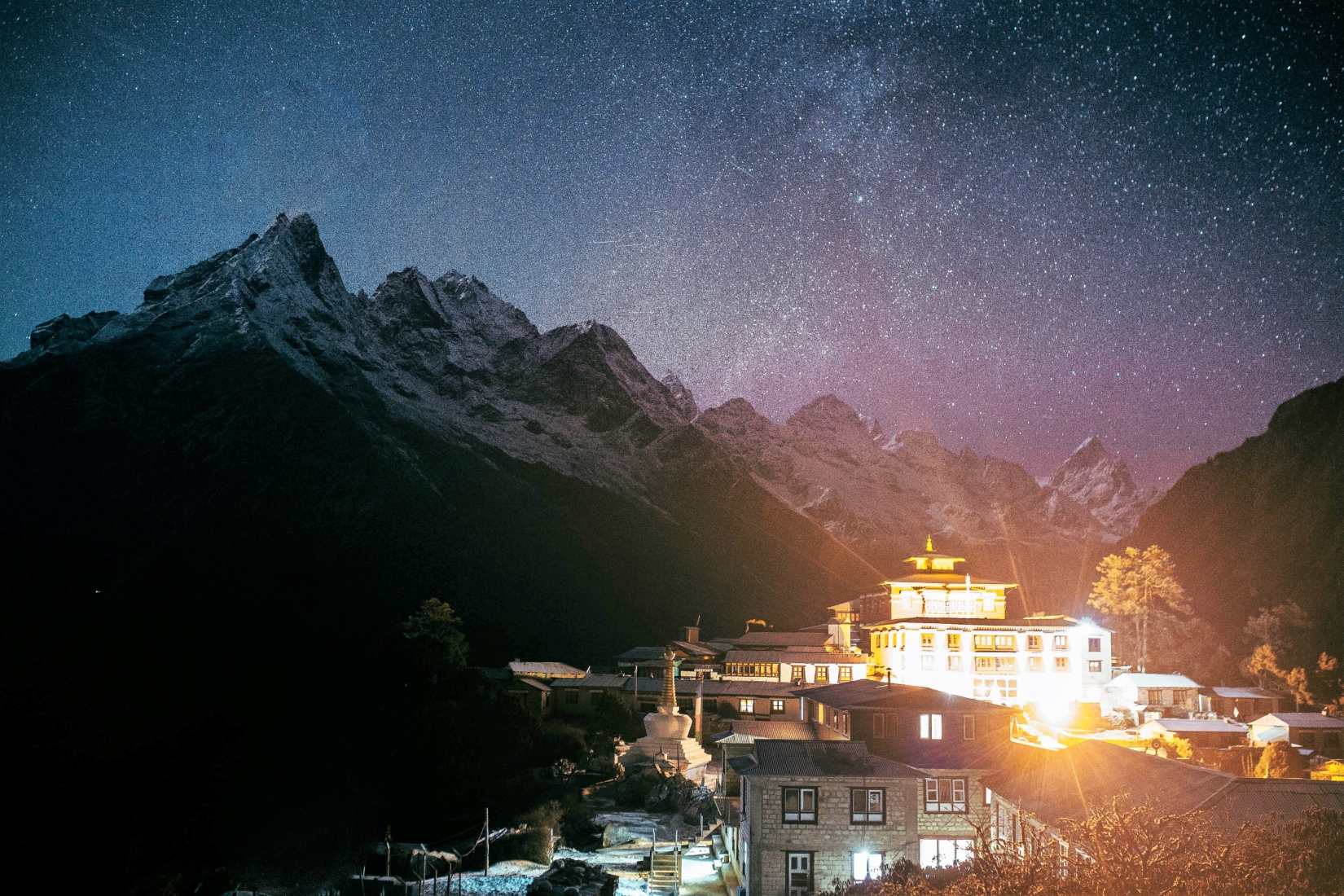
- Nangkar Tsang / Dingboche Viewpoint – Above the town of Dingboche, this detour off the main route is good acclimatization trekking and offers a panorama that takes in the Khumbu Glacier and the whole Imja Khola Valley.
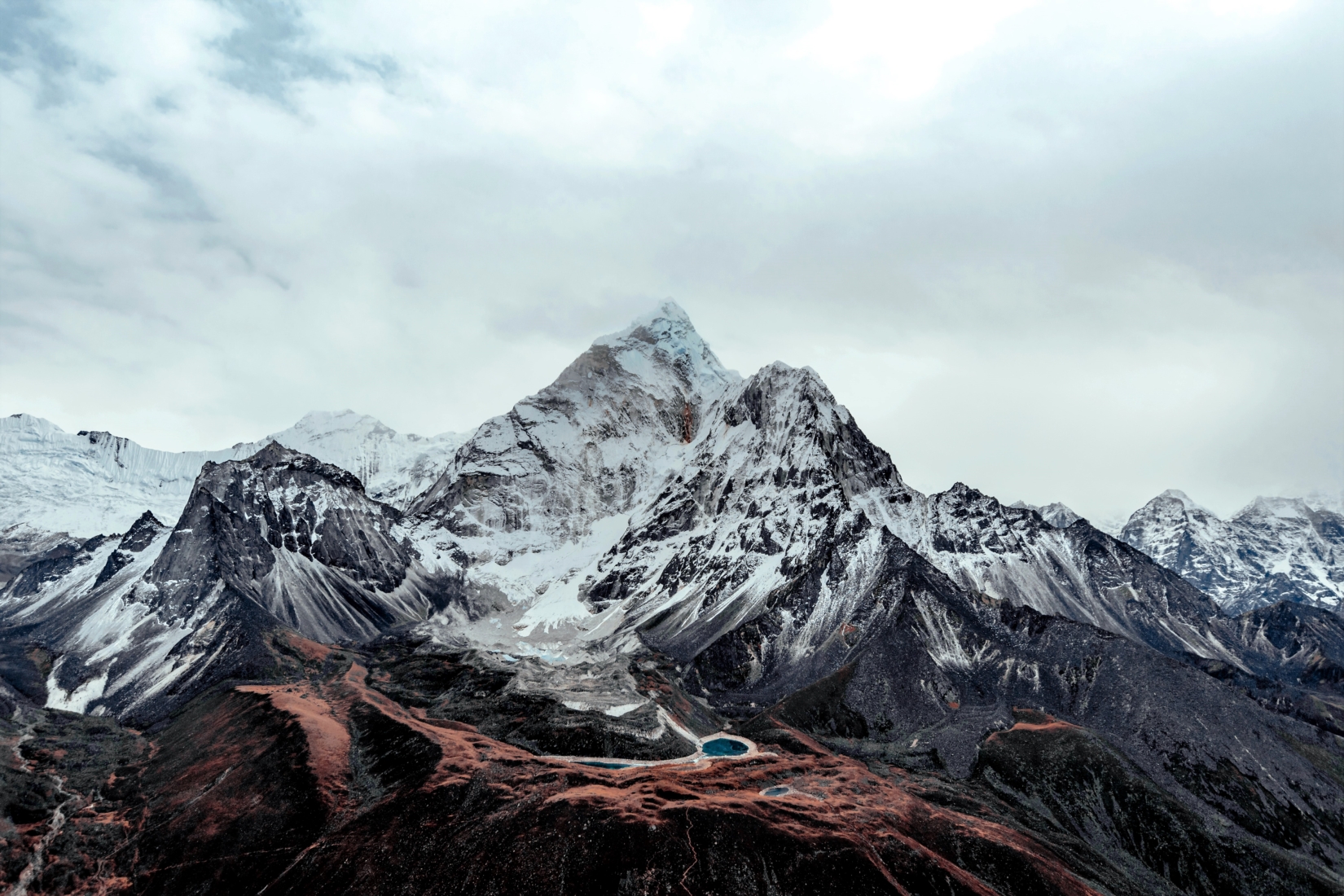
With so much natural beauty to be experienced, how much will it set you back? When it comes to pricing, costs of the Everest Base Camp Trek can range widely but the best all-inclusive tour packages start at around US$4,295 (including domestic flights to/from the trek start point) . If this number is giving you sticker shock, don’t let it deter you from the trip of a lifetime to Nepal, because my team at The Explorer’s Passage is always here to work with you and your preferences to craft a trip that fits your needs .
5. How hard is the trek? Terrain, elevation, and altitude
So just how difficult is the trek to Everest Base Camp? To answer this, you’ll have to consider the terrain and heights of EBC. Your physical fitness also plays a factor in the perceived difficulty of this adventure. Based on our Trip Activity Level Guide , we classify this trek as an advanced level, but you may be glad to know that no technical training or mountaineering experience is required.
Not sure if this Himalayan adventure is right for you? Contact us and we’ll walk you through details on the physical demands, recommended training, and more so you can make an informed decision.
The Everest Base Camp hike graduates from the alpine surroundings at the south end of the Sagarmatha National Park to the scree-covered ridges of ancient moraines in the final push towards the trekking finish line. The first sections are easier in terms of terrain but more difficult because they are constantly steep. You’ll notice this in the ascent from Lukla to Namche Bazaar, and then again from Namche Bazaar to Tengboche. The path there is largely shaded by pine and ironwood forests, muddy when wet but also interspersed with rocks wedged into the ground. You’ll stroll across suspension bridges to cross most rivers.
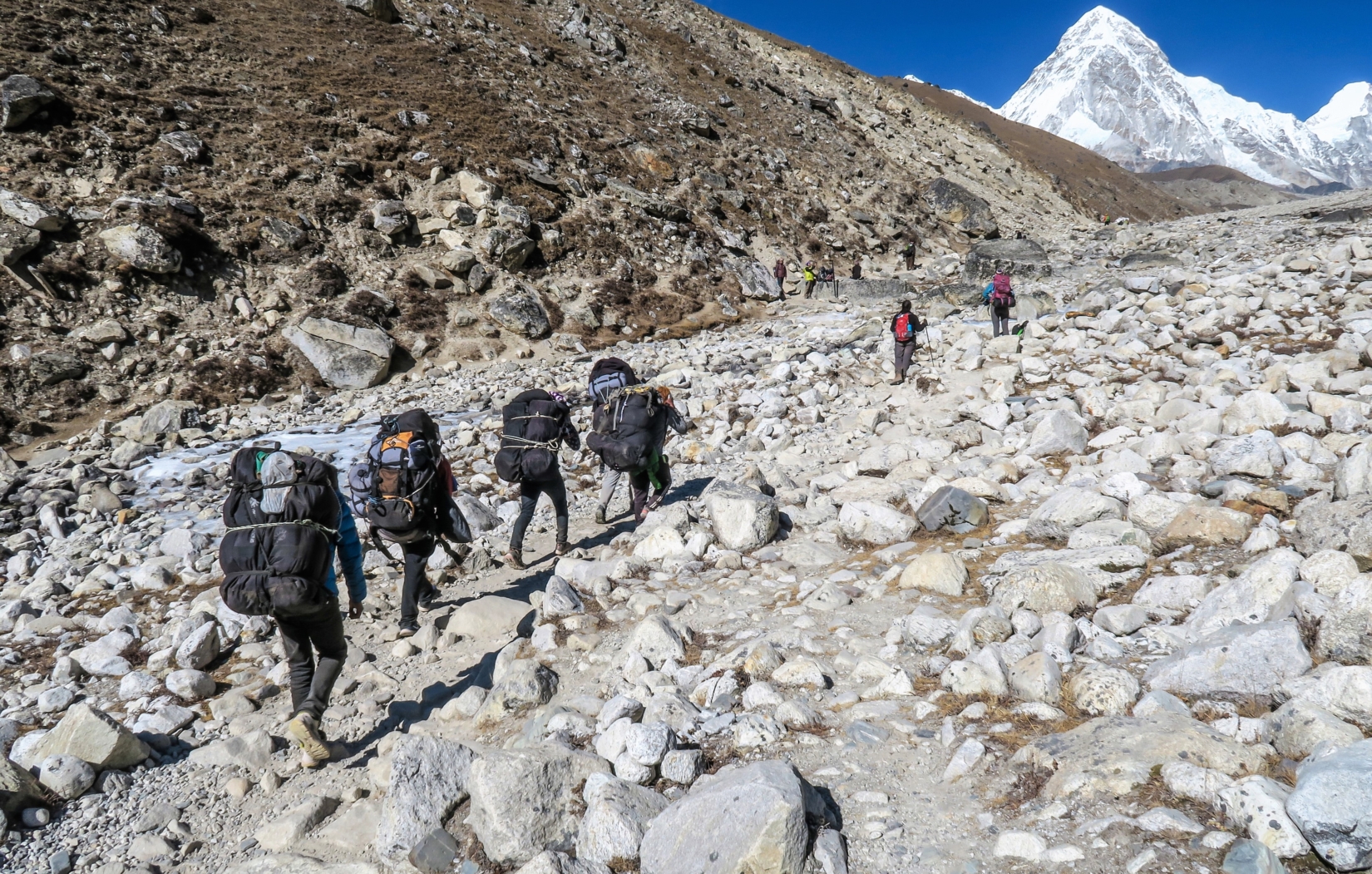
After the first few days of your trip, you’ll see that the trekking path levels a little as it skirts a wide, flat valley with the mighty Himalayas looming on all sides. This is where you lose the tree cover for good, so be sure to have the sunscreen handy. It’s rock and grit underfoot until you near Gorak Shep. There, the route sort of merges with the great pebble and rock moraine at the end of the Khumbu Icefall. It’s normal to find snow coverage in those parts, especially if you’re trekking between November and March.
Elevation and altitude
How high is Everest Base Camp? Well, altitude is commonly travelers’ biggest challenge on this tall trek. As mentioned before, you’re going to have to clock up a hefty 17,598 feet (5,364m) above sea level. You’ll manage 9,400 feet (2,865m) at the EBC trailhead, which is taken care of by the flight from Kathmandu to Lukla. The rest is up to your legs. You’ll knock out about 1,800 feet (549m) by climbing to Namche Bazaar. After that, days on the trail (not including acclimatization days) average around 1,200-1,600 feet (366-488m) in elevation gain, though it’s on less-steep paths once you cross the tree line around Tengboche. Everest Base Camp elevation is no joke and can be difficult for some.
Acute Mountain Sickness (AMS) – the mildest form of altitude sickness – is certainly a risk here. It can affect anyone over altitudes of 8,000 feet (2,438m), but usually has severe impacts at higher levels. Since the EBC Trek reaches altitudes of more than double the height where AMS can possibly kick in, there are usually two full acclimatization days planned in – one in Namche Bazaar and the another in Dingboche or Lobuche. These days aren’t for resting but instead used to climb high and then descend to sleep at lower altitudes, a common practice that’s known to help the body acclimate to conditions at higher elevations.
Don’t be surprised if your Everest Base Camp Trek guide constantly reminds you to drink enough water as it’s another way to combat AMS. Once you hit the higher altitude parts of the path, you can typically expect your guide to be prepared with a supply of oxygen, should you need it. You might also want to consider packing an AMS medication like Diamox on your trip to Nepal.
Even seasoned alpinists find the trip a challenge and lots of climbers struggle with Acute Mountain Sickness. Just remember: no pain, no gain on this most incredible of trails! On this trip, you’ll see the sheer majesty of the Nepalese Himalayas up close and scale to viewpoints that are simply some of the best you’ll ever hike to.
6. Food on the Everest Base Camp Trek
All that trekking is going to work up a serious appetite, you can be sure of that. Thankfully, EBC teahouses tout some decent grub for when it’s time to refuel. Don’t be surprised to find that the menus are virtually identical the whole way along, even if the dishes themselves vary greatly with the whims of different chefs up and down the trip route.
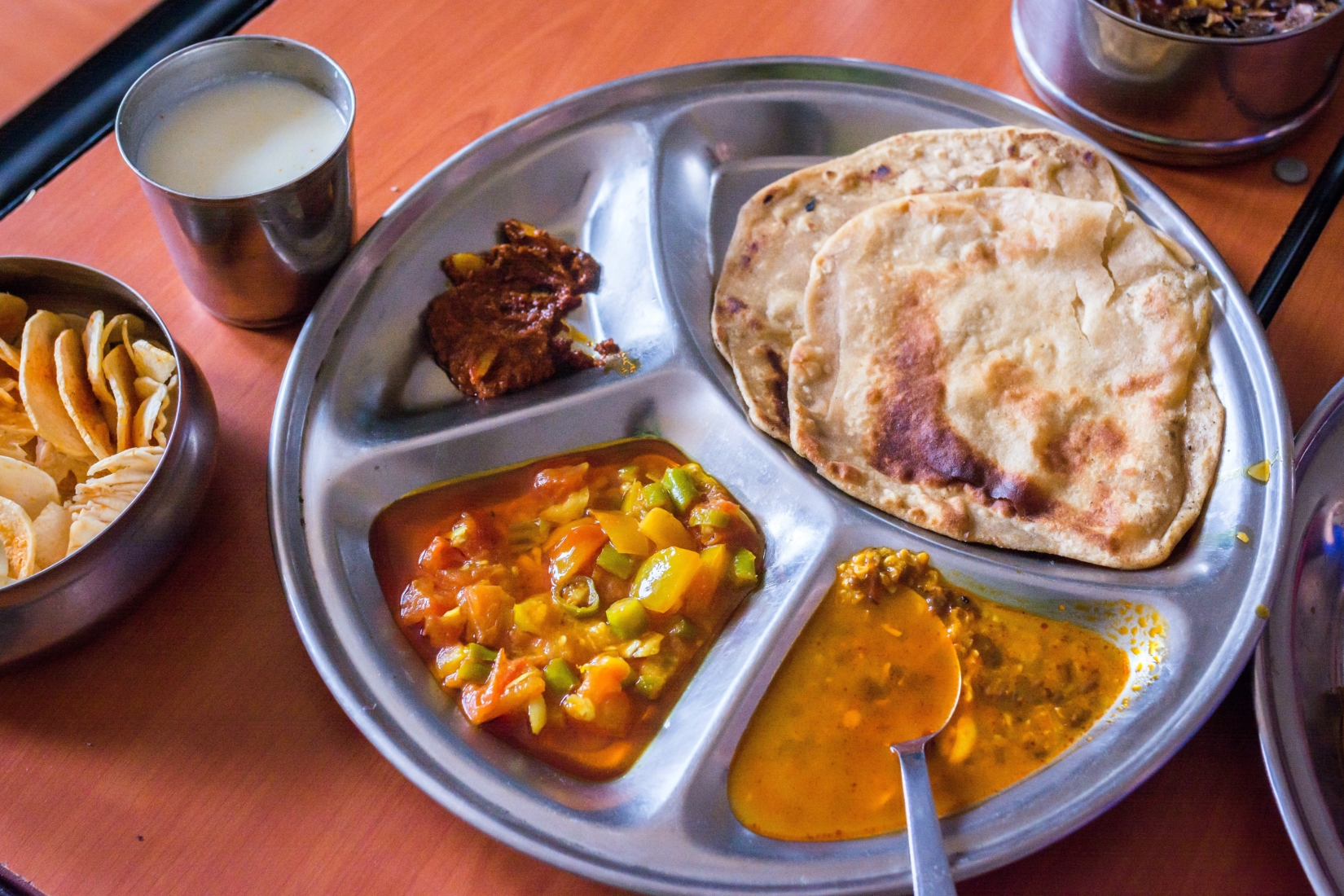
Common dishes include:
- Dal bhat – The most popular EBC meal of all. Every hiker who’s done the route has warmed up with this spicy lentil stew at least once. It’s usually served with rice and chapati flatbread.
- Egg and fries – A hearty option for those feeling really hungry, this one includes hand-cut, fried potatoes and a double-egg omelette.
- Shyakpa ( Sherpa stew ) – A classic favorite of sherpas in Nepal and a great vegetarian option that’s basically broth with cut potatoes, carrots, and other root vegetables.
- Pizza – Some teahouses try their hand at pizza. We’ll let you be the judge of whether or not the Italians would be proud.
Is your mouth watering yet? These dishes will surely give you the energy you need to power through the trek.
7. Accommodations on Everest Base Camp
Apart from the hotels in Kathmandu at the start and at the end of your quest, all of your accommodations on the Everest Base Camp Trek route are likely to be teahouses. Don’t let the name fool you – these aren’t just places to stop for a hot drink. They’re actually full-fledged bed and breakfast lodges purposely designed to host travelers.
EBC teahouse accommodations in Nepal are simple, clean, and comfortable. The general rule is that the quality is better towards the start of the trek, where the teahouses are both larger and better supplied. Rooms are usually minimally decorated. They have wood-paneled or plastered walls and, for the most part, a single window, along with low-rise beds with foam mattress pads. Some have in-room heating, while other teahouses are warmed by a central stove that’s kept alight in the evenings. Some places offer hot showers, but most only offer cold. Electrical charging of devices is on offer at most places, though that could come at an extra cost.
For more details on accommodations, check out our Everest Base Camp tour page .
8. Best time to trek to Everest Base Camp
There are two main seasons for trekking to Everest Base Camp in Nepal. The first is in the spring (late March to May) and the second comes in the autumn (late September to November) . Both high seasons essentially straddle the main monsoon season, offering more dryness and clearer skies without too much precipitation. Although, it’s important to note that zero rain can never be guaranteed this high up.
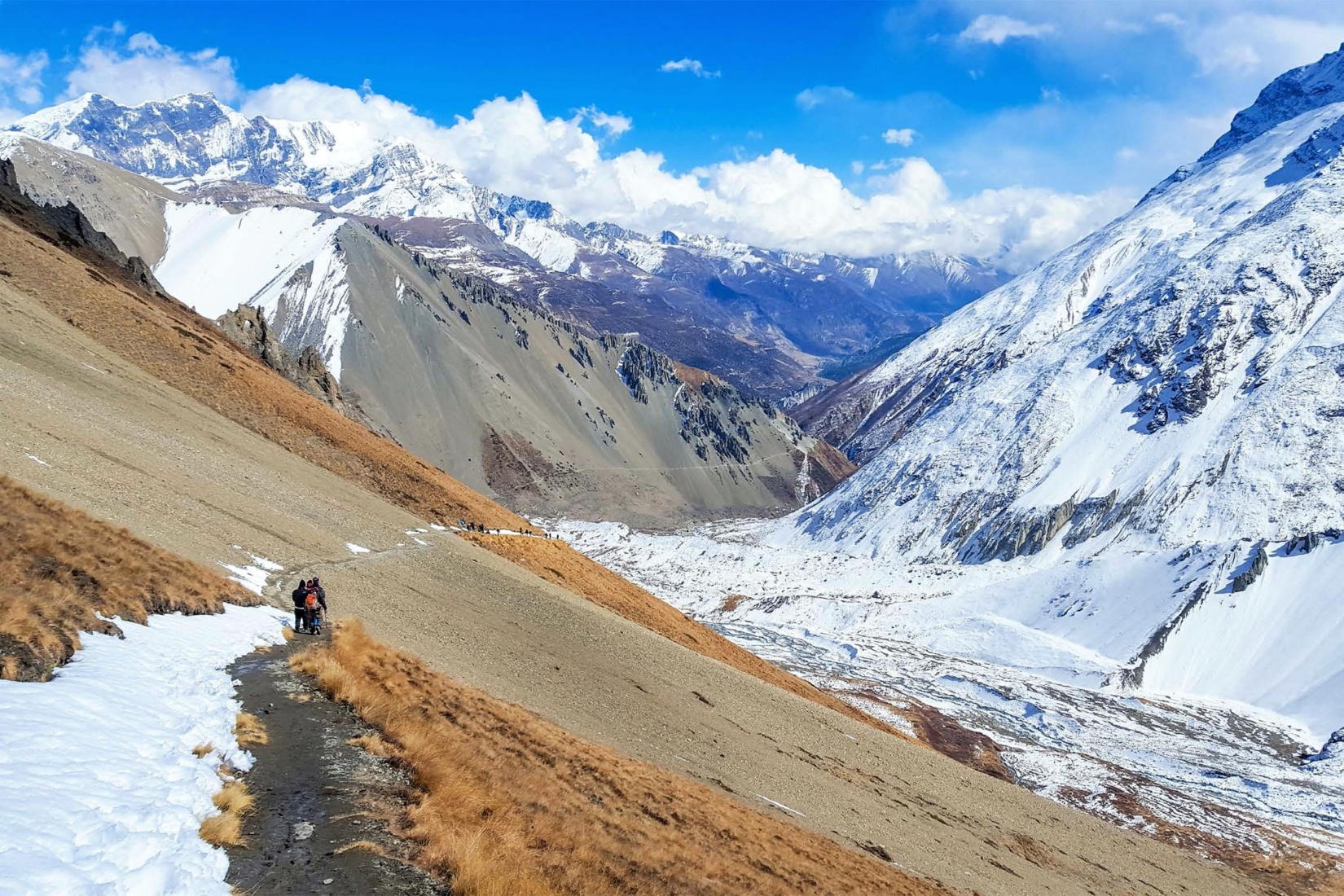
Here’s a breakdown of the best months to go:
- March – Marks the beginning of the trekking season proper but it’s not its peak. That means a good balance of smaller crowds, availability in teahouses and affordability. Most of the ground snow has melted by this point, but rising temperatures do mean there can be some heat haze to obscure the views.
- April – The busiest time of all on the Mount Everest Base Camp Trek, but for good reason: Clear skies abound, the views are wonderful, and temperatures are comfortable. You can also come in April if you’re keen to see the hardcore mountaineers prepping for a summit push up Mount Everest itself.
- May – The hottest month on the trail with less harsh conditions in the evening. Downsides include heat haze that can obstruct the views and the potential for some early-monsoon rains.
- September – The first month after the monsoon can see some rains stick around. However, that also means the lower-altitude parts of the trek between Lukla and Namche Bazaar are wonderfully lush with flower blooms and vivid greenery.
- October – Second only to April in terms of crowds of travelers. Lots of people hit the EBC trail at this time because there’s a great balance between comfortable temperatures and clear skies. In fact, I’d say that this is the clearest time of all, so it’s perfect for those wanting uninterrupted views of Everest.
- November – Cold winter conditions can start to set in by November. It’s not unusual to encounter snow at higher altitudes and you’ll need proper thermal gear to get through the nights. The payoff is super-clear skies and way fewer hikers on the trail.
December to February is the low season for one main reason: Snow. Temperatures during these colder days drop to an average of 25 degrees fahrenheit (-4℃) in the middle of the winter season, and that’s in Namche Bazaar, one of the lowest points on the trek. It’s not ideal for overnight hikes that rely on teahouses made of plywood walls. That said however, completing the EBC certainly isn’t impossible at this time, it just presents unique challenges. You’ll need way more thermal layering, special trekking equipment to handle the snowdrifts, and probably extra days to complete the trek. The upside is that winter days offer very clear skies and there’s rarely a big crowd on the trail.
9. What gear and equipment should I pack?
When considering what to pack for your trip, it’s good to know there are strict limits on the weight each passenger can take on that initial flight from Kathmandu to Lukla. What’s more, there are limits on the size and weight of bags that you can ask porters to shuttle up and back to EBC for you. Due to these limits, you’ll want to think very carefully about what to bring for this once-in-a-lifetime trek. As a general rule, it’s good to stick to about 22-33 pounds (10-15kg) in your main pack, with a small 30-litre day pack on the side to carry the things you’ll need on the trail.
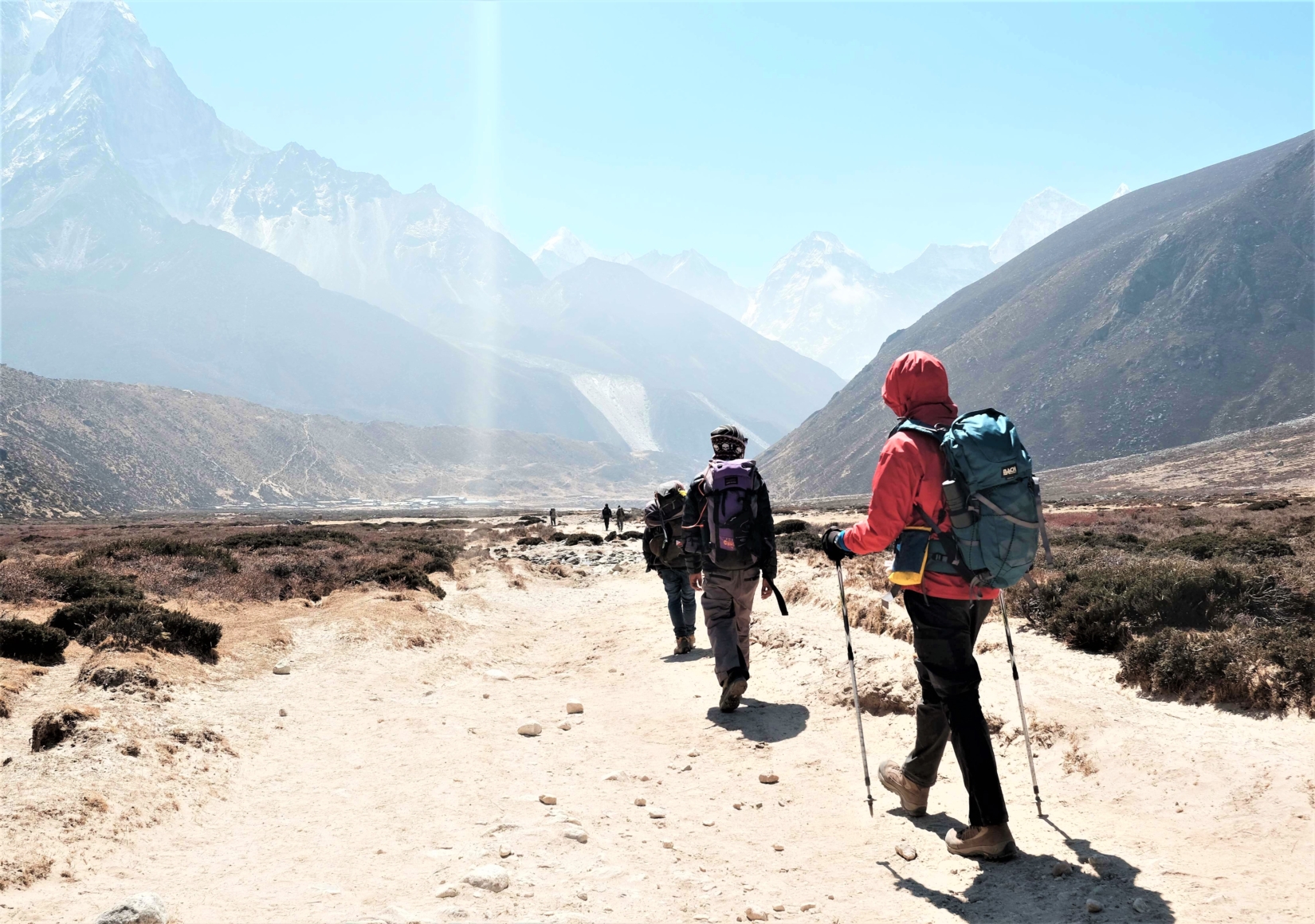
Layers are always key in the Nepalese mountains, as temperatures can warm up considerably during the day and drop suddenly at night. You’ll want to be able to add and remove fleeces and thermals on the upper body to match the fluctuating temperatures. For the lower body, I’d recommend bringing both shorts (mainly for the lower elevations of the trek where it can be positively balmy) and sturdy trekking pants (for higher elevations), backed up by good thermal-rated underlayers.
Waterproofs are also essential for your trip. Rain and snowfall can come without warning in the high Himalayas, and weather patterns on the EBC Trek have little respect for the so-called high season, so inclement weather can happen any time of the year. Winter trekkers will need to plan a little more, though, in order to deal with all that ground ice and much colder conditions.
On top of that, you’ll need to think about all those hiking essentials. Good boots, a pair of hiking poles you feel comfortable with, both a wool hat and a sun hat, strong sweat-resistant sunscreen, headlamps, and a decent-capacity water bottle should all be on your packing list.
That’s just scratching the surface, but The Explorer’s Passage will make sure you’re fully prepared for your chosen season on the EBC route when you plan with us – just ask us for a full packing list !
10. Should I use a porter service?
Put simply, porters are essential on the trek to Everest Base Camp. They’re very much the superheroes of the expedition, transporting the bulk of most trekkers’ gear and equipment from camp to camp outside of Lukla or Namche Bazaar. For larger groups of trekkers, some operators will utilize animal support for transport assistance. Porters will carry one standard rucksack or duffle bag per hiker. Usually, that’s limited to a weight of between 22-33 pounds (10-15kg) per person, though it can be lower or higher depending on the Everest Base Camp tour you pick. That leaves you to only carry what you need for the day. As mentioned above, a 30-litre pack typically works best, just enough for water, snacks, fleece and waterproof layers, your camera, and sunscreen.
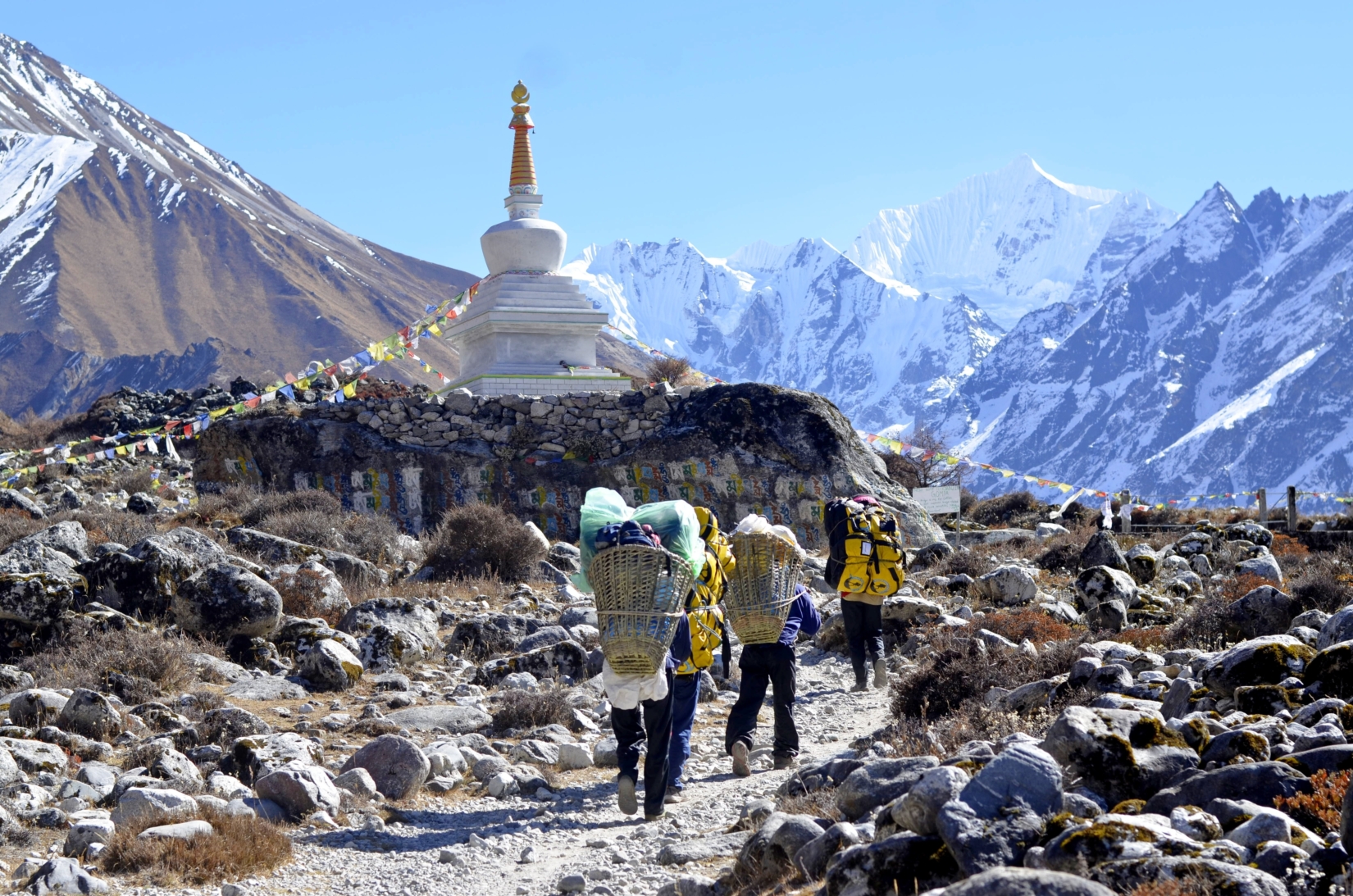
I do, occasionally, see people who choose not to engage a porter but that’s a tough task. Ultimately, when you’re deciding whether or not porter service is right for you, remember that the Mt. Everest Base Camp hike involves several days of walking at altitudes over 12,000 feet (3,658m) above sea level, on tricky terrain to boot. It’s a challenge even without 44 pounds (20kg) of gear strapped to your back!
11. Getting there
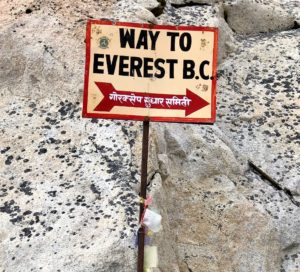
So now you know what this infamous excursion holds and you can’t wait another moment to go, how will you get there? The trip to the start of EBC is a journey in itself. You’ll first jet into Kathmandu, the heady, rickshaw-rattling capital of Nepal. It’s an amazing place, filled with UNESCO temples and the aromatic spices of Nepalese curry houses. We usually recommend that travelers arrive at least a couple of days before they are due to set off for the trek, not really to help with altitude acclimatization – Kathmandu is a relatively modest 4,500 feet (1,372m) up – but more for cultural acclimatization.
Doing that means you’ll have time to score any last-minute gear you might have forgotten for the hike itself. Kathmandu has plenty of decent outfitters that offer good deals on key items like down sleeping bags and thermals. It also means you’ll get to see some of the great cultural treasures of the country, including the tower-topped temples of Durbar Square and the colossal Boudhanath Stupa, which is usually writhed in prayer flags dancing in the wind.
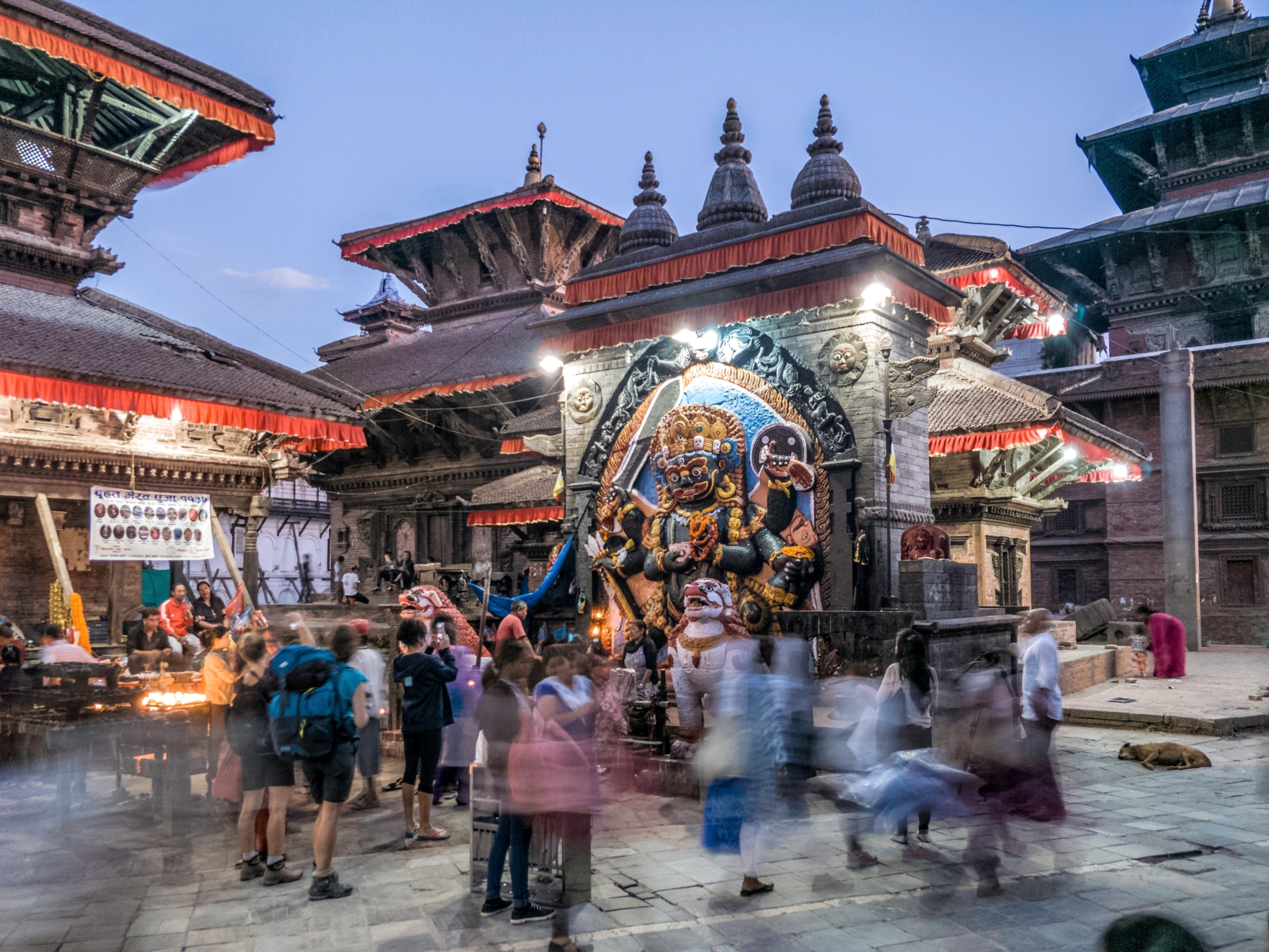
After Kathmandu, there’s a short-haul flight from the domestic terminal of Kathmandu Airport that takes you all the way to the trailhead of Everest Base Camp in Lukla. The plane ride is relatively quick – about 30 minutes total – and pretty spine-tingling, especially as the landing strip on the Lukla side sits a whopping 9,300 feet (2,835 meters) above sea level on a precipitous mountain plateau. It’s not a flight you’ll forget in a hurry!
12. Travel visas and permits
Some nationals of specific countries can enter Nepal without a visa, but most travelers will require one. For those who do, entry visas for tourists traveling into Nepal are generally available in advance or upon arrival at Tribhuvan International Airport and various land borders. If you’re unsure of which category you fall into, use this easy tool to double check your entry and health requirements .
When it comes to permits, there are no permits for the Everest Base Camp Trek itself, at least not like there are for the Inca Trail and some other bucket-list hikes elsewhere on the planet. However, there are limits to the number of guests teahouses can host (so it’s important to book early) and you will be passing through some regions and conservation areas that require visitors to obtain special passes, but no need to worry as The Explorer’s Passage will handle all of these details for you. Just make sure your travel documents and essentials are still valid.
For the route to Everest Base Camp from Lukla, there are two key documents that we will secure for you:
- Khumbu Pasang Lhamu Rural Municipality Entrance Permit – This is a pass for access to the whole Khumbu region.
- Sagarmatha National Park Entry Permit – This is your pass to enter the national park that contains Mt. Everest.
It is important to note, those looking to do the longer, 20-day extension to the EBC Trek, going from Kathmandu by road and then onwards by foot from Jiri, will also need a pass for access to the Gaurishankar Conservation Area.
13. A typical Everest Base Camp Trek itinerary
The temple-topped, bazaar-busting city of Kathmandu is likely to be where you enter Nepal. You’ll definitely want to take some time out of your trip to explore this amazing city first. Then, it’s time to head northeast to start your Everest Base Camp hike. Most travelers do that with a flight to Lukla and then walk from there, but it’s also possible to trek all the way if you have the time. Still, most Everest Base Camp Trek itineraries officially start at Lukla airport.
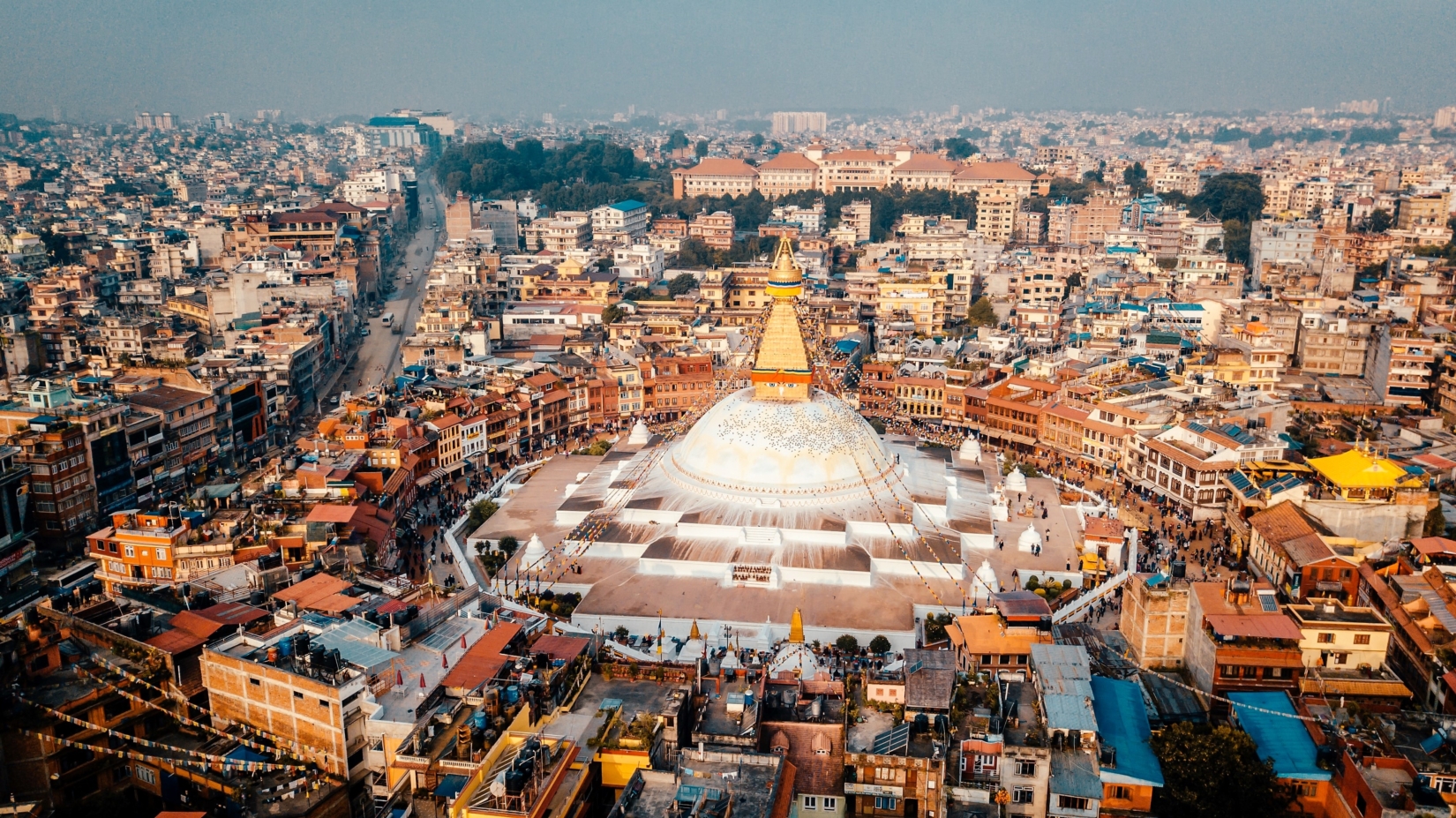
For a customized itinerary, connect with us to craft your ideal trip.
- Day 1: Namaste and welcome to Kathmandu! Get ready to experience one of the most awe-inspiring journeys our planet has to offer. You’ll arrive in Kathmandu and explore the dynamism, scenery, and history the city has to offer.
- Day 2: Today will be filled with cultural immersion. Begin by exploring three UNESCO World Heritage Sites. The first is Boudhanath, one of the largest stupas in Nepal. Next is Pashupatinath, a sacred Hindu temple located on the banks of the Bagmati River. Finally, you’ll visit Durbar Square, which sits in front of the old royal palace. Finish your day with one of the most classic walks through the old narrow streets of Kathmandu. In the heart of this city, soak up the buzzing atmosphere of the local markets and stores, before heading back to the hotel.
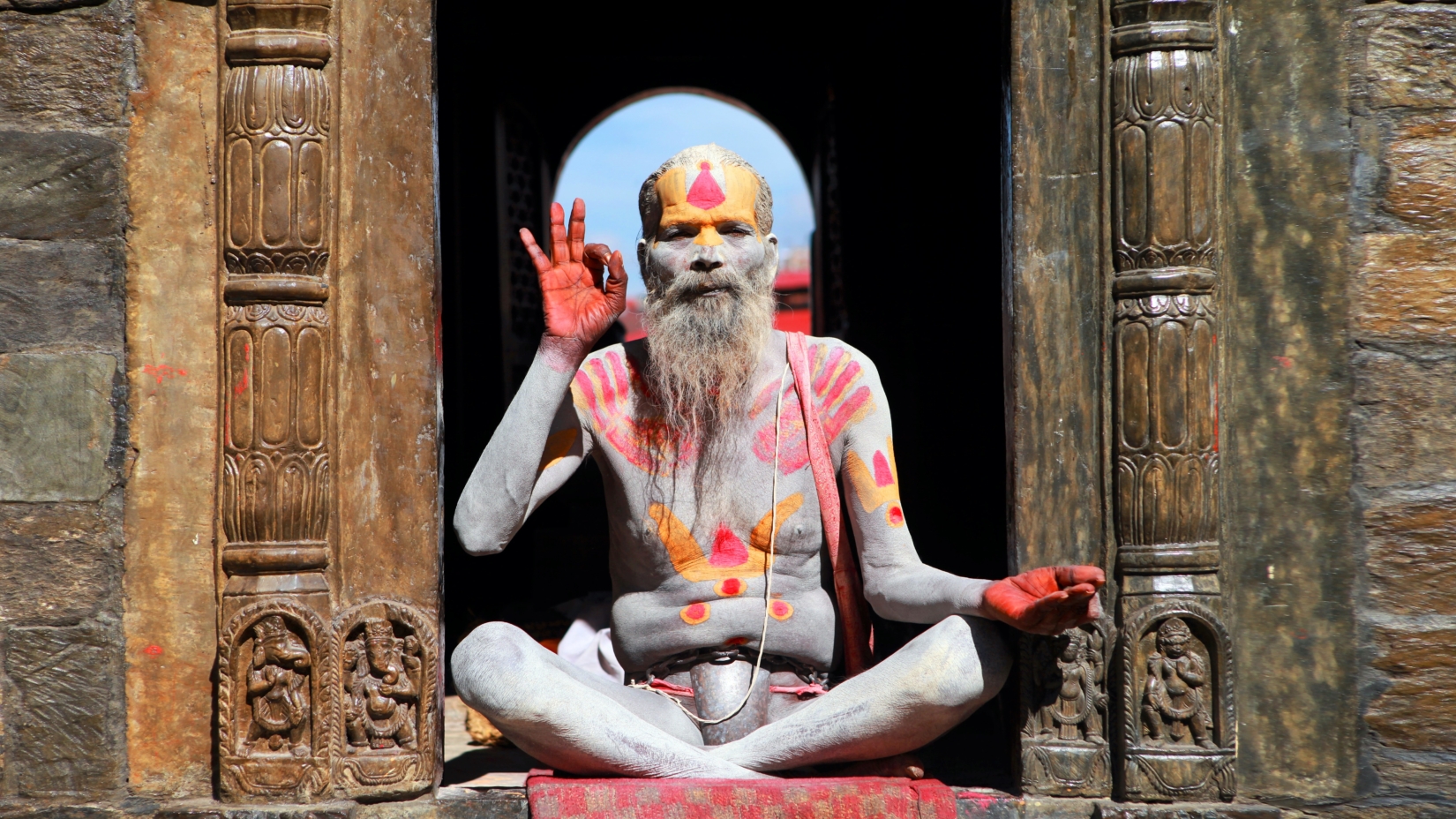
- Day 3: Kathmandu to Phakding (8,562 ft / 2,610 m) – After a short flight to Lukla, it’s a pleasant hike through dense pine forests and steep gorges traversed by swinging suspension bridges. There’s a real bustle about this part of the path, with oodles of hikers fresh onto the trail to chat to. It’s also the lushest part of the trail, with wildflowers and roaring riverways, more Alps than Himalaya.

- Day 4: Phakding to Namche Bazaar (11,286 ft / 3,440 m) – Today you’ll go up to the main hub of EBC: Namche Bazaar. This is a good place to stock up on any essentials you may have forgotten to bring on your trip. Enjoy the town that’s abuzz with hiker cafes and lodges, and comes with stunning views of the jagged Mount Khumbu Yül-Lha (Khumbila), loosely translated as “God of Khumbu” peak, to the north.
- Day 5: Namche Bazaar (11,286 ft / 3,440 m) – This is your first official acclimatization day. The best way to prepare for the altitude is to hike high during the day and return to lower altitudes in the evening to sleep. The Khunde and Khumjung Loop is the perfect option for that, taking you to long-lost Sherpa villages with mystical Buddhist stupas.
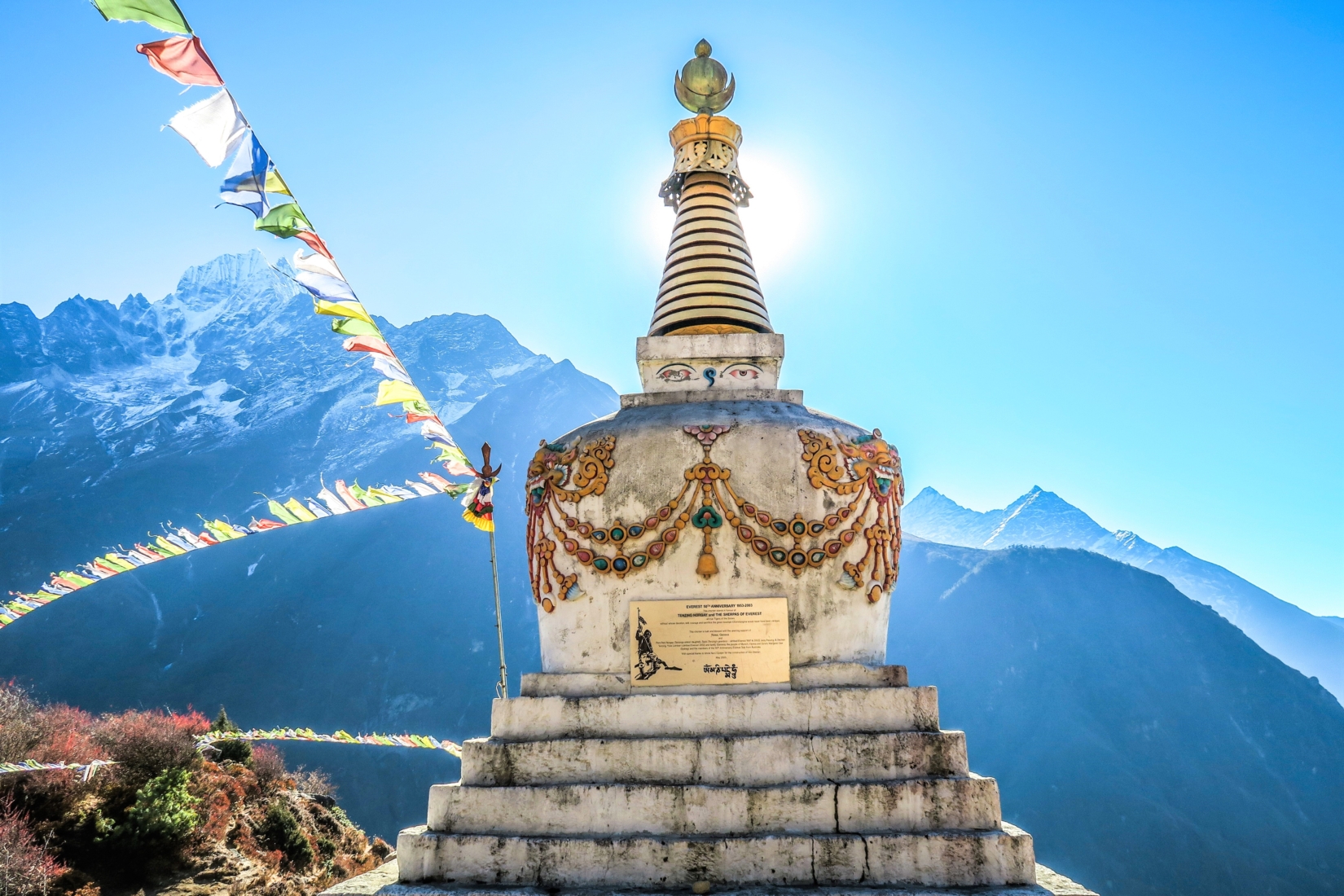
- Day 6: Namche Bazaar to Tengboche (12,664 ft / 3,860 m) – Your first steps on the Everest Base Camp Trek proper begin with a steep incline that takes you almost out of the treeline. The path levels and then emerges into a lunar-like world of big brown rocks where the Himalayas draw ever closer. The destination? The rhododendron forest, where you’ll stay for the evening.
- Day 7: Tengboche to Dingboche (14,470 ft / 4,410 m) – Expect exposed trekking except for some sections through high-altitude pine woods. Later in the day, the trail wiggles across the sides of Ama Dablam peak and you’ll get to appreciate the Everest massif in all its glory looming overhead.
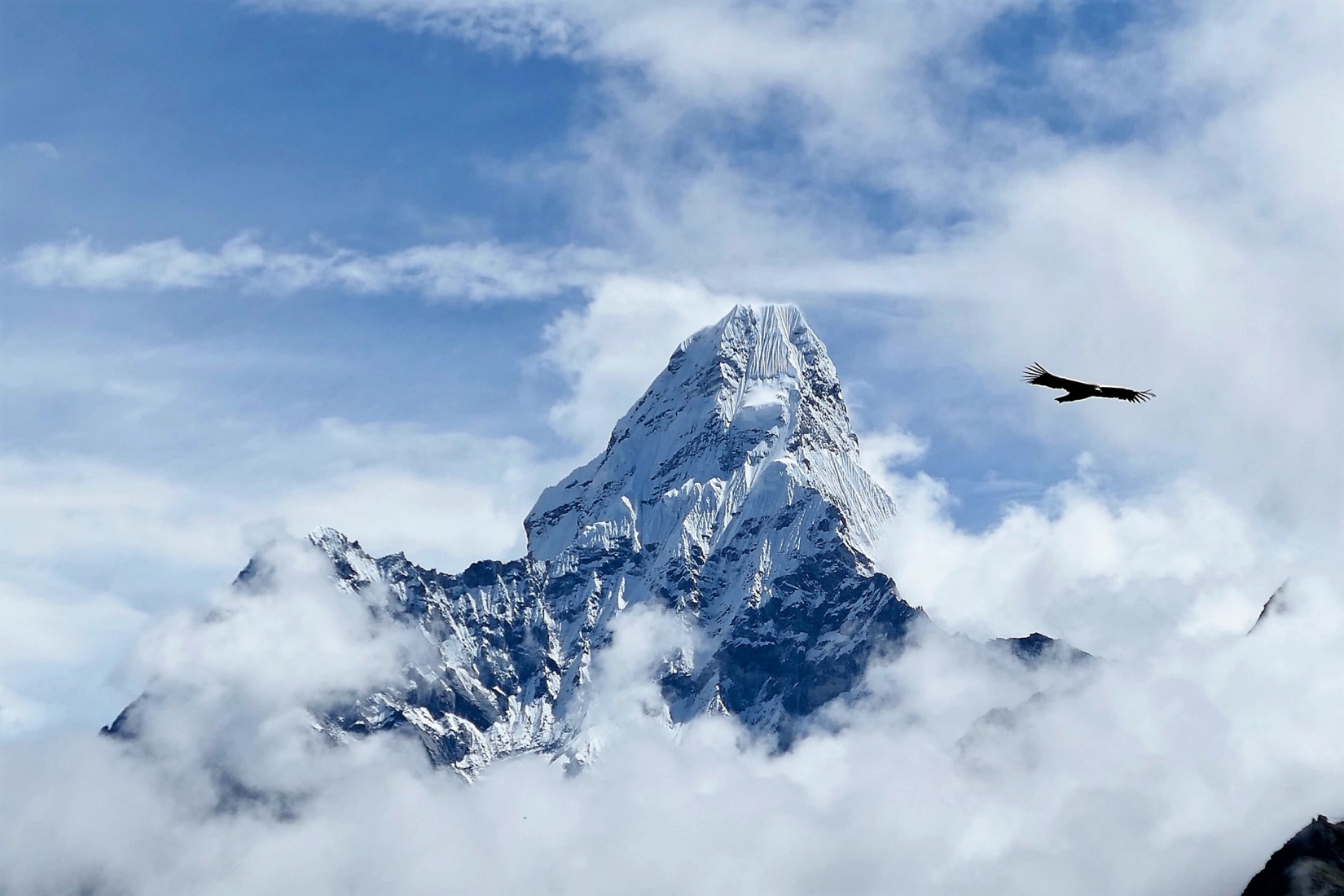
- Day 8: Dingboche (14,470 ft / 4,410 m) – A second acclimatization day is needed at this stage of the trip. Perhapstake some time to experience Chukhung (15,518 feet / 4,730 meters), a place traditionally used to raise yak. Lodges rise up amongst the peaks, making it a perfect spot for relaxation, observation and absorbing the scenery and local life.
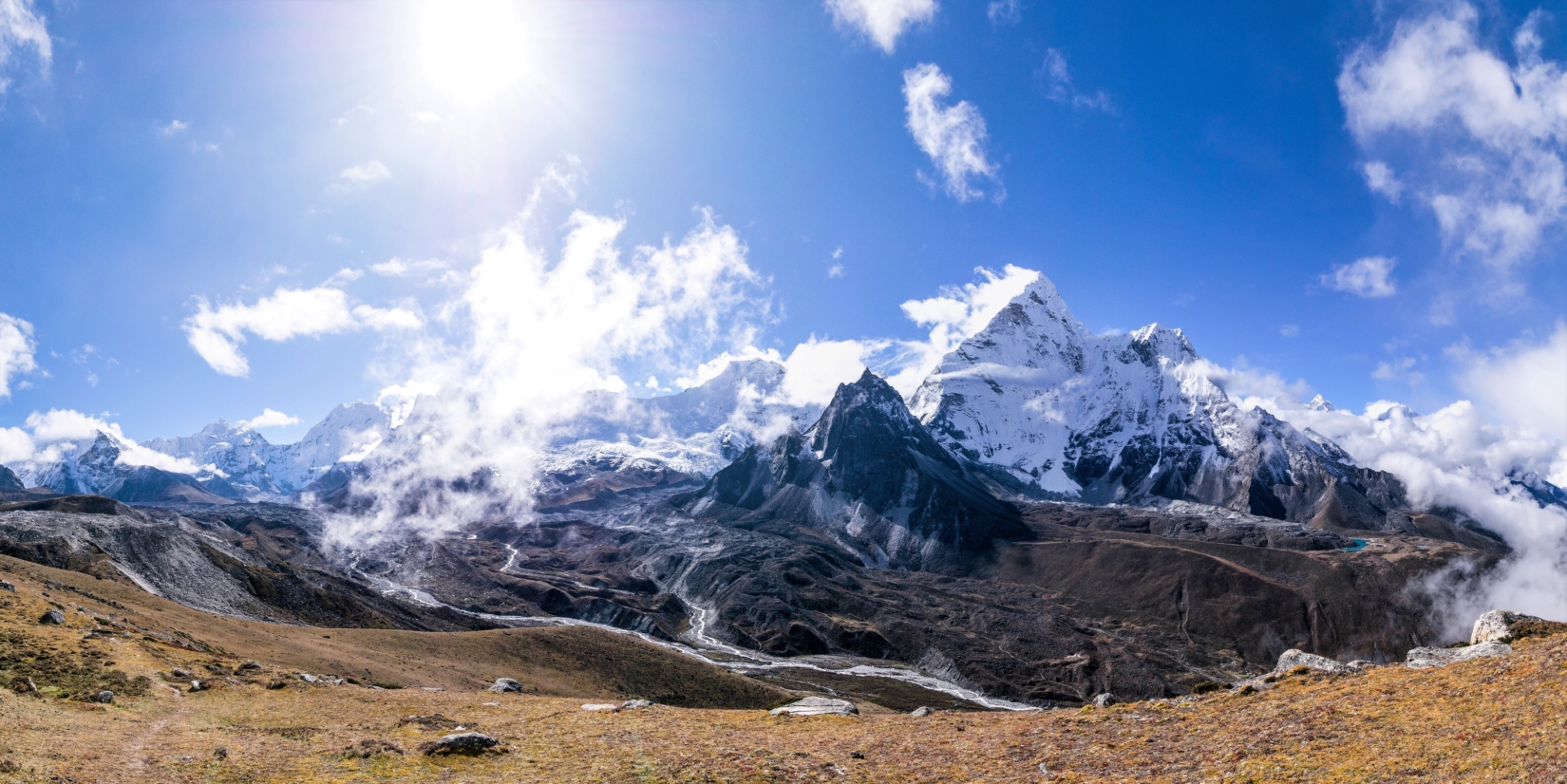
- Day 9: Dingboche to Lobuche (16,210 ft / 4,941 m) – You’re now onto the penultimate push towards Everest Base Camp. Welcome to the high Himalayas. Trees are long gone in this land of rugged rocks and the cascading tongues of glaciers. The day includes some amazing visions of the approaching Everest massif, especially the closer face of Nuptse.
- Day 10: Lobuche to Everest Base Camp (17,598 ft / 5,364 m) – The final part of the trail starts by weaving over rocky highland terrain and then passes through the Gorak Shep village, where a small trekking lodge clutches the edge of the Khumbu Icefall. There’s a chance of a small rest there, but not for long, because EBC is only another 1.5 hours up the valley!
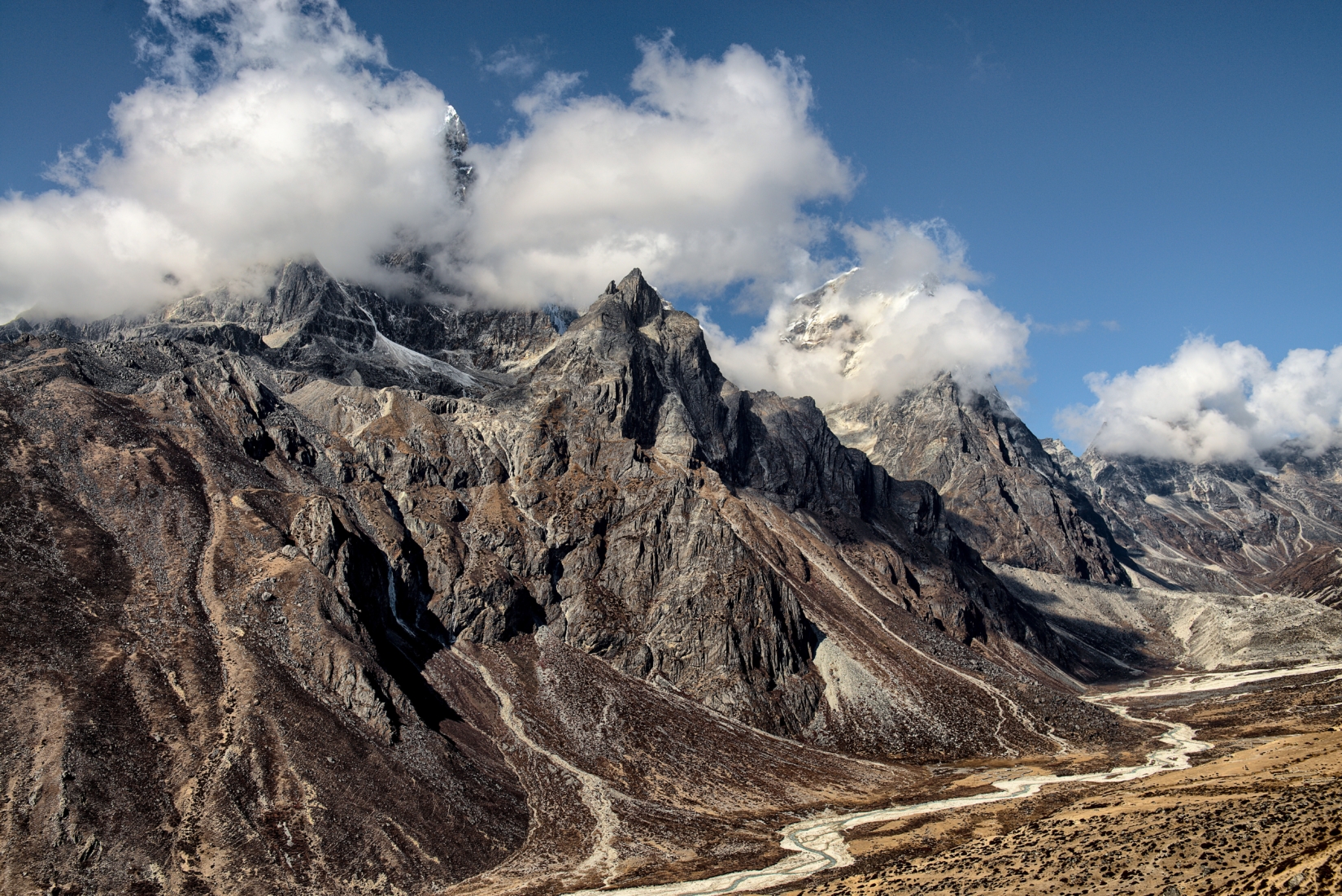
- Day 11: Everest Base Camp to Pheriche (14,340 ft / 4,371 m) – Today you’ll retrace your steps towards Pheriche, hiking first towards Kala Patthar. Oxygen begins to increase and much of this portion is downhill, and you’ll have the chance to take in the panoramic views with an easier trek.
- Day 12: Pheriche to Debouche (12,533 ft / 3,820 m) – You’ll work back via Deboche, passing the Old Nunnery. Follow the river back towards Debouche, a campsite, not far from the Tengboche Monastery.
- Day 13: Debouche to Namche Bazaar (11,286 ft / 3,440 m) – Today you’ll double back towards Namche Bazaar, the Sherpa village that is the hub of activity and local culture. Here you’ll see many porters like Norgay, who aid climbers and know this terrain better than anyone. Observe the local mountain life, as you continue on tomorrow towards Phakding.
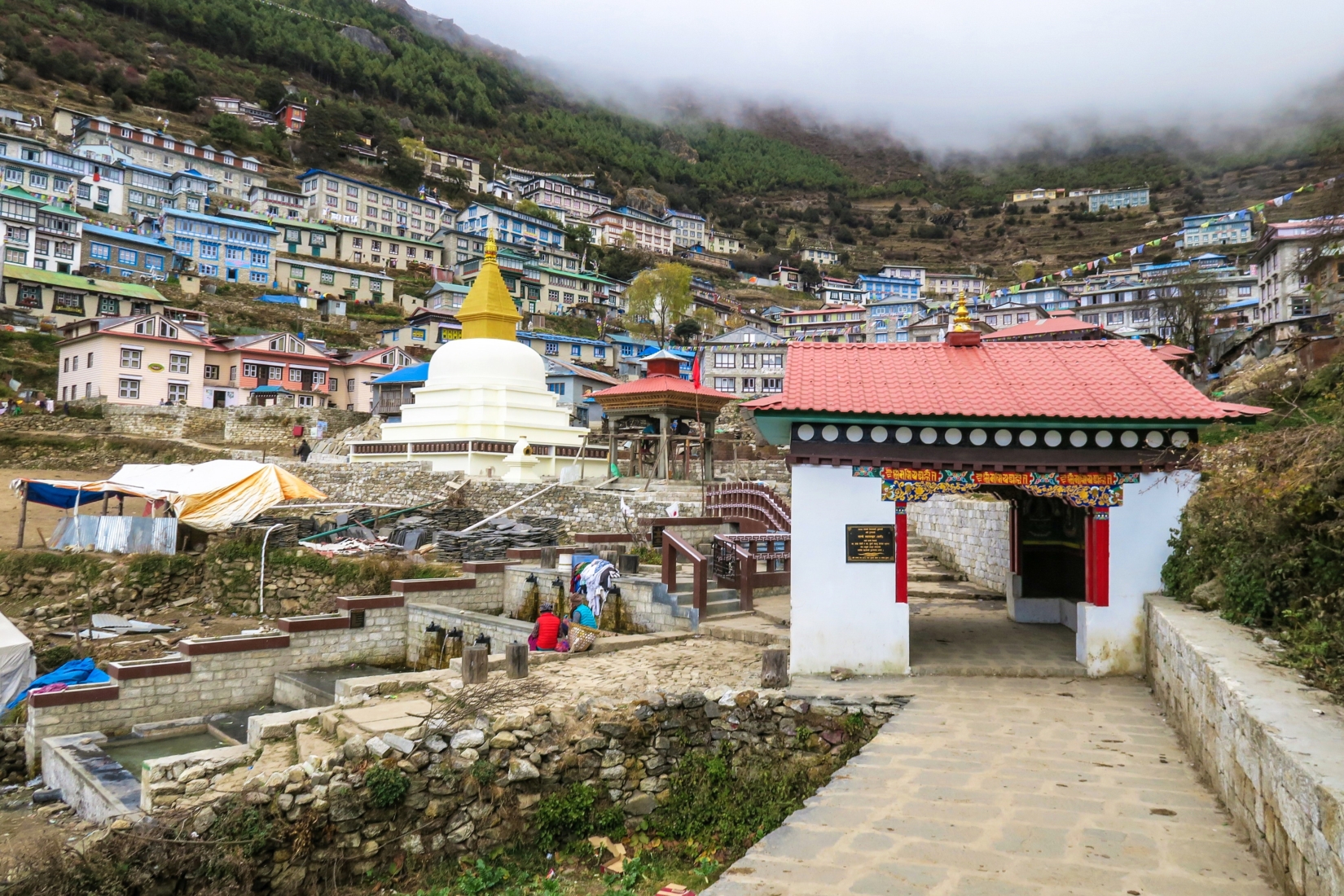
- Day 14: Namche Bazaar to Phakding (8,562 ft / 2,610 m) – As you continue downhill towards Phakding, observe the local agriculture and yak pastures as you pass by the majesty of the Himalayan peaks. You’ll spend the evening alongside the Dudh Kosi River, and take in the sights and sounds of the crystalline waters.
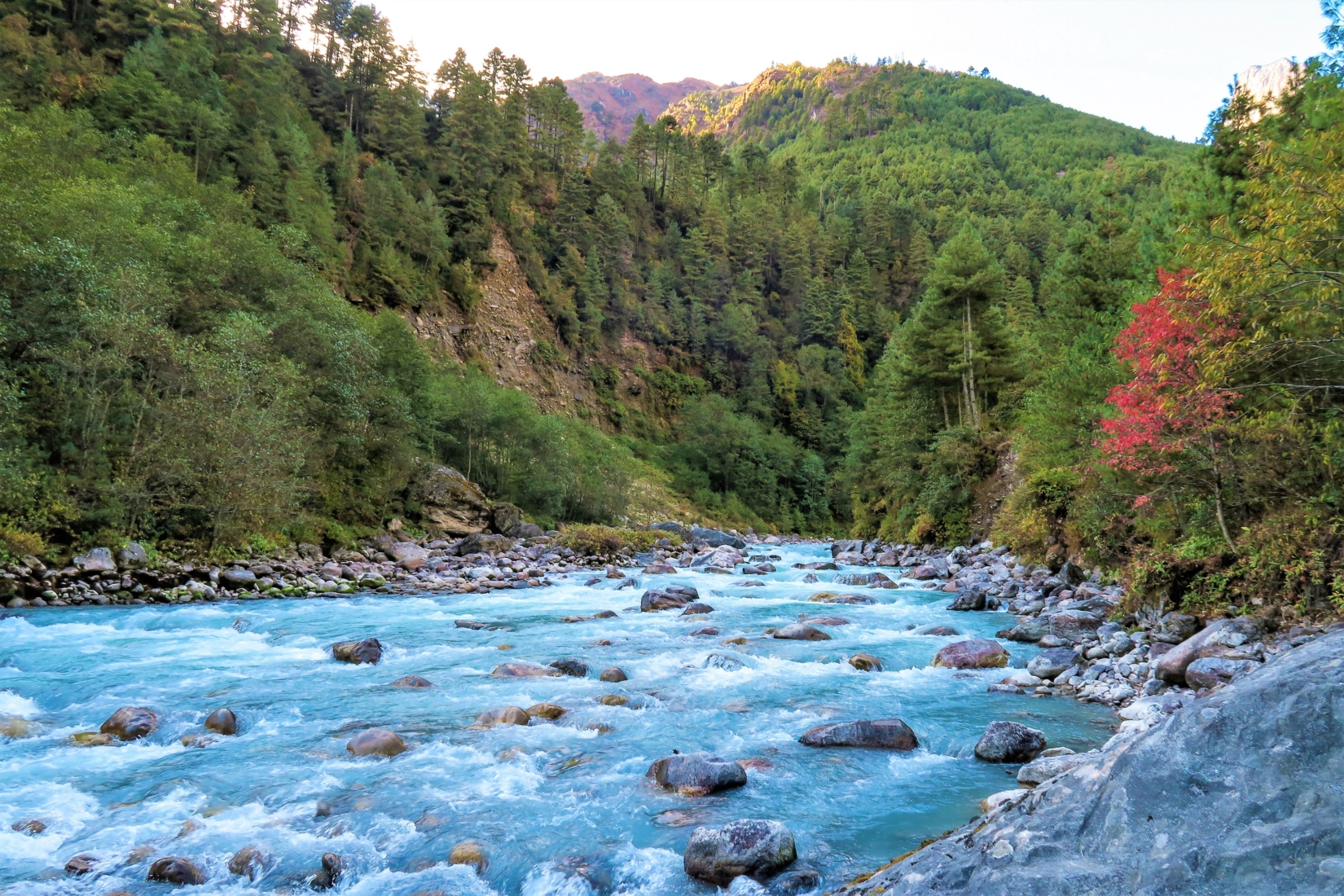
- Day 15: Phakding to Lukla – From Phakding, you’ll make our approach towards Lukla. Gather your new memories from the trip and enjoy your last days amongst unparalleled natural views in Nepal. You’ll stop for lunch in Lukla, with plenty of time to appreciate the clear landscape.
- Day 16: Lukla to Kathmandu – Returning to Kathmandu, you’ll have time and space to explore after having a chance to refresh and recuperate in your hotel. The Thamel district is a great place to wander with its many winding streets lined with souvenir shops, bars, restaurants, and more. There’s plenty to see and to try on the final day of your trip in Kathmandu. Soak up as much of the city’s offerings as you can as the end of our trip approaches.
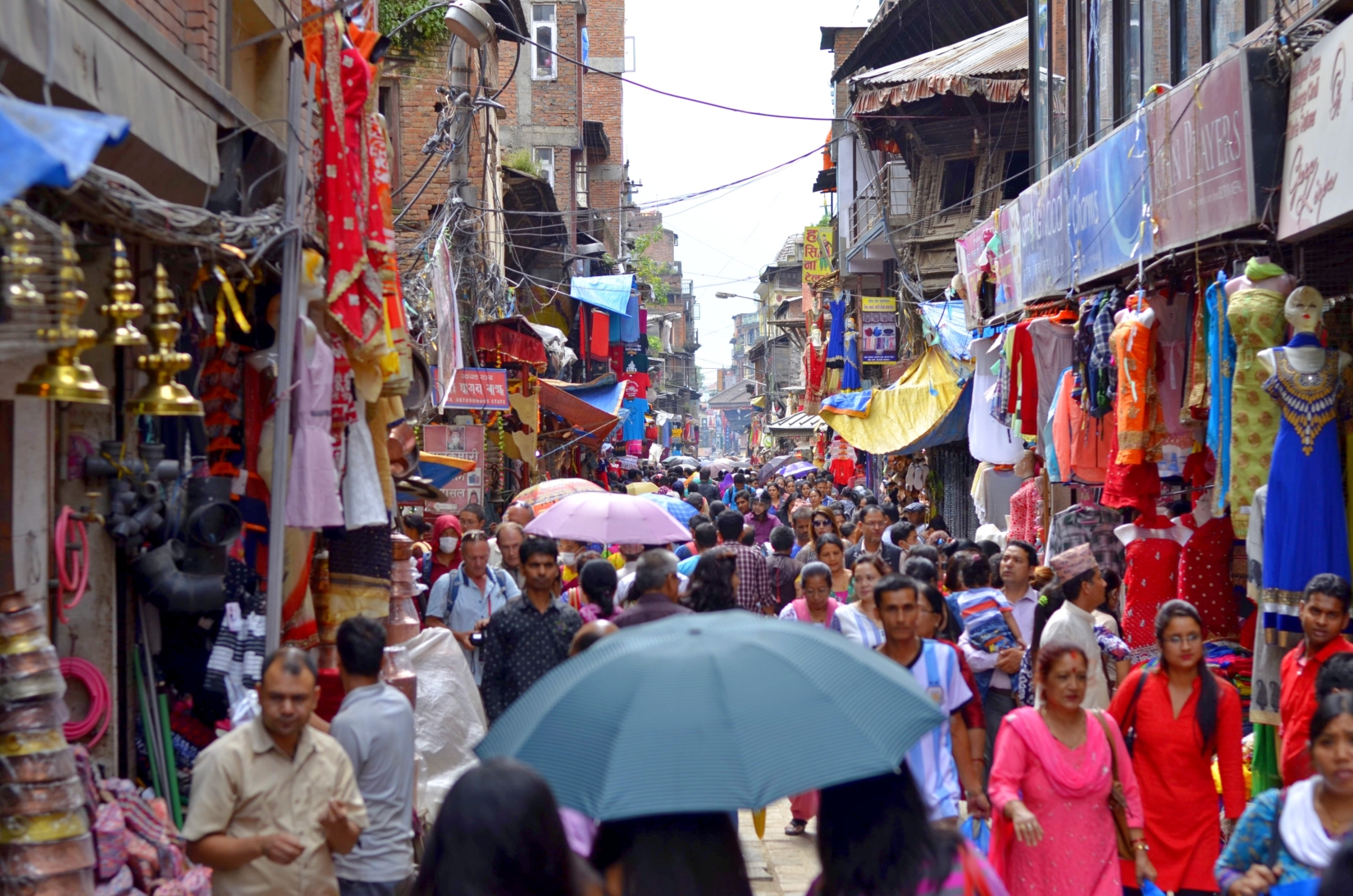
- Day 17: Today is your final day as an intrepid traveler exploring Nepal. You might have time to see some live music in Lazimpat or venture to Patan, which was originally known as Lalitpur, or the “City of Beauty”. Stop off at Newa Chen to add a visit to a 350-year-old Newari home, restored to its former glory and open to the public, to your trip. Be sure to experience as much of Kathmandu as you can, before you reluctantly head back home from this exhilarating adventure trip!
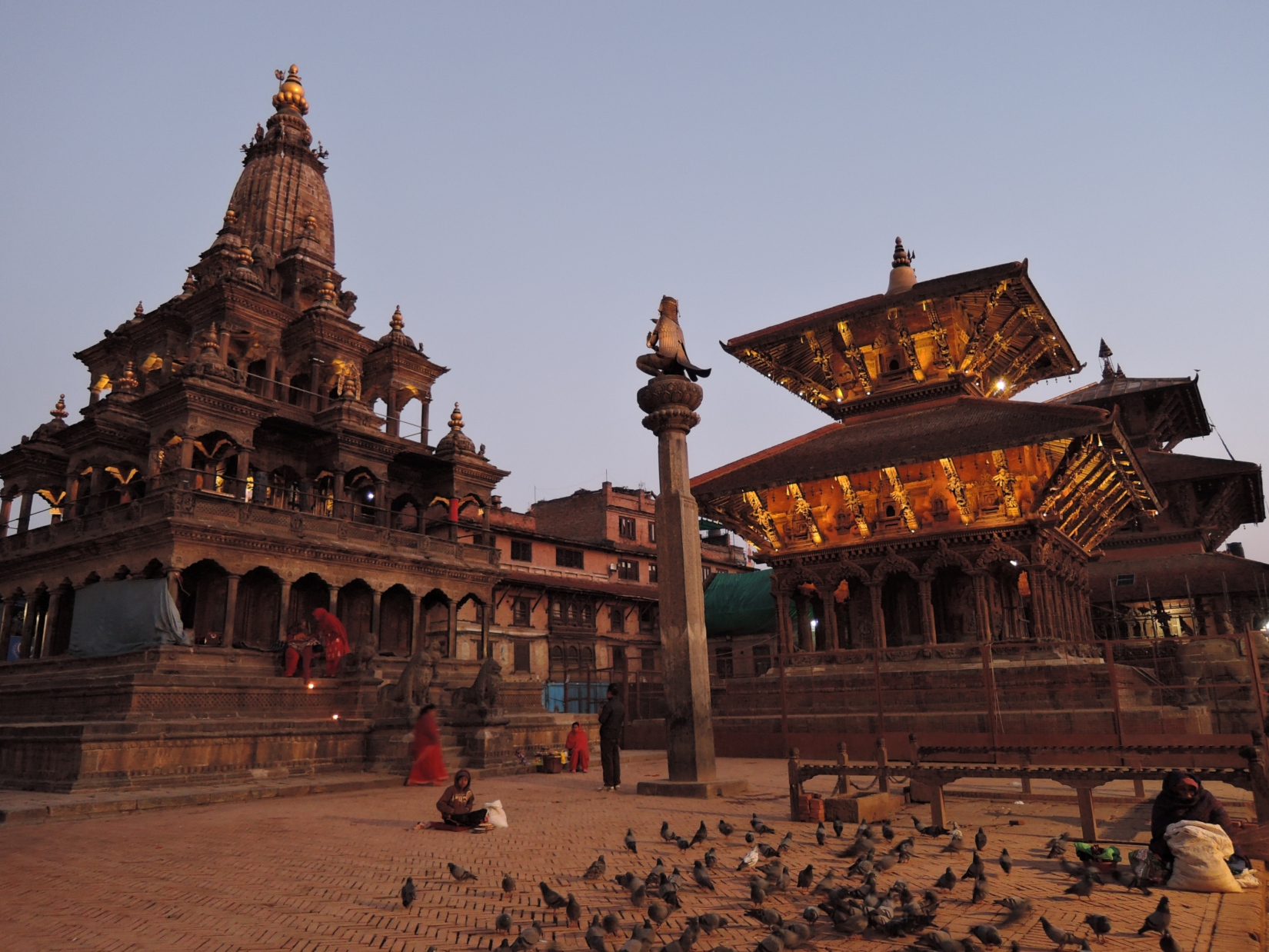
- Day 18: Depart from Kathmandu. Today you’ll return home having retraced many of Hillary and Norgay’s historic steps. You’re officially one of the lucky few who have witnessed the majesty of Everest up close!
Other Variations of the EBC Trek
The main up-and-back EBC Trek outlined above is by far the most popular route to the fabled camp on the slopes of Mount Everest, but there are also other options. Take the Three Passes Trek. It’s a circular romp that encompasses a trio of the highest traversable passes immediately around Everest itself, starting with Kongma La (18,175 feet) before pushing on through Cho La (17,782 feet) and then Renjo La (17,585 feet).
This is a considerably more challenging undertaking than the classic Everest Base Camp Trek, usually reserved for hikers with high-altitude experience. The reason? You spend multiple days walking at heights of over 16,400 feet. There’s also more chance you’ll have to contend with snowpacks – especially late and early in the main trekking seasons (April and November). The reward is a chance to explore all the nooks and crannies of the Khumbu Region, with visions of the gleaming Gokyo Lakes and remote Sherpa hill villages along the way.
Other variations include the dedicated Gokyo Lakes Trek, which involves portions of the Three Passes Trek at Cho La to offer a fuller visit of the Gokyo Valley before re-joining the route to base camp at Lobuche.
This trip guide is just a taste of what you should know before embarking on the remarkable trek to Everest Base Camp. For more details on general trip costs, accommodations, and more, check out the specifics on our Everest Base Camp tour page .
Better yet, if you have more questions on hiking to Everest Base Camp or need help planning your trip to the Himalayas, let’s connect! Our knowledgeable Adventure Consultants would love to hear from you so contact us and let us show you what’s possible .

Why travel with The Explorer’s Passage?
Experience the Everest Base Camp Trek with the best tour operator in Nepal. Our guides have been leading adventure trips in the Himalayas for over 30 years and are experts of trekking to Mount Everest Base Camp. They are also native to the Khumbu region of Nepal, the home of the Sherpa community, so you know you’ll enjoy an authentic experience.
We pride ourselves on delivering extraordinary tours based on travelers’ needs and are humbled by our guests’ testimonials . In fact, our dedication has earned us a 5-star rating on Tripadvisor , and awards by Travel+Leisure Magazine and Newsweek. Check us out and discover why so many travelers worldwide choose us . My team and I would love for you to join us on the trek to Everest Base Camp or any of our many other adventure trips !
I hope to go exploring with you soon!
Jeff Bonaldi Founder & CEO The Explorer’s Passage
About Jeff Bonaldi
Jeff Bonaldi is the Founder and CEO of The Explorer’s Passage, a premier adventure travel company. His mission is to provide travelers with the opportunity to transform their lives and the planet through the power of adventure.
Learn more about Jeff’s story and his company HERE .
Share This Amazing Location!
Related posts.
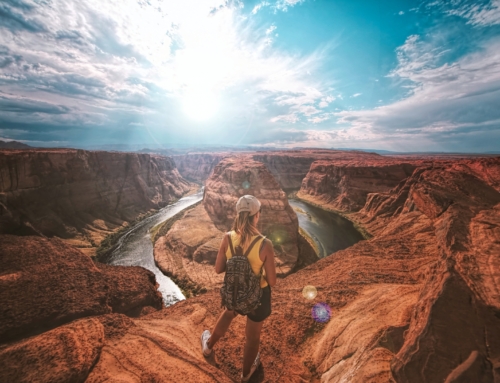
Expert Guide to Solo Travel & Top Destinations in 2024
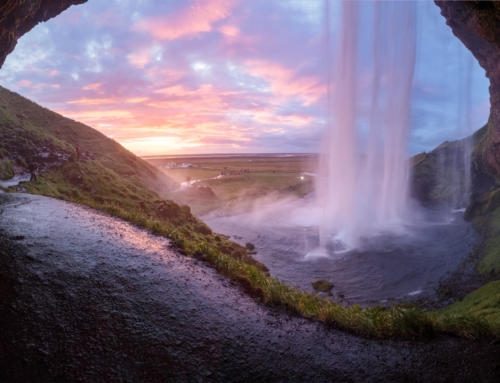
14 Best Places to Visit in Iceland in 2024
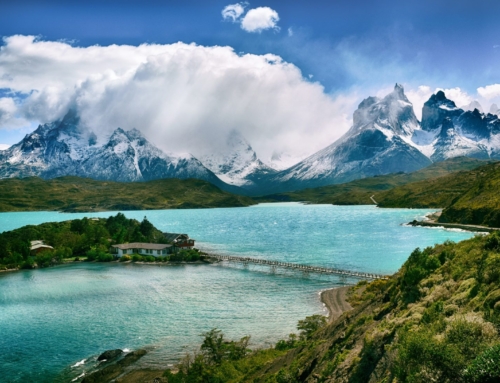
19 Things to Know Before Hiking the W Trek in Patagonia’s Torres del Paine in 2024

14 Things to Know Before You Climb Mount Kilimanjaro in 2024

The Ultimate Guide to Inca Trail Permits for 2024
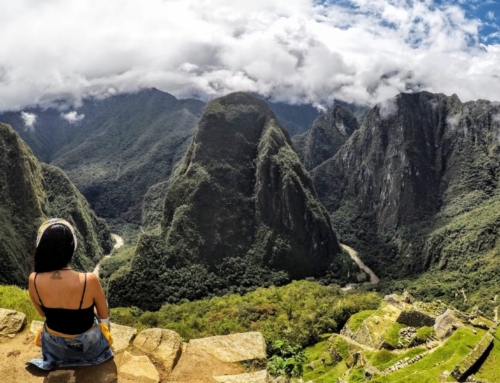
The Classic Inca Trail Route: A Day by Day Guide
Dos and don'ts for your Everest Base Camp trek
Dec 10, 2020 • 6 min read
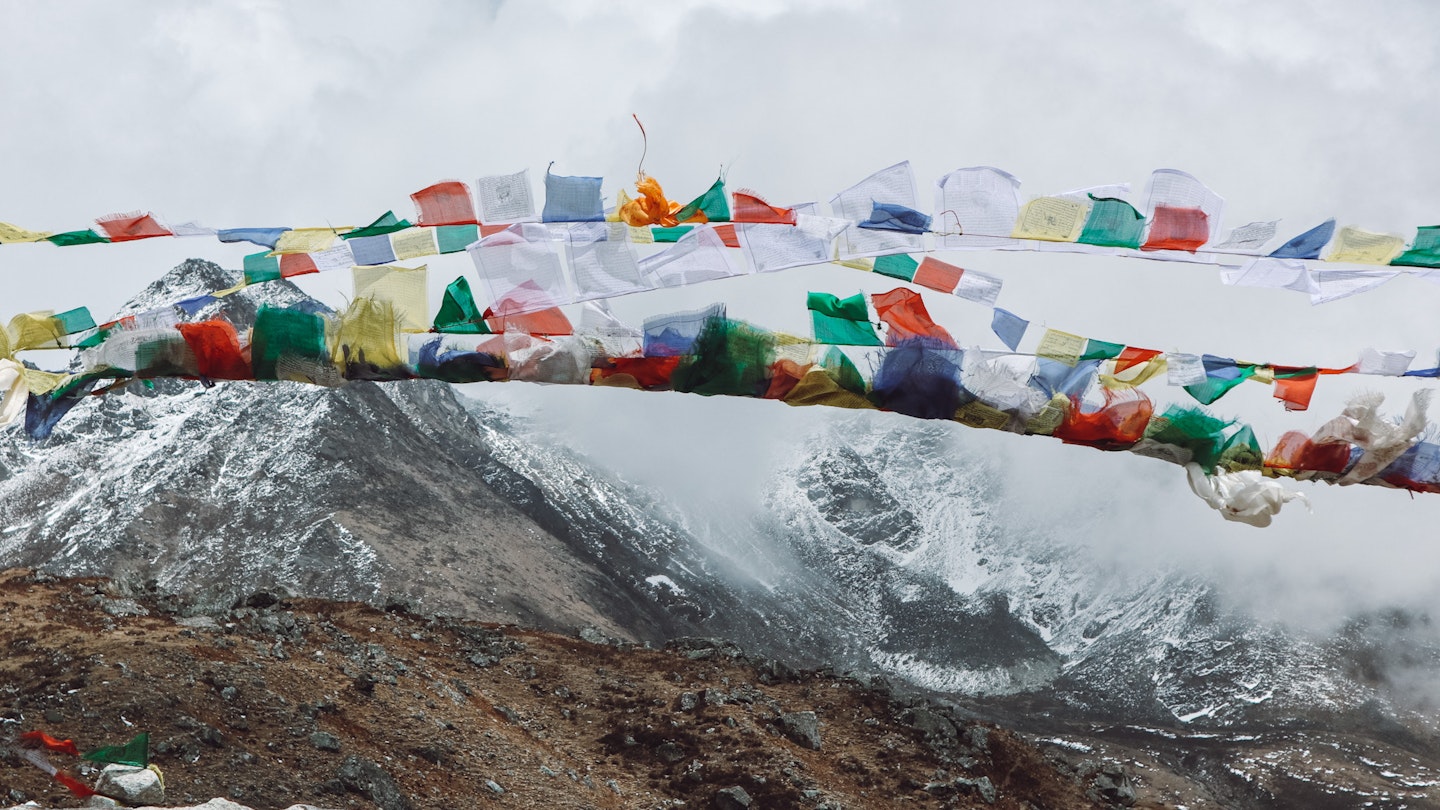
The Everest base camp trek can see over 30,000 visitors a year © Sarah Bence / Lonely Planet
Nepal is gearing up for another trekking season on its most famous routes. For many adventurous travelers, this means ticking Nepal’s Everest Base Camp trek off their bucket list.
The COVID-19 pandemic has meant the route was much quieter in 2020, although it reopened in November . Before that, it was becoming increasingly overwhelmed with trekkers, many of whom could use a lesson in simple etiquette. It remains to be seen how fast tourism will rebound in 2021, but no matter how many people are on the trail, there are ways to make it easier for everyone.
Editor's note: travel restrictions may be in place due to COVID-19. Always check ahead before planning a trip and follow government health advice.
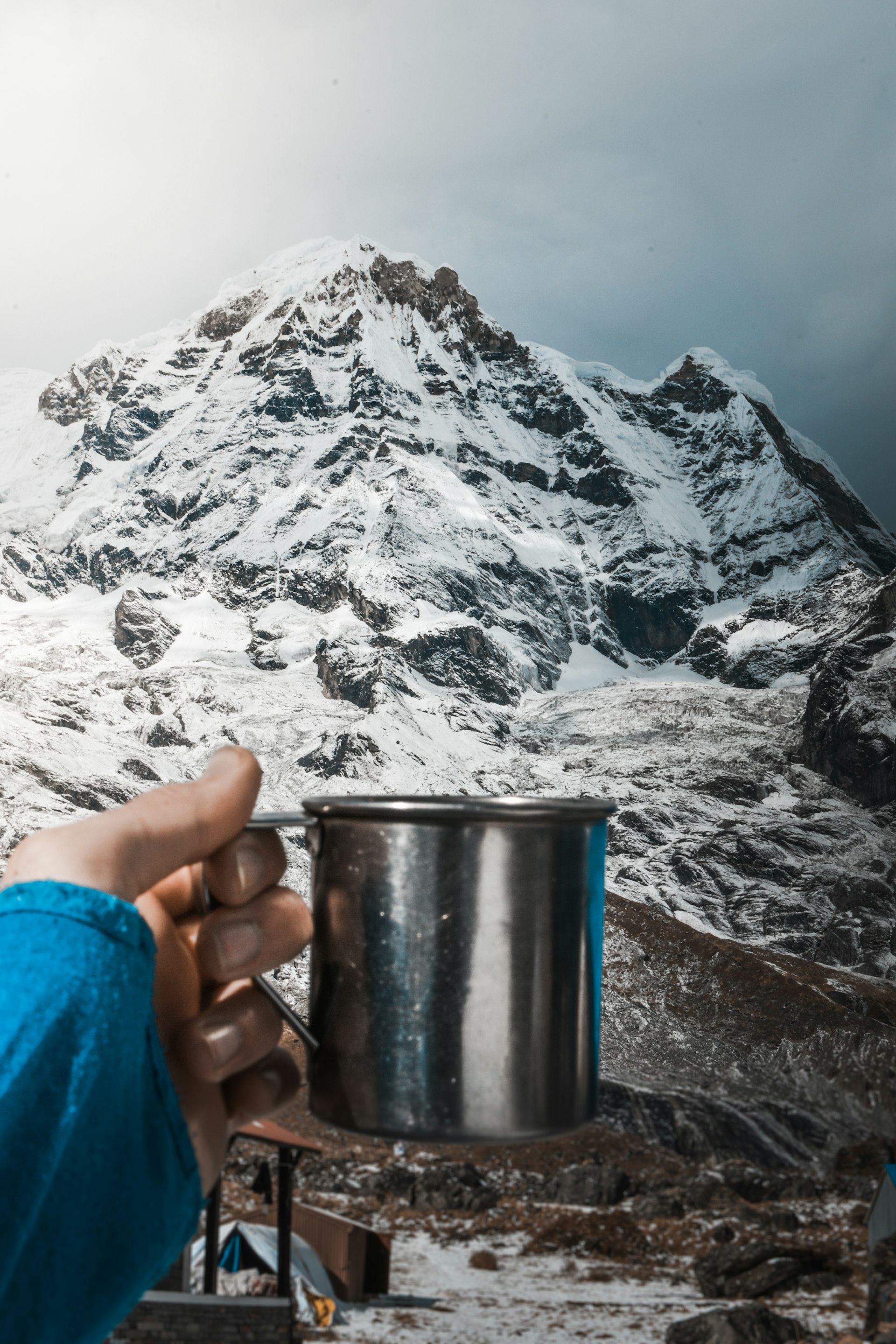
You meet all kinds of people when you travel, but there’s something about the Himalayan trail that can really bring out the jerk in some people. I’m thinking of the European trekker who yelled at my born-and-raised Nepali trekking guide for “walking on the wrong side” (as if there is a correct side of a muddy trail at 14,000-foot altitude).
There are, of course, also subtler ways to be rude on the way to Everest Base Camp, too, which can damage the environment and disrespect everyone from locals to fellow hikers. In an era when even the highest peaks of the Himalayas are trash-strewn and experiencing glacier melt, any uptick in traffic can indeed have an outsize impact.
For travelers who want to have a positive experience trekking to Everest Base Camp – and make it positive for everyone else around them, too – here are some things to be aware of.

Don’t complain about conditions
The popular Everest Base Camp trek is a multi-day hike into a remote region of the Himalayas. Don't expect 5-star luxury treatment.
I myself am not a fan of early morning visits to squat toilets in unheated teahouses, but I tried not to shout this from the mountaintops. It’s important not to complain about the conditions. When trekkers pass judgement, it can be taken as a personal offense to locals.
Guides do everything they can to make trekkers comfortable, and complaining sends the message that they are not fulfilling their responsibility, even if this is not the intent. Remember that your complaints are often a reflection of your privilege.
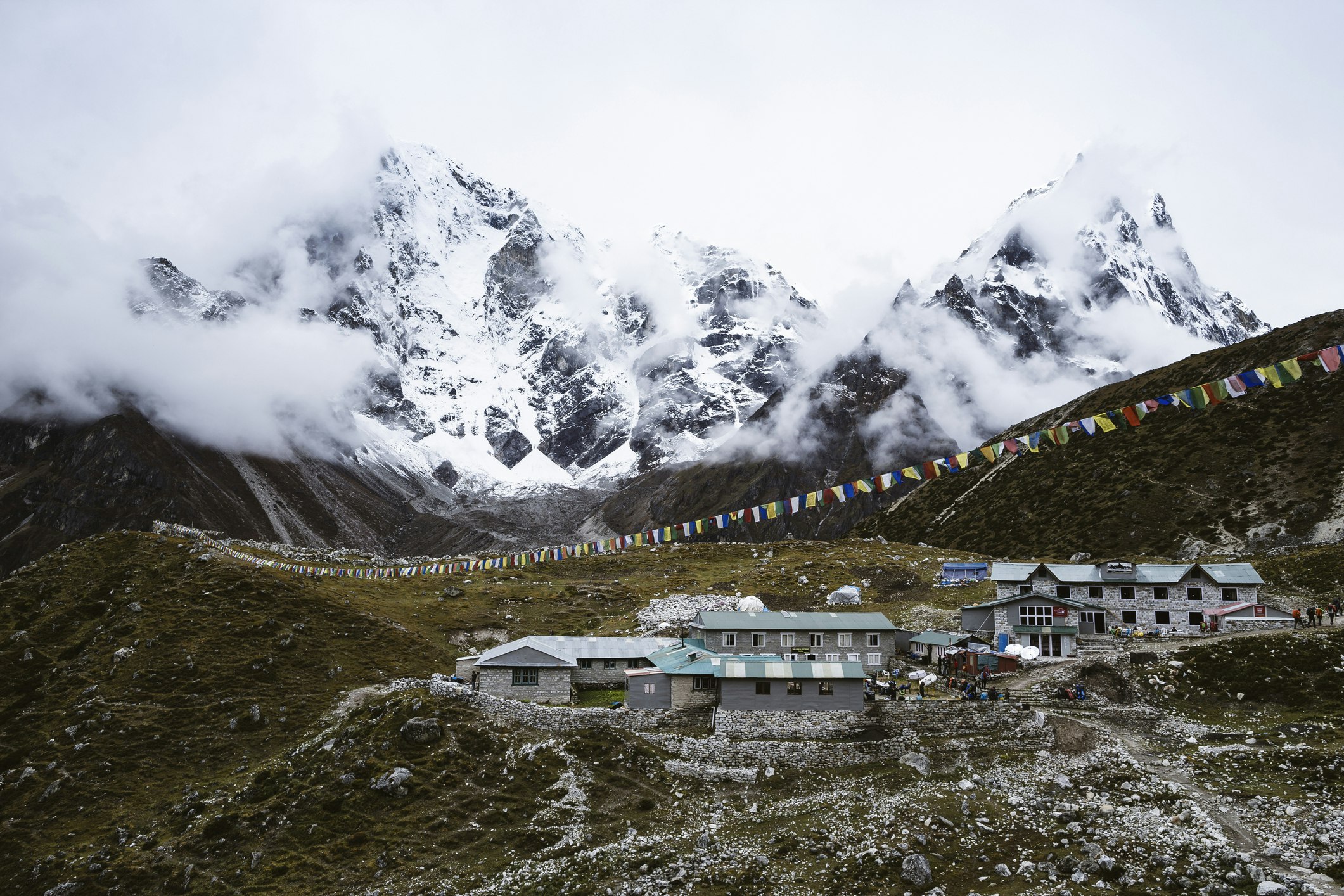
Do use the toilet
Speaking of squat toilets, use them. At a certain point, a poo in the woods might sound more convenient than yet another squat toilet, but for the love of Mother Nature, please resist. It’s important to use the provided facilities, not because of the (very real) risk of flashing another trekker, but to maintain drinking water quality in communities along the Base Camp route.
One side effect of more visitors on the Everest Base Camp trail is a very unglamorous increase in human waste – waste which inevitably makes its way into local water systems. That convenient forest wee carries with it implications for the public health of local people and trekkers alike. After all, you aren't the only one who's thought to cut corners by personally watering a tree.
Luckily, trekkers will frequently find public facilities along the Everest Base Camp trail – in teahouses, restaurants, and shops. And if needs must, trekkers can still go in the woods, as long as they make sure to pack out toilet paper and dig a cathole.

Do be adaptable
Not only are you at the whims of nature on the Everest Bake Camp trail, you're also in a different cultural environment than back home. In Nepal , organizational standards both on and off the trail might be different than what you’re used to.
Remember that trekker who yelled at my guide for “walking on the wrong side” of the trail? There we were, trudging along at 14,000-foot altitude, when he had the gall to run into my guide, and then yell, “It’s Nepal! They drive on the left here!”
First of all, there’s not a right or wrong side on the Everest Base Camp trail – there’s just common sense, and doing your best to not be in the path of an oncoming yak or a porter. Secondly, if this man had spent any time in Kathmandu he might have noticed that even “driving on the left” is taken as a suggestion rather than a mandate in Nepal.
The point is to always be adaptable. Trekkers should try to maintain a certain level of operational flexibility on their way to Everest Base Camp. Aim to adjust to the local culture, rather than impose their own upon it. Remember that you aren't the authority – and that's OK.
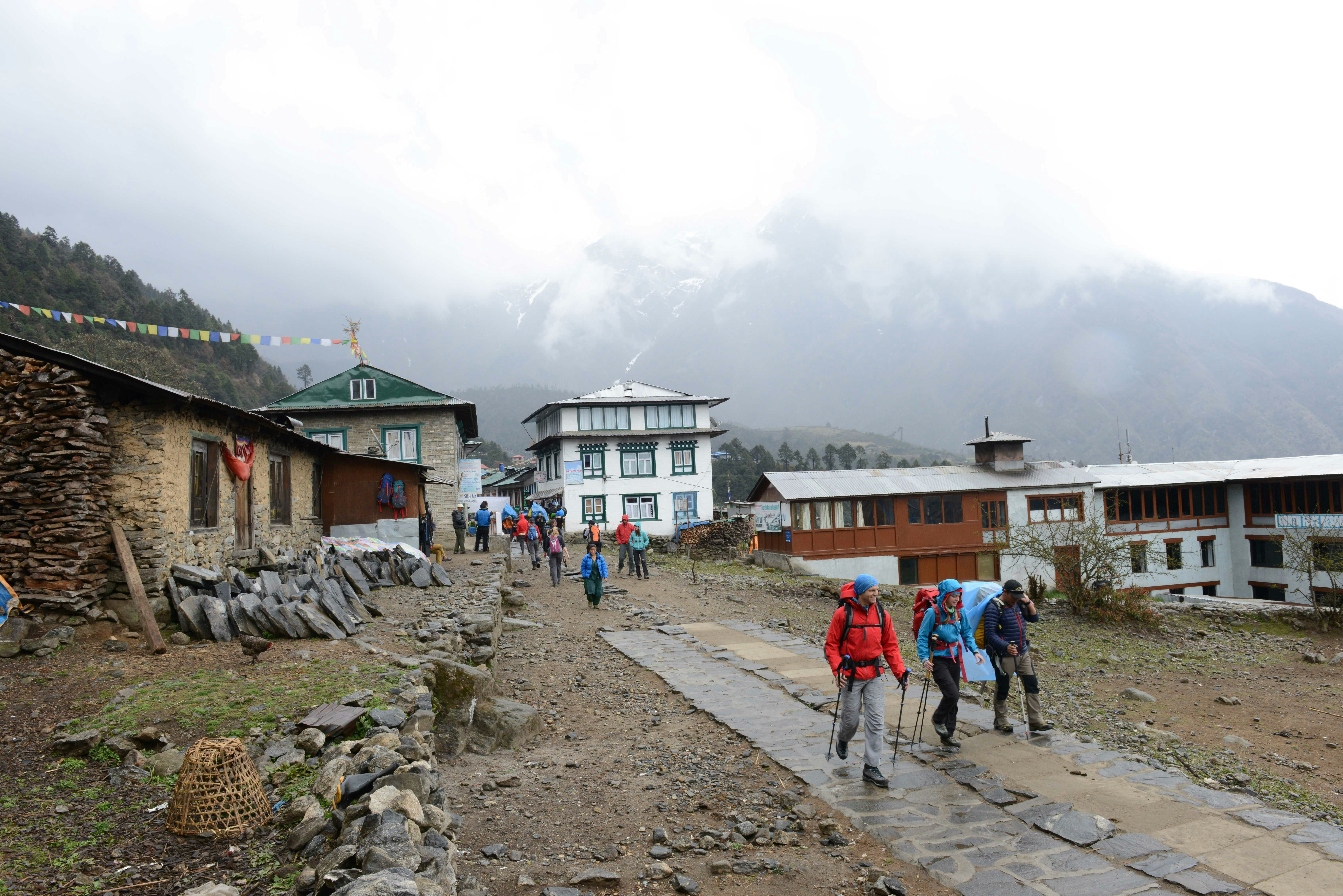
Don't rush
Trekking to Everest Base Camp is, undoubtedly, a physical feat. That doesn’t mean it should be treated like a competition. While the Everest Base Camp trek holds significantly fewer risks than actually summiting the world’s highest peak, the root of the risks are the same. When trekkers begin to rush along crowded trails, things can get dangerous.
This is why trekkers should adopt a marathon mentality. After all, base camp isn’t going anywhere. Additionally, a multi-day descent follows the adrenaline-fueled arrival at base camp, which can be bad news for trekkers who burned themselves out on the way up.
Based on my own trek in 2018, the most crowded and jerk-filled area of the trail was the final rush before Everest Base Camp itself. Essentially, there are multiple routes to reach base camp, which funnel down into one boulder field in the final few kilometers. The increase in trekker density, combined with the sight of base camp’s yellow tents in the distance like a dangling carrot, can be a dangerous combination.
Trekkers should remember their marathon mentality, and continue being aware of safety and surroundings as they make that final push. Not only could you prevent an injury or bad experience for yourself, but you could also help someone else make the most of their difficult, expensive trip to Everest, too.
Do learn the native names
Finally, trekkers should make an effort to learn the native names and history of Everest and its surrounding peaks. This won’t automatically make them an enlightened trekker, but it does show respect toward the local people and culture of which you are a guest.
Everest, for example, was only titled as such in 1865 by a British surveyor, in honor of another British surveyor (Sir George Everest). For centuries before that (and to this day) the world’s highest mountain was known by the local Sherpa people as “Chongolungma,” which roughly translates to “Goddess Mother of the World”.
There are many ways to be a responsible trekker in Nepal – which even include choosing alternative treks to Everest Base Camp. Truly responsible trekkers should also keep in mind these etiquette tips for a culturally sensitive experience that won't leave you feeling sheepish.
You might also like:
How to pack for the Himalayas Discovering Nepal's best trekking regions 6 day-trip destinations from Kathmandu
This article was published February 2020 and last updated December 2020.
This article was first published February 2020 and updated December 2020
Explore related stories
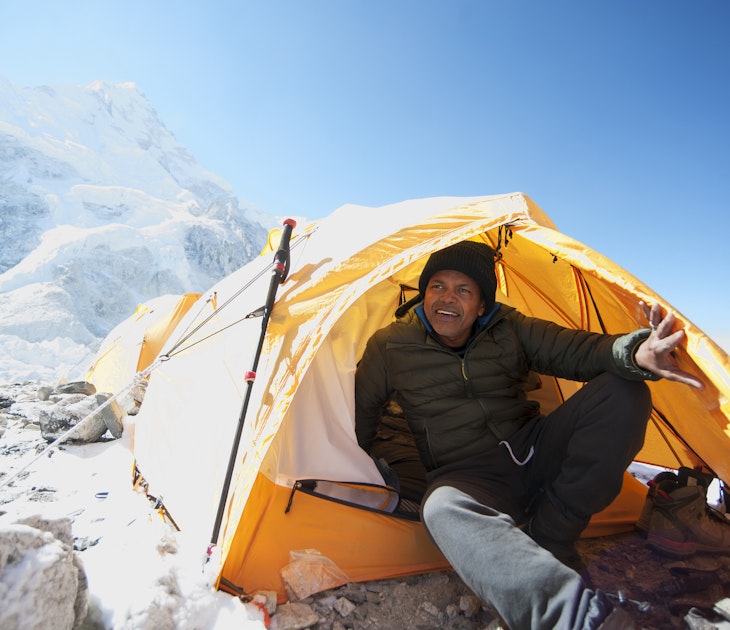
Jun 20, 2023 • 10 min read
Lonely Planet writer Bradley Mayhew recently returned from trekking to Everest Base Camp. Here’s what he thinks every visitor needs to know.

Mar 14, 2023 • 4 min read

Jul 13, 2022 • 8 min read

Jan 31, 2022 • 6 min read
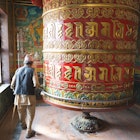
Jan 9, 2022 • 8 min read

Sep 14, 2021 • 11 min read

Jan 28, 2021 • 5 min read
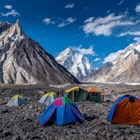
Jan 12, 2021 • 7 min read
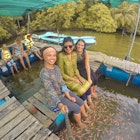
Jan 7, 2020 • 6 min read
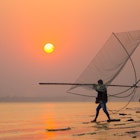
Oct 10, 2019 • 9 min read
.webp)
Everest Base Camp Trek
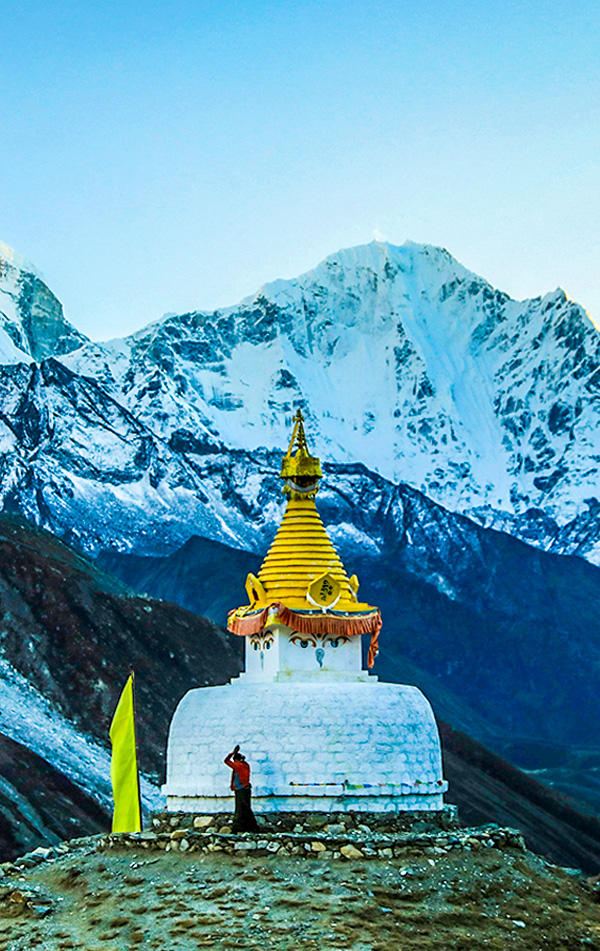
Kathmandu |
Kathmandu | Nepal
Max Altitude
Trekking Km
Help & Support
67000 /person $ /person.
- October-2024
- November-2024
- +5% GST (Goods and Services Tax)
- USD 1500 +5% GST for Non-Indians
- Services Kathmandu to Kathmandu
- Lukla flight, Food & Stay in Kathmandu included
Offload 5300
Backpack offload is optional
Choose add-ons during booking. If missed, log in and add them later.
Book off-load at least 10 days before the trek.
For offline bookings at the base camp, a convenience fee of Rs. 6000 applies.
Cancellations made before the trip date will receive a full refund.
For more information. Please complete this form.
Help & Support
Trek Name: Everest Base Camp Trek
Adventure Type: Trekking
Base Camp: Kathmandu
Season: Summer | Autumn |
Month: March | April | May | September | October | November |
Country: Nepal
Altitude: 18200 Ft.
Grade: Difficult
Rail Head: Kathmandu is not connected to any Railways
Stay: Hotel and teahouse
Food: Meals while on trek & at Hotel/Guesthouse (Veg & Eggs)
Location: Kathmandu
Distance: 108 Km.
Trail Type: One way trail | Camping in various locations, starting and ending at the different point.
AirPort: Kathmandu (Tribhuvan International Airport)
Why Everest Base Camp Is A Must-Do Trek
When it comes to trekking in the Himalayas, Mt. Everest is the most celebrated peak and not just in our country but all across the globe. For avid trekkers and mountaineers, getting up close to the highest mountain peak in the world is a once-in-a-lifetime experience. This classic trek takes place in the Bagmati Zone of Nepal and allows you to experience the immense beauty of the surroundings. Along your trek, you will get to witness 4 of the 6 highest mountain peaks in the world — Cho Oyu (8,201 m), Mt. Makalu (8,470 m), Mt. Lhotse (8,516 m), and Mt. Everest (8,848 m).
Everest Base Camp is a teahouse trek, which means you will stay at some of the highest villages in the world and get a close look at their cultures and traditions, and life in the remote corners of the Himalayas. Staying at the Sherpa villages you will get to learn a lot about the mountain lifestyle and how inextricably the people are connected to the mountains. There are many notable junctures throughout the trek and Kala Patthar is one such point. Standing at an altitude of 5,500 m it offers an astonishing view of Mt. Everest . EBC trek presents a wonderful opportunity to experience the grandeur of the Himalayas, the imposing challenge and thrill of the climb, and the charming culture of Nepal.
Trekking in Nepal is all about trekking amidst the biggest mountain ranges and on this trek, you will see mountains surrounding you. All along the way, you can feel the sense of legacy left behind by the greatest mountaineers. Crossing the route beyond Namche Bazaar, you will come across, Tenzing Norgay Stupa, a tribute to the great mountaineer, who was the first to scale Mt. Everest along with fellow mountaineer Edmund Hillary. Also, just near Dughla on Everest highway, there are memorials for distinguished mountaineers who dedicated their lives on the slopes.
Reaching Everest Base Camp means trekking through the traditional Sherpa villages, with warm and friendly villagers, hidden Gompas, picturesque mountain views, and exceptional natural beauty. Those who take part in such a trek will never forget the amazing experience.
About The Trek
Your journey will start at Kathmandu from where you will take a short flight to Lukla. The iconic trek starts at Lukla in the southern part and the trail weaves towards Namche Bazaar in the north. We will stay a day here, acclimatizing to the higher altitudes. It then diverges in the northeast direction towards Pheriche and Dingboche. Once we reach Dingboche, we will spend a day at Dingboche as a rest day. From Dingboche, the route continues to Lobuche. Everest Base Camp is a little further east from here and the Kala Patthar viewpoint can be seen towards the west.
There are other variations to the trek route as well, where the trek bifurcates towards Gyoko Ri early on at Namche Bazaar. The route then follows the left side to arrive at the Base Camp. Sometimes people also prefer trekking from Jiri village instead of Lukla, Jiri is a short bus ride away from Kathmandu. However, trekking from Jiri adds a couple of days to the trek as Jiri is considerably further away from Lukla. The EBC trek follows a gradual ascent up to the base camp, following which there is a steep descent. The entire journey lasts for 13 days and in between, we also have acclimatization days as well.
What Can You Expect At The Trek
It is a difficult grade trek. Trekking to the Everest Base Camp requires exceptionally high physical fitness and while the trek is not dangerous, you need to prepare well for it. A variety of factors add to the difficulty of the trek like the terrain, the duration of the trek, the distance covered every day, and the number of days spent at high altitude and a difficult exit in case of emergencies. While all trek is not especially tricky but it is surely an endurance test.
It is a high altitude trek and as such chances of AMS are quite high but with adequate hydration, proper rest, and a well-planned itinerary taking into consideration the acclimatization criteria will help counter such issues. Our trek leaders are mountaineering-certified individuals with a keen understanding of AMS and other high-altitude issues. They can detect the signs of AMS early on and adopt necessary measures for the prevention of the same. Our Trek Leaders are also all Wilderness First Aid Responders, who are diligent in handling emergencies.
The trek from Lukla to Everest Base Camp is 50 km and it takes 13 days to complete the trek starting from Kathmandu. To mitigate the risks of being at a higher altitude for such a long time, we have incorporated acclimatization and rest days in the itinerary. Mt. Everest can be spotted multiple times on the trek even in the initial part of the trial.
In cold conditions, batteries drain pretty quickly be it phones, cameras, or Kindles. Make sure to bring spare batteries with you. Some teahouses allow you to charge your phone and other electronics but they will charge you for it.
Be prepared for extreme weather conditions as the weather at high altitudes is unpredictable. Layer properly to regulate your body temperature and stay comfortable while trekking. When its sunny, the weather can get quite warm and you may even have to discard a couple of layers in the first few days of trekking, however, the temperature at night drops pretty quickly. Make sure to drink a lot of water to stay hydrated and avoid altitude sickness. Also, remember that sunburn happens much quicker at higher altitudes so always wear sunscreen and keep your sunglasses ready.
Accommodations at Everest Base Camp will be in teahouses in Sherpa villages or mountain lodges. Also, keep enough cash with you as there are no ATMs in Lukla. Also, if you want to do some last-minute shopping for trekking gear and equipment, Kathmandu is a good place to do so.
- Who can Participate
- Important Links
- How to Reach
- Trek Essential
Who Can Participate
Age; 15 years.
Experience of any high altitude trek, at least 1 treks of 4,000m/13,100ft.
The climber must be fit and have sufficient stamina to cover 5 km of distance in 30 minutes without stress.
The climber should be able to carry a 12-16 kg backpack.
Pulse rate at rest must be in between (60 to 90 beats per minute)
Blood Pressure Reading must be in between (DIASTOLIC 70 – 90, SYSTOLIC 100 - 140 mm Hg)
Respiratory rate at rest must be in between (12 to 20 breaths per minute)
Should not have Liver and kidney issues
Should not have Diabetes Mellitus, Bronchial Asthma, Heart problems, Hypertension etc
No pacemaker implant
People with the Sinus issues, Epilepsy please contact to trek coordinator before booking the trek
If your BMI is not normal, Please contact our Trek coordinator before Trek booking.
Medical & Disclaimer Form (Mandatory Documents) Click here to download Medical & Disclaimer Form
- Government Employees can avail the benefit of Special Casual Leave (SCL) when you join us for a trekking expedition. As per the rules of the Pay Commission, Special Casual Leave can be availed for up to 30 days in a calendar year for trekking/mountaineering expeditions through a registered organization. Trek The Himalayas is a registered adventure tour operator by Indian Mountaineering Foundation (IMF) and Ministry Of Tourism (MOT)
- Trekkers have to apply for leave at least 20 days before trek departure date,
- This service is exclusive to Indian government employees and is applicable only for treks within India.
- Do mail at info@trekthehimalayas to apply and mention your booked trek date and trek name.
Junior trekkers (below 15 years) should have a company of parents/guardians.
Trekkers between 15 to 18 years can come solo with the disclaimer form signed by parent/guardian.
- Medical & Disclaimer Form (Mandatory Documents) Click here to download Medical & Disclaimer Form
Exercise For Difficult
Fitness Regime For:
Calculate Your Bmi
Your BMI value is
Congratulations, your body is in good conditions!
Arrive At Kathmandu
- Altitude: 1,400 m/ 4.600 ft.
- Spend the day exploring Kathmandu.
- A short briefing session in the evening.
- Stay: in hotel (included in cost).
Welcome to trekkers’ paradise, Nepal. Nepal is characterized by beautiful Himalayan summits, rich natural biodiversity, and beautiful culture and history. Once you arrive at Kathmandu airport, you can take a taxi to the booked hotel in Kathmandu. There are loads of taxis available at the airport and you can easily find one to drop you off at the hotel. Once you check-in to the hotel, you can freshen up, and in the evening, you will receive a briefing session where you will learn about the trek and your schedule for the upcoming days. If you have any questions about the trek, then you can clear them at the time of the briefing session. Post the briefing session, you can explore Kathmandu and do some last-minute gear and equipment shopping if you want.
Note that, from April 2019 most flights have been diverted to Ramechhap airport due to construction and crowding at Kathmandu Airport. Ramechhap is a small Airport Ramecchap in Manthali and 4 hrs drive away from Kathmandu. In this case, your flight will be booked for the next day. So take an early night flight to Kathmandu and get ready to leave Kathmandu City by 1 o’clock so that you can take an early morning flight from Ramechhap airport.
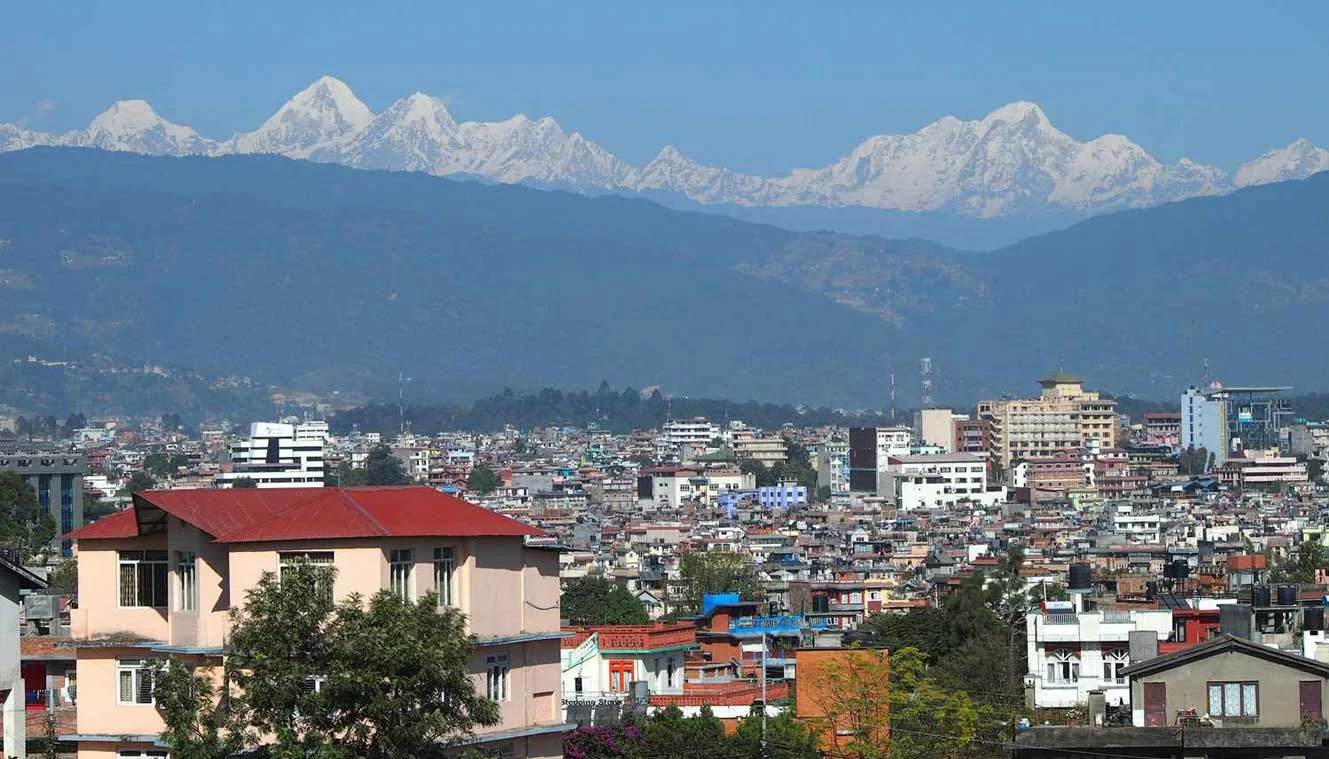
Fly to Lukla, Trek To Phakding | Enjoy A Scenic Flight Journey
- Altitude: Lukla - 2,850 m/ 9,350 ft; Phakding - 2,600 m/ 8,500 ft.
- Altitude Gain: 1200 m/ 3,900 ft.
- Early morning flight to Lukla (30 minutes).
- Trek to Phakding: 9 km | Duration: 4 to 5 hrs.
- Easy and gradual descent.
- Cheplung village lies en route from where you can see Mt. Khumbila.
- You can buy or refill your water bottles from teahouses on the way.
Get ready for a beautiful flight from kathmandu or ramechap to Lukla. Its a short flight of about 35 minutes that will take you over a panoramic landscape. On these flights, the planes are quite small but the journey is quite scenic. Our representatives will meet you at Lukla airport and this is where your trek towards Everest Base Camp starts.
After arriving at Lukla, we will start our trek towards Phakding after some refreshments. The trail is 9 km long and passes through Nepali mountain villages, green mountains, suspension bridges, and forests to Phakding. It takes about 4 to 5 hrs to complete the trek. From Lukla, the trek begins with a gradual ascent, with a few ups and downs along the way. Along the route, you will witness amazing views of Kusum-Kanguru as you cross a suspension bridge on your way. After a short climb, you will arrive at Ghat Village and after another one and a half hours of gradual walking, you will arrive at Phkading. En route, you will also spot boulders that are carved with Buddhist Prayers. We will stay overnight in Phakding.
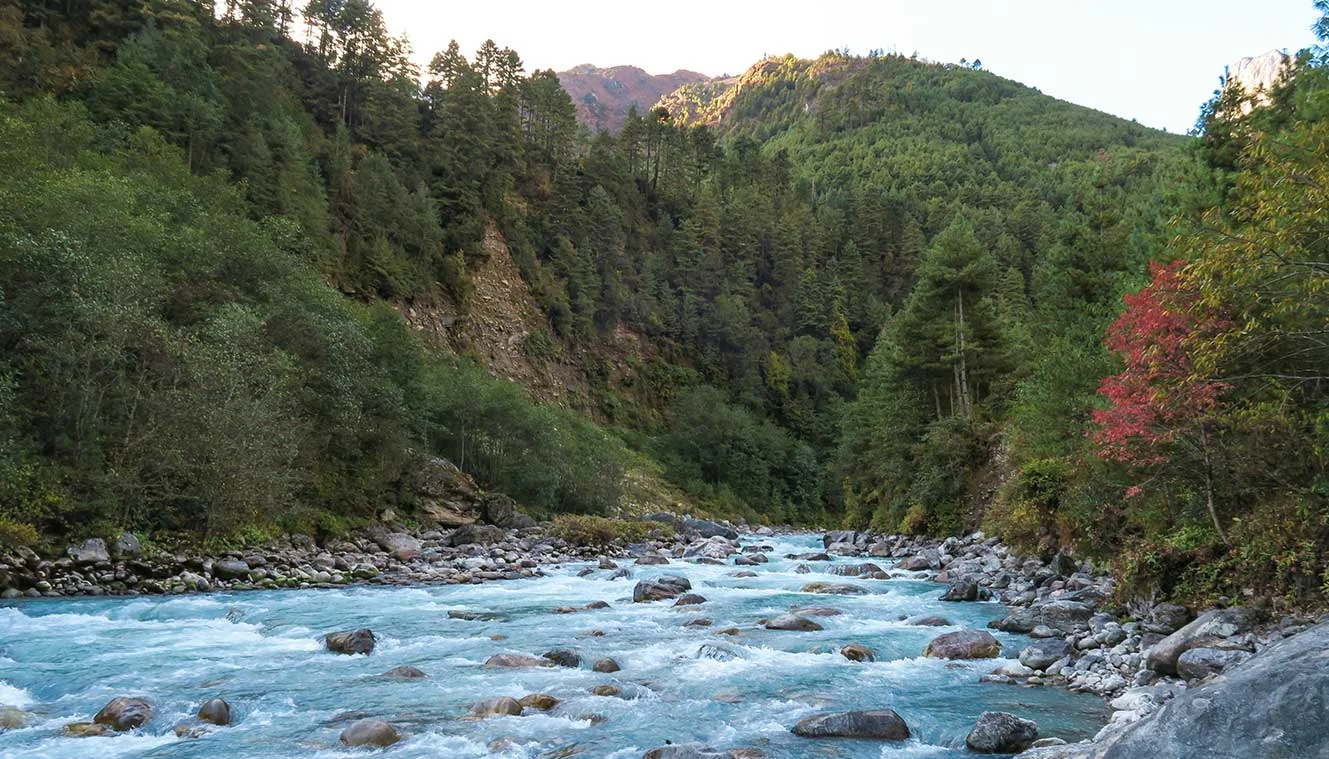
Phakding To Namche Bazaar | A Major Trading Hub In Khumbu
- Altitude: 3,450 m/ 11,300 ft
- Trek: 10 km | Duration: 7 hrs.
- Altitude Gain: 850 m/ 2,800 ft.
- Moderate level of climb and steep climb before Namche Bazaar.
- Namche Bazaar is the capital of the Khumbu region.
- You will get the first views of Mt. Everest today.
- You will spot Kongderei and Thamserku peak.
- Monjo village is the mid-point of the trek.
- A swiss suspension bridge on Dudhkosi River. It is one of the major attractions.
- Dudhkosi River is considered as the lifeline of the Khumbu Region.
- Today you will enter into the Sagarmatha National Park (a UNESCO World Heritage Site).
Post breakfast, we will start our trek towards Namche Bazaar. The route today is surrounded by green mountains and will take you through suspension bridges over the Dudh Koshi and Bhote Koshi rivers. Before entering the Sagarmatha National Park, you will have to obtain permits and then the trail follows a steep ascent before arriving at Namche Bazaar. Namche Bazaar is an important trading hub of the Khumbu region.
We will start our trek early in the morning from Phakding and soon you will cross a suspension bridge over the Dudh Koshi River, the walk from here is easy and pleasant with short uphill and downhill climbs. You will cross another suspension bridge over the Bhote-Koshi River. It is a busy area and you may notice a multitude of trekkers and porters here. After a 20 minute climb from this area, you will arrive at Monjo. Monjo is a pit stop for many trekkers and many people also camp here. At Monjo, you will see interesting watermills that are used to grind barley, a staple diet of the Sherpas. Monjo is situated right below the majestic Thermasarkhu peak (6,608 m) and quite close to this village is the entrance to the Sagarmatha National Park.
Treading along the Dudh Koshi River, you will arrive at the Sagarmatha National Park. At this point, your trekking permit will be checked and the officials will keep a record of all the trekkers going ahead. Sagarmatha is a UNESCO World Heritage Site that showcases stunning mountain views and rich biodiversity. Here, you may spot rare Himalayan species like snow leopard and the lesser panda. The presence of Sherpa settlements with their unique culture makes the trek even more interesting. A gradual walk from Sagarmatha National Park will lead you to Namche Bazaar. From Namche Bazaar, you will catch the first glimpses of Mt. Everest. Namche Bazaar is a historic trading center of the Khumbu area and you can stock up on essentials from this point. At night we will stay here at a guesthouse.
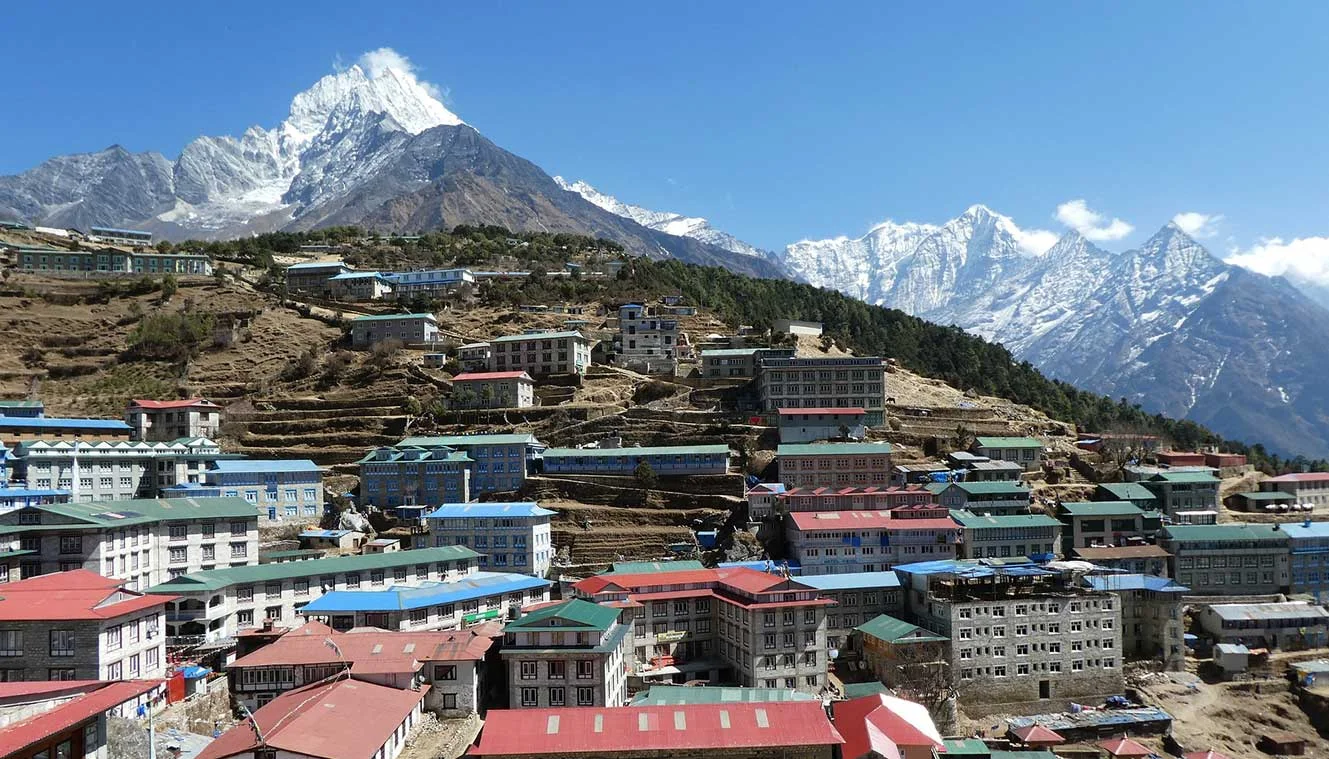
Acclimatization Day | Explore Namche Bazaar
Wake up to the beautiful views of the highest Himalayan peaks and enjoy a delicious breakfast. Today we will stay in Namche Bazaar allowing our bodies to acclimatize to high altitudes. You can spend the day exploring the surroundings and enjoy the culture and hospitality of Nepal. Namche Bazaar is a commercial hub so you can do any last-minute trek shopping from here. The market has a vibrant atmosphere and there are a couple of restaurants and coffee shops as well.
You can do a short hike to Sagarmatha National Park headquarters. From here, you can get a good view of Ama Dablam, Mt. Everest, and other Khumbu peaks. Sherpa Cultural Museum is close by and lies just above Namche Bazaar. The museum gives you a fair amount of details about the history of the Himalayas, the geographic and cultural aspects, mountaineering history, and information about the various flora and fauna in the region. You will see many pictures of Tenzing Norgay and Edmund Hillary from their climb and maps detailing their trails as well. In the evening, take acclimatization walks around the market, preparing your body for higher altitudes. Soak in the Nepalese Buddhist culture, food, and traditions. Namche Bazaar gained popularity during the time when Tibetan salt was traded for grains from Nepal\\s lowlands. Nowadays, you can see a roaring trade of rugs, clothing, dried meat, and salt in the village center. There are many shops that also offer locally made handicraft items, you can buy them as souvenirs or gifts for your friends and families. You will stay the night at a guesthouse in Namche Bazaar.
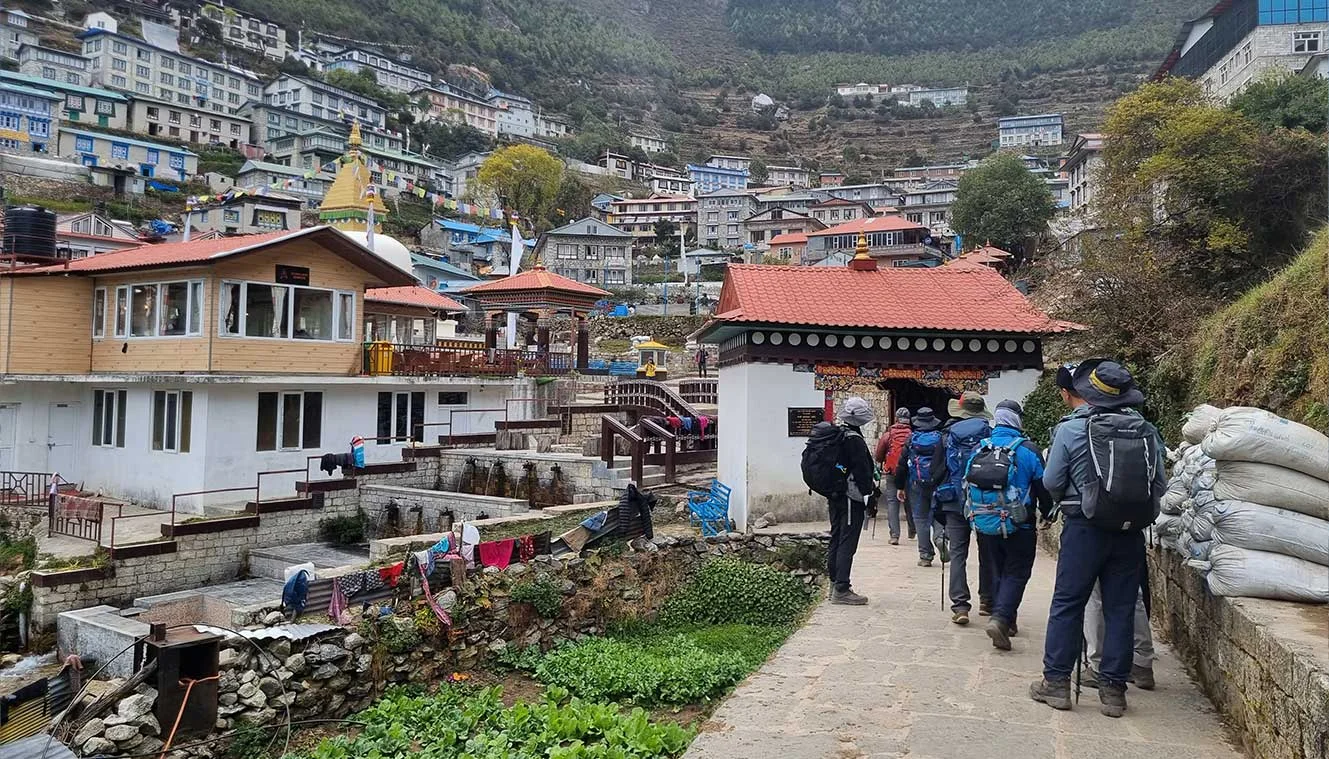
Namche Bazaar To Tengboche | Visit The Largest Buddhist Monastery Of Khumbu
- Altitude: 3,850 m/ 12,650 ft.
- Altitude Gain: 400 m/ 1,350 ft.
- Trek Distance: 8 km | Duration: 5 to 6 hrs.
- Mixed ascent till Phunki Tenga.
- Steep ascent after Phunki Tenga to Tengboche.
- Tengboche has the biggest monastery in the area.
- You can attend a prayer ceremony held by the monks to invoke protection on your expedition.
- Cross another high bridge at the village of Phunki Tenga.
Start your day with a delicious breakfast and get ready for your trek to Tengboche from Namche Bazaar. It’s an 8 km long trail and is a fairly easy trek accompanied by the views of the majestic Himalayas. You will also spot Himalayan Wildlife on the way as well.
Tengboche is a small alpine valley that is situated at an altitude of 3860 m and the trek starts with an easy walk. The trek from Namche Bazaar to Tengboche is extremely beautiful and along your trek, you will get a bird’s eye view of Dudh Koshi River down below and the epic mountain views as Thamserku (6,608 m), Kantega (6,782 m), Ama Dablam (6,812 m), Lhotse (8,516 m) and Everest (8,849 m) comes into view.
A 20-minute walk from Namche Bazaar will take you to the top of Namche Bazaar. From here the trek descends to Khumjung, a Sherpa village and then climbs up the sides of the mountains through some stairs and then diverges from the Everest Highway at Sanasa. You will be able to catch glimpses of Lhotse, Nuptse, and Mt. Everest from here. This is probably the best view of Mt. Everest you will get until you reach Gorakshep when climbing to Kala Patthar. Two hours of pleasant walking will bring you to Sanasa. Up to Sanasa, it is a walk-through forest covers of Oak and Rhododendrons. It is a great location for bird watching and you may spot the Danphe Pheasant, the national bird of Nepal. Musk-deer and Himalayan Tahr, a Himalayan goat that looks like an antelope are commonly spotted in these areas. You will also spot the Tengboche monastery from here which you will reach in the later part of your trek.
Next, following a gradual descent, you will reach the Imajtse River at Phungitenga at an altitude of 3,250 meters. Phunki Tenga is a small Himalayan settlement with teahouses and army posts. The climb down can be a little tougher as the terrain is rocky and uneven. You will reach a suspension bridge over the river and after you make the crossing, you will need to get permits at a checkpoint to proceed further in your trek. From here it is a strenuous climb of about an hour that will take you to a Buddhist monastery just before Tengboche and finally to Tengboche village. This is the last part of today’s trek and you can expect the trail to be rocky with a couple of switchbacks. Don’t push yourself too hard, take it slow and steady as you make your trek uphill.
Tengboche Monastery, locally known as Dawa Choling Gompa is the largest monastery in the Khumbu region. It overlooks the beautiful region and the mountain landscapes around. There are daily prayers that occur around 7:00 am and once around 3:30 pm. You can take part in the prayers if you truly want a cultural experience. It is one of the important cultural aspects of the EBC Trek. Enjoy the serenity at this revered place of worship and at night your stay will be in the guesthouses at Tengboche.
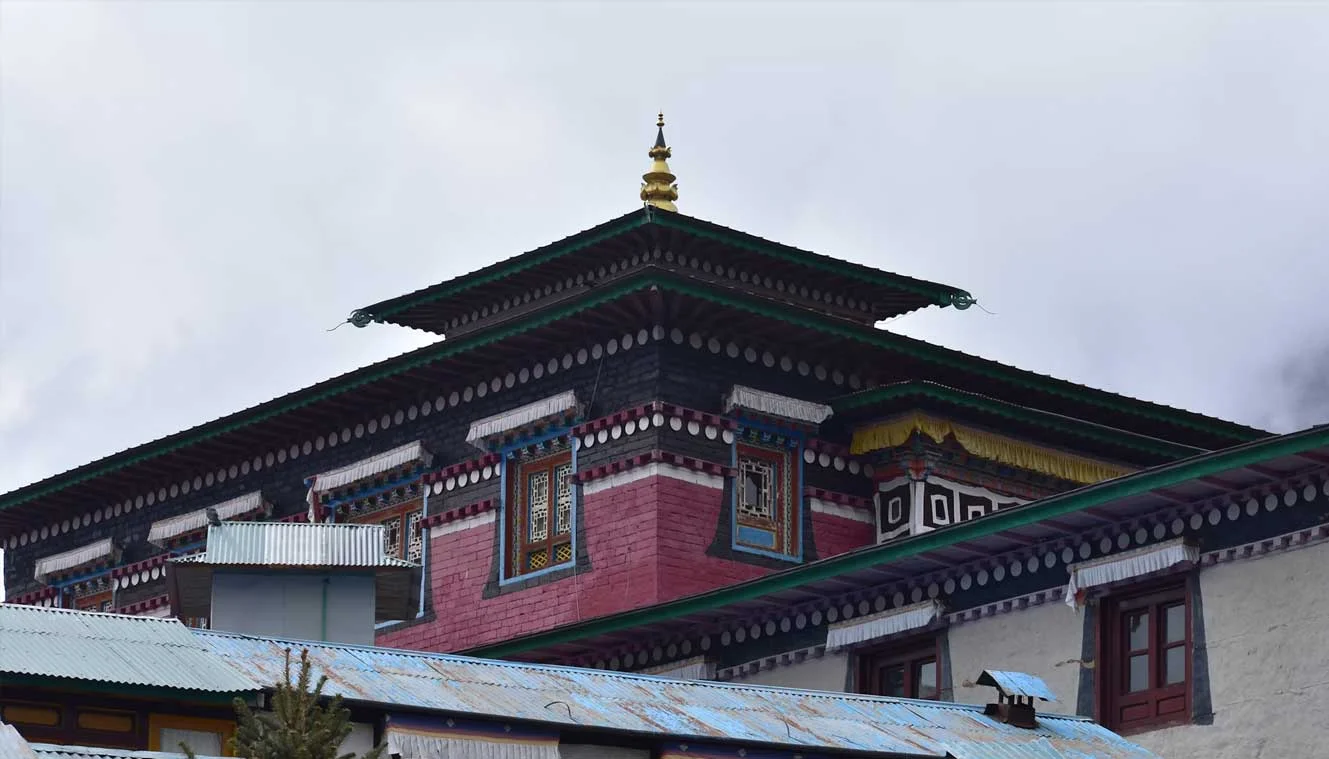
Tengboche To Dingboche | Stunning Views Of Ama Dablam
- Altitude: 4,350 m/ 14,250 ft.
- Altitude Gain: 500 m/ 1,600 ft.
- Trek Distance: 9 km | Duration: 6-7 hrs.
- Gradual descend and little bit of ascent after Lobuche River to Dingboche.
- The trail passes through lush forests of birch, conifer, and Rhododendron trees.
- The route offers amazing views of Ama Dablam standing over you.
- The trail crosses the Imja River to reach Pangboche.
- Continue along the Imja Valley and Lobuche River before ascending to Dingboche.
Today, we will begin our trek towards Dingboche. From Tengboche, cross bridges and rivers accompanied by beautiful mountain views all the way to Dingboche. Stone steps will lead you through forests of Rhododendrons, conifers, and birches, and at the bottom of the forest lies the Deboche village. From here, the trail rises up and enters into the alpine meadows and Dingboche. Dingboche is the only place in the entire Khumbu region where barley is grown. The views of the Himalayas are amazing from Dingboche. Start your trek from Tengboche and walk towards Pangboche Village, you will get to see some beautiful views of Mt. Ama Dablam and from Pangboche we will trek towards Pheriche and to Imja Valley. The beautiful Lobuche River passes through Imja Valley and from here a steep hike will take you to Dingboche. The trek takes about 6 to 7 hrs and for the most part, the difficulty is moderate.
At the beginning of the trail, you will first descend into a forest trail passing the small settlement of Deboche. As you trek from Tengboche to Dingboche, the scenery changes as you gain altitude, greenery slowly giving way to barren landscapes, and the trails gradually becoming more rugged and it will also start getting cold and windy. In the initial part of the trek, you will pass by a wall with stone inscriptions and a small stream will keep you company along the trail. You will have to cross the stream to the left-hand side of the valley. The majestic Ama Dablam dominates the skyline ahead of you. About two hours into the trek, you will arrive at Pangboche, a mountain village, where you get beautiful views of Mt. Everest. From Pangboche, you will hike upwards towards the valley and throughout the trek, you will slowly gain elevation. Although the trek is mostly uphill, the slope is relatively easy without extremely steep inclines. Ama Dablam continues to stay in view, however, you will only get to see a tiny silver of the top of Mt. Everest. Lhotse and Nuptse become quite prominent now.
Soon you will arrive at the village of Shomare, your last village before Dingboche. Ama Dablam still remains in view but now you will get to see a different angle of the mountain from what you have seen before. The trail continues winding to the valley side and you will cross another river before entering Dingboche village. Dingboche is a lovely Himalayan hamlet and you will see agricultural fields protected by stone walls. Once at the village, we will check into a guesthouse and we will stay the night in the guesthouse.
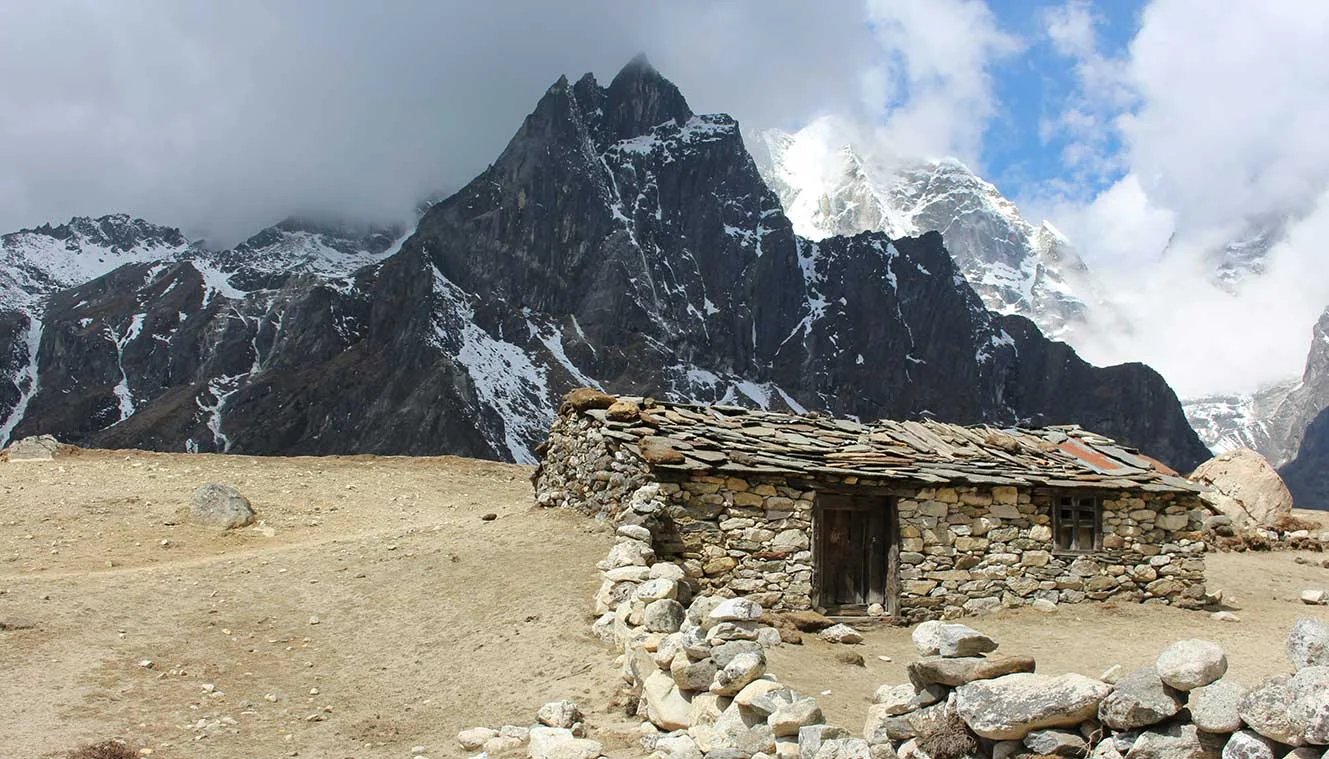
Dingboche (Rest Day) | Acclimatize To Higher Altitudes
Today is a rest day at Dingboche, which will help us acclimatize to the high altitude. As we exert a good deal of energy on the trek, our body needs to get accustomed to less oxygen at higher elevations. So instead of taking a rest day, if continue to gain elevation it can result in altitude sicknesses like dizziness, nausea, and headache or potentially even more dangerous conditions like cerebral or pulmonary edema. To prevent these issues, we start our acclimatization process at the 11,500 ft mark. Since Namche Bazaar is quite near that elevation, we start our acclimatization process from Namche Bazaar itself.
For acclimatization, you can walk around the village. Dingboche village has many farms and crop fields sparse across the village, native crops include barley, potatoes, and buckwheat. You can also do a short hike around the village to Chukung. Its a 3 - 5 hrs trek that takes you to an altitude of 4,730 m. Chukung lies in the Imjatse Valley towards the east. Although the trek is gradual you can feel the effects of thinning air. Chukung has a couple of teahouses as well and you get a superb view of the surrounding areas from here. Some of the views are exceptionally beautiful as you continue to climb higher and higher. Explore the valley and the surrounding areas, return back to the guesthouse. This hike will prepare your body for the next few days at higher altitudes.
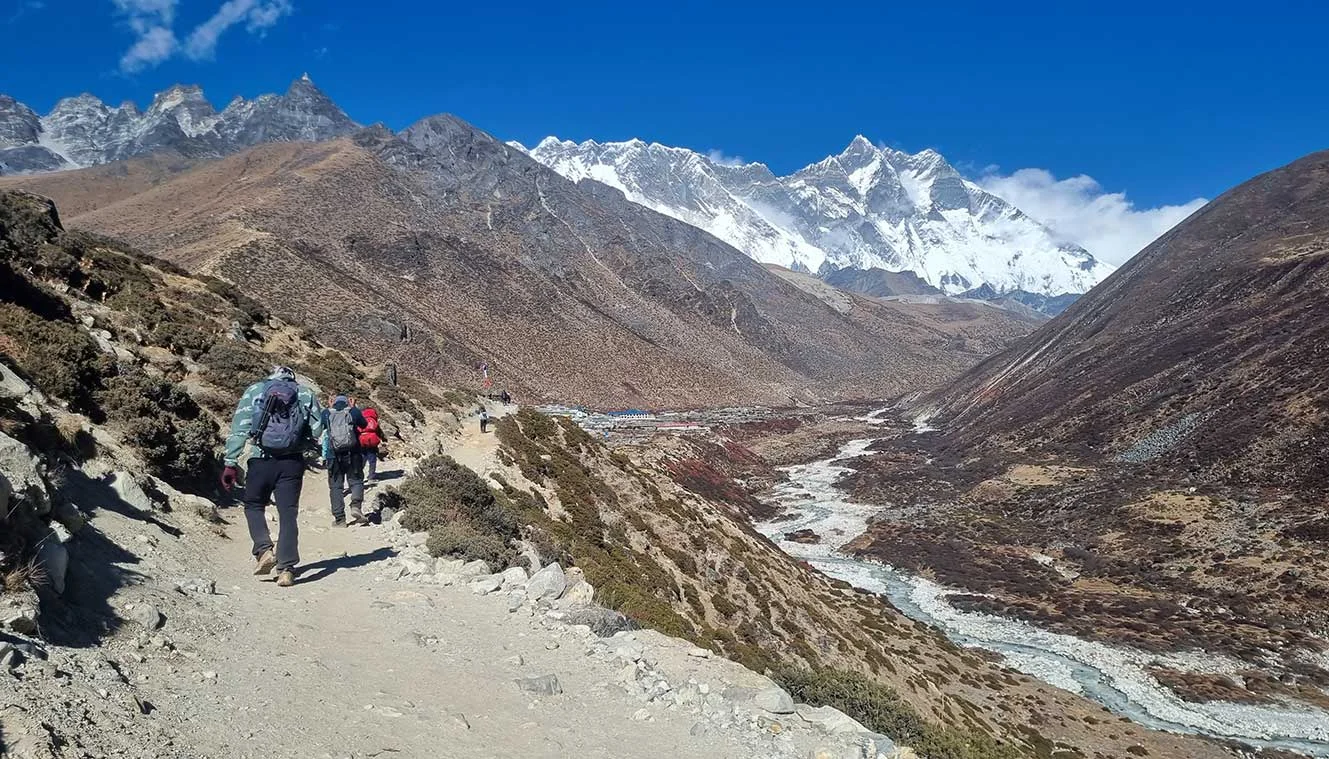
Dingboche To Lobuche | Pay Your Respects In Everest Memorial
- Altitude: 4,950 m/ 16,200 ft.
- Trek Distance: 7 km | Duration: 6 hrs.
- Altitude Gain: 600 m/ 1,950 ft.
- Tricky climb on moraine and rocky terrain.
- You can visit the memorial shrine.
- The top of the ridge is filled with prayer flags and stones which are memorial shrines for climbers who lost their lives on Mt. Everest.
- As you cross Khumbu Glacier, you will see Mt. Nuptse (7,861 m).
Today’s walk will take you from Dingboche to Lobuche through alpine pastures and in the summertime, you can see Yaks grazing in these pastures. You will trek towards the end of the moraine of the Khumbu Glacier offering spectacular views of Mt. Nuptse. At the moraine, you will see stone monuments, these are dedicated to six Sherpas who died in an avalanche along with monuments dedicated to other mountaineers. From here, it’s a steep climb towards Lobuche where you will get a magnificent view of Mt. Nuptse and the sunset over this mountain peak is even more spectacular. From Dingboche, you will have to ascend a small ridge behind the village, towards the north you can see Lobuche Peak (6119 m) and the snowfields of Cho La. Later you will cross Khumbu Khola, the huge glacier moraines of the Khumbu Glacier flowing from Everest. Crossing the memorial cairns, and following the valley stream, you will arrive at Lobuche in the early afternoon. The 6 hrs trek covers 7 km and brings us much closer to the Everest Base Camp.
Start the hike from Dingboche along the inclined path running alongside the mountain’s wall and go further into the valley. As you make your turn along the path and inside the valley, you arrive at the village of Pheriche, we will be staying here on our way back from the base camp. For the next 2 to 2.5 hrs, you will follow into the valley, while the incline is not very difficult but you are at a high altitude, so take it slow and steady and avoid using too much energy too quickly. A river lies in front of you and crossing the river, you will arrive at the village of Thukla. This is a great spot to rest for a couple of minutes, refuel yourself and continue on the trek.
The next part is going to be the toughest part of the trek today as you climb to Lobuche. The climb takes you along a zig-zag path all the way to the Thukla Pass and it becomes steeper and steeper as you climb until you reach the edge of the Khumbu Glacier and the Everest Memorial. The oxygen gets less and less from here and the temperature also starts to get lower. The remaining part of the trek follows the left side of the glacier as you reach the village of Lobuche and you will also gain a little elevation from the glacier as you arrive at Lobuche. In front of you, you get to see a beautiful view of Nuptse in front of you. Lobuche is a small Himalayan village with only a handful of teahouses. We will stay the night here before we head out to the last village on the trek tomorrow.
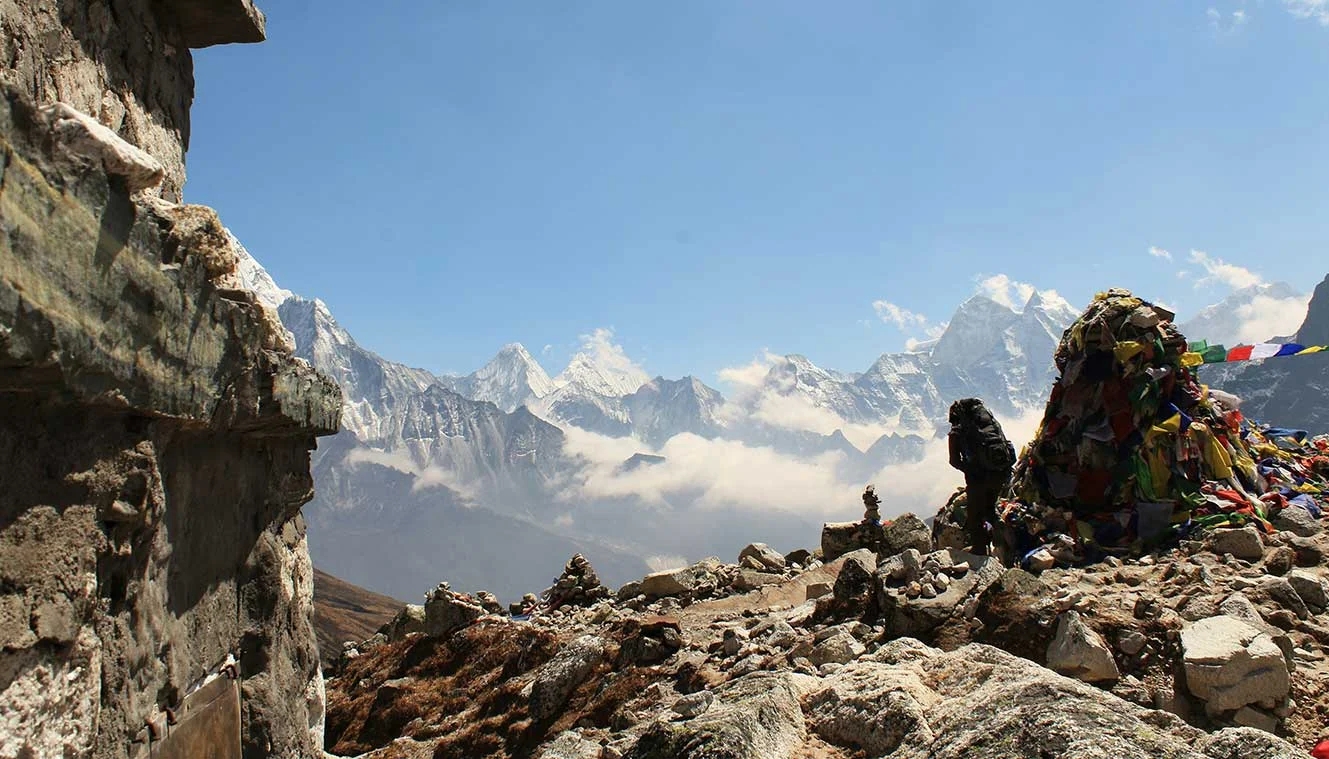
Lobuche To Gorkhashep | Excursion To Everest Base Camp
- Altitude: Gorakshep - 5,150 m/ 16,900 ft & highest point - 5,350 m/ 17,750 ft.
- Altitude Gain: 200 m/ 700 ft.
- Lobuche To Gorakshep: 6 km | Duration: 4 hrs.
- Gorakshep To EBC: 3 km away each.
- It’s Everest Base Camp Day Today.
- Good steep climb to Gorakshep.
- It takes about 3 to 4 hrs to reach Gorakshep.
- Lunch is at Gorak Shep.
- A steeper climb to Everest Base Camp.
- The trek to Everest Base Camp is not very difficult.
- Trekker\\\\\\\\s stop point is just below the actual base camp.
- Most tour groups are not allowed to enter or stay in EBC.
- Make sure you carry your day pack since you will need water.
- You can enjoy amazing views of Nuptse, Khumbutse, and Pumori mountains from the base camp.
- Overnight stay in Gorakshep.
Note: Drinking water in Gorakshep is chargeable. We don’t include drinking water on the trek which you can buy from a number of places between $1 to $3 a bottle (it gets more expensive towards the base camp). The better alternative is to buy water tablets in Kathmandu/Pokhra for around $2 and treat the water.
Today is the most exciting day of the trek as you make an excursion to the Everest Base Camp. An adventurous journey and a great trekking experience await you. Waking up early, have your breakfast, and gear yourself up. We will follow the trail from Lobuche through narrow gaps in the mountains and glacial moraines along the Khumbu glacier to Gorak Shep, the last village on the trek. Post lunch in Gorak Shep, we begin our trek to the Everest Base Camp, the ultimate adventure of this entire journey. We follow the lead of Sherpas as the trail changes every season as the glaciers move. It takes about 7 hrs of walking to reach Everest Base Camp. Spend some time at the base camp, celebrate your victory, capture some stills and descend back to Gorakshep. Overnight stay will be at Gorakshep.
The trek today can be broken down into two parts, the first part is the trek from Lobuche to Gorak Shep and the second part is an excursion to EBC and back to Gorak Shep. After breakfast at Lobuche campsite, we begin our trek towards Gorak Shep. It is a 6 km hike that takes about 4 hrs. Walking along the sandy and rocky parts, you will gradually gain elevation as you walk alongside the Khumbu Glacier. Mt. Nuptse looms on the horizon in front of you. Some sections of the trail are a little steeper than others. On the way, you will pass Sherpa flag monuments indicating that you are getting closer to the Everest Base Camp.
The last section of the trail directs into a glacier before you reach Gorak Shep. the terrain is rocky and uneven with inclines and declines. Be cautious and watch your step in this part and always pay heed to the trek leader\\\\\\\\s advice to complete the patch safely. You can see a sliver of the top of Mt. Everest from here, right behind Nuptse. Soon the village of Gorak Shep comes into view guarded by Kala Patthar and Pumori in the back. Make your way into the guest house have some lunch, reenergize yourself and get ready for the next part of the trek.
From Gorak Shep, you will walk right along the Khumbu Glacier, the Everest Range lies right behind it. It is a vast glacier and as you continue walking along the side of the glacier, you will constantly gain elevation until you reach the base camp. The incline is not very steep and is slightly moderate. A technical terrain lays ahead of you with a mixture of sand and rocks and it can get pretty slippery at some points as well. As long as you watch your steps, you will be good. Continue on and you will reach a point where the Khumbu icefall comes into better view as it winds down from the mountain to the valley. More Sherpa prayer flags mark the way to the base camp. In the final stretch of the trail, you will see numerous prayer flags flowing in the wind and the popular Everest Base Camp Rock. You have made it to the Base Camp, congratulations! While this is not the actual base camp, it is a trekker’s base camp. Most tour groups are not allowed to enter or stay in EBC. Once you have had enough time to enjoy the area around EBC, it is time to head back to Gorakshep. Follow the rocky trail back to Gorak Shep. We will stay the night in Gorak Shep.
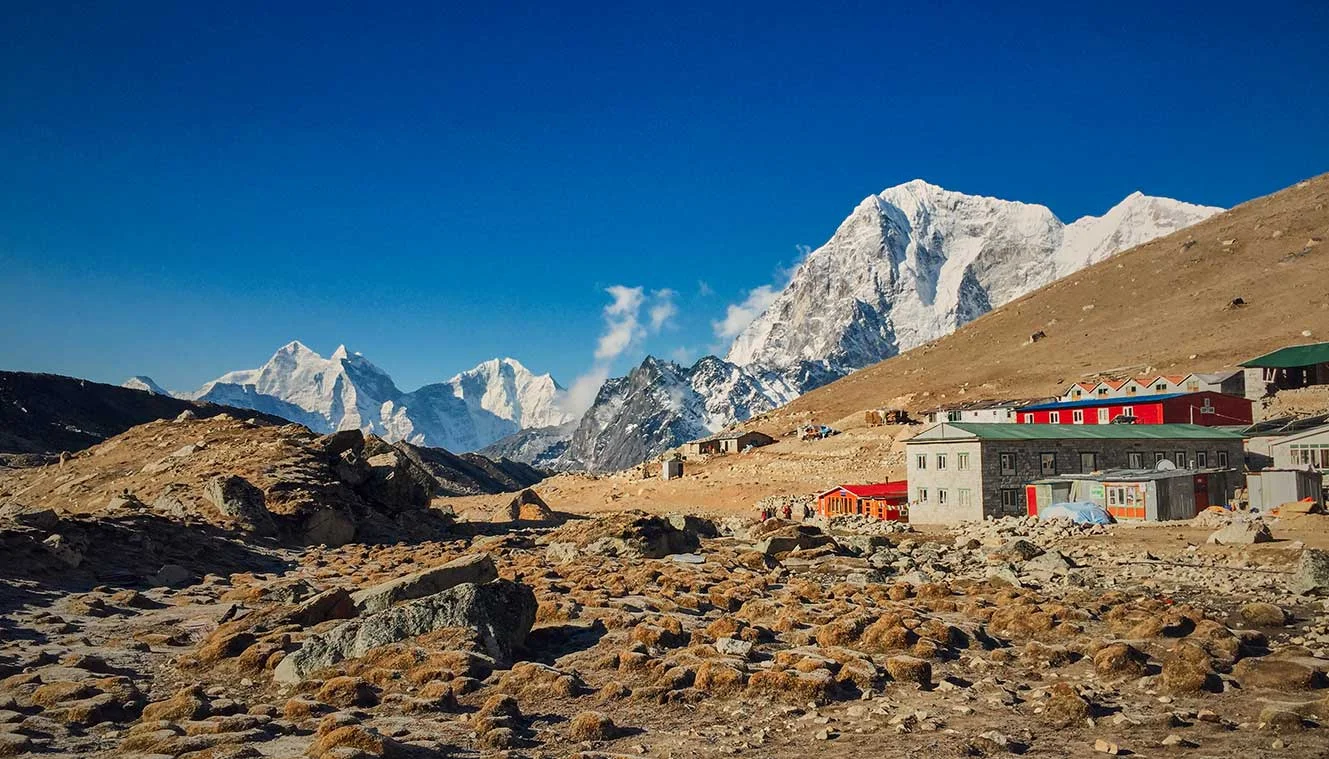
Hike To Kalapatthar And Retreat Trek To Pangboche | Enjoy Arresting Views Of Mt. Everest
- Altitude: Kalapatthar - 5,550 m/ 18,200 ft Pangboche - 4,300 m/ 14,100 ft.
- Gorakshep To Kalapatthar: 2 km each way | Duration: 3 to 4 hrs.
- Gorakshep To Pangboche: 25 km | Duration: 6 hrs.
- Altitude Loss: 850 m/ 2,800 ft
- Steep climb to Kalapatthar (difficult).
- Gradual descent to Pangboche.
- Start early in the morning to avoid early morning clouds.
- Kala Patthar is the rocky hilltop below Pumori.
- Views from the summit: Everest, South Col, Lhotse, Makalu, Khumbu Glacier & icefall, Pumori & Everest Base Camp.
- Breakfast at Gorakshep after Kalapatthar hike.
After your trek to EBC and back to Gorakshep, you are now ready to climb Kala Patthar. Gorakshep is also a good place to roam around, it has a couple of teahouses and it also used to be the base camp for climbing Mt. Everest in the 1950s. The trek starts with an easy walk from Gorakshep and you will be walking on sandy fields. After this, there is a steep climb of 45 minutes. After the strenuous climb, you will come to level fields and the walk is easy and gradual. You will have the comfort of walking for the next one hour, post which there is another steep climb to Kalapatthar for about half an hour. Mt. Everest from this point looks closer than you can imagine. From here, you will trek down to Pangboche.
Start your day early and leave your stuff at Gorakshep, only carry a daypack with the essentials as you will return to Gorakshep. As you cross the sandy trail and begin ascending, you will notice the Gorakshep village and Khumbu Glacier behind you including Ama Dablam. The top of Mt. Everest begins to peek out above the surrounding mountain ranges. The more you gain altitude the more Mt. Everest will come into view. The best part of today’s trek is that all along the trek you can enjoy the landscape of the surroundings and not just on the summit. The higher you get, the rockier and trickier the trail gets. Be mindful and watch your steps. The last patch is especially rocky.
The summit is a little difficult to navigate as well. You will know you are near the summit when the Sherpa prayer flags and weather reading device come into view. Take your time and dont rush to the summit to avoid any accidents. Once you reach the summit, you will get to see the breathtaking views of the entire Sagarmatha National Park but the main attraction is of course Mt. Everest itself. You will get the best view of Mt. Everest from here. Below Everest lies the Khumbu icefall that feeds into the Khumbu Glacier and to the right is the face of Mt. Nuptse. On the opposite side of the lake, you will see even more glaciers, lakes, and mountains, as far as your eyes can see. After spending some time at the top, descend the same path that you came in. When you are back in Gorakshep have a nice meal and refuel yourself as we will descend to Pangboche.
On the trek down, the first village will be Lobuche and throughout the trek, you will again be alongside the Khumbu Glacier. You have already completed this section while ascending up so you now have an idea of what to expect. The trek is a little tricky till Sagarmatha National Park sprawls out in front of you and the rest of the part is manageable. You can have some snacks at Lobuche before heading down to Pangboche.
As you descend, you will come to the intersection where one path diverges towards Dzonghla village, Cho la pass, and Gyoko Ri, and the one on the left heads towards Pangboche. Stay on the left side of the trail and you will come across another difficult patch of the trek. You will head down from the moraine wall of the Khumbu Glacier and descend to the Thukla Pass. Crossing the Everest Memorial, begin a tricky hike down to the river below and soon you will arrive at Pangboche.
Pheriche lies just below Dingboche so after crossing Thukla, you can take the lower path towards Pheriche instead of taking the higher path towards Dingboche. Once we arrive at Pangboche, you will check into a teahouse, have your dinner, and rest for the night before heading down to Namche Bazaar the next day.
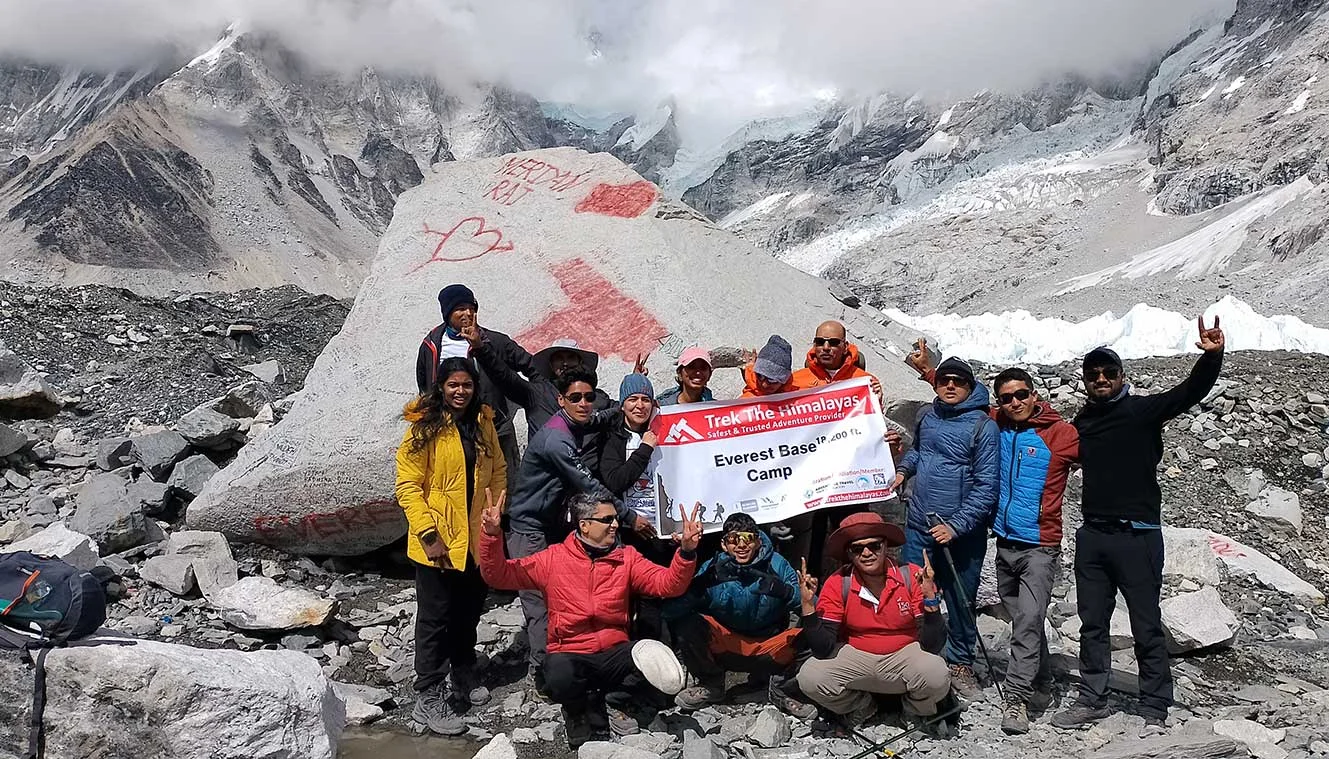
Pangboche To Namche Bazaar | Buy Some Souvenirs
- Altitude: 3,450 m/ 11,300 ft.
- Trek Distance: 15 km | Duration: 6 to 7 hrs.
- Altitude Loss: 850 m/ 2,800 ft.
- Moderately, continuous descent and short ascent just before Namche Bazaar.
After your descent to Namche Bazaar, the cumbersome part of the trekking is almost over. From here on the descent will be easy after having the Everest Base Camp trek. But we recommend starting early as it is a long walk. Start the journey by heading down to the village, across the river, and again climbing back up the valley wall. You can rest here for some time, catch your breath before resuming your decline down the valley.
Once you have declined the path, you will cross a suspension bridge followed by a 2 km incline along the valley wall. As you zig-zag up towards the trail, it becomes forested and once you have completed the uphill ascent, it is a fairly smooth walk for the remaining 5 km to Namche Bazaar. The path to Namche Bazaar is etched on a valley wall and there’s the river below. Soon the path bends inwards and you are welcomed with views of Namche Bazaar. Descend down to the village below and check into a teahouse. Rest well. Tomorrow will be the last day of your trek.
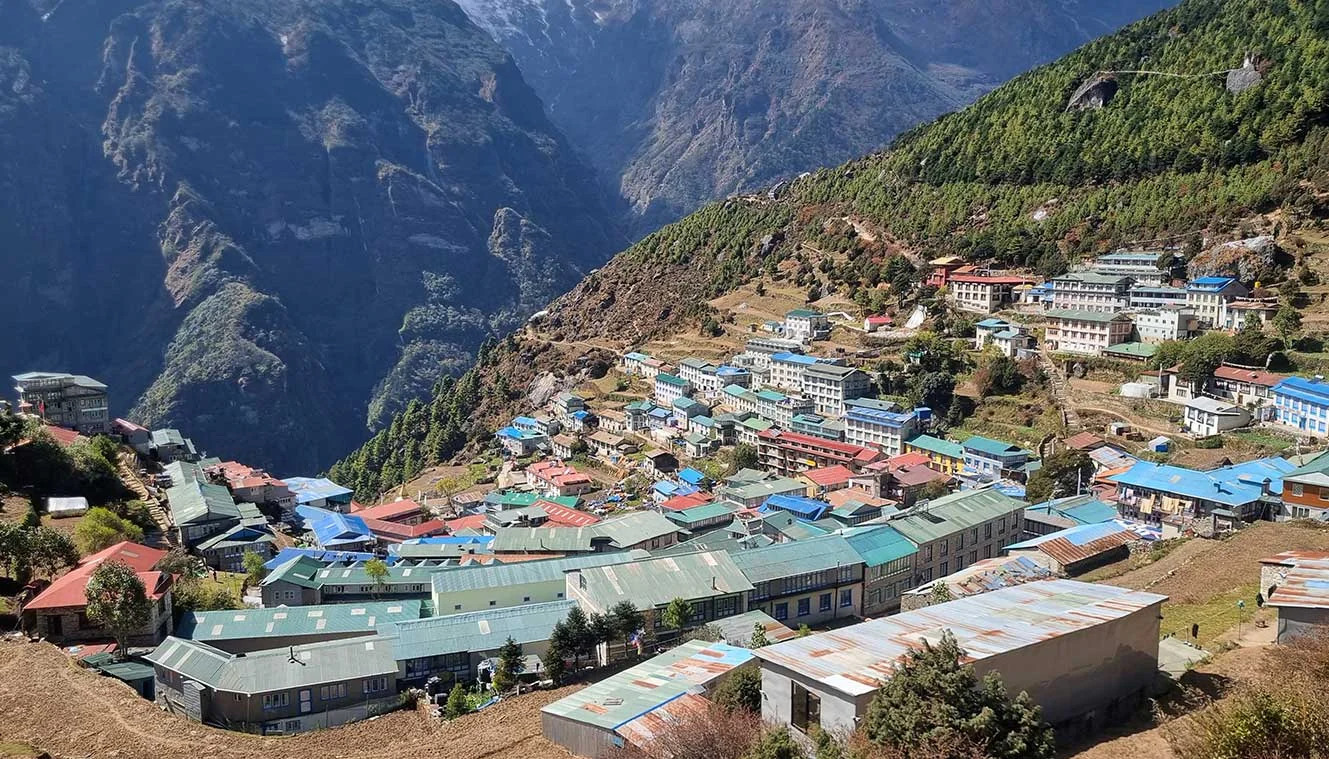
Namche Bazaar To Phakding To Lukla | Last Day Of Trekking
- Altitude: Phakding - 2,600 m/ 8,500 ft, Lukla - 2,850 m/ 9,350 ft.
- Altitude Loss: 600 m/ 1,950 ft.
- Trek Distance: 19 km | Duration: 7 to 8 hrs.
- Moderate, continuous descent till Phkading and gradual ascent to Lukla.
- Start your trek early in the morning as it is a long day trek.
- Stop at Phakding for lunch.
- Stay in Lukla.
Waking up to the lovely weather at Namche Bazaar, you can visit the place and roam around a little bit. You can explore the market and buy souvenirs from your trip to the Everest Base Camp and buy gifts for your friends and family. There are several local handicraft stores in Namche Bazaar as it is the biggest trade hub in the Khumbu region. You can also take a small walk-in around the Sagarmatha National Park and enjoy the local cuisine as well. Post which treks down to Phakding, it is an easy trek down to the village. The beauty of the distant mountains with several waterfalls adds to the beauty of your journey. This is the beauty of Nepal trekking, there will be a few uphill climbs but you will manage it very easily. The lush green beauty and forests will take your pain away. After this easy walk, you will reach Lukla. This will be your last day with the Sherpas and other crew members, so you would like to enjoy the day with a delicious dinner and a few drinks.
Right at the beginning of the trek, you will begin to lose elevation, after about 45 minutes of walking, you will arrive at a rest stop, the same that you came in on when ascending towards the basecamp. This is where you will get the last glimpses of Mt. Everest. After this point, there are no mountain views anymore only little peeks from behind the forest covers. You will cross a few suspension bridges and continue alongside the river as the initial steep decline eases into a more moderate decline. While most of the trek is downhill, there are a few uphill climbs as well. Pass by Sherpa stones into the village of Phakding. You are more than halfway to Lukla by now. We will stop at Phakding for lunch before descending further down the valley with river views, mountain ridges, and suspension bridges. You will also have several stair sections and an incline path all the way through. Passing by a few more villages, you will arrive at Lukla, your final stop for the day.
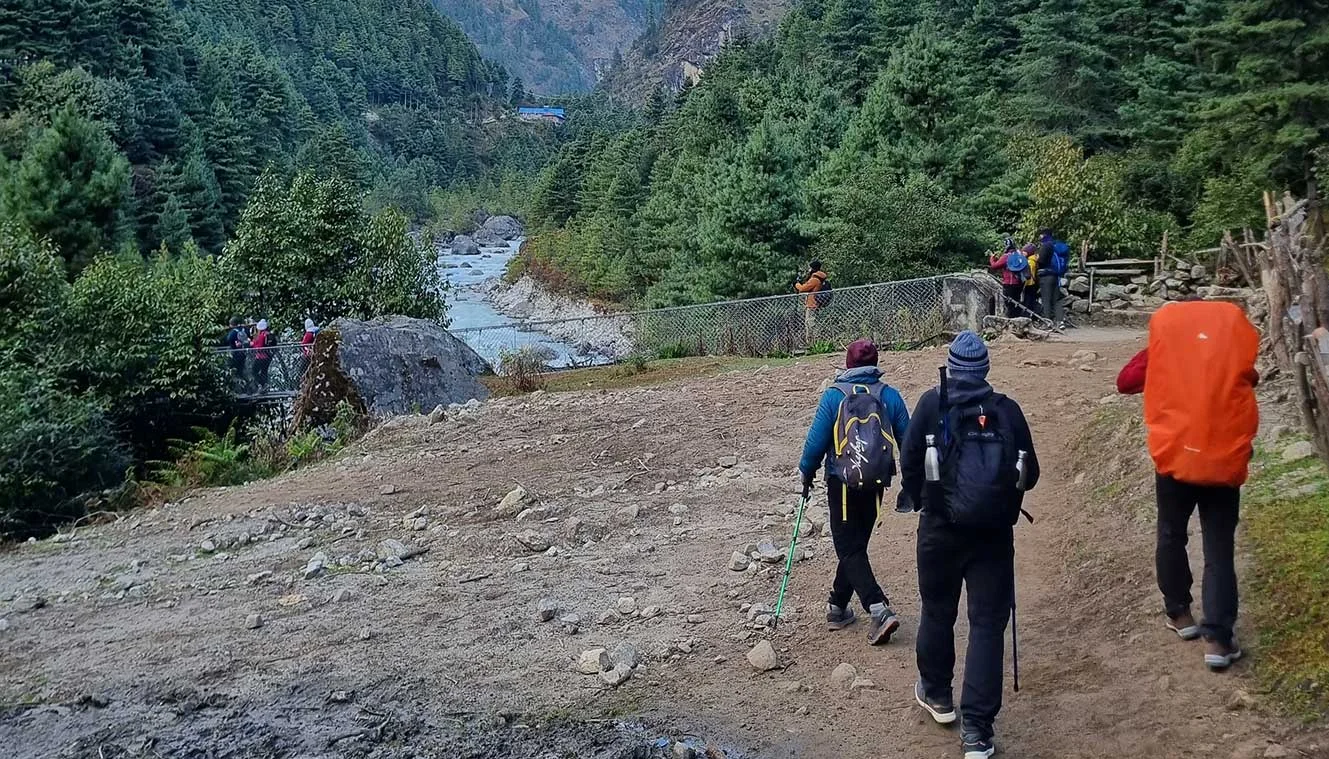
Fly Back To Kathmandu | Bid Adieu To The Mountains
Today you will have to wake up early as flights to Kathmandu are generally scheduled in the morning. This is because during the daytime, the weather is generally windy and there might be a delay in the flight timings. However, you can expect a slight delay in your early morning flight as well if the weather is not suitable. As you make your way through the security checks and your flight takes off from Lukla airport, you will have a magnanimous view of the surroundings. Drive back to Kathmandu from Ramechhap Airport and overnight stay in a hotel. You can book your further journey from here. We wish you a great journey towards your home with lots of memories.
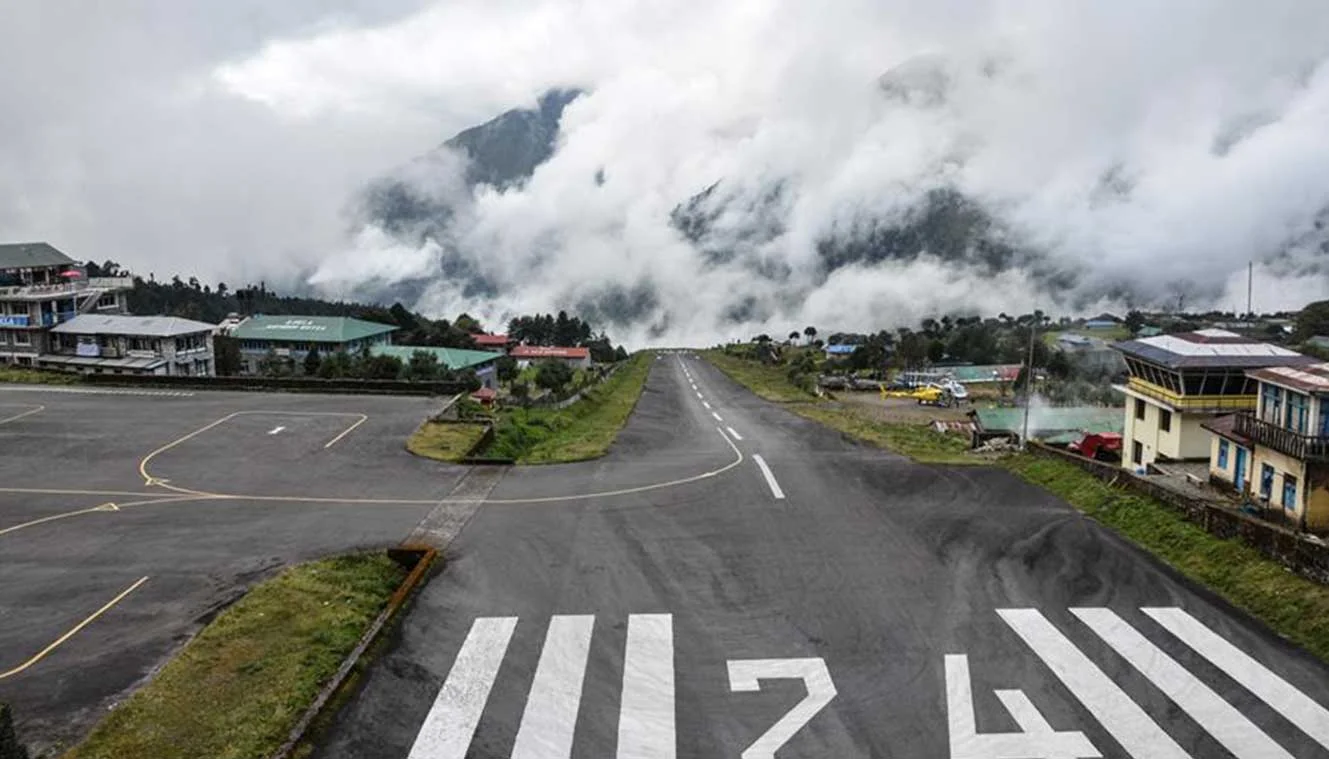
Day-1: Arrive At Kathmandu
Day-2: fly to lukla, trek to phakding | enjoy a scenic flight journey.
Note: Flights to Lukla are prone to delay due to weather, keep one or two buffer days in your plan.
Day-3: Phakding To Namche Bazaar | A Major Trading Hub In Khumbu
Day-4: acclimatization day | explore namche bazaar.
- Today is acclimatization day.
- You can hike up to Sherpa Cultural Museum to get a view of Everest and Ama Dablam.
- It’s worth exploring the town, a good place to buy trekking gear.
- ATMs, internet cafes, shops, and restaurants are available at extra cost.
- Stay in the guesthouse.
Day-5: Namche Bazaar To Tengboche | Visit The Largest Buddhist Monastery Of Khumbu
Day-6: tengboche to dingboche | stunning views of ama dablam, day-7: dingboche (rest day) | acclimatize to higher altitudes.
- Rest Day helps you acclimatize well to high altitudes.
- A small hike today will show you the world’s six tallest peaks including Lhotse (8,516 m), Makalu (8,463 m), and Cho Oyu (8,188 m).
- From another location, you can see the Imja Khola Valley and Dingboche Valley.
Day-8: Dingboche To Lobuche | Pay Your Respects In Everest Memorial
Day-9: lobuche to gorkhashep | excursion to everest base camp, day-10: hike to kalapatthar and retreat trek to pangboche | enjoy arresting views of mt. everest, day-11: pangboche to namche bazaar | buy some souvenirs, day-12: namche bazaar to phakding to lukla | last day of trekking, day-13: fly back to kathmandu | bid adieu to the mountains.
- Morning flight to Kathmandu.
- Your trek to Everest Base Camp is over.
- Spend the day in Kathmandu or fly back to your onwards destination.
- Hotel accommodation in Kathmandu is included in the cost.
Note: Weather conditions may cause flight cancellations. Delays are possible any time of the year but are more typical on summer departures. Keep one or two buffer days.
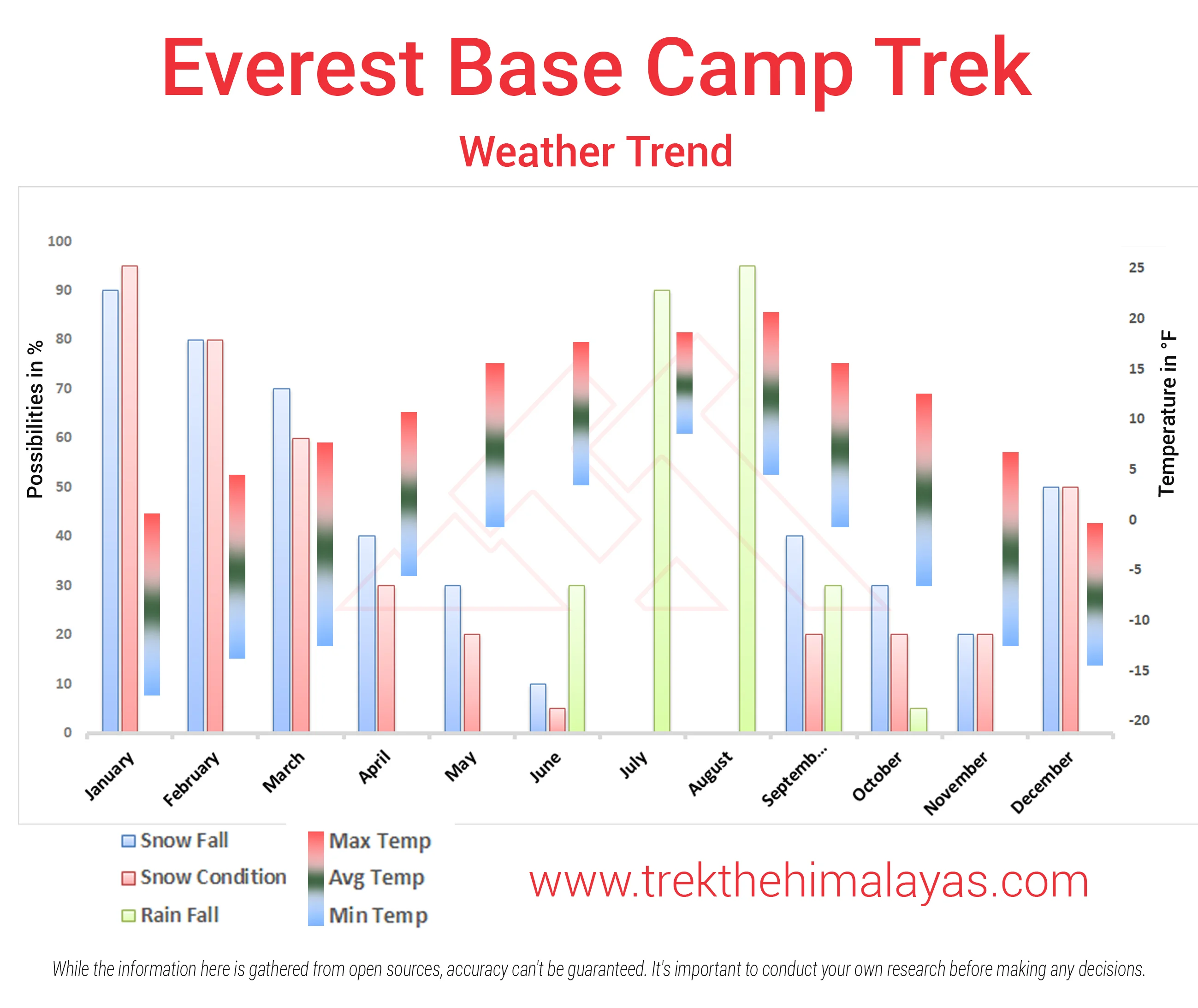
Medical & Disclaimer Form (Mandatory Documents) Click Here.
How To Reach
It is essential for everyone to arrive at Kathmandu (1:00 pm).
Upon booking the trek, you are required to come to our hotel. Your trek coordinator will provide you with details such as the name of the Kathmandu hotel, its location, and the contact person's number.
Options to reach Kathmandu.
The best way is to fly to Kathmandu Tribhuvan International Airport, which receives airlines mostly from South-east Asia and Europe. A number of direct flights fly from Delhi, Mumbai, Kolkata, Bangalore and Varanasi to Kathmandu. Popular airlines that operate regularly are Jet Airways, Air India, IndiGo and Nepal Airlines.
Delhi to Kathmandu by train + bus :-
Day 1: Take a train from Delhi to Gorakhpur. The Vaishali Express leaves Delhi at around 19:45 and arrives at Gorakhpur Junction at 09:10 next morning, or there's another train from New Delhi at 17:20 arriving Gorakhpur at 06:35 next morning. The fare is around Rs. 2440 (£35 or $54) in AC1, Rs. 1240 (£18 or $27) in AC2, Rs. 785 (£12 or $18) in AC3 or Rs. 315 in Sleeper Class - check current times and fares at www.indianrail.gov.in or www.irctc.co.in.
Day 2: Take a bus or jeep from Gorakhpur to the Nepalese frontier at Sunauli (Indian side) and Bhairawa (Nepalese side, often also called Sunauli). Journey time about 3 hours, Rs. 55 (£1 or $2).
Walk across the frontier, it's then a few minutes’ walk to the Bhairawa bus station. Take a bus or jeep on to Kathmandu. Buses take 9 to 12 hours, cost about 120 Nepalese Rupees or 230 Indian Rupees (£1 or $2). There are many buses daily, either daytime buses leaving regularly until about 11:00 or overnight buses leaving regularly from about 16:00 until 19:00. Indian rupees may be accepted here in Bhairawa, but not further into Nepal.
It's also possible to travel via Varanasi An overnight train links Delhi & Varanasi. Buses link Varanasi with the Nepalese border.
For your return journey from Kathmandu, you have the flexibility to choose between road or air transport options. Please note that our services extend only to the hotel, and the standard hotel check-out time is 11:00 am.
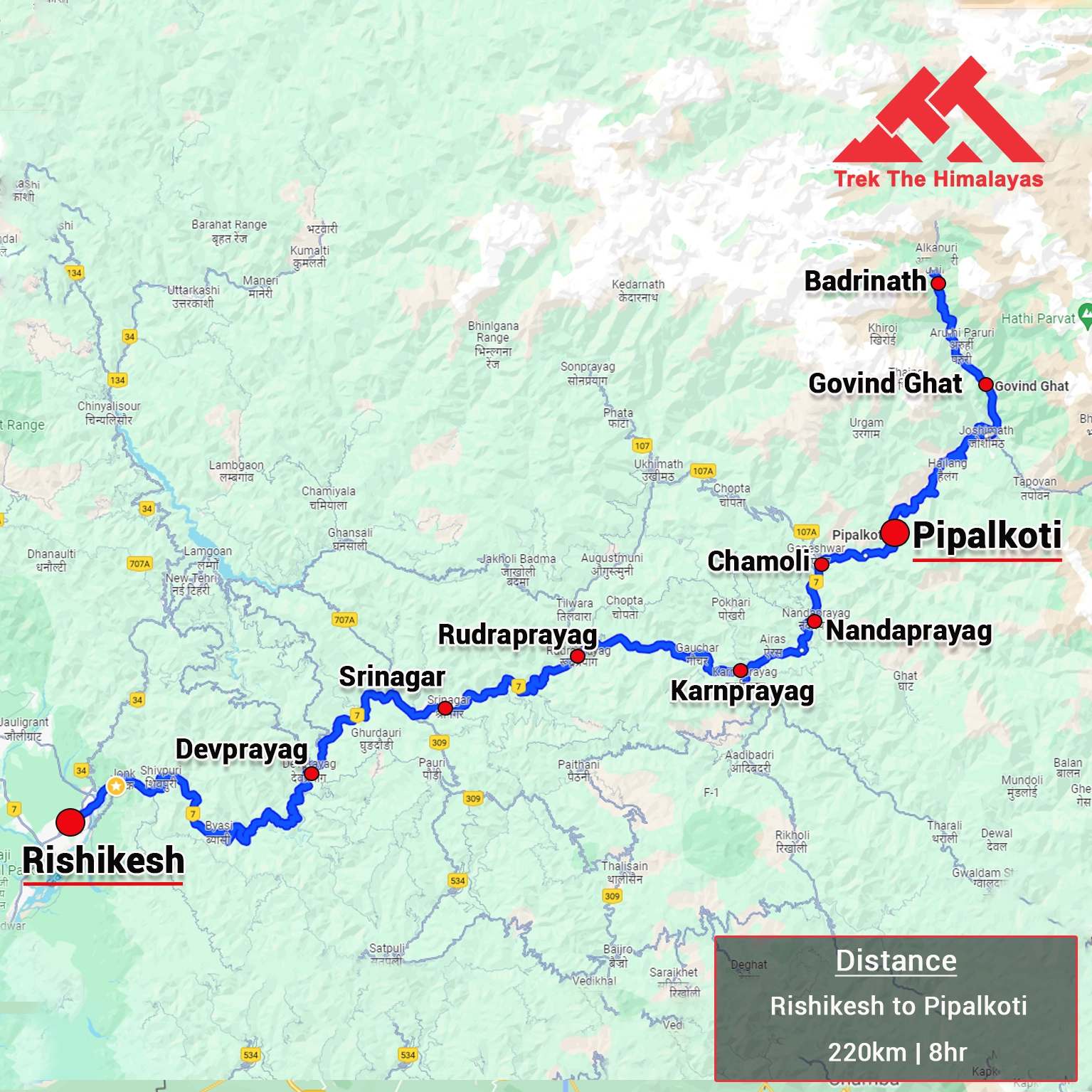
1. Accommodation (as per the itinerary):
- Day 1 and Day 13 Hotel Accommodation in 3 Star Hotel in Kathmandu with Bed & Breakfast.
- Day 2 to Day 12 Accommodation in Teahouse.
2. Meals (Veg + Egg):
- All meals Lukla to Lukla from Day 2 Lunch to Day 13 Breakfast
- Fresh fruit after dinner every day.
3. Support:
- 1 Versatile base camp manager: handles communication and deploys extra manpower in emergencies.
- 1 Mountaineering & First aid qualified professional trek Leader.
- Local experienced guides (Number of guides depending on the group size).
- Enough support staff.
4. Trek equipment:
- Sleeping bag.
- Gaiters & Crampon (if required).
5. First aid:
- Medical kit, Stretcher, Oxygen cylinder, Blood pressure monitor, Oximeter, Stethoscope.
6. Transportation (as per the itinerary):
- Arrival Departure Airport Transfer as per itinerary.
- Domestic airport transfers for Lukla.
- Kathmandu to Ramecchap /Lukla, and back.
7. Mules/porters to carry the central luggage.
8. Clock room facility available at the base camp for additional luggage.
9. All necessary permits and entry fees, Upto the amount charged for Indian.
10. Services from Kathmandu to Kathmandu .
11. TIMS card.
12. EBC Map.
13. Farewell Dinner in Kathmandu.
14. Trek Completion Certificate
15. Complementary Trekking Kit Bag (Duffle bag if opted for Porter facility).
1. Insurance (Mandatory).
2. Food during the transit.
3. Any kind of personal expenses.
4. Mule or porter to carry personal luggage.
5. Emergency evacuation, hospitalization charge or etc.
6. Anything not specifically mentioned under the head Inclusion.
8. Extra Expenses.
- Porters for the personal bag*.
- Wifi, charging batteries and hot showers.
- Customary gratuities for guides & porters.
9. Nepal entry visa (approximately $40 USD, Bring Two Passport Size photos) only for foreigners (Not for Indians).
10. Unforeseen costs due to flight cancellation, weather conditions etc.
11. Extra night accommodation Kathmandu.
Things can be provided on demand and availability (participant has to pay extra for these things).
1- Satellite phone/set phone - is a type of mobile phone that connects via radio links via satellites orbiting the Earth instead of terrestrial cell sites like cellphones. Therefore, they can operate in most geographic locations on the Earth's surface.
2- Gamow/PAC HAPO Bag (Portable Hyperbaric Bag) - is a unique, portable hyperbaric chamber for the treatment of acute mountain sickness (AMS), also known as altitude sickness.
3- AEDs (Automated External Defibrillators) - are portable life-saving devices designed to treat people experiencing sudden cardiac arrest, a medical condition in which the heart stops beating suddenly and unexpectedly.
Special Offer
Make a single payment and trek the number of times you want.
If you book a trek with Trek The Himalayas and cannot complete it, or if you've successfully completed the trek and wish to do it again, you can repeat it multiple times at no additional cost.
Terms and conditions
- This offer is non-transferable.
- This offer is valid for Trek The Himalayas limited fixed departures.
- This offer is valid for 5 years from the date of booking.
- This offer is not valid if the participant has received a cash refund or voucher at the time of cancellation.
- Participants don’t have to pay for the trek cost but have to pay for transportation and trek permit costs.
To reserve a spot for a trek or adventure program, you can either utilize our online booking form or call us at the provided number. For your confirmation, a deposit must be wired, including the initial payment.
Cancellation terms:
Cancellations prior to 25 days from the start of the Trip
Refund options
- 5% deduction of trek fee
- 100% cash voucher for any trip till one year
- Transfer your trek (any trek, any date) to your friend
Cancellation between 24 days and 15 days to the start of the Trip
- 30% deduction of trek fee
- 100% cash voucher for same trip till one year
- 85% cash voucher for any trip till one year
- Transfer your trek (same trek, any date) to your friend
Cancellation between 14 days and 10 days to the start of the Trip
- 50% deduction of trek fee
- 80% cash voucher for same trip till one year
- 70% cash voucher for any trip till one year
- Book the same trek, in the same season, with any other batch
Cancellation less than 9 days to the start of the trek
- No cash refund
- 20% cash voucher for the same trip till one year
- 10% cash voucher for any trip till one year
- Transfer your trek (same trek, same date) to your friend
Note- If a booking is made using a voucher or discount code, the policies related to vouchers and discounts cannot be modified.
In the unlikely event that TTH cancels a trek prior to the scheduled departure date:
While it is extremely rare for TTH to cancel a trek, we understand that unforeseen circumstances or natural disasters may occasionally require us to do so before the scheduled departure. These circumstances could include continuous rain or snow, thunderstorms, snowstorms, landslides, floods, earthquakes, or any other natural calamity that poses a risk to the safety of our trekkers. Additionally, unforeseeable events such as local riots, curfews, pandemics, lockdowns, government orders, or any similar situations that compromise the safety of the trekking experience may also necessitate a cancellation.
In the event of such a cancellation, TTH will provide you with a voucher equivalent to the amount you paid for the trek. This voucher can be redeemed for any of our treks within the next year, allowing you to still enjoy an adventure with us at a later date.
The issuance of a voucher is not applicable in situations where you are required to descend from the trek for any reason. The trek leader may make the decision to send you down from the trek due to factors such as insufficient fitness level, symptoms of Acute Mountain Sickness (AMS), high blood pressure, exceeding the designated turn-around-time, health concerns, or if you are found smoking, drinking, or violating the rules set for the trek. In such cases, the provision of a voucher does not apply.
In the rare event that TTH shifts a trek:
We would like to emphasize that weather conditions in high-altitude areas are highly unpredictable and can undergo sudden changes at any time, irrespective of the day. Additionally, circumstances beyond our control, such as natural disasters, political unrest, pandemics, and lockdowns, may impact the feasibility of conducting a trek. In cases where we are unable to proceed with an event due to such circumstances that are beyond our direct control, we will make every effort to provide you with an alternative trek that is safer and more suitable.
In such situations, we will issue a voucher to offset the cost difference between the originally scheduled trek and the alternative trek. This voucher can be redeemed at any time within one year from the date of issue. Please note that a refund fee or reimbursement of the cost difference is not applicable in these cases.
- Change of trek batch is dependent on the availability of seats in the batch
- In case of transferring a trek to a friend, he/she should satisfy all the mandatory requirements put forward by TTH
- TTH holds the right to change/cancel the policies, without prior notice
- Cash refund is applicable only in case of bookings made without using any promotional offer code or vouchers
Cash Voucher Terms:
- This is a non-transferable voucher
- The voucher cannot be merged with any other offer of Trek The Himalayas
- The voucher is valid for Trek booked directly with Trek The Himalayas in India
- To avail the voucher please use your register phone number or e-mail id
- All the other Terms of booking a trek with Trek The Himalayas are applicable to the voucher
- Trek The Himalayas holds rights to add/remove any of the Terms and Conditions without prior notice
Itineraries are based on information available at the time of planning and are subject to change. "Trek The Himalayas" reserves the right to change expedition dates, people or itineraries as conditions warrant. If a trip must be delayed or the itinerary changed due to bad weather, road conditions, transportation delays, government intervention, airline schedules, sickness, or other contingency for which TTH or its agents cannot make provision, the cost of delays and/or other changes are the responsibility of the participant. TTH reserves the right to decline, or accept, any individual as a trip member for any reason whatsoever.
Trek Essentials
PDF Of Trek Essential Download
Frequently Asked Questions(FAQ)
How to register/create an account with tth.
To register with TTH, visit our website - www.trekthehimalayas.com and create your account. To create your account you will need to use your email address and fill in all the details, set your unique password and your account is ready to use.
How to book a trek?
- To book a trek with TTH, you first need to register with us and create an account.
- Choose the trek that you want to do and click on available dates.
- You will land at the login page, fill in the required details.
- Add Participants, choose add-on services click on the Pay now button, choose your preferred payment method, and make the payment. TTH accepts multiple payment options, including credit/debit cards, net banking, and UPI.
- You will receive a confirmation email from TTH with all the necessary details about the trek, including the meeting point, transportation, accommodation, and other important instructions.
Made a payment but did not receive any confirmation.
please send an email to us at [email protected] or reach out to the numbers provided in the Help and Support section of your Trek Page. We will ensure that your issue is promptly resolved.
How to book off-load luggage and transportation?
To book services such as off-load luggage and transportation, you can find them listed as add-ons. These additional services can be booked at the time of your initial booking. If you miss booking add-ons during the initial reservation, you can log in anytime and easily book 4 days before the departure date add-ons through the platform.
If I have booked the wrong trek or date, how can I make changes?
In such a situation, please log in to your account and transfer your trek or date to the desired one within 12 hours or drop us an email at [email protected] 10 days before the departure date of the trek. After the initial 12-hour period, any changes will be processed according to the cancellation policy.
I am a beginner and confused which trek to book.
We recommend visiting our "Suggest Me a Trek" page. By filling out the form, our experts will contact you with the best possible trek options based on your preferences and experience level. Alternatively, you can reach out to us via email at [email protected] or give us a call using the numbers provided on our website for personalized assistance and recommendations.
How is family trek different from regular trek?
Family treks differ from regular treks by focusing on ease of difficulty, offering shorter durations for younger participants, Kid-friendly and easily digestible foods, child-friendly activities, maintaining a higher guide ratio for diverse age groups, and implementing additional safety measures for families.
Ideal treks for children.
Family Trek with Kids recommendation Only Dayara Bugyal and Chopta Chandrashila Trek.
Minimum age for children to trek with TTH.
Minimum age for TTH treks is typically 7 years, though this may vary depending on the specific trek.
Can we take children to high altitudes with their guardian?
Yes, you can take a kids to a high-altitude trek with a parent. Discuss with a trek expert before booking a trek.
Can we send kids without Parents/guardian?
Medical & Disclaimer Form (Mandatory Documents) Click here to download medical and disclaimer form
How to prepare a child for a high altitude trek?
Physical Fitness: Ensure your child is physically fit. Engage them in regular exercise, outdoor activities, and hikes to build stamina and endurance. Hydration: Emphasize the importance of staying hydrated at high altitudes. Encourage your child to drink water regularly, even if they don't feel thirsty. Proper Nutrition: Provide a well-balanced diet with sufficient carbohydrates for energy and foods rich in iron to prevent altitude sickness. Adequate Sleep: Ensure your child gets enough sleep in the days leading up to the trek. Quality rest is crucial for altitude adaptation. Educate on Altitude Sickness: Teach your child about the symptoms of altitude sickness, such as headache, nausea, and dizziness. Encourage them to communicate any discomfort immediately. Appropriate Clothing and Gear: Dress your child in layers to adjust to changing temperatures. Ensure they have appropriate trekking gear, including sturdy footwear. Positive Mindset: Foster a positive mindset. Encourage your child, and let them know it's okay to take breaks when needed. Medical Check-Up: Schedule a medical check-up before the trek to ensure your child is fit for high-altitude activities. Consult with a healthcare professional about any potential health concerns.
Kind of food will be served during the trek for children.
TTH takes special care to provide wholesome and nutritious food for children on treks. Here are some of the foods that are typically served for children: Breakfast: For breakfast, TTH serves a variety of options like porridge, cornflakes, bread, butter, jam, honey, boiled eggs, omelettes, and pancakes. Children can choose from these options to fuel themselves for the day's trek. Lunch: For lunch, TTH serves lunch which includes rotis, vegetables, rice, dal, and salad. The rotis are usually made fresh on the trek and are a good source of carbohydrates. The dal and vegetables provide protein and other essential nutrients. Snacks: TTH provides healthy snacks like fresh fruits, dry fruits, energy bars, cookies, and biscuits to keep the children energized throughout the day. Dinner: For dinner, TTH serves a hot and wholesome meal which includes soup, rice, dal, vegetables, and a non-vegetarian dish (if requested in advance). Children can also choose from a variety of desserts like custard, jelly, and fruit salad. Dietary requirements: If a child has any special dietary requirements, TTH can cater to those needs as well. For example, if a child is lactose intolerant or allergic to nuts, the kitchen staff can make arrangements to accommodate those requirements.
How to choose the right trek?
Choosing the right trek for a beginner can be a bit overwhelming as there are many factors to consider such as distance, elevation gain, terrain difficulty, weather, and time of year. Here are some tips that can help you choose the right trek for a beginner:
1. Determine fitness level: Assess the fitness level of the beginner to understand their physical capabilities. This will help you select a trek that is challenging but not too difficult.
2. Choose a well-traveled trail: A well-traveled trail will have more amenities such as signposts, water stations, and shelter. It is also safer as there will be other hikers on the trail.
3. Consider the length of the trek: For beginners, it is recommended to start with a shorter trek that can be completed in a day or two. This will help them get acclimatized to trekking and build their confidence.
4. Look for gradual elevation gain: Choose a trek with a gradual elevation gain rather than steep ascents. This will make the trek easier and more enjoyable.
5. Check the weather: Check the weather forecast before selecting a trek. Avoid treks during the monsoon season or winter when the trails can be slippery or dangerous.
6. Research the trail: Read about the trail to get an idea of the terrain, altitude, and difficulty level. This will help you select a trek that is suitable for the beginner.
7. Consult with an expert: If you are unsure about which trek to choose, consult our trek expert Mr. Nitin (+91 70600 59773) between 10 AM to 6 PM (Tuesday - Friday). Mr. Nitin will provide you valuable advice and guidance.
Overall, it is important to choose a trek that is enjoyable, challenging but not too difficult, and suitable for the beginner's fitness level and experience.
Can a beginner choose a tough trek?
It is not recommended for a beginner to choose a difficult Himalayan trek. Trekking in the Himalayas can be physically and mentally challenging, especially if you are not used to the high altitude, steep slopes, and rugged terrain. Choosing a difficult trek without the proper experience, fitness level, and preparation can be dangerous and put you at risk of altitude sickness, injury, and other hazards.
If you are a beginner, it is recommended to start with an easier trek and gradually build up your skills and experience. This will help you understand the challenges of trekking in the Himalayas, and also prepare you physically and mentally for a more difficult trek in the future. It is also important to choose a trek that matches your fitness level, experience, and interest.
What is the age limit for a beginner trekker?
There is no specific age limit for a beginner trekker. However, it is important to consider your physical fitness, health condition, and personal interests before embarking on a trek. Trekking in the Himalayas can be physically and mentally demanding, and requires a certain level of physical fitness and endurance.
If you have any pre-existing medical conditions or are above a certain age, it is recommended to consult with a doctor before embarking on a trek. It is also important to listen to your body and take breaks as needed during the trek to prevent exhaustion or injury.
If I am solo, can I join the trek in a group?
Yes, you can join the trek. We have fixed departure groups where you can simply book your trek and we will take care of curating a group.
How does my family get updated about my Trek?
Before you start the trek, it is recommended that you make all the necessary phone calls as during the trek you may or may not receive network coverage, once you come back to the Base Camp, you can reconnect with your family via phone once again. You can share your trek coordinator contact detail with your family members to get the latest updates about your trek batch.
What food can I expect?
At TTH, we provide wholesome and nutritious meals during the trek. The food is vegetarian and includes a variety of dishes such as rice, dal, vegetables, chapati, paratha, pasta, noodles, and soup. We also offer snacks such as biscuits, and salty, and dry fruits during the trek. Special dietary requirements such as vegan, gluten-free, or Jain food can also be arranged if informed in advance.
I am allergic to some foods.
If you are allergic to some foods, you need to let us know in advance so that we can make arrangements accordingly.
How safe is trekking with TTH?
TTH is a trekking company that prioritizes the safety of all its participants, including women trekkers. They have a comprehensive safety system in place, which includes a dedicated team of experienced and trained trek leaders and support staff who are equipped to handle emergency situations and provide first aid.
TTH also takes specific measures to ensure the safety and comfort of women trekkers. They have a separate tent accommodation for women trekkers, female trek leaders, and support staff. They also provide separate toilet facilities for women and encourage a safe and respectful environment for all trekkers.
Moreover, TTH has a strict policy against any kind of harassment and has a zero-tolerance policy towards such incidents. They have a designated Internal Complaints Committee (ICC) to investigate and address any complaints related to harassment or misconduct. Overall, TTH has a good reputation for safety and responsible trekking practices, and women can feel comfortable and safe while trekking with them.
How TTH will manage if I am the only woman in the group?
In case you are the only women in the group, we provide a single sleeping arrangement. Also, during the trek, the trek leader will always remain by your side to provide optimum safety and reassurance.
How can I know that other women are in the batch?
You can reach out to the trek coordinator to inquire about the number of female trekkers and their respective states who have booked the trek. Please note that the trek coordinator cannot disclose personal details of any trekker. Once you've confirmed your booking, a WhatsApp Group will be created for all the trekkers in your batch. This allows you to connect with fellow trekkers before the trek begins.
Can I know in advance, which trek is led by a women Trek Leader?
While many of our treks are led by female trek leaders, however, it is not possible to know which trek leader is assigned to which group. But nonetheless, whether the trek leader is male or female you can be completely assured of your safety and security with us.
Can I trek with periods? If yes, then where can I dispose of the sanitary pad?
Yes, it is possible to trek with periods. However, it is important to take some extra precautions and preparations to ensure a comfortable and safe trekking experience.
Here are some tips that can help you trek during your period:
1. Use menstrual hygiene products that you are comfortable with, such as tampons, pads, or menstrual cups. It is recommended to carry enough supplies for the entire duration of the trek.
2. Pack wet wipes, hand sanitizer, and plastic bags to dispose of used hygiene products.
3. Wear comfortable and breathable clothing that allows for easy movement and reduces friction. Avoid wearing tight or restrictive clothing that can cause discomfort.
4. Carry pain relief medication, such as ibuprofen or acetaminophen, in case of menstrual cramps.
5. Stay hydrated and maintain a balanced diet to support your energy levels and overall health.
6. Take breaks as needed and listen to your body. If you feel uncomfortable or experience any unusual symptoms, seek medical attention immediately.
It is also recommended to consult with a doctor before going on a trek during your period, especially if you have a pre-existing medical condition or are taking medication. By taking necessary precautions and being prepared, you can have a safe and comfortable trekking experience even during your period.
We provide proper disposal facilities for sanitary pad disposal during the trek.
How will the accommodation be during the trek?
We offer three person tents with twin-sharing for optimum comfort. A woman trekker will share a tent with another woman trekker and if you are the only woman in the group, you will be given a single accommodation for your comfort and privacy.
Are trek poles, Jackets and other equipment available for rent from Trek The Himalayas?
Yes, we do provide gears on rent. You can book it using you TTH account directly.
Who will be with us on the trek from Trek The Himalayas?
Mountaineering qualified Experienced and first aid certified Trek Leader, First Aid Certify local guide, Cook, helpers and supporting staff.
Who can not join the trek?
People suffering from Bronchitis, Asthma, High blood pressure, Epilepsy (got faints), TB , Heart problem or on higher BMI side are strictly not allowed to go on any Himalayan trek. Apart from this if you had any medical history, please let us know.
When it gets really cold can I consume alcohol?
No. Alcohol and smocking isn’t allowed while on trek. It is totally misconception that it will keep you warm. Your body need to acclimatize properly and for that eat properly and drink enough water; these things will keep you warm.
What type of toilet facility is TTH providing at the trek?
Toilet tents provide a convenient solution for answering nature's call in the great outdoors. Dry toilets, in particular, offer a highly sanitary approach. By digging a pit and utilizing mud and a shovel, you can easily cover up your waste. This method ensures cleanliness and hygiene while camping or exploring in the forest.
Remember to pack essential toiletries to complete your outdoor bathroom kit and maintain proper personal hygiene during your adventures. With these practices in place, you can enjoy nature while also respecting it.
How do I manage the negative temperatures on the trek at higher camps? Do I need special jackets?
Layer Up From Head To Toe Eat Full Meals, never sleep empty stomach You can keep warmee (if you’re more susceptible to cold). Use sleeping bag in right way and don’t leave free space in sleeping bag.
For upper body – Thermal layer – T-shirt (full-sleeves) – Fleece T-shirt (for extreme colds) – Fleece layer – Thick Jacket/Down Jacket – Waterproof or Windproof layer (outermost layer, when it is snowing or raining) - For Lower Body – Thermal layer – Hiking pants (normal) or Winter hiking pants
Based on how warm you feel you can skip any of the above layers. Your outer later should be windproof since it is windy at high altitude. The idea behind layering is that the more insulation you have the less cold you feel, and instead of wearing a very thick jacket if you wear multiple layers, your body will be better insulated against the cold.
Do you provide crampon/micro spikes and gaiters?
Yes, we provide micro spikes and gaiters, if required.
What documents need to carry on trek?
Mandatory documents: 2 xerox of ID having address (addhar card/driving license), 2 Passport size photographs, hard copy Medical form signed & sealed by doctor, disclaimer form sign by trekker and high altitude insurance.
If we come prior the trek date, Do you provide accommodation?
No. We don’t but we can suggest you good hotel/Stay nearby pick up location.
Do we get enough water for drinking?
Yes, trekker must carry 2 water bottles 1 litre each so they can refill it at campsite for drinking and keep themselves hydrate.
What kind of shoes we should buy for the trek?
You should buy shoes which has these three features –Good grip, Ankle Support and additional water resistant layers. Generally, we advise Quechua Trek 100, MH 500 and MH 100.
How do we get back after the trek?
Your return transport is also included in trek fee if you're opting for service Dehradun to Dehradun ; we use Tempo Traveller/ Tata Sumo/Max/Boloero kind of vehicle.
What happens if some members of the team need to turn back before the summit?
No one is forced to go on. There is always enough staff to split the party according to need and regroup later at the camp. Most people have no trouble reaching the highest campsite. If some members decide not to climb the final distance they can wait for the climbers to come back down the same way or take a lateral path to the descent route.
What kind of help is available in case of emergency?
We always have a first aid kit close at hand. Serious injuries are rare. Porters will assist injured climbers to the base of the mountain and onward to a clinic or hospital. Kilimanjaro International Airport is very near Marangu Gate if evacuation to the US or Europe is advisable.
What is Everest Base Camp Trek?
Everest Base Camp Trek (EBC) is a popular trekking destination located at the base of Mount Everest in the Khumbu region of Nepal. It serves as a starting point for many climbers who aim to summit Mount Everest and offers stunning views of the surrounding Himalayan mountain range.
Where is Everest Base Camp located?
Everest Base Camp is located in the Khumbu region of Nepal, at an altitude of approximately 18,200 ft above sea level.
What is the altitude of Everest Base Camp?
The altitude of Everest Base Camp is approximately 18,200 ft above sea level.
How do I get to Everest Base Camp?
To get to Everest Base Camp, you need to first fly to Lukla from Kathmandu and then trek for around 8-12 days through the Khumbu region of Nepal.
Do I need a permit to trek to Everest Base Camp?
Yes, you need to obtain a Sagarmatha National Park Permit and a TIMS (Trekkers' Information Management System) card to trek to Everest Base Camp.
How long does it take to trek to Everest Base Camp?
It takes 13 days to complete Everest Base Camp, depending on your fitness level and the route you take.
What is the best time to trek to Everest Base Camp?
The best time to trek to Everest Base Camp is during the spring (March-May) and autumn (September-November) seasons when the weather is dry and stable.
What is the weather like at Everest Base Camp?
The weather at Everest Base Camp can be unpredictable and harsh, with temperatures ranging from -20°C to 15°C (-4°F to 59°F) and strong winds.
What type of accommodations are available at Everest Base Camp?
There are teahouses and lodges available at Everest Base Camp that offer basic accommodations and food.
What kind of food is available at Everest Base Camp?
The food at Everest Base Camp mostly consists of Nepali and Tibetan cuisine, including dal bhat (rice and lentils), momos (dumplings), and noodle soup.
Is it safe to trek to Everest Base Camp?
Trekking to Everest Base Camp can be challenging and there are risks associated with high-altitude trekking, but with proper preparation and guidance from experienced guides, it can be a safe and rewarding experience.
What are the risks associated with trekking to Everest Base Camp?
The risks associated with trekking to Everest Base Camp include altitude sickness, hypothermia, falls, and avalanches.
Do I need any special gear to trek to Everest Base Camp?
Yes, you need to bring proper trekking gear, including warm clothing, trekking boots, a sleeping bag, and a backpack.
What physical fitness level is required for trekking to Everest Base Camp?
Trekking to Everest Base Camp requires a moderate to high level of physical fitness, as you will be trekking 8 for several days at a high altitude.
What are some other popular trekking destinations near Everest Base Camp?
Other popular trekking destinations near Everest Base Camp include Gokyo Lakes, Cho La Pass, and Island Peak.
- Date and Price
Rent A Gear
Trek Articles
Quick Links
Trekking & Hiking
Mountaineering
Multi Sports
Himalayan Pilgrimage
Website Privacy
Terms & Condition
Contact Info
Get in touch with us. E-mail us Monday-Saturday (10 AM to 6 PM)
Address: Trek The Himalayas, Kaintura Plaza, Badrinath Road Tapovan, Rishikesh - 249201 Uttarakhand
Phone: 8191004846
Email: [email protected]
2010 Trek The Himalayas. All rights reserved

- Classic EBC Trek
- EBC + Gokyo Trek
- Jiri to EBC
- 3 Passes Trek to EBC
- Island Peak and EBC
- Acclimatisation
- Packing List
- Get a Trek Quote
Everest Base Camp Trek Distance, Length and Elevation
The Everest Base Camp Trek is the most popular trek in the Nepal region and one of the most iconic and well-known treks in the world.
After a nerve-racking flight into Lukla airport that is sure to get you pumped up, you will retrace the footsteps of Sir Edmund Hillary, Tenzing Norgay and the countless other brave men and women who have summited Everest after them.
The route takes you through the beautiful Sagarmatha National Park and eventually ends up at Everest Base Camp, where you will feel the buzz and excitement of potential summiteers of the world’s tallest mountain (the main climbing season kicks off in April and culminates in the 3rd or 4th week of May).
Popular questions asked about the Everest Base Camp Trek always seems to follow the similar pattern of ‘how hard?’, ‘how long?’ and ‘how high?’.
This article will cover the raw data behind the trek to answer all those burning question about distance, length and elevation.
To get a better understanding of how challenging the trek is, read our in-depth article on the difficulty of the Everest Base Camp Trek .
[adinserter block=”2″]
The classic Everest Base Camp trek from Lukla to EBC and back is 130km long – 65km each way – which may sound like a lot of trekking!
Fear not, because the typical round trip to Everest Base Camp takes around 12 days, the actual distance you will be covering each day will be about 15km – a much more reasonable and achievable number.
Furthermore, the average walking pace is about 5km/hour, so 15km per day does not sound too bad anymore.
Obviously, you will not be trekking at that pace because of the rocky terrain, gradual ascent and high altitude gains that have to be made.
The point being made is that the distance is very attainable for all people of all ages, shapes and sizes!
If you book through a tour operator , you will likely have the luxury of having your large bags carried for you by porters or by yak / mules. This should further take the strain off your body and allow you to focus on getting yourself safely up and back down the trail.
[adinserter block=”3″]
The typical length, in terms of time, of the Everest Base Camp trek is around 12 days. There are variations of standard route, like Jiri to Everest Base Camp and Gokyo Lakes trek , which take longer.
The outward route from Lukla to Everest Base Camp is significantly longer, in terms of time, than the return route to allow for proper acclimatization and to minimize the risks of Acute Mountain Sickness and related illnesses.
It should take around 9 days of trekking to reach base camp and just 3 days to return to Lukla.
To get a better idea of the distances and day-by-day break down of the typical Everest Base Camp Trek we have posted a sample itinerary below:
- Day 1: Arrive in Kathmandu where you will spend the night.
- Day 2: Fly from Kathmandu to Lukla, then walk to Phakding – 9 km (4 hours)
- Day 3: Trek from Phakding to Namchee Bazaar – 12 km (6 hours)
- Day 4: Acclimatization day. No walking except maybe a quick hike up to the Everest View Hotel.
- Day 5: Trek from Namchee Bazaar to Tengboche – 10 km (6 hours)
- Day 6: Hike from Tengboche to Dingboche – 12 km (6 hours)
- Day 7: Acclimatization day in Dingboche. Explore the area.
- Day 8: Trek from Dingboche to Lobuche – 12 km (7 hours)
- Day 9: Hike from Lobuche to Gorak Shep to EBC and back to Gorak Shep – 15 km (8 hours)
- Day 10: Hike from Gorak Shep up Kala Pathar and then to Pheriche – 13 km (7 hours)
- Day 11: Trek from Pheriche back to Namchee Bazaar – 14 km (8 hours)
- Day 12: Hike from Namchee Bazaar to the airstrip at Lukla – 15 km (8 hours)
- Day 13: Fly back to Kathmandu
- Day 14: Leave Kathmandu
[adinserter block=”4″]
The most challenging element of the trek is probably elevation . Even at the start of the trek at Lukla airport you will be at an altitude of over 2,600m. As most people’s bodies are not used to these altitudes, the trek involves acclimatization days and the ascent to Everest Base Camp will occur at a much slower pace than the descent to allow for acclimatization and to ensure safety.
Typical elevation gains will be in the range of 400-800m each day. Days when the gain is large and the altitude is significantly high will usually be followed by an acclimatization day that doubles up as time for some sightseeing and exploration of the surrounding areas.
Here is an Everest Base Camp trek elevation and altitude profile for the standard trek.
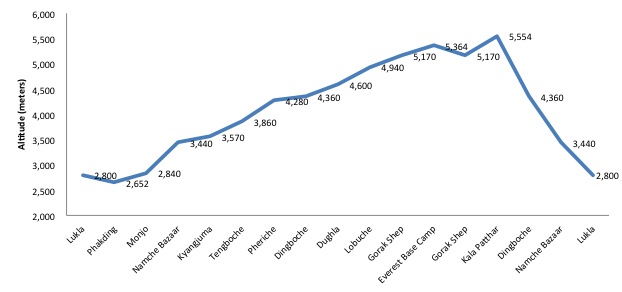
The highest point on most Everest Base Camp Treks tends to be the Kala Patthar viewing point where you will be blessed with some of the best views of Everest and the nearby peaks. Kala Patthar stands at just over 5500m, but not too much time is spent at that altitude as the trek then descends back down to Pheriche and eventually back to Lukla Airport.
Hopefully these facts and figures have convinced you set out on your own trek to Everest Base Camp – if so, happy trekking!
Tags: Everest Base Camp Trek Distance, How long is the Everest Base Camp Trek? Length of the Everest Base Camp trek, Everest Base Camp trek altitude, Everest Base Camp Trek elevation
Mark Whitman
Hi, I'm Mark! Welcome to EBC Trek Guide - the Web's No.1 Trekking Guide to Everest Base Camp. I have trekked all over Nepal, but the Everest region remains my favourite. I hope you find all the answers you are looking for on this site. If you have any questions don't hesitate to drop a comment below! Happy Trekking!
Leave a Reply
Your email address will not be published. Required fields are marked
Really useful post to reflect the daily walking distance , gain elevation and length of track regarding EBC treks thanks for sharing
Hi Mark, just wondering if Island Peak (in November) is do-able for my son who will be 17 years old. We’re both pretty fit but we don’t have any climbing experience. I did EBC in 2014. Cheers.
Hi Anthony, thanks for getting in touch. It is possible to climb Island Peak in November. The hike to Island Peak usually includes a visit to EBC before to help with acclimatisation. The climb itself is a real challenge and not for the faint-hearted. I would highly recommend doing some winter mountaineering courses before embarking on the adventure. You will need to be comfortable using crampons, crossing a glacier with ladder crevasse sections and ascending a tough headwall with a fixed rope jumar. You can read more about Island Peak here: https://www.mountainiq.com/guides/trekking-in-nepal/routes/island-peak/
Thanks Mark, your info was very helpful = )
Thanks for info. It needs to write per day max hgt of destination
on the clair ridge oil platform we climb 17km per day.8.5 up and 8.5 down….how many times do we climb the equivolent of everest per week ?
Hi Donald, I’m not sure the answer to your question. I would estimate that on the average day on the EBC trek, you gain about 800-1500m in altitude and lose about 400-800m. The average elevation gain is about 400-800m per day. Hope this helps.
Hellow ! My name is Jaak, my friends name is Andras and we are from Estonia. We wish to make a little trek, max 10-11 days for max alt. 5500/5600m and to stay overnight 5000+ meters few nights. It mast be an acclimatization trek, because my friend are going to K2 summit expedition in july. My friend have gone earlier on Mount Everest summit .Could You please think about it and say, is it possible to organize trek like this between 08.05 – 21.05. We do not need a guide service and accomondation can be easy. Thanks in adavance, Jaak and Andras
Hi Jaak, we are not a tour oeprator so unfortunately we cannot help organise your trek. For a tour operator recommendation go here: https://ebctrekguide.com/go
Looking over the Everest Trek itinerary (which is similar to other organized Everest treks), it seems a little ambitious for the uninitiated. What I mean (and I’ve done the trek independently as well as extensive mountain climbing and backpacking in the Cdn. Rockies) is that while each day’s trek is reasonable, the day-after-day grind will wear down some people. I would recommend anyone attempting this pace first do some multi-day backpacking in the mountains to see how he or she reacts to what is a fairly relentless pace. A Stairmaster is a poor substitute. Also, people who’ve not trekked high up (above 12,000 feet) should know that altitude brings new challenges.
I love to try EBC from Lukla
please tell distance between first base camp to everest summit
Hi Murali, the distance from EBC on the south side (Nepal side) to the summit is approx. 20 kilometres. The altitude gain is nearly 3,300 meters though.
Thanks for all the information… Inshalah I will be there on the last August
Hi, I would like to do EBC on my own since having a porter or a guide with me all the time does not work for me. I am wondering how safe it is to hike alone for a female. I am also wondering if getting accommodation can be a problem if you dont book in advance. Finally, is the path well marked. Many thanks!
Hi, it is possible to trek solo and if you go during the high seasons (March-May or September-November) then there will be quite a few people on the trail. Getting accommodation each day should not be a problem but you might not get your pick of teahouses. Generally porters run ahead of trekkers to secure the best teahouses. The standard EBC path is not well marked but maps of the region are very detailed and easy to follow. All the best!
I am Ram and 40 year old i would like to know more about Everest trekking , i would like to do and what is the process
Hi Ram, I recommend browsing our site – it provides all the information you need. Start here: https://ebctrekguide.com/
Why is there so little time spent at EBC?
Hi Laurie, There are a few reasons why the time at EBC is limited. Firstly, trekkers cannot actually get all the way into the camp. The stop point is just before the camp, and there isn’t a huge amount to see. 10-20 minutes there is more than enough. Secondly, EBC is a good two hour hike from the last tea house at Gorak Shep. So to hike there and back means hanging around EBC is not recommended. Finally, the best views of Everest, the surrounding mountains and EBC is from Kala Pattar, which is right next to Gorak Shep and if you move fast can be hiked on the same day that you visit EBC. Hope this helps!
I’m planning to trek solo in December – January. I read is the low season, with probably a lot of snow. You consider this dangerous? Which equipment would you consider? Your info it’s very clear thank you very much!
Hi Mariano, yes, there is more snow in December. As long as you are trekking the standard route to EBC there is no additional danger. If you plan to cross some big passes, like those on the Gokyo route or Three Passes Trek, I would caution against that. Most passes will be closed in December anyway. In terms of gear, here is what you need: https://ebctrekguide.com/everest-base-camp-trek-packing-list
Thank you for sharing all this information in your blog . Very useful information, it opened my eyes to things i wasn’t aware about. Great way to start preparing for next years climb
Thanks Ebby!
Thanks for the info Mark, helps a lot. Planning to do the trek in December. Would appreciate any pointers to make it comfortable as I am told the Climate is extremely cold.
Hey Ismail, yes, December is pretty cold. Make sure to bring a four season sleeping bag and warm winter jacket / gloves / beanie etc. Layers will be important too, check out our packing list for advice: https://ebctrekguide.com/everest-base-camp-trek-packing-list
Hi, we are a family of 4 and interested in doing EBC in July 2019. Wanted to check what the minimum age is. My two sons are 12 and 10 years old and are physically fit. Thanks
Hi Jeet, there is no official minimum age for the EBC trek, although I wouldn’t take a child younger than 10. In terms of timings I would avoid July – this is the middle of the monsoon season and a terrible time to trek. The best time to go is either Feb-May or Sept-November. Hope this helps.
My other is a smoker and we would like to trek to EBC. Please give her some words of wisdom from your experience with smoking trekkers.
Hi William, words of wisdom… stop smoking. No in all seriousness, one can trek to EBC and smoke but I wouldn’t recommend it. If at all possible, I would encourage your ‘other’ to abstain from smoking, especially on the upper reaches of the trek.
Hello we are 3 friends and want to do EBC, want to know the formalities. Preferable date is 23rd march
We are planning to trekk to Everest base camp in next month . What is your advice for me
Hey, little mistakes on the altitude, Lukla is 2850m and the Kala Patthar is 5643m. 😉 btw I recommend to not hire any porter, that’s too easy with them and you won’t have the same satisfaction. I did it by myself without help and I was so proud to carry my bag in front of all this groups of tired people (but with no bags 😉 ) you’re going for a challenge or not ?
can you hire poter and guide at lukla. how is the chance if you trek to phaking and try to get a tea house without prior booking
Yes it is possible to hire a guide / porter in Lukla. If you ask at one of the many teahouses they should be able to assist. In terms of teahouse availability, this varies by season and time you arrive. Ideally it is best to send a porter ahead early in the day to make a booking for you, but generally if you arrive at a reasonable time it is usually possible to find a free room in one of the teahouses.
Great informative stuff, I’m Planning on 4 old guys 60 +62 to EBC In Nov 2020 Let you know how it goes
can I see everest from namchee bazaar?
Technically you need to hike up to the Everest View Hotel which is just above Namche. But it is only a 20 minute walk away so yes you can.
Is it possible to take a helicopter from Lukla to EBC and then hike back to Lukla with a group? I have taken a bus to EBC and that would be an option too. We would be staying the week before at a 10,000' elevation to help with acclimatization. Thanks,. Tom
Hi Thomas, it is possible to get a helicopter to EBC, but it’s pretty expensive and due to the high altitude weight is usually limited to one passenger (maybe two).
How far from base camp 4 to the peak and back?
Hi Albert, just to be clear this website is about hiking to Everest Base Camp, not climbing Mount Everest. But to answer your question, Camp 4 is on Everest is located on the South Col at just over 8000m. It’s about 1-mile climb to the summit and takes about 7-8 hours.
All of these guides have been so helpful! I leave for EBC in a week and have been panic googling to try to be as prepared as possible. Thank you for the info!
Sure thing Megan!
Hi! What clothing do you recommend for doing the EBC trek first couple weeks of November? Thanks!! Great article
Hi Jackie, I recommend checking out this packing list: https://ebctrekguide.com/everest-base-camp-trek-packing-list
very informative mark thank you. i will be doing this in october 2023
Thanks Tony!
Hi Mark, is there scope to buy all the kit you need in Kathmandu as I’m traveling light at the moment. Im in the far east in shorts and flip flops and my gear is back in the uk. If so how much would I be looking at?
Yes, there are loads of gear stores in Thamel.
Very informative, intresting and nicely articulated! Loved it.
Get a quote from the best local trek operator in Nepal!
Get my recommendations on the Best EBC trek operators
- Go to slide 3
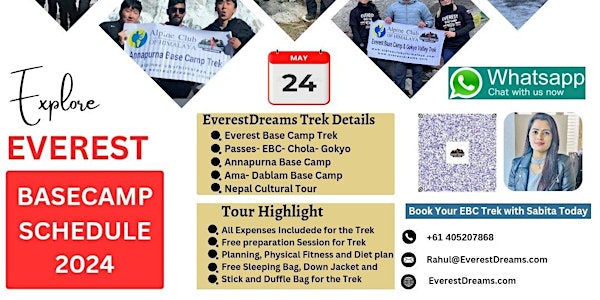
Everest Base Camp Trek - Last Trek of 2024 !!!! Book Now
Select date and time
- Saturday May 4 1:00 AM
- Sunday May 5 1:00 AM
- Saturday May 11 1:00 AM
- Sunday May 12 1:00 AM
- Saturday May 18 1:00 AM
- More options
About this event
Our Al Inclusive costs include
· Free Tour Itinerary and Day Breakup session before booking
· Physical Fitness, Food and Medical Preparation and Packaging
· Costing and Budgeting
· Free one day Culture Orientation Kathmandu tour included For Booking mail [email protected] or Whatsapp +61 405207868
Frequently asked questions
For Booking mail [email protected] or Whatsapp +61 405207868
- Online Events
- Things To Do Online
- Online Retreats
- Online Travel & Outdoor Retreats
Organized by
'I trekked Everest to hang my friend's hat; it was her dying wish'

Liz Cullinane who placed her late mother's wig and her friend's hat at Everest Base Camp as part of a touching tribute after they died from cancer.
Most people would move mountains to fulfill their best friend's dying wish. Cork woman Liz Cullinane did just that - and more - by hiking to Everest base camp to hang a hat belonging to her best friend Caroline Shaw.
Liz had been planning a charity trek to Everest in March in order to raise funds for the Cork Cancer Care Centre. The 58-year-old, who had breast cancer, is hoping to receive the all-clear in May. The disease claimed her mother's life in 1996, and Liz was planning the Everest trip not only to raise vital funds, but also to hang her late mother's wig on Everest.
However, in February the lifelong friends received the devastating news that Caroline had been diagnosed with an aggressive form of cancer. She was only expected to live until April.
Liz's first instinct was to cancel the Everest trip, but Caroline insisted she go ahead. Knowing that Liz wanted to pull out, Caroline asked Liz to take her favourite hat on the camp, and hang it in Everest base camp in her memory.
The friends made a so-called pinkie promise, which Liz was then determined to fulfil, so much so she then had it tattooed on her arm. It depicts two interlinking fingers sealing Liz’s commitment.

“Caroline asked me to hang her hat on Everest because she knew I was going to cancel the whole thing on account of her illness,” Liz said.
“When I said I was cancelling the climb, she said 'no, no, no I need you to hang my hat up there with your mum’s wig'. She knew herself that she wasn’t going to make it. I told her 'I’ll do it, I will'. I said 'I’ll get your hat up there'. She had good faith in me.
Caroline passed away on February 28, five days after she gave her hat to Liz and made her promise to go ahead with the trip.
"She knew I was planning to cancel it because of her illness and that’s why she asked me to take her hat there.” The memory of that conversation is one that will stay with Liz forever.
“We sat down and laughed and cried. She was very calm in giving me the hat. Caroline was very upset when she lost her hair and wore this hat to every function and even when she was going for treatment.”
Liz said she felt the spirits of both her mother and best friend as she climbed to base camp.
“I had both the wig and the hat on the way up. What was strange was there were two little robins following me the whole way up. They stayed by my side that entire time. I wouldn’t have thought anything of it if there was one but the fact there were two made me think that their spirits were with me the whole time.”
She says how grief can be a lifelong process.
You never get over a parent dying. 28 years later I am still not over losing my mum.
"Leaving her wig behind was like another stage of letting her go. I used to take out the wig now and again because it still had the scent of her. It might sound crazy but it was a nice thing to have.
"It got to a stage where I couldn’t take it out anymore. I knew I had to let go. My hands were shaking as I hung the wig up.
"It was also tough leaving Caroline’s hat behind. At one stage I wanted to go back for them. I can’t say one was harder than the other. They were both equally difficult. I was overwhelmed by the whole thing, so overwhelmed that I can’t remember some of it, but I’m really glad I did it.”

Irish Examiner’s WhatsApp channel
Follow and share the latest news and stories
more cork - news articles

More in this section

HSE chief: 'Our failure' led to Aoife Johnston's death
Lunchtime news.
Sign up to the best reads of the week from irishexaminer.com selected just for you.
Please click here for our privacy statement.

War of Independence Podcast
A special four-part series hosted by mick clifford, available on www.irishexaminer.com/podcasts.

Commemorating 100 years since the War of Independence
FOLLOW IRISH EXAMINER

Select your favourite newsletters and get the best of Irish Examiner delivered to your inbox

Sunday, April 28, 2024 - 6:00 PM

Sunday, April 28, 2024 - 8:00 PM

Sunday, April 28, 2024 - 9:00 PM

Family Notices
© Examiner Echo Group Limited

Cumbrians tackle Mount Everest base camp ascent for St Mary's Hospice
A group of Cumbrians have been facing Mount Everest to raise money for a local hospice.
The fundraisers arrived in Kathmandu, Nepal's capital, on Tuesday, April 16 and have been getting closer to the top of the world ever since.
The walkers are being guided by Matt Le Voi from LMG Treks and Expeditions, taking them under his wing and guiding them through the beautiful forests, Sherpa villages, glacial moraines, and foothills to reach Everest Base Camp.
It has been an emotional journey for those out walking and for their friends and family back home who are cheering them on every step of the way.
Matt said: “The trek to the base camp is rightly popular thanks to its amazing views, immersion into the local culture, and of course because of the physical challenge it offers.
“The team have trekked every day, whilst pitting their bodies against ever-increasing altitude and other challenges such a trek poses."
The team has already raised a 'tremendous' amount of money which will be going to St Mary's Hospice based in Ulverston .
Matt added: "For some, this has been the toughest thing they've ever undertaken, but the level of satisfaction amongst the team for having visited the world-famous base camp at the foot of the tallest mountain in the world is through the roof.
“The team has one further day to trek before they can return to the hustle and bustle of Kathmandu, and shortly after, back home to share their amazing stories with their loved ones.”
The hospice only gets about one fifth of its funding from the Government, meaning events such as this are vital to keep the organisation running.
Events and challenges manager Mel Dixon said: “I find it hard to put into words just how incredibly proud I am of each and every person who decided to join the Everest Base Camp trek - they’ve raised a phenomenal amount of money that will help us keep going.
“I’ve kept in close contact with the group while they’re out there and hearing the stories they have shared and what it means to them is enough to make anyone tear up.”
Places are available for Everest Base Camp 2025 and you can find out more information here or by emailing Mel at [email protected].
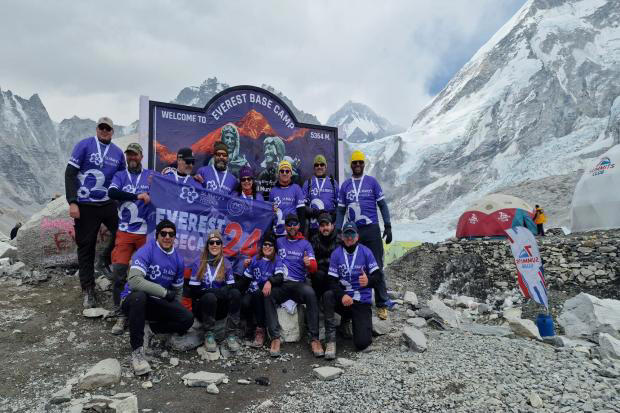

IMAGES
VIDEO
COMMENTS
Top of many people's travel bucket lists, the trek to Everest Base Camp is often the first thing people think about when they start dreaming of a trip to Nepal.. The walk takes trekkers past Sherpa villages and Tibetan-style monasteries, right up into the heart of the high Himalaya, into a breathtaking world (literally) of iconic glaciers, lakes and the tallest peaks on earth.
Hike to Everest Base Camp via Gokyo Lakes - Add three or four days to your EBC trek by trekking to Goyo Lakes, six spectacular glacial lakes, located between 4,700m and 5,000m. Beautiful panoramic views of famous mountains such as K 43, Taboche, Cholatse, Nuptse, and Everest and the famous glacial lakes, cross the beautiful and challenging ...
Classic Everest Base Camp trek. The classic Everest Base Camp trek takes about 14 days, including time in Kathmandu before and after. From Kathmandu, you'll fly into Lukla Airport (2,860m/9,383ft) with its famously short runway - try to sit on the left side of the plane so you can catch your first views of Mt. Everest.
Phone +1 682-558-3926. Web Visit website. Trekking to Everest Base Camp in Nepal's Sagarmatha National Park is the adventure of a lifetime. Although actually climbing Mount Everest is out of reach for many of us, anyone with enough grit and good enough fitness can reach EBC and the Khumbu Icefall, the starting point for climbing Mount Everest.
Trekking Distance. The one way trekking distance from Lukla to Mt Everest Base Camp is about 65 kilometers (40 miles). That means the total roundtrip distance of an EBC Trek is about 130 kilometers, even if you don't do any of the detours. Don't let that scare you off. It's a lot of hiking, but every step is worth it.
EVEREST BASE CAMP TREK DETAILS. Distance: 120 km round-trip from Lukla to Base Camp and back to Lukla (You will fly to Lukla from Kathmandu); Days required: 12 -14 days; Total Incline: (Undulation) - 6015 m; Total Decline:(Undulation) - 5821 m; The highest point on the trek: 5640 m/18 500 ft, this is actually at Kala Patthar, which you will hike to in the morning after reaching Everest ...
THE ESSENTIAL GUIDE. In this guide we cover everything you need to know about the Everest Base Camp Trek in Nepal. This includes suggested itineraries and practical information about accommodation, costs, what to pack, independent vs. guided treks, transport, and more. We also offer a route map with GPX download for use on the trek.
For Everest Base Camp Trek, you'll need between $2,000 and $4,000 depending on the services you want. Prepare with plenty of cash (preferably in USD or Euro) so that you don't have to rely on ATMs or credit cards; both charge hefty fees. Then there are transportation and visa fees that can add up quickly.
The Everest base camp trek can be booked through Magical Nepal, a Kathmandu-based trekking specialist with a wealth of experience in the region. Prices start from around USD $1,459 for a round trip from Kathmandu and include the following: Local transfers for international flights (arrival/departure)
2 Highlights of EBC Trek. 3 Everest Base Camp Trek Overview. 4 Everest Base Camp Trek Route Map. 5 Detailed itinerary of EBC Trek. 5.1 Day 01 Arrival in Kathmandu (1350m/4429feet) 5.2 Day 02 Fly to Lukla (2880m/9448feet), then trek to Phakding (2610m/8563feet) 5.3 Day 03 Trek to Namche Bazaar (3440m/11286feet) 5.4 Day 04 Acclimatization day in ...
The best trekking team Everest Base Camp Trek Route. If you follow my Everest Base Camp trek itinerary, you'll need 12 days to start and return to Lukla. You will reach Everest Base Camp on day 9 which is enough time for your body to adjust to the higher altitude. Day 1: Kathmandu to Lukla to Phakding. Day 2: Phakding to Namche Bazaar
Trekking to 5,550m/18,204ft0 at its highest point (Kala Patthar), the two weeks Everest Base Camp trek (EBC trek) is the most loved and popular trekking route in the World. This amazing adventurous journey takes you around the foothills of the renowned World's highest peak, Mt. Everest (8,848.86m). The major attraction of the EBC trek is Kala ...
The iconic Everest Base Camp Trek leads you through the Khumbu Valley, allowing you to experience the immense beauty of the surrounding Sagarmatha National Park while simultaneously providing breath-taking vistas of 4 of the 6 highest peaks in the world - My. Everest (8.848m), Mt. Lhotse (8,516 meters), Mt. Makalu (8,470 meters) and Cho Oyu (8,201 meters).
Everest Base Camp Trek is an incredible adventure in the Himalayan region of Nepal. Mt Everest region is home to majestic hills, serene rivers, pristine waterfalls, and village settlements. There are various trekking routes and destinations in this region.
In April 1, 2023, Nepal has banned solo trekking. Foreigners must hire a guide for treks in high-altitude trekking regions of national parks. According to the Kathmandu Post in March "solo or independent trekkers have to mandatorily hire a guide or a porter before setting off to Nepal's mountains."However, after an updated article in the Kathmandu Post, it seems that the Everest Region ...
Volunteers removed 10.3 tons of rubbish from the slopes of Everest and the approach to Everest Base Camp in 2019, making just a small dent in Everest's waste mountain. To help, the SPCC has erected more than 100 rubbish bins at rest points on trekking trails in the Everest Region.
8. Best time to trek to Everest Base Camp. There are two main seasons for trekking to Everest Base Camp in Nepal. The first is in the spring (late March to May) and the second comes in the autumn (late September to November). Both high seasons essentially straddle the main monsoon season, offering more dryness and clearer skies without too much ...
Trekking to Everest Base Camp is, undoubtedly, a physical feat. That doesn't mean it should be treated like a competition. While the Everest Base Camp trek holds significantly fewer risks than actually summiting the world's highest peak, the root of the risks are the same. When trekkers begin to rush along crowded trails, things can get ...
This classic trek takes place in the Bagmati Zone of Nepal and allows you to experience the immense beauty of the surroundings. Along your trek, you will get to witness 4 of the 6 highest mountain peaks in the world — Cho Oyu (8,201 m), Mt. Makalu (8,470 m), Mt. Lhotse (8,516 m), and Mt. Everest (8,848 m). Everest Base Camp is a teahouse trek ...
Distance. The classic Everest Base Camp trek from Lukla to EBC and back is 130km long - 65km each way - which may sound like a lot of trekking! Fear not, because the typical round trip to Everest Base Camp takes around 12 days, the actual distance you will be covering each day will be about 15km - a much more reasonable and achievable number.
Eventbrite - EverestDreams.com presents Everest Base Camp Trek - Last Trek of 2024 !!!! Book Now - Saturday, May 4, 2024 | Friday, May 24, 2024 - Find event and ticket information.
Liz had been planning a charity trek to Everest in March in order to raise funds for the Cork Cancer Care Centre. The 58-year-old, who had breast cancer, is hoping to receive the all-clear in May.
A group of Cumbrians have been facing Mount Everest to raise money for a local hospice. ... Matt said: "The trek to the base camp is rightly popular thanks to its amazing views, immersion into ...
13 likes, 0 comments - swanseaeverestbasecamp on February 17, 2023: "How do you organise a bag pack?? Swipe to find out! >>>".